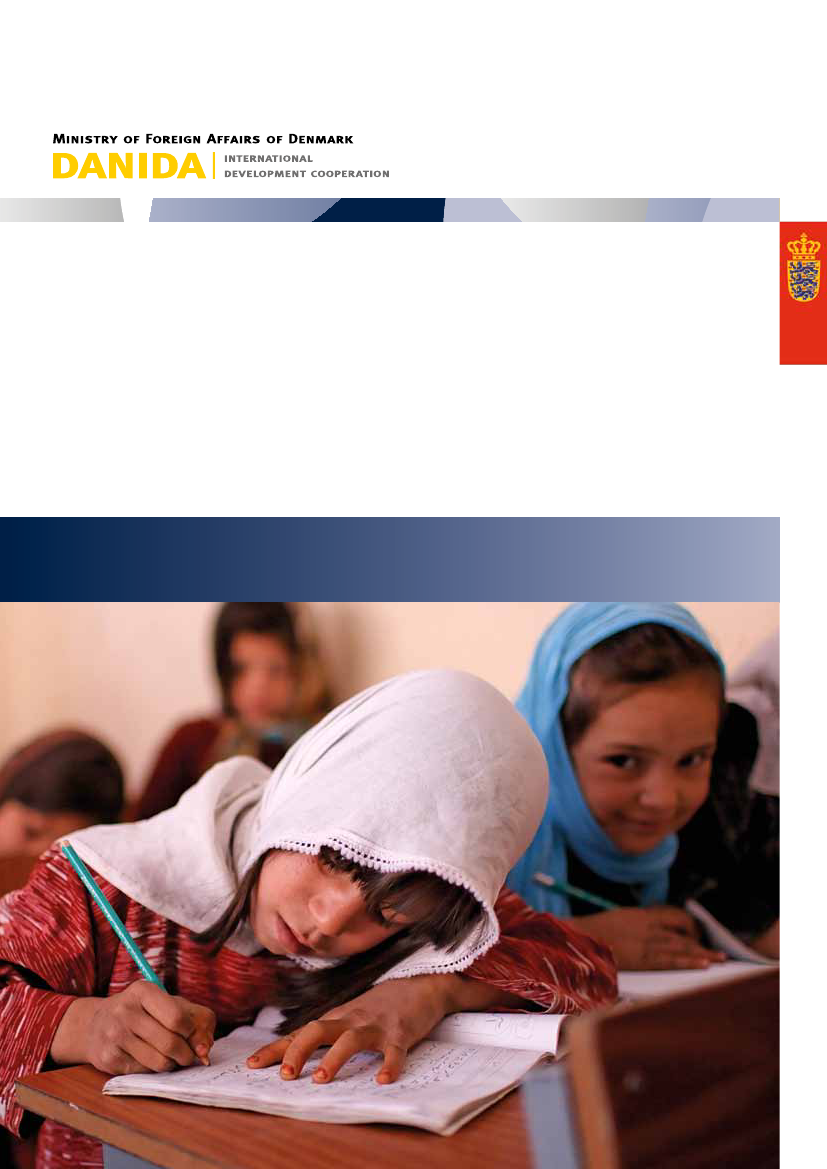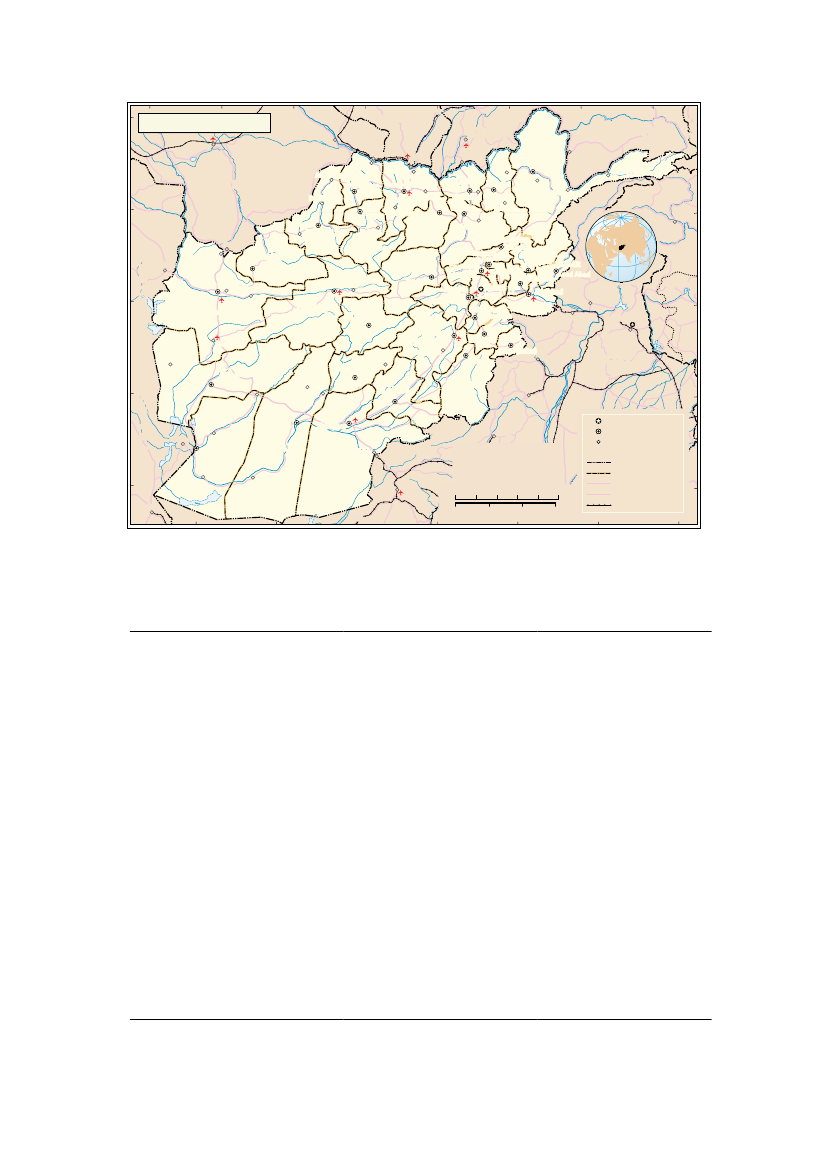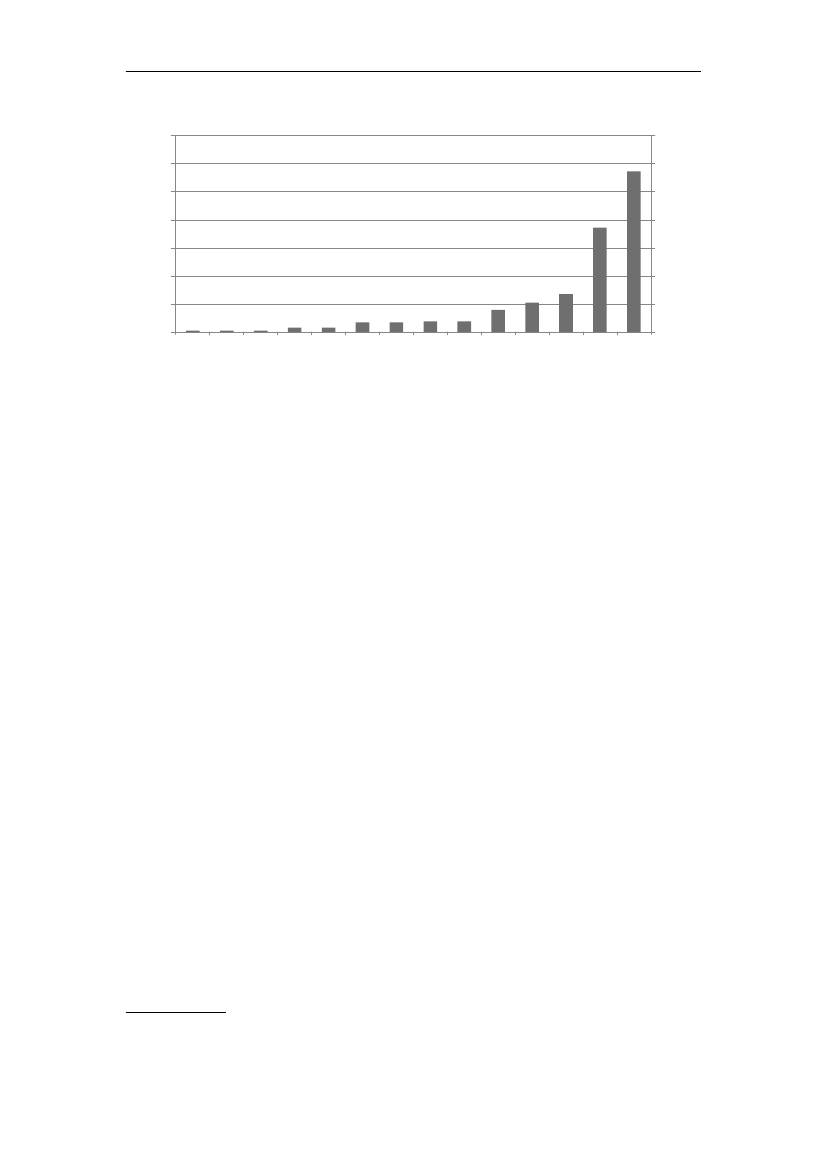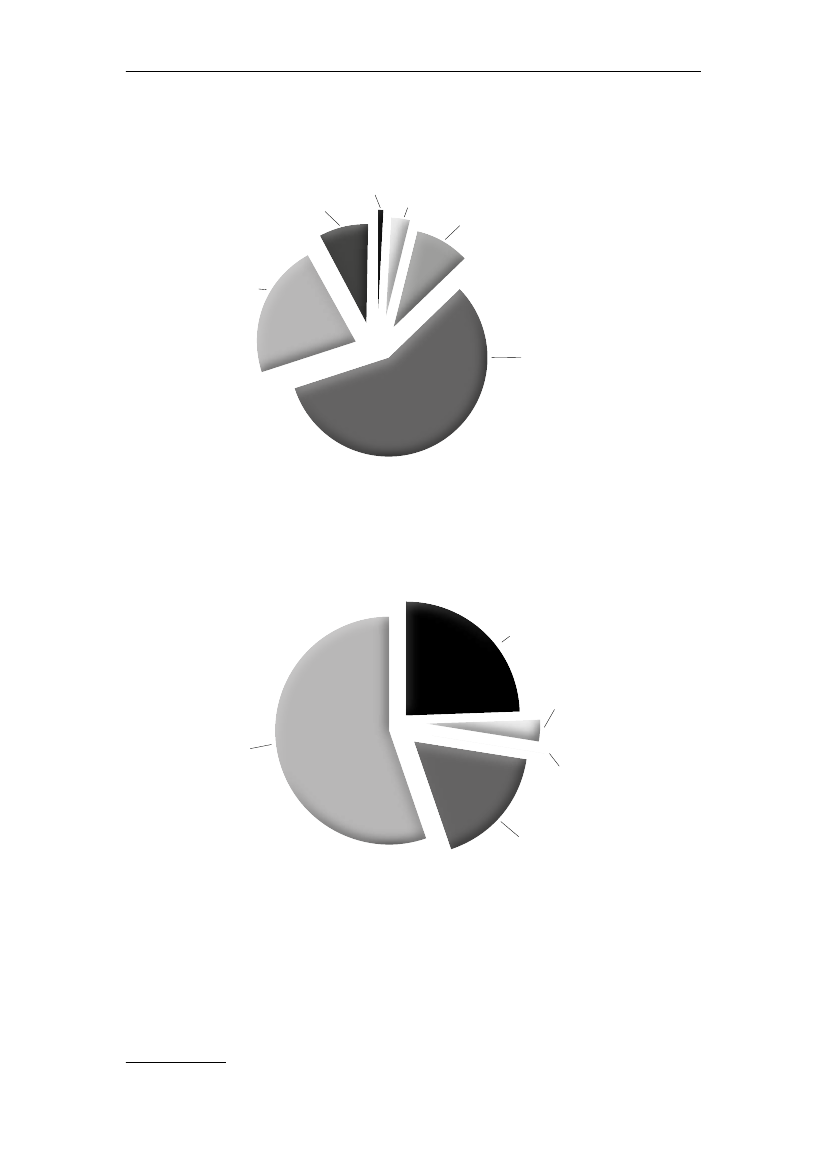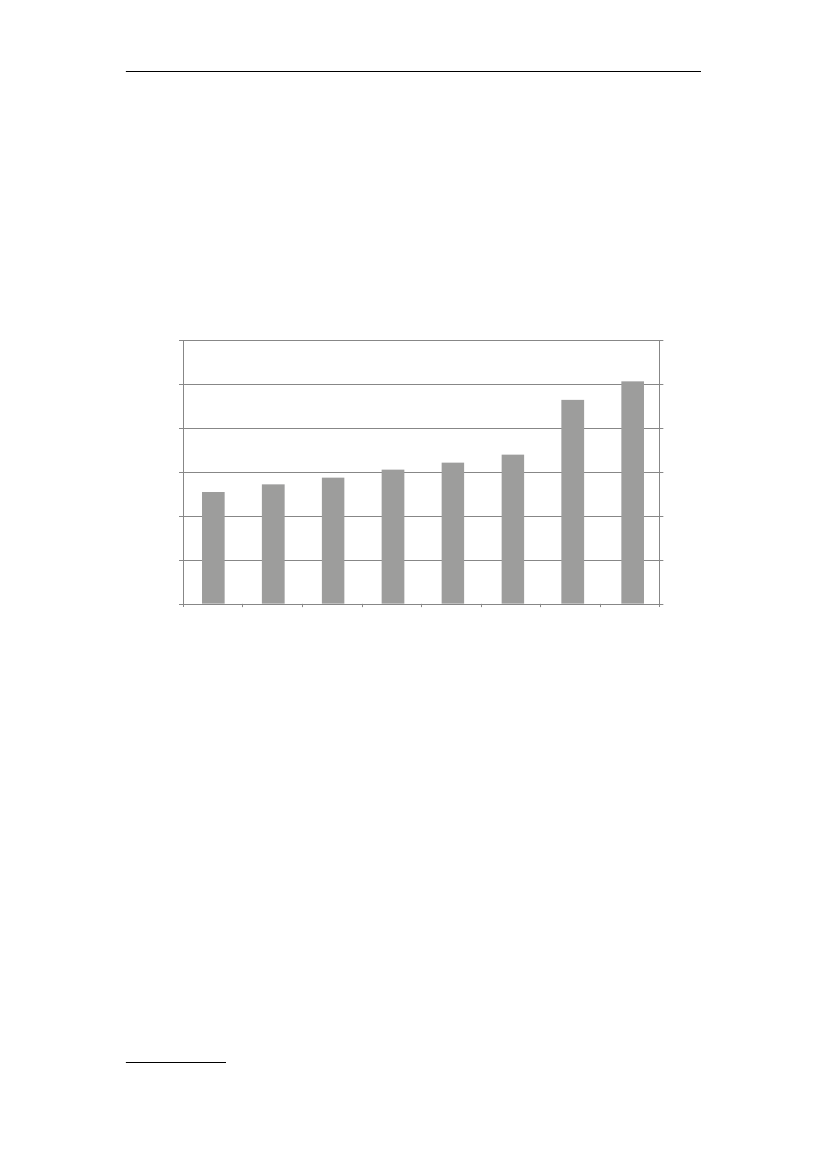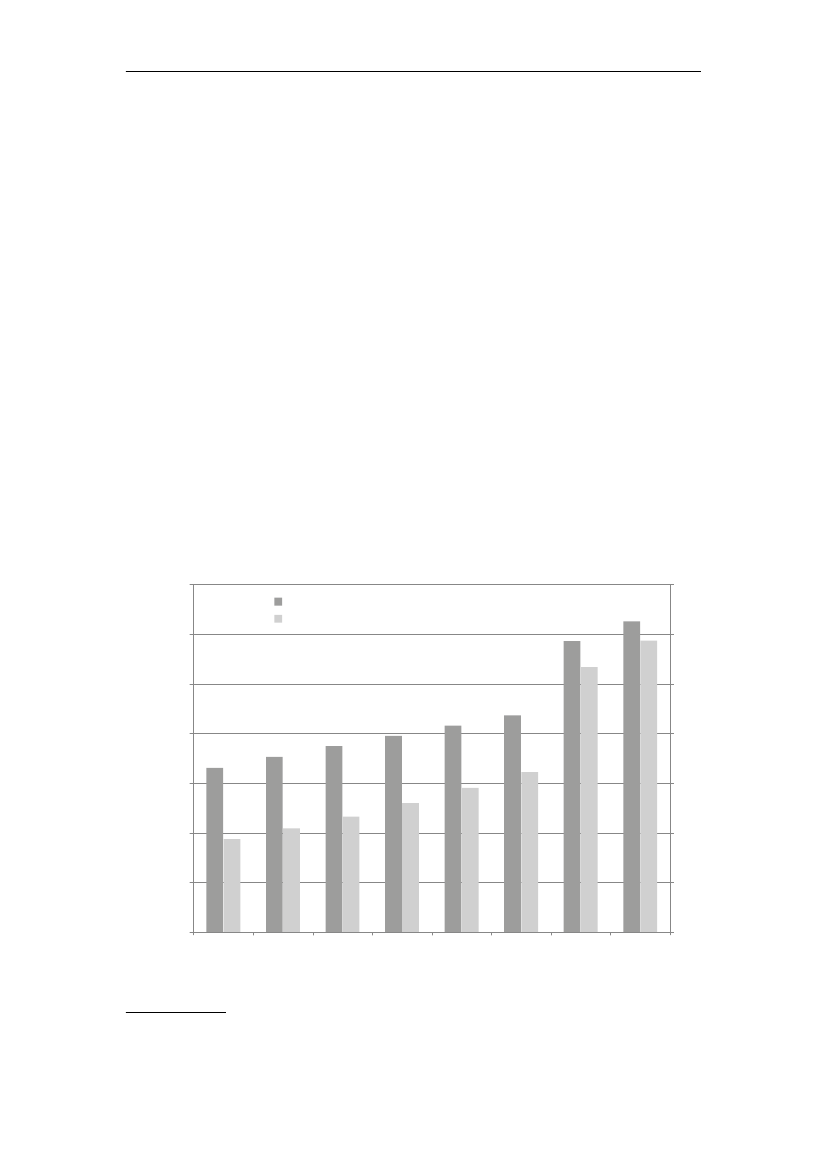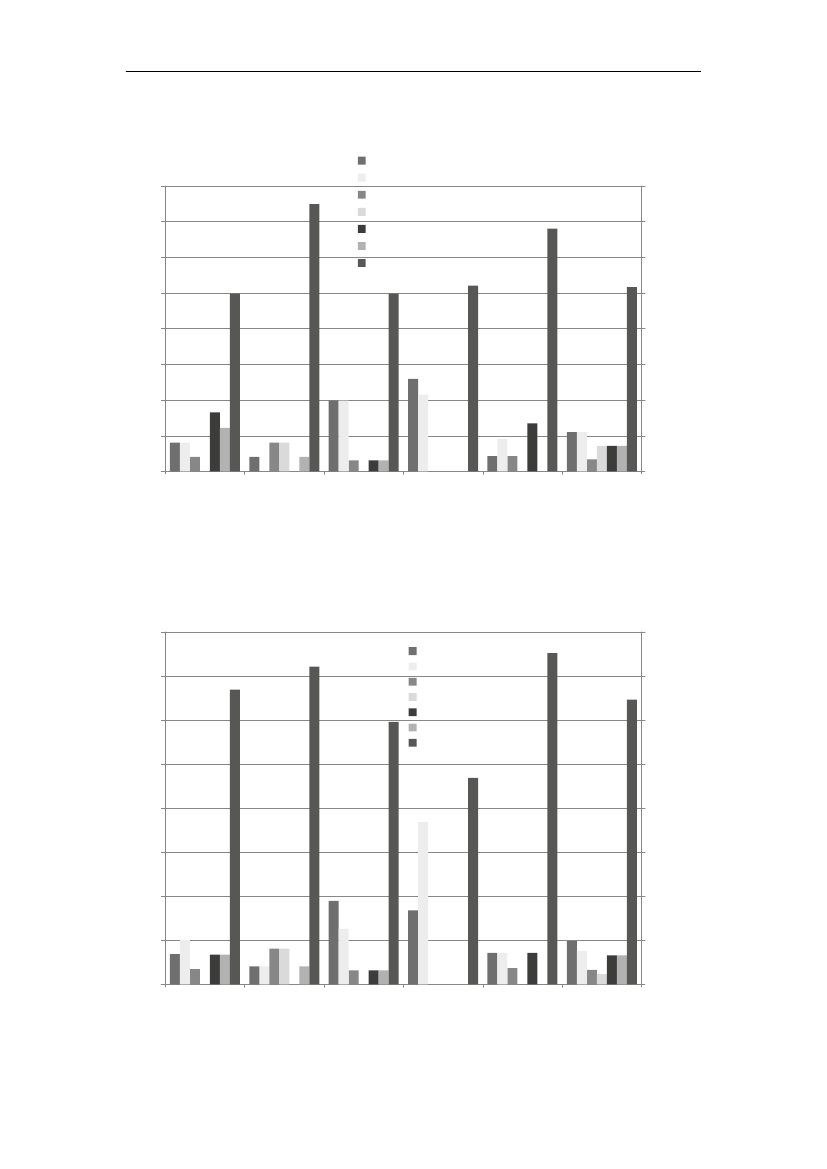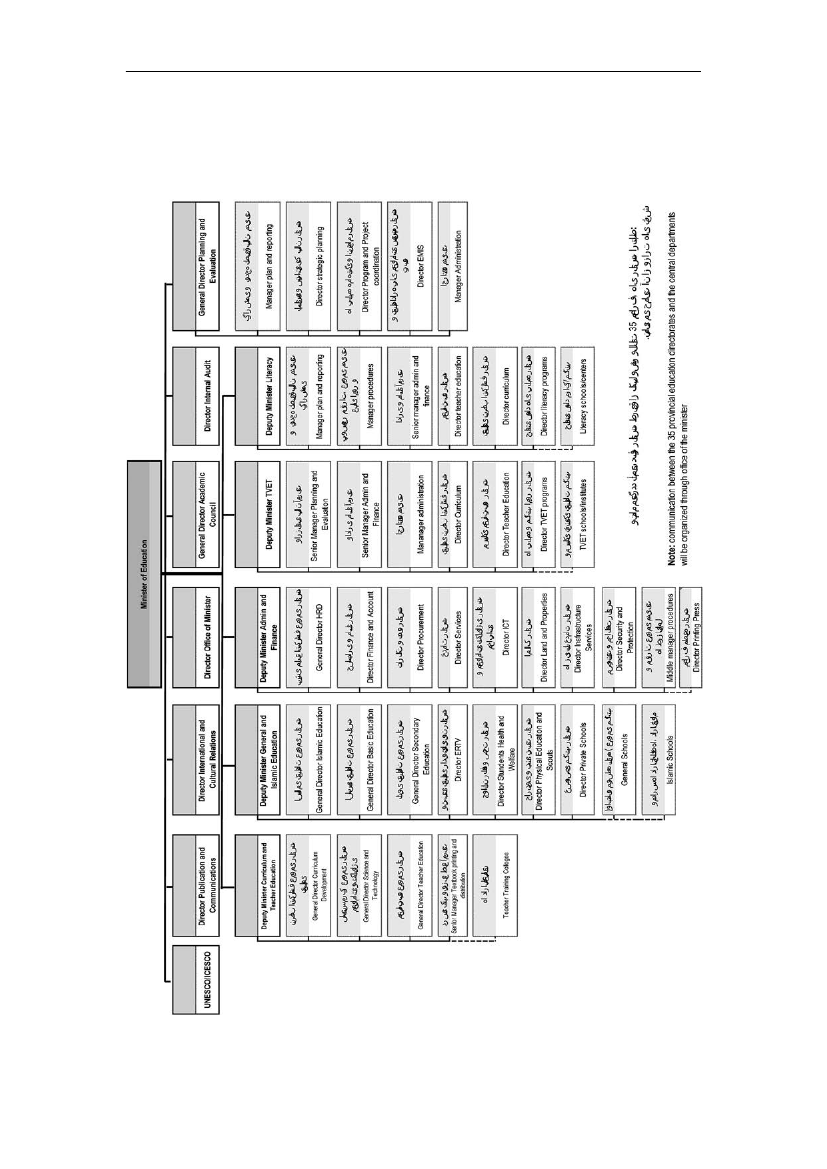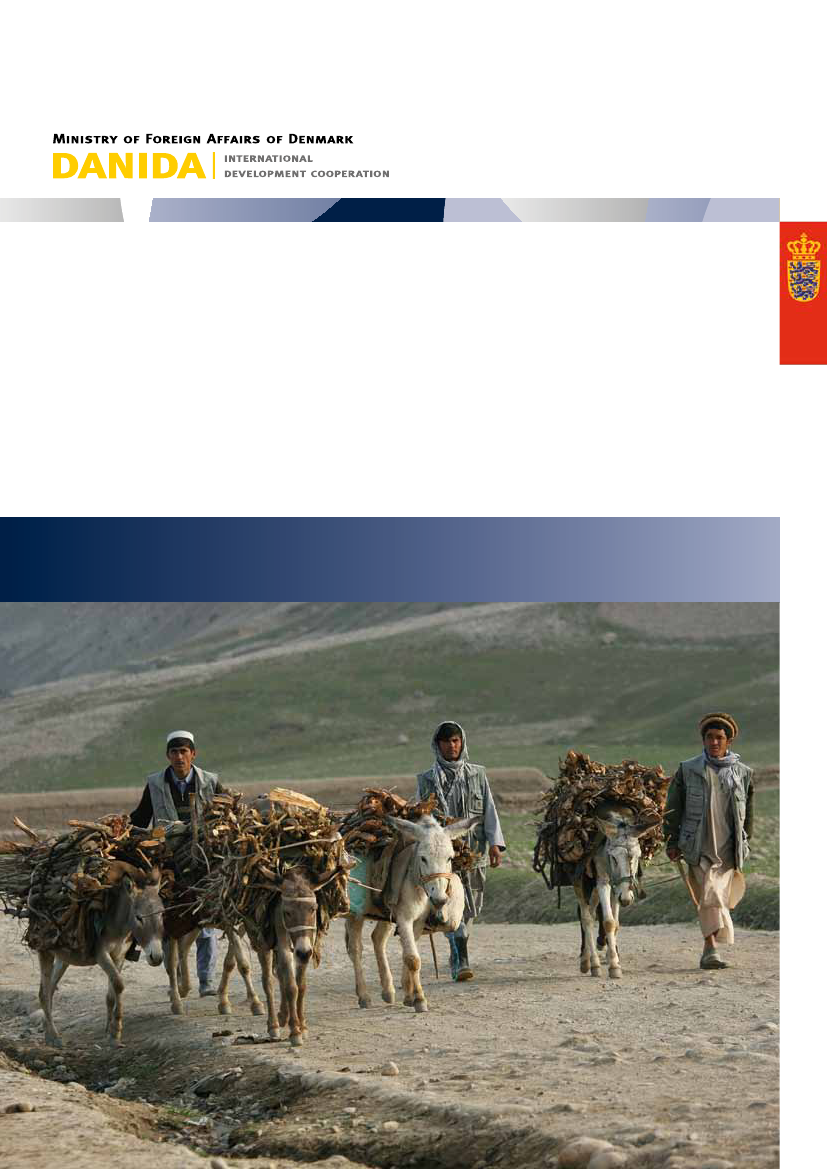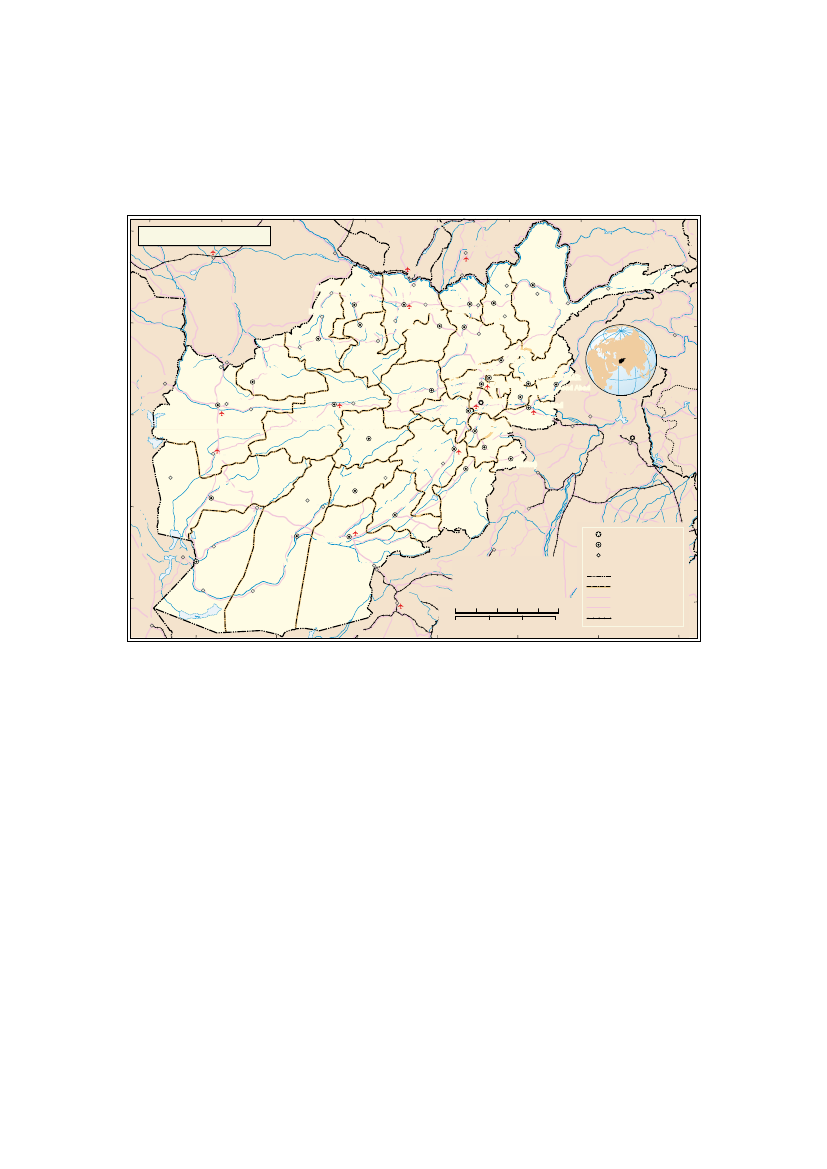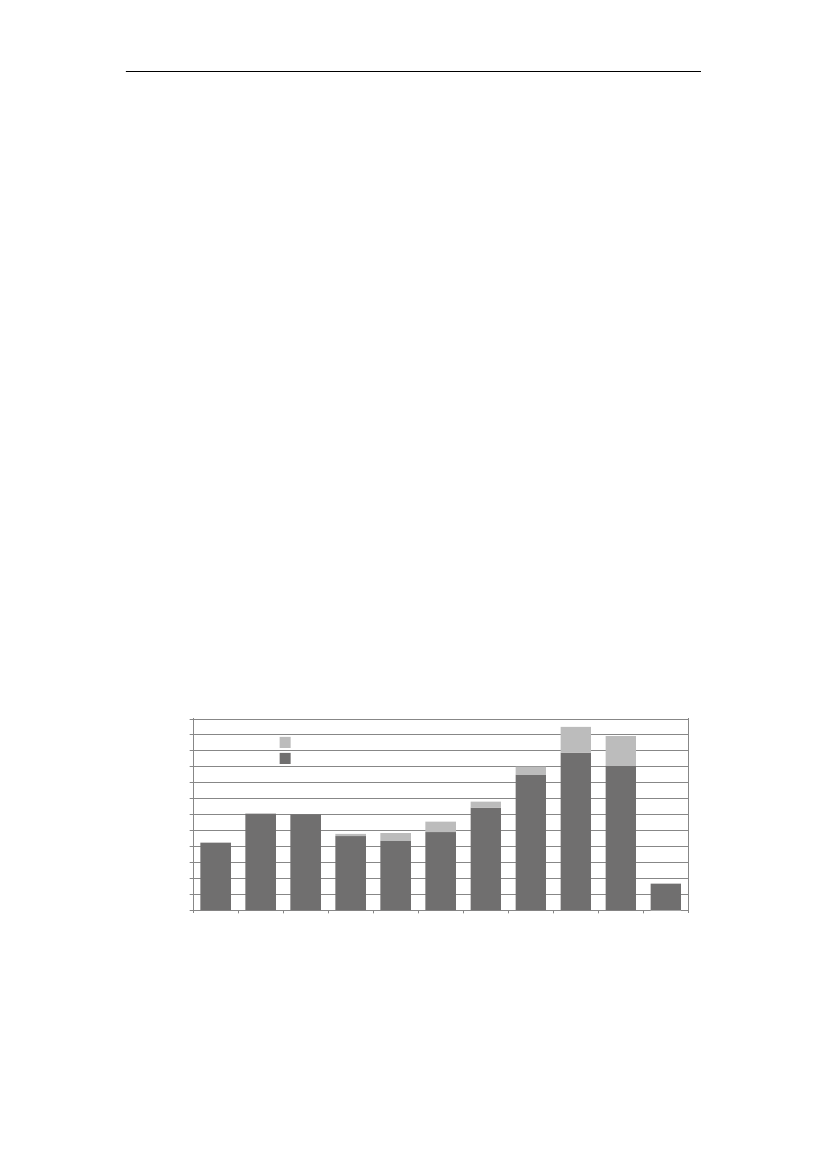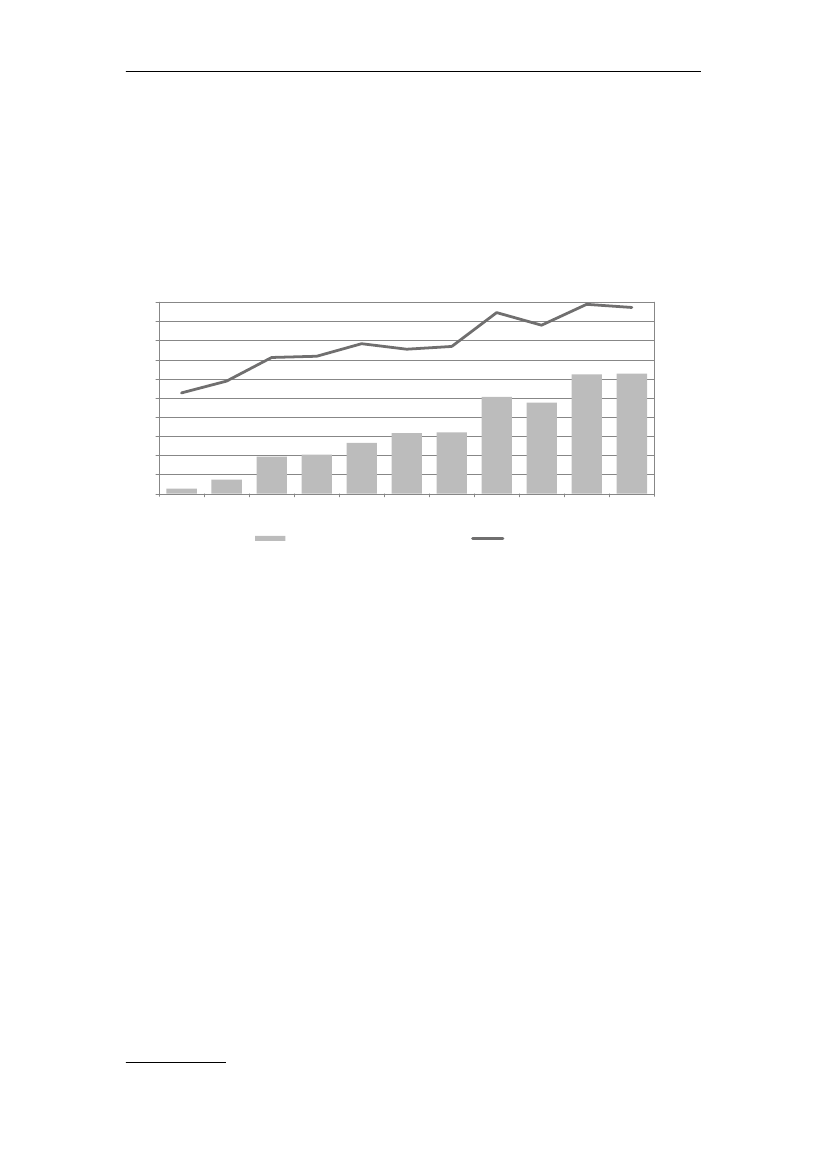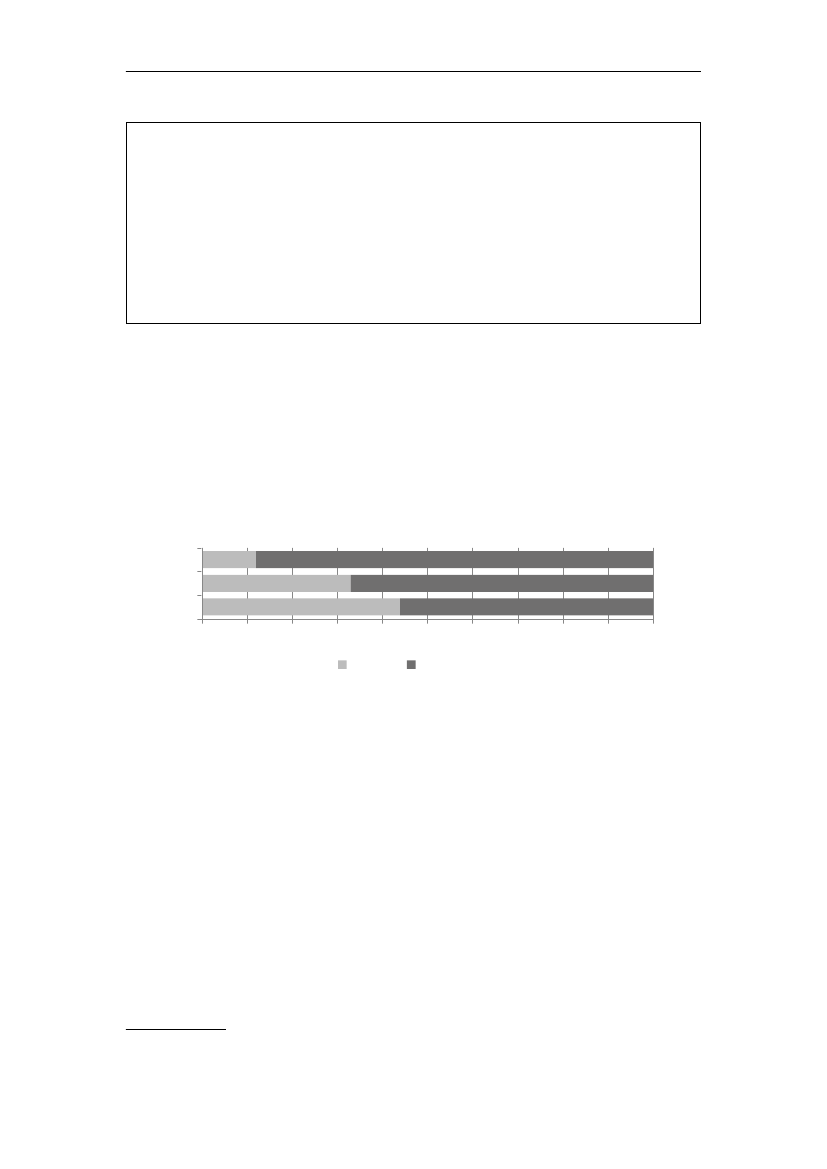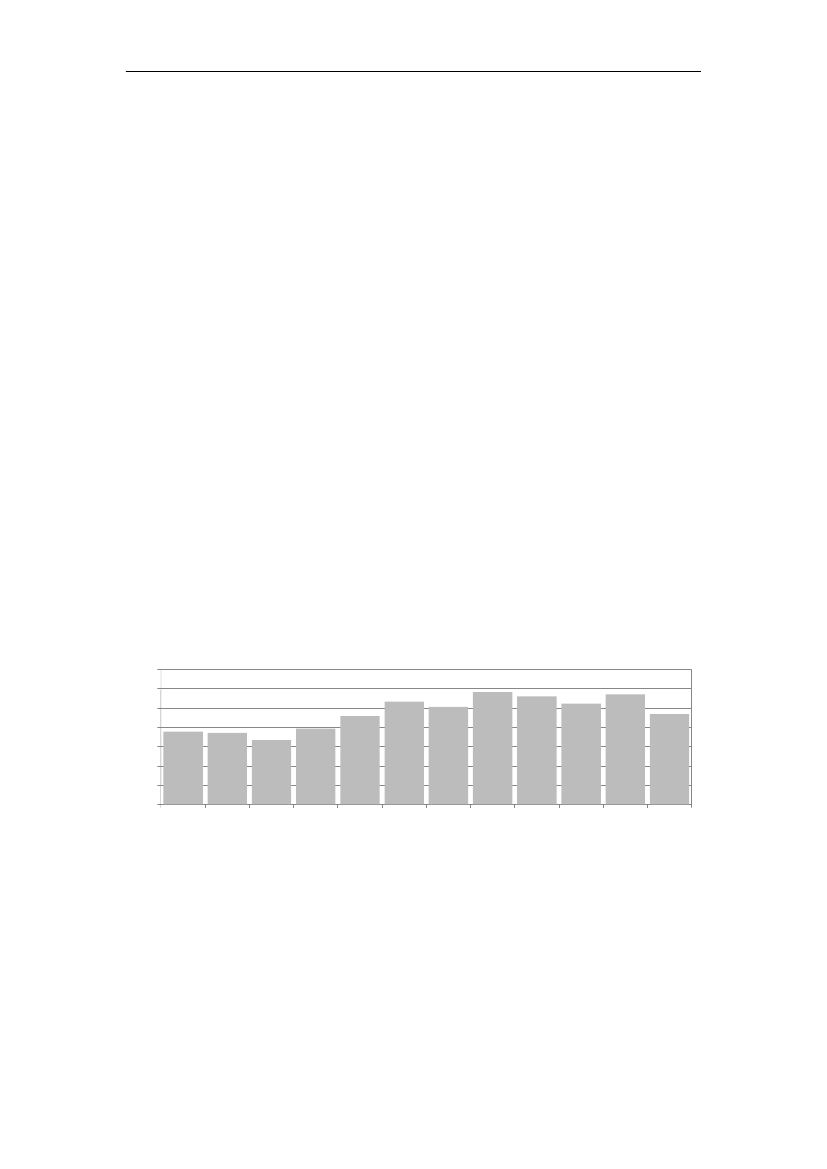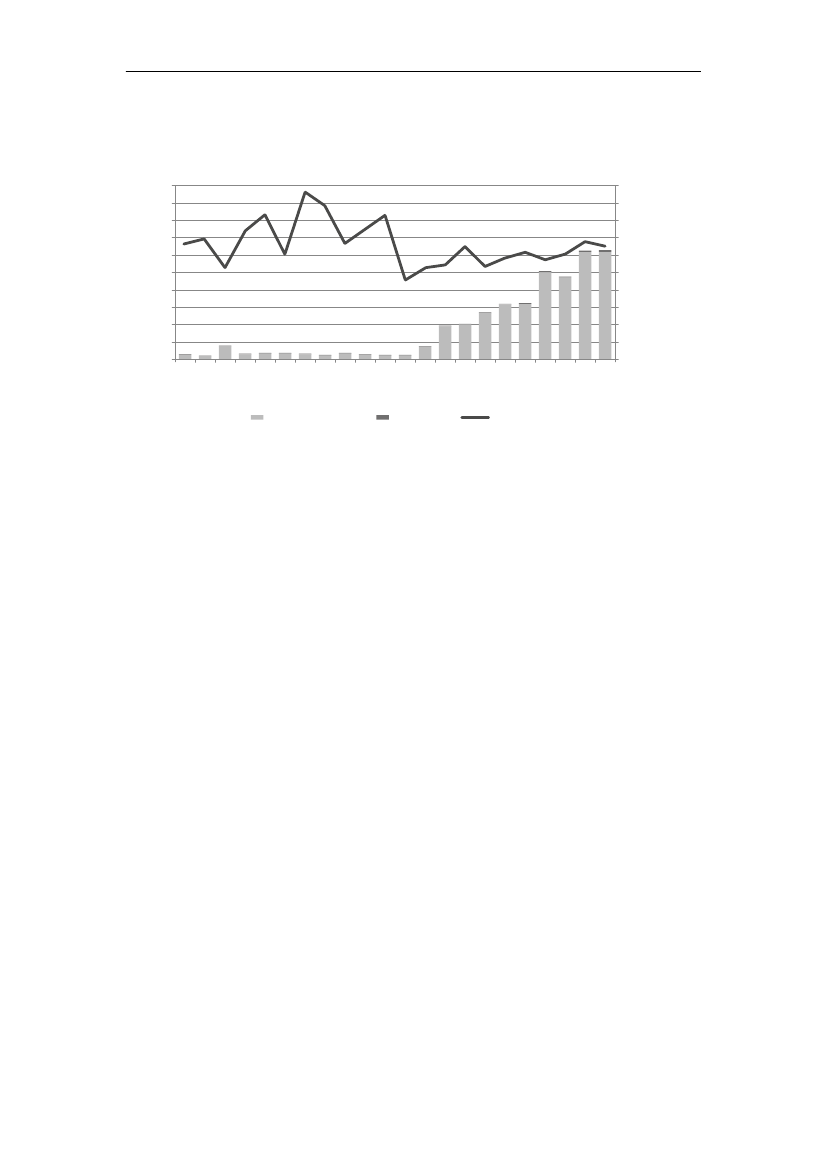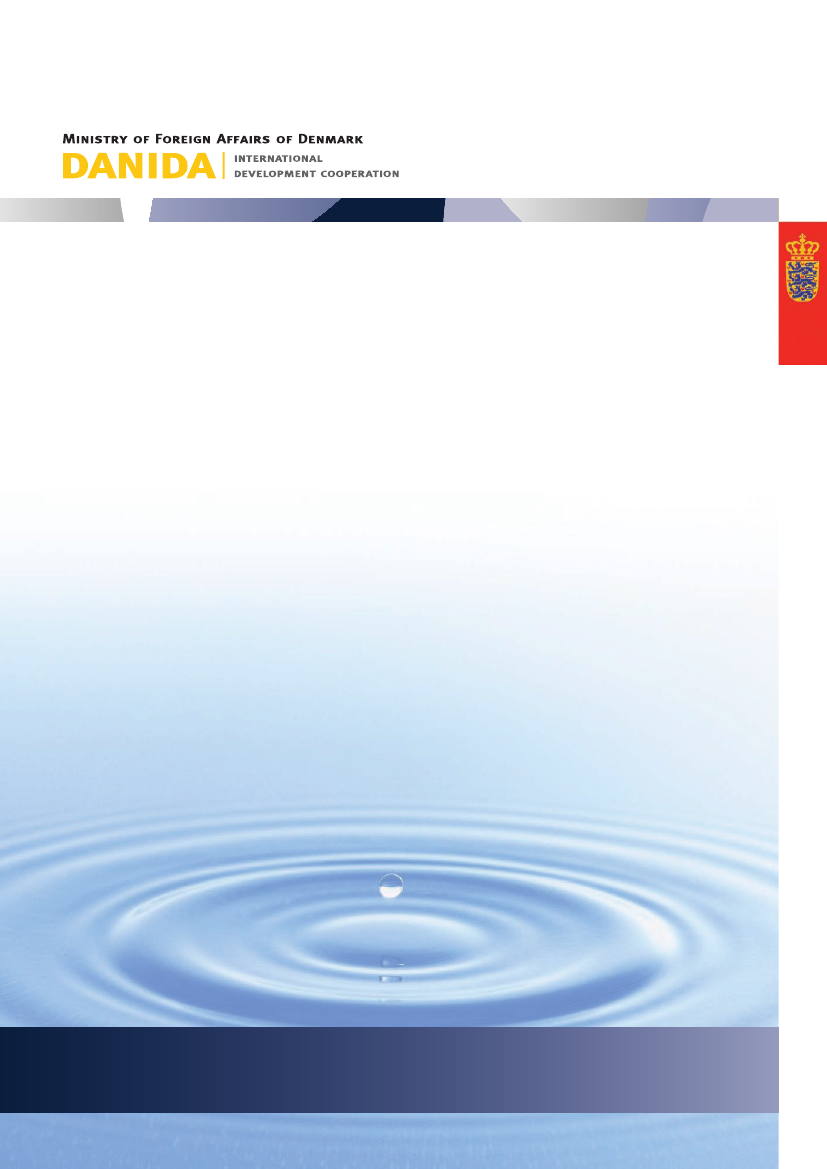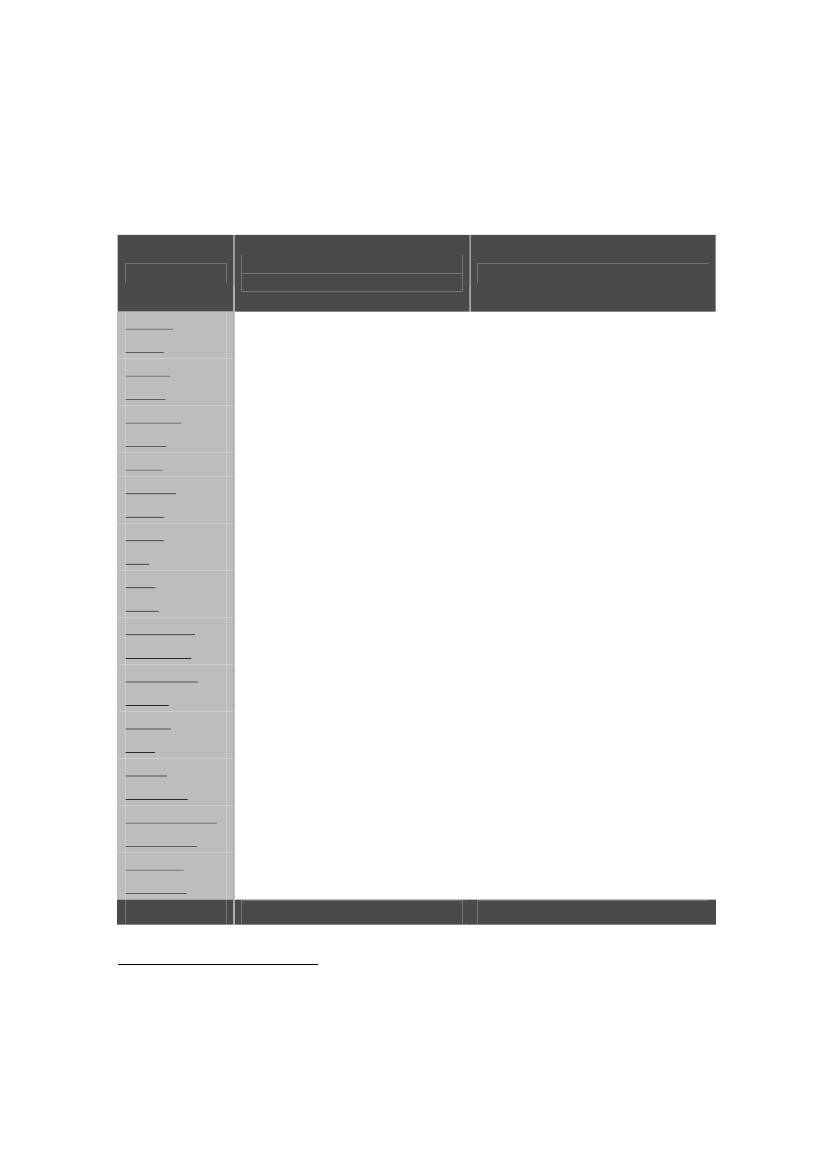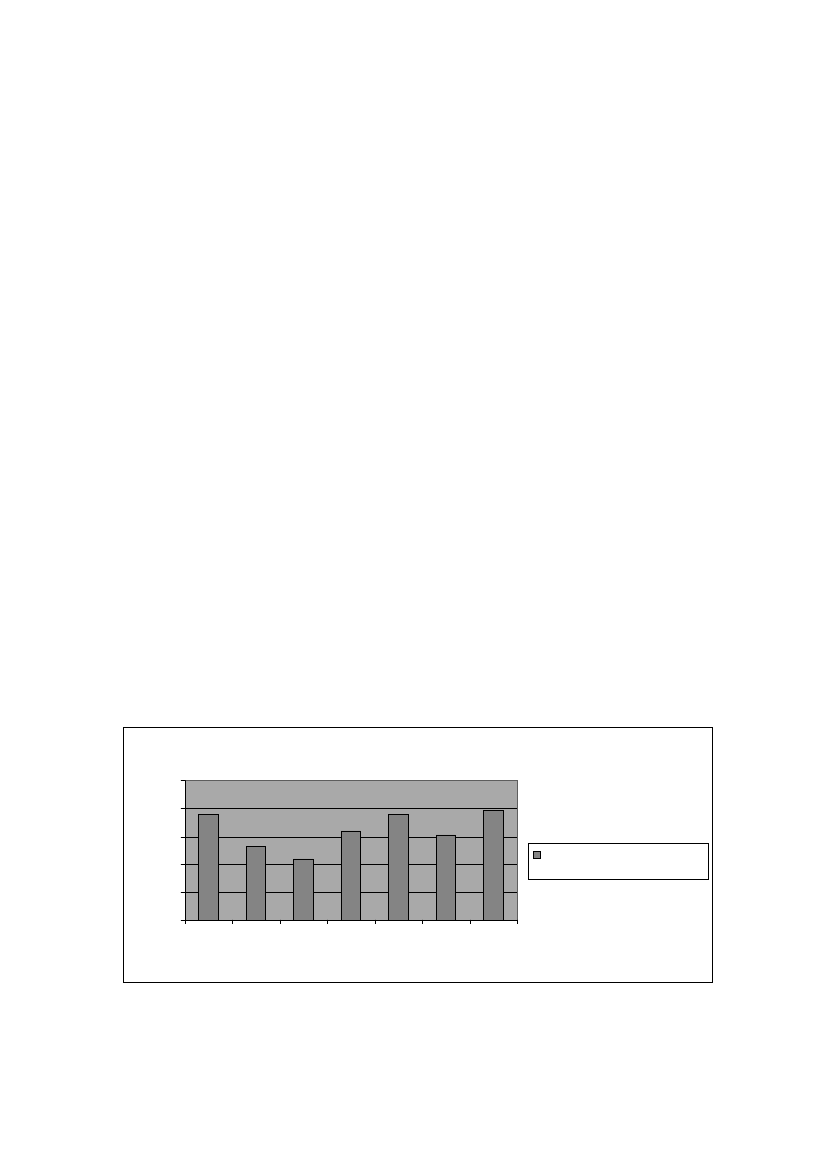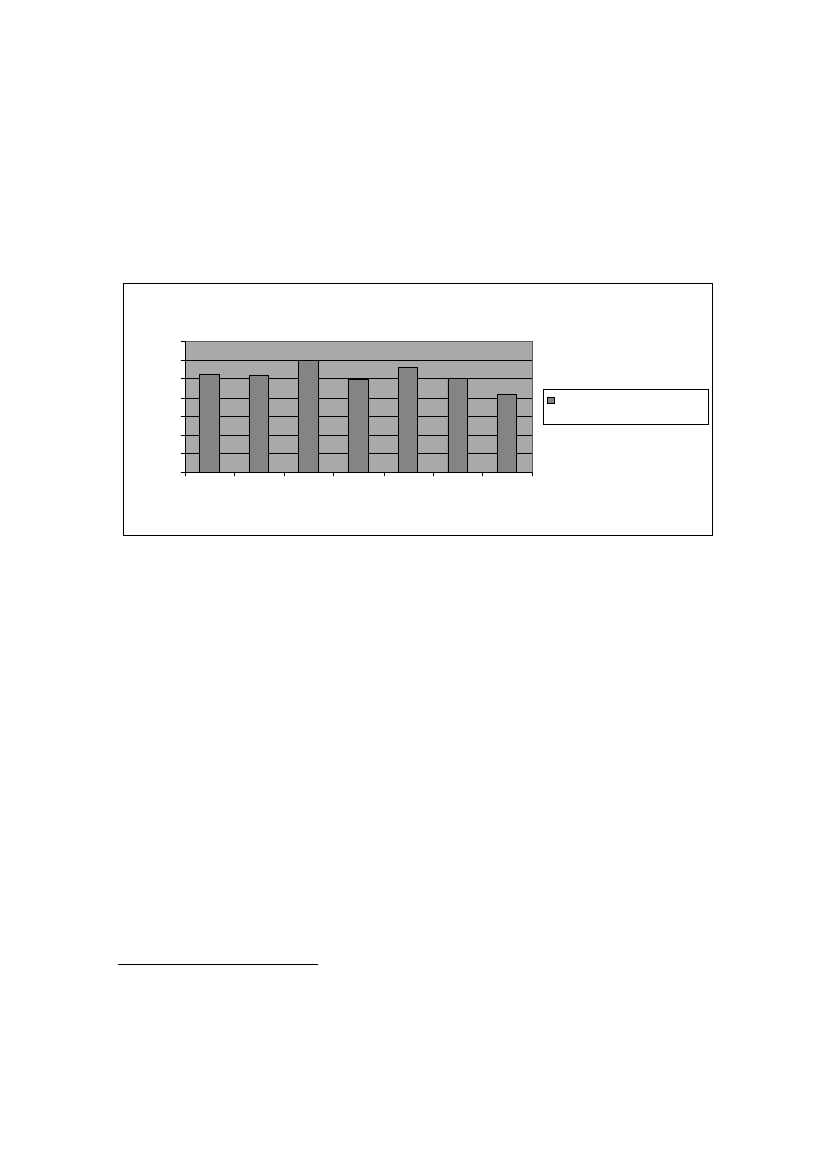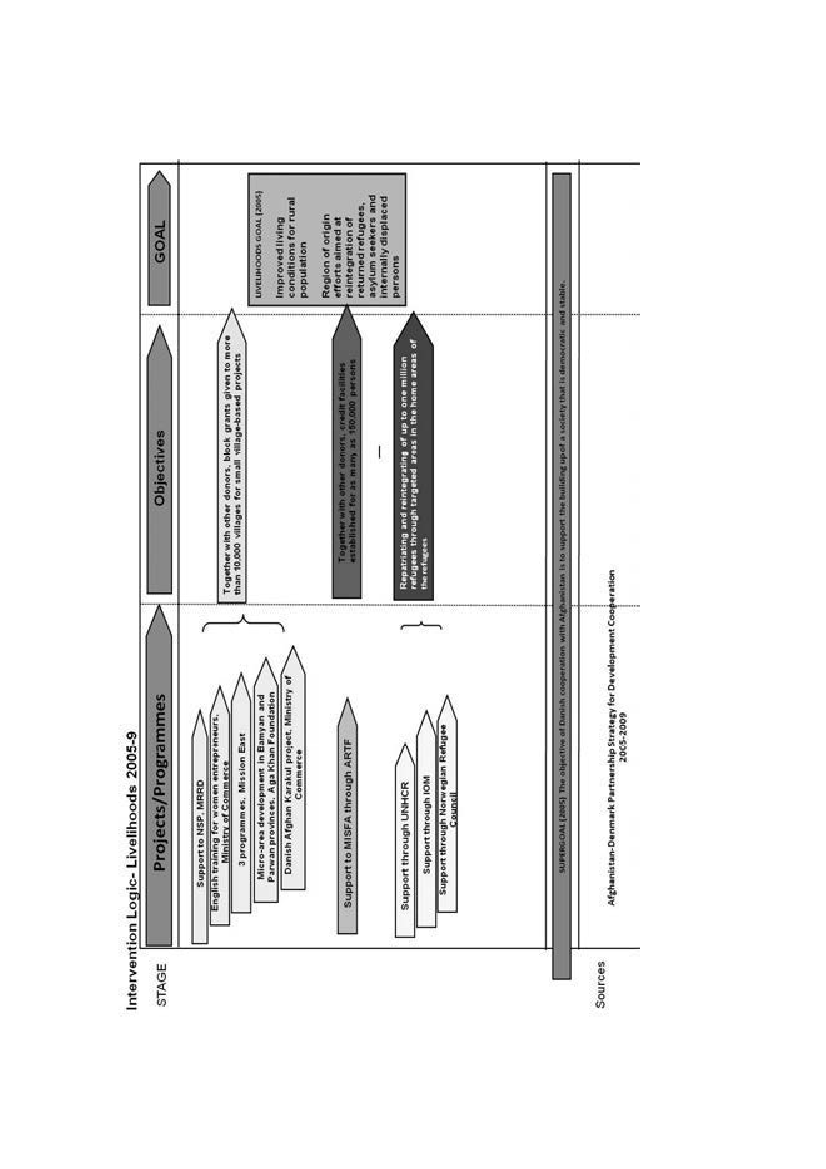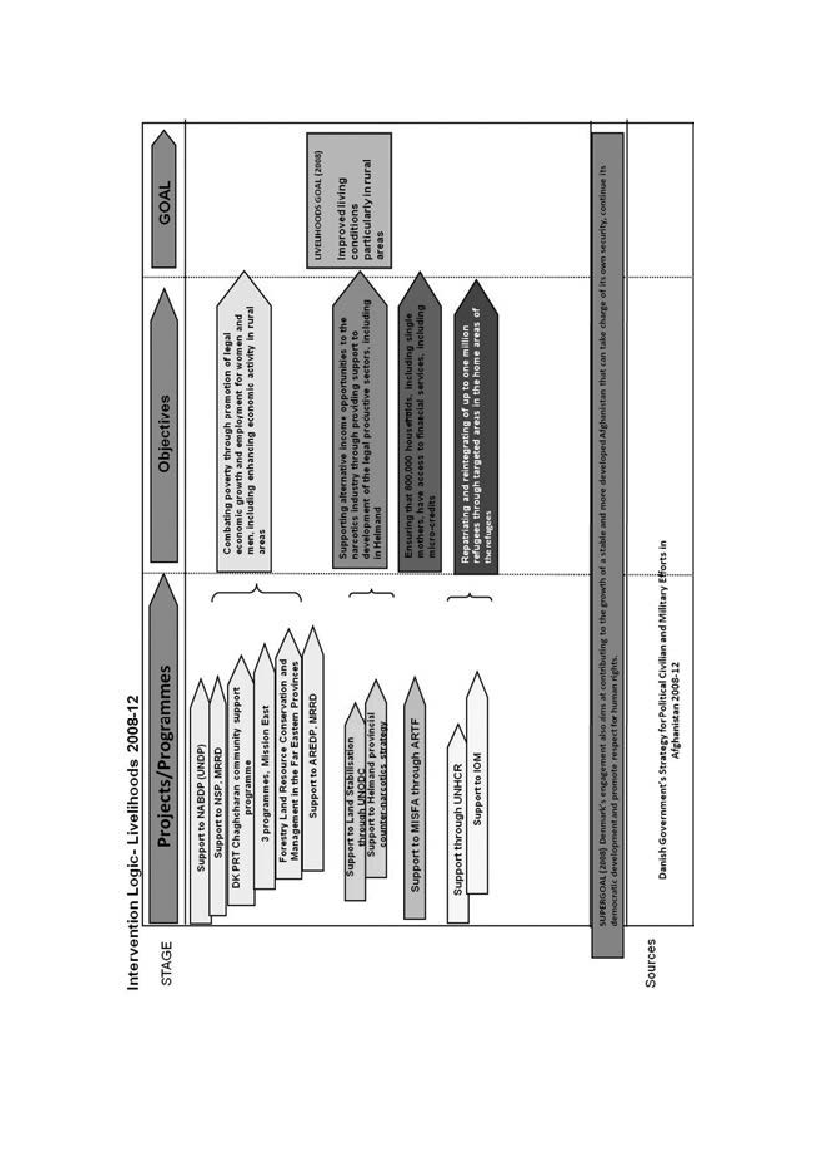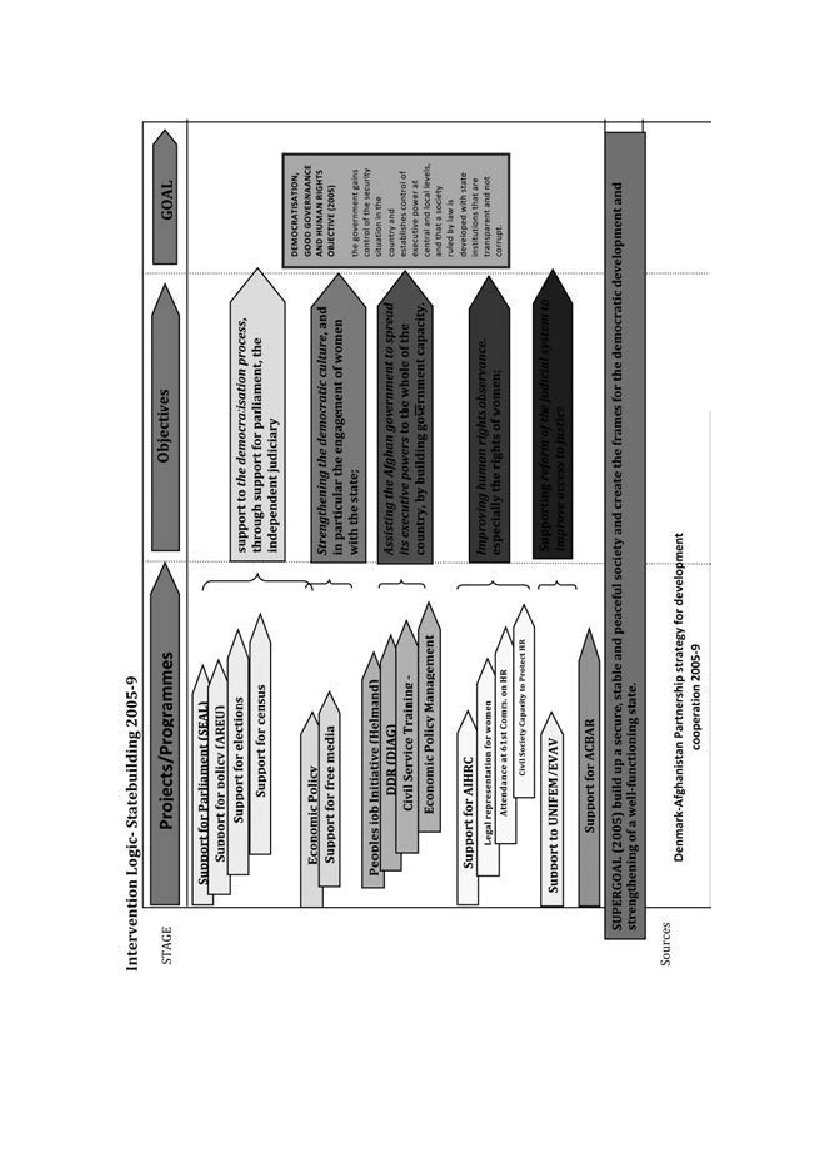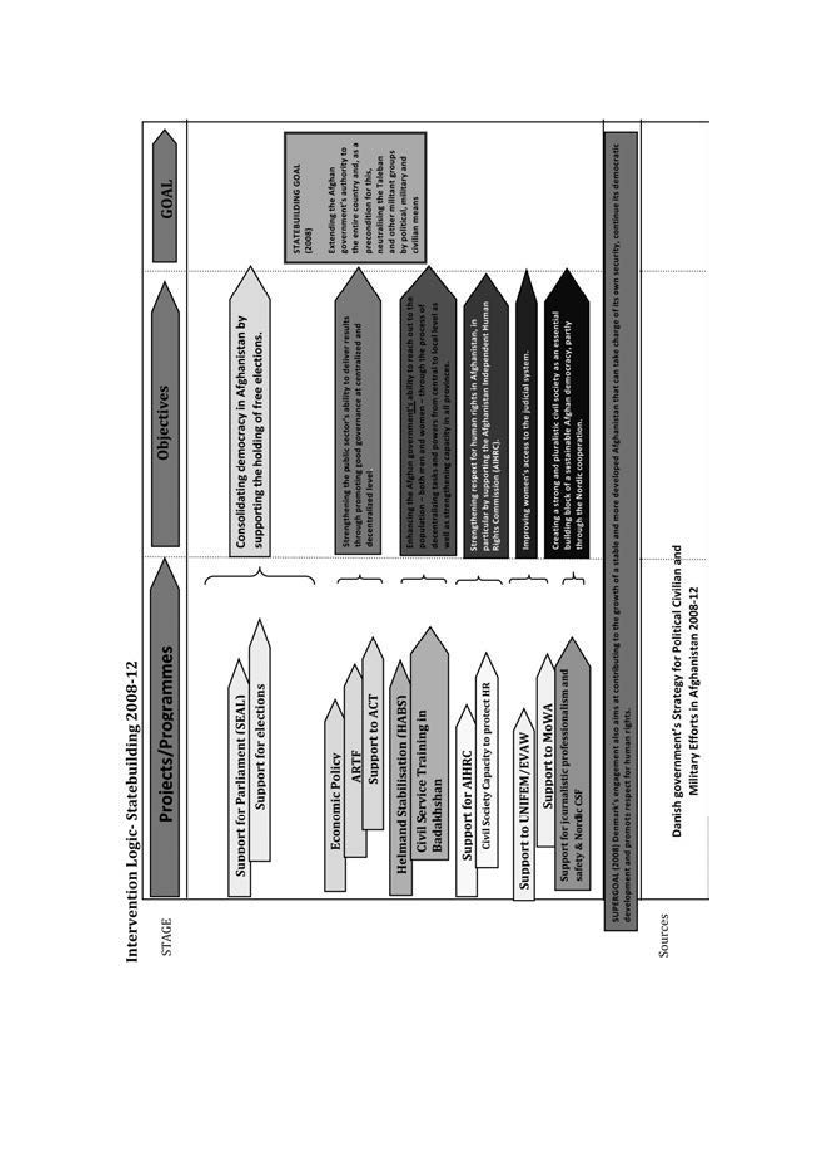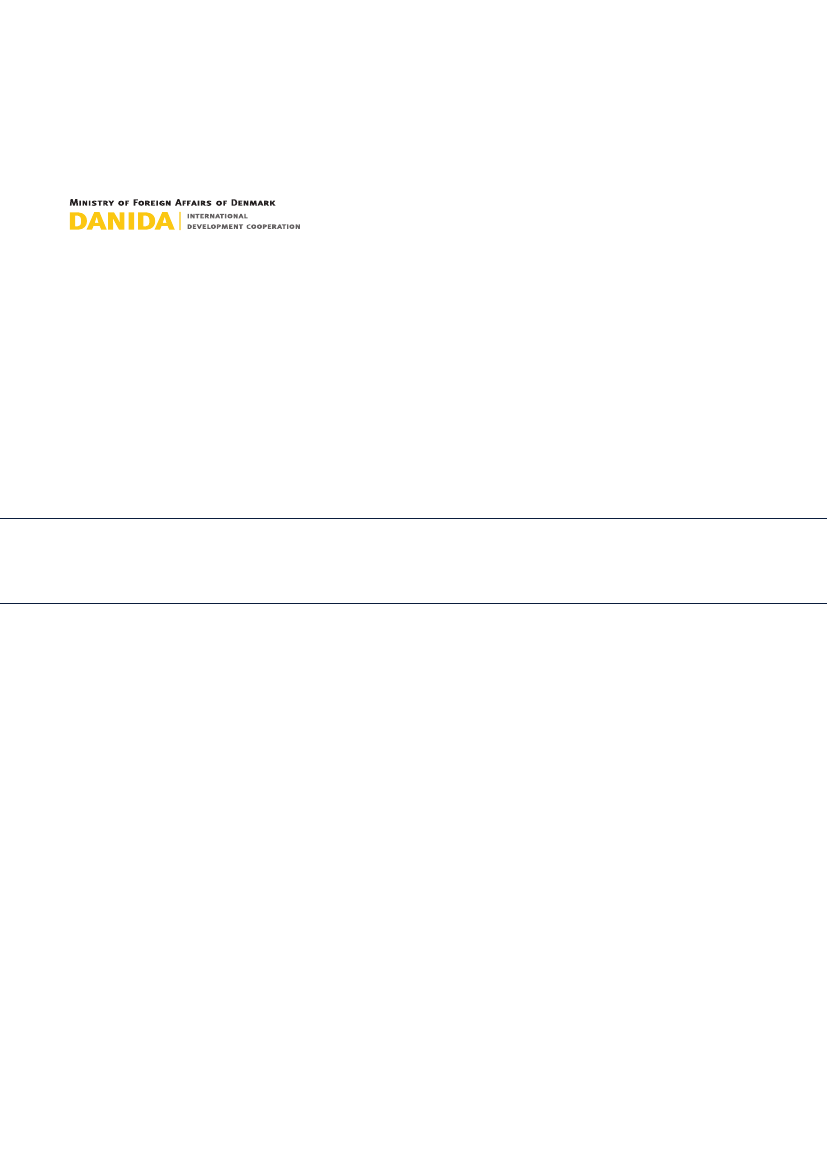Udenrigsudvalget 2011-12
URU Alm.del Bilag 236
Offentligt
EVALUATION OF DANISHDEVELOPMENT SUPPORTTO AFGHANISTAN
Evaluation
2012
Evaluation of Danishdevelopment supportto Afghanistan
Ministry of Foreign Affairs of Denmark
August 2012
� Ministry of Foreign Affairs of DenmarkAugust 2012
Production:Cover photo:Graphic Production:e-ISBN:
Evaluation Department, Ministry of Foreign Affairs of DenmarkFranz-Michael MellbinPh7 kommunikation, Århus978-87-7087-667-4
This report can be obtained free of charge by ordering from www.evaluation.dk or fromwww.danida-publikationer.dk.This report can be downloaded through the homepage of the Ministry of Foreign Affairs www.um.dk ordirectly from the homepage of the Evaluation Department www.evaluation.dk.Contact:[email protected]
The opinions expressed in this document represent the views of the authors, which are not necessarilyshared by the Danish Ministry of Foreign Affairs or other stakeholders.
ContentsPrefaceEvaluation of Danida Support to the Education Sector in AfghanistanEvaluation of the Danish Region of Origin Initiative in AfghanistanEvaluation Study:Danish support to statebuilding and improved livelihoods in Afghanistan
3
4
PrefaceOver the last decade, Denmark has provided substantial development support to thereconstruction of Afghanistan, with the main purposes of contributing to national, re-gional and global security as well as to poverty reduction. In Denmark, as well as in thedonor community in general, there is a wish to learn from the experiences with differenttypes of support to Afghanistan implemented through the last decade. Against this back-ground, the Evaluation Department in 2010 decided to initiate preparation of an inde-pendent evaluation of the Danish support to Afghanistan.Preparatory work for the evaluation established that the total disbursement of Danishdevelopment support to Afghanistan over the period 2001-2012 amounted to approxi-mately DKK 3.8 billion. Support during this period was mainly concentrated within fourthematic areas: (1) State-building, (2) Livelihoods, (3) Education, and (4) Regions ofOrigin Initiative (ROI) support.The preparatory work also found that support to state-building and livelihoods hadmainly been channeled through joint/pooled funding mechanisms covered by a consid-erable amount of existing reviews, studies and evaluations. EVAL therefore decided tocover these two thematic areas by means of an Evaluation Study comprising a desk basedreview of existing documentation. The review was conducted by Oxford Policy Manage-ment Institute (UK).The two other thematic areas – i.e. education and Regions of Origin (ROI) support inAfghanistan – had not to the same extent been covered by previous evaluation work. Inthese two areas of support, EVAL therefore decided to commission full evaluations, in-cluding both desk and field work.Field work for the two evaluations was conducted during the period from September2011 to March 2012 by independent evaluation teams selected through internationaltendering processes. The evaluation of support to the education sector was conducted bya consortium comprising Particip (Germany) and Niras (Denmark), while the evaluationof the ROI support was conducted by a consortium comprising GHK (UK) and tana(Denmark).The two evaluations and the evaluation study were supplemented by two additionalevaluation studies entitled Economic development and service delivery in fragile states(conducted by UN-Wider) and Effective statebuilding? A review of evaluations of inter-national statebuilding support in fragile contexts (conducted by German DevelopmentInstitute). These evaluation studies were published in Spring 2012 and are available atwww.evaluation.dkEvaluation DepartmentMinistry of Foreign Affairs/Danida
5
6
Evaluation of DaniDa Supportto thE EDucation SEctorin afghaniStan
Evaluation
2012.02
CH INA
AFGHANISTANMaryMu
64
Dary
�
mu
Darya
66
68��UZBEKISTAN
70
�
a-ye
72
�
Murgho74b
�
Te
A
QurghonteppaKerkiKiroyaKeleftAndkhvoy
(Kurgan-Tyube)
TA J I KI STA N
izrm
DustiRostaq
BADAKHSHANKhorughFayz AbadFayzabadJormEshkashemrmiPa
TURKMENISTANTedzhen
rgab
JAWZJAN
Jeyretan
Qala-I-Panjeh
Shiberghan Mazar-e-Sharif
Kunduz
KUNDUZTaluqanTaloqanKhanabadTAKHAR
Dowlatabad36
BALKHSari PulTokzarShulgarah
Kholm
�
BaghlanAybak
shgy
MaymanaQeysar
Gu
FARYAB
SAMANGAN
nar
GushgyTaybadTowraghondi
BADGHISQala-e-NawMorghab
Ku
SARI PULBAMYANBamyan
LAGH
Ha
rirud
HeratHirat
Karokh Owbeh
DowlatChaghcharanYar
BazarakMahmud-e-NURISTANRaqirunsKUNARChaharikarNPoKAPISAAsad AbadPARWANMehtarlamMA
dBAGHLANniHPANJSHER
FarkharDowshi
Ku
u
s
h
36
�
GilgitAFGHANISTAN
34
ruHa
FA RA HFaraharahF
Now ZadKajaki
Tirin Kot
ghAr
t
andab
32
T
Indus
shKha
Lashkar Gah
wd-e
NIMROZCheharBorjakHilmand
KANDAHARDeh Shu
Chaman
✈
30
Zahedan62
Map No. 3958 Rev. 7 UNITED NATIONSJune 2011
for administrative purposes the government has grouped afghanistan’s 34 provinces intothree main zones (from: 2008-09 EMiS School Summary report). these are shown in the tablebelow:Northern Mainland Afghanistan1.1 north Eastern afghanistan1.1.1Badakhshan1.1.2 Baghlan1.1.3 Kunduz1.1.4 takhar1.2 north Western afghanistan1.2.1 Balkh1.2.2 faryab1.2.3 Jowzjan1.2.4 Samangan1.2.5 Sare polCentral Mainland Afghanistan2.1 Eastern afghanistan2.1.1 Kunar2.1.2 laghman2.1.3 nangarhar2.1.4 nuristan2.2 central afghanistan2.2.1 Kabul2.2.2 Kabul city2.2.3 Kapisa2.2.4 logar2.2.5 panjshir2.2.6 parwan2.2.7 Wardak2.3 Western afghanistan2.3.1 Badghis2.3.2 Bamyan2.3.3 farah2.3.4 ghor2.3.5 heratSouthern Mainland Afghanistan3.1 South Eastern afghanistan3.1.1 ghazni3.1.2 Khost3.1.3 paktia3.1.4 paktika3.2 South Western afghanistan3.2.1 Daykundi3.2.2 helmand3.2.3 Kandahar3.2.4 nimruz3.2.5 urozgan3.2.6 Zabul
ISLAMIC
JammuandKashmir
�
HERA THIRA T-ShindandAnar Darreh
GHOR
DAYKUNDINililmHedan
MaydanShahrWARDAK
KABUL
Kabul
JalalabadMardanbeKhy
LOGARPul-e-Alam
NANGARHARPeywar PassrPass
34
�
Peshawar
IslamabadRawalpindi
REPUBLIC
Ghazni
GHAZNIQarah Bagh
GardezPAKTYA KHOSTKhost (Matun)SharanBannu
URUZGAN
Khas Uruzgan
PAKISTAN�
�
ZABULQalatnakarRo
PAKTIKAhraLu
Delara
m
Tank
32
OF
Kandahar
National capitalZhob
IRAN�
Zabol
Kadesh
Provincial capitalTown, villageAirportsInternational boundaryProvincial boundaryMain roadSecondary roadRailroad72
Zaranj
HILMAND
Spin Buldak
The boundaries and names shown and the designationsused on this map do not imply official endorsement oracceptance by the United Nations.Dotted line represents approximately the Line of Controlin Jammu and Kashmir agreed upon by India and Pakistan.The final status of Jammu and Kashmir has not yet beenagreed upon by the parties.
INDIAINDIA
QuettaGowd-eZereh
00
50
10050
15010070
200
250 km150 mi
30
�
�
64
�
66
�
68
�
�
�
74
�
Department of Field SupportCartographic Section
Evaluation of Danida Supportto the Education Sectorin Afghanistan
Ministry of Foreign Affairs of Denmark
June 2012
� Ministry of Foreign Affairs of DenmarkJune 2012
Production:Cover photo:Graphic Production:Print:ISBN:e-ISBN:
Evaluation Department, Ministry of Foreign Affairs of DenmarkFranz-Michael MellbinPh7 kommunikation, ÅrhusRosendahls - Schultz Grafisk978-87-7087-644-5978-87-7087-645-2
This report can be obtained free of charge by ordering from www.evaluation.dk or fromwww.danida-publikationer.dk.This report can be downloaded through the homepage of the Ministry of Foreign Affairs www.um.dk ordirectly from the homepage of the Evaluation Department www.evaluation.dk.Contact:[email protected]
The opinions expressed in this document represent the views of the authors, which are not necessarilyshared by the Danish Ministry of Foreign Affairs or other stakeholders.
Table of ContentsAcknowledgementsExecutive Summary1Introduction1.1 Background to the evaluation1.2 Structure of the report1.3 MethodologyEducation in Afghanistan2.1 The cultural context2.2 The development of education2.3 The administration of education2.4 Education and society2.5 Education and conflict2.6 The futureDanish support to the education sector in Afghanistan 2003-103.1 Danish aid to Afghanistan before the 2000s3.2 Danish assistance to education from 20013.3 Implementation modalitiesThe activities and objectives of other development partners inthe education sector in Afghanistan4.1 Introduction4.2 Principal donors in educationFindings on Danish support to the education sector inAfghanistan 2003-105.1 2001-03 The baseline situation5.2 2003-06 Primary Education Programme Support (PEPS)5.3 2007-08 Extension of PEPS5.4 2008-10 Further extension of PEPS5.5 Overall performance on extensions 2007-105.6 2010-13 Education Support Programme to AfghanistanOverall assessment and conclusions6.1 Evaluation Criterion 1: Relevance6.2 Evaluation Criterion 2: Effectiveness6.3 Evaluation Criterion 3: Efficiency6.4 Evaluation Criteria 4/5: Sustainability and ImpactRecommendations and lessons learned59242424253232323334363941414245484848525256717882849696101108113118
2
3
4
5
6
7
3
Table of Contents
AnnexesAnnex A Terms of ReferenceAnnex B List of informantsAnnex C List of documents consultedAnnex D Organogram of the Ministry of EducationThe following annexes to the Evaluation Report can bedownloaded from www.evaluation.dkAnnex EAnnex FAnnex GAnnex H
121121132137148
Education sector aid programmes and projects 1388 (2009)Donor assistance to education over the period covered by the evaluationList of feedback session participants in KabulCase studies
4
AcknowledgementsThe evaluation was led by George Taylor and included Henrik Jespersen, Leo Schellek-ens, Ahmad Parwiz Yosufzai, Habiba Wahaj and Nazifa Aabedi. Project management wasprovided by Anchoret Stevens and Beatriz Bohner, and quality assurance by Georg Ladjand Gunnar Peder Jakobsen. Additional support for the evaluation was provided by EricSarvan and Tino Smail.The evaluation team would like to express their gratitude to representatives of the Gov-ernment of Afghanistan especially those in the Ministry of Education who generouslygave their time to the evaluation, the Danish Ministry of Foreign Affairs, the Royal Dan-ish Embassy in Kabul, the members of the Reference Groups and all others who providedvaluable input in one form or another during discussions, interviews, meetings or provin-cial visits.
5
List of abbreviationsADBAFANDSAPEPARTFCIDACNADACDACAARDAARTTDEDDfIDDKKDOFDPECEECGEFAEIPEMISEQUIPESPAESWGEQEQIPEUEVALFDGFTIGDPGIZGMUGPEHDIHRDBIDPIIEPINEEInSeTISDISAFJICALEGLTTAMDGMDUMFA6Asian Development BankAsia FoundationAfghanistan National Development StrategyAfghanistan Primary Education Program (World Bank)Afghanistan Reconstruction Trust FundCanadian International Development AgencyADB’s Comprehensive Needs AssessmentDevelopment Assistance CommitteeDanish Committee for Aid to Afghan RefugeesDanish Assistance to Afghan Rehabilitation and Technical TrainingDistrict Education DepartmentDepartment for International Development (UK Government)Danish KronerDepartment of FinanceDevelopment PartnerEarly Childhood EducationEducation Consultative GroupEducation For AllEducation Interim PlanEducation Management Information SystemEducation Quality Improvement Program (World Bank)(Danish) Education Support Programme to AfghanistanEducation Sector Working GroupEvaluation QuestionEducation Quality Improvement ProjectEuropean UnionEvaluation Department,Focus Discussion GroupFast Track InitiativeGross Domestic ProductDeutsche Gesellschaft für Internationale ZusammenarbeitGrant Management UnitGlobal Partnership for EducationHuman Development IndexHuman Resource Development BoardInternally Displaced PersonInternational Institute for Educational PlanningInter-Agency Network for Education in EmergenciesInservice TrainingInfrastructure Development Services DepartmentInternational Security Assistance ForceJapan International Cooperation AgencyLocal Education GroupLong Term Technical AssistanceMillennium Development GoalsMaterials Development UnitMinistry of Foreign Affairs of Denmark
List of abbreviations
MoEMoFMoHEMTNATONDFNESPNGOOECDP&GPARPEDPEPSPIUPRAPRDCPRRPRTQAQRFRBMRDEREURIMUROIRRASBSSidaSQSTTATATEPTLToRTRCTRTTTCTVETUNUNESCOUNHCRUNICEFUPEUSAIDWFPWHODanida
Ministry of EducationMinistry of FinanceMinistry of Higher EducationMaster TrainersNorth Atlantic Treaty OrganisationNational Development FrameworkNational Education Strategic PlanNon-Governmental OrganisationOrganisation for Economic Cooperation and DevelopmentPay & GradePublic Administration ReformProvincial Education DirectoratePrimary Education Programme SupportProject Implementation UnitParticipatory Rural AppraisalProvincial Reconstruction Development CommitteePriority Restructuring & ReformProvincial Reconstruction TeamQuality AssuranceQuick Response FundResults Based ManagementRoyal Danish EmbassyResearch and Evaluation UnitReform Implementation Management UnitRegions of Origin InitiativeRapid Rural AppraisalSector Budget SupportSwedish International Development Cooperation AgencySub-evaluation QuestionShort Term Technical AssistanceTechnical Assistance/Technical AdvisorsTeacher Education ProgramTeam LeaderTerms of ReferenceTeachers’ Resource CenterTeachers’ Resource TeamTeacher Training CollegeTechnical and Vocational EducationUnited NationsUnited Nations Educational, Scientific and Cultural OrganisationUnited Nations High Commissioner for RefugeesUnited Nations Children’s FundUniversal Primary EducationUnited States Agency for International DevelopmentWorld Food ProgrammeWorld Health OrganisationThe Danish aid administration until the 1990s, but now a collective termfor the development activities of the Danish Ministry of Foreign Affairsrather than a separate entity.
7
List of abbreviations
Exchange Rates (November, 2011)1 Euro = 7.44 Danish Kroner (DKK)1 Euro = 1.42 United States Dollars (USD)1 DKK = 0.19 USD (However, actual exchange rates are used in the report)Afghan Calendar:1382 = 2002 - 20031383 = 2003 - 20041384 = 2004 - 20051385 = 2005 - 20061386 = 2006 - 20071387 = 2007 - 20081388 = 2008 - 20091389 = 2009 - 2010
8
Executive SummaryBackground to the evaluationBetween 2003 and 2010 Denmark disbursed Danish Kroner (DKK) 431 million foreducation in Afghanistan mainly through bilateral programmes, including in Helmand,but also through other channels, e.g. the Afghan Reconstruction Trust Fund (ARTF)1.To learn from the experience the Evaluation Department of the Danish Ministry of For-eign Affairs (EVAL) commissioned the current evaluation. The main purposes are to as-sess Denmark’s contribution and to assist the continued improvement of Danish support.The objectives are to assess strategy, implementation and results and to identify conclu-sions, lessons learned and recommendations. The evaluation has used the DAC evalua-tion criteria of relevance, effectiveness, efficiency and sustainability, taking into consid-eration the context, including the security situation, in which the support is provided.The evaluation was conducted from mid-2011 to early 2012. It was planned to includefour phases: i. Preparation and fact finding; ii. Desk study; iii. Evaluation visit and fieldstudies; and iv. Final data analysis. Arrangements were made for a further documentsearch and a visit to Kabul and Helmand province. Results of the additional work havebeen incorporated into the evaluation report.
MethodologyDanish support policy, as exemplified in the programme documents, was to workthrough and strengthen host institutions, using an ‘on-budget’ modality. This approachrelied on regular, documented results to guide joint programme management by theMinistry of Education (MoE) and the Royal Danish Embassy (RDE). Planning andmodifying activity would specify outputs and programme outcomes. Immediate resultswould feed into next steps in the management process, keeping ownership with the MoEand raising capacity.The approach taken by this evaluation also relies on documented results. Consistent withthe logic of the support programme it draws on Results Based Management (RBM), astrategy focusing on outputs, outcomes and impacts. The evaluation seeks to show thelinks between what was planned, what was carried out (inputs) and the immediate results(outputs), and the eventual broader outcomes. Where possible it also points to longer-term impact.Documentation for programme management and evaluationEssential tools for all programmes were the Annual Work Plans and Budgets, whichwould guide each cycle. The fragile situation and weak capacity meant managementwould be a challenge. This was the risk inherent in the support strategy. To mitigate this,flexibility in resource allocation was a central part of the design, therefore, and docu-mented Annual Reviews were to inform the feedback loop (e.g. PEPS 1 Programme1Note: References have been kept to a minimum in this Executive Summary. Full details of quotedsources are given in the main text or in footnotes in the report. A list of the main documents con-sulted is given in Annex C.
9
Executive Summary
Documents, para 6 and para 41). Programme documents detail the roles of the GrantsManagement Unit (GMU) and the Steering Committee in using annual and quarterly pro-gress reports, monitoring, accounts and audits to monitor progress and make decisions. Thelogic, as stressed by Programme Documents, was that this would strengthen capacity, notonly to manage Danida’s programmes, but for the education system in general.The GMU was also to be a magnet and coordination mechanism for other DevelopmentPartner (DP) programmes. The logical assumption was that as efficiency and effectivenesswere demonstrated, other donors would provide funding through government systemsfollowing Danida. Danish aid was to be a “test case” (term used in the Programme Docu-ments) to encourage harmonisation and alignment. Thus documentation was fundamen-tal to management and aid effectiveness.Management as central to Danida’s modalityThe modality also assumed that use of the Afghan public administration (a Ministry ofFinance (MoF) account for Danish funds with earmarking of programme components)and MoE service delivery would contribute to national reconstruction. In particular, themodality relies on development of a strong monitoring framework. Popular participa-tion in governance to increase stability in a very fragile situation was also a broad aim.National policies linked to local activity were to build confidence in Government. Theseincluded community participation in location of schools, promoting access to educationfor girls, training for female teachers and students, school management, etc. The Afghanand Danish Governments explicitly linked national policy and local realisations as ameans of nation-building.A fundamental aspect of Danida’s support model was the implementation of a two trackdevelopment approach, i.e. to attend not only to local, emergency intervention, butalso to long-term systems and policy development. Sustainability and ownership by theAfghan Government as well as collaboration with other donors would be built on docu-mentation of shared strategy.In sum, management mechanisms with documented outputs (accounts, reviews, min-utes, reports, plans, etc.) were foreseen as the basis of Danish support and continue to beessential for programme management and for broader system development. They permit,flexible budget allocation (inputs) in response to need as it becomes clearer, as data andreduced levels of conflict allow this to be specified; they provide a means to manage thefunding risk, through transparency and accountability; at the level of outcomes they sup-port confidence-building in government systems among other donors and the Afghanpublic, and they link immediate, local action to long-term national strategy, and buildsustainable capacity in MoE and government departments.Evaluation approach and constraintsSimilarly, the evaluation itself depended heavily on written records. Security and time didnot permit direct observation or statistical sampling of programme results. Interviews andvisits allowed only an impression of the Afghan education system, although fact-findingand field visits in 2011 and 2012 included a mix of urban and rural areas in different re-gions with experience of different ethnic groups. During these visits informants at MoE,provincial and district education offices, schools, communities and teacher training col-leges (TTCs) were interviewed; girls’ schools were visited and issues of marginalisationdiscussed. Representatives of key NGOs and DPs were met (see Annex B). The interplaybetween education support and security issues in Helmand and elsewhere was discussed.10
Executive Summary
During the 2011 field mission schools were sitting national exams, meaning little obser-vation of structured teaching or use of books or materials was possible. Data collectionbased on the evaluation questions (EQs) and sub-questions (SQs) provided in the Termsof Reference (ToR), were used in the field mission. However, data on many indicators wasnot available (e.g. net and gross enrolment ratios (NER) and (GER), numbers of qualifiedteachers by year, etc.). Other constraints matched those for programme management:• Frequent changes of staff in Government and DPs and weak institutional memo-ry;• • • • • Lack of continuity between international staff, including technical assistance (TA);Donor projects (including military) operating in the same technical area;Weak individual, institutional and data management and administrative capacity;Frequent reorganisation in Afghan government institutions;Changing patterns of security and stability throughout the country.
The evaluation, moreover, covered a period of more than 10 years. Technical and man-agement reports covered a lengthy and unstable period. However, a comprehensive data-base of over 800 documents was assembled and largely formed the basis for the evalua-tion.
Education in AfghanistanThe cultural contextThe Islamic tradition has permeated Afghan society and religious leaders have influencedcommunity life, including educational development. Education indicators have alwaysbeen low (literacy has never risen above 25%) and the central state’s role in provision hasbeen limited. In 1979, when the Soviets invaded, the literacy rate was 18% for males and5% for females.This period was followed by two decades of conflict when 80% of school buildings weredestroyed and qualified teachers were killed or left the country. After Soviet occupationin 1989 factional fighting between Mujahedeen parties delayed reconstruction. In 1993,NGOs assisted 1,000 of the 2,200 schools. 90,000 Afghan children were supportedin refugee camps in Pakistan. Between 1996 and 2001, the Taliban took control andbanned female participation in education. Only limited services were provided by MoE,which by 2001 needed to be rebuilt from scratch.Provision has greatly improved with support from donors including Denmark. Accord-ing to MoE, more than 7 million children are enrolled, (39% or 2.7 million girls); usableclassrooms were increased from fewer than 1,000 in 2002 to over 71,000 in 2010; thereis an eight-fold increase in teacher numbers; over 8,500 school Shuras (community edu-cation committees) have been established, and there is a Provincial Education Depart-ment (PED) in each of the 34 provinces.
11
Executive Summary
Education and societyThe socio-economic and political situation varies within the 34 provinces. GDP hasgrown since 2003/04 at an average of 9.1% p.a., though with high volatility. In 2010/11international aid was about USD 15.7 billion, or about the same size as nominal GDP.Afghanistan has made notable progress on some Human Development Index (HDI) in-dicators. In 2011 48% of the population had access to clean water, i.e. double 2007/08figures; 72,500 women are attending 2,900 literacy centres. Education is a basic right forall children. The country is committed to Education for All (EFA) and the MillenniumDevelopment Goals (MDGs), with a revised target date of 2020. However, it remainsamong the poorest countries in the world (HDI ranking 172 of 187).Education and conflictEducation is a means of building stability and is free of charge. However, continued vio-lence undermines protection and almost 50% of the population is insecure. This limitsservice delivery.According to the Asia Foundation (AF), access to education and widespread illiteracywere the biggest problems for women in 2011, but security, peace and education inter-act in a complex manner. Stakeholders have a range of interests, capacities and motives.Government legitimacy continues to be challenged and links between Government andpeople depend on central and local structures. The state is only slowly becoming animportant part of people’s lives. Danish support to education in Afghanistan recognisesthat where donor support is outside the Government it undercuts state capacity andmay reduce legitimacy. Moreover, in areas where international military and PRTs pro-vide assistance, schools may be more vulnerable to attack precisely because they havebeen constructed by foreign forces. Some donors have begun to address this throughbroader approaches, at least within education, and recent reports indicate the Talibanand Government are finding common ground, though progress is vulnerable to fre-quent setbacks.
Brief overview of Danish supported areas in educationThe two tables below provide a summary of Danish support from 2003 to the present,showing the programme components supported with amounts, by period, and the mainmodalities. It will be noted that the current programme budget represents a substantialincrease in funding (2003-10, USD 50.5 million; 2010-13, USD 60 million). The pro-gramme components supported in 2003 included Curriculum development, Construc-tion, Teacher training, Textbooks and Management including aid management. Apartfrom construction, funded separately through the NGO Danish Assistance to AfghanRehabilitation and Technical Training (DAARTT), and some funding through the ARTF,Danish support used an on-budget modality.Over the whole period there is a broadening of scope (to include all education grades1-12) and reduction in earmarking, aligning with Afghan strategic planning for educa-tion as set out in the Education Interim Plan (EIP). This reflects Danish developmentguidelines and strategy. Support for education in Helmand was specifically included from2008.
12
Executive Summary
Table 1Programme
Programmes and budget allocations2Agreement date4.12 2003Years2003-06(Extendedto March 2007)2007-082008 onwards2009-10DKK110.0 millionUSD215.7 million
Primary EducationSupport Programme(PEPS 1)Extension (includinggrades 1-12)Helmand Schools andDormitoriesExtension of funding foreducationTotal 2003-10Education SupportProgramme toAfghanistan (ESPA)Total incl. (ESPA)
17.5 200719.11 2008??
72.0 million34.2 million92.5 million308.7 million
12.6 million6.0 million16.2 million50.5 million60 million
2010
2010-13
340 million
648.7 million
110.5 million
Source: Programme documentation and meetings during the evaluation mission.Table 2Summary of programme components 2003-103Primary EducationSupport Programme(PEPS)2003-061-6XXXXXXXXXXXXXExtension of Danishsupport to Educationin Afghanistan2007-081 - 12Hel-mand2008-??1 - 12Extension of fund-ing for education2009-101 - 12
Component*
GradeCurriculumConstructionTeacher trainingText BooksEducationadministrationHelmandMultilateralassistance
During the period Danida provided multilateral funding (in 2009 at leastthrough the ARTF) earmarked for teacher salaries3Danida also supportedUNICEF’s “Back-to-School-Campaign” in 2002.
23
USD 1= DKK 7.00 in 2003 and DKK 5.70 for the remaining years.Letter from WB to RDE, January 2009.
13
Executive Summary
Component*
Primary EducationSupport Programme(PEPS)2003-06Covered by a separatecontract signedbetween Danida andDACAAR/DAARTTfor construction ofschools.
Extension of Danishsupport to Educationin Afghanistan2007-08Covered by aseparate contractsigned betweenDanida andDACAAR/DAARTTfor construction ofschools
Hel-mand2008-??
Extension of fund-ing for education2009-10In 2009 DAARTTwas contractedfor an acceleratededucations projectfor Danida fundedfrom the bilateralsector support foreducation.
Assistancethrough NGOs
*Capacity Development: Staff training, institutional and professional development are explicitlymentioned as priorities or under implementation arrangements (with budget in PEPS) in allcomponents from 2003 onwards (including in current ESPA documents). Capacity developmentwas the principal element in the Education Administration component.
Source: Programme documents.
The activities and objectives of other development partners in AfghanistanIn 1990 NGOs and UN agencies supported 70% of Afghan schools with teacher salaries,training, student supplies, and textbooks. In 2001 the new development agenda attractedinternational organisations and NGOs and increased the need for coordination.Principal donorsDetails of donor contributions are given in Annex F (can be found on www.evaluation.dk). Inaddition, a 2009 report listed the principal donors with the United States Agency for Interna-tional Development (USAID) as the largest bilateral, contributing USD 97 million directly(almost USD 300 million in total) for education over the decade. The Embassy of Japan andJICA were also major contributors with the multilateral agencies (World Bank (WB), AsianDevelopment Bank (ADB), and United Nations (UN) agencies, including the World FoodProgramme (WFP)) also providing very substantial sums. Danida, Canadian InternationalDevelopment Agency (CIDA), Swedish International Development Cooperation Agency(Sida) and German aid, (Deutsche Gesellschaft für Internationale Zusammenarbeit (GIZ))were the major contibutors bilaterally after USAID. Few donors have provided funds throughGovernment via MoF. While others use MoE systems, they contribute little directly to sup-port MoE’s control of sector resources. In this sense Danida’s approach is unique. USAID andthe United Kingdom’s Department for International Development (DfID) also implementeducation programmes in Helmand through the PRT. WB manages the largest donor pro-gramme in the MoE with three components under the ARTF, all on-budget:• the World Bank’s Education Quality Improvement Program (EQUIP) – basic and secondary education• • Technical/Vocational trainingHigher education
The 10 ARTF donors have provided USD 88 million for EQUIP I and II, covering Gen-eral Education, Teacher Education and Working Conditions, Education Infrastructure14
Executive Summary
Rehabilitation and Development. PRTs, funded primarily by the Provincial Reconstruc-tion and Development Committee (PRDC) and Quick Response Fund (QRF) underISAF, also support the sector.
Achievements of Danish support to education in Afghanistan 2003-10Achievements are summarised for three periods of programme support. It was expectedthat inputs would take time to show progress and that sustainable results would not beestablished in one three year programme, but that periods of support would strengthenearlier gains. This has been the case with a remarkable expansion in education provisionin Afghanistan over the past decade with an increase of schools under MoE ownershipby approximately 10,000 (in 2002, there were 3,400 schools in MoE ownership and in2010 the MoE reported owning 13,363 schools; including 12,421 general education and626 islamic education), recruitment and training of 93,000 new teachers, printing ofmillions of textbooks based on a new curriculum and significantly strengthened manage-ment capabilities. Denmark has made a major contribution to this progress.Overall performance of PEPS 1Between 2003 and 2006 the Afghan education system expanded substantially. Accessimproved dramatically through the construction of 1,424 primary schools and class-rooms. Quality was addressed through a new curriculum, printing millions of books andby greatly expanding teacher provision. These outcomes relate to Danida’s programmeoutputs: building 21 schools, rehabilitation of the Curriculum Development Centreand contributions to writing the primary curriculum and textbook printing. Danida’smanagement inputs were documented and the whole programme budget was disbursedmaking use of in-built flexibility. The on-budget modality, management controls and ear-marking allowed spending to be monitored with evidence of ownership and responsive-ness to need in terms of inputs.The evidence shows that, through a very unsettled period in the establishment of theAfghan MoE, Denmark contributed significant and much appreciated support. Theonly other programme to use direct funding, EQUIP, which became effective in July2004, was in problem project status before June 2006. These are important achievementsagainst considerable obstacles.However, recognition of great progress in Afghan education and the Danish contributionmust be tempered by acknowledgement of differences between planned interventions and theactual experience of support. Budget disbursement and management were not as planned.Management, through the Steering Committee (the GMU did not function), relied heav-ily on Danida TA. Flexibility was anticipated, but variations from programme plans weremarked, and reasons not always documented. Inputs and activities were recorded, but thereare limited records of outputs especially in the areas of system and policy development.Spending was very largely on printing books (twice the original allocation and three times thatspent on all other components), and yet there was no book distribution system. For this pe-riod there are no central records of how many of the books printed with donor support actu-ally reached the schools. Systems for sustainable printing and distribution were only discussedat the end of 2006. Plans for capacity development and coordination of construction werenot addressed. Danida’s planned contribution to teacher training was reallocated. Immediateneeds tended to crowd out systems rather than operating an expected two track approach.
15
Executive Summary
For these reasons overall programme relevance is evaluated as good, though effective-ness and efficiency are moderate. Sustainability took longer to emerge. It is too early toevaluate performance in terms of impact. Limited records of outputs make contributionanalysis difficult. That Danida supported improved outcomes in access and quality areasis clear. Its overall contribution, however, was not as anticipated. Individual programmeoutputs where documented show marked differences from original plans.Overall performance on extensions 2007-10During the following period the Afghan education system continued to expand ac-cess and to address quality issues. By 2008 there were almost 8,000 more schoolsand 6 times as many enrolled students compared to 2001. 87 million textbooks wereprinted in the period and teacher and education administration staff reached almost170,000 (from 64,000 teachers in 2001). In 2008 also MoE produced the first Edu-cation Management Information System (EMIS) report, showing improved capacityfor planning and management. The Ministry was gradually able not only to gatherand present data at provincial level, but also to begin analysis of quality issues as wellas access. Recorded Danish aid outputs for the period include: Completion of 72classrooms by August 2009 with a further 130 classrooms almost finished by the endof 2010; contribution to textbook printing and some attention to distribution prob-lems.In general, records for Danish programme outputs are scarce for this period. As shown,Afghan education outcomes improved substantially and Danida clearly contributed.Budget disbursement and achievement of outputs are not reported in any detail. Howev-er, as far as can be seen, the funding modality functioned reasonably well in very difficultcircumstances in Afghanistan. Aid effectiveness and management improved somewhatalso, with ARTF acting as a donor coordination forum. The Education DevelopmentBoard (EDB) and subsequently the Human Resource Development Board (HRDB) andWorking Groups began to meet in late 2008. Danida has been active in the HRDB, andwas co-chair from May 2010 to 2011.However, it is less easy to see where Danish programme inputs occurred until SteeringCommittee Meetings resumed in late 2009. Improvements in management capacity atthe level of policy, strategy and systems are seen from later evidence from school surveys,staff management, etc. Danida contributed to reforms in these areas. Achievements inmanagement and aid management were slower to emerge than expected. Fragmentationof inputs was reportedly still a problem in 2009, and the capacity to formulate commonplans and provide objective feedback on performance (outputs) was still weak, meaningintended programme outputs were still highly relevant.Analysis of Danish contribution to overall system outcomes is harder than for the previ-ous period, therefore. 2008 and 2009 Danida reports draw attention to this problemand issues began to be addressed from late 2009 when Steering Committee meetings re-sumed, documentation improved and monitoring of TA workplan outputs began.
Education Support Programme to Afghanistan (ESPA) from 2010From March 2010 Denmark began a three-year programme worth DKK 340 million(approximately USD 60 million) to support Government’s Afghan National Develop-ment Strategy (ANDS) and what would become the NESP/Education Interim Plan16
Executive Summary
2011-13. Danish support is provided under the Education Support Programme for Af-ghanistan (ESPA) April 2011-13. Under the Danish Helmand Plan (2011) 15% of thedevelopment support is for Helmand.ESPA provides direct support to MoE budgets and plans with TA and capacity devel-opment. The ESPA Programme Document lists five EIP priority programmes. Theyinclude, i. General and Islamic education; ii. Curriculum development and teacher edu-cation; iii. TVET; iv. Literacy; v. Education governance and administration. Due to thelimited implementation period this evaluation covers only a limited analysis of ESPAfocusing on links and follow up from PEPS, etc.The largest budget item in EIP is Construction, also the most seriously underfunded.However, a recent (Danida-funded) report has improved the basis for MoE policy de-velopment in this area, coordination of inputs, setting of targets, standards, etc. EMISreports the number of classrooms in 2009 was 71,592. The projected need was 127,253,rising to 144,191 in 2011. The relevance of support is still clear.There is growing confidence in government systems. In addition to improved access(through construction) quality continues to improve through materials provision andteachers. MoE capacity to estimate need with increasing accuracy is a significant achieve-ment and Danida supports this area through TA and funding of training. However,programme documents emphasise continued monitoring of progress in areas of ongoinginterest, using MoE systems.The demand for teachers remains very large (EMIS records a shortfall of 131,929 in2009) despite progress. The proportion of female teachers has risen, from 28% of thetotal in 2006 to 52% in 2011. Several training initiatives continue. Danida’s interest re-mains in improved programme coordination, systems for measuring and increasing learn-ing, and improved efficiency.The Steering Committee is still responsible for management of ESPA using EIP workplans as“the primary references”with clear annual targets according to programme docu-ments. The stated intention, following the strategy for earlier interventions, is to reportoutputs and outcomes not activities. Monitoring is against targets, budget and DPs’ con-tributions. ESPA foresees some training before this can happen, and Danida is currentlyfunding workshops by the International Institute for Education Planning (IIEP).The GMU, revived from 2008, has functioned as coordinator for the Steering Com-mittee Meetings. It is staffed by national TA. In late 2009 there were 1,157 TA in MoE,mostly Afghan nationals. Danida was funding some 155 of these. “Capacity buying” ofsuch a large TA cohort represents a significant strategic choice and merits shared discus-sion on management and staged future planning. More specific output targets for capcitydevelopment would be welcome.The GMU’s function as coordinator for Danida’s programmes and its role in broader aidcoordination, the support logic consistently detailed in programme documents, are notdemonstrated, and the transaction cost of monthly Steering Committee Meetings is high.There has been progress with donor coordination as indicated by successful submissionof a coordinated proposal to the Global Partnership for Education (GPE) in 2011, andby MoE’s preparation with DPs of a first Joint Sector Review for mid-2012. However,there is some duplication of function between the Department of Finance (DoF), GMU17
Executive Summary
and the Education Development Board (EDB later the Human Resources DevelopmentBoard, HRDB). Danida supports both the HRDB and the GMU.HelmandNESP/EIP as a national plan directs priority activities, without earmarking by province.ESPA supports national level planning with specific, indicative activities and budget allo-cations for Helmand (15% of Danish development support for Afghanistan). Since 2008Afghan priorities for Helmand have focused on access as the number of students in safeareas has increased.According to MoE’s EMIS system there were 89,615 students enrolled in Helmand(17,720 girls, 20%) attending 332 schools in 2010. The school numbers have increasedsince 2008, when 238 schools were reported with 106,881 students (16% more thancurrent). Fluctuating trends show the difficulty of getting reliable data and the changingsecurity situation. However, there seems to be an encouragingly consistent growth in en-rolment of female students.From 2010, Denmark has support programmes aimed at stabilisation and develop-ment. Development activities are related to ESPA, with funding for school and dor-mitory construction and capacity building initiatives implemented through MoE.Stabilisation activities are funded through the UK and US military budgets andhave included community outreach, teacher training, material supply and schoolconstruction. Danida, as education lead, has increased alignment and harmonisa-tion of donor programmes over 2011, reflecting the overall support strategy. This isan achievement of Danida support and deserves expansion. More donors and NGOsshould join the Provincial Education Sector Working Group, adopt common policiesand report progress jointly to PED.In terms of infrastructure achievements, Denmark has funded construction of nine schoolsand two dormitories. Progress has been reported since 2010 at Steering Committee Meet-ings. Ongoing plans include construction of a Mini-TTC and administrative building inGereshk to increase female teacher recruitment; the extension of a school in Abazaan intoa high school to have an impact on girls’ enrolment in the area, and the development of abranch of the National Institute for Administration and Management in Lashkar Gah.Textbooks and materials for over 4,000 students and 100 teachers were distributed to dis-trict centres in 2009. In 2010, students and teachers received sets of children’s books tobroaden reading opportunities in Pashto.On teacher training, as with all data from the province, the figures are not reliable. How-ever, between 2005 and 2008 numbers increased from 1,437 teachers to 1,629 (20% fe-male). In 2010 there were 200 women enrolled in the Lashkar Gah TTC. Over 2009 andearly 2010, in-service training was provided to 200 female literacy teachers and over 400district based teachers. Teachers in Helmand also make use of the Radio in a Box distancetraining programme. Upgrading through national exams has enabled Helmand teachers(over 90%) to be included on the new MoE Pay & Grade system leading to higher indi-vidual salaries.A challenge in Helmand as elsewhere is to apply Danida’s policy on programme sup-port to develop MoE capacity for more confident and convincing projections, and to usethem jointly with partners for reporting, planning and decision-making.18
Executive Summary
ConclusionsThis section summarises the performance of Danida’s programmes against the DAC cri-teria. It constitutes a set of conclusions drawn from the evaluation. The relevant chapterin the main report gives detail on the inputs, components, discussions and outputs foreach period of support.RelevanceDanish support has been in line with Afghan needs. Despite the challenge of on-budgetsupport in the early 2000s the strategic decision to work closely with the new Govern-ment has had great value. Denmark is, consequently, seen as a trusted partner. Accesshas been MoE’s greatest priority and Denmark continues to support this through con-struction. Need for inputs to quality areas has also increased with the huge expansion inenrolments and Danida has provided the bulk of funding for textbook development andprinting. Budget flexibility in particular increased ownership and responsiveness to need.Collaboration on management has also been appreciated by MoE and other donors. Da-nida has contributed to increased MoE capacity to collect and analyse data on nationalneeds and performance, which has justified reduced earmarking in recent programmes.The integrated, two track attention to policy and system development and immediateneed was appropriate. Cross-cutting issues were consistent and appropriate policy priori-ties in Danida support, as were the emphases on harmonisation of donor support.However, the challenge of establishing systems for on-budget modality, were under-estimat-ed and there was insufficient assessment of the implications of possible failure. In the eventearly management relied much more than intended on Danish TA. The Steering Commit-tee and GMU were expected to develop policy and capacity without explicit details of howthis was to be done. Target outputs and mechanisms for development of MoE managementcapacity were not detailed and results not documented. Sustainability and efficiency werereduced, therefore. The decision to fund school construction through DAARTT mademanagement by the Steering Committee more difficult. Funding for teacher training wasswitched to textbook printing in response to need, but fuller documentation of how budgetflexibility operated would have allowed valuable lessons to be learned. There are few ex-planations of what activities or outputs were projected in many of the cross-cutting areasapart from expansion in female enrolment and teacher numbers. The mechanisms for pro-gramme harmonisation were also not detailed and the need to capture all annual donor andgovernment contributions (funds and activities) in annual strategic plans, with joint sectorprogress reporting is only now being addressed in 2012. It would be helpful to see plans ofhow attention to urgent needs is balanced with long-term strategic capacity building.EffectivenessThere have been significant improvements in the sector during a highly insecure periodand Danida has provided major inputs. Male and female access to education, a consti-tutional right and a MoE policy priority, has increased as schools were built or restored.Denmark has funded high quality construction with local involvement in site selectionand building. Education quality issues have been addressed through curriculum and syl-labus development, writing and printing of textbooks and training of teachers. Danidamade its largest contribution to textbook and other material printing. Flexible budget al-location largely benefited this component.MoE capacity to report improvements and to estimate annual demand for teachers, class-rooms, etc. with greater accuracy has grown. There is now considerable M&E capacity at19
Executive Summary
central level related to IIEP support funded through Danida. Full programme ownershipby government institutions is established (with caveats regarding TA). Successful intro-duction of the staff pay and grading (P&G) system indicates growing capacity to monitorand reward performance. Danida funding of the Reform Implementation ManagementUnit (RIMU) helped develop this system.Management and aid management have made clearer progress recently and Danida hasshown the lead towards better alignment with government priorities. It helped coordinatedevelopment of the GPE support proposal. Danida’s“flexible and non-bureaucratic”ap-proach in dialogue with MoE has allowed rapid response in the uncertainties of Afghani-stan. A joint donor/MoE review in June 2012 will move this process forward significantly.Danida’s success in applying aid effectiveness principles in difficult circumstances (even inHelmand) merits greater publicity especially in the face of objections that such coordina-tion is premature for Afghanistan. Security constrained programme implementation in itsaccess to provinces, schools and communities even for Afghan staff. Access to Helmand hasbeen severely restricted for civilian advisers. Danida is said by DPs to be doing a“remarkablejob”there, aligning with local and government priorities and approaches.Nevertheless, in all component areas there were aspects of planned support that tooklonger to show progress. Management capacity to control construction, though repeat-edly emphasised, was not addressed until recently and there is no evidence of systems orpolicies for vulnerable groups and minorities. Support for these is mainly handled locallyby individual NGOs or donors. Danida’s collaboration in teacher development ceasedearly. Funding was switched and the intended unified policies, programmes and nationalrecords are still in development. Donor training remains fragmented and still needs in-tegration into national career pathways (e.g. the P&G structure). MoE records booksprinted, but there is no system for monitoring distribution to schools.Contrary to the planned use of Afghan systems, programme management dependedlargely on TA inputs before 2006, and from mid-2006 to late 2009 largely stopped re-porting inputs and results. From limited records, funding was not disbursed as expectedand important elements in the planned support were not fully achieved.Ministry capacity still rests with staff designated as TA and not in systems or in the growingskills of establishment counterparts. TA numbers remain very large and key staff are paid bydonors under different systems with unclear links between salary and performance. The riskalso is that“bought capacity”will not stay in the public service if outside funds are reduced.EfficiencyThe ability to direct funding to areas of need contributed to efficient use of budgets. Inearlier periods, built-in flexibility allowed response to emerging need in a very uncertaincontext and ensured a high burn-rate. Major re-allocations from curriculum develop-ment and teacher training to printing went smoothly. Management decision-making bythe Steering Committee was efficient, though reliant on outside TA to 2006 and then onhold until late 2009. Funding efficiency through pooled arrangements was developed asplanned where Danida took the lead (e.g. in Helmand). Separate funding for infrastruc-ture has a mixed evaluation for efficiency. Speedier construction may have been offset byraised costs, increased duplication and complicated management by MoE.The security situation affected the efficiency and effectiveness of all activity. Insecuritywith poor distribution systems and road conditions limited delivery of textbooks printed20
Executive Summary
with Danida support. The cost of precautions is high, especially where use of interna-tional TA is necessary.The GMU coordinating mechanism did not operate consistently or efficiently as for-seen in implementation plans for managing aid in general or Danish aid in particular.Currently, it runs in parallel to the HRDB. The continued frequent, dedicated Steer-ing Committee Meetings are still valued by MoE despite the serious transaction cost.Absence of Joint Sector Reviews (with all donors), intended to increase alignment andharmonisation, reduced efficiency. The first Joint Sector Review is now planned for mid-2012.Measurement of inputs and related outputs was generally not used to measure Danida’sprogramme performance and increase efficiency. The modality made enormous demandson RDE capacity. Effectiveness and efficiency increased where sufficient permanent Da-nida staff with education sector specific expertise were in place.Sustainability and impactIn line with its programme strategies, Danish support follows Afghan priorities. Owner-ship by MoE of Danida supported interventions contributes to sustainable alignmentand partnership. In addition, interventions comply with Danish Government policy on“Whole of Government approaches”.Consequently Government is seen by the Afghanpublic as the main education provider, the most important public service. Awareness ofdonor initiatives is encouragingly limited, strengthening sustainable ownership. SchoolShura also strengthen ownership, planning and liaison with the community, promotingeducation, reducing suspicion, etc. including in Helmand.In more stable parts of the country there is evidence of economic progress contribut-ing to stability and long-term development. Perceptions of improved prosperity aregrowing, though unevenly. There is steady confidence in the Afghan National Armyand National Police and growing confidence in print media, provincial and communitycouncils and other forms of local government, indicating sustainable stability and pro-gress. There is a respect for free speech and exchange of opinion (e.g. through the LoyaJirga).Support to central and provincial planning units is important for targeting and sustain-able development of education services as well as measurement of performance. The ca-pacity of the EMIS unit to make projections of education need is developing and Danidahas funded training and continues to pay staff supplements. There were questions overthe reliability of data on need in 2004 and later, but recent improvements are encourag-ing. Sustainable capacity at provincial and district levels has yet to be developed. The de-ployment of Afghan TA or supplemented Afghan staff promotes national ownership andensures skills are available within MoE. However, buying capacity is vulnerable to adjust-ments in donor support and of weak sustainability.As noted, trends in female school attendance, sometimes in discouraging circumstances,are encouraging even in Helmand. Supply of female teachers is also expanding, whichencourages sustainable female enrolment. Needs remains double the supply, however. At-tendance at literacy classes continues to grow even in Helmand. Positive trends are revers-ible however, and sustained growth in enrolment trends relies on improved quality andopportunities for graduates to make use of learning when they leave school.
21
Executive Summary
Recommendations and lessons learnedThe evaluation presents six recommendations below. Each draws from various conclu-sions and links to lessons learned. In general, the recommendation is that Danida shouldcontinue to support education priorities in Afghanistan in those areas and through themodality that has been used to date. The programme support approach is the more ap-propriate as capacity in MoE has grown. The EIP provides the necessary basis for jointsector performance monitoring.1.Danida’s on-budget modality reflected emerging aid effectiveness priorities, wasappropriate and should be continued.At the time of its application it was innova-tive and applied in a context of high risk (acknowledged in programme documen-tation). Nevertheless, the benefits outweighed the risk.However, to reduce this risk, to implement policies underlying Danida’s supportstrategy, to allow all stakeholders to draw more fully on experiences and lessonslearned from the modality and programme implementation, the following recom-mendations should be introduced.2.To reduce risk and promote capacity development, it is recommended thatdocu-mentation be kept more fully and in a form that facilitates use by managers inMoE, Danida and development partners.This was not always done and, at times, seriously threatened the value of the assis-tance. Moreover, at best, documentation referred more to activity and process thanoutput. Management needs to focus more on planning and monitoring of outputs,targeting medium-term outcomes and eventual impact. This needs to be explicit inToR of TA and managers and monitored as an important aspect of performance.3.For the host institution the maintenance of records in a form that focuses on re-sults serves a strong capacity development purpose and should be given greaterprominence. Counterpart managers should receive training and support in writing,keeping and using documented results, identification of significant expected out-puts and setting realistic targets. MoE, provincial, district and school managementstill needs help to cost annual interventions and to report on performance andtrends.It is recommended that Danida ensure that results-based managementskills are included in the training programmes they currently support for MoEand PED staff. In addition, RDE education programme management should bestrengthened and increased to ensure the assistance MoE receives is tailored tothe monitoring task involved.The use of the on-budget modality was intended to promote donor coordination.Plans for a Joint Sector Review are currently being developed, and it is recom-mended that this is capitalised on for explicit mapping of phased progress towardsimproved coordination including programme budgeting, capturing all annual do-nor and government contributions (funds and activities) to annual strategic plans.It isrecommended that Danida develop an explicit results chain to show howprogramme activity will lead to the improved harmonisation and alignment ofsupport.This should be done in collaboration with MoE and other donors, butneeds to be both planned and monitored.
4.
22
Executive Summary
5.
Danida’s further support to education quality at the level of systems, coordinationand policy development is appropriate, consistent with the modality, in line withearlier planning, and plays to Danida’s strengths in partnership and dialogue. Itshould continue to balance attention to urgent needs with support for long-termstrategic planning. More explicitbenchmarking is needed to ensure these inputstranslate into not just immediate outputs but medium-term outcomescloser tobeneficiaries, i.e. students, parents, etc.4Danida should support the further de-velopment by MoE of systems that record and report quality improvements atschool level.It is recommended thatDanida should support rationalisation of the different TAand supplementation systems, either by provision of specialist advice to MoE, orthrough advocacy in Ministry/donor forums.Performance of TA with counterpartdevelopment roles should be monitored against ToRs, preferably in collaborationwith the HR department. Where funding is provided to government establish-ment staff, development of a single scheme with government-led reporting criteriashould be established. Since it supports both, Danida should advocate a rationalisa-tion of the roles ofthe GMU and HRDB.
6.
4
For example, through support to MoE on follow up of issues raised in the 2006 report on text-books.
23
1
Introduction
1.1 Background to the evaluationDenmark has provided substantial development assistance to the reconstruction of Af-ghanistan since 2001, with the main purposes of contributing to national, regional andglobal security as well as to poverty reduction. It has been active in the education sectorsince 2003 and between 2003 and 2010 disbursed approximately Danish Kroner (DKK)431 million (US Dollar (USD) 82 million at 5.24 DKK=1 USD) in support to Afghaneducation through bilateral programmes, including the efforts in the Helmand province,mainly through the bilateral education sector programmes. A relatively minor portion offunding has been given through other channels, e.g. through the Afghan ReconstructionTrust Fund (ARTF) and, in the early years, through UN organisations.Denmark wishes to learn from the experience of development assistance to Afghanistanover the above period, and the Evaluation Department of the Danish Ministry of ForeignAffairs (EVAL) has, therefore, commissioned the current evaluation. The main purposesare to assess and document the contribution to results of the Danish support to educationin Afghanistan and to contribute to the continued improvement of Danish support. It willalso contribute to continued learning in relation to sector support in ‘fragile’ situations.The main objectives of the evaluation are to assess the strategy, implementation and re-sults of Danish support and to identify conclusions, lessons learned and forward-lookingrecommendations for continued support. The evaluation has used the DAC evaluationcriteria of relevance, effectiveness, efficiency and sustainability as a basis for assessments,while taking into consideration the context, including the security situation, in which thesupport is provided. This evaluation is one of two Danida evaluations concerning Danishsupport to different development cooperation activities in Afghanistan. The other evalua-tion covers the Region of Origin Initiative.
1.2 Structure of the ReportThe report firstly sets out the methodology used for the evaluation including discussionof the underlying logic, and a description of the data collection tools and processes usedduring the evaluation. This is followed by chapters outlining the background to educa-tion in Afghanistan to the present day and an overview of Danish support to Afghan ed-ucation in the past decade. Both include some analysis of the ongoing conflict situation.These chapters are followed by an in-depth analysis of the Danida programmes: PrimaryEducation Programme Support (PEPS 1) 2003-06; the extension from 2007 to 2008;the further extension from 2008 to 2010, and the current support through the (Danish)Education Support Programme to Afghanistan (D/ESPA) 2010-13. Each programmecomponent (curriculum, textbooks, training, construction, management) is discussed interms of the DAC evaluation criteria and the modality selected for delivery of Danishsupport. There are sections on Technical Assistance (TA) and on support activity in Hel-mand Province. This is followed by a chapter summarising the conclusions of the evalu-ation in answer to each of the Evaluation Questions (EQ) and Sub-evaluation Questions(SQ). The report ends with six key recommendations drawn from the analysis.24
1 Introduction
The report includes annexes and with a summary of the Terms of Reference (ToR), listsof documents consulted and persons interviewed and an organogram of the Ministry ofEducation (MoE).
1.3 MethodologyThe ToR ask for an evaluation with a focus on results taking account of the context ofhistorical isolation, poverty, fragmentation, fragility and insecurity and the causal chainleading to the results.Danish support policy, as exemplified by the strategies detailed in programme documents,was to work through and strengthen host institutions, using an on-budget modality. Supportrelied on regular, documented results to guide joint programme management by the MoEand the Royal Danish Embassy (RDE). Planning and modifying activity would specify out-puts, and programme outcomes. Immediate results would feed into next steps in the man-agement process, keeping ownership with MoE and raising capacity.The support strategy also assumed that use of Afghan public administration (a Ministryof Finance (MoF) account for Danish funds with earmarking of programme compo-nents) and MoE service delivery would contribute to national reconstruction. Wheredevelopment partner (DP) support over the last 10 years has been provided off budget ithas thereby undercut state capacity and missed the opportunity to strengthen legitimacy.To this extent it has reduced its assistance to the Afghan State. Danida’s strategy specifi-cally addressed this through its emphasis on use of government systems.A further fundamental aspect of Danida’s support strategy was the implementation of atwo track approach referred to also in programme documents as “interrelatedstrategic ap-proaches”(PEPS 1 p. 4 and Extension Document p. 6). This required attention not onlyto local, emergency intervention but also to long-term systems and policy development.As an example of emergency intervention, the Education Materials component was to begiven priority in the first year of programme operation (2003-04) and the largest portionof the budget. This was because a major investment was urgently required“to establish thecapacity for production on the scale and quality required for the new curriculum”5. As noted,the need for books, even based on earlier, low estimates of demand, was huge.A further aspect of Danida’s programme strategy was the emphasis on harmonisation andalignment of support. These aspects, as shown in sustainability and ownership by theAfghan Government as well as collaboration with other donors would be built on docu-mentation of shared strategy.The approach taken by this evaluation also places a strong emphasis on documentedresults. Consistent with the logic of the support programme it draws on Results BasedManagement (RBM), a strategy focusing on outputs, outcomes and impacts. The basictechnique in RBM is formulation of a results chain, mapping inputs and activities toproduce intended results. The key distinction in RBM between inputs/activities and re-sults places emphasis on measurement of the latter, where possible using indicators andtargets. Also fundamental is the distinction between short-term outputs and longer-termoutcomes and impact. The evaluation seeks to show the links between what was planned,5PEPS 1 Programme Document, 2003-06, p. 5.
25
1 Introduction
what was carried out (inputs) and the immediate results (outputs), and the eventualbroader outcomes. Where possible it also points to longer-term impact.Evaluation approach and constraintsRBM principles are relevant to planning, management and evaluation of aid pro-grammes6. Danish support to education in Afghanistan from 2003 was not informedexplicitly by RBM, but logic in Danida’s PEPS and ESPA depends explicitly on a similarresults focus to guide programme management7. Planning and modifying activity toproduce expected outputs leading to outcomes continue to be essential responsibilities ofprogramme management. Programme management and the methodology used for thisevaluation, though distinct, thus share an emphasis on documentation of results. In theformer the documentation of results is to guide programme inputs and activity. In thelatter, to draw broader conclusions against EQs grouped under the headings: Relevance,Effectiveness, Efficiency, Sustainability and Impact. This chapter of the evaluation under-lines the ways in which both management and evaluation rely on and make use of docu-mentary evidence.Security and time did not permit direct observation or statistical sampling of programmeresults. Interviews and visits allowed only an impression of the Afghan education system,although fact-finding and field visits in 2011 and 2012 included a mix of urban and ruralareas in different regions with experience of different ethnic groups. During these visitsinformants at MoE, provincial and district education offices, schools, communities andteacher training colleges (TTCs) were interviewed; girls’ schools were visited and issuesof marginalisation discussed. Representatives of key NGOs and DPs were met (see An-nex B). The interplay between education support and security issues in Helmand andelsewhere was discussed. During the 2011 field mission schools were sitting nationalexams meaning little observation of structured teaching or use of books or materials waspossible. Data collection based on the EQs and SQs provided in the ToR, were used inthe field mission. However, data on many indicators was not available (e.g. net and grossenrolment ratios (NER) and (GER), numbers of qualified teachers by year, etc.). Otherconstraints matched those for programme management:• Frequent changes of staff in Government and DPs and weak institutional memo-ry;• • • • • Lack of continuity between international staff, including technical assistance (TA);Donor projects (including military) operating in the same technical area;Weak individual, institutional and data management and administrative capacity;Frequent reorganisation in Afghan government institutions;Changing patterns of security and stability throughout the country.
The evaluation, moreover, covered a period of more than 10 years. Technical and man-agement reports covered a lengthy and unstable period. However, a comprehensive data-67See inter alia: Defining the role of evaluation vis-à-vis Performance Measurement in Results BasedManagement in the Development Cooperation Agencies: A Review of Experience, The Develop-ment Assistance Committee, Working Party on Aid Evaluation, 1999.E.g. PEPS 1 Programme Document, 2003-06, paragraph 6 p. 1, paragraphs 41 and 45 p. 8.
26
1 Introduction
base of over 800 documents was assembled and largely formed the basis for the evalua-tion.Documentation for programme management and evaluationPage 1 of the Executive Summary of the first PEPS 2003-06 specifies,“Annual Work Plansand Budgets will serve as tools for determining and identifying next steps in each componentof the programme”.Given the fragile situation, weak capacity and lack of data records,management was always going to be a challenge. This was the risk inherent in the inter-vention logic. Flexibility in resource allocation linked to planning was part of the design,therefore, and Annual Reviews were to contribute to the constant feedback loop.In addition to annual plans, budgets and reviews, the mechanisms consistently identifiedfor management of Danida’s programmes were the Grants Management Unit (GMU)and the Steering Committee. Responsibilities of both are set out in detail in the 2003,2007 and 2010 programme documents. They include widespread and comprehensivereporting, monitoring and accounting functions, including, in the case of the SteeringCommittee, approval of plans and budgets (annual and quarterly revisions if needed),annual and quarterly progress reports, ToR for annual audits, etc. The logic explained inthe programme documents was that this would strengthen capacity, not only to manageDanida’s programmes, but for the education system in general8.Moreover, through its key management function the GMU was intended to act as both amagnet and a coordination mechanism for other DP programmes. The assumption wasthat other donors would begin to provide funding through the GMU in the same way asDanida9. The modality selected for Danida’s Afghan education programmes, i.e. use ofgovernment systems with a degree of earmarking linked to management assistance, is de-scribed as on-budget support10. To increase fiduciary reliability funding was to be chan-nelled to the MoE through a special bank account allowing the Finance Ministry (MoF)to withdraw money for utilisation by MoE, while MoE would report to the Danish Rep-resentation in Kabul on the use of funds and activities carried out. Danish aid would be a‘test case’ to encourage harmonisation and alignment, a“shift from parallel disbursement oftheir funds to channelling into the official Afghan system.”11Thus documentation was fun-damental to management and aid effectiveness.Management as central to Danida’s modalityHost capacity and a strong monitoring framework are recognised as essential elementsin deployment of an on-budget modality12. And yet weaknesses in Afghan monitoringand management capacity were repeatedly acknowledged in documents throughout theperiod. For this reason, the development of management capacity in MoE (includingplanning and performance monitoring) was included as a formal component of the aidprogramme. To mitigate risk entailed by the on-budget modality, where institutions and89101112PEPS 1 Programme Document, p. 27 paragraph 151.Explicitly stated in PEPS 1 Programme Document, p. 30 paragraph 163.See Danida’s Guidelines for Programme Management, 2011 and earlier versions of documentationon Danish aid modality from 1994 and 2000.PEPS 1 Programme Document 2003-06 p. 5.Danish policy on host management and monitoring capacity has been developed and refined inofficial documentation at least since the Strategy for Danish Development Policy towards the year2000, 1994. Documentation includes Guidelines for Programme Management Support, 1998,Partnership 2000, Guidelines for Programme Management, 2003 (1stversion), 2006, 2007, 2009and 2011, and Modalities for the Management of Danish Bilateral Development Cooperation, June2005.
27
1 Introduction
management were known to be fragile, substantial management capacity developmentwas, and continues to be, essential.The rationale for use of the on-budget modality included recognition of the importanceof strengthening the Afghan state in provision of public services as part of national,economic and social reconstruction. Poverty reduction, social development and equity,including access by girls to education, are Afghan state policy and have also been stronglyadvocated by Danida from PEPS onward. Popular participation in governance as a meansto build stability is a broad aim of Danish support, just as the drafting of coherent Af-ghan national policies and their presentation through local activities, building confidencein Government are also accepted as critical in this process.Danida programme documents stress the need for strong links between national policyand local implementation including community participation in dialogue on location ofschool buildings, access to education for girls, promotion of training for female teachersand students, unified national curricula, systems for school management, etc. The Af-ghan and Danish Governments explicitly linked national policy and local realisations in acritical nation-building relationship.And finally, Danida’s support was always foreseen as a collaborative effort. Danida wouldnot take sole responsibility for a sub-sectoral component, but would work with the Af-ghan Government and other donors. The development of a common policy frameworkwas always essential, therefore. Danida’s objectives were not simply to train teachers orto print textbooks, but to do these things within a unified national programme. Thisexplains the stress on balance between policy development and urgent, local implemen-tation,“the inter-related strategic approaches (i) immediate action, and (ii) longer-termdevelopment”.13The availability of shared documentation was fundamental to the ap-proach.In sum, the management mechanisms identified in the PEPS programme documentstogether with associated documentation (accounts, reviews reports, plans, etc.) wereforeseen as the basis of Danish support and continue to be essential for programmemanagement and for broader system development. They were also essential to the evalu-ation. The meetings, records, reviews, etc, made possible and demonstrated the flexiblebudget allocation (inputs) in response to need as it becomes clearer, as data and reducedlevels of conflict allow this to be specified; they provide a means to manage the fund-ing risk, through transparency and accountability; at the level of outcomes they supportconfidence-building in government systems among other donors and the Afghan public,and they link immediate, local action to long-term national strategy for development andreconstruction14, and build sustainable capacity in MoE and government departments.Limitations of the evaluation approachEvaluation of Danida support, thus, depends on documentation (as well as institutionalmemory, informants’ impressions, etc.) in the same way that the above management pro-cesses did and do. The conflict situation and weak institutional capacity in Afghanistanplaced a serious burden on management of aid programmes. They also made evaluationdifficult. But the fragile situation, weak institutional capacity and need for changes ofstrategy also made the role of management especially important. Constraints common toevaluation, aid and sector management include:1314PEPS 1, 2003-06 Programme Document p. 4.PEPS Extension 2007-08 Programme Document, para 68.
28
1 Introduction
• • •
Frequent changes of staff at all host government and DP institutions resulting in weak institutional memory;Lack of continuity of inputs from key international staff, including Technical Advi-sors (TA) (short periods in-country followed by leave);A tendency for several donor projects (including the aid activities implemented by military or associated mechanisms) to operate in the same technical area increasingthe risk of duplication, fragmentation and increasing transaction costs;Uneven capacity in institutions and individuals;Frequent reorganisation of structures and responsibilities in Afghan government institutions;Changing patterns of security and stability throughout the country.
• • •
The evaluation itself examined a range of activities over a period stretching back morethan 10 years. This extended time frame was a constraint. It was expected that docu-ments and staff able to report on the technical and management processes of the early,unsettled periods would not be easy to find. Records and memories were bound to beuneven and possibly to reflect inputs rather than outputs, as was the case.The evaluation managed to assemble a very large number of documents from a widerange of primary and secondary sources in Afghanistan and in Denmark. Filing systemshad changed as had locations over the 10 year period. At times, documents had not beenfiled systematically or securely. Nevertheless, using triangulation of information sourcesand case studies, an overall picture of support to the sector was established as well as amore detailed appreciation of Danish interventions.A change in the evaluation team between inception and the field work in Phase 315reduced the opportunity to arrange provincial visits, including to Helmand. Strictsecurity requirements mean visits require considerable time to set up. Nevertheless,the evaluation team for the main field vists included members with past experiencein country and in-house on Danish development aid. Personal contacts could thus bedrawn on for both documentation and administrative support without compromisingindependence, and this proved of great help given the challenges of staff continuity atRDE.The 2011 field mission also coincided with a ‘Loya Jirga’ in Kabul and a serious bomb at-tack, which increased security concerns and restricted movement. For these reasons, andto address issues of documentation particularly relating to the 2009-10 extension, furtherperiods of field work were carried out in Copenhagen and in Afghanistan in March andApril 2012. A visit was made to Helmand to provide additional details about interven-tions in the province.Data collectionDuring the field mission instruments prepared earlier were refined and used to collectdata and information. The document base was also greatly expanded as interviews took15Phases were: i. Preparation and fact finding; ii. Desk study; iii. Evaluation visit and field studies; iv.Final data analysis.
29
1 Introduction
place and respondents provided records, minutes, reports, etc. A list of the main docu-ments consulted is in Annex C. The full list extends well beyond this.Standard data collection instruments were important because the team split into twogroups to meet a larger number of people and visit a wider range of places. They were re-fined before and during the field mission in line with feedback. The full set:1.Interview questions for DP and Embassy informants;2.3.4.A questionnaire for NGOs;Interview questions for MoE staff at central, provincial, district and school levels;Classroom observation checklist with teacher interview questions (e.g. on adequacyof training received).
Selection of provinces for field visits was made with the help of Afghan nationals onthe basis of security and feasibility to provide a mix of urban and rural areas in thedifferent regions, north (Balkh Province), east (Laghman and Nangarhar Provinces),west (Herat Province) and central (Parwan Province and Kabul). This allowed someexperience of different ethnic groups (Pashtun in Herat, Jalalabad, Kabul; Uzbek inMazar e Sharif; Nuristani in Nangarhar and Hazara in Parwan) although these divi-sions are less distinct in practice than in theory. Girls’ schools were included, and tosome extent issues of marginalisation were explored. The interplay between educationsupport and security issues in Helmand and elsewhere was discussed with informantsfrom the Provincial Reconstruction Teams (PRT), the Ministry, NGOs, Danida andother DPs, and on a four day visit to Lashkar Gar (including to schools). This alloweda balanced assessment of different perspectives. Capacity development during theevaluation was addressed by having a member of the Ministry’s Research and Evalua-tion Unit (REU) join each of the provincial teams and by conducting a workshop forthe REU at the end of the mission after the feedback presentation to the Ministry’ssenior leadership.National experts provided exceptional support with logistics. The MoE’s Planning De-partment gave invaluable assistance as well as providing documentation and respondingto requests for further explanation between the team’s visits to Afghanistan.During the fact-finding and subsequent field visits conducted in mid and late 2011, andagain in early 2012, informants at the MoE (17 central departments), provincial and dis-trict education offices (eight and four respectively), schools and communities (13), andTTCs (two) were interviewed in depth. Representatives from 27 separate non-govern-mental organisations (NGOs) and DPs were also interviewed (see Annex B). Discussionswere also held with the Provincial Education Directors (PED) from Helmand and Kun-duz and at the PRT in Helmand.Short ‘case studies’ are included as Appendix H to this report (can be found on www.evaluation.dk). They provide an impression of the more immediate experience of educa-tion at local level. The evaluation spoke at length to teachers, principals and administra-tors on field visits about their experiences over the last decade and before and their hopesfor their country and their students. All education staff showed committed pragmatismas well as an awareness of modern professional developments tempered by a realistic as-sessment of what is possible in Afghanistan.30
1 Introduction
Visit outlines were shared through Ministry staff with provincial offices so respondentswere aware of questions the teams would ask. National experts distributed questions toNGO informants before the field mission. Responses were used to guide further investi-gation in interviews.The data collection instruments were developed from indicators related to the 29 EQsand SQs. They ensured that judgements were quantified where possible. For example,the numbers of girls enrolled, female teachers trained, books printed, etc. are reported.However, information on many common indicators was not available or rarely utilised orreferred to (e.g. net and gross enrolment ratios (NER) and (GER), numbers of qualifiedteachers by year, numbers of schools renovated annually, number of joint sector/donorreviews, number and type of project implementation unit (PIU), number of TA in man-agement roles, etc.).In practice, respondents were well-informed on current programmes and responsibilities,but fewer than expected were able to give details of broader trends, milestones, changesin management or evolution of policy or strategy. Consequently, analytical data had to beassembled from a number of different sources and that relating to the early years, was oc-casionally contradictory.In many countries (including some with comparable levels of post-conflict development,ongoing insurgence, social break-down, weakness of management capacity, etc. – e.g. ear-ly 1990s Cambodia) basic information on past and present enrolment, repetition, dropout and promotion (by gender) is displayed in school offices. This was not the case inthe few schools visited. Even locally, school-age populations were not known. Questionson these matters and on enrolment or completion rates could not be answered. In a fewinstances (e.g. Roodat District, Nangarhar Province) enrolment numbers were assembled,but analysis or explanation for changes in the rate of expansion had not been undertaken.It was expected that there would be general, but not specific awareness of Danish sup-port programmes, and this was the case. Few respondents could give details of particularinitiatives supported by Danida, and those related to present or recent past programmes(e.g. support for development of the Global Partnership for Education, (GPE) ProgramDocument; construction of schools in Helmand). Since recent Danida support has beenfor broad programme areas and the amount of earmarking has been greatly reduced therewas, as expected, little attribution, and this was regarded as positive by the evaluation.At the time of the field mission schools were involved in national exams. Little observa-tion of structured teaching was possible, therefore. Systematic investigation of teacherperformance was not possible, but from the few classes observed (and from informants),even where textbooks were available, teaching was teacher focused. So questions on theuse of books or materials could not be answered, though important information on text-book availability was found. From admittedly limited observation, but also from reportsby interviewees, cases of students working independently are rare, (although not impos-sible to find, e.g. in Bibi Hawa High School, Jalalabad, see case study in Annex H).
31
2 Education in Afghanistan2.1 The cultural contextAfghanistan was always a crossroads of civilisations, peoples of different origins and eth-nic backgrounds. Islam came to Afghanistan during the seventh century and ever sincehas provided the spiritual, philosophical and cultural context for the Afghan people. TheIslamic tradition permeated every aspect of Afghan society and way of life. Religiousleaders have been able to influence the political, social and cultural life of the communi-ties, thus, educational development during much of its history reflected the religious andtraditional nature of the society.In 2011, the Minister of Education wrote:“Our vision for the Afghan education system is todevelop human capital based on Islamic principles and respect for human rights by providingequitable access to quality education for all to enable them to actively participate in sustain-able development, economic growth, stability and security of Afghanistan”16.
2.2 The development of educationAfghanistan’s education indicators have always been low (literacy rates have never risenabove 25% in the past) and the central state’s role in the provision of education has beenlimited. In the 1930s, the majority of rural communities had no schools and educationtook place at home and in the mosques. By 1940, with an estimated population of about10 million people, there were 60,000 pupils in 324 schools with 1,990 teachers through-out Afghanistan.17While centralised state support for a broad secular education increasedthroughout the 20th century, it was concentrated in the cities and major towns. The firstformal boys school (Habibia) was established in 1904 in Kabul. It took almost two dec-ades to establish the first formal school (Asmat) for girls in Kabul in 1921.The constitution of 1964 made basic education compulsory, but the country never suc-ceeded in establishing a strong system. Agencies such as the United Nations EducationalScientific and Cultural Organisation (UNESCO), the United Nations Children’s Fund(UNICEF), and the United Nations Development Program (UNDP) supported plan-ning, the establishment of primary schools, teacher training and adult education. Turkey,France, Egypt, Germany, Japan and the Union of Soviet Socialist Republics provided as-sistance in secondary, technical and higher education. However, in 1979, when the Sovi-ets invaded Afghanistan, the overall literacy rate was estimated at 18% for males and 5%for females.The Soviet invasion was followed by more than two decades of conflict. An estimated80% of school buildings were damaged or destroyed and qualified teachers were killedor left the country. During this period, two education systems operated in Afghanistan:one provided by the Soviets and the other organised by Mujahedeen groups with Westernbacking.
1617
Message from H.E. the Minister at MoE web-site, www.moe.af/en/page/2019 2011.Samady, Saif R. Education and Afghanistan Society in the twentieth century, UNESCO. Paris,2001 p. 10.
32
2 Education in Afghanistan
The Soviet effort to provide education was characterised by literacy campaigns in both ur-ban and rural areas. Such programs provided the opportunity to instil pro-Marxist values.However, rural Afghans often resisted attempts to use the education system to enforce socialchange which contradicted religious and social values and threatened traditional ways of life.Resistance activists regarded schools and teachers as the messengers of an alien ideology18.The end of Soviet occupation in 1989 failed to result in tangible improvements. Instead,factional fighting between Mujahedeen parties destroyed the remaining infrastructureand further delayed the reconstruction of the country.In 1993, prior to the Taliban take over of Afghanistan, approximately 1,000 of the 2,200schools were supported by international assistance channelled through NGOs. These servedabout 25% of the estimated one million children enrolled in primary education. In Pakistan,NGOs supported the primary education of 90,000 Afghan children in refugee camps.19Between 1996 and 2001, the Taliban assumed control and the formal education systemwas crippled; their ban on female participation compounded problems by significantlyreducing support available from the international donor community.The Taliban further dismantled the education system by converting the existing formaland non-formal schools across the country into Madrassas under the direction of theMinistry of Religious Affairs. Only limited services were provided by MoE.20By 2001,after 23 years of war, education indicators were some of the worst in the world and theMoE needed to be rebuilt from scratch.21
2.3 The administration of educationProvision has greatly improved since 2001. According to education management informationsystem (EMIS) figures for 2010, more than seven million children were enrolled in all schools,around 39% or 2.7 million of them girls; usable classrooms were increased from fewer than1,000 in 2002 to over 71,000 in 201022. The number of schools under MoE ownership hasincreased by approximately 10,000: In 2002, there were 3,400 schools in MoE ownershipand for 2010, the MoE Annual Progress Report indicates the MoE owning 13,363 schools(including 12,421 general education and 626 islamic education). There is an over eight-foldincrease in the number of teachers (93,000 new teachers have been recruited and trained). Topromote ownership of the education system by communities, 10,876 school Shuras (commu-nity education committees) have been established.23Millions of textbooks have been printedbased on a new curriculum, according to the 2010 MoE Annual Progress Report.The MoE is responsible for managing and delivering both formal, and non-formal edu-cation (the latter covering“multiple approaches”to literacy, training, etc. through classesand materials outside the formal state system) through the following programs:• General and Islamic Education;• Curriculum Development and Teacher Education;181920212223American Institute for Research, Education and the role of NGOs in Emergencies, Afghanistan1978-2002, USAID 2006 p. 4.Ibid p. 5.Ibid.Website Ministry of Education http://moe.gov.af .MoE EMIS figures for 2010 provided November 2011.Afghanistan Ministry of Education assessed November 2011.
33
2 Education in Afghanistan
• • •
Technical and Vocational Education and Training;Literacy;Education Governance and Administration.
General and Islamic Education is the single largest programme accounting for between75% and 80% of the recurrent state budget for education, mainly due to salaries.Territorially, Afghanistan is divided into 34 provinces, frequently grouped into threezones (Northern, Central and Southern Mainland Afghanistan). The MoE has a PED ineach province. Kabul city is also an administrative unit and has the status of a province,thus increasing the number of sub-offices from 34 to 35. As noted in a WB report onadministrative structures in 200724“the Central Statistics Office considered that there were364 rural districts and 34 provincial urban centers, some of which are subdivided into nahiaor urban districts”(p. vi). Local administration is evolving and the number of District Ed-ucation Departments (DED) is currently almost 400. The latest Ministry organogram25is shown in Annex D26on p. 148.Other ministries apart from MoE are also involved in education. The Ministry of Labour,Social Affairs, Martyrs and Disabled is responsible for parts of technical and vocationaleducation (TVET), and the Ministry of Higher Education (MoHE) is responsible foruniversity programmes. In addition, the Ministries of Defence and Interior Affairs runliteracy courses for their officers and soldiers. The role of international donors in the sec-tor is described in the following chapters.
2.4 Education and societyThe socio-economic and political situation shows variation within and across the coun-try’s 34 provinces and respective districts. The GDP in Afghanistan has grown steadilysince 2003/04, and the country has had an average growth of 9.1% over the period sincethen, though with high levels of volatility. The main drivers have been agricultural pro-duction and private consumption. The former is subject to weather fluctuations, globalprices, the particularities of the narco-economy, and dependence on external consump-tion and on- and off-budget donor grants27. In the latter, growth in the security economyand higher non-security spending by donors represent a significant contribution28. In2010/2011 international aid was about USD 15.7 billion, or about the same size asnominal GDP.
242526
27 28
Service Delivery and Governance at the Sub-national Level in Afghanistan, World Bank, 2007.Results Monitoring Unit (RMU), MoE, 2011.Not all administrative units are shown in the overall version, e.g. the key Monitoring and Evalua-tion Unit. Some units within General Departments only appear in a separate organogram for eachdepartment, e.g. The General Department of Planning and Evaluation has three sub-departments.1) EMIS, 2) Strategic Planning and Policy Formulation, and 3) School Establishment and Coordi-nation; etc.“Afghanistan Economic Update”, October 2011 (World Bank), and “Transition in Afghanistan – Looking Beyond 2014”, November 21, 2011. (Ministry of Finance and the World Bank). See alsohttp://go.worldbank.org/EEXQKXSB00.In 2010/2011, this largely externally fuelled private consumption contributed some 82% of realgrowth.
34
2 Education in Afghanistan
Figure 118161412USD billion106420
Afghanistan’s GDP 2002-11 (in billion USD)
2002/3
2003/4
2004/5
2005/6
2006/7Year
2007/8
2008/9
2009/10
2010/11
Source: Transition in Afghanistan – Looking Beyond 2014, Ministry of Finance and the World Bank (2011).
Ten years after the re-engagement of international cooperation Afghanistan is still one ofthe poorest countries in the world with an estimated income per capita of USD 900 in2010 and unemployment of almost 35%29. The country ranks number 172 on the Hu-man Development Index (HDI) out of 187 countries with comparable data30. In 2009,when Afghanistan was registered in the HDI for the first time, the country was rankednumber 181 out of 182 countries31. According to the National Risk and VulnerabilityAssessment 2007/08 only 27% of the population had access to clean drinking water,15% of the population had no access to basic health services, 8 % of the countries chil-dren under five were suffering from acute malnutrition, and 54 % of the population wereeither directly affected by or vulnerable to food insecurity32.The country still has the highest rate of maternal mortality in the world, the second high-est rate of under-five mortality, and continues to have severe problems with malnutritionreflected in the world’s highest rate of stunting33. But, there is also notable progress onsome of the indicators. In 2011 48% of the population had access to clean water, i.e. adoubling from 2007/0834. 72,500 women are presently acquiring literacy skills at 2900literacy centres in 34 provinces35.29303132CIA World Fact Book https://www.cia.gov/library/publications/the-world-factbook/geos/af.html(accessed 12.01.12).The HDI provides a measure of three basic dimensions of human development: Health, education,and income. Afghanistan’s HDI is 0.398, giving the mentioned ranking. http://hdrstats.undp.org/en/countries/profiles/AFG.html .UNDP: http://hdr.undp.org/en/media/HDR_20072008_EN_Indicator_tables.pdf.The National Risk and Vulnerability Assessment 2007/2008 was conducted by the Central Statis-tics Organisation and the Ministry of Rural Rehabilitation and Development (MRRD), with sup-port from the European Union. It is based on statistical data collected from August 2007 throughAugust 2008.UNICEF: “Fast Facts – 2011”.UNICEF: “Fast Facts – 2011”.Briefing from UNICEF 25.11.11.
33 34 35
35
2 Education in Afghanistan
Afghanistan is committed to Education for All (EFA) and the Millennium DevelopmentGoals (MDGs) to “ensure that, by 2015, children everywhere, boys and girls alike, willbe able to complete a full course of primary schooling (Universal Primary Education(UPE))” and to “promote gender equality and eliminate gender disparity in primary andsecondary education, preferably by 2005, and to all levels of education no later than2015”36. However, the decades of conflict have obliged the country to set a revised targetdate of 2020.37Afghanistan has also signed and ratified the Convention on the Rights ofthe Child, accepting education as a basic right for all children.
2.5 Education and conflictThis section draws on interviews with stakeholders in Afghanistan, discussions at theUniversity of York 2011 with Sultan Barakat (Professor at the University of York, withextensive field experience in Afghanistan), Fransesc Vendrell (Former European Union(EU) and United Nations (UN) Representative to Afghanistan), and Mohammed HaneefAtmaar (former Minister of Education in Afghanistan), as well as on the host of writtenmaterial outlined in the references of the section.Education is seen as an important means of building stability, and assistance to the sectordraws on the perception that“an educated population is one of the most powerful founda-tions for fostering peace and mitigating conflict”38. Article 43 of the Afghan constitution(adopted in January 2004) states that education is the right of all citizen (both men andwomen), and up to BA level, it is free of charge.39The familiar drivers and obstacles to development in Afghanistan have been known foryears. Others have developed as a reaction to continued international military engage-ment. The ongoing conflict emerges from a combination of historical factors and otherelements: the country’s geopolitical relevance, natural hazards, a multi ethnic population,and a strongly urban biased distribution of wealth. Weakness of Government, exclusionand political marginalisation of key actors and the presence of international forces ensurea mix that is“neither a singular conflict nor a phenomenon of anti versus pro-governmentelements”40.Violence continues to be a major problem – despite military successes for Government and international troops41. In 2008 insecurity spread from the border areas with Paki-stan and isolated parts of the south. Since then it has become widely acknowledged, thatmilitary success alone is no longer possible, and political solutions must be found42. Thecontinued violence has undermined efforts to provide protection in affected areas, andalmost 50% of the population is currently reported as insecure43. This has direct implica-tions for delivery of social services like education.3637 3839404142 43Afghanistan has committed to fulfil MDGs by 2020.Ministry of Education, Response to EFA global monitoring report – 2011, op. cit. p. 1.Adam Smith: Afghanistan Education Sector Analysis (2010).Abdullah Qazi, Education. Afghanistan online www.afghan-web.com updated August 29 2010.Sultan Barakat et al “A Strategic Conflict Analysis of Afghanistan” (2008) p. I v.Report of the United Nations Secretary-General: The situation in Afghanistan and its implicationsfor international peace and security (March 2011).Minna Jarvenpaa in “Making peace in Afghanistan – the missed political strategy”, February 2011 p. 2.Proposal to the Global Partnership for Education (GPE). Ministry of Education (2011).
36
2 Education in Afghanistan
The evaluation does not attempt to provide a full context and conflict analysis. However,the table below44provides an overview of fault lines, challenges, and key actors. Faultlines are seen as underlying divisions that may remain dormant, but may become thepoints of fracture along which different groups will align themselves in confrontation. Inthis sense ‘Challenges’ may be seen as priorities in reducing tendencies to social fragmen-tation. Components in the pattern of conflict in Afghanistan are not all equally relevantwhen it comes to the role of education, but are useful references when assessing risk andpotential linked to social interventions45.Table 3Fault linesInternational factors:Geopolitical interests –the western-led “war onterror”
Suggested fault lines, challenges, and actorsChallengesSecurity:Military intervention needs achievableobjectives before main ISAF Partnerswithdraw by 2014ActorsThe National GovernmentInternational forces(ISAF)Regional GovernmentsInternational & RegionalCorporations,International securitycompanies with interestin insecurityAnti-Governmentalelements (AGE’s), led byor affiliated with Taliban,Pakistan Taliban and al-Qaeda fighting againstAfghan Government andinternational forcesWarlords fighting forcontrol of resourcesincluding drugs
Regional interests in the Afghan Security Forces (ANP & ANA) mustcountry (Pakistan, India provide a satisfactory level of security to theand Iran)populationGovernment need to be seen to balanceregional interests to build securityHistorical factors:Weak links betweenCentre and PeripheryWeak capacityand legitimacy ofGovernment (SecurityForces as well as CivilGovernment structures)Urban biaseddevelopment policiesCorruptionRivalries betweenRegions (eg: Ethnicity)Control over resources(presently in particularNarcotics)Government legitimacy:Government must generate trust amongpopulationPeace process needs to be more inclusiveImplementation of development strategiesneeds to be seen as successful and equitableGeographic and ethnic rivalries requireconstant political attention
Need to mitigate anti ISAF sentiments fuellingTaliban sympathiesLocal communitiesand population – not aNeed to build government capacity to lead,homogenous groupmanage, represent whole populationNeed to offset youth of leadershipStrong conservative elements and sentimentswithin communities and across the country tobe taken account of in all initiativesLack of results reinforces lack of popularconfidence in the “National Project” leadingto increased risk of conflict
44
45
Compiled from various sources including: Stuart Gordon: The United Kingdom’s StabilisationModel and Afghanistan: The Impact on Humanitarian Actors (ODI 2010), Minna Jarvenpaa: Mak-ing peace in Afghanistan – The Mission Political Strategy (US Institute of peace 2011), lectures by Fransesc Vendrell, Mohammed Haneef Atmaar and Mike Smith (at University of York 2011).Sultan Barakat et. al. provides a comprehensive analysis of the conflict in Afghanistan in “A Strate-gic Conflict Analysis of Afghanistan” (November 2008). Other references include Gilles Dorronsoroin “Afghanistan at the Breaking Point” (2010), Stuart Gordon: “The United Kingdom’s Stabilisa-tion Model and Afghanistan: The Impact on Humanitarian Actors” (ODI 2010), and MinnaJarvenpaa in “Making Peace in Afghanistan – the missed political strategy” (February 2011).
37
2 Education in Afghanistan
According to the Asia Foundation (AF), 10% of the Afghan people consider access toeducation the most important problem at both national and local levels. Access to edu-cation and widespread illiteracy are also rated as the biggest problems facing women to-day46.The issues surrounding security, peace and education interact in a highly complex man-ner, as do the actors outlined in the table above. Stakeholders – the Afghan Government, international and national security forces, educational institutions, communities, stu-dents, and governments of the international donor community – have a range of inter-ests, capacities and motives pertaining to these issues. Some of these are outlined below.The Afghan state is still very much based on central government structures and local gov-ernment is still being built up. Government legitimacy continues to be challenged in par-ticular in three areas: i) its ability to provide services, ii) corruption, and iii) its ability tomaintain security47. The strength of links between Government and the general popula-tion depends on these factors and perception of the state as an important part of people’slives is only slowly being established.In areas where the international military and PRT provide educational assistance, oftenplaying a significant role in rehabilitating critically needed infrastructure which Govern-ment has been unable to deliver, schools may be more vulnerable to attack, precisely be-cause they have been constructed by foreign forces48.International donors and aid partners have provided much support to education overthe past 10 years. However, where this has been channelled through direct partnershipsoutside the Afghan Government49it has thereby compromised state capacity and missedthe opportunity to increase legitimacy. To this extent it has failed to address the conflictdynamics outlined and reduced its assistance to the Afghan State.50.Over the decade Government and donors have begun to address this issue throughbroader sector approaches – at least within education. One stakeholder summarised this: Until the end of the decade the selection of an organisation’s interventions was largely de-cided at community level. For example, Danish Assistance to Afghan Rehabilitation andTechnical Training (DAARTT) would arrive at decisions on school construction throughdialogue at community level. In 2009 the approach to construction shifted, and decisionsof location were largely driven by MoE – “ashift from bottom-up, to top-down”,reflectingthe importance of pursuing national strategies and also“the aspiration of the Governmentand donors (like Danida) to use school construction, education as a visible sign of state build-ing – the Government’s capacity to outreach”51.
46
4748495051
The Asia Foundation: Afghanistan in 2011 – A Survey of the Afghan People. The survey also notes that satisfaction with the availability of most basic facilities and public service has been increasingover time, reaching its highest levels in 2011 for a range of services including the availability of edu-cation for children, and the proportion of respondents who identify lack of education as the biggestproblem in the country has fallen significantly since 2009 to 10% in 2011.Sultan Barakat et al., “A Strategic Conflict Analysis of Afghanistan” November 2008 p. 28.Adam Smith International: Afghanistan Education Sector Analysis (2010).Denmark being a noteworthy exception to this.See, for example, Sultan Barakat et al., “A Strategic Conflict Analysis of Afghanistan” November2008 p. 53.Meeting with DAARTT on 27.11.11. DAARTT noted that the strong links to local communitieshad been developed as part of the direct partnership with DACAAR.
38
2 Education in Afghanistan
Another challenge for Government is that data suggests poverty is not necessarily linkedto areas most in conflict. Relatively large parts of international aid and attention are po-litically and strategically targeted at conflict areas, e.g. through PRTs. The result is thatpopulations in the more stable and at times poorer areas feel disadvantaged. While it isnot clear if this threatens stability in poorer areas, it may affect perceptions of Govern-ment ability to deliver services52.Attacks on service providers, e.g. teachers, have been a problem53. The evaluation teamwas told that these and attacks on schools have declined, but it has been difficult to ac-cess data on this. UNICEF is planning further related studies with CARE, which shouldprovide useful information for Government and donors.Related to this issue, there is a need for greater nuance in analysis of resistance to education,and hence also in the response. The label ‘Taliban’, for example, is used loosely by interna-tional media to refer simply to more conservative attitudes54. And yet there are many areasunaffected by conflict, where there is significant resistance to education, in particular ofgirls who have reached puberty. Attitudes also vary between different ethnic groups.UNICEF also explained that, although the Taliban is a challenge to the introduction ofeducation, there are several instances where local communities in Taliban led areas haveactually requested support for education. A recent report from the Afghan Analyst Networkalso indicates signs the Taliban and Government are increasingly finding common groundon education, which in principle should point towards fewer attacks on schools55.The lesson is clear, that actors interact in dynamic and highly complex manners. Per-formance monitoring and shared analyses are increasingly important to a balanced ap-proach, supporting education through central initiatives realised by pragmatic compli-mentary local solutions56.
2.6 The futureDespite immense progress many challenges lie ahead. The NER is estimated (by the2007-08 National Risk and Vulnerability Assessment) at only 52%. The high numbersof out-of-school children and youth, gender and rural/urban disparities, low quality ofeducation and administrative limitations are yet to be overcome. Shortages of femaleteachers inhibit girls’ enrolment and there remains, in many areas though by no meansall, a cultural bias against educating women.57An estimated 11 million Afghans are stillilliterate58.52Ministry of Education and UNICEF in the Proposal to Global Ppartnership for Education (GPE)for a Catalytic Contribution towards Implementation of Afghanistan’s Education Interim Plan,2011 (p. 18), drawing on data from among others the National Risk and Vulnerability Assessment(NRVA) 2007/2008.Care: “Knowledge under Fire” (November 2009).Meeting with UNICEF 25.11.11.Antonio Giustozzi and Claudio Franco: The Battle for the Schools – the Taleban and State Educa-tion (2011).In the report “Understanding and Addressing Context in Rural Afghanistan” (December 2010)AREU concludes that: “A programming approach that builds on what exists is more likely toachieve sustainable benefits than one that ignores it”.Qazi, op. cit.United States Central Intelligence Agency (CIA) March 1008, cited in Qazi, op. cit.
535455 565758
39
2 Education in Afghanistan
Even success brings challenges. Schools must operate in multiple shifts due to increas-ing enrolments and limited classroom space. Reopening and rebuilding schools entailsstaffing and recurrent budget costs. Reopened schools lack proper facilities and qualifiedteachers. Meeting rising demand and expectations stretches limited resources and requiresdifficult management decisions on priorities.
40
3 Danish support to the education sector inAfghanistan 2003-103.1 Danish aid to Afghanistan before the 2000sEarlier Danish assistance to Afghanistan in the 1990s and early 2000s is not part of thepresent evaluation and is included only for background. Danish assistance following thewithdrawal of the Soviet troops in 1989 and during the 1990s was characterised by hu-manitarian assistance and development cooperation through civil society partners. Thiswas the case for support provided under the traditional humanitarian and NGO budgetsas well as under Danida’s budgets for bilateral cooperation59.Prior to 9.11.2001 and into the subsequent period with increased political, military, anddevelopment engagement in Afghanistan, Danish assistance to the country came largelythrough NGOs such as Danish Committee for Aid to Afghan Refugees (DACAAR)60,the Danish Afghanistan Committee61, Mission East62, and other international part-ners such as UNICEF and UNHCR. During this period, cooperation with the DanishNGOs, built strong competencies in the water, sanitation, health and rural livelihoodssectors.DACAAR & DAARTTDACAAR was established in 1984, working with Afghan refugees in refugee camps in Pa-kistan. The programme gradually developed and its focus became water supply. In 1990it started a school construction department, to work in communities where it was alreadyengaged in water supply. Geographical focus was for several years in the east of the coun-try. The approach was to construct or refurbish school structures where schooling wasalready happening, but where the physical frame for education was absent/or worn out. In2004 the DACAAR School Rehabilitation Unit was separated out and established as a sep-arate NGO, Danish Assistance to Afghan Rehabilitation and Technical Training (DAARTT).From 2003 Afghan NGO legislation changed, and international NGOs were not allowedto construct directly. However, a number, including DAARTT, were given a waiver and theorganisation was allowed to continue to construct schools until 2012, when a new waiverwill be applied for.
The evaluation team noted that DACAAR’s role in water management was regularlymentioned in meetings during the field missions63. The sectoral shift to education andfrom working through NGOs to collaboration with Government marked a further5960616263E.g. Appropriation acts (aktstykker) 115 from 1999 and 021 from 2001: Oversigt over aktstykkerfremsendt til Folketingets Finansudvalg, Økonomityrelsen http://www.oes-cs.dk/aktstykker andhome page of the Danish parliament.http://www.dacaar.org.http://www.afghan.dk.http://www.miseast.org.E.g. Deputy Minister Patman (Ministry of Education) underlined in a meeting on the 20.11.11the importance and quality of the Danish support through DACAAR in providing access to cleanwater and functional water management. Minister Patman stressed that“DACAAR had managed totransfer itself towards a national organisation. It is a model that should be followed by others”.
41
3 Danish support to the education sector in Afghanistan 2003-10
change in strategic direction for Danish aid, which had begun in the mid 1990s64. Fund-ing through UN and NGO partners with interventions in e.g. health, water managementand livelihoods, has continued as part of the support targeting returning refugees, underthe Regions of Origin Initiative (ROI)65.
3.2 Danish assistance to education from 2001Danida provided a total of DKK 2.5 billion over the period 2001-10 (USD 460 million)for all sectors. Danish development aid to Afghanistan for the period 2009-12 is approx.DKK 450 million (USD 83 million approx.) p.a. Danida is the 7thlargest donor to Af-ghanistan, the largest being the USA, which spent USD 84 billion over the decade.The main budget allocations for Afghanistan in the period covered by the evaluationinclude funding under a number of Appropriation Acts (“Aktstykker”)66. The followingtable summarises these, the principal modalities used and their main focus over the pe-riod. Supplementary allocations were also made. For example, an addendum to the 2008Partnership agreement was signed in 2010, expanding the budget by DKK 260 million,making total Danish support DKK 750 million for the period 2008-1267.Table 4No. Year
Appropriation Acts (Aktstykker) from 2002 to 200868 69 70TitleMillion DKKMain modality Focus1) Administrative system,2) Democratic institutionsand human rights, 3) Ruralareas, agricultural production,access to clean water andsanitation, 4) Social sectorsincluding education, 5)Regional cooperation.1) Democratisation and Hu-man Rights; 2) Public SectorReform; 3) Education (incl.curriculum development,teacher training, books forprimary school, school con-struction and reform in MoE);4) Rural development. 5) Civil– Military Cooperation (aid inareas with Danish troops; 6)Integration of refugees andinternally displaced people(IDPs)70.
123 2002 Humanitær bistand til 785 (250 for NGOs andAfghanistan og afghan- humanitarian multilateralske flygtninge i nærom- aid)partners69rådet(Humanitarian assis-tance to Afghanistanand Afghan refugees inthe region of origin)68159 2005 Afghanistan – støtte til 670 (160 for Nationalgenopbygnings-bistand humanitarian Prioritym.v.aid)Programmes,General(Afghanistan – supportBudgetto the reconstructionSupport, andassistance etc.)Sector BudgetSupport
64656667686970
“A Developing World”, Danida, March 1994.This support is subject to a separate evaluation undertaken simultaneously with the present evaluation.In Danish administration an Appropriation Act (”Aktstykke”) is the term for a request for funds froma Minister to the Parliament’s Finance Committee. An approved request is referred to as an “Akt”.Addendum to Partnership Agreement between the Government of the Islamic Republic of Afghani-stan and the Government of Denmark 2008-10. (2010).Danish text translated by the evaluation.Appropriation Act 123 (2002).Appropriation Act 159 (2005).
42
3 Danish support to the education sector in Afghanistan 2003-10
020 2008 Afghanistan,bistandsindsats ioverensstemmelse medregeringens strategi for“Den danske indsats iAfghanistan 2008-12”Afghanistan,developmentassistance followingthe Governmentstrategy for ”TheDanish Assistance inAfghanistan 2008-12”
490(including aidinterventionsin Helmand)
“Whole ofGovernmentapproach”,targetedEducationSector BudgetSupport
Integrated political, military,and civilian effort: StateBuilding, Education, andImprovement of LivingConditions71
Source: Appropriation Acts.71
Over the period, therefore, there was an evolution in priorities and modalities towardsstate building including an increased focus on education. Furthermore, it is noted thatincreased efforts were made to link Danish civilian assistance in Afghanistan to Den-mark’s military engagement in the country, e.g. by a complementary effort focusing (upto 15 % of the total Danish assistance) on civilian activities in Helmand after 200872.The following is an overview of Danish education aid programmes from 2003.PEPS 1 2003-06The Draft Identification Report from 200273states that support is to address the main priori-ties of the Afghan Government, in particular along four streams: Teacher Development, Phys-ical Infrastructure, Curriculum Development and Provision of Education Materials. The caseis also made for various forms of TA74. In the subsequent appraisal report it is recommended,that the four components are supplemented with a fifth:“Management and HRD”75.The Identification Report notes that“The (Education) Policy Document is expected to pro-vide the common framework for action and support for all donor and Government partners’support in educational development in the country (and that the policy principles) are in linewith the “World Declaration on Education for All””76. It was recommended that the bulkof the Danish support for the MoE should be on-budget support through the system ofpublic administration, with a relatively high degree of earmarking. A GMU and a Steer-ing Committee would ensure flexibility in Danish support.Finally, the first bilateral agreement on education, the Primary Education ProgrammeSupport (PEPS) 2003 to 200677, had five components: Curriculum Development,Teacher Development, Provision of Education Materials, Physical Infrastructure and Ad-ministrative Reform in the MoE.71727374 7576 77“Denmark’s Engagement in Afghanistan 2008-12” produced jointly by the MFA and the Ministryof Defense.In 2005 the same was the case when Denmark had troops around Faizabad in Badakhshan.It has been difficult to locate material (or any institutional memory) that can outline the basis uponwhich the decision to pursue a strategy of supporting education was made.Draft Identification Mission Report – Future Danish Support to Education, Afghanistan, October 2002 (pp. 5-13).Rejserapport vedr. Appraisal af uddannelsesstøtte til Afghanistan (26.4 - 7.5.2003).Draft Identification Mission Report – Future Danish Support to Education, Afghanistan, October 2002 (p. 3).The document was signed by the two Governments in 2003.
43
3 Danish support to the education sector in Afghanistan 2003-10
Extension of the programme 2007-08The Annual Review of PEPS from 2005 recommended that the programme be extendedbeyond 31stDecember 2006, and that the extension should run to the end of 2009. Fur-thermore the Review recommended reducing the number of components from five tothree, providing an argument that“Curriculum development has been funded by UNICEFand UNESCO – hence reason to reconsider whether Danida should continue, (and that)USAID and JICA are heavily supporting teacher education – hence also a reason to reconsiderwhether Danida should continue with teacher education”78.In 2007 the support to education was extended for a shorter period 2007-08 with abudget of DKK 72 million. The extended programme was expanded to cover all grades,i.e. 1 to 12 with additional TA. The focus was on three components: General Education(including i.a. support to the MoE as well as support to the continued construction ofschools), Curriculum Development including printing of books and Education Adminis-tration Reform.Support to Helmand from 2008In line with the Helmand Plan, an important share of approximately 15% of Denmark’sdevelopment support to Afghanistan was channelled to Helmand Province, where sup-port was focussed on: security, state building, education, living conditions, and cross-cutting issues79. Included within this programme was funding for construction of schooland other education infrastructure. Support to education in Helmand Province was seenas part of the stabilisation objective, and two education advisors were posted in the prov-ince to contribute to the coordination of the overall international effort in the educationareas under PEPS and to promote capacity building at the provincial level. The aim hasbeen to complement military efforts in the province.80Over time, Danish support inHelmand has increasingly been integrated into the overall Danish bilateral support pro-gramme to education in Afghanistan81.Extension of funding for education for the period 2009-1082As part of the implementation PEPS 1 2007-08, a review was carried out in late 2008.The Review Mission recommended urgent formulation of an intermediate phase of 15months of the same magnitude as the previous one to be followed by a further, longerphase, covering the next three years83.Subsequently the Danish Embassy in Kabul submitted a proposal for continued fundingof DKK 92.5 million. The relevant documents did not follow Danida procedures or for-mats. The Technical Department’s Desk Appraisal, however, noted the difficult circum-stances in Afghanistan, and recommended“the Proposal be approved with the proviso thatthe Proposal be further developed with the information and analyses of the following issues by
7879808182 83
PEPS Annual Review 2005, p. 19.“Denmark in Helmand 2008”, p. 8.“Denmark in Helmand 2008”.This process will continue under ESPA to 2013 in support to NESP-2/IP with funds managed bythe MoE and the PED.Executive Summary – Extension of Danida funding till March 2010 (un-dated – but presumably January 2009).Desk Appraisal of “Request for Extension of Funding by Denmark to the Education Sector inAfghanistan for the period January 2009 - December 2010”, Danida’s Technical Services – BFT (2009).
44
3 Danish support to the education sector in Afghanistan 2003-10
May 1 2009”84. After extensive enquiry the evaluation finds there is inadequate docu-mentation for this period. Danish support activities continued, however.ESPA 2010-13Preparations for the ESPA85-programme, which covers the period April 2010 to March2013, began at the end of 2009. The programme is aligned with Afghan Governmentstrategy, and was linked to the emerging National Education Strategic Plan (NESP)-2,with agreements signed in 2010. Revision of NESP led to development of the Educa-tion Interim Plan EIP 2010-13, and a revised version of the ESPA, signed in April 2011.ESPA support is available for all of MoE’s five programmatic areas. The three that cor-respond principally to earlier areas of Danish support are: General Education, Curricu-lum Development, and Educational Administration Reform. The majority of fundingcontinues to be channelled through the MoF to MoE as on-budget support. The periodis outside the principal scope of the evaluation, and is mentioned with some observa-tions and recommendations to complete the picture of Danish support to education inAfghanistan.The following table summarises Danish funding over the whole period:Table 5ProgrammePrimary EducationSupport Programme(PEPS 1)Extension (includinggrades 1-12)Helmand Schools andDormitoriesExtension of funding foreducationTotal 2003-10Education SupportProgramme toAfghanistan (ESPA)Total incl. (ESPA)20102010-13
Programmes and budget allocations86Agreementdate4.12 2003Years2003-06 (Extendedto March 2007)2007-082008 onwards2009-10DKK110 millionUSD8615.7 million
17.5 200719.11 2008??
72 million34.2 million92.5 million308.7 million340 million
12.6 million6 million16.2 million50.5 million60 million
648.7 million
110.5 million
Source: Programme documentation and meetings during the evaluation mission.
3.3 Implementation modalitiesOf the DKK 2.5 billion in support to Afghanistan that Danida has provided over the pe-riod 2001-10, approximately DKK 431 million, or 17.24%, has been disbursed for edu-848586Desk Appraisal of “Request for Extension of Funding by Denmark to the Education Sector inAfghanistan for the period January 2009 - December 2010”, Danida’s Technical Services – BFT (2009).Originally Danish Education Support to Afghanistan (DESPA) until appraisal in April 2010.USD 1= DKK 7.00 in 2003 and DKK 5.70 for the remaining years.
45
3 Danish support to the education sector in Afghanistan 2003-10
cation support; this includes the efforts in Helmand Province87. The support to educa-tion has included aspects of bilateral, multilateral, and NGO cooperation, and involvedpolitical and military engagement through the PRT.Assistance has largely been provided through bilateral sector support to the MoE closelylinked to the Afghanistan National Education Strategic Plan and national educationpolicy objectives. Multilateral support has been limited. In the period 2003-10 Den-mark allocated USD 60.9 million through the Afghanistan Reconstruction Trust Fund(ARTF)88of which USD 18.2 million was preferenced to poverty eradication and theNational Solidarity Programme. Otherwise all ARTF funding has been un-preferenced89.Funding through the UN, e.g. UNICEF, for education has also been minimal. Accordingto the Draft Identification Mission Report for the first education programme (2002)90,UNICEF received DKK 10 million for its“Back-to-School-Campaign”in 2002. Despiteplans for additional aid to this programme, UNICEF informs that they did not receivefurther Danida funding for education during the period, but did receive a contributionto humanitarian assistance of DKK 10 million in 200491. As such it appears that Da-nida’s support for education through multilateral channels has been mainly in the formof policy dialogue, cooperation and simultaneous funding to MoE.The main NGO channel for education has been DACAAR and DAARTT, with focuson school construction. The appraisal report of the first programme document recom-mended that:“The School construction/rehabilitation should start urgently. DACAAR shouldbe funded directly by Denmark for an initial period as an emergency measure. The furtherdevelopment of school construction/rehabilitation is to be worked out later, including thepossible involvement of DACAAR”92. This modality, which was introduced in 2003, wascontinued after DACAAR’s school construction department was shifted to the newly es-tablished DAARTT in 2004: From 2005 to 2007 DAARTT was funded directly throughDanida’s humanitarian budget-line, and during these years, DAARTT was involved inthe construction and refurbishment of 21 schools93in a number of provinces94. Directfunding to the organisation was repeated in the period 2007-09, where funding camedirectly from Danida’s Regions of Origin budget-line. During this period DAARTT con-structed or rehabilitated 72 classrooms.Through PRTs various minor interventions have been implemented in Badakshan andin Helmand, e.g. the establishment of a school library in Fayzabad in 200695and a one-time donation of books in Fayzabad96. Since 2008 support to education through thePRT has changed character. Denmark participates in the PRT in Helmand as part of87888990 919293949596Evaluation ToR see p. 121.A multi-donor trust fund administered by the World Bank (WB).Afghanistan Reconstruction Trust Fund, Annual Report, March 21, 2009 to March 20, 2010(World Bank).Draft Identification Mission Report – Future Danish Support to Education, Afghanistan, October 2002.Telephone interview with UNICEF fundraising department in New York 17.12.11.Danish Support to Primary Education Development. Appraisal Mission 27.4-6.5.03.In this period DAARTT broadened its previous scope from construction activities, to include provi-sion of school furnitureReflecting the linkages with DACAAR and focus on returning refugees from Pakistan, DAARTTwould initially focus on the eastern parts of Afghanistan, to where the bulk of the refugees fromPakistan returned. This has since been broadened out.Project document regarding school library in Badakhshan Institute of Technology (2006).Project document regarding Book Donation to Department of Education (DOE), BadakhshanProvince (2007).
46
3 Danish support to the education sector in Afghanistan 2003-10
the civil-military collaboration. The PRT is led by the UK; Denmark has funded twoeducation advisors in the PRT including the head of the Education Dept. The US Mili-tary Commander Emergency Response Program has recently joined the PRT educationset-up, and all three partners have supported education in the province, primarily in theareas of school construction, refurbishments and supplies.As detailed in Chapter 1, management inputs to Danida’s education programmes fromRDE were as essential as technical support to education management in MoE. The mo-dality, size and complexity of programme funding as well as the challenging context fac-ing Danish aid throughout the period placed a special burden on this function. Frequentchanges of personnel and consequent lack of institutional memory increased the need tomaintain a full documentarty record. The findings of the evaluation in Chapter 5 evalu-ate the success of this operation.The table below summarises Danida’s technical inputs to education over the period.Table 6Summary of programme components 2003-1097Primary EducationSupport Programme(PEPS)2003-061-6XXXXXXXXXXXXXExtension of Danishsupport to Educationin Afghanistan2007-081 - 12Helmand Extension of funding2008-??for education2009-101 - 121 - 12
Component*
GradeCurriculumConstructionTeacher trainingText BooksEducationadministrationHelmandMultilateralassistanceAssistancethrough NGOs
During the period Danida provided multilateral funding (in 2009 at least throughthe ARTF) earmarked for teacher salaries97Danida also supported UNICEF’s“Back-to-School-Campaign” in 2002.Covered by a separate Covered by a separatecontract signedcontract signedbetween Danida and between Danida andDACAAR/DAARTTDACAAR/DAARTTfor construction offor construction ofschools.schoolsIn 2009 DAARTTwas contractedfor an acceleratededucations project forDanida funded fromthe bilateral sectorsupport for Education.
*Capacity Development: Staff training, institutional and professional development are explicitlymentioned as priorities or under implementation arrangements (with budget in PEPS) in allcomponents from 2003 onwards (including in current ESPA documents). Capacity developmentwas the principal element in the Education Administration component.
Source: Programme documents.
97
Letter from WB to RDE, January 2009.
47
4 The activities and objectives of otherdevelopment partners in the educationsector in Afghanistan4.1 IntroductionIn the post-Soviet and the Taliban period more than 28 NGOs and three UN Agenciessupported education activities inside and outside the country. In 1990 70% of the 2,633schools inside Afghanistan were supported by NGOs with teacher salaries, training, stu-dent supplies, and textbooks98. The situation of extreme need and revitalised internation-al interest in education for all, resulted in many donors wishing to channel part of theirincreased support to education.However, the fragility of the new administration and the varied agendas linked to donorengagement increased the need for coordination. Over the previous decade it was mainlyhumanitarian organisations that provided aid to the country.99The new developmentagenda encouraged hundreds of international organisations and NGOs to begin work-ing in their own target areas with limited contact to Kabul and central line ministries.In addition, apart from the usual differences between funds pledged, committed, andeventually disbursed, the picture has been clouded by a common pattern of short-termpostings, frequent staff turnover, lack of detailed documentation and consequent loss ofinstitutional memory. Despite assurance in 2008 that the GMU was carrying out a donormapping exercise, assembling the details of who is providing what support to which pro-gramme remains a challenge, not least for MoE and Government.
4.2 Principal donors in educationMoE does not yet have reliable data bases on donor support to education. A 2009 re-port100gave an overview of the principal donors at the time. Drawing on data from theofficial registry of donors managed by the MoE (with UNESCO support), the main con-tributors to education were:
9899
100
American Institute of Research: ‘Education and the role of NGOs in emergencies, 1978-2002’,USAID, 2006, p. 3.Prior to the fall of Taliban in 2001, a broad spectrum of internationally sponsored educationprogrammes had provided significant scale and reach for Afghans both in the country and inrefugee camps, particularly in Pakistan, including e.g. the USAID-funded University of Nebraska,DACAAR, the Swedish Committee for Afghanistan, the Norwegian Committee for Afghanistan,Muslim Aid, and the Islamic Relief Agency.Identification Report for Danish support to Education (MoE) Afghanistan for the period 2010-12(2009).
48
4 The activities and objectives of other development partners ...Figure 2350300250USD million200150100500
Main contributors to education – 2009 (in USD)
W
HO
HUN
CR&U
CENI
F
ZGT
Si
daU
CNI
EF
J IC
A
CI
DA
aidanD
FPW
LDORW
BA
NK
Ja
pa
nU
SNE
CO
FPW
AUS
ID
Source: Identification Report for Danish Support to Education, 2009, p. 31.
Also a sector analysis from 2010101generates a table using a mix of information on aidfrom the MoE’s GMU and from UNICEF, noting that“these two(set of data)overlap, butdo not match” – a copy of the table is shown in Annex E102.The brief presentation of donor support in this chapter is largely drawn from these tworeports103and from information and material received during the evaluation mission. Aswill be seen, there is a range of activities and funds provided to education in Afghanistan.Most stakeholders make reference to NESP 1 and 2. Similarly most activities are said tobe implemented in close cooperation with MoE at all levels. However, unlike Denmark,very few donors provide funds through the core modality to Government via MoF, and,from interviews, while some regard Danida’s funding as laudable, others regard it as tooambitious, high risk and premature. While these donors refer to and apparently dependon MoE systems, they contribute little directly to ensure that MoE is able to take controlof resources provided to the sector.Several donors channel funds through multilateral organisations including the Euro-pean Union (EU), World Bank (WB), Asian Development Bank (ADB), UNESCO,UNICEF, the UN High Commission for Refugees (UNHCR), World Food Programme(WFP), and World Health Organisation (WHO). Bilateral donors include AustralianAid for International Development (AusAID), Canadian International DevelopmentAgency (CIDA), UK’s Department for International Development (DfID), Germany’sGesellschaft für Internationale Zusammenarbeit (GIZ), Japan’s International Coopera-tion Agency (JICA), the Swedish International Development Cooperation Agency (Sida),United States Agency for International Development (USAID), France, India and theNetherlands. The evaluation team consulted many of these organisations during the fieldvisit. Several NGOs funded by these donors were also consulted. A list of informants isincluded in Annex B.Among bilateral agencies USAID is by far the largest donor. From 2006 to 2013, it con-tributed almost USD 96.9 million for education through partnerships with: Creative As-101102103Adam Smith International: Afghanistan Education Sector Analysis (2010).Adam Smith International: Afghanistan Education Sector Analysis (2010) p. 122.Identification Report for Danish Support to Education, (2009) & Adam Smith International:Afghanistan Education Sector Analysis (2010).
49
4 The activities and objectives of other development partners ...
sociates, CARE, Danida, and UN-HABITAT104and USD 190 million for a number oflarge projects and programs through various national and international partners. USAIDdoes not channel funds through Government and the line ministries, though it providessome funds to organisations that cooperate with MoE e.g. through an agreement withthe RDE for textbook printing and distribution. However, USAID is preparing to switchto on-budget support through the Basic Education, Literacy and Technical-VocationalEducation and Training project. It has previously implemented a health programme“Tech Serve” through the MoH, using on-budget modalities.105. The US also has a largeaid component in Helmand implemented through the PRT, including an educationcomponent. Since 2007 USAID has gradually shifted towards capacity building, inter-ventions in the insecure areas with a view to strengthening the presence of Governmentin those areas106.The World Bank’s EQUIP programme107is the largest programme within the MoE.There are three major education programmes that come under the ARTF, and they are allon-budget:• EQUIP – basic and secondary education;• Technical/Vocational training;• Higher education.The 10 donors to the ARTF have provided USD 88 million for EQUIP I and II, cover-ing General Education, Teacher Education and Working Conditions, Education Infra-structure Rehabilitation and Development. In principle EQUIP covers all provinces ofthe country, but currently this is not possible due to insecurity. Since its inception in2006, the two phases of the EQUIP have supported the construction or rehabilitation ofover 1,600 schools. Of these, some 50% have been completed while the rest are underconstruction. Some 100,000 teachers and over 6,500 principals and headteachers havebeen trained. Moreover, over 11,000 schools have received grants to purchase school sup-plies and laboratory equipment, and a similar number of school shuras have been estab-lished to manage their schools in line with local priorities108.The UK’s DfID provides 50% of the overall UK aid portfolio of GBP 135 million a yearthrough the ARTF and was the largest contributor from 2002/03 to 2009/10. ARTF hasthree windows: Investment, recurrent costs and incentive programme. DfID’s support is“unpreferenced”(un-earmarked). In practice a relatively large part of the UK funding isgoing through the budget for recurrent costs (government salaries mainly). DfID notesthat teacher salaries constitute 60% of the state’s budget for salaries, but that only 18% isallocated from the state budget to teacher salaries. Thus, DfIDnotionallydisbursed £ 108million to the education sector in Afghanistan from 2002/03 to 2009/10109. DfID alsosupports education through the PRT in Helmand. Furthermore DfID provides fundingfor education through UNICEF as well as for a number of NGO partners.
104105106107108109
Identification Report for Danish Support to Education, (2009).Meeting with USAID 24.11.11.Meeting with USAID 24.11.11.Education Quality Improvement Program (EQUIP1 Aug 2004-Sept 2008; EQUIP 11 March2008-Sept 2012).Meeting with World Bank on 7.12.11. See also WB Home Page http://go.worldbank.org/9YJ94MTRO0.Meeting with DfID 23.11.11 and DfID: Overview of DfID Afghanistan’s Support to the Educa-tion Sector:DfID Afghanistan Support for Education Sector through the ARTF to 2009/10(2010).
50
4 The activities and objectives of other development partners ...
Canadian CIDA has provided support to education since 2001110. In 2004 CIDA sup-ported four sectors, of which education was one of the highest, with a budget of 100million Canadian dollars over three years. This level has continued to 2011. CIDA is notproviding assistance through the national budget or MoF, but under Canadian strategyin Afghanistan all education programming supports the NESP and involves MoE in co-ordination, and joint implementation. CIDA provides considerable resources throughEQUIP, UNICEF, CBE, Girls Education Project through BRAC, TVET assistancethrough CARE, teacher training, and school construction. CIDA does not support print-ing of textbooks or curriculum development. Much support is focused on districts inKandahar, where 50 schools will be built, expanded or repaired by 2011111.After the fall of Taliban, Norway provided support to MoE through UNICEF, includ-ing support for education policy development and community based schools. In 2004Norway changed support modality and funded through the ARTF, targeting EQUIP, andin 2006 supported development of the new MoE Sector Strategy, through UNESCO.Within TVET Norway, together with USAID has financed a National Institute of Man-agement and Administration112. Norway and Denmark have financed UNESCO IIEP’sassistance to the development of NESP 1 and 2.Norway’s support to education in Faryab has been located in, though separate fromthe PRT. A particular goal is to achieve full school coverage of primary schools in theprovince. Programs educating illiterate women will also be prioritised. Before 2009 thebulk of Norwegian support was through ARTF/EQUIP and through NGOs. Norwaydoes not have civilian advisors in PRTs, but works through NGOs, and has funded:DACAAR, DAARTT, NRC, NCA on long-term agreements113.PRTs funded primarily by the Provincial Reconstruction and Development Committee(PRDC) and Quick Response Fund (QRF) under the International Security AssistanceForce (ISAF) with some funding from the American Government, are also involved inthe education sector.ISAF is a NATO-led114security mission established by the United Nations SecurityCouncil in 2001. PRTs consist of military officers, diplomats and reconstruction subjectexperts to empower local governments through strengthening government services, suchas education. Denmark (in conjunction with the United Kingdom, United States and Es-tonia) leads on education in the British-led PRT in Helmand Province.
110111112113114
Meeting with CIDA 23.11.11.Identification Report for Danish Support to Education, (2009) and meeting with CIDA 23.11.11.This will include offers of programs on Administration and Management, Accounting, and Infor-mation and Communications Technology to prepare graduates for jobs and careers in the public orprivate sector or for entry into university programs.Meeting with Norad 23.11.11 and Identification Report for Danish Support to Education, (2009).See also Afghanistan, Norwegian Education Team Report, April 2005.NATO (the North Atlantic Treaty Organisation) is an intergovernmental military alliance.
51
5 Findings on Danish support to the educationsector in Afghanistan 2003-10This chapter presents the findings of the evaluation as they relate to five specific timeperiods (1. 2001 to 2003, before Danida’s first education programme; 2. 2003 to 2006;3. 2007 to 2008; 4. 2008 to 2010; 5. 2010 to 2013). The inputs and activities of eachprogramme were not expected to produce outcomes in the short term. These wouldtake more time to become apparent. However, identification of measurable outputs onwhich to base management decisions was part of the design. The evaluation examines theDanida-supported programme components and addresses the five main EQs (Relevance,Effectiveness, Efficiency, Sustainability and Impact). This gives three dimensions foreach part of the evaluation: time period, programme component and EQ. In addition,findings are presented, where possible, in relation to inputs from other DPs and also geo-graphically, with particular reference to Helmand, as required by the ToR. The chapterbegins with a description of the situation just before the Danida programmes began, withparticular reference to the sub-sectoral areas where Danida was preparing to provide in-puts.
5.1 2001-03 The baseline situationReliable data on the years before 2003 is not easily accessible at this remove. Not onlyhas a lot of time passed, but pre-2003 there was less incentive or capacity in the MoEfor record keeping. The main sources of information are the ADB’s ComprehensiveNeeds Survey, 2002, the Afghan Government’s National Development Framework,2002 and the Policy for the Rehabilitation and Development of Education of the sameyear. There is some disagreement between these sources on numbers. The Policy forRehabilitation reports that 70% of education infrastructure had been destroyed. A re-cent IIEP report115describes a ministry in disarray in 2002 with no equipment, furni-ture, stationery, electricity, water, etc. With widespread instability, no education systemin existence and very little individual capacity in the Ministry reliable nation-wide datawere not available. Local and international NGOs, military and civilian agencies re-sponded to requests or perceived needs in particular areas without reference to nationalstrategic planning. NGOs had increasingly taken on quasi-governmental roles in theprovision of education services for Afghans in Afghanistan and Pakistan. In 2002, theDanish representation in Kabul noted, donors had a general understanding of the over-all priorities, but that a comprehensive or joint overview of actual or planned donorinitiatives did not exist116.At the same time demand for education was much higher than anticipated at the endof 2001. When the Government launched the ‘Back to school’ campaign sponsored byUNICEF in 2002, it expected 1.7 million students to enrol in primary school, yet morethan 3 million students were enrolled in schools at grades 1 to 12 that year117.
115116117
On the road to resilience. Capacity development with the MoE, Morten Sigsgaard, UNESCO/IIEP,2011 p. 60.Konceptpapir for dansk støtte til Afghanistan (2003).Asian Development Bank, ‘A new start for Afghanistan’s Education Sector’, April, 2003, p. 4.
52
5 Findings on Danish support to the education sector ...
Curriculum developmentIn 2001 Afghanistan had no unified curriculum, a shortage of teachers and a shortage oftextbooks. The Policy for the Rehabilitation and Development of Education, spelled outthe broad aims of the curriculum:“to translate the national vision and goals into curriculumobjectives. A curriculum should advocate unity, justice and security and strive against terror-ism and all social ills, promote welfare programs and maintain freedom”(p. 5).There was, initially, the task of agreeing on what exactly were the national vision andgoals, and how to incorporate them into a national curriculum. In 2002, ADB’s Compre-hensive Needs Assessment (CNA) pointed out that the curriculum had not been revisedfor 30 years, and “virtually no modern educational practices have been introduced fordecades” (p. 4). There was no central authority meaning no national programme, booksor curriculum standards or goals, let alone any common textbooks.The CNA proposed to print and distribute what books could be made rapidly availablewith donor funds, while working on a curriculum framework and syllabi. A draft NewCurriculum Framework was produced in 2002 and revised in 2003 partly through work-shops and consultancies funded and supported by UNESCO and UNICEF. UNICEFalso assisted with the syllabi for grades 1 to 6. MoE’s Compilation and Translation De-partment had responsibility for further development.In June 2003, Danida funded a consultant from International Book Development Ltd,UK to report on the need for a Materials Development Unit (MDU) in the Ministry.The priority was for materials development initiatives to have a framework in which toproduce books and other materials.Teacher education and developmentBefore 2001 teacher training activities were of short duration and to a large extent con-ducted by NGOs. They were locally beneficial but lacked common direction in the typesof training offered. In early planning after 2002 many donors, including the WorldBank, USAID and Danida, prioritised support for teacher education policies, strategies,curricula and training plans.The Afghan Government identified the professional development of teachers as a criti-cal part of re-establishing the country’s human capital and economy. In the first placethey cited the need for data,“to establish the number of teachers who are actually engagedin teaching”.In order for a strategy to be developed it was essential to have an idea of theinitial situation, the likely cost and demand. Thereafter the Government should“provideteacher training, establish a system for evaluating the skills of teachers and their commitments,provide them support to enhance their skills, and ensuring timely payment of their salaries”118.The CNA recognised that a huge number of new teachers (4,000 each year) was urgentlyrequired to teach the flood of children returning to schools, and that existing trainingsystems were “wholly incapable” of meeting the demand. The MoE’s Policy for the Re-habilitation and Development of Education summarised the problem: For the 3 millionstudents enrolled in schools in 2002, 93,466 teachers were needed. At the time the coun-try had 64,850 teachers. So, 28,610 additional teachers were needed. The major prob-lems were: i. Qualifications and professional skills in teaching; ii. Living conditions; iii.Shortage of teachers as a whole.118Afghan National Development Framework, 2002, p. 20.
53
5 Findings on Danish support to the education sector ...
The Ministries of Education, Higher Education and Labour and Social Affairs with theMinistry of Women’ s Affairs were jointly responsible for training programmes with anEducation Consultative Group (ECG), headed by MoE, responsible for steering the pro-cess through policy decisions, budgetary planning, and the identification of implemen-tation needs. Membership of the ECG was drawn from representatives of donors, UNAgencies, INGOs and international organisations.Educational materials developmentIn 2001 materials of varying quality and based on differing ideologies were in use inschools in Afghanistan and in refugee camps in Peshawar, Quetta and elsewhere. In2002 the MoE calculated the books needed as follows: “For3 million students, 27 milliontextbooks are needed. 11.5 million textbooks have been printed and distributed. There is anurgent need for 15.5 million more”119. These should be based on a unified curriculum. Thesame needs and solutions applied to all sorts of equipment for schools, desks, chairs andblackboards, laboratory equipment, books for libraries, etc. Moreover, school enrolmentswere rising rapidly. In 2002, UNICEF distributed approximately 4,500 school kits,21,000 teacher kits and 1.5 million student packets for primary schools. 100,000 copiesof primary and secondary textbooks were provided by USAID (CNA, 2002, p. 9).Table 7Serial #123
Estimated textbook requirementsTextbooksNeededAvailableShortageNumber of Textbooks27,000,00011,500,00015,500,000
Source: Policy for the Rehabilitation and Development of Education, 2002, p. 20.
Physical infrastructureAccess tends to be the first concern of most education rehabilitation programmes, andorganising school construction is, therefore, a priority at central and local levels. Despitethe lack of reliable figures from the beginning of the century on such things as school-agepopulation and classrooms, the records that exist agree that in 2002 there was a seriousshortage both of school buildings, capacity for reconstruction and for management ofthe process. By 2002 staff numbers in the Building and Construction Department had,according to Giustozzi,“dropped from 411 to 50”120. The evaluation team was repeatedlytold, as a measure of how far things have improved, that in 2001 under the Taliban therewere only 3,400 schools in the whole of the country, and fewer than 1 million children inschools, none of whom were girls.Following the Bonn Agreement of December 2001 and by the time of the Tokyo DonorConference of January 2002 there was already increasing demand for education. TheDraft National Development Framework produced by the Board of the Afghan Assis-tance Coordination Authority in April 2002, refers to the enormous hope and interestgenerated by the Back to School campaign and emphasises the importance that“programsof construction and maintenance of schools are undertaken with community support”(p. 20).
119120
Policy for the Rehabilitation and Development of Education, MoE, 2002, p. 13.Nation-Building is not for All, AAN, Politics of Education, May 2010.
54
5 Findings on Danish support to the education sector ...
The estimate at that time was also that up to 4.5 million121returning refugees and dis-placed persons would also need to be absorbed by the country and provided with publicservices including education.The ADB’s CNA, 2002 estimated that there were 3,600 primary schools in the countryand that“in order to achieve an 85% net enrolment ratio in primary education within 10years, using a very conservative estimate of a constant primary school age population of 4.5million … an additional 13,851 schools will need to be constructed”(p. vii). This meantbuilding 1,385 new schools each year, a “massive undertaking” in the words of the Da-nida programme document for PEPS 1.The Policy for the Rehabilitation and Development of Education in Afghanistan (Sep-tember 2002) refers to the same 4.5 million school-age children, but points out that in2002 only “3 million children were able to be registered and absorbed in the schools”.Moreover, school places of a reasonable standard were only available to 1 million of these3 million children,“the other 2 million are attending school with inadequate facilities. The 2million children lack basic learning materials and necessary supplies”(p. 7).The Ministry’s estimate was that 5,063 schools existed at the time, though it is not clearon what this estimate is based or whether it includes secondary and other establishments.It was proposed that 2,500 schools should be newly constructed, therefore, bringing thetotal for the 3 million students to 7,563. Repairs were to be completed in six months,while students made use of“temporary learning spaces”.The construction of new schoolbuildings was to be“completed within 16 months”(p. 8).Aid management and planning and management capacity developmentThe central roles of planning and institutional development were recognised at the startof the decade and discussed in several key reports. The importance for Danida’s pro-grammes, and for this evaluation, is explained in the introductory chapter above. TheADB’s CNA in 2002 reinforced the essential need for a balance between attending toboth immediate and longer-term needs:“Emergency assistance that delivers services but detracts from long-term development is inef-ficient, whereas an emphasis on long-term planning that fails to meet immediate critical needsis ultimately ineffective because it undermines the short-term stability needed to achieve long-term goals.”(p. 5)The MoE’s Policy for the Rehabilitation and Development of Education in Afghanistan(September, 2002) also stressed the need for a policy and strategic framework withinwhich to address long-term and immediate goals. It warned,“Lack of coordination be-tween the objectives and the system will lead to failure in achieving educational goals”122.The National Development Framework, 2002 echoed this concern for coordinationamong NGOs“and with the international agencies to avoid duplication, harmful competi-tion, pursuit of conflicting agendas, tensions between Afghan and international NGOs andamong the established and new entrants, and geographic concentration of operations”(p. 17).It argued for the development of policies and systems for financial, personnel and sup-121122A Joint Evaluation, Humanitarian and Reconstruction Assistance to Afghanistan, 2001-05, MFA,Denmark, Oct. 2005, p. 19.Policy for the Rehabilitation and Development of Education, MoE, 2002, p. 14, The EducationalSystem.
55
5 Findings on Danish support to the education sector ...
porting operations for national education programmes within which there would be co-ordinated, efficient and transparent use of funds, including the payment of salaries.
5.2 2003-06 Primary Education Programme Support (PEPS)Danida was one of the first major national agencies to offer support to the huge problemsof the education sector outlined above. From 2003 it committed DKK 110 million (ap-proximately USD 15.7 million) plus TA over three years to December 2006 in supportof five priority areas. The following sections examine what was attempted in each compo-nent area and how well each managed to achieve its objectives. The analysis uses annualplans and budgets as well as reviews, where these are available. It also draws extensivelyon the Steering Committee Meeting minutes for the period. As a proxy for programmeperformance, budget disbursement is also examined. The programme is discussed inmore detail than subsequent Danida programmes, since more documentation exists forthis early phase. In addition, much of what follows PEPS 1 builds on its systems.Table 8Component
PEPS 1 2003-06: Budget
Budget allocation in USD by Afghan fiscal yearText2003-04300,000274,5002004-05245,000844,7002005-06275,650395,2001,625,0001,275,000436,0002006-07267,000301,6001,600,000555,000337,000
TotalBudget in% ofUSD budget1,087,6501,816,0006.9%11.6%
1 Curriculum2 Teacher Education and Dev.3 Education Materials4 Physical Infrastructure5 Aid Management & HRDSub-totalContingencyYearly in %
1,298,000 1,730,000700,000 1,200,000220,000506,000
6,253,000 39.8%3,730,000 23.7%1,499,0001,328,6009.5%8.5%100%
2,792,500 4,525,700 4,006,850 3,060,600 14,385,650 91.5%
19.4%
31.7%
28.0%
21.4%
15,714,250
Source: Danida Programme Document, PEPS 1 2003-06 (Dec. 2003, p. 7).
Curriculum developmentThe objective of the curriculum component of the PEPS 1 programme was to supportthe continued implementation of the New Curriculum Framework, developed in 2001and still undergoing review in 2003, and also syllabus development. Four outputs wereidentified:• Subject syllabi for grade 1-6 • Textbook content and pedagogical methods• Teachers’ support packs• Guidelines and materials for student assessment and examsTA would be provided and there would be a budget for design, printing and distributionof the supplementary materials. There was some anticipated overlap between curriculumdevelopment and the activity and funding provided under the education materials com-ponent of the programme. The main distinction was that the curriculum componentwould develop the frameworks and write the materials (including the textbooks) and the56
5 Findings on Danish support to the education sector ...
materials component would be responsible for printing (and presumably distributing) thebooks and guides. Coordination with UNICEF, UNESCO other donors and NGOs ac-tive in curriculum development, syllabus and educational materials was also an acknowl-edged priority.From Steering Committee Meeting minutes and expenditure reports the programmeseems to have been a little slow starting. There is no evidence of urgent needs beingrapidly addressed. If this was a consequence of the modality, using undeveloped MoEsystems, it would have been helpful to document in reports at the time since this con-cerned a fundamental intervention principle. However, in 2004, the new curriculumtextbooks in math, science and social studies in Dari and Pashto for grades 1 and 4 werefield-tested, comments were made by teachers and students from all over Afghanistan.Changes were incorporated in the final versions by the end of the year. TA were providedfor curriculum development and the Curriculum Development and Compilation of TextBook facility was renovated with programme funds. Danida funded TA worked in thebuilding to raise the capacity of curriculum staff and were much appreciated. Supportfrom several donors for further development of the curriculum framework was begun in2004 and harmonisation was not reported as a problem, though the Programme’s 2005Annual Report suggested problems with coordination and information sharing betweenMoE departments.In addition, substantial expenditure on textbook printing took place. For example, inSeptember 2006 the Mid Year Report stated that the majority of textbooks (3.6 millionreported printed by June 2005) were now in schools (p. 11). This was a major achieve-ment, although it is not clear exactly how this was established since the 2005 Annual Re-port reported that no mechanism or budget for actual distribution of the printed bookshad been established. This critical issue is discussed further under the Education Materi-als component below123.Nevertheless, the Afghanistan Norwegian Education Team Report of April 2005 con-firmed that USAID, Danida, UNICEF and TTC of University of Columbia/USA124,were involved in“curriculum development and printing of textbooks, together with theircounterpart in the Ministry of Education. 48 million books have so far been printed, and theneeds are still great”(p. 30). 400 professionals apparently worked on the curriculum, 200of them overseas Afghans. 40 staff were sent to Jordan for training. The new curriculumbooks for grades 1 to 4 were finalised by 2005. Work on the next phase with grades 2and 5 had started at the time the Norwegian team reported, but then was stalled for lackof financing.The anticipated documentation and reporting difficulties did make it hard for the Min-istry to monitor progress. In 2006 the 8thSteering Committee Meeting called for “therequested and long overdue report to the Minister and to the Danish Embassy”. In Julythe Embassy received a Textbook Distribution Mechanism from MoE125with details123From more recent reports and observation, delivery of books to schools after printing continuesto be problematic. On school visits the evaluation was, in fact, able to discover examples of distri-bution systems, textbook ordering forms, etc. developed by Danida. However, they suggest bookordering is not yet well established or functioning smoothly in 2012 and that demand continuesseriously to exceed delivery.This University has been involved in Afghan education since the 50s. An interview with ReneeCherow about curriculum development is available on the university’s web-page: http://www.tc.columbia.edu/news/article.htm?id=4823&tid=85.Textbook Distribution Mechanism, MoE, July 2006.
124125
57
5 Findings on Danish support to the education sector ...
of how need was to be assessed and delivery checked. Late that year (2006) Danida TAprovided MoE with an excellent, succinct outline of policy and strategic choices regard-ing printing, unit costs, layout considerations, etc. and also such considerations as raisedexpectations created by initial high quality donor-funded inputs to textbook develop-ment and distribution126. These were sent together with proposals for a pilot study inone province. They demonstrate clearly the linking of immediate response to urgent needand long-term financial requirements. For example, limited textbook life (estimated inthe Programme Document, p. 21 at around three to four years, but in 2006 by DanidaTA at only two years for some grades) means books need frequent replacement. Attrac-tive books, with colour illustrations are more effective in educational terms, but alsoconstitute a higher recurrent cost to Government. These issues of sustainability, efficiencyand cost effectiveness were clearly part of the decision-making process within the Steer-ing Committee in 2006, but apart from a much later record of expenditure on provincialwarehouses127there is no evidence of agreement on how to ensure that books printedreached children, were economically produced and could be reprinted sustainably.Budget disbursement for the component was dependent on the functioning of the GMUdiscussed below, and this was problematic. The Audited Financial Statement of March2005 indicated expenditure of just 6.9% of the original allocation for the first two yearsof operation. In fact, over the three years only USD 46,382 (4.3%) of the original overUSD 1 million allocation was spent on the curriculum programme. In October 2006Danida’s Review of Support to Primary Education recorded the reallocation of pro-gramme funds“to books because other donors were funding some areas”(p. 22). No furtherexpenditure was recorded for Curriculum over the whole programme period to mid-2007.In October 2006 the Review of Support to Primary Education suggested,“the distinctionbetween curriculum development and textbook provision…should no longer be made”(p. 25).The Ministry’s Five Year Strategy presented in 2007 also combined curriculum and text-book activities. However, the issues of printing and delivery, while connected, are distinctfrom those of curriculum and pedagogy128.In all, the record for this component shows Ministry achievement of expected outputsin terms of the printing of books based on a unified curriculum and subject syllabi.However, neither from budget expenditure nor from other records is it easy to determineDanida’s precise involvement. Documentation of policy on pedagogical method, deci-sion-making on textbook specification and guidelines relating to student assessment werealso hard to find. This points to the continued weakness in policy including of systemsfor responding to need through delivery and reporting on arrival of the printed books inschools.Teacher education and developmentThere were five sub-components of the Teacher Education element of PEPS 1, with cor-responding outputs:1.A teacher education policy. TA support would help develop this.
126127128
Major Textbook Issues in Afghanistan, Gibbings, MoE/Danida, October 2006.Warehouses Construction Report, Danida or MoE, 2010.The Departments of Publication and Communication and of Curriculum Development and Com-pilation of Text Book continue to operate with separate responsibilities in 2012, which suggesting aseparation of support was and remains valid.
58
5 Findings on Danish support to the education sector ...
2.3.4.
A unified teacher education curriculum. Again TA would assist with this, and withthe training of educators and printing of the curriculum and materialsA national institutional framework for pre- and in-service education and training.TA would provide capacity development.Expansion of the part-time diploma programme and rehabilitation of two trainingcolleges. Up to 1,000 teachers would be trained. TA would assess and help improvethe part-time programme, and DAARTT would be responsible for the construc-tion work.Headteacher training. TA would assist with course development and training for600 headteachers.
5.
All activities were to be undertaken in collaboration with other donors and with theMoE’s Teacher Training Institute and Planning Department. As indicated for the periodbefore 2003, a number of independent training activities had taken place. A MoE ini-tiative in 2004, supported by WB, UNICEF, USAID, JICA and Afghanistan PrimaryEducation Program (APEP), was to establish a Teacher Education Programme (TEP) todeal with the need for coordination, to raise the quality of teaching and learning, and toincrease the number of qualified teachers, particularly females.According to the November 2005 PEPS Progress Report, Danish and WB funding forTEP was delayed for almost two years due to accounting problems and the lack of a cashflow mechanism from central to the provincial offices of MoF129, while direct supportfrom USAID and UNICEF allowed activities to proceed as planned. These activities in-cluded production of a Teacher’s Resource-book and Trainer’s Manual, and the selectionof 140 Master Trainers (MTs), 34 finance and 34 logistic officers from all PEDs. Thisset of activities formed the first Inservice Training programme (InSeT 1). Unfortunately,in this case the choice of modality seriously limited Danida’s ability to contribute to theprogramme component.A group of TEP Core Trainers was formed, including employees of MoE, staff hiredfrom outside MoE and educators from NGOs. This group developed a set of eight teach-ing standards describing the social, pedagogic and moral qualities of ideal primary levelteachers, and, based on these a curriculum framework for a two-year training programwas drafted in early 2005.Training of teacher educators and teachers proceeded, as did coordination meetings at-tended by representatives from over 30 of the NGOs conducting training (including Savethe Children, World Vision, BRAC, CARE, etc.), MoE and MoHE. These were followedby further TEP packages and development of an evaluation plan in late 2005.The following table shows progess with training by late 2005. Danida involvement inthese activities was limited due to the funding difficulties.
129
PEPS Progress Report, November 2005, p. 8.
59
5 Findings on Danish support to the education sector ...
Table 9ProvinceKapisaLogarPaktiaParwanGhorBadghis
InSeT 1 teacher training 2005Total teachers2,5842,2991,7664,8612,7931,549Trained 1stround(female)448 (97)381 (109)556 (32)1,188 (?)516 (13)319 (70)Teachereducators304248696624Mastertrainers334543
Source: Danida PEPS Progress Report, Nov. 2005 p. 10.
Over the first two years of PEPS, therefore, there was teacher training activity, but withlimited inputs from Danida. TEP activity was discussed in Danida/MoE Steering Com-mittee meetings, but only in terms of funding for workshops. The balance between long-er-term planning and budget disbursement to address urgent needs was not evident. Forexample, in September 2004, the programme Steering Committee Meeting considereda request that funding for PEPS policy development activity be reallocated to a trainertraining programme proposed for the following month within the TEP framework. Andthe Danida Review a year later in August 2005 still noted the need for“development ofa national policy and strategic framework for further and more systematic development ofteacher education”130. This was almost two years into the PEPS programme and teachereducation policy, a unified teacher education curriculum and a national institutionalframework were the main component outputs identified by Danida in the PEPS 1 Pro-gramme Document (p. 18). While progress was, no doubt, constrained by MoE capacityand organisation, it would have been helpful, as noted above, to have reference to activi-ties and interim outputs with implementation of the two track approach in reports.There was no rapid initial expenditure and the TA to advise on long-term strategy werenot in post a year after the programme had started. No disbursements at all for the com-ponent were made before Financial Year 2005-06 and the Steering Committee Minutesfor September 2004 indicate that TA had not yet arrived. In fact, the 2004 Review rec-ommended,“the request for Danish technical assistance, … be put on hold until more clarityas to which donor agency (or agencies) will be providing the necessary technical assistance”131.Coordination between donors was clearly an issue. The Review felt that because otherdonors (WB, USAID) had also targeted teacher training“a decision be taken as to whichagency (or agencies) would be in the best position to provide the necessary technical assistance,and that this be discussed within the framework of the TEP”132.The evaluation team was assured there has been much progress in the area of teacher devel-opment. In 2001 there were just four Teacher Training Centres. By 2005 there were 14 andby 2011 there were 42 Teacher Training Institutes covering all provinces. The number offemale teachers is also expanding (e.g. 41,300 in 2007, 44,231 in 2008133). However, needwas estimated at 94,551 for 2009, so demand continues seriously to outstrip supply.130131132133Review of Danish Support to Education, August 2005, p. 5.Review of PEPS 1, 2004, p. 7.Ibid.EMIS Surveys, 2008, 2009.
60
5 Findings on Danish support to the education sector ...
In terms of Danida’s inputs to this process, a joint evaluation in 2005 praised Denmarkand UNICEF for investments in coordination and capacity building within MoE toenhance its ability to direct and develop the education sector. It remarked,“The Danishmodel stands out here for its emphasis on establishing benchmarks for Government achieve-ment, thereby facilitating an ongoing debate on further improvements”134. MoE senior staffspoke warmly to the evaluation of inputs by TA when they did arrive in post.135In the event Danida contributed some USD 800,000 to a trainer-training programme,which took place in FY 2005-06. Thereafter expenditure on the component was minimaland the October 2006 Review records the“reallocation to books, because other donors arefunding some areas”(p. 22). Total expenditure by mid-2007 was some 46% of the originalUSD 1.8 million.To summarise, therefore, the planned programme component seems to have been a clearresponse to need, and highlyrelevant.The slow deployment of TA and emphasis on us-ing government channels delayed Danida’s inputs to the component. The latter is notnecessarily a failing if it could be shown that it drew attention to central budgeting andmanagement and that these were subsequently strengthend as a result. However, there islittle evidence to connect later improvements with these challenges. Overall funding wasmuch less than anticipated.Education materials developmentThe Education Materials component was to be given priority in the first year of pro-gramme operation (2003-04) and the largest portion of the budget. This was becausea major investment was urgently required“to establish the capacity for production on thescale and quality required for the new curriculum”136. As noted, the need for books, evenbased on earlier, low estimates of demand, was huge so some urgency was anticipated.However, by September 2004 there was still a lack of clarity on procurement proceduresfor equipment for the proposed MDU discussed over a year before. This unit and theprinted books were the two outputs for this component. The Danida Management Ad-viser was in place but MoE“institutional and management challenges”affecting the MDUhad not been sorted out137and, as has been noted above, TA were still not fielded by late2004.3.6 million copies of the books for grade 1, 22 titles in two languages (Pashto and Dari),were indeed printed with Danida funding, though not until 2005. A contract for distri-bution by a private transport company was signed that year and co-financing was agreedbetween Danida and USAID for the printing and distribution of 17.4 million moretextbooks. Danida and USAID funding for this purpose was estimated at USD 6.3 mil-lion and USD 6 million respectively. As indicated earlier, UNICEF and also JICA hadcommitted funds and TA to this activity and Norway also contributed to the funding oftextbook printing.134135MFA, A joint evaluation. Humanitarian and Reconstruction Assistance to Afghanistan, 2001-05.From Denmark, Ireland, The Netherlands, Sweden and the United Kingdom, Main report, Copen-hagen 2005, p. 108.Nevertheless, much of the original agenda remains outstanding. Policy development, unified train-ing curricula, institutional frameworks, management and administration training reportedly stillrequire support in 2011. MoE staff continue to be concerned about lack of alignment betweendonor programmes and the government objectives and goals. EMIS have only recently managed tospecify figures on targets and projected demand.PEPS 1 Programme Documents, 2003-06, p. 5.PEPS 1, 2ndSteering Committee Meeting Minutes, September 2004, (p. 10).
136137
61
5 Findings on Danish support to the education sector ...
Technical inspections were being carried out on paper and cover quality and strength ofbinding, but baseline data on student numbers for 2006, a prerequisite for preparation ofcost-estimates for printing and distribution, were still being developed. At this time thetask of distribution over a period of 18 months to two years was shared with a number ofinternational NGOs who arranged to buy books from central or provincial Ministry of-fices and to undertake delivery themselves to schools they supported. These independentarrangements continued into 2009 as shown by the comment in the Education Develop-ment Board minutes138that“NGOs would like to obtain textbooks from Ministry of Educa-tion rather than printing their own copies”.The figures in the table below demonstrate the increasingly large number of books print-ed by PEPS and other central programmes between 2005 and 2007 (though well short ofestimated demand).Table 10No. Year
Textbooks printed during PEPS 1Number ofTextbooksprinted3.6 milliontextbooks15.4 milliontextbooks23.5 milliontextbooks13 milliontextbooksGrade/LevelGrades1 to 6Grades1 to 6Grades1 to 6Grades1 to 124899Numberof TitlesFundedByDanidaDanidaTotalPrinted3.6 milliontextbooks15.4 milliontextbooks36.5 milliontextbooks5.78millionTotalCost inUSDTotalDemandof MoE5.5 milliontextbooksaround19 milliontextbooks42 milliontextbooks
12
20052006
3
2007
Danida/USAIDUSForces
Source: Publication Department, MoE, 2011.
Originally 40% of funding for PEPS 1 was for education materials, USD 6.2 million(DKK 32.6 million) out of a total USD 14.38 million. This was to be spent on produc-tion costs for textbooks, teachers’ guides and for the establishment of the MDU discussedabove. The MDU was to be provided with furniture, equipment, computers and softwarefor textbook publishing, as well as technical assistance. Nevertheless, as with other pro-gramme components, it took time to establish procurement procedures. No expenditurewas recorded before FY 2004-05.Eventually, programme budget flexibility allowed the under-spend in other componentsto be absorbed by the printing of books. By mid 2007 the total spent on book printingwas USD 12.5 million (DKK 65.8 million), twice what had been originally planned andthree times the size of all other programme components combined. This appears to bean appropriate, flexible use of funds, though very different from the original intention.Moreover, the output, in terms of books in children’s hands, is unknown.Physical infrastructureUSD 3.7 million (23.7% of the programme allocation) was provided in the first Danidaprogramme for school construction. Given the huge demand, this would normally havebeen a top priority in most intervention programmes. All areas of the country needed138Minutes of Education Development Board Meeting, 16.2.2009, MoE, Item 6.3.
62
5 Findings on Danish support to the education sector ...
new or refurbished classrooms and access, the provision of shelter, generally comes beforeconsideration of quality in hierarchies of need and educational development planning.Nevertheless, infrastructure had the second largest allocation in the programme.School construction is also a highly visible indicator of a Government’s ability to providepublic services. It thus contributes strongly to its legitimation, still a critical factor inAfghanistan today. The recent and highly rated Global Partnership for Education (GPE)Program Document summarises:“Supporting communities to rebuild and/or reopen their schools is a powerful ex-pression of the intent to revitalise the education system and put the entire nationon a path towards peace.”(GPE Program Document, 2011, p. 33)PEPS 1 did not set a target number of schools for construction or rehabilitation. Con-struction of a“limited number”was proposed through DACAAR/DAARTT, with aproportion of funds channelled through MoF to allow MoE to acquire skills in supervi-sion. Thus, consistent with the overall approach to PEPS, support for construction alsoincluded provision for management capacity development in the Ministry’s ConstructionDepartment.There are many aspects to construction management, both technical and strategic. Theevaluation’s limited comments on technical matters are included in sections below relat-ing to later programme inputs. Strategic management includes issues of site selection,supervision of standard construction procedures and processes, as well as choice and pro-curement of materials and the projection of long-term maintenance requirements. All ofthese may be subject to pressures of patronage or short-term, local interests. Local com-munity demand and involvement is cited in much documentation139as essential for siteselection and school construction. As with all PEPS components, the plan was to balancelocal initiatives by developing capacity for long-term planning at national level. TA con-tracted by ADB was to assist with skills development in the Construction Department,with funds for training provided by PEPS. DAARTT would implement constructionwhile MoE would be responsible for monitoring of activities140.The dangers of duplication and fragmentation made coordination a priority in this com-ponent as in others. A recent comparative review (funded by Danida)141included at least20 organisations many of which had been active in Afghanistan since 2003 either directlyor through sub-contracting to smaller companies. As a consequence the MoE has inher-ited a huge range of styles and quality standards for which it now has long-term mainte-nance responsibility.Nevertheless, the result of the combined construction effort was a substantial and rapidexpansion of school building stock. The first EMIS School Survey in 2007 records 5,024primary schools (up from 3,600 in 2002), and a total of 9,476 schools (MoE had esti-mated 5,063 in 2002). DAARTT were responsible for the Danish contribution to thiseffort. They had selected the two provinces of Samangan and Badakhshan for its initialconstruction of eight schools in 2004-05, a decision based partly on security and accessand partly on the need to support the eastern provinces as the destination of the majorityof refugees from Pakistan. The PEPS 1 Annual Report (March 2006-07) states“comple-139140141E.g. Comparative Review of School Construction and Education Infrastructure, Article 25, June,2011.PEPS 1 Programme Document, p. 26.See the Comparative Review of School Construction and Education Infrastructure cited above.
63
5 Findings on Danish support to the education sector ...
tion of 13 schools is just around the corner”(p. 10). With the initial eight schools this givesan output total of 21 schools between 2004 and 2007142. Two Teacher Training Centreswere also refurbished or rebuilt in the period.The component was less successful in building capacity in the Construction Department.The October 2004 Review praised the development by DAARTT of“an effective andsystematically sequenced approach to construction of schools in rural settings with the directinvolvement of local communities in both decision-making and provision of labour”(p. 9).However, it also commented, “the possibility that DAARTT could collaborate with theConstruction Department was discussed” (p. 10). Since DAARTT was required to reporton progress quarterly to the Steering Committee this should already have been part of theprogramme.Communication was problematic and in 2005 the Deputy Minister“requested that forthe future the Danish Government should inform MoE and the Department of Constructionof their construction plans.”143He was“surprised to learn”about the schools and“remindedDanida that whatever Danida is doing must be registered with MoE to ensure proper expla-nation to the Government”.The Review of Danish Support to Primary Education in Afghanistan (August 2005) alsostressed the importance of coordination and “buildingcapacities in the MoE Construc-tion Department”.Further references through 2006 suggest seriously delayed progress144.Problems with budget and with MoE re-organisation were given as reasons.PEPS 1 originally planned to spend approximately USD 1 million of the allocatedUSD 3.7 million in the first two years (2003 & 2004) on construction by DAACAR/DAARTT. It intended, thereafter, to channel funds through MoF for contracts managedby MoE once the latter had acquired supervision skills, a process supported by the ADBand for which Danish support had also allocated a budget of USD 75,000.According to budget records expenditure was initially slower and overall lower than ex-pected. Each year spending was expected to pick up, although this was not realised inactual performance. The Audited Financial Statement of March 2005 reports disburse-ment of a reasonable 74% of the original budget projected for the first 15 months (afteran initial reported 0% expenditure to September 2004). A draft Work Plan in February2004 had projected expenditure to March 2005 of almost USD 5.4 million. The budgetfor 2004-05 shown in the 2005 Audited Statement cut this to only USD 2.3 million, buteven so only 60% of this was actually spent. The following year a budget of nearly USD4 million was planned but only just over USD 1 million was spent145. In total, betweenJanuary 2004 and March 2007, the project component spent USD 2,488,577, approxi-mately 67% of the original USD 3,730,000 allocation146(an under-spend of USD 1.3million). Given the lack of capacity and the instability in the country this is perhaps notan unreasonable performance, though less than expected and considerably less than an-ticipated each year.142143144145146The figure was confirmed by the Head of DAARTT’s International Department.Minutes of 3rdproject Steering Committee Meeting, 6.2.2005.PEPS Annual Report for the period March 2005-March 2006. April 2006 and also PEPS Review ofSupport, October 2006.Work Plan for 2005-06 and Annual Report, April 2006.This figure was given by the Head of DAARTT’s International Department on 27.11.11. ThePEPS 1 Annual Report (March 2006-07) states “completion of 13 schools is just around the cor-ner” (p. 10). With the initial eight schools this gives a total of 21.
64
5 Findings on Danish support to the education sector ...
In general therefore, the conclusion on the performance of the component during thisfirst phase is that it was again highly relevant in terms of both its construction and capac-ity development objectives. It was also effective in building and refurbishing schools. Theavailability of classrooms has directly benefitted thousands of Afghan children who wouldotherwise have had no experience or a poorer experience of schooling. However, thereis no evidence at this stage that problems of minorities, e.g. Kuchi peoples and disabledstudents were being systematically addressed or that demand from returning refugees wasquantified in any way.The programme was less successful in its ability to predict spending. Given the difficultcontext, this is understandable. However, coordination and reporting to management onprogress were also not as strong as expected, which reduced performance of the compo-nent in terms of efficiency. Separate funding for school construction seems to have madethe component harder to manage in terms of the programme’s objectives, and reducedMoE’s ownership of programme activity, hence making the component less efficient. Co-ordination and reporting also relate to capacity development and ensuring sustainability,which, reportedly, remained weak at the end of the programme.It is hard to measure the wider impact of this component at this point. In 2011, a na-tional survey147indicated that education is regarded as very important and that the Gov-ernment’s delivery of education is welcomed and expected to improve. Public awarenessof development initiatives separately operated by donors is encouragingly limited. Gov-ernment is seen as the main provider and education is regarded as the most importantpublic service. As indicated, school construction is a visible sign of government effective-ness. The above survey suggests perceptions of overall government performance are goodand expectations are that it will improve (73% regard education availability as eitherQuite Good or Very Good, 84% expect availability to be either much better or somewhatbetter in a year’s time).Aid management and planning and management capacity developmentIn 2002-03, the education sector in Afghanistan was largely coordinated through theEducation Programme Secretariat. This body reported directly to the Minister of Educa-tion and included a small team of international and national senior education profession-als who organised regular coordination meetings around specific topics. They were alsoresponsible for the coordination of development funds as part of the National Develop-ment Budget. The secretariat functioned until 2004 when a Grants Management Unit(GMU) was established inside the MoE, which aimed to assist in the coordination ofdevelopment funds to the Ministry. The PEPS 1 component on management anticipatedthe establishment of this Unit, saying,“The main output of this component will be the es-tablishment of the GMU”(p. 26). Indeed, the GMU was critical to the operation of theother PEPS components since it was to manage funds, and coordinate the planning andperformance monitoring functions.
147
Afghanistan Survey Book, Asia Foundation, 2011.
65
5 Findings on Danish support to the education sector ...
Grant Management UnitAccording to the GMU’s Terms of Reference, annexed to the PEPS 1 Programme Document(Annex 2), the GMU was established under the Office of the Minister, and headed by adirector reporting directly to the Minister of Education. At the time it was expected that anincreasing number of externally funded projects within education required a strong unitfor the coordination and management of such assistance. The GMU was to be responsiblefor the management of education grants, development of management capacity, the prep-aration of the Ministry’s Development Budget and coordination of all donor assistance tothe Ministry.
Unit procedures and practices as well as staff capacity were to be supported, financiallyand with technical advice by counterpart international TA and a Management Adviser.The responsibilities of the GMU with regard to PEPS 1 included:• Establishment and maintaining of procedural and reporting requirements relating to collaboration and communication between MoE, MoF and the Office of theRepresentative of Denmark to Afghanistan,• • • Establishment and operation of accountancy functions for, and monitoring of, uti-lisation of Danish funding,Participation in planning and preparations for the Joint Annual Reviews,Acting as secretariat of the Steering Committee.
As outlined, MoE would apply for use of programme funds through the GMU andSteering Committee. In 2003, the development budget held only donor contributions,those from Danida and the World Bank managed ARTF148.Quarterly Steering Committee meetings were to be used, eventually, to monitor pro-gramme support from other DPs too as these began providing funding through theGMU. This would reduce transaction costs in terms of staff time, administration andpromote financial efficiency as well as reducing the risk of duplication.Given the capacity of MoE in 2003, assigning these critical responsibilities to an untriedUnit entailed major risks, though, to some extent these were anticipated in ProgrammeDocuments. MoE would need to make staff available and good relations would have tobe established with the MoE’s Finance Unit. MoE would also need to prevent donors set-ting up separate PIUs.Programme documentation includes Annual and Progress Reports, Reviews and min-utes of fairly regular Steerring Committee Meetings. Annual plans and budgets withexpected outputs are less complete and reports refer to progress with inputs (activity andbudget disbursement) more often than achievement of targets. In particular, records showproblems establishing, staffing and clarifying procedures for the GMU. These difficul-148PEPS and ARTF regulations differed and GMU procedures were not established. PEPS disburse-ment procedures were set out in a separate protocol and Project Management Manual developed in2004. ARTF multilateral funds, (USD 8,510 million between 2004 and 2006), came through theDepartment of Finance (DoF) and covered recurrent government costs including salaries as well aspriority investments.
66
5 Findings on Danish support to the education sector ...
ties played a role in delaying implementation of all components, and to the extent thecomponent output was not achieved, the management and aid management capacities inMoE, the expected outcomes for Component 5, also remained elusive149.Throughout the period of Danish support, the GMU slips in and out of focus, and thiswas true between 2003 and 2006. The Steering Committee noted the“setting up of theGMU office”150in mid 2004 with the support of the newly arrived Management Advisor.However, records also contradict this, saying the GMU had not been established by theend of 2004. There was also a need for better“documentation on forward planning andbenchmarks for the monitoring of progress”151and a lack of activity on Component 5152.The GMU Director had been replaced by the time of the third and fourth SteeringCommittee Meetings in March 2005, and the Annual Report concludes: “GMU has notbeen capable to deal with fund management in a proper and accountable manner”153. Itsuggests the Unit was abandoned in 2005, calling it“a vision without MoE support, with-out general donor support and out-dated and non-adherent ToR”154.By 2005 MoE was“in the process of bringing change to the GMU”155. It was, apparently,decided to pass responsibility for both Danida and ARTF funds to the Finance Depart-ment156. However, the move was not completed by the end of 2005, though no GMUstaff apparently attended Steering Committee Meetings after June 2005.Crucially, and until her departure in April 2006, PEPS 1 programme management, in-cluding financial management, was handled by the Danida Management Advisor, inwhat seems to have been a partly integrated Project Implementation Unit (PIU). Formuch of the period the TA was not training a counterpart, and the GMU’s establishmentstatus was uncertain. The capacity development role of the implementation logic, there-fore, was secondary to that of programme management.Management of Danida and other donor funds was transferred to DoF from mid 2006.MoE recruited Danida-funded financial and management TA to assist and the SteeringCommittee retained oversight. However, in March 2007, it was once more reported that“the GMU has been established”157.The role of the GMU was central to the management of all PEPS components, to theaid effectiveness agenda and, in some ways, to the whole on-budget modality. However,it is clear that this element of the component, and thus of the programme, did not func-tion as expected. Programme management was not coordinated by the GMU, but bythe Danida Advisor and by the Steering Committee. While the Advisor was in post, theCommittee functioned effectively. Records suggest, however, that after her departure,Committee Meetings ceased and annual planning, reporting and reviews for PEPS werediscontinued.149150151152153154155156157The Unit currently exists and staff were interviewed. Further discussion is included in outlines oflater Danish support.2ndMeeting Minutes, September 2004.Review of Danish Support, October 2004, p. 2.2004-05 Annual Report, May 2005, p. 6.Ibid.Ibid, p. 19.4thSteering Committee Minutes, March 2005.2004-05 Annual Report, May 2005, p. 21.2006-07 Annual Report, March 2007, p. 12.
67
5 Findings on Danish support to the education sector ...
It is true that some capacity to deploy management mechanisms covering the wholesector has developed in Afghanistan and that MoE is able to draw on this through verysubstantial TA involvement as discussed below. The drafting of subsequent nationaleducation strategies and plans (e.g. the EIP) as well as the recent proposal to the GPEdemonstrate this, and it is reasonable to conclude that continued engagement by Danidahas played a role not only in the drafting and donor coordination, but in capacity de-velopment. However, the logic of the results chain, and the GMU was clearly one of theplanned links in this, suggests the GMU component did not fulfil its role.The component was also unsuccessful in its donor coordination function. Appearancesof other DPs at Steering Committee meetings were rare, and a 2005 report commented,“...it is therefore completely blurred which donors support which activities in the core andexternal budgets.... currently attempts from Danida to involve the WB funded EQUIP pro-gramme in capacity development at the MoE (...) have proven futile”158. A year later neitherthe Steering Committee nor the GMU were able to show evidence of harmonisation,though,“coordination…takes place through informal contacts”159. For MoE, however,“ac-cess to different funds for different purposes from different donors is a jungle”(Ibid).In terms of budget disbursal, the planned, flexible redistribution among components,following Steering Committee resolutions, responded reasonably effectively to the initialslow spend. This seems to have worked well, with TA support. However, expected perfor-mance as reflected in budget plans did not improve each year. The chart below presentsthe year-by-year projected and actual disbursement on each component. It shows notonly the flexibility, and the final concentration on textbooks, but also the rather over-op-timistic annual estimation of expenditure in many components such as planned spendingon teacher education, construction and management.To summarise, the programme component on Management used the Steering Commit-tee, with TA support, to move programme funds in response to need, to over-supply andoccasional shortfall in funding from other donors. This functioned to MoE’s and Da-nida’s satisfaction, and in this respect fulfilled the programme intention.
158159
PEPS Annual Report, May 2005, p. 6.PEPS Annual Report, April 2006, p. 17.
68
5 Findings on Danish support to the education sector ...
Figure 3
Year by year budget performance during PEPS 1Projected vs actual disbursement by programme component by year 2003/04 to 2006/07
9Projected 2003/048Actual 2004Projected 2004/057Actual 2004/05Projected 2005/066Actual 2005/06Projected 2006/07Actual 2006/07
USD million
5
4
3
2
1
0CurriculumTeacher Ed. & Dev.Ed. Mats.Programme ComponentPhysical Infrs.Man. & HRD
Source: Compiled by the evaluation from figures in various published sources.
In general, performance results for the management component are mixed. The GMUwas not established at the start of PEPS and when it did exist, it consistently sufferedfrom a lack of clear mandate. The slow start to the other components must be linked tothe lack of clarity over management. The Steering Committee operated efficiently whilethe Danida management TA was in country, and plans, reviews, reports and minutesrecord activity, and some outputs. However, it is not clear that management skills wereidentified and passed on (e.g. planning linked to budget, followed by monitoring andreporting on outputs), or that there were counterparts to whom transfer could take place.For these reasons the component can only be considered moderately relevant, effectiveand efficient. Some capacity has been established within MoE, but the question of wherethis is located (in establishment staff or TA) is discussed below.Overall performance of PEPS 1Between 2003 and 2006 substantial outputs were achieved in the programme’s compo-nent areas. The primary curriculum was written, large numbers of teachers were trained,millions of books were printed, schools and classrooms were built, the management pro-cess was documented and the whole budget was disbursed making use of in-built flexibil-ity. The on-budget modality with management controls and earmarking allowed perfor-mance against most of the expected outputs to be monitored. The evidence shows that,through a very unsettled period in the establishment of the MoE, Danish aid providedvery substantial and much appreciated support. The only other programme to use directfunding, the World Bank’s Education Quality Improvement Program (EQUIP), whichbecame effective in July 2004, was in problem project status before June 2006160. Theseare important achievements against considerable obstacles.160EQUIP Mid-Term Review Mission, Aide Memoire, May 2007.
69
5 Findings on Danish support to the education sector ...
However, recognition of great progress in Afghan education must be tempered by ac-knowledgement of unexpected difficulties experienced by Danish support. Neitherbudget disbursement nor management were as planned. Flexibility was anticipated, butvariations from programme plans were marked, and reasons not always documented.Inputs and activities were mostly recorded, but not results. Management, through theSteering Committee not the GMU, relied heavily on Danida TA. Few reports refer tosystem and policy development. Spending was very largely on textbooks and not on othercomponents, and yet there was no book distribution system. For this period there are nocentral records of how many of the books printed with donor support actually reachedthe schools. (This remains a serious omission in 2012). Systems for sustainable printingand distribution were only discussed at the end of the period. Plans for capacity develop-ment and coordination relating to construction were not addressed. Danida’s plannedcontribution to teacher training was almost wholly reallocated. Immediate needs crowdedout attention to systems with little evidence of the two track approach.For these reasons overall programme relevance is evaluated as good, though effectivenessand efficiency are moderate. Sustainability was under-addressed or un-reported. It is tooearly to evaluate performance in terms of impact. The World Bank’s conclusion seems ap-propriate. Early progress had allowed Afghanistan to anticipate,“a more rapid transitionfrom its emergency post-conflict status to a more ‘normalised’ situation. Time has demonstratedhowever that despite the progress made, many elements of that post-conflict situation re-main – capacity is uneven and weak overall, systems and procedures are rudimentary, thoughimproving”161. The chart below shows the differences between PEPS budget intentionsand disbursement results:Figure 4PEPS 1 Budget Disbursement PerformanceActual disbursement versus projected spending by component 2003-0712Actual 2003-07Projected 2003-0710
8USD million
6
4
2
0CurriculumTeacher Ed. & DevEd. Mats.Programme ComponentPhysical Infrs.Man. & HRD
Source: Compiled by the evaluation from figures in various published sources162.
161162
Interim Strategy Note, WB 2006, p. 8.Sources include: Programme Documents, Steering Committee Minutes, Work and Budget Plans,Audited Statements and Annual reports.
70
5 Findings on Danish support to the education sector ...
5.3 2007-08 extension of PEPSProgramme documents specify the continuation of Danish support to the educationsector in Afghanistan during the period March 2007-December 2008163. PEPS 1 hadalready been extended from December 2006 (the original end date) to March 2007 tocoincide with the end of the Afghan FY.The new two-year programme was to“build upon the experience and results of the firstprogramme period of support”(p. 3). Funding for the additional 21 months was set at ap-proximately USD 12.7 million with additions for TA to support the Education Admin-istration Reform and, presumably, the school construction programme. This representsa substantial increase in funding p.a. over the first grant and reflects criteria of need andthus relevance. Many outputs set for PEPS 1 had still to be fully realised.There were no Steering Committee Meetings or Work Plans, Annual Reviews or Re-port documents for this period, and this presents a gap in active management as wellas the record. A Review was carried out in late 2008 for which a helpful Aide Memoireexists164. A formal audit was carried out in 2010 for the period 2008 and 2009. Therewere a number of disagreements with the findings of this audit, however, mainly relatingto documentation, HR recruitment procedures and stipend records. The audit was notsigned off on until early 2011.A few additional reports of activity on individual programme components have beenseen. As explained in the introduction to the evaluation, documentation of process andresults relates to effectiveness and also to both efficiency and sustainability. In order forlessons to be learned and management capacity to be developed, partner organisationsand host departments need to be able to refer to common records. From personal com-munication it is confirmed that meetings did take place during a period of considerableflux and confusion in MoE and RDE. However, no records were kept. At one point165it was asserted that Annual Reports were written by the RDE and not shared with MoE.There were no Annual Reports after March 2007, and the assertion differs clearly fromthe policy of“higher level alignment with Afghan systems”re-iterated in the 2008 ReviewAide Memoire:“systematic joint planning between the MoE and the Danish Embassy as op-posed to more ad hoc like agreements and action”(p. 1).The focus of PEPS 1 had been the five programme components related to the primaryeducation sub-sector. This was widened during the extension to include secondary educa-tion grade 7 to 12. Support was no longer confined to specific Danida programmes, butto the whole Afghan National Development Strategy (ANDS), which, with the Afghani-stan Compact, resulting from the London Conference on Afghanistan in early 2006,formed the framework for a new Education Programme: Five Year Strategy 1385-89(2006-10). The Strategy identified eight programmes, of which Danida would supportthree:1.General EducationCurriculum Development2.3.Education Administration Reform163164165Programme Document on Extension of Danish support to Education in Afghanistan 2007-08, 21March, 2007.Review Aide-Memoire Danish Support to the Education Sector in Afghanistan 2007-08 (2008).Danida Preparatory Material Review 2008, Preliminary Response to Mission preparation notes, Da-nida, 2008 p. 1.
71
5 Findings on Danish support to the education sector ...
Limitation to these three programmes would ensure issues of access, quality and capac-ity development remained priorities, while avoiding stretching programme capacity toothinly. The need for continued attention to “a two-track development approach” was rec-ognised, i.e. the most pressing demands would be addressed while the programme wouldhelp MoE to“continue planning for systematic development in the longer perspective as speci-fied in the Education Strategy”166.The lack of documentation for this period limits the ability to evaluate performance ofcontributions to particular education programmes in Afghanistan. The support contin-ued to be highly relevant and the modality is to some extent justified by aid effectivenesscriteria. However, while the flexibility and size of the budget was appreciated by MoE,there is little evidence of effective or efficient use of funds, and shared data was intendedin the implementation logic’s emphasis on use of shared results for management. Fromexperience on the field mission, clearly considerable capacity in the Ministry (particularlyin relation to planning and monitoring) has been established. This is positive. However,as much of this is bought in through national TA, who remain outside the establishmentand whose presence is dependent on donor funds, the arrangement cannot be said to besustainable.General educationThe decision to broaden the focus in the extended programme extended the flexibilitybuilt into the first three years. It continued the modality used for PEPS 1 with“clearand measurable performance and output indicators”167. The decision was made, however,to abandon earmarking of programme funds, and the prescribed outputs were those de-scribed in the Education Strategy as explained below.Management mechanisms for the extension were to be the same as those that had oper-ated over the past three years: Steering Committee meetings with the GMU“or such othersimilar authority as may be mutually decided”,Annual Plans, Audits, Reviews and Reports.However, monitoring and reporting would be part of a full set of indicators developedby MoE for the overall Strategy. The first EMIS school survey dates from 2007168andprovides some of the evidence on progress not shown by programme mechanisms. Re-cords of MoE reporting (e.g. through EMIS) on progress in programme areas of interestto Danida would have been perfectly acceptable. In the event, Danish contributions toMinistry achievement in the period were difficult to quantify, though, as with the earlierperiod, schools were built, teachers trained and books printed. Known inputs on Cur-riculum, Management and Infrastructure are detailed below.Curriculum developmentThe Ministry’s presentation on the Five Year Strategy 2007169sets out the targets for cur-riculum and textbook activity to 2010 (“Major targets 1385-89”):• Develop new curriculum for secondary school;• • 166167168169
Field test, print and distribution of 78 million textbooks in official languages;Establishment of resource and reference materials for libraries in 80% of schools;PEPS Extension Programme Document 2007-08, p. 6.Programme Document on Extension of Danish Support to Education in Afghanistan 2007-08,March 2007, p. 8.Less comprehensive surveys had taken place in 2004 and 2005 with UNICEF support.Education Programme: Five Year Strategy 1385-89 (2006-10), Slide 8.
72
5 Findings on Danish support to the education sector ...
• • •
Establishment of science labs in 2,400 secondary schools and provision of science kits to 10,000 schools;Strengthening and expanding the National Curriculum Development Centre;Establishment of a National Standards Board for teaching and learning achieve-ments.
As explained above, in 2006 the distinction between curriculum and textbook develop-ment had become less clear-cut. The Five Year Strategy incorporates textbook provisionwithin the programme on curriculum development. Yet book and material developmentand production (printing and distribution) activities continued to be managed by sepa-rate departments. According to data provided to the evaluation by the MoE ProductionDepartment, Danida funded the printing of 7.1 million textbooks in 2008 for grades3 to 6, and 15.3 million for grades 1 to 6 in 2009. The latter cost USD 7.76 million.Danida TA had begun supporting the Curriculum Department’s MDU in September2006 and a progress report on the production and distribution of books from April 2007briefly outlines activity.170There was a six-member Textbook Team in place assisting notonly with the production of 27.7 million books (in collaboration with UNICEF, USAIDand the Norwegian Government), but also with capacity building in a single province(Parwan) on computerised record keeping and receipt/dispatch of books. There was alsoa pilot activity to“assess and upgrade existing textbook storage facilities in the larger Provinc-es”(p. 1). The report found that in 2007 books were arriving in Provinces and Districtswith no storage facilities of any kind. A subsequent, 2008, meeting between Danida andMoE staff indicated some problems with payments to a local printing company and withquality control, counting of books, reporting on distribution and coordination with theUS Army171.In January 2008, the EMIS department in MoE produced the first full report on itsSchool Survey, which had taken place the previous year, between May and August 2007.This indicated substantial progress in systems management capacity in MoE. However, itdid not cover data on books in schools. A record172of books printed and distributed inthe period with Danish funding suggests:• 44.5 million textbooks printed between 2003-08 (co-financed by USAID)• 49 million books distributed in first half of 2009.
Education Administration ReformAt the time of the preparation of this phase of Danish support, the Afghan Government’sPriority Restructuring and Reform (PRR) planning process was in its final stages of com-pletion. PRR was an organisational structure related to the Public Administration Re-form (PAR) for the function of the entire civil service system. Changes to MoE structurewere planned at central, provincial and district levels, specifying staff requirements, func-tions and responsibilities within a new Pay and Grading (P&G) human resource manage-ment system. A Reform Implementation Management Unit (RIMU) had been set up toimplement the PRR in the education sector. Danish funding was provided in support ofthe work of this Unit between early 2006 and 2008.170171172 Gibbings, Danida Textbook Production and Distribution Progress Report, April 2007.Minutes of Meeting, June, 2008, p. 1.Major achievements for Donor Profile – Danish contributions Achievement under the Education Pillar, RDE, 2010.
73
5 Findings on Danish support to the education sector ...
It was hoped that part of the PAR would include arrangements for multi-donor co-fi-nancing. The Danida Programme Document refers to introduction of programme budg-eting, which would allow planning of annual activity related to Education Strategy goalsand linked to annual budgets. These would capture all government and donor fundingsupporting MoE programmes irrespective of modality. Given that continuation of Dan-ish support was designed“to advance further the achievement of the targets of the ParisDeclaration and the Afghanistan Compact on donor harmonisation and effectiveness”173thiswould indeed have been an advance.Three documents relate to Danida support to RIMU: a MoE proposal to establish RIMUwith Danish support from 2006174, a Final Report on Implementation of RIMU was pro-duced in May 2007175, and a 2009 Report on work undertaken by the Unit176. The initalproposal was for a modest budget input (USD 250,000) over three years to provide fivenational specialists. The tasks included the drafting of job classifications for P&G and thedevelopment of capacity in the HR department to manage human resources in MoE.The Final Report refers to training and recruitment of provincial staff and to capacitydevelopment activities in relation to human resource management. It records severalrecruitment successes, but that staff (in the event three long-term and five short-termforeign staff ) became overstretched and involved in day-to-day crisis management. Theeventual budget exceeded USD 1.1 million and although the P&G system appears cur-rently to be quite widely established177the 2009 Report states that implementationof P&G was too difficult for the HR department. They would not be“in a position tohandle this without a targeted capacity building intervention”.From the repeated and unde-fined references to“capacity development”at several points in the programme there is theimpression of this term being invoked to cover the immediacy of“guidance on a daily ba-sis”and a much broader time horizon without specified limits. References to measurabletargets are very hard to discover.The Financial and Management TA referred to above in discussion of GMU functioningapparently continued at post during this period with responsibility for:• Advising on all aspects of capacity development related to the implementation of the PRR process;• • • Supporting the PRR task force to oversee the implementation of the PRR process;Assisting through the Deputy Minister in planning and evaluation of capacity de-velopment programmes for professional staff;Assisting MoE on all aspects of management issues related to donor-funded sup-port implemented by the Ministry, especially regarding harmonisation and promo-tion of Coherence.
Progress on donor coordination took place through a meeting of the Education Develop-ment Board in December 2008 and attended by MoE and donor representatives (CIDA,173174175176177Programme Document on Extension of Danish Support to Education in Afghanistan 2007-08,March 2007, p. 7.Establishment of a Reform Implementation Management Unit (RIMU) MoE, March 2006.Implementation of RIMU/PAR at the Ministry of Education, The Services Group, May 2007.Danida, RIMU, Report on the work undertaken, RDE August 2009.Some 80% of staff currently recorded on the system according to MoE, 2011.
74
5 Findings on Danish support to the education sector ...
UNICEF, USAID, JICA, WB and Sida). Danida did not participate. They did attend afurther meeting in February 2009 at which the use of TA, textbook distribution, the useof ARTF for teachers’ salaries and the Fast Track Initiative were discussed.The extension was to make use of considerable TA inputs. However, use of TA seems in-creasingly to have been a concern to donors and to MoE. From interviews and from thelack of documentation the evaluation concludes this was also true for Danida. Account-ability for expected outputs as well as coordination of effort were not well managed. In2006, the World Bank had been critical of the way donor provided TA had been utilised,and these comments can also be applied to Danida TA178:“Coupled with the problems ofpublic administration reform are the difficulties encountered with technical assistance. Experi-ences learned from the past four years indicate that TA has generally been provided through anad hoc, project-based and donor supply-driven approach resulting in a fragmented, uncoordi-nated and expensive provision of assistance with the absence of regular monitoring and report-ing mechanisms. Salary top-ups and hiring government staff to work on donor programs havefurther undermined Public Administration Reform”179. The 2008 Review Aide-Memoirealso emphasises the dangers of perpetuating a“2ndclass public service”by ignoring the“un-easy working relations between lowly paid civil servants and highly paid TAs”(p. 8).Infrastructure developmentThe Programme Document for the extension identifies new expenditure on infrastruc-ture development with a contract for construction of 14 schools by DAARTT. In addi-tion, it was suggested,“support could be provided for capacity development in MoE’s Depart-ment of Construction to enable the staff to manage tender, bidding, contracting and overseeingprocesses, and to coordinate construction activities”(p. 7). The Programme Document doesnot refer to funding arrangements for construction and it is assumed the previous sepa-rate financing channel for DAARTT continued under the new programme180. Accordingto the DAARTT representative, between 2007 and 2009 they were contracted to con-struct or rehabilitate 72 classes, develop coordination and information sharing (but notcapacity development) with what had by this time become the Infrastructure Develop-ment Services Department (ISD) and other stakeholders. They were also to develop theDAARTT Staff Competence Development programme and share this with ISD.The National Education Strategy confirmed the priority still given to infrastructuredevelopment in 2007, and the huge need that remained (73,000 classrooms in 9,200schools compared with the 13,851 estimated need five years earlier). However, in addi-tion to access, management capacity for policy development and monitoring were thefirst items listed when the Strategy was presented to MoE and donors181. This suggests abetter strategic balance between long-term and immediate needs and is consistent withDanida’s support policies.
178
179180181
Danida’s 2009 Identification Report refers to supply-driven decisions (p. 50). The 2008 ReviewAide Memoire (p. 8) is critical of earlier TA use. The 2011 IIEP document, On the road to re-silience (p. 105) cautions on widespread use of TA. Danida Programme TA Performance reviewprocedures beginning late 2009 concluded many TA had no workplans against which to rate perfor-mance.Interim Strategy Note, WB, 2006, p. 21.In 2007 Danida’s funding of DAARTT moved from the NGO budget-line for to the Regions ofOrigin budget-line, planned to run until 2009.National Education Strategy Presentation, 2007 (Slide 13.)
75
5 Findings on Danish support to the education sector ...
Table 11
Summary of schools and students by gender and type of education 1386 (2007)No. of% ofSchools Schoolsto TotalSchoolsMaleFemale Gen-Students Students derRatio% of% ofMale FemaleStu-Stu-dents dentsTotal%Students Studentsto TotalStudents98.00%1.58%0.25%0.18%
GeneraleducationIslamiceducationTeachertrainingTechnicalandvocationalTotal
9,062 95.63% 3,677,862 2,008,08933634443.55%0.36%0.46%84,4469,1569,321
0.55 64.62% 35.38% 5,675,9517.57%91,36214,29410.366
6,916 0.08 92.43%
5,138 0.56 64.05% 35.95%1,0450.11 89.92% 10.08%
9,476 100.00% 3,770,785 2,021,188
0.54 65.10% 34.90% 5,791,973 100.00%
Source: 1386 (2007) Schools Survey Summary Report, MoE, 2008.
The table taken from the EMIS database report (drawing on a sample of 1,386 schools)was able to give more accurate figures for existing school infrastructure from 2008 (draw-ing on the 2007 survey) and thus more reliable estimates of need. For the first time fig-ures are given also for each province.The table below, from the same report, provides an estimate of the “Number of schoolswithout building” (more than 50%).Table 12General education building type and classroomsNo. ofCurrentSchoolsNo. ofBuilding StudentsStatus Per Class-Unknownroom402135No. ofClass-roomsAvailable42,003No. of ExpectedClass-No. ofrooms StudentsNeeded Per Class-room73,20878
TotalNo. ofNo. ofNo. ofStudents Classes Schools Schools(Norm)with withoutBuilding Building5,675,951 157,5373,7044,956
Source: 1386 (2007) Schools Survey Summary Report, MoE, 2008.
Figures were disaggregated by level, gender, type (Islamic or General), area-type (urban orrural) and by school year type also (warm areas or cold areas). There are no references todisabled pupil provision, education of Kuchi families, ethnicity or provision for religiousminorities, but the report gives an impressive view of the progress the MoE had made inproviding management information relating to need.
76
5 Findings on Danish support to the education sector ...
Table 13
Summary of general education schools by type and gender (1386)MaleFemaleMixTotal By % Total by LevelLevel Schools to TotalSchools5,02455.44%
Primary% of Primary Schools toTotal Primary SchoolsLower Secondary% of Lower Secondary Schools toTotal Lower Secondary SchoolsHigher Secondary% of Higher Secondary Schools toTotal Higher Secondary SchoolsTotal by Gender% of Total Schools by Gender toTotal Schools
181736.17%83033.12%75349.15%340037.52%
72814.49%37414.92%23515.34%137714.75%
247949.34%130251.96%54435.51%432547.73%
2,506
27.65%
1,532
16.91%
9,062
Source: IBID, p. 13.
A report182on Danish support for construction from March 2007 to mid-2009 givesthe selection criteria for DAARTT’s construction of 72 primary classrooms in Kabul,Nangarhar, Baglan, Samangan and Balkh at a cost of USD 15 million. These includedthe high numbers of school age children, lack of infrastructure and DAARTT’s extensiveexperience in the areas. It also examines the effectiveness, efficiency and sustainability ofoutputs and reports the construction output as achieved, largely following MoE standarddesigns. However, the output relating to staff competence development was not achievedand DAARTT’s contribution to capacity development is described as“ad-hoc”and hardto identify183. The evaluation suggests the objective was undefined, though it also com-ments that no staff competence plan was developed. Construction costs were not foundto be excessive, but overhead costs could in future be reduced. Sustainability (in this casethe ability of the Ministry to fund ongoing maintenance) is regarded as“a work in pro-gress”for DAARTT.As with the earlier phase of support, classrooms were constructed, but outputs relating tocoordination and to capacity development were not achieved; following the above evalua-tion cost-effectiveness is considered only moderate. Sustainability, in terms of strengthen-ing host institution ownership and capacity, was not addressed systematically. It was tooearly to assess impact.An overall assessment of Danida’s support during the period 2007-08, therefore, suggeststhat management capacity was gradually developing within MoE. Danida-supported out-puts in terms of physical infrastructure and books were documented. However, limitedrecords do not reveal where the expected systematic support to management during thisphase occurred.
182183
Carsten Bronded, Evaluation of Danish Assistance to Afghan Rehabilitation and Technical TrainingPhase III 2007-09, Training & Development Partners Aps., August 2009.Ibid. (p. 6).
77
5 Findings on Danish support to the education sector ...
5.4 2008-10 Further extension of PEPSAs noted, the 2003-06 programme was extended to March 2007. This was then again ex-tended to December 2008 as described in the previous section. On 18.11.2008 MoE andRDE signed an MoU recording a USD 6 million grant for the construction of schoolsin Helmand. From the end of 2008 to mid 2010 when the current Education SupportProgramme to Afghanistan (ESPA) 2010-13 began, Denmark provided substantial fundsto the ARTF for teacher salaries184. It is understood that Danida support to other pro-gramme components continued during this period making use of carried over funds.However, as indicated, until the resumption of Steering Committee Meetings and Min-utes at the end of 2009 there are few records of programme activity or outputs.The intention to continue Danish support for the reconstruction of Afghanistan to theend of 2009 had been foreseen in the 2005 education review. Education was included inthis intended support.“As the current phase ends in December 2006 the support to educationwill be extended by three years to include the period January 2007-December 2009. The exactamount of Danish funding for this extension still needs to be calculated. But it is expected tocontinue at the current level”185.In June 2009, an Identification Mission visited Kabul to plan the next phase of Danishsupport to education186. This mission reported in August 2009 and gives an indication ofthe substantial funding at that time available for part of the 2008-10 period.Table 14Proposed further funding for Danish Support to Education (USD)Carry Over from 20087,590,000300,0007,890,00020093,100,000441,3003,541,300Total10,690,000741,30011,431,300
Program Funding StreamDanish/Ministry of EducationStabilisation FundingTotal
Source: Identification Report for Danish Support to Education, 2009, p. 84.
In September 2009, the series of Steering Committee Meetings resumed and continuedwith regularity and remarkable frequency to late 2011. The 23 meetings (roughly oneper month) provide a useful general record of activities and how Danish funding wasbeing spent. The supported programmes are in the areas of textbook production, con-struction (especially in Helmand) and Technical assistance. Details of expenditure andactivity in these areas, apart from construction, are uneven. Discussion of support dur-ing this period is grouped under headings relating to Management and Infrastructure,therefore.Aid management and planning and management capacity developmentWhen the Steering Committee Meetings restarted, senior MoE staff attended regularlyand there were often more than 15 members, observers or invited participants. This re-flected the quality of discussion, size of funding provided and the flexibility of allocation,frequently explained as the most appreciated characteristics of Danish support.
184185186
Letter from WB to RDE, January 2009.Review of Danish Support to Education, August 2005, p. 3.Identification Report for Danish Support to Education, 2009, p. 84.
78
5 Findings on Danish support to the education sector ...
More recently, however, Directors have sent TA to represent them at these meetings. Noother DPs are shown as attending. However, both donors and ministry interviewees re-ported high regard for Danida’s support modality linked to management arrangements.From reports, few donors are currently in a position to support the Ministry in the sameway, and some envied the professional satisfaction derived from close involvement in thedetails of MoE programmes.Steering Committee Meeting minutes provide an overview of discussion on some ofthese technical details referring, for example, to the quality control of textbooks, and pro-curement and contracting procedures. Steps for dealing with detailed textbook printingproblems, the purchase and transportation of shipping containers for storage of books inprovinces, and the arrangements for awareness-raising campaigns to encourage girls to at-tend school. The monthly meetings allow a fair idea of the time required to resolve issues.A 2010 textbook inspection report also refers to this period187. Lack of printing capacityin-country led to contracting of companies as far away as Indonesia188. Given Afghani-stan’s land-locked situation, the size and bulk of the end product and quality of roadsthis seems a remarkable decision. The report illustrates the challenges of exercising qual-ity control over millions of copies of books, the difficulties of distribution and the hugedemand still being experienced. These remained significant. However, it is noted thatsystems to address them were still being developed at this time, six years after the startof major donor support. Other reports suggest large differences between books neededand arrivals in 2008.189Provincial visits during the evaluation confirm this as an ongo-ing issue. EMIS and centralised units are still not able to calculate annual demand andmonitor delivery. The only references to systematic procedures and forms for monitoringtextbook supply were seen in documentation from Helmand and from Balkh (see CaseStudy in Annex H). It must be acknowledged, however, that even in 2011 roads are inpoor condition and it is reported that in some areas, to be found by insurgents trans-porting government material means immediate execution. This is not a simple problem,therefore. But it must be stressed that the printing of books by MoE and donors is onlyone step in the lengthy process of getting books into students’ hands.Budget break downs for Danida support are referred to in Steering Committee minutes,but are not attached to documentation. Annual Plans were not prepared in relation toDanida funding, though they may have been developed by departments. Records of spe-cific inputs or outputs were described by the 2009 Identification Mission Report as im-portant for monitoring by both Danida and MoE, and the 2008 Review Aide-Memoiremakes the point:“Without programme budgets based on reliable activity-level data andthe possibility to monitor programme results regularly and reliably, there is little chance thatthe donors will be able to switch from strictly earmarked funding towards more flexible pro-gramme funding”(p. 4).Technical assistanceThe GMU seems to have been revived from 2008 and functioned as coordinator for themeetings when they resumed. The same staff have continued in place from 2009 to thepresent, which provides a welcome degree of continuity. Many participants shown in the187188189“40.6 million Textbooks to the MoE”, Institute for Education, Business and Culture, iEBC Ltd.,Sept. 2010.PEPS 1 Programme Document 2003-06, p. 21.Heidi Vogt, School textbooks bogged down in Afghanistan, Associated Press 23 April 2009. Severalof the persons interviewed for this article were also interviewed by the evaluation.
79
5 Findings on Danish support to the education sector ...
minutes as ministry staff, were in fact TA, including the GMU members. Coordinatedfunding of TA was one of the issues discussed by the Steering Committee at the end of2009. Danida was at this time funding some 155 TA in the Departments of Finance,Procurement, Planning and Construction among others, many of them Afghan nation-als.Funding of TA, or supplementing MoE staff through donor funds is a significant strate-gic choice, and further documentation would be welcome on the reasons for implemen-tation of such an extensive strategy, whether its implications had been fully consideredand how long it was expected to be used190. From recent communication with RDEand MoE it is understood that a detailed analysis is currently being carried out by theHR Department191. However, the GMU is also said to have been working on a form ofTA policy in 2008192. This has not been seen by the evaluation. The 2011 IIEP paperdiscusses TA deployment and points to serious concerns with “capacity buying”193. Thestrategy merits serious, shared discussion and staged future planning. Recruitment of Af-ghans with the required qualifications has not been possible on government salaries andDPs have agreed to support salary payments. However, this masks the long-term implica-tions for civil service capacity. The table below lists the TA being supported by DPs inlate 2009.Table 15DonorWorld BankDanidaCNTFCDPUSAIDUSAIDUNESCOUNESCOWFPUNICEFTotal Number of TACDPProgram CoordinationCCP
TA in MoE supported by different donors, 2009SectionNumber4751555017819283143341,157
Source: Identification Report for Danish Support to Education, 2009.
The evaluation was unable to examine the different systems through which staff are re-cruited and employed in any detail, though these were briefly discussed with MoE. Someprovide“superscale”salaries for senior staff, other DPs pay department directors who re-ceive no government salary. There are also national TA schemes and a Civilian Technical190191192193 The situation is far from unique to Afghanistan.Personal communitcation with RDE and with Planning Department, February 2012.Review Aide-Memoire Danish Support to the Education Sector in Afghanistan 2007-08 (2008) p.9.On the road to resilience – Capacity development with the Ministry of Education in Afghanistan, Morten Sigsgaard (Ed.) (2011) p. 107.
80
5 Findings on Danish support to the education sector ...
Assistance Programme funded by different donors. All schemes are said to involve pro-cessing and merit-based selection by MoE and approval by MoF, and this provides somewelcome coordination. Nevertheless, the size of the TA cohort and its deployment in keypositions remains striking.In October 2009, Danida was funding 70% of TA in the DoF, while the other 30% weresupported by the WB. There was a suggestion that Danida should assume funding forall TA since this would allow for a unified scale194. The decision of the Meeting is notrecorded, but recent discussion on the evaluation mission suggests the different systemsand scales for TA employment continue to be a challenge.In addition, the roles, functions and exit strategies related to TA deployment in capac-ity development positions have in the past frequently been unclear. Although some TAreferred to benchmarks for capacity development in their ToR, others admitted they hadnone. From mid-2009, an MFA format for recording Performance Dialogue regardingTechnical Assistance was made use of by RDE. One statement reports on whether“Aclear and agreed work plan outlining the advisers’ tasks exists”.In several cases, the TA werecarrying out extensive and important tasks (with high levels of commitment and flexibil-ity) without a work plan.As noted already, it is generally harder to identify objectives and outputs for capacity de-velopment roles and, in this respect, TA responsibilities and expected outputs have oftenbeen unspecified. More detailed planning would be needed to establish exit strategiesand counterpart development in case donor funding becomes unavailable and the TAleave. As indicated, it is understood that MoE and donors are working on this issue, butit would need to be much more accessible to scrutiny. Tasks require much more specificoutput targets.In the case of the GMU, it is clear that its function as management coordinator for theDanida programmes has not been a success. Its function as broader aid coordinator is notdemonstrated, and the transaction cost of holding large Steering Committee Meetingsevery month for a single donor does not seem to have been questioned. Duplication offunction between the DoF, GMU and the Education Development Board (EDB later theHuman Resources Development Board, HRDB) suggests less than optimal efficiency. Itis noted that Danida supports both the HRDB and the GMU.Physical infrastructureMoE, through its Helmand Provincial Education Department (PED), had responsibil-ity for implementation of the construction of nine schools (including boundary walls,latrines, furniture, facilities and wells) and two dormitories in Helmand province. Moni-toring was to be carried out by Danida via the PRT195.The need for construction in all areas has remained significant throughout the programmeperiod. Growing stability by 2009 meant that demand for schooling and school popula-tions increased (e.g. through returned refugees). Expectations grew too, and grew harder tosatisfy. The situation remained critical not only in terms of access, but in relation to educa-tion quality, as suggested by the comment on shifts in the second EMIS Report:“The current infrastructure situation has affected all faced of education. There are schoolswith no buildings and schools with buildings. In schools with buildings the schooling hours are194195Danida/MoE Steering Committee Meeting Minutes, 29.12.2009.MoU between RDE and MoE, 18.11.2008.
81
5 Findings on Danish support to the education sector ...
lesser and schools and classrooms are serving students in shifts, which in return have adverselyaffected the quality of education. Lack of supporting facilities, i.e. libraries, laboratories andactivity centers is also an issue partly involving infrastructure.”196From Steering Committee records, in 2009-10 DAARTT were also constructing 130classrooms in three other provinces, Kapisa, Baghlan, Parwan and in Kabul. Construc-tion appears on every Steering Committee agenda and DAARTT were called to reporton progress with these classrooms, and eventually on those in Helmand, on several oc-casions, providing updates to MoE and RDE. The minutes recorded the need for ac-celerated construction of the 130 classrooms. Use of UNICEF’s model for contracts andpayments was proposed. There was discussion of the appointment of“construction TA”toassist with all contracts in ISD and in one discussion the Ministry commented that costsfor 215 new classrooms were“very expensive”.197From discussion, in 2009 Danida had again raised the importance of DAARTT engag-ing in capacity building and technical cooperation with the MoE as part of implementa-tion of its contract. No documents describe the specific capacity building activities andoutputs expected for this sub-component or the results, although there is a request for aconstruction“tracking worksheet”in the Steering Committee minutes for April 2010. TheDanish Support Identification Mission in August 2009 had suggested that constructionproposals referred insufficiently to NESP objectives and were“more supply driven – by theNGO itself – than those required by the situation in Afghanistan”(p. 50).
5.5 Overall performance on extensions 2007-10The fact that records are scarce for this period does not indicate a lack of progress inAfghan education development, nor that Danida was not involved. Some significant out-puts for the period were indeed reported. 72 classrooms were completed by August 2009and a further 130 classrooms almost completed by the end of 2010. Steering CommitteeMeeting minutes from 2009 suggest progress was made with textbook printing and someattention was paid to distribution problems. MoE records show Danida contributed withothers to the printing of 30.8 million textbooks in 2008, 15.3 million in 2009 and 40.6million in 2010.However, as pointed out earlier, between 2007 and 2009 it is not only hard to piece to-gether where programme inputs occurred and outputs were achieved, the evidence forcapacity improvement at the level of policy, strategy and systems is simply not visible.And lack of visibility suggests weak focus on management and aid management.The 2009 Identification Report summarises the Ministry’s capacity for monitoring andevaluation (M&E) at the time,“it can be characterised as weak and fragmented, with dis-parate systems, all working without a common plan, and with little success in providing MoEwith an objective feedback on its overall performance”198. A Danida Assessment makessimilar comments, with some criticism of MoE stakeholders for their lack of attention toreporting on results: “On the whole little attention has been paid in the ministry to itsM&E function. This is despite the fact that MoE is implementing programme budgetingfor the third year in a row. This has not led to promotion of any ‘result’ orientation in the196197198MoE, EMIS Summary Report for 2007/8, July 2008, p. 34.Steering Committee Minutes, 14.4.2010.Danida Identification Report, July 2009, p. 27.
82
5 Findings on Danish support to the education sector ...
ministry. There are various issues here: poor capacity of staff, poor systems and processes,and poor demand from MoE’s stakeholders themselves – MoF, MoE, even donors – for providing objective evaluation reports and score cards.”199Perhaps as a consequence, inearly 2010 the EMIS team reported to the Steering Committee the initiation of a pilotproject to build M&E capacity in Helmand Province with Danida support.Details of budget disbursement and achievement of outputs are not known. The 2009Identification Report table shows a carry-over of nearly USD 8 million from 2008 to2009, so delays in spending apparently remained. The Assessment quoted above com-ments positively on MoE staff commitment and on the functioning of the funding mo-dality in very difficult circumstances in Afghanistan. It recommends continued use ofthe on-budget mechanism. However, quoting an IMF/IDA Note it states,“Capacity de-velopment is an urgent priority, requiring a range of actions, including PAR, pay and gradingreform, and better management and coordination of TA”200. Further effort from donors onaid effectiveness and on management from MoE are also needed the note says.From discussions with several donor representatives the evaluation concludes that sec-tor coordination, while still weak, improved somewhat during the period. The ARTF/EQUIP acted with some success as a donor coordination forum. There was praise also forthe EDB and subsequently the HRDB and Working Groups.201EDB meetings began inlate 2008 and HRDB took over in April 2010. Danida has continued since then to beactive in the HRDB, and was co-chair from May 2010 to 2011202.Despite the continuing need for greater monitoring capacity in MoE, the EMIS Sum-mary Report for 2008 demonstrates some improvement in planning, management andreporting. Danida is understood to have supported these functions through TA. TheMinistry was increasingly able not only to gather and present increasing amounts of dataat provincial level, but also to perform some analysis related to quality issues as well asaccess. For example, in the following illustrations MoE presents data not only on teachernumbers, but also on their qualifications by education grade attained. This is an impor-tant step in the process of raising standards in the teaching profession. Presentation ofdata on school shifting also demonstrates a growing awareness that simply increasingaccess, by conducting classes in shifts, has implications for the length of school day and,thus, the quality of education provided. Greater attention to these issues of quality, aswell as quantity, has repeatedly been called for in programme documentation.203
199200201202
203
Afghanistan Assessment of the Education Sector based on the 10 Budget Support Principles, 2009?p. 10. NB. The evaluation has not seen evidence of this “programme budgeting”.Approved by Juan Carlos Di Tata and Matthew Fisher (IMF) and Praful Patel (IDA), May 15,2008. Avaiable at: http://siteresources.worldbank.org/INTPRS1/Resources/Afghanistan_JSAN-PRSP (May15-2008).pdf.Meeting with Norad on 23.11.11.The evaluation team noted some donors, e.g. USA, believe in the need to re-create an EducationDevelopment Board (EDB) in addition to the HRDB, to ensure sufficient focus on primary educa-tion. RDE reports that ToR for the Education Coordination Committee were adopted in January2012.For example, Review Aide-Memoire Danish Support to the Education Sector in Afghanistan 2007-08 (2008) p. 5.
83
5 Findings on Danish support to the education sector ...
Figure 5
Illustrations of growing capacity to analyse quality issues 1General Education Teachers by QualificationUnknownPrimary1%3%Secondary9%Master Total 0%Doctors Total 0%
Undergraduate Total8%
14thGrade Total22%
12thGrade Total57%
Source: EMIS Report 2009, p. 39.Figure 6Illustration of of growing capacity to analyse quality issues 2Schools by Shifts
Schools withtwo Shifts2,59825%
Schools withone Shift5,80955%
Schools withthree Shifts3133%
Schools withfour Shifts30%Schools withunknown Shift+ null value181817%
Source: EMIS Report 2009, p. 39.
5.6 2010-13 Education Support Programme to AfghanistanIn 2009 the Identification Mission referred to above planned the next phase of Danishsupport to education. The Mission reported in August 2009 and proposed a three-yearprogramme from March 2010, with a budget of USD 60.7 million to support Govern-ment’s ANDS and what would become the NESP/Education Interim Plan 2011-13204.The funding represents a substantial further increase p.a. over previous years. Danish204NESP 1 was approved in 2006, NESP 2 in 2010 and the 5thversion of the EIP in 2011.
84
5 Findings on Danish support to the education sector ...
support is provided under the Education Support Programme for Afghanistan (ESPA)April 2011-13. The first version of the programme agreement was signed in June 2010and a revised version in January 2011. In addition to the national focus and support forMoE, Danish attention in the current programme is explicitly on support for Helmandprovince. Under the Danish Helmand Plan (2011) an allocation of 15% of Denmark’sdevelopment support to Afghanistan is for Helmand.ESPA aims to achieve its objectives through direct support to MoE budgets and plansand through provision of TA and capacity development. The ESPA Programme Docu-ment lists the five EIP priority programmes selected from the NESP. They include, i.General and Islamic education; ii. Curriculum development and teacher education; iii.TVET; iv. Literacy; v. Education governance and administration.The ToR for this evaluation suggest only a limited analysis of the current programme dueto the limited implementation period. For this reason the comments in this section arerelatively brief. They include discussion of issues in EIP programmes i., ii., and iv. wherethere is some continuity from earlier Danida inputs and references to documentation oneducation programmes in Helmand, which provide helpful insights into the current situ-ation in the province, and also has wider relevance.General and Islamic educationThe main item (and by far the largest budget item) under these two headings in EIP isConstruction of school facilities. Required budgets in the Interim Plan quoted in theGPE Program Document confirm the priority status of investment in school construc-tion. Construction is also the most seriously underfunded item, showing the largest gapbetween Plan and Estimated Commitment from DPs.Table 16Projected construction costs2011152.42403.6737.752012170.55478.9335.612013188.80539.8134.98Total511.771,422.4135.98
Education Interim PlanPlanned construction of school facilities(USD million)Total EIP (USD million)Construction as % of Total
Source: Extracted from GPE Annex 8.5 Table 10.3.4 Donor Resources Mapping, 2011 (p. 5).
MoE documentation for construction targets (classrooms) improved and a major assess-ment of construction practice (conducted by Article 25, funded by Danida) has recentlyreported with recommendations on standards, coordination, etc. for the future. In ad-dition, meetings with key stakeholders (including DAARTT, WB, UNICEF and MoE’sInfrastructure Services Department, ISD) confirmed that greater coordination and de-velopment of management capacity are now receiving the attention they deserve. TheISD now has 181 staff. Its director and engineers attend monthly Steering CommitteeMeetings and, from discussion, regard these as valuable for sharing advice on construc-tion matters. In terms of national systems, all new schools in Afghanistan now“have topass the ISD”.In terms of relevance, EMIS reports the number of classrooms in the country in 2009was 71,592, including MoE owned and also rented premises. The official 2009 projec-85
5 Findings on Danish support to the education sector ...
tion suggested the target figure for that year was 127,253, rising to 144,191 for 2011.The shortfall and hence the need and relevance of support are still substantial, therefore.Construction continues to function as an indication of progress in nation building.Public attitude surveys report not only a high level of satisfaction with the provision ofeducation services by the Government (73%), but also that more than half the respond-ent sample (57%) were aware of education-related projects such as reconstruction or theopening of schools and training of teachers205. Construction continues to satisfy indica-tors relating to public demand.Figure 7300,000
Classrooms needed
250,000
200,000
150,000232,808252,5112020/21
50,000
02008/092009/102010/112011/122012/132013/142019/20
Source: Afghanistan Analysis and Projection Model, EMIS, MoE, 2009.
The ESPA Programme Document (Annex D) identifies some Activities for“indica-tive funds distribution”through the Core budget, including support for HelmandPED and EMIS, textbook printing and“Construction Activities”.There is also an al-location for construction of textbook storage and warehousing facilities in the Prov-inces and Districts. Support for construction engineering teams in school design andfor provincial monitoring and maintenance teams is also planned (Annex A “KeyActivities”).
205
A Survey of the Afghan People. The Asia Foundation, 2011.
86
127,253
135,603
144,191
152,480
160,960
169,400
100,000
5 Findings on Danish support to the education sector ...
Table 17PriorityProgram
ESPA Programme Support Document, 2010-13, Annex D, Sub-programEducation ManagementComponentsActivitiesFunding Commitments USD MillionCore DevelopmentBudget138913901391External Budget138913901391
5.1Identification ofRehabilitation andConstruction NeedsConstruction andEquipping of GeneralSchoolsConstruction andEquipping of IslamicSchools and Dar-ul-UlumsConstruction andEquipping of Technicaland Vocational Schools4.1. NationalInstitute ofManagementandAdministrationin BalkhProvince +Greshk MS2.000.502.1.ConstructionActivities(DAARTT&ISD)4.321.30
Construction andEquipping of TTCs,Science Centers andLabsConstructionand Equipping ofEducational Offices inProvinces and DistrictsMonitoring and QualityControlMaintenance ofBuildingsManagement andCoordination6.1. TextbooksWarehouse +HRD Building2.000.800.70
Source ESPA Programme Support Document, 2010-13, Annex D.
Although Danida funding is no longer earmarked, reflecting the general growing confi-dence in government systems reported in the Assessment of the Education Sector quotedabove, it remains a priority for Danida (as pointed out in programme documents) tomonitor progress on these items, through MoE systems. In particular, performance onthe issues commented on by the Minister, H. E. Farooq Wardak at the presentation of87
5 Findings on Danish support to the education sector ...
the Danida-funded school construction report in mid 2011206might be monitored:• “QualityControl– we must work together to find a solution to this problem. Currentlythe low skills in Quality Control mean we do not get the best deal from the contractorswe appoint. We must address this assertively.”• “MoECapacity– We know the Ministry has to build its capacity to deliver. This is notan instant process, but takes time and can only happen through the collaboration withall the Implementation Partners and donors in this room. This Review helps show uswhere we need to focus our collaboration for improvement.”
Curriculum development and teacher educationThe focus on access and the need to do more to improve quality also was commented onby informants and in documents throughout the period under evaluation.Teacher provision has reportedly doubled from 64,850 in 2002. Figures for existing Gen-eral Education teacher numbers (128,275 in 2008) and expected demand (260,204 in2009) need to be treated with caution. Assessments of data reliability by donors207em-phasise the need for cross-validation and more careful examination of methods of calcu-lating numbers. But the EMIS system’s ability to estimate need with increasing accuracyrepresents a significant achievement. Danida continues to support this capacity develop-ment through TA and by funding a three- year programme with the IIEP to develop ca-pacity within MoE in planning and monitoring208.Figure 8350,000MalesFemales300,000
Teacher projections
250,000Number of teachers needed
200,000312,623
165,653
176,644
50,000
02008/092009/102010/112011/12Year2012/132013/142019/202020/21
Source: EMIS, Planning Department, MoE, 2010.206207208Comparative Review of School Construction and Education Infrastructure, Article 25, June, 2011.Data Quality Assessment, DfID, 2010.See Afghanistan Sustainable Capacity Development in Education Sector Planning, Progress reportNo. 1, UNESCO IIEP, October 2011.
88
94,551
105,222
116,980
130,327
145,348
161,669
100,000
187,270
197,247
207,435
218,244
266,479
150,000
292,624
292,651
5 Findings on Danish support to the education sector ...
The outstanding demand for teachers remains very large, however, (a shortfall of 131,929in 2009) despite the undoubted progress in education and the provision of teachers.From discussion at TTCs, there also seems to be no shortage of trainees. The proportionof female teachers has also risen enormously; from 28% of the total in 2006 to 52% in2011 according to the TTD.As indicated, there have been several different training initiatives over the last 10 yearsconducted by NGOs as well as MoE. Throughout 2009 and 2010 a national radioteacher training program was broadcast through the so-called Radio in a Box networkaimed at teachers in remote and insecure areas. Teachers have also been encouraged toupgrade their qualifications by sitting the National Teacher Competency Exam. The WBsupported EQUIP and ARTF programmes have been mentioned. The series of in-servicetraining programmes has continued from InSeT 1 (2003-06), which trained 75,000teachers, to InSeT 2 (2009-10), which trained 100,000. Currently InSeT 3 aims to pro-duce 90,000 by 2013 and InSeT 4 is projected to train 70,000 more by the same targetdate209.Trainees follow a new pre-service curriculum and quality of teachers is reported to be ris-ing. However, the need to coordinate these programmes remains and some donors havestressed the need for further staff training after graduation pointing to a continued useof rote learning and teacher lecturing. Student-centred, active-learning was observed onthe evaluation (see the Case Study in Annex H), but this is reportedly rare. Others ques-tioned the efficiency of the training system. MoE suggests some 50% of trained teachersdo not eventually work in schools (let alone government schools) partly because of thesize of the recurrent budget. Teachers already represent the largest section of the civil ser-vice. Questions of teacher productivity (and student learning quality) will grow in impor-tance during the ESPA period, especially for those schools which operate more than oneshift a day (up to 45%), thus shortening teaching and learning hours.In terms of the school curriculum, and the intention that students will use more modernlearning materials, the summary below shows a greater overall balance in the most recentcurriculum with more attention to practical subjects210.
209210
EIP Operational Plan 2011-13: MoE 2011, Budgets and Priorities, p.117.Educational Curriculum Frame Work, General Directorate of Curriculum Development and Com-pilation of Textbooks, MoE, 2011.
89
5 Findings on Danish support to the education sector ...
Figure 9
Comparison of curriculum elements from 1960 to 2011(Primary Phase 1 – Grades 1-3)Holy KoranReligionSportManual work / Life skillsCalligraphyDrawing, artMaths, science, language, etc.
80
70
Percentage of time in curriculum
60
50
40
30
20
10
0Monarchy &Republic1960-78Pro-Soviet1978-92NGOsRabbani1992-94/6Taliban1994/6 -2001Post 2001-2002 - 03Current -2011
Curriculum subject per time period
Source: Compiled by the evaluation from figures in various MoE published sources.Figure 10 Comparison of curriculum elements from 1960 to Present(Primary Phase 2 – Grades 4-6)80Holy Koran70ReligionSportManual work / Life skills60CalligraphyDrawing, artMaths, science, language, etc.50Percentage of time in curriculum
40
30
20
10
0Monarchy &Republic1960-78Pro-Soviet1978-92NGOsRabbani1992-94/6Taliban1994/6 -2001Post 2001-2002 - 03Current -2011
Curriculum subject per time period
Source: Compiled by the evaluation from figures in various MoE published sources.
90
5 Findings on Danish support to the education sector ...
Education governance and administrationMoE performance on issues of governance and improving administrative capacity werecommented on positively in the 2009 Danida Assessment. For ESPA, Monitoring, Re-porting, Reviews and Evaluation continue to be the responsibilities of the Steering Com-mittee. EIP work plans are“the primary references”and the Plan“will be translated intoannual national and provincial operational work plans with clear annual targets”211. Report-ing is to focus on outputs and outcomes not activities. Monitoring will be against targets,against budget and of DPs’ contributions. ESPA foresees some training before this canhappen, and workshops are currently being provided within the IIEP managed pro-gramme, Afghanistan Sustainable Capacity Development in Education Sector Planning.These inputs to management capacity development can help to provide the focus onresults missing from earlier programme monitoring and reporting. However, in the lightof earlier comments on capacity development, constant and explicit attention to outputs(expected and achieved) is strongly advised.The previous series of Steering Committee Meetings has continued regularly into the cur-rent support programme with records of items discussed being added to as new points wereraised or developments noted. The start of the ESPA programme in the third quarter of2010 is only indicated in a change in title of the meetings. The minutes of the meetingsprovide a useful record of discussions on ongoing activities. ESPA monitoring is expectedto make use of EIP reports, but also reviews and periodic financial reports. The minutes re-cord some delays in signing the agreement on training in planning and reporting, however,from IIEP reports workshops began towards the end of 2011 for up to 400 MoE staff.Further progress with coordination is indicated by news that MoE with DPs is preparinga first Joint Sector Review to take place between April and July 2012.HelmandNESP/EIP as a national plan directs priority activities by programme, without earmarking byprovince. ESPA supports national level planning, though there are specific, indicative activitiesand budget allocations for Helmand. Danish support to the Helmand Plan represents 15%of Danish development support for Afghanistan. Since 2008, development of education inHelmand has reflected Afghan priorities – in the sector as well as in the province: “Theneedfor construction of schools in safe areas in Helmand Province has increased significantly due to thefact that students from areas considered insecure are now living in, and attending, schools in safeareas”212. Denmark funded construction of nine schools including boundary walls, latrines,furniture, facilities and wells, and construction of two dormitories in Helmand Province andprogress was occasionally reported through 2010 at Steering Committee Meetings.In mid-2010, Danish support for education in Helmand consisted of programmes aimedat stabilisation and development. Development activities are related to the larger Dan-ish support program, ESPA, with funding for school and dormitory construction andcapacity building initiatives being submitted directly through the MoE for implementa-tion. The 2011 proposed Annual Plan (submitted to the Steering Committee in Decem-ber 2010) included funding for a Social Mobilisation Unit, a Girls’ Education Unit, aConstruction Progamme, and Technical Support213. Stabilisation activities are funded211212 213ESPA Programme Support Document, 2010-13, 2011, p. 32.MoU between RDE and MoE, Annex C, Project Document – Construction of Schools and Dormi-tories in Helmand Province, (2008), p. 1.MoE & Denmark Steering Committee Danish Support Program for Education in Afghanistan(DSPEA): Request for Helmand Activity Funding Support, 2011.
91
5 Findings on Danish support to the education sector ...
through the UK and US military budgets and have included community outreach,teacher training, material supply, school construction and refurbishment. The two sets ofactivities have been increasingly coordinated in Helmand over 2011, as they need to be,since both include, for example, school construction.Initially, coordination of internationally financed programmes, civilian, military, donorand MoE-led, had been a challenge in some areas. However, this is an area where Danidahas shown positive leadership and achieved considerable progress. A 2011 WB report com-ments on harmonisation and alignment of provincial activity,“Coordination between mili-tary supported programs and the PED seemed less effective. For example, the PED noted thatschools built by marines were not coordinated by the PED, nor was the PED responsible for en-suring quality/technical standards. Costs of the schools were also much higher than Governmentbuilt schools. Not only do such interventions cause confusion and parallel systems, but it also un-dermines opportunities for capacity building of local governments”.In Helmand, however, thesituation is more satisfactory,“...coordination between provincial level government and donorsseemed to be stronger than in other provinces. For example, interventions supported by Danidahad resulted in adding much value to the quality of infrastructure as well as teacher training.Helmand provides a useful example of what can be achieved in other provinces in terms of coor-dination and support of PRTs to local government programs”214. The recent Final Report of theEducation Advisor215details earlier lack of coordination in Helmand:• Schools were refurbished in areas with no teachers or safe access for PED Staff to monitor;• • • • Expectations were built up among communities in areas where the PED was not able to deliver on-going service;Teacher salaries were being paid externally with the PED unable to continue pay-ing the external rates once the schools and teachers were ‘handed’ over;Schools have been constructed without consideration of PED’s capacity to provide ongoing maintenance;Quality issues on the level of education provided in schools established with little PED oversight.
Such failings are currently much reduced. The report still stresses the need to encour-age more donors and NGOs to join the Provincial Education Sector Working Group(ESWG), and to adopt common policies and report progress jointly to PED, but a solidfoundation has been built in one of the most demanding provinces.In terms of infrastructure achievements, the 2011 Annual Plan for Helmand identifiesthe construction of a Mini-TTC and administrative building in Gereshk to increase fe-male teacher recruitment; the extension of a school in Abazaan into a high school to havean impact on girls enrolment in the area, and the development of a branch of the Na-tional Institute for Administration and Management in Lashkar Gah. The establishmentof this Institute was seen as a priority in providing vocational opportunities for womenin Helmand and was supported by NGOs and local business. It is not yet known if theseoutput targets have been achieved.214215Helmand Field Mission Report, July 2011, World Bank.Danida, Final Report Education Advisor, Helmand, March 2012.
92
5 Findings on Danish support to the education sector ...
Danida’s lead education TA in Helmand reported an increase in the number of schoolsopen since Danida started work in Helmand in 2007 from 47 to 145 in 2011. Local coop-eration was widely reported as a key factor in re-opening schools. By late 2011, all districtshad schools except two. US marines have cleared one of these, which will allow construc-tion to start. All construction projects in the province are tendered through the ISD.According to the central Ministry’s EMIS system there were 89,615 students enroledin Helmand (17,720 girls, 20%) attending 332 schools in 2010. These school numberssuggest an improving trend since 2008, when 238 schools were reported for the prov-ince216. However, at that time 106,881 students were listed, 16% more. These consistedof 79,488 boys and 15,418 girls (14.4%)“Present in the class”.In 2008 therefore, almost12,000 students were either“Absent from the class”or“Permanently absent”when the sur-vey was conducted, pointing to the difficulties of establishing reliable data and consist-ent trends. The outgoing education Advisor’s report (2012) includes the following tablesshowing trends for student numbers over the last six years:Table 18Year1385/2005-061386/2006-071387/2007-081388/2008-091389/2009-101390/2010-111390/Nov 2011
Student numbers, Helmand (2005-11)Total Female5,27910,29214,26414,35819,51221,43129,842Total Male73,34089,65037,22040,27958,51371,71489,261Total Students78,6199994251,48454,63778,02593,173119,103
Source: Final Report, Danida Education Advisor, 2012.Figure 1114000012000010000800006000040000200000Total FemaleTotale MaleTotal Students
Trends in student enrolments, Helmand
13
/85
2
5-00
061386
-0620/
077/38120
-07
088813/20
-08
098913/2
900
-109130/2
0-01
119130/
2v.No
01
1
Source: Final Report, Danida Education Advisor, 2012.2162008-09 Education Summary Report, EMIS, MoE, July 2009.
93
5 Findings on Danish support to the education sector ...
Moreover, the substantial differences in the numbers of schools recorded by EMIS in2008 and 2010 and those reported open to the evaluation in 2011 give a strong indica-tion of both the fluctuating security situation and the difficulty of establishing reliabledata. For example, the Provincial Education Director cited 131 active schools in 2010217.The Danish Helmand Plan 2011-12, has 115. According to the Director this had in-creased to 156 in 2011 (91 built and 28 still under construction) with assistance fromDanida. Danida’s education TA gave the figure for open schools as 145 in 2011, fewerthan half the number reported by EMIS the year before.On textbooks and materials, Helmand PRT has produced a checklist218for local officialsand project staff for following up on delivery of requested books. This has sections ontransportation, storage and distribution and contains suggestions for assisting, withouttaking over from local authorities. It is not known if this initiative is coordinated with na-tional distribution mechanisms. School supplies for over 4,000 students and 100 teacherswere distributed to district centres in 2009. In 2010, students and teachers received setsof children’s books to broaden reading opportunities in Pashto.Table 1911
Checklist for textbooks andschool supplies, Helmand
Transportation of textbooks and supplies is the responsibility of Government,specifically the MoE has a budget for this and is supposed to work through PED andDED.Let DED and School Officials take responsibility for the transportation and storageof supplies. Play an advocacy and facilitate role that focuses on troubleshooting andbuilding local capacity as much as possible this will lead to a sustainable solution.Do not have the CF Military transport the supplies to the schools because it mayundermine Governmentand put the school, students and teachers at risk.If necessary, ask the Afghan National Army (ANA) or the Afghan National Police (ANP)to transport the supplies to school, which also reinforces their productive role in thecommunity and a functional Government.If necessary, as last resort, facilitate air transport to remote districts. On arrival tothe district let DED and School Officials take responsibility for the transportation andstorage of supplies.
12
1314
15
Source: PRT Helmand, 2011.
On teacher training, as with all data from the province, the Danida TA cautions thatfigures are not always reliable. In 2009 a baseline analysis was proposed to assemblesafer data and under ESPA support for M&E development is being provided219. Thetable below, from that proposal, estimates increases in teacher numbers between 2005and 2008.
217218219
Interview November 2011.Checklist for Helmand PRT and District Teams, Education Textbooks and School Supplies, Janu-ary, 2011.Technical Memo, Baseline School Survey for Lashkargah, Helmand Province, 2009.
94
5 Findings on Danish support to the education sector ...
Table 20Year
Helmand teacher registered numbers by yearMaleTeachersFemaleTeachers% MaleTeachers% FemaleTeachersTotalTeachers14371456129913021356129325928834633683.3881.3879.6779.3716.6218.6220.3320.631558160017021629
1384/2005 (1)1385/2006 (2)1386/2007 (3)1386/2007 (4)1387/2008 (5)1388/2008 (6)
Source: Helmand Data Analysis and Baseline Proposal, Technical Memo.
There are several ongoing training initiatives in the province. According to a 2010 Situ-ation Analysis, there were 200 women enrolled in the Lashkar Gah TTC.220Over 2009and early 2010, in-service training was provided to 200 female literacy teachers and over400 district based teachers. For many teachers it was the first and only training opportu-nities any of them had received. Attendance on this course was reported as“excellent withsome teachers travelling through dangerous Taliban held ground to receive the training”221.From 2010, the three-year MoE approved InSeT programme has been run, and teachersin Helmand also make use of the Radio in a Box, distance training programme. Districttrainers are also able to assist teachers through face-to-face training. Upgrading throughthe national training exams has enabled successful Helmand teachers (over 90%) to beincluded on the new MoE Pay & Grade system leading to higher individual salaries.In terms of management and monitoring, to some extent Helmand’s special focus makesit easier to track development activity even where these initiatives are not discussed andreported at Steering Committee Meetings. The different level of expatriate staff resourceprovision, with reporting to Danida contributes. Due to the security situation, the pres-ence of, the PRT and the interest from several donors, support for Helmand retains someof the characteristics of a project, although as pointed out, there is clear movement in thedirection of a more coordinated programme based on MoE policies and local PED-ledstrategy, with a sensible emphasis on capacity development.A challenge in Helmand, as elsewhere, is to develop the capacity to make more confidentand convincing projections, and to make use of them jointly with partners for report-ing, planning and decision-making. This needs to be done at provincial level as well asthrough HRDB forums (possibly at Danida Steering Committee Meetings) and capacityneeds to be embedded in“Tashkil”222staff in MoE. To achieve this, institutional mecha-nisms need to be extended systematically to provincial and district offices and then toschools also. The IIEP workshop programme is an important contributor to this set oftasks and is an important area of Danida support, though specific outputs and scheduleswould be welcome.
220221222
Helmand Education Situational Analysis, June 2010.Ibid.Tashkil in Pashto translates as Establishment in English.
95
6 Overall assessment and conclusionsThis chapter presents an overall assessment of the performance of Danida’s programmesagainst the EQs and SQs proposed in the ToR. It is followed by a set of conclusionsdrawn from this assessment.
6.1 Evaluation Criterion 1: RelevanceRelevance:Consistence with beneficiaries’ requirements, country needs and priorities andpartners’ and donors’ policies.
1.
To what extent have the objectives and modalities of Danish support to education in theevaluation period been in line with the evolving Afghan needs, priorities and policies,including local needs and priorities, e.g. in the Helmand Province?
Matters of relevance are mainly considered in terms of planning and intentions and notimplementation. However, as the whole period of Danish support involved repeated phas-es of planning and implementation, the extent to which plans reflected evolving needs isimportant. It should be expected that new plans would have reflected experience on earlierphases, data provided by reports and reviews, MoE surveys, etc., and that assessments ofneed would have contained references to inputs, expected outputs and targets.In the early part of the period it was hard to obtain reliable data. Nevertheless, the con-sensus was that needs were enormous. Following the fall of Taliban, the education sectorwas paralysed and the bulk of its physical structures were destroyed. There was a majorneed in 2001 for massive investment to construct and refurbish buildings as well as toestablish institutions and capacities, and it was given a very high priority in the new Gov-ernment’s agenda. As such the relevance of support to the education sector is very clear.At the same time, precise estimates of need were accepted as unreliable. There was a gen-eral acceptance throughout the period that the number of books, teachers, classrooms,etc. required was still far from being met. But confidence in detailed targets (e.g. the es-timated school-age population in particular provinces, numbers of copies of a particulartextbook needed by a district in a particular year, etc.) was only gradually being estab-lished in 2011.From published documents and interviews with both MoE and DP representatives, theoverall feedback has been that the Danish support to education has been very much inline with the priorities and modalities of the Afghan authorities. This has included align-ing with policy priorities as well as channelling funding through the Government. Giventhe embryonic nature of the administrative set up in the MoE as well as its strategies, itwas challenging in the extreme to attempt a coordinated effort in the early 2000s.The importance of the Danish decision to work closely with the new Government, andto exercise risk willingness in terms of giving responsibility to the Afghan national part-ners is, therefore, hard to overestimate. The on-budget support was a significant strategicchoice in 2003 when the system was in the process of being established, and the modalityallowed support to be complementary to government plans and budgets.96
6 Overall assessment and conclusions
Results are reflected in requests and emerging priorities as expressed at Steering Com-mittee Meetings and in reports and strategic plans. The modality is appreciated in allparts of MoE:“The funds are in our own coffers, and we can spend them according toour priorities”223, and by donors:“at the same time it is clear that the MoE is in charge,and it can be argued that Danida’s support to MoE is among the most value added inAfghanistan”224.The extension of Danish support to education in Afghanistan during 2007-08 and sub-sequently until 2010 built upon PEPS 1 in that, for example, it included an expansionto all levels of education covering grades 1-12 in response to increased pressure for accessto secondary education. This agreement supported strategic priorities for the educationsector detailed in Government’s new Education Programme: Five Year Strategy 1385-89(2006-10). Danida’s approach of close alignment with national priorities and implemen-tation modalities in the education sector has continued through the ESPA signed in April2011 for a three-year period.The shift from the Grant Management Unit towards more integrated modalities withinthe MOE in the 2007-08 programme documents, while not explained by Danida or inmaterials, seems a good indication of attempts to increase national ownership and align-ment. The re-emergence of the GMU from 2008 and the continuing lack of clarity overits role, staffing and performance is a concern, however.The decision to structure complementary support for school construction throughDAARTTseems to indicate a different approach to alignment and made management bythe Steering Committee more difficult. The evaluation agrees that there was a need towork on two tracks (i.e. both emergency interventions and strategic planning), while na-tional capacities were built up. However, DAARTT paid less attention to capacity devel-opment in MoE than required. The quality of the DAARTT schools is good – but they are costly, raising questions of whether they are replicable.2.To what extent is the Danish support to education relevant for and coherent with the over-all strategy and objectives for Danish support to Afghanistan, including stabilization andpeace-building objectives at the local level (the Helmand Province and elsewhere)?
Danish aid to Afghanistan had not focused on education as a strategic priority before2003. So the emphasis since that time represents a major change. Support had also beenprovided through NGOs and at local levels before the start of PEPS 1. Involvement innational programmes, evolution from humanitarian to development aid with associatedsupport for institution-building at central government level, etc. represent changes in ap-proach and strategic objectives.The emphasis on the two track approach not only meant broadening the geographicaland temporal focus, but supporting more complex issues such as policy formulation, in-stitution and capacity-building, and, to some extent, nation-building. Engagement withISAF and integration of military and civilian efforts in some parts of the country (e.g.Helmand) was a further reflection of this new approach.The change is fully reflected in programme documents and in statements emphasisinghost government ownership, alignment with government policy and harmonisation with223224Meeting with Deputy Minister Patman 20.11.11.Meeting with the World Bank 7.12.11.
97
6 Overall assessment and conclusions
other DPs. In 2003, these principles pre-dated the Paris Declarations and other state-ments on Aid Effectiveness.Danida’s broad approach to Afghan education support reflected these policies from thestart of the decade and has been successfully carried through to engagement in Helmandwhere, it has been argued, such an approach is less appropriate. The link between educa-tion and Denmark’s overall policy objectives in the country (increased stability, nationaland social reconstruction), is clearly relevant225.The more detailed planning and internal management capacity needed for engagementin the new approach has been less evident. The challenges inherent in establishing moni-toring, analysis, reporting and use of expected outputs, including documentation ofperformance, elaboration of management mechanisms for planning, decision-making,etc. on which the successful use of the modality relies, were under-estimated. Supportat a strategic level requires a different, greater and arguably more politically experiencedexpertise than was provided. The 2008 Aide-Memoire comments usefully on the implica-tions of weak beneficiary capacity for the donor, the huge burden of work and the needto factor difficulties into planned management (p. 10).It was recognised that national policies and capacities did not exist in 2003. It is not clearthat Danish education aid through an on-budget modality, while aiming laudably to addressAfghan strategic sectoral policies, recognised the level of expertise required to help make thiswork. The fact that expertise was, in the event, provided through TA and programme sup-port in RDE at certain periods, was fortunate if not fortuitous. Far too much responsibilitywas placed on the Steering Committee and GMU to develop policy and raise capacity with-out explicit details of what they were to do and how support was to be provided.3.What is the relevance of the Danish support to the education sector when seen as part ofthe overall donor assistance provided to the education sector in Afghanistan (division oflabour, complementarity of objectives/approaches, gaps, overlaps etc.)?
The commitment to harmonisation with other donors has been stated consistently inprogramme documents and was recognised by all respondents met by the evaluationteam during the field mission. However, the mechanisms for implementing programmesas part of overall donor assistance have been less successfully detailed in planning docu-mentation. It was recognised that fragmentation of assistance was widespread in 2003.This was noted repeatedly throughout the programme period and it was recognised thatthis posed a threat to successful implementation of Danida’s strategic approach.The components of the first phase of Danish support were areas where it was recognisedother partners were active (training, curriculum, textbooks, construction). From respond-ents the team received assurance that assistance in curriculum development and textbookprinting was successfully harmonised and contributed to assistance provided by otherdonors working on these initiatives. The situation in the components on teacher train-ing and construction was different. The former became untenable and support, except interms of advice, was effectively reallocated.While it is an achievement that the design of Danish assistance allowed this switch totake place, a fuller documentation of the decision process would have allowed valuable225Afghanistan-Denmark-Partnership 2005-09, Denmark in Helmand 2008, and Denmark’s Engage-ment in Afghanistan 2008-12.
98
6 Overall assessment and conclusions
lessons to be learned. It appears that the identification of these areas for support was ofquestionable relevance. There were a large number of active partners committed to work-ing on traning and construction and using a very different modality to Danida. A moredetailed assessment of how Danish aid should be focused given this situation might haveavoided subsequent difficulties (switching funds from training, the critical, but unad-dressed, need for coordination of construction inputs).In the area of construction, evidence of planned division of labour, complementarity ofobjectives, etc. has not been seen. Much planning related to location, design, cost andmaintenance was based, it seems, on informal understanding. It has been addressed in partin more recent reports, though the mechanisms for assisting MoE to assume managementcontrol of these issues are only now receiving more systematic attention. Repeated andexplicit statements of the need to address management capacity may now start to produceresults. The urgent provision of buildings crowded out long-term perspectives. In the ab-sence of detailed national strategy this is unsurprising. It was probably unrealistic to expectexperts in construction to operate as management trainers for MoE counterparts.More recent design of broad support to national programmes (i.e. EIP) seem to permitgreater complementarity in that host institutions are more in control of planning and im-plementation. However, the mechanisms for realising these sectoral approaches (annualcosted and programme based plans, performance reports, joint sector reviews, etc.) areonly now emerging in 2012. Again the assumption is either that MoE will evolve these orthat partner organisations (e.g. IIEP) will assist in development. It would be reassuring tosee evidence that detailed, results-based plans are addressing these needs. It is critical thatprogramme strategy makes explicit (and measurable) the means by which Danida’s veryrelevant and appropriate support strategy in relation to aid effectiveness is implemented.4.Has risk analysis and risk/conflict sensitivity analysis been performed (by Denmark orother actors)? How and to what degree has it shaped the support? Have activities been se-lected and implemented with due consideration of risks related to the dynamic and variedcontext in Afghanistan?
Through flexibility and collaboration, especially in the most difficult areas of the country,Danida has done much to address the risks inherent in the current and ongoing securitysituation. Selection of provinces for construction reflected security and population move-ment issues. It is reported that the curriculum development component of early pro-grammes also addressed social breakdown issues, though to what extent cannot be judgedwith confidence.Denmark’s overall engagement in Afghanistan draws on a number of analyses; theseinclude security and risk analysis undertaken by e.g. the Danish military in connectionwith deployment226. However, it is noted that the references to risks and conflict ineducation programme documents, are limited and very generic227. The first programmedocument from 2003, included minor comments, and in the subsequent extensions, ref-erences are standard formulations.The decision to support Afghan government priorities and policy development – de-spite the relatively weak foundation – carried a relatively high degree of risk-willingness. 226227The evaluation team has not had access to such documents.These comments do not reflect the content in the ESPA/DESPA Documents from 2010, whichdoes follow Danida’s AMG and includes an appropriate analysis.
99
6 Overall assessment and conclusions
However, there are few assessments of the implications of possible failure. The PEPS 1Programme Document assumes, for example, that the MoE would take the lead on de-veloping policies, but also that there is a risk this would not work, leading to inconsist-ency and uncoordinated donor support. This appears to be substantially what happened,yet there are no suggestions, for example, of what might be done if the Ministry did notdevelop the necessary policies. More explicit references to policy and system prioritiesand support mechanisms with reports on progress at joint reviews (e.g. assistance withdrafts on training, teacher demand, textbook distribution, construction, etc.) would havecontributed to efficiency and sustainable capacity. In terms of Danish management sup-port particularly in 2008, the Review Aide Memoire makes the point:“the principle ofimprovisation appears to have been somewhat dominant”(p. 14).5.How and to what extent are cross cutting issues like gender, human rights and good gov-ernance considered in the education programme support?
Gender, ethnic diversity, disability and broader considerations have been consistent pol-icy priorities in Danida support. It has been easier to provide details of how to approachsome of these areas than others. In terms of planning as well as implementation (see be-low), this is something of a concern. Gender has had a more consistent priority throughlocal and national advocacy and demand for education. Danida’s programme documentsrefer to specific measures to address cross-cutting issues such as HIV/AIDS, Environ-ment, Violence and Conflict, for example, more marginalised groups (such as nomadsand the disabled) have received less support and attention in programme and in nationalplanning and local provision.However, detailed planning and reporting provide few explanations of what activitiesor outputs were projected in any of these areas. Incentive programmes for female stu-dents in Helmand, for example, were referred to by respondents. These are being re-duced as funding is withdrawn, but studies of effectiveness would assist broader policydevelopment.Numbers of female teachers and enrolments by girls are common indicators of progress(though percentages of total female population served are not provided until more re-cently). There are no references to cross-cutting issues being addressed in construction,for example through access ramps for disabled students, schools for settled nomads, or tocater for seasonal use, separate toilets for girls, etc.228The few references to curriculumdevelopment plans do not refer to the inclusion of human rights issues, support for HIV/AIDS patients, the environment, etc.From September 2011“Cross-cutting issues”are to be mainstreamed into programming.According to MoE, these include human rights, gender, protection of the environment,counter-narcotics, civics, peace-building and health education. Support for inclusion ofthese topics within the curriculum and textbooks has been received from different gov-ernment agencies and ministries (e.g. Ministry of Public Health, Ministry of Women’sAffairs, etc.). The evaluation did not see explicit reference to these topics in earlier edi-tions of the curriculum and textbooks (e.g. in 2003/04). There is a need to identifyand monitor progress on core subjects, topics and skills to avoid crowding out throughgradual accretion.228MoE assures (2012) that school designs were reviewed and revised from 2008 and now include ac-cess ramps for disabled children, specific designs for latrines for girls, etc.
100
6 Overall assessment and conclusions
6.
In a forward looking perspective: what issues and priorities should be considered, in lightof the results obtained, the development of the education sector and emerging issues?
The evolution of Danish support to Afghanistan’s education development has reached apoint where, in the current programme, even less earmarking is applied than in earlierphases. This is justified by the greater capacity within ministry departments to collectand analyse data on national needs and MoE performance in meeting them. Earlier pro-grammes anticipated detailed budgeting for components would be worked out for inclu-sion in Annual Work Plans and budgets. Evidence for this happening in practice is weak.Arguably it is now less important since Danish support is across broader programmeareas and these are identified in national strategies.However, with national sectoral plans it should be more important, and in some respectseasier, to cost expected interventions over the coming 12 months. At the end of thisperiod it should be a priority, for the purposes of national and international account-ability, to report on performance. The fact that this must increasingly involve provincial,district and school management means capacity development initiatives at these levels arerequired. School mapping, district planning and provincial inspection of performanceagainst national priorities should gradually be developed. Programme budgeting is saidto have been in use for some time. The evaluation did not see evidence of this and itremains a priority to capture all donor and government contributions (funds and activi-ties) to Governments strategic plans on an annual basis, and to report progress jointly. Itis hoped significant progress can be made in follow up upon the joint evaluation in June2012. These are all areas where Danida’s support to planning (through IIEP) can be ex-pected to play an important role.That the above priorities were implied, but not explicit, in earlier programmes of Danishaid may have delayed development, but does not lessen the need at this stage. Imple-mentation of Danida’s support strategy in relation to aid effectiveness suggests assistanceto MoE in coordinating aid through programme budgeting remains a priority. In fact,as has been pointed out, unsatisfied demand and lack of perceived government responseputs at risk the investment made to date. Empowerment of local levels within a nationalframework is even more urgent now, and there are signs that this is being addressed(training programmes for PED and DED staff, etc. within the WB programme dependon Danida contributions. IIEP-led workshops are being conducted).A flexible approach in identifying priorities has been stated consistently in all programmedocumentation. This was entirely appropriate particularly in the early days of supportand remains so. The limitations of and requirements in terms of support for this ap-proach have been spelled out less explicitly than necessary in the past. This remains thecase. Despite the implementation logic of the programme documents the evaluation sawlittle elaboration of how the balance between responding to urgent needs and the impor-tance of addressing long-term strategic capacity was being struck or how these would bedifferentially supported and managed in future plans.
6.2 Evaluation Criterion 2: EffectivenessEffectiveness:The extent to which the interventions’ intended outputs and outcomes have beenachieved
101
6 Overall assessment and conclusions
7.
What is the overall status on results of support to the education sector in the evaluation pe-riod, and what is the Danish contribution (including overall assessment of results/achieve-ment of objectives of the multilateral education supported by Denmark)?
As indicated in the previous chapter, in all areas according to available data there havebeen major improvements in the sector over the period under evaluation. Enrolments ofgirls and boys have increased enormously; a modern curriculum and syllabi have beendeveloped and very large numbers of textbooks written and printed; teachers have beentrained; thousands of schools, classrooms and other infrastructure have been built orrestored, and management capacity has been improved. The capacity to report improve-ments has developed and been used, more recently, to estimate year by year demand forteachers, classrooms, etc. with greater accuracy.The Danish contribution, in the early period, can be identified reasonably well, and,from reports, Denmark is a respected and valued partner among other donors and in theMinistry. These are all important achievements in an extremely difficult environment ata very difficult time. However, Danida funding was not disbursed as expected and thereare important elements in the planned support (development of capacity to manage in-frastructure, to distribute books, to coordinate aid and to focus planning on results andtargets) that were not achieved.Danida’s modality emphasised strengthening of planning and reporting mechanismsto mitigate risk and to develop MoE capacity. Steering Committee oversight and moreindependent reviewing were indeed more consistent in the early periods than later. Plan-ning, budget auditing and accounting were not frequent, but provision of managementsupport was evident even where policy development and the use of detailed outputs tobuild planning capacity based on results received less attention than deserved. Much ofthe management activity seems to have depended on TA inputs in this period. In the pe-riod 2006/07 to 2009/10, there is less evidence of Danida’s reporting of both inputs andresults. More recently, the Steering Committee meetings have provided a good record ofdiscussion if not of output. MoE capacity to monitor and report on data, itself and essen-tial“results”which was to have been a focus for Danida, has strengthened. However it isharder than expected to track Danish contributions.All DPs have suffered from a lack of data and coordinating policies, but while acknowl-edging the difficulties, these should have been a particular priority for Danida. Reportsmight have indicated achievement of outputs improving performance in this area. Asreported in the section above on Helmand, even in the most difficult circumstances,initiatives to improve monitoring and coordinated planning can be launched and cansucceed.Since 2005, MoE capacity has grown and in some areas supported by multilateral pro-grammes where Danish support has been provided (e.g. ARTF and in Helmand) achieve-ment of and reporting on objectives is more satisfactory. The overall conclusion is thatthe results of support have generally been highly positive. However, even when not look-ing for direct attribution, the Danish contribution is obscured by lack of documentationof outputs. Partly this is because, at a time of severe instability, the management mecha-nisms took longer to develop, but also because records stopped. Funding was movedaway from the components and elements planned for support and directed substantiallyat the more short-term ouputs (printing books and building classrooms) and not thelonger-term policies and strategic capacity.102
6 Overall assessment and conclusions
8.
To what extent have the planned objectives of the Danish bilateral education supportbeen met? What specific results have been achieved on curriculum development, teachereducation, educational material development, physical infrastructure and capacity de-velopment? What are the implications for access to and quality of education?
As detailed in the above chapter, there has been considerable success in several of theareas of Danish support. A modern, balanced curriculum for grade 1 to 12 has been pro-duced after appropriate piloting and consultation. Full ownership of government institu-tions is established (albeit with caveats regarding TA). Danida’s contribution to this workespecially after 2006 is less completely documented than expected. Budget disbursementrecords before this time show expenditure was different from that intended. However, thefact that the curriculum is in place and is made use of for textbook and materials devel-opment is a significant achievement to which Danida has contributed laudably.Danida’s programmes also contributed in terms of collaboration in the area of teacher de-velopment, funding a trainer training course during PEPS 1, for example. Again, specificoutputs from Danida’s contribution in terms of unified policies and programmes, coursesrun or trainees produced are harder to trace. Pre-service training and in-service upgrad-ing of teachers remains a priority, and the sub-component areas identified by Danida inprogramme documents remain important. The fragmentation of in-service programmesprovided by different DPs continues to present MoE with problems of coordination.Support is still needed to increase integration into national career pathways and the Pay& Grade structure, which represents a major achievement for MoE.Danida has made its largest contribution in the area of textbook and other material print-ing. As indicated above, the flexibility in moving original allocations has largely benefitedthis programme component. Moreover, MoE has produced records of books printed withDanida funds. Delivery to schools and institutionalisation of distribution and monitor-ing systems has been less successful.Construction of classrooms and other facilities has been of high quality. Local involve-ment in selection of sites and actual construction has been engaged successfully. Capacityin terms of central department management has been repeatedly emphasised as an im-portant objective. However, beyond broad assertions there is little detailed evidence thatsuch capacity has been built, either in terms of systems or individual skills within MoEdepartments.The complex but important areas of management and aid management have shownclearer progress in the later stages of the programmes. Earlier implementation of pro-gramme management depended to a considerable extent on Danish and internationalTA and less on the expected management structures in MoE. Experience in this area wasmixed. Progress, therefore, has been slower than hoped for in 2003. Moreover, it is aconcern that Ministry capacity resides substantially in staff designated as TA and less insystems or in the growing skills of counterparts.9.What results have been achieved in supporting MOE in establishing effective aid manage-ment and coordination in the different phases of the Danish education support? How isthe coordination between Government and donors, and including Denmark?
Donors comment on Danida’s position as a lead donor in showing the way towards bet-ter alignment with the government priorities, and upholding the Kabul process goals. A103
6 Overall assessment and conclusions
“good and engaged partner”,Danida has played a lead role in the HRDB,“breaking newground”in implementing on-budget support since the beginning of Danish support toeducation229. Danida was instrumental in the development of the proposal for supportsubmitted to the GPE, playing a lead role in coordinating stakeholders, especially the do-nor community230.Donors, for example the World Bank, echo the Government’s appreciation of Danida as“flexible and non-bureaucratic”.The Bank notes that Danida’s flexibility and proximity toand dialogue with the MoE can address problems that arise suddenly. For instance Dani-da was able to provide additional support to construction projects that have already beenfunded, but then have had problems in terms of quality. This was the case with some ofthe Bank’s construction projects. This is crucial in a situation as uncertain as Afghanistan,and for the Bank, which was unable to employ the same degree of flexibility231.As noted above, access to detailed information remains an aid management challenge inAfghanistan. This might be expected in the early days of an intervention in 2003, and insuch a complex situation as Afghanistan. However, it should have gradually become lessof an issue. Yet, lack of data collection and shared data is an ongoing planning problemfor the Ministry and other donors including Danida.For effective aid management, particularly when employing an on-budget modality, itis hard to underestimate the importance of documentation and institutional memory.These are essential to the particular donor (in this case Danida), but also to generatecommitment to more coordinated approaches. A joint donor/MoE review planned for2012232will, it is expected, move this process forward significantly.Access to documentation is important for evaluation purposes also, but more criticallyfor management quality control. When working in fluid, conflict, or fragile contexts,there is a need for shorter feedback loops and continuous integration of lessons learned,ensuring that programmes are adjusted accordingly throughout the period from initialdesign to completion or transition to another level and type of assistance. Building onsuch discussion can feed into Danida’s ongoing effort to revise organisational and admin-istrative frameworks of engagement in conflict and complex scenarios.In sum, there is a degree of cooperation, but greater coordination among the presentgroup of donors develops when addressing specific issues, such as the GPE submission.There are other mechanisms of pooled funding, ARTF, EQUIP, Helmand education sup-port, but most tend to be local (in the case of Helmand), short-term (in the case of GPE)or reported as being problematic (in terms of inputs to EQUIP, and ARTF). In short, in-formal cooperation is good, but an institutionalised common approach has taken time toemerge. No agreed joint costed annual sector plans (MoE and DPs) have been achievedto date10.& 11. To what extent has Danish education support achieved (or contributed to achiev-ing) the objectives concerning education for girls and marginalised ethnic groups? Whatare the special challenges concerning inclusive education in Afghanistan and how haveVarious meetings with donors.Meeting with UNICEF 25.11.11.Meeting with World Bank 7.12.11.Details of Project Management Services recruitment for a Joint Review planned for April or May2012 were released on 25.1.12.
229230231232
104
6 Overall assessment and conclusions
these challenges been addressed in the different phases of the Danish bilateral and multi-lateral education support on gender and gender equality in the education sector (e.g. in-crease in number of female teachers, female head teachers, etc.)?Good results are reported for the enrolment of girls in school and teachers in trainingand employed as teachers. Reports of literacy programmes for women being enthusiasti-cally attended have also been reported. The evaluation visited a number of girls’ schoolsand was able to report on great demand for education from those already with some ac-cess. The need for improved facilities and greater quality was also raised in these schools.Estimating populations of girls and women who are not able or willing to access educa-tion is complex. Communities in very rural areas have informal information on schoolage populations, and are able to estimate demand. But in more urban provincial anddistrict locations the links between the school or education office and the communityare, from verbal reports, much more tenuous. As with much else facing educationproviders in Afghanistan, the size of the challenge is hard to gauge, especially at the na-tional level.Although inclusiveness is a constitutional and MoE policy priority the evaluation identi-fied little evidence of the problems of vulnerable groups and minorities, e.g. Kuchi peo-ples, disabled students or returned refugees being quantified or recorded. Hence the im-plementation of a road-map for supporting these groups is mainly handled by individualNGOs or donors. MoE reports the development of textbooks in eight local languagesand also boarding schools for Kuchi children and for children with disabilities. Danida’sexpected role in addressing the needs of these groups was to assist with the developmentof central and local planning and reporting processes, estimating needs and advising onflexible methods of meeting them. The evaluation saw no evidence that this had been at-tempted.The following table draws brief conclusions on cross-cutting issues as they relate to theDanish support to Education in Afghanistan over the period 2003-10.Table 21IssueGender
Summary of cross-cutting issues relating to Danida programmesConclusionsWhile the general situation for women in Afghanistan is reported tohave improved in certain areas, sectors and in particular, in towns ofAfghanistan since 2002, the situation for girls and women needs furtherexplicit attention, policy development and systematic planning.Particular support to improve girls’ and women’s access to education,as well as promoting prospects for women to become teachers,administrators at schools, or in the central administration is explicitlyconsidered in PEPS 1 and in the Interim Education Plan.
Children and youth
The focus of the programme is to support children and youth in theiraccess to education.
105
6 Overall assessment and conclusions
IssueEnvironment
ConclusionsThe relationship between support to education and environment points attwo aspects: a) The details and implications of school construction, and b)the improved knowledge of environmental issues that can be developed inthe classroom. Re: a) no information has been found suggesting problemswith construction methods. Re b) MoE reports that the new curriculum/textbooks include infromation on environmental issues and environmentprotection (developed with support from the Afghanistan EnvironmentalProtection Authority).Supporting access to education is part of developing the political systemin Afghanistan, as well as being part of upholding people’s right toeducation, and their capacity to fend for their own rights.Inclusive education is a priority in programme documentation and is aconstitutional right in Afghanistan. MoE informs that various measureshave been taken including improvement of access and the construction ofboarding schools for children of nomad families under the EIP. However,the evaluation did not see evidence on the ground or data on theseachievements.
Democratisation,human rights andgood governance,HIV/AIDSSupport fordisadvantagedgroups, nomads, thedisabled, etc.
Source: Compiled by the evaluation.
Inclusive education, either mainstreamed through the General Education Department, oraddressed at local levels through community based schools supported by UNICEF andNGOs, is not yet systematically addressed. No records of discussion or specific planningmeasures were identified in Danida programme reports.12.What results, experience and lessons learned can be identified from the use of TA in theMOE? In the Helmand and other provinces?
The deployment of TA remains a problematic issue. In one sense, since currently de-ployed TA seem to be largely Afghani, and recruited through government institutionsthere is considerable improvement since the early years of support where reports were ofindividual, ad hoc arrangements. Scarce supply in a growing market meant that earlierDanida programmes found it hard to recruit local, Dari or Pashto speakers for their pro-grammes. Even in the same department several donors were providing TA on differentcontracts with different benefits. This situation was unsustainable, inefficient and oftenineffective. It was often unclear who staff were reporting to or what their official workplans required them to do.Now few staff from overseas, who do not speak local languages, are employed. MoEand MoF coordinate recruitment and a more transparent and common hiring processis used.However, numbers remain alarmingly large and key positions are held by TA or by staffwhose salaries are paid by donors under a number of different systems. These systemshave reportedly comparable, but different benefits (see previous chapter). It is moreover,far from clear what will happen if outside funds are reduced, how salary relates to per-formance, if the incumbents are expected to build a counterpart capacity, etc. The risk isthat Afghan experts, the“bought capacity”,will not look to build careers within the publicservice. It is understood that MoE’s Human Resources Department is examining these106
6 Overall assessment and conclusions
complex issues. More open and joint discussion is urgently needed and a staged strategyfor moving to a sustainable civil service.In Helmand, an arguably different situation exists. The skills needed for coordination ofdifferent DPs, both civilian and military, with PED staff are specialised and not widelyavailable. The constraints on use of international TA (very high levels of security provi-sion, frequent staff turnover and short inputs) may be unavoidable in the short term.Even here, however, the familiar balance needs to be struck between short-term needsand longer-term systems. Danida’s success in applying aid effectiveness principles in suchdifficult circumstances merits greater publicity especially in the face of objections thatsuch coordination is premature for Afghanistan.13.How and to what extent have the interventions and results of the education programmesupport, including in the Helmand Province, been affected by (or affected) contextual fac-tors, including security and stabilization factors?
From reports, programme implementation was constrained in its access to provinces,schools and communities. This varied over the period of support and for different prov-inces. For much of the 10 year period access to Helmand was severely restricted to civil-ian advisers. Danida TA were only able to discuss local situations with PED staff on visitsto the central ministry.Access to MoE and donor offices in the capital was also problematic and time-consuminginvolving negotiation of considerable security procedures. Monitoring of programmeperformance in provinces has required frequent security briefings and coordination withmilitary advisers on the rapidly changing situation. For programme TA the availability oflocal counterparts was essential. Without these staff translation and thus communicationwould have been impossible. Availability of female counterparts and colleagues in MoEwas critical to discuss progress with female teachers, students and community members.In Helmand there are still areas in the north that cannot be accessed, which constitutes atroubled context for education233. But in the growing areas where it has been possible tooperate, the feedback is that a focus on provision of education is in line with local priori-ties. Recent public opinion surveys suggest“Improving availability of education serviceswas also the single issue mentioned most often in Group 1 when asked which three areas theywould like to see the Government focusing on over the next six months, and ranked in secondplace in Group 2 districts”234. The interventions in Helmand are part of a broader engage-ment with other aid partners, but Danida’s decision to participate in education efforts inthe province seems relevant, effective and is clearly in line with the Afghan policy of en-gaging in the non-secure provinces.On the other hand, throughout Afghanistan, there are examples where military assis-tance programs have constructed schools without any community participation, just asthere are examples of using teachers as informants. It appears that the UK/DK/US PRTin Helmand, and the engagement in education in the province, where Danida plays alead role in the sector, has adopted a very different approach as outlined in the previous233234 Ref. e.g. Care: Knowledge under Fire (2009).Helmand Monitoring and Evaluation Programme 2011 Annual Review – Education. The report categorises districts in Helmand province into four groups: 1) Lashkar Gah, Nahri Sarraj, Nad Ali,Nawa-i-Barak Zayi, Garmser and Marjeh, 2) Musa Qala, Naw Zad, Khanishin, and Sangin, 3)Kajaki, 4) Washer, Dishu, and Baghram.
107
6 Overall assessment and conclusions
chapter, and is doing a “remarkable job in education”, managing to align with local andgovernment priorities and approaches235.14.To what extent do existing M&E systems function as a reliable monitoring and planninginstrument for the education sector (in particular national systems including EMIS)?
The consensus is that there is now considerable M&E capacity being developed at centrallevel. This is to an extent related to IIEP support funded through Danida. The IIEP Ca-pacity Development project is implementing workshops to train staff in the use of statis-tical measurement and programme planning. In terms of capacity assessment236, it wouldadditionally be helpful to refer to skills audits or inventories of expected outputs. Theevaluation had its closest engagement with staff from the Planning Department in whichthe Results Evaluation and EMIS units are located. However, capacity development isonly now being extended to the provinces and districts. EMIS system capacity itself isdeveloping, though it has taken too long to become a focus of support. Capacity supportfor results is frequently dependent on donor funding. For this reason the opportunity ex-ists, through mutual interest among donors, to make this a shared and coordinated prior-ity area. It is encouraging, though overdue, that a Joint Review is now planned for June2012.As stated above, skills and responsibilities still need clearer definition, currently making ithard to identify outputs or targets. The ambitious and reasonably successful introductionof the staff P&G system, deserves recognition and is an indicator of growing capacity tomonitor and reward performance. MoE TA with Danida funding (e.g. under the RIMUproject) were involved in implementation of this system.At provincial and district levels the task of monitoring performance of service deliveryseems largely untouched and limits the central Ministry’s ability to operate systematicallyand effectively in response to demand and need. School supervision was observed on theevaluation, though this still requires very considerable development. Targets of all kindsare only now becoming agreed and useful for planning.
6.3 Evaluation Criterion 3: EfficiencyEfficiency:The relationship between outputs and inputs. To ensure that financial and humanresources are put to good use, so that results are achieved in a cost-effective manner.
15.
To what extent has the education sector programme management, procedures, and organi-sational set-up contributed to the efficiency of programme implementation? Have inter-ventions supported by Denmark been implemented in line with plans and budgets? Why/why not?
The Steering Committee in the MoE, which was established to ensure a continued dia-logue between MoE and RDE on programme implementation, has been appreciated bythe MoE, for the access to flexible use of funds, the partnership and the access to advicethis has provided. The ability to direct funding to areas of need has contributed signifi-cantly to efficient use of budgets.235236Helmand Field Mission Report, July 2011, World Bank, and meeting with World Bank 7.12.11.See, for example, Danida’s 2009 Technical Note on Programme Support Preparation (p. 39).
108
6 Overall assessment and conclusions
In the earlier periods of Danish support MoE engagement was good and reasonably welldocumented, largely due to the unplanned management role of Danida TA. SteeringCommittee Meetings were devoted to rather ad hoc deployment of the budget. The posi-tion of the GMU, which was to have been central to the management process, has neverbeen satisfactorily resolved. Transfer of responsibility for GMU functions to DoF seemsto have been an effective and efficient development. From late 2009, engagement and re-cords of discussion improved after a period of weak documentation. The frequent Steer-ing Committee Meetings between September 2009 and mid-2011, while popular withMoE and providing a useful record, represent a serious transaction cost and possibly par-allel to HRDB meetings which involve other donors. It is unlikely that this is an efficientmanagement mechanism. Joint planning or review of outputs with other donors and theMinistry is only now being implemented (2012).Despite the general admiration, the close partnership with the MoE, particularly the on-budget modality has been challenged by a few DPs, arguing that Danida has been per-haps too eager in channelling support through the Ministry and underestimated the lackof capacity. Such resistance to following the on-budget example might have been reducedby providing more specific inputs and monitoring of outputs in the area of aid manage-ment.It is possible that the recent shift from bottom-up to top-down planning of school con-struction, reflecting government intention to use the spread of education as a visible signof state building, may be at the cost of community participation. There may be conse-quences for local engagement, commitment, ownership and sustainability. Achieving abalanced approach remains a goal worth supporting for effective, efficient and sustainableprovision237.16.& 19. To what extent has the programme been able to adapt/respond to changing con-texts/conflict situations, needs and priorities of Government/MOE and local authorities?How has uncertainty and need for flexibility been handled in planning and implemen-tation? How much does the security situation influence the costs, and to what extent arepossible additional “security costs” reasonable in comparison with the results achieved,when looking across regions with different situations (including Helmand)?
Built-in flexibility has allowed the programmes to respond to local emerging need, mak-ing use of the Steering Committee (although with a gap between 2006 and 2009 whenthe Committee did not meet) as a management forum. One view of the mechanism isthat it efficiently directed funding where needed and ensured the burn-rate remainedhigh. Major redeployment of allocations from curriculum development and teachertraining, over-supported between 2003 and 2006, to textbook printing, was the most sig-nificant use of this flexibility.Use of the Steering Committee could be viewed more positively if it was creating or es-tablishing host government procedures, thus contributing to capacity development. Inaddition, if it drew other donor funding and planning along the same lines there would237MoE informs the evaluation (April 2012) that the construction plans for 2011 and 2012 wereprepared using such a mixed approach. MoE Planning Department has developed a fomula forallocation of numbers of schools to be constructed in each province per year. The provincial educa-tion directorates consult with local authorities and communities and provide lists of priority schoolsfor construction. This is used for on and off-budget construction of schools although some partners’off-budget programmes do not adhere to this plan.
109
6 Overall assessment and conclusions
be a clearer gain in efficiency. Without greater evidence of wider strategic value it is onlypossible to point to the reasonable efficiency of the mechanism for management of Da-nida programmes.The security situation undoubtedly impacts all MoE activity. For example, slow deliveryof the millions of textbooks printed with Danida support has been caused by insecurityas well as by lack of warehousing and poor road conditions. Transport by road is highlydangerous in some provinces and at certain times. This also restricts the monitoring thatis possible at all levels of the ministry system. An early concept-paper noted the,“securitysituation in the country is somehow stable in the majority of the country, but that the Transi-tional Government still has limited influence in a number of the provinces, (and) that thereis a major focus from the administration and the donors on supporting the peace process withvisible development and progress.”238.It is hard to quantify the cost of security precautions. Use of international TA may bringthe benefits of more highly developed managerial, planning and coordinating skills,where there are explicit and effective programmes to build capacity and implement sys-tems. However, lack of local language skills and higher security needs add a substantialcost, though it is not possible to quantify the benefits and disadvantages. However, sever-al donor informants mentioned difficulties in recruiting programme managers (nationalor international) with appropriate experience.17.To what extent, and why, has the use of different modalities (including partner struc-tures, on-budget support etc.) been appropriate and efficient? What trade-offs have beenencountered when deciding on modalities of support and ways of working, and what arethe implications for efficiency (when considering both short-term results and longer termresults and sustainability)?
The bulk of funding has been through the MoF on-budget modality. This has workedreasonably well. Remarkably, there have been almost no concerns expressed by audi-tors239, flexibility in a very uncertain context has been possible, budgets have been dis-bursed hand ownership has been established by the host government. The modality hasbeen instrumental in creating a strong partnership and shared management responsibilitybetween Danida and MoE. There were risks involved in this approach including loss ofdirect control, some weakness in accounting for funds, etc. At one point the textbookcomponent was affected by poor quality control and accountability partly attributable tolack of close management as outlined above. On the whole, however, the mechanism wasstrongly justified and worked satisfactorily. Budgets were disbursed and outputs are evi-dent (curriculum, books, teachers, classrooms, surveys and plans). Records (mainly Steer-ing Committee Meeting minutes) report activity. Other documentation is increasinglyuneven after 2006.Separate funding for school construction seems to have made the component ratherharder to manage, and reduced ownership by MoE of this programme’s activity. Giventhe large number of contributors to the component, and the admitted previous lack ofISD capacity, this has reduced efficiencies (and sustainability), though it is possible thatconstruction quality has benefitted. Funding through pooled arrangements has beensatisfactory where Danida has taken the lead (e.g. in Helmand), though inputs to ARTFhave been less easy to relate to outputs. To some extent this is inevitable, though Danida238239Danida’s”Konceptpapir for dansk støtte til uddannelsessektoren i Afghanistan”,2003.However, the 2008 and 2009 Audit, signed off in 2011 indicates some issues of disagreement.
110
6 Overall assessment and conclusions
might advocate and model a more specific link to expected MoE strategic results accord-ing to several DP informants.18.Have possibilities for coordination, synergy and division of labour between efforts (alsoin relation to efforts supported or implemented by other actors) been sufficiently pursuedby the Danish support? How have constraining factors been addressed?
It is not clear that promotion of coordination with other donor programmes has beenaddressed systematically. Some coordination has certainly occurred. It is reported, for ex-ample, that inputs by Danida to curriculum development and to textbook printing wereharmonised with other donor support, but it is not documented in what way this workedor what the outputs were.PEPS 1’s withdrawal from teacher training may reflect a successful recognition of otherdonor strengths in the component, but it appears to have been at best a “tactical” reallo-cation of funds. And, furthermore, the decision process is undocumented.To institute a more deliberate and conscious approach to coordination would require ap-propriate staffing resources and more explicit planning. It is not clear that Danida hadthe resources at its disposal in the early years, and a staged approach to fostering coordi-nation remains to be designed.Management mechanisms from the first programmes were intended to include AnnualPlans, Joint Reviews, Steering Committee meetings, etc. A Joint Sector Review with alldonors is now planned for mid-2012, though documentation of expected outputs andprocesses is still under development. Harmonisation is not fostered by separate Danidameetings though ownership and alignment arguably are. The HRDB Steering Commit-tee Meetings could provide a vehicle for greater harmonisation if they absorbed Danida’scoordinating role among MoE departments.In programme documentation, the body targeted to manage, coordinate and receive sup-port from Danida was the GMU. At various points in the programmes the GMU hasnot operated, been abandoned and then revived. Currently, it operates in parallel to theHRDB and may duplicate its functions. It has not proved an efficient mechanism formanaging aid in general or Danish aid in particular.20.Have lessons and earlier experiences from support to the education sector been consideredin later support to sector in order to improve results and efficiency?
Earlier inputs into Afghanistan do not seem to have been used as an active sourceof“lessons learned”.The statement in 2005 that support would continue after 2006was not related to success at that point. The 2008 Review and the 2009 Identifica-tion Mission admitted to a lack of results on which to base a positive assessment,though recognising the ongoing need. In fact, commitment to continued and ex-panded funding, and use of broader programme approaches seems generally to havebeen made on the basis of positive working relations and broad progress within theAfghan education system. Documentation of extended support between 2008 and2010 is incomplete. According to Danida’s current Aid Management Guidelines240this should have included:240Guidelines for Programme Management, MFA, Danida, 2011, p. 25. Similar requirements areincluded in the 2007 and 2009 Guidelines.
111
6 Overall assessment and conclusions
•
Description of objectives, intervention logic, strategies, expected outcomes and outputs, including the resulting capacity in the sector to manage and deliver ex-pected results.Indicators with baseline figures and targets established (disaggregated by sex if the database enables this) on several levels (i.e. objectives, outcomes, service delivery orregulatory outputs, capacity).Clear indication of inputs and resources, including a budget related to planned outputs, and the funding distributed by source.
•
•
The documentation241on the extension is limited and inconclusive and doesnot resolvesome serious issues identified by the 2008 Review. Neither the 2009 Identification Re-port nor the related appraisal includes references to assessments of Danida’s own capaci-ties within education in Afghanistan at that time, or recommendations as to how indetail Danida would demonstrate skills as a comprehensive and professional aid partnerwithin education in Afghanistan. At the same time the Identification Report stipulatesthat“Ongoing monitoring of programme development would be the responsibility of the Officeof the Representative of Denmark to Afghanistan (..and..) the Departments for Asia and theTechnical Advisory Services in the MFA”242.The evaluation is not required to include a capacity assessment of the RDE, but it isnoted, that the modality made enormous demands on RDE capacity and that there wasno permanently posted Danida staff with education sector specific expertise until thebeginning of 2009243. In January 2009, an education specialist from Danida’s TechnicalAdvisory Services244was posted at the RDE. Previously technical support had been pro-vided through annual or bi-annual missions – as well as through various forms of written and verbal communication.In the 2007-08 Programme Extension Document it is noted that the main risks arewhether the institutional framework and systems within the MoE and the AfghanGovernment continue to be able to deliver, and whether donor interest will pre-vail. The only reference to risk conflict assessment states:“Continued reconstructionand social development in Afghanistan requires stability and an improving economicsituation”245.The evident need and local demand for education has been huge and, though still notsatisfied, the gradual progress (books printed, schools built, a curriculum developed,teachers trained) has been sufficient to ensure continued donor support, and along thesame lines as previous programmes. The political and security situation has also contrib-uted to the ongoing commitment. However, quantifiable results would arguably havestrengthened the case for further support and pointed to the need to identify explicit241242 243244245Background Paper on details of Request for Extension of Funding by RDE for the period Janu-ary 2009 to March 2010, in the MoE, and Executive Summary, Extension of Danida funding tillMarch 2010 (both un-dated – but presumably January 2009).Draft Identification Mission Report – Future Danish Support to Education, Afghanistan, October 2002 (pp. 14).Drawing on feedback from interviews with embassy staff and persons with previous Danida-Af-ghanistan experience,The Technical Department has had different names over the period covered by the evaluation.Programme Document on Extension of Danish Support to Education in Afghanistan 2007-08. (p.12).
112
6 Overall assessment and conclusions
outputs against which to measure Danida’s programme performance as well as that of theAfghan education system.
6.4 Evaluation Criteria 4/5: Sustainability and ImpactSustainability & Impact:Whether the benefits of development interventions are likely to continueafter external support has been completed. The positive or negative, expected or unforeseeneffect on beneficiaries and other affected parties.
21.
& 26. When looking at the different results achieved from the support to the educationsector, what are the prospects of sustainability? What major threats to sustainability canbe identified (including, but not limited to security issues)? How has issues of risk miti-gation and exit strategy considerations been addressed? When looking at results achieved,what are the prospects that they can translate into longer-term impacts? Are there anysigns of unintended impacts, be they positive or negative?
The 2002 Identification Report, subsequent appraisal, and the 2003 Programme Docu-ment stated,“Sustainability issues would be addressed in the context of technical, institution-al and financial sustainability. Clearly, none of these would be achievable within the planedperiod of four years of Danish support. The aim would therefore be to assist in the developmentof essential processes, which can be continued and consolidated after Danish support has beenphased out”246.Ownership by MoE staff of Danida supported interventions, where these can be specifi-cally identified (contributions to curriculum development, school infrastructure, books,etc.), contributes to sustainability and indicates a degree of programme success.On the other hand, in terms of management mechanisms (planning, results analysis, etc.)the Steering Committee and GMU have contributed less than expected to long-termskills development. Danida’s more recent funding of IIEP involvement may be more suc-cessful, though this would benefit from more specific skills audits or documentation ofoutputs.The deployment of national TA or supplemented staff throughout the Ministry is,in one sense, highly satisfactory. It promotes national ownership and development ofcapacity and ensures skills are available within MoE. It fosters sustainability in thatAfghan nationals are likely to remain in country. However, this strategy of buyingcapacity requires transparent coordination and is vulnerable to adjustments in donorsupport. The issue is under review by the HR Department and needs to be a focus forcoordinated discussion resulting in phased stratic planning at the upcoming Joint Re-view. Capacity at decentralised levels, while less dependent on outsiders, is also far lessdeveloped and remains weak, apparently more reliant on energetic individuals ratherthan systems. In this sense sustainable capacity, at least in those provinces and districtsvisited, has yet to be developed.22.& 24. To what degree have the selected aid modalities supported ownership and longer-term sustainability? What trade-offs have been encountered, and what have the impli-cations been? What measures have been put in place to enhance national ownership ofDraft Identification Mission Report – Future Danish Support to Education, Afghanistan, October 2002 (pp. 10).
246
113
6 Overall assessment and conclusions
the education programme, both at the Government and the local level, and what are theimplications for sustainability? Relevant links to broader public financial managementshould be considered.The majority of Danish support to education follows Afghan priorities, and as such sup-ports sustainable alignment and partnership.247Danida has channelled funds throughon-budget support, collaborative efforts with other donors in Helmand, through theARTF and through NGOs (e.g. DAARTT) and through UN organisations (e.g. IIEP).The separate funding of DAARTT has, perhaps, been the weakest of the modalities interms of sustainability. Danish aid as a means of supporting host institutions was not bestimplemented by a decision specifically to separate this component from the direct invest-ment through Afghan government channels248.In addition to the links with national priorities, the Danish intervention in Afghanistanis also fully in line with the Danish government policy towards“Whole of Governmentapproaches”,promoting cross-fertilisation of (Danish) government policies, in this caseforeign, development and defence. Over the period, increased efforts were made tolink Danish civilian assistance in Afghanistan to Denmark’s military engagement in thecountry, e.g. by focusing particularly on civilian activities and civilian leadership in theHelmand Province after 2008. This approach appears most successful when initiatives arecarefully integrated and where MoE representatives are helped to assume the lead man-agement role, as is currently the case in Helmand.23.How does attention to and results achieved for institutional capacity building at the dif-ferent levels of the education sector bode for sustainability?
From analysis of recent projections of demand, it is clear the capacity of the EMIS unitis developing. Extensive discussion with the Planning Department also suggests greateranalytical capacity at central level than was seen during the early period under evalua-tion. Danida has funded key staff in these areas on overseas training and continues to paysalaries or supplements. It has been argued throughout this report that greater attentionto data and planning are essential for management of an effective education system. Sup-port to these units is important for targeting and sustainable development of educationservices as well as measurement of performance.Capacities for data management through provincial and district EMIS systems, however,appear rudimentary. In some provinces and districts visited by the evaluation manage-ment data on service provision was not available, and it is doubted if the ability to baseplanning decisions on real data exists even where these data are available. This need iscurrently being addressed, although, since it was recognised as a priority in 2003, imple-mentation should have taken place earlier.In terms of specific programmes, such as textbook provision, inspection, in-service teacherdevelopment, which have been supported by Danida over the past decade, systems areonly now being put in place. The evaluation took note of a new supervision system beingestablished with central oversight and local staff able to visit schools and provide support aswell as monitoring compliance with systems. Warehousing for textbooks received from the247 248Denmark’s national Development Strategy “Frihed fra fattigdom – Frihed til forandring” (2010). A new strategy is expected sometime before summer 2012.Article 25, Comparative Review of School Construction and Education Infrastructure, Kabul/Lon-don 2011, p. 36.
114
6 Overall assessment and conclusions
central Publications Department is being provided with direct or indirect Danida support(either through construction or advice and coordination of other donor’s development pro-grammes, e.g. in Helmand). This, and the associated monitoring, reporting and follow upcapacities are essential but should have been supported much earlier in the decade.25.How has the level of donor confidence in national systems and procedures evolved since2001, and what are the implications for sustainability?
There is some formal evidence that confidence in systems is mixed. The DfID assess-ment of government data quality from 2010 points to lack of reliability for past figureson which estimates of need were based for forward planning in 2004 (e.g. ‘guesstimates’of school-age population numbers) and later. However, this assessment also pointed toencouraging improvements.Other respondents spoke with less confidence of current system reliability. Danida’s relianceon MoE management was regarded as risky, though laudable. Informants pointed to theo-retical capacity, but said that practical decisions tend to be ad hoc and not system-based. Thiswas said to be a reflection of over-rigid, formal education at all school and higher educationlevels. The evaluation found this to be the case at provincial and district levels, though therewas also recent evidence of more creative strategic planning from some provinces.Despite the lack of confidence in some quarters and the assertion that anything resem-bling a SWAp would currently be inappropriate, this evaluation concludes that Danida’ssupport has been sufficiently successful that, with greater attention to expected outputsand performance measurement, for which capacity may soon be in place in MoE, meas-ured progress towards greater sector coordination will be possible and certainly desirable.As discussed elsewhere, the deployment of TA throughout the Ministry may mask truecapacity. This is a key concern in terms of sustainability. If systems can only be sustainedwith the support of staff who may be temporary, sustainability is at risk.27.To what extent has the increasing number of female teachers and girls in schools had animpact on the situation and status of women in Afghanistan? What are the prospects forsustainability and longer term impacts in light of security issues?
Broadly, from observations, reports from informants and in documents seen by the evalu-ation, the numbers of girls who continue to attend schools, sometimes in the most dis-couraging circumstances, is growing. The schools and individual informants consultedby the evaluation may be unrepresentative as the evaluation could only consider a smallsample. However, reports from DPs and NGOs are very encouraging. In 2008, when en-rolments of boys in Helmand dropped, female enrolments held up remarkably.The number of female teachers is also expanding (e.g. 41,300 in 2007, 44,231 in2008249). However, need was estimated at 94,551 for 2009, i.e. double the supply, so de-mand continues to outstrip the number of teachers recruited by Government. It has beenpointed out in the previous chapter that more trainees graduate than can currently beemployed within national budget ceilings.Moreover, the positive trend is reversible and continued progress is dependent on contin-ued improvement in provision of basic facilities and resources for females, which, from249EMIS Surveys, 2008, 2009.
115
6 Overall assessment and conclusions
observation are sometimes seriously lacking. The extremely difficult physical circum-stances observed by the evaluation in some provinces will eventually deter even the mostenthusiastic student. Sustainable growth in enrolment trends must depend on improvededucation quality and also on opportunities for graduates to make use of learning whenthey leave school and look for work.It is hard to say what impact this trend is having on perceptions held by women out-of-education. The recent AF survey of attitudes suggests education continues to be veryhighly prized. Attendance at literacy classes continues to grow also, showing that evenafter formal school age women are seeking access to basic education. From reports anddiscussions this is even the case in Helmand.By its nature, the momentum generated by women seeking education often as the first fe-males in their families to do so, is likely to grow slowly at first. It will be sustainable onceit is reasonably well established. This cannot yet be the case and progress remains vulner-able to an extremely unstable situation.In relation to the interplay between the education sector support and the Afghan state-buildingprocess, how are changes perceived amongst the population?From the above AF survey it can also be seen that public awareness of initiatives asimplemented by donors is encouragingly limited. Government is seen as the main pro-vider and education, as pointed out, is regarded as the most important public service.Overall government performance is perceived as good and expectations are that it willimprove (73% regard education availability as either ‘quite good’ or ‘very good’, 84%expect availability to be either ‘much better’ or ‘somewhat better’ in a year’s time250).The survey reports 57% of the public are aware of development projects in the educa-tion sector. Only 20% of survey respondents, however, reported they were aware offoreign sponsorship whereas 64% knew of Afghan Government led projects in educa-tion. This perception of ownership is encouraging, especially when coupled with thereported perception (21%) that insurgents were fighting against the presence of foreigntroops/ international community.As expected, and intended, there was little awareness of specific Danida programmes out-side those central ministry departments directly involved in Steering Committee Meet-ings. Even in those programme areas where Danish funding has contributed to the majorimprovements (classroom construction, book production, teacher training), Danida isnot directly associated with either specific achievements or shortcomings.Public awareness campaigns promoting the importance of education have been directedat stimulating demand. The evaluation also saw reports of planned campaigns in Hel-mand and elsewhere suggesting Government is addressing this issue as part of the state-building process. The role of the school Shura in management, planning and liaison withthe community, promoting education, reducing suspicion, etc. was discussed with repre-sentatives in Helmand and in Mazar. All schools have at least one such committee. Fromreports the Shura plays an important role in linking the state education system to localinterests in the community.Discussions by the evaluation in schools suggest a risk that rising expectations regardingincreased access and quality that are not met will undermine past investment by Govern-250Afghanistan Survey Book, Asia Foundation, 2011.
116
6 Overall assessment and conclusions
ment and DPs, including Danida. Increased enrolment that forces schools to operatemultiple, shorter shifts, for example compromises eduation quality.28.To what degree can early signs of the impact of changes in the education area be identi-fied on governance, possibilities for social and economic development, and broad basedparticipation in the country?
It was not possible to make any systematic evaluation of this area. In some more stableparts of the country there is a sense of economic progress and commitment to the future(evident in private construction and consumer activity, as well as participation in schoolShura activity). However, large parts of the capital remain blighted by justifiable securityconcerns limiting social and economic development.Public newspapers, at least those reporting in English, give prominence to human rightsand governance issues. They are also encouragingly open in criticism of public policy andfigures. There is a respect for free speech and exchange of opinion (e.g. through the LoyaJirga).The AF survey asked respondents about perceptions of prosperity compared with thetime under the Taliban. 44% regard themselves as more prosperous and 34% as less pros-perous. The percentage has fluctuated each year since 2006 when it was at a high of 54%falling to 39% in 2008. However, the most recent response from ethnic Pashtuns was lessencouraging. More responded negatively to this question than positively (39% against33%).In terms of governance, there is steady confidence in the Afghan National Army and theNational Police (93% and 83% responding they have a ‘great deal’ or ‘fair amount’ ofconfidence). More than 60% also steadily report confidence in print media, provincialand community councils and other forms of local government.It is not possible to associate these public perceptions with changes in education provi-sion, except to say that education is regarded as very important and that the Govern-ment’s delivery of education is welcomed and expected to improve.
117
7 Recommendations and lessons learnedThe evaluation presents six recommendations below. Each draws from various conclu-sions and links to lessons learned. In general the recommendation is that Danida shouldcontinue to support education priorities in Afghanistan in those areas and through themodality that has been used to date. The programme support approach is the more ap-propriate as capacity in MoE has grown. The EIP provides the necessary basis for jointsector performance monitoring.1.The first recommendation is thatDanida’s on-budget modality reflected emergingaid effectiveness priorities, was appropriate and should be continued.At the timeof its application it was innovative and applied in a context of high risk (acknowl-edged in programme documentation). Nevertheless, the benefits outweighed therisk.However, to reduce this risk, to improve management, to allow the Ministry, Da-nida and other DPs to draw more fully on experiences and lessons learned fromthe modality, a number of modifications should be introduced. These effectivelyimplement the requirements set out in Danida’s own Guidelines for ProgrammeManagement and are discussed under the other recommendations below.Despite reservations expressed by some DPs, the modality was welcome to the hostMinistry and encouraged collaboration, openness and partnership. It also provedsufficiently robust that, according to audits and other reports, it encountered fewproblems in terms of misappropriation. This can be attributed at least in part tothe close relationship between Danida TA and MoE colleagues during the earlyphase, and to the application of procedures set out in the budget managementmanuals provided. Similar experiences currently from Helmand should continueto be documented and shared as a demonstration of coordination feasibility andadvantages.In addition, the modality allowed funds to be deployed with great flexibility tomeet needs as they arose and with adequate management control. In itself thiscontributed to Government confidence in Danida as a partner and trusted advisor.The possibility of flexible deployment of funds created the opportunity for man-agement discussion with ministry officials, itself promoting capacity development.It also allowed Danida to collaborate with other donors in response to emergingfunding situations.2.Secondly, in order for all stakeholders to benefit more fully from the application ofthe modality in all aspects indicated above, to reduce risk and to promote capacitydevelopment, it is recommended that Ministry, RDE and Danida agree a transpar-ent recording system and keepdocumentation more fully and in a form that fa-cilitates use by all managers and development partners.This was not always done and, at times, seriously threatened the value of the assis-tance. Moreover, the documentation even at its fullest referred more to activity andprocess than output. Management needs to focus more on planning and monitor-ing of outputs targeting medium-term outcomes and eventual impact. The policies118
7 Recommendations and lessons learned
and strategies required to produce expected outputs and outcomes need to be madeexplicit and their results monitored. This is recommended in Danida’s own guide-lines and was insufficiently adhered to during the period under evaluation. Insecureand fragile contexts can encourage a more ad hoc approach to assistance, indeedwith greater flexibility. However, such a response, while understandable and evenappropriate makes the need for shared documentation and focus on outputs evenmore necessary.Since this is an essential requirement it needs to be explicit in ToR of TA and man-agers. In itself it should be monitored as an important aspect of performance.3.For the host institution the maintenance of records in a form that focuses on resultsserves a strong capacity development purpose and should be given greater promi-nence. Counterpart managers should receive training and support in writing, keep-ing and using documented results. And managers should be assisted with identifica-tion of significant expected outputs and setting realistic targets. This requires discus-sion, which, with the eventual strategic decisions, needs to be recorded and followedup on. It was the case during the period under evaluation that programme inputsreceived more attention than appropriate. Where basic outputs were reported, therewas insufficient reference to key discussion and strategic decisions that would allowimproved management in the future. For example, the printing of books was re-corded, but not their delivery to students, the operation of phased systems for order-ing materials, reporting on need and arrival. These systems were developed or pi-loted, but not fully documented, adopted and institutionalised.It is recommendedthat Danida ensure that results-based management skills are included in the train-ing programmes they currently support for MoE and PED staff.In addition, it issuggested that the support for training in these skills be prioritised and monitoredby RDE programme management. Over the decade programme implementationusing the on-budget modality was most effective when specialist education manage-ment was provided by RDE. It is, therefore, recommended thatRDE educationprogramme management is strengthened and increased to to ensure the assistanceMoE receives is tailored to the monitoring task,if necessary through the provisionof dedicated staff, in particular senior education specialists.The use of the on-budget modality and host institutions was intended to promotegreater donor coordination. There is some evidence of occasional progress, particu-larly when Danida funds have been re-deployed and where discussion on issues ofpooled or multilateral funding has taken place (e.g. the submission to GPE). How-ever, as explained, this is not yet institutionalised.Plans for a Joint Review are currently being developed, and it is recommended thatthis is capitalised on to strengthen explicit mapping of phased progress towardsimproved coordination. This may be the responsibility of TA recruited to plan theReview, and if so, should be included in the ToR.It should also be part of Danida’s own programme reporting. While it was the statedintention for Danida’s support to act as a “case study” to attract other donors to makeuse of similar modalities, and donors are in some cases committed to channelling anincreasing portion of aid through budget support, the GMU mechanism for promot-ing this has not been effective. In fact there remains a lack of clarity over the role ofthe GMU and the HRDB. It is, therefore,recommended that Danida develop an119
4.
7 Recommendations and lessons learned
explicit results chain to show how programme activity will lead to the improvedharmonisation and alignment of support.This should be done in collaboration withMoE and other donors, but needs to be both planned and monitored.5.Danida’s further support to education quality at the level of systems, coordinationand policy development is appropriate, consistent with the modality, in line withearlier planning, and plays to Danida’s strengths in partnership and dialogue. It wasalways Danida’s intention to balance attention to urgent immediate Afghan needswith support for MoE’s long-term strategic planning. As indicated for the otherrecommendations, more explicit benchmarking is needed to ensure these inputstranslate into not just immediate outputs (teachers trained, books, printed, schoolsbuilt, etc.), but medium-term outputs or outcomes closer to beneficiaries, i.e.teachers, students, parents, etc. Improved access is a major achievement, but car-ries with it the rising expectation that education quality will also improve, i.e. thatbooks will be available, teachers better qualified, etc.Danida should support thefurther development by MoE of systems that record and report improvements atschool level(e.g. % of children with complete sets of books, schools with completecomplement of qualified teachers, etc.)Management planning and performance monitoring needs to focus to a muchgreater degree on these benchmarks. There is no doubt that much has beenachieved in the past decade in Afghanistan. However, it is easy for those provid-ing the inputs to develop a sense that the task is satisfactorily completed before thebeneficiaries in schools and villages are aware of any results.6.It is understood that the MoE is looking at ways to increase coordination and long-er-term systems for employing TA or government staff on salary supplementationschemes. The responsible department has implemented the P&G system and clear-ly any new, government-led system needs to be related to this.It is recommendedthat MoE’s rationalisation of the different TA and supplementation systems besupported by Danida, either through provision of specialist advice, or throughadvocacy in Ministry/donor forums.Where Danida is supporting staff providing limited-term assistance to ministrycounterparts these should have clear reference to capacity development responsi-bilities. To establish capacity needs, skills and institutional audits should be carriedout in order for long-term requirements to be addressed with phased inclusion inAnnual Plans and coordinated funding from other donors where necessary. Per-formance of TA with counterpart development roles should be monitored againstToR, preferably in collaboration with the HR Department.Where funding is being provided to staff who are effectively on the government es-tablishment, support for development of a single scheme with clear, unified and gov-ernment-led reporting criteria should be established. Since it supports both, Danidashould advocate a rationalisation of the roles of theGMU and HRDB.Extensionand combination of existing schemes, managed by Government (e.g. preferencedsupport for teachers’s salaries under ARTF) should be promoted with bechmarkingand monitoring of progress, even where no immediate exit strategy can be planned.Provision of short-term technical inputs where no counterparting is expected,should be very limited.120
Annex A
Terms of Reference
Evaluation of Danida support to the education sector in Afghanistan2003-101.Background
Since 2001, Denmark has provided substantial development assistance to the re-construction of Afghanistan with the main purposes of contributing to national,regional and global security as well as to poverty reduction. Today, Denmark is oneof Afghanistan’s largest bilateral contributors measured per capita. The Danish devel-opment assistance to Afghanistan has mainly been concentrated within four thematicareas: (1) State-building, (2) Livelihoods, (3) Education, and (4) Neighbourhood ef-forts. Other appropriations include NGO funding, humanitarian efforts and fundingfrom the Local Grant Authority. The total disbursements of Danish development as-sistance to Afghanistan over the period 2001-10 amount to approximately DKK 2.5billion.Denmark participates in efforts to strengthen donor coordination and promote the ef-ficiency of donor assistance to Afghanistan, i.e. through Nordic cooperation, the EU andthe UN. Consultations between the Afghan Government, the UN and the internationalcommunity led to adoption of the “Afghanistan Compact” in 2006, which provides thebasis for partnership between the international community and the Afghan Government.The Afghanistan Compact is implemented through the Afghanistan National Develop-ment Strategy (ANDS), which covers the period 2008-13.In June 2008, the Danish Government announced a new strategy for Danish efforts inAfghanistan, which outlines the integrated political, military and developmental effortin the period 2008-12, and replaces the Strategy for Development Cooperation betweenDenmark and Afghanistan, 2005-09. In the new strategy Denmark continues to focusthe assistance within the four main areas mentioned above. The Danish Governmentmoreover prepares annual plans for the Danish engagement in Helmand, where the Dan-ish military presence is concentrated and where part of the development effort is under-taken.In Denmark, as well as in the donor community in general, there is a wish to learn fromthe experiences with development assistance to Afghanistan through the last decade,and the Evaluation Department of the Danish Ministry of Foreign Affairs (EVAL) hasdecided to commission an evaluation of the Danish support to the education sector inAfghanistan 2003-10. This is one of expectedly five evaluative processes being carriedout in 2011; the others being an evaluation of the Regions of Origin initiative and threeevaluation studies.1.1Support to the education sector
Danish supportDenmark has been actively engaged in the education sector since 2003 and was un-til April 2011 lead donor and co-chair of the Human Resource Development Board(HRDB; similar to education round table). Between 2003 and 2010 Denmark disbursed121
Annex A Terms of Reference
approximately DKK 431 million in support to the education sector through bilateralprogrammes, including the efforts in the Helmand Province, mainly through the bilat-eral education sector programmes. A relatively minor part of the funds have been giventhrough other channels, e.g. through the Afghan Reconstruction Trust Fund (ARTF)and, especially in the early years, UN organisations.Danish bilateral supportThe bilateral support has been provided as sector support to the MoE and has beenclosely linked to the national development strategy and the education policy objectives.The first bilateral agreement was the “Primary Education Programme Support (PEPS)Afghanistan 2003-06” signed in 2003. The programme aimed to support the AfghanGovernment in its provision of primary education. The PEPS objectives were based onthe National Development Framework (NDF) and the Ministry of Education (MoE)sector policy of 2002, “the Policy for the Rehabilitation and Development of Educationin Afghanistan”. This policy document emphasised physical infrastructure, but also theneed for quality improvements through the provision of more education material, teachereducation and upgrading of qualifications. The overall budget for the PEPS was DKK110 million. The PEPS 2003-06 had five main components:1.Curriculum developmentTeacher education and development2.3.Educational materials development4.Physical infrastructure5.Aid management and planning and management capacity developmentThe MoE was the main implementer of the programme and was supported by a GrantManagement Unit established in the MoE. A Steering Committee was further establishedto oversee the Danish support and approve plan and budgets as well as reports.The PEPS was extended with the agreement “Programme Document on Extension ofDanish Support to Education Sector in Afghanistan 2007-08”. The budget for the exten-sion was DKK 72 million as well as additional technical assistance. While the first periodfrom 2003 to 2006 was concerned with support to the primary education sector, thesecond phase from 2007 to 2008 included support to levels 1-12 of the school education.Major reform and development processes were initiated in Afghanistan between 2003and 2006. Of particular importance to the education sector were The (Interim) Afghani-stan National Development Strategy and The Afghanistan Compact.The strategic framework for the sector, the National Education Strategic Plan (NESP)for 2006-10, can be seen as an important milestone in establishing a national frameworkfor education in Afghanistan and has helped to structure and focus the discussion, bothwithin MoE and among its partner agencies, on key priorities of the sector. A continua-tion of NESP exists for the years 2010-15. The plan was prepared with the participationof a broad spectrum of partners and Afghan stakeholders. NESP was further operational-ised in an Interim Plan 2010-13, where the Ministry of Education has indicated the mostimportant priorities for the three years period.The Danish support was based on the Afghan education policy as expressed in the overallnational policy framework “Education Programme: Five Year Strategy 1385-89 (2006-10)”. The Afghan Government had identified eight programmatic areas, referred to asprogrammes, for inclusion in the Education Strategy. The Danish support prioritisedthree of these programmes, namely; General Education, Curriculum Development, and122
Annex A Terms of Reference
Education Administration Reform. The overall objective of the Danish support for theextension phase was to ensure increased access to continuously improved quality educa-tion. Relevant performance and output indicators were to be formulated and agreed formonitoring purposes and alignment to national monitoring and reporting requirementssought. In continuation of Danish support to the education sector, preparations for thenew Danish Education Support Programme to Afghanistan (ESPA) were initiated at theend of 2009, with the programme document for support 2010-13 presented and signedin mid 2010. A revised and further aligned version of the programme document wassigned in April 2011, with a budget of DKK 340 million for the three-year period. Theprogramme aims at establishing a programmatic framework which is also adequate toother donors, while being aligned with NESP/IP and will support the same priorities,with the aim of creating a basis for further alignment and harmonisation.Education support in the Helmand provinceAccording to the strategy paper “Denmark in Helmand 2008” the overall objective ofthe Danish efforts in Helmand is to contribute to a stable and sustainable developmentby means of inter-connected and integrated civilian and military effort. Prior to 2008,the Danish support to Helmand had, in addition to the security efforts in relation toinsurgents, primarily consisted of smaller projects implemented in cooperation with theProvincial Government. The plan for Helmand in 2008 had a budget of DKK 40 millionand envisaged three main interventions: 1) Stabilisation efforts (15 million); 2) counter-narcotics (10 million) and education (15 million).The overall objectives of the education support were twofold:• To increase the number of pupils at public schools and to strengthen the capacity of provincial authorities• Reduced radicalisation in Helmand with respect to the education sector.
The support to education included the following elements:• School facilities and equipment • Teacher training • School textbooks • Capacity building An educational advisor was posted in Helmand from 2008 to contribute to the coor-dination of the overall international efforts in the education area and promote capacitybuilding at a provincial level. Furthermore, funds from national programmes would alsobe available for the development of the education sector in Helmand if the provincialauthorities in Helmand were in a position to receive and implement these programmes.This included the construction of schools. The school textbooks printed with supportfrom Denmark under the PEPS were also to be distributed in Helmand. The supportto education in the Helmand province now forms a part of the bilateral education pro-gramme and is fully integrated in the support to the NESP/IP with the funds being man-aged by the MoE and the Provincial Education Directorate – PED. Multilateral supportMultilateral support from Denmark to the education sector in Afghanistan has been pro-vided through the ARTF (managed by the World Bank), UNICEF (especially prior to2003) and UNESCO (see further below). It should be noted, that the Danish multilater-al support has been targeted as well as limited in amount, when compared to the bilateral123
Annex A Terms of Reference
support. Thus, the information below is especially relevant as a brief overview of someimportant aspects of multilateral support to the sector, rather than as a specific indicationof areas of Danish support.ARTFThe Afghanistan Reconstruction Trust Fund (ARTF) is a multi-donor trust fund admin-istered by the World Bank. Since mid-2002 it has funded the recurrent budget, but alsobeen used as a mechanism to fund priority investments in Government’s National Prior-ity Programs (NPPs) based on the National Development Framework (NDF). ARTFhas been investing in Afghanistan’s education system through the Education Quality Im-provement Programme (EQUIP I) which was signed in 2004 between the Governmentof Afghanistan and the World Bank.251The budget was USD 24 million for a four-yearperiod and the programme consisted of the following components:• School grants for quality enhancement and infrastructure development• Support to schools through institutional and human resource development• Policy development and monitoring and evaluation.The objective was to ensure national access to quality school infrastructure and an im-proved standard of teaching. ARTF funding enabled the scaling up of the Government’snational basic education programme, EQUIP I.EQUIP I was succeeded by EQUIP II in 2008. EQUIP II was meant to widen and ex-pand the scope of the IDA interventions of the past to be a multi donor supported pro-ject that was fully aligned with the vision and goals set out in the NESP in partnershipwith major donors and NGOs in the sector.252EQUIP II was to be more comprehensivein terms of coverage, fully aligned with the government strategy in education and providethe vehicle through which other donor funding could be channelled. The programmehad three components, focusing on support for school grants; teacher and principaltraining and education and project management, monitoring and evaluation. It shouldbe noted that Denmark has not provided financial support specifically for EQUIP.The MoE was designated as responsible for the overall execution of the project, throughits central, provincial and district departments. Furthermore, the plan was to increase theuse of NGOs for specific components and independent organisations to support projectimplementation, build capacity within the government bodies and provide independentmonitoring and evaluation of specific components.253UNUNICEF was instrumental in the first round of education provision after 2001 andthe “Back to School Programme” provided school starter kits and text books for a largeamount of pupils after the Taliban regime was ousted. UNICEF has continued its coop-eration with the MoE throughout the decade, providing teaching material and buildingcommunity schools. The programme has been supported by other cooperating partners.Support to education has also been given through UNESCO.
251252253
Development Grant Agreement, EQUIP, between Islamic Republic of Afghanistan and IDA,Grantnumber H119AF, August 4, 2004.http://www-wds.worldbank.org/external/default/WDSContentServer/WDSP/IB/2007/11/19/000076092_20071119165054/Original/Appraisal0Stage0PID0Nov01902007.doc.Ibid.
124
Annex A Terms of Reference
Other bilateral supportIt should be noted that there are several other actors giving bilateral support to the sec-tor, where e.g. Japan/JICA provides infrastructure support. Significant funding is alsoreceived through especially the US Armed forces (CERP-funds).Important challenges for education sector support in the context of AfghanistanThe context in Afghanistan clearly entails a range of challenges that also are of impor-tance to the planning, implementation and results of support to the education sector.These include the fact that Afghanistan is a fragile state, where capacity building, also inrelation to the education sector remains important and where the situation with regardsto stability and security continues to be challenging, changing and diverse across thecountry. Thus, the interplay between education sector support on one hand and issuesof security, political processes and state and capacity building on the other can be seen asboth important and complex. The security situation can further be seen to entail a highturn-over of staff in international organisations/donor agencies, with implications for i.e.continuity and institutional memory. The diverse set of development actors involved andthe range of modalities in play can further add to the complexity.
2.
Evaluation purposes and objectives
The main purposes of the evaluation are to assess and document the contribution to re-sults of the Danish support to the education sector in Afghanistan and to contribute tothe continued improvement of Danish support to the education sector in Afghanistan.To a more limited degree, the evaluation is expected to contribute to the continued learn-ing in relation to sector support in “fragile” situations.The main objectives of the evaluation are to assess the strategy, implementation andresults of the Danish support to the education sector during the period 2003-10, and,based on the overall approach and the specific experiences of activities funded, to identifyconclusions, lessons learned and forward-looking recommendations for the continuedsupport to and development of the education sector in Afghanistan. In line with scope ofsupport given, the main emphasis is expected to be on the bilateral support.The evaluation will use the DAC evaluation criteria of relevance, effectiveness, efficiencyand sustainability as a basis for assessments, while taking into consideration the context,including the security situation, in which the support is provided. Given the timeframeneeded for wider effects from support to the education sector to materialise, the criterionof impact is expected to be addressed only to a limited degree, mainly in relation to earlysigns of impact.
3.
Scope of work
3.1 Evaluation periodThe evaluation must cover support to the education sector from 2003 and onwards.However, to understand the context and support background, the earlier support toAfghanistan from 2001-02 should be included as part of the context analysis. The evalu-ation should ensure that periods of particular importance to decisions on the supportto the education sector is explored in sufficient depth. In terms of “time sampling” it istherefore suggested that the evaluation focus on important moments and periods e.g. the125
Annex A Terms of Reference
very first years (2001-02) before the sector programme was signed, then the period lead-ing up to the signing of the first agreement of PEPS (2003), the time of the extension ofthe PEPS and the signing of the Afghan Compact (2006) and then the time of the latestphase of the sector education support as well as the ANS (2008). While it is consideredtoo early to include the support in terms of ESPA (2010-13) in the assessment of resultsetc., it should be considered as an important part of the frame within which to utilise les-sons learned and follow up on recommendations3.2 Coverage in relation to education sector supportThe different element of the Danish education support must be included in the evalua-tion, albeit not necessarily in the same way or at the same level of detail. Danish supportto education in Afghanistan given bilaterally through PEPS (now ESPA), including thesupport to the Helmand province, is expected to form the core of the evaluation (in linewith its large share of the budget for the Danish support), and all the components hereofmust be considered. Again, it should be noted that the educational support to the Hel-mand province is now integrated in the PEPS/ESPA. However, the specific context andchallenges of the interventions in this region should be considered and may require theevaluation to address this aspect of the support as a distinct, but interlinked interventionarea. Other types of support, such as the support given through multilateral organisa-tions and funds (mainly through the UN system and the ARTF) should also be included.However, due to the limited amount, this is expected to be at the more overall level ofachieving a background for assessing of the contribution of the Danish support to theeducation sector, and to assess the division of labour, strengths and weaknesses and valueadded of the different modalities. At the overall level, the evaluation is expected to em-ploy a sector perspective in order to be able to assess the relevance, contribution of resultsetc. of the Danish support in relation to the sector context. This also means that themain areas of support to education, also outside the area of Danish support, should beincluded in establishing the overall picture of support to the sector.3.3 Geographical coverageThe evaluation must ensure a sector-wide coverage, which by implication entails coun-try-level coverage. Within this, the evaluation must be able to address the regional differ-ences in context and results (with the support to the Helmand Province as one importantexample). However, given security issues and logistical challenges, this coverage may haveto be obtained by combining different types of data sources, with different levels of cov-erage and detail. The evaluation is expected to carry out field visits to enhance both geo-graphical and thematic coverage. The case studies should take into account the significantregional disparities between the different parts of the country, and consider other issuesrelated to geography (HDI differences, ethnicity etc). An important part of the analyticalwork will be to assess the coverage obtained and ensure that the conclusions consider thestrengths and limitations of the information collected with regards to coverage and depth(see further below).3.4 Context and conflict analysisThe evaluation must include thorough context and conflict analysis, due to the environ-ment of volatility and fragility in which the supported is implemented and because of thepossibility of a complex, mutually influencing interplay between the context and supportactivities. This will include mapping out the existing conflict and context assessments,as relevant at different points in time (in line with proposed time sampling), as well asinvestigating if and why issues that later proved to be important were underexplored. Ifnew context and conflict analysis are carried out as part of the evaluation, their relevance126
Annex A Terms of Reference
in light of changes in information, processes etc should be considered to ensure appropri-ate analytical use.3.5 Evaluation criteria and questionsAs mentioned, the evaluation will assess the quality of the Danish support by using theOECD/DAC evaluation criteria of relevance, effectiveness, efficiency and sustainability.The additional (humanitarian) evaluation criteria of coherence, complementarity, cover-age and coordination are relevant in relation to different aspects of the education support(e.g. coordination between the wide range of actors; complementarity between the dif-ferent types of the support, whether sufficient coverage of target groups is achieved; thepositive or negative interplay between education sector interventions and interventionsaimed at stabilisation or peace building etc.). These criteria should be considered in rela-tion to the characteristics of education sector support and are therefore seen as dimen-sions of the overall OECD/DAC evaluation criteria, in line with the evaluation questionsbelow.The criteria should be used to assess the different types/areas and objectives of support.Based on this, the criteria should also be used to give a more overall assessment of thesupport at the portfolio level to the degree possible. It should be noted that the differentcriteria can to some extent be seen as interlinked, as when the issue of sustainability hasimplications for the prospects of achieving longer-term impacts, or when assessment ofefficiency may consider issues of short-term and long term objectives and results (as re-lated to effectiveness and sustainability). The evaluation is expected to consider such im-portant interlinkages where relevant. An outline of evaluation questions for the differentcriteria is indicated below. It should be stressed that this should be revisited, prioritisedand/or supplemented and refined, as part of the proposal and the inception phase.
4.
Approach and methodology
Since a range of different actors are involved in supporting the education sector, andmany factors influence the overall development, the evaluation is expected to establishan overview of the education sector and key areas of support, and use this as part of thefoundation for assessing the contribution of the Danish support, and whether it hasfunctioned as envisaged. Thus, contribution analysis may be relevant, since attributionis not – or only to a very limited degree – expected to be possible. In order to do this the evaluation is expected to establish an overall picture of the support to and interventionswithin the sector as well as a more detailed overview of the Danish support, so as to beable to assess the contribution of the Danish support, its characteristics etc. Further, it isexpected that both overall changes and developments in the sector, as well as investiga-tion of the interplay with contextual factors will need to addressed by the evaluation inorder to assess the contribution to results and effects of the Danish support.The evaluation is expected to apply a theory based approach where the causal chain inthe programmes between inputs, outputs and outcomes are critically examined. This en-tails establishing the intervention logic/theory of change of the support by mapping outand investigating the channels through which the inputs provided by the interventionsare expected to affect the intended intervention outcomes. This approach is expected togenerate learning of relevance to future support by on one hand keeping a focus on re-sults, while on the other exploring the interplay between support interventions and thecontext, the causal chain leading to the results etc.127
Annex A Terms of Reference
The evaluation is expected to be based on mixed methods approach, where questionsare explored using quantitative or qualitative data and analysis as well as a combinationhereof, depending on data availability and the issues at hand. Careful validation and tri-angulation of findings is to be ensured throughout.The possibilities of enhancing the data coverage and depth concerning the whole port-folio through the application of alternative methods (use of social media, telephoneinterviews or similar; stakeholder seminars etc.) should be explored. Moreover, the evalu-ation team will have to devote time to additional compilation of background information(relevant international, regional and national research and documentation from otherdonors, including existing evaluations) to ensure that the context and conflict analysis issufficiently well founded.Quantitative data and analysisIt is recommended that quantitative data be obtained from secondary sources such as pro-gramme monitoring data, national and regional survey etc. Some data on education indica-tors such as net and gross enrolment rate (e.g. boys/girls/disadvantaged groups/province),completion and retention rates (by boys/girls/disadvantaged groups/province), drop-outand repetition rates (boys/girls; disadvantaged groups, province), pupil/teacher ratios, text-books per pupil and subject, classrooms, graduation and progression rates can to some ex-tend be obtained from MoE. Coverage, reliability and validity of such data should howeverbe critically assessed, and should be supplemented by data from other sources. Where pos-sible and relevant, systematic quantitative assessment of results should be undertaken, butmixed methods approaches are also expected to be relevant. The intended use of quantita-tive methods, including an assessment of quantitative data sources and the intended inter-play with qualitative information, should be thoroughly explained in the inception report.Qualitative data and analysisQualitative data collection and analysis should be undertaken in order to validate andsubstantiate quantitative findings, and to assess effects as well as the issues related to therelevance, efficiency, sustainability and impacts that may best be assessed using qualitativetools. The qualitative analysis must be systematic and judicious, and intended methodsshould be described thoroughly in the inception report. Primary data sources include re-ports (policies, strategies and programme documents), internal documents and interviewsand focus group meetings with stakeholders. Further, reviews and evaluations of issuesrelated to social sector development, gender, governance, and institutional developmentin Afghanistan must be considered. Stakeholder groups include i.a. former and presentembassy staff, education advisors in Danida, other past and present donors in Afghani-stan, the UN system, local and central government officials and religious leaders.Field workThe evaluation team is expected to carry out field visits to gain in-depth information on theDanish support to the education sector. The key aims are to supplement the secondary datasources with more nuanced and detailed information, as well as to gather information fromrelevant third parties that can contribute to validation and triangulation in the analysis. Thefield visits are expected to include interviews and group discussions with key stakeholdersand informants, central and local governments, implementing actors and other relevantorganisations in the field as well as direct beneficiaries. This includes gaining more directinsight into what goes on in the schools, school administration, teacher training facilitiesetc., and interact with stakeholders and end users. As part of the field work it is expectedthat three to five case studies/case study areas are selected for in depth study. The selection128
Annex A Terms of Reference
must take into account the significant regional disparities between different parts of thecountry and should ensure as representative coverage as possible. Since it is not expected tobe feasible to ensure full representativity of cases etc. investigated through the field visit, thesampling criteria indicated below (and others, as proves relevant) should be considered toensure an appropriate coverage, as well as to address the issue of the external validity of thefindings from the field visit, to strengthen and clarify the foundation for the analysis andconclusions. More specifically, the following selection criteria should be considered whendeciding the specific scope and focus of the field visit and case studies:• Programme coverage: The field study should be planned to maximise the expected benefits of information on the five components of the PEPS, and to the degree rel-evant, other aspects of the Danish support.• Geography: A mix of urban and rural areas, remote and non-remote, and if pos-sible including Helmand, should be visited. Differences in human developmentindex (HDI) should be considered.Ethnicity and language: Schools in various ethnic regions should be represented.Gender: girls’ schools should be included, and the field visit should allow for the exploration of issues of marginalisation.Security situation: The field study should be planned so as to gain insight into the interplay between the education support and the (different) security contexts.
• • •
The specific sampling strategy is to be established by the evaluation team during the in-ception phase based on the initial study of background documents for the portfolio ofactivities (to be done by the evaluation team).The fieldwork planning will be influenced by the security situation in Afghanistan(which may vary over the time of implementation of the assignment). These factors, to-gether with the requirement for coverage will require a careful planning, both in termsof design and analytical strategy and when considering the logistics of the field visits.The consultants are responsible for planning, logistics etc. in relation to the field visits.Limited assistance (upon request through EVAL) might be obtained from e.g. the DanishEmbassy in Kabul. The embassy may help identify areas relevant for visit, and may facili-tate the contact with schools and stakeholders, e.g. through MoE.In will be an important part of the evaluation to explicitly consider the limitations withregards to coverage of conclusions and recommendations, including those that are madeon the basis of the field visit and case studies selected, and to ensure a rewarding analyti-cal interplay between field visit/cases and the analysis of the portfolio of activities as awhole. The methodology should be further refined during the tender process and duringthe inception phase of the evaluation by the selected evaluation team. Further, it shouldbe noted that the evaluation must be conducted in a conflict sensitive manner.Evaluation processIt is expected that the evaluation comprises of four phases as follows:1.Preparation and fact finding, including an introductory visit to EVAL; MFA Co-penhagen and an initial fact finding trip to Afghanistan which will be used tofurther qualify the scope of the evaluation, to get an overview of the possibilities129
Annex A Terms of Reference
for data collection based on field studies, access to other types of data, hold initialmeetings with stakeholders etc. It should be noted that this should be carried outvery early in the process (immediately after initiation of work if possible; e.g. June/July), to ensure the needed foundation for the inception report, and to benefitfrom the information and institutional memory of the present staff at the Embassyin Kabul, prior to expected change of staff (rotation) in August/September 2012.2.Extensive and comprehensive desk study to ensure a detailed overview of the sup-port, preliminary context and sector analysis, outline of intervention logic/theoryof change and fine-tuning of the evaluation matrix and detailed planning the fur-ther data collection activities, based on available material and fact finding trip.These two phases are to be reflected in the inception report.Evaluation visit and field studies in Afghanistan enabling the evaluation team col-lect information through interviews, focus group discussions and workshops withall relevant stakeholders to cross-examine, supplement and further qualify observa-tions, findings and recommendations emerging from the desk study. It is importantthat there are opportunities where children and women are interviewed. The localteam members will prepare/start up the evaluation exercise at provincial, commu-nity and school level prior to the international evaluation team’s arrival, as relevantdepending on the planned field studies. The possibility for consultations withMOE staff, donor representatives and the donors’ technical advisers as well as otherrelevant stakeholders engaged in the earlier phases of the education sector supportprogramme not currently in Afghanistan should be explored and integrated in theprocess as far as possible.Final data analysis, including consolidation of findings and reporting.
3.
4.
The evaluation should follow Danida’s Evaluation Guidelines (2006) and the DAC Eval-uation Quality Standards (2010).
5.
Outputs
The outputs of the assignment shall be:1.At the end of Phase 2 an Inception Report, not exceeding 30 pages excluding an-nexes, is produced. The report should include the overview of the support and a de-tailed evaluation matrix based on the evaluation questions, indicating and explainingany proposed revisions, based on the data collected and the initial overview. Further,the report must include a detailed proposal for methodology and approach, expectedsources of information and the work plan for Phase 3 and 4. An important part isexpected to be explanation of sampling strategy, data coverage, interplay of differentdata sources etc., and the analytical implications hereof. Additionally, the interven-tion logic should be presented in the inception report, and the analytical implicationsexplained. An outline of the expected structure of the evaluation report must be in-cluded as well. The draft report is submitted to EVAL for approval.After the termination of the fieldwork and at the end of the evaluation visit, a Debrief-ing Note, containing preliminary findings and considerations shall be presented to therelevant stakeholders at the Danish Embassy, and to the EVAL in Copenhagen.
2.
130
Annex A Terms of Reference
2.
An evaluation report (not exceeding 50 pages, excluding annexes, to be deliveredin word and pdf-files, with cover photo proposals), in draft(s) and final version(s).The draft Evaluation Report should be presented at a workshop for stakeholders inKabul, an estimated two weeks after the circulation of the report. The final versionshould include a CD-ROM with all major evaluation documents, including rel-evant reports and documentation from the field work.The timing and contents of the evaluation outputs will be further specified in theInception Report and Work Plan, taking into consideration the overall work planindicated below. Responsibility for the content and presentation of the findingsand recommendations of the evaluation rests with the team leader of the evaluationteam. The evaluation report will be made public once finalized.
3.
6.
Work plan
Key expected milestones:• March-June 2011: Prequalification and tender process. Introductory visit to MFA, Copenhagen.• • • • June-July 2011: Initiation of work; mobilization, fact finding/inception visit. De-briefing presentation after the fact finding/inception visit is expected.August 2011: Draft Inception report. Visit to MFA, Copenhagen to discuss Incep-tion report.August/September 2011: Final Inception report. September/October 2011: Evaluation mission (not expected to be feasible until late September due to change in staff at the Embassy in Kabul. The specific timingto be coordinated with EVAL and the Embassy).October 2011: Draft Evaluation Report (zero draft). Meeting with reference group in Copenhagen to present draft report.November 2011: Final report. Expected presentation to stakeholders (seminar, workshop or similar through visit to MFA, Copenhagen for videoconference; spe-cific timing to be coordinated with EVAL and the Embassy).
• •
The full text of the ToR can be found on www.evaluation.dk.
131
Annex BName, first nameAhmed, ShahabuddinAlfred, ColinAmiri, Samir AhmadAndersen, JesperArian, Abdul WassayAtayee, JalaludinAthar, Mohammad HadiAzizi, Mohammad SarwarAziz-ul-RahmanBahbodzada, Susanne
List of informantsOrganisation / institutionBRACSave the ChildrenMoEMFA, DenmarkMoEMoESave the Children, Mazar eSharif, BalkhMoEMoEMoEMoEChief of StaffHerat City Education GeneralManagerInternal Audit ManagerGeneral Director for GeneralEducationHafeezullah Samo, CapacityDevelopment Advisor for BasicEducationFunctionProgramme Manager EducationEducation AdvisorAdvisor to the Minister forGrants ManagementSenior AdvisorGeneral Director PlanningManager, Research & EvaluationUnit
Baheen, Mohammad Naeem
Baizayee, Ahmad NajeebBalkhi, Maulana JalaludinBasiratkhwa, BasiraBehzad, KamaluddibBlumoer, RuedigerChristie, KarenCross, RobinCrowley, PeterDinesen, RenéDoes van der, MartineEkaju, JohnEsmailzai, Allah Dad
MoEMoEMoEMoEGIZ Gesellschaft fürInternationale ZusammenarbeitCanadian InternationalDevelopment Agency (CIDA)Article 25UNICEFRDENetherlands EmbassyUNICEFMoE (PED)
General Director HumanResourcesHigh School, Mazar i Sharif,BalkhPrincipal, Herat ExperimentalGirls High SchoolPrincipal, Art School, Herat
First Secretary (Development),Canadian EmbassyDirector of ProjectsDeputy RepresentativeAmbassador
Provincial Education Director,Jalalabad, Nangarhar
132
Annex B List of informants
Name, first nameFahimFarzad, Mohammad Nasir
Organisation / institutionSave the Children, Mazar eSharif, BalkhMoE
Function
Internal Inspection Manager,General Education Directorate ofHerat
Froghy, Mohammad Ayoub
MoE
Principal, Firdausi High School(Boys), Kod-e-barq, Dehdadi,BalkhDirectorAdvisor to MoE, AfghanistanEducation Projects SeniorManagerPrincipal, Bibi Zainab HighSchool (Girls), Kod-e-barq,Dehdadi, BalkhGeneral Director of CurriculumDevelopmentChief of Education SectorDistrict Education Director, IngelDistrict, Herat.Director, Academic SupervisionDeputy Minister ofAdministration/FinanceDirector, Procurement Dept.Chief of Party, AfghanistanStabilization Initiative – East,Kabul, AfghanistanDirector, InformationCommunication Technology,Afghanistan One Laptop PerChild (OLPC) Project ManagerHeadmaster, teachers and pupilsHeadmistress, teachers andpupilsEducation AdvisorEQIP Officer, BalkhEducation Advisor, Helmand PRT,Lashkar Gah, HelmandEQIP Officer, Nangarhar (WB)First Secretary Development
Garvey, GerryGay, DorianGhaznawi, DaoudGhotai
DACAARUNESCO, IIEPSave the ChildrenMoE
Gulistani, Abdul ZahirHaas, OlveHabibi, Nasser AhmadHaidariHamidullah, SayedHanifi, Abdul WakilHansen, Stig Marker
MoEUNESCOMoEMoEMoEMoEDAI
Hayran, Mohamed Salim
MoE
Headmaster, teachers andpupils
Shahid A Mateen Boys School
Headmistress, Deputy, teachers “Lycee Nawan”and pupilsHoilund-Carlsen, Marie-Louise DanidaHomayoon, RahmaniHove, Niels D.Ibrahami, Muslim KhanIzzard, PeterMoEDanidaMoE (Provincial EducationDirectorate - PED)Ausaid
133
Annex B List of informants
Name, first nameJabarkhail, Abdul, GhaffarJain, RenuKato, MasahiroKhail, Abdul Moneer MirzaKhail, Abdul Moneer MirzaKhail, Walajan HussainKhan, Mohamad Osman
Organisation / institutionMoEUSAIDUNICEFMoEMoEMoE (DED)MoE
FunctionGrants Management & DonorsCoordination AdvisorEducation Advisor
Director Teacher Training Centre,Charicar, ParwanDirector, Parwan TeacherTraining College, CharicarEducation Manager, RoodatDistrict, NangarharDirector, Mohammad OsmanExperimental High School,Charicar, ParwanDirector, EMISProgram DirectorDeputy PRT DfID representativeSecretariat Director, HumanResources Development BoardDevelopment Budget ManagerActing Director Teacher Trainingcentre HeratSenior Manager of the PRTSecurity and Justice Team
Khattab, M. IsmailKissell, JeanLun, Mary ThidaMasood, MirwaisMirzad, FaridMohab, Ghulam QaderMoss, JohnMtalo, CalisterMujahed, Mohammad YaqubMüller-Wille, Björn
MoEWARDANUK/DfIDMoEMoEMoEHelmand PRTUNICEFMoEHelmand PRT,Lashkar Gah
Principal, Naswan-e-Salang Highschool, Salan District, ParwanTeam Leader HelmandMonitoring and EvaluationProgramme (HMEP) (via skype)Deputy Minister TVETManaging DirectorProvincial Education Director,KunduzProgram ManagerSenior Civilian Representative,Helmand PRTTechnical AdvisorPRT Education Advisory TeamDeputy Minister for AcademicAffairs
Nang, AsifNasib, MohammadNazm, Mohamad ZahirNiazi, InayatullahNielsen, IvanOlsen, CharlotteOruzgani, MehdiPatman, SediqPedersen, Lars
MoEWARDANMoEWARDANMFA, DenmarkMoR (formerly RDE)HelmandMoEDACAAR
134
Annex B List of informants
Name, first namePenhan, Mohamed ZahirPoulsen, Michael ThygeQanoon, Ghulam Haidar
Organisation / institutionMoEInstitutional DevelopmentAdvisor MRRDMoE
FunctionDistrict Education Director, Nahre Shahi, BalkhCTAP Advisor in the MinistryDeputy Director forAdministrative Affairs, Mazar iSharif, Balkh ProvinceDirector Infrastructure ServicesDepartment
Raad, MomenRadyar, Mohammed ZiaRapley, Brett
MoEDACAARDanida
Education AdvisorHelmand PRTLashkar Gah, HelmandConsultant
Rasmussen, Poul Erik
Nordic Consulting Group(previously Senior EducationAdvisor, Danida)MoEMoEAfghan DevelopmentAssociationRDEMoEMoEHelmand Monitoring andEvaluation ProgrammeRDEMoEMoEEmbassy of India, KabulWorld Bank
Rostayee, Ghulam RasolRoya, AsadullahSabur, AbduSafdari, Murad MirzaSafi, Mohamad NasimSafi, ZiaulhaqSantos, RonaldShah, Nazar AhmadShaheed, ZalmaiSherec, Abdul KhadirGaurav ShresthSilva de, Samantha
District Education Director,Dehdadi District, BalkhProvincial Education Director,PED, LaghmanDirector ADA ParwanFinance OfficerProvincial Education Director,Lashkar Gah, HelmandDirector General Finance &AccountingDeputy PRT Team LeaderSenior Programme Officer/StateBuildingProvincial Education Director,ParwanPrincipal Sarvistan Girls HighSchool, HeratHead of DevelopmentCooperationCountry Sector Coordinator,Education, Health & SocialProtection
Sofizada, Abdul HaiTanai, Farid
UNESCORDE
Programme coordinatorPrevious Senior ProgrammeOfficer
135
Annex B List of informants
Name, first nameThomas, PhilippaTolentino, BruceViveen, AnneloesVokstrup, Alan M.Volkersen, LeneWafamal, RabihaWafiullah, Shahid MohamedWahidyar, AttaullahWaisuddinWakil, AddulWali, ShahWalther, Pernille ØrumWandel, Marie-LouiseWardak, SusanWiles, RoyceWirak, AndersZalmain, MohammedZarmina
Organisation / institutionUK / DfIDAsia FoundationNetherlands EmbassyDAARTDanidaMoE
FunctionSocial Development & ResultsAdviserCountry RepresentativeAfghanistanSecretaryHead of InternationalDepartmentPrevious Senior ProgrammeOfficer, RDE, KabulHeadmaster Saifi Herawi School,Herat
MoE (Roodat District, Nangarhar Middle School, Hishar ShahiProvince)VillageMoEMoEHelmandDACAARRDEUNICEFMoEAfghanistan Research andEvaluation Unit (AREU)Norwegian EmbassyMoEMoESenior Programme OfficerSenior Adviser, Policy andExternal Relations (via phone)Senior Policy Advisor & GeneralDirector of Teacher EducationCoordinator informationResourcesCounsellor Development AffairsPrincipal, Emam Azam No.2School , ParwanDeputy Principal, BalkhDirector Publication andCommunicationNaswan-e-Jabulseraj HighSchool, ParwanPRT Education Advisory Team
136
Annex C
List of documents consulted
Adam Smith International, Education Sector Analysis: Afghanistan (Final). (June 2010)Adam Smith International, Initial Assessment of the Afghanistan National EducationStrategic Plan (NESP II), 2010-2014, Final version, (2010)Adam Smith International, Recruitment of Budget and Financial Expert for MoE (2007)Afghan Authority for the Coordination of Assistance Afghan National DevelopmentFramework (2002)Afghan Study Centre, Peshawar (Pakistan), Project Proposal, Drug and Human RightsAwareness and Orientation of Democracy (DHAODA), submitted to Royal Dan-ish Ministry of Foreign Affairs, (2002)Afghanistan Libre Organization, Remedial Education for Girls, Project proposal/agree-ment with Danish Embassy in Kabul, (2003)Afghanistan Reconstruction Trust Fund, Adolescent Girls Initiative (AGI) Update [Statethat the Afghanistan component has not yet started] (February 2011)Afghanistan Reconstruction Trust Fund, Adolescents Girls, support programme. Agree-ment between Danish Embassy and World Bank (2009)Afghanistan Reconstruction Trust Fund, Afghanistan Assistance Coordination Authority,Draft National Development Framework, (2002)Afghanistan Reconstruction Trust Fund, Aide Memoire: Afghanistan Female Youth Ini-tiative, Pilot project (support to Adolescents Girls) (2009)Afghanistan Reconstruction Trust Fund, Education Quality Improvement Proposal,EQUIP, (2004)Afghanistan Reconstruction Trust Fund, Quarterly and Annual Reports 2005-2011.http://www.worldbank.org.af/WBSITE/EXTERNAL/COUNTRIES/SOUTHA-SIAEXT/AFGHANISTANEXTN/0,,contentMDK:22997590~pagePK:141137~piPK:217854~theSitePK:305985~isCURL:Y,00.htmlAfghanistan Research & Evaluation Unit, Afghanistan National Development Strategy(ANDS) Formulation Process: Influencing Factors and Challenges, Government ofthe Islamic Republic of Afghanistan, (2009)Afghanistan Research & Evaluation Unit, Afghanistan, Household Decision Making onChildren’s Participation and Continuity in Education. Project proposal for RoyalDanish Embassy, (December 2004)Afghanistan Research & Evaluation Unit, Understanding and Addressing Context in Ru-ral Afghanistan (2010)Agency Coordinating Body for Afghan Relief (ACBAR), Health and Education in Af-ghanistan: An Empty Gift, (October 2011)Aid Afghanistan (formerly Afghanistan Libre), Remedial Education for Girls in theProvinces. Authorization Document. Representative of Denmark to Afghanistan,(2004)Article 25, Comparative Review of School Construction and Education Infrastructure,Kabul/London 2011; Presentation to MoE, PowerPoint presentation (2011)137
Annex C List of documents consulted
Asia Foundation, Afghanistan in 2010, A survey of the Afghan People, (2010)Asia Foundation, Afghanistan in 2011 – A Survey of the Afghan People Asia Foundation, The Performance Based Governance Fund (PBGF II), (2011)Asian Development Bank, A new start for Afghanistan’s Education Sector, (April 2003)Asian Development Bank, Comprehensive needs assessment in education, Afghanistan,Final Draft Report, (2002)Avais Hyder Liaquat Nauman – Chartered accountants, Financial Proposal for Audit Danida support to Primary Education 2007-08 (2010)Avais Hyder Liaquat Nauman – Chartered accountants, Technical Proposal for Audit Danida support to Primary Education 2007-08 (2010)Badakhshan Institute of Technology, School Library in Badakhshan Institute of Technol-ogy Feyzabad, Badakhshan Province, Project proposal to the Royal Danish Em-bassy, (2006)Barakat, Sultan et al., A Strategic Conflict Analysis of Afghanistan (2008)Barfield, Thomas, Afghanistan, A cultural and Political History. Princeton UniversityPress, (2010)CARE, Knowledge on fire: Attacks on Education in Afghanistan, Risks and Measures forSuccessful Mitigation, (2009)Central Statistics Organization and the Ministry of Rural Rehabilitation and Develop-ment (MRRD), The National Risk and Vulnerability Assessment 2007/2008CIA, CIA World Fact Bookhttps://www.cia.gov/library/publications/the-world-factbook/geos/af.htmlCIDA, BRAC’s Girls’ Education Project (GEP) and Save the Children’s Quality PrimaryEducation Project (QPEP). Mid-term evaluation, (2010)DAARTT, Book Counting Narrative Report (October 2009)DAARTT, Completion Report: Bridging of Danish Assistance to Afghan Rehabilitationand Technical Training, July 2009 - March 2010 (2010)DAARTT, Evaluation of Danish Assistance to Afghan Rehabilitation and TechnicalTraining (DAARTT), Phase III, 2007-2009. Published by Training and Develop-ment Planning (2011)DAARTT, Improving Learning Environment in Afghanistan, School Construction Pro-gress, (July 2011)DAARTT, Project Proposal: Bridging of Danish Assistance to Afghan Rehabilitation andTechnical Training, July 2009 - March 2010 (2009)DACAAR, DACAAR Homepage: http://www.dacaar.orgDanida & Government of AfghanistanJoint Financial Management Report (2003)Danida and Ministry of Education, Government to Government Agreement Denmark – Afghanistan on Primary Education (2003)Danida, A Developing World, (1994)Danida, Aid Management Guidelines Home Page http://www.amg.um.dk/enDanida, Appraisal Report (Draft) – Primary Education Afghanistan, (May 2003)138
Annex C List of documents consulted
Danida, Assessment of the Education Sector based on the 10 Budget Support principles.(2009)Danida, Back-to-office report re: Review of the Danish support to the education sector2007-08 (December 2008)Danida, Back-to-office report re: Review of the Danish support to the education sector2007-08 (2008)Danida, Back-to-the office report re: Appraisal of “Danish Support Programme to Edu-cation in Afghanistan (DSPEA) 2010-12 (2009)Danida, Confirmation of contribution to UNICEF of DKK 10 million: Back to School(2002)Danida, Danish support Programme to Education in Afghanistan (DSPEA), 2010-12,Copenhagen, Draft (2010).Danida, Danish Support to Primary Education Development in Afghanistan, AppraisalReport, (May 2003)Danida, Danish Support to primary Education Development. Appraisal Mission 27.04-06.05 (2003)Danida, Desk Appraisal of “Request for Extension of funding by Denmark to the educa-tion Sector in Afghanistan for the period January 2009 - December 2010” DanidaTechnical Services BFT (2009)Danida, District Project Tracking Education Helmand, (2011)Danida, Draft Identification Mission Report – Future Danish Support to Education in Afghanistan, (2002)Danida, Draft ToR Senior Education Advisor (SEA) Danish Embassy Kabul (2008)Danida, E-mail introduction to the two first ASI advisors – a mail from Charlotte Olsen (2007)Danida, Evaluation of Danida support to the Education Sector in Afghanistan 2003-2010, Power Point presentation, Feedback to Ministry of Education and DanishEmbassy, (2011)Danida, Executive Summary, Extension of Danida funding till March 2010 (un-dated – but presumably January 2009)Danida, Extension of Danish Support to the Education Sector in Afghanistan 2007 -2008Danida, Final Desk Appraisal of Danish Support Programme to Education in Afghani-stan (DSPEA) 2010-2012 (SY 1389-91) Volume I and II (2010)Danida, Final Report Education Advisor, Helmand (2012)Danida, GMU: ToR Programme Manager for Danish Education Support to the Afghani-stan Education Sector (DRAFT) (2007)Danida, Guidance note on Danish support for capacity development, (August 2006)Danida, Hand over note for Danish supported education activities in Afghanistan. ByCharlotte Olsen (Sep/ Oct 2007)Danida, Identification Mission Report – Future Danish Support to Education, Afghani-stan, Final (2003)139
Annex C List of documents consulted
Danida, Identification Report for Danish support to Education (MoE) Afghanistan forthe period 2010-2012. Final Draft (2009)Danida, Implementation Status Report: Primary Education Programme Support (2004)Danida, Inception Report Primary Education Programme Support (2003)Danida, Konceptpapir for dansk støtte til uddannelsessektoren i Afghanistan (2003)Danida, Major achievements for Donor Profile – Danish Achievement under Education Pillar. Undated note, provided by RDE, (2011)Danida, Programme Document (i) Primary Education Programme Support 2003-2006(PEPS ) (2003)Danida, Programme Document (ii) Extension of Danish Support to Education in Af-ghanistan 2007-08 (2007)Danida, Programme Support Document (iii) Education Support Programme to Afghani-stan 2010-13 (ESPA) (2010)Danida, Recruitment of a Civil Adviser in Education for Helmand, Afghanistan – ToR (2007)Danida, Rejserapport vedr. Appraisal af uddannelsesstøtte til Afghanistan (2003)Danida, Review Aide-Memoire Danish Support to the Education Sector in Afghanistan2007-08 (2008)Danida, Review Report 2004 of Danish Support to Education in Afghanistan (October2004)Danida, Review Report 2005 of Danish Support to Education in Afghanistan (Draft)(August 2005)Danida, Review Report 2006 of Danish Support to Education in Afghanistan (October2006)DanidaStrategy for Danish Development Policy towards the year 2000 (1994)Danida, Textbook Inspection Report. Jakarta Indonesia (2003).Danida, ToR TA Material Development Unit (2006)Danida, UNDP, UNICEF and UNFPA’s engagement in fragile and post-conflict states,by Henrik Jespersen, (2010)Danida, Vacancy: Financial Management Advisors to the Ministry of Education: 2 posts,1 international and 1 Afghan National (2005).Danida, CIDA, SIDA, USAID, Appraisal of the Afghanistan Education Interim Plan. (2011)Danish Embassy & UNESCO, Agreement for Danish support to 2 experts (2009)Danish Embassy / B. Rapley, Helmand Education Situational Analysis (2010)Danish Embassy /MoE, Agenda/Minutes Steering Committee Meetings, 2003-2006 and2009-2011Ministry of Education,Warehouses construction report [providing status of implementa-tion by the end of this evaluation’s timeframe] (2010)Danish Embassy, Appropriation Note: C Warehouses construction Grant (2009)Danish Embassy, Appropriation Note: Curriculum Development TVET Proposal 2009-2010 (2009)140
Annex C List of documents consulted
Danish Embassy, Final Report, Education Advisor Helmand B. Rapley, March 2012Danish Embassy, Letter of Agreement: Bridging of project support through DAARTTfor School Construction (2009)Danish Embassy, Mail to MFA: Indberetning om skolebyggeri i Helmand… (29. Sep. 2010).Danish Embassy, Memorandum of Understanding between The Embassy of Denmark toAfghanistan (EDA) and Ministry of Education of the Foreign Islamic Republic ofAfghanistan (MOE) regarding Construction of up to 9 schools and funding for sti-pends for up to 2000 Students living in Dormitories in Helmand Province. (2008)Danish Embassy, Note for the Minister of Development: “Uddannelse i Afghanistan – sektoren of dansk støtte” (2009)Danish Embassy, Partnership Agreement between the Government of the Islamic Repub-lic of Afghanistan and the Government of Denmark regarding grant assistance toAfghanistan from Denmark 2008-10. (2008)Danish Embassy, Preparatory material for Review (2008)Danish Embassy, Response to Desk appraisal on Extension 2009-10 (un-dated)Danish Embassy, Ministry of Education and Accounting Firm, Contract document: Au-dit Danida support to Primary Education 2007-08 (2010).Danish Ministry of Foreign Affairs and Danish Ministry of Defence: Denmark in Hel-mand. (2008)Danish Ministry of Foreign Affairs and Danish Ministry of Defence: Denmark’s engage-ment in Afghanistan. Executive summary of the Government’s Strategy for DanishPolitical, Civilian and Military Efforts, 2008-12. (2008)Danish Ministry of Foreign Affairs, Addendum to Partnership Agreement between TheGovernment of the Islamic Republic of Afghanistan and the Government of Den-mark 2008-10. (2010)Danish Ministry of Foreign Affairs, Afghanistan – Denmark Partnership Strategy 2005-09 (2004)Danish Ministry of Foreign Affairs, Afghanistan: Risk Assessment (education sector),(2009)Danish Ministry of Foreign Affairs, Appraisal and Endorsement of the Afghanistan Edu-cation Interim Plan. (2011)Danish Ministry of Foreign Affairs, Capacity Development outcome evaluation, Field-Testing of Methodology, Summary of evaluation, (2005)Danish Ministry of Foreign Affairs, Denmark in Afghanistan – Why, how and for how long? (2010)Danish Ministry of Foreign Affairs, Frihed fra fattigdom – Frihed til forandring (2010)Danish Ministry of Foreign Affairs, Humanitarian and Reconstruction Assistance toAfghanistan 2001-05. From Denmark, Ireland, the Netherlands, Sweden and theUnited Kingdom. A Joint Evaluation. Main Report. (2005)Danish Ministry of Foreign Affairs, Performance Review of the Danish Embassy in Af-ghanistan (2009)Danish Ministry of Foreign Affairs, Project document – Construction of schools and Dormitories in Helmand Province. (Published with Ministry of Education) (2008)141
Annex C List of documents consulted
Danish Ministry of Foreign Affairs, Remedial Education for Girls in the provinces, Phase1, Phase 2, Kabul 2005 Authorization Document (2004)Danish Ministry of Foreign Affairs, Report of the Danish Engagement in Afghanistan in2010, MFA/MOD, (Feb 2011)Danish Ministry of Foreign Affairs, Selected Appropriation Acts 2001-09Danish Ministry of Foreign Affairs, The Danish Helmand Plan, 2011-12Department of Education, Badakhshan Province, Book donation to Department of Edu-cation (DEO), Badakhshan Province, (2007)DfID, Data Quality Assessment on the Education Management Information System(EMIS), (2010)DfID, Overview of DfID Afghanistan’s support to the Education Sector through ARTFto 2009/10. (2010)DfID, Service delivery in countries emerging from conflict. Final Report, (Publishedwith Centre for International Co-operation and Security (CICS) Department ofPeace Studies, University of Bradford (2005)Dorronsoro, GillesAfghanistan at the Breaking Point (2010)Economist (The), Afghanistan. What comes next? December 3rd-9th, 2011 p. 27-29Economist Intelligence Unit (The), Annual Country Profiles Afghanistan, 2001-10,EFA FTI Secretariat, Fast Track Initiative (FTI) Support to Fragile Situations, ProgressiveFramework (Draft), (2008)European Commission in Pakistan, Thematic global evaluation of European Commis-sion support in the education sector in Partner countries, (2010)European Commission, Study on Governance Challenges for Education in Fragile Situa-tions, Study Synthesis Report, (2009)European Union, EU Statement – United Nations Security Council: Situation in Af-ghanistan, March 17, 2011, New York, EUUN11-038EN, http://europa-eu-un.org/articles/en/article_10836_en.htmFast Track Initiative, A Global partnership to achieve Education for all, Welcome letter toMoE, (2011)GIZ, Factsheets on Joint Afghan-German Development Programmes, (November 2011)Giustozzi, Antonio and Franco, Claudio, The Battle for the Schools – the Taleban and State Education (2011)Giustozzi, Antonio, Nation-Building is not for All, The Politics of Education in Afghani-stan, published by Afghanistan Analysts Network (May 2010)Gordon, Stuart, The United Kingdom’s Stabilisation Model and Afghanistan: The Im-pact on Humanitarian Actors (2010)Government of Japan, Education portfolio in Afghanistan (December 2011)Helmand Monitoring and Evaluation Programme (HMEP), Annual Review – Educa-tion (2011)Human Resource Development Board (HRDB), Annual Plan (2010)Human Resource Development Board (HRDB), Terms of Reference for the HRDB – Fi-nal Draft (2010)142
Annex C List of documents consulted
INEE, Children’s Rights Toolkit p. 27, Community Monitoring Framework Grid, n.d.INEE, Minimum Standards for Education in Emergencies, Chronic Crises and Early Re-construction, Inter-Agency Network for Education in Emergencies (INEE) 2004,(2ndedition 2010)Jarvenpaa, Minna, Making Peace in Afghanistan – the missed political strategy (2011)Kabul International Conference on Afghanistan, Communiqué, (2010)Ministry of Education / Danida, Annual Progress and Financial Report 1384 (2005-2006)Ministry of Education / Danida, Major Textbook Issues in Afghanistan (2006)Ministry of Education and ALCIS Consultants, Technical Assessment of EMIS CentralUnit (2010)Ministry of Education, Afghanistan Education: Goal and Performance Matrix, NESP,(2006)Ministry of Education, Annual Progress Report 1389 (2010)Ministry of Education, Annual report 2006-07 (un-dated)Ministry of Education, Audit of PEPS 2003-04 (2006)Ministry of Education, Audit of PEPS 2005-06 (2006)Ministry of Education, Audit of PEPS 2006-07 (2007)Ministry of Education, Audit of PEPS 2009-10 (2011)Ministry of Education, Budget Execution, Presentation to the Education DevelopmentBoard, Government of the Islamic Republic of Afghanistan (2010)Ministry of Education, Budget plan for utilization of Danida grant USD 700 000 forcurriculum development (2009)Ministry of Education, Community Based Schools Summary 2005-09. (2009)Ministry of Education, Education and Vocational Training Budget 2003 (2003)Ministry of Education, Education Implementation of RIMU/PAR at the Ministry ofEducation, The Services Group, (May 2007)Ministry of Education, Education Interim Plan 2011-13, (2011)Ministry of Education, Education Sector Strategy 1387-1391 (2007/08-2012/13), Pil-lar IV, Education & Culture, Government of the Islamic Republic of Afghanistan,(2008)Ministry of Education, Education Sector Strategy for the Afghanistan National Develop-ment Strategy (with focus on prioritization), Government of the Islamic Republicof Afghanistan, (2007)Ministry of Education, Education Summary Report 2008-09, EMIS Department, Gen-eral Directorate of Planning and Evaluation. (2009)Ministry of Education, Education Support Program for Afghanistan (ESPA), Annual ProgramActivity Report. 1389, Government of the Islamic Republic of Afghanistan (2010)Ministry of Education, Education Support Program to Afghanistan (ESPA) QuarterlyProgram Activity Report, 1390 1stQuarter, (2011)Ministry of Education, ESPA Annual Report 1389/2010, (2011)143
Annex C List of documents consulted
Ministry of Education, Establishment of a Reform Implementation Management Unit(RIMU) (2006)Ministry of Education, Global Partnership for Education, Country Presentation, Afghan-istan, Summary Documentation, Washington, (September 2011)Ministry of Education, Interim Report (2004)Ministry of Education, List of re-opened schools since November 2008, (2009)Ministry of Education, Ministry of Education Initiative for Developing Effective Pro-gram Management and Administration Capacity at National and Sub-NationalLevel, Project Proposal, Government of the Islamic Republic of Afghanistan (2010)Ministry of Education, Ministry of Education Strategy for ANDS, , Government of theIslamic Republic of Afghanistan (2007)Ministry of Education, Minutes Education Development Board 16.2 2009 (2009)Ministry of Education, Minutes Education Development Board, Kabul 2009; idem Ka-bul 2010; idem Kabul 2011Ministry of Education, National Education Strategic Plan for Afghanistan (1389-93)(2010-14) Draft, Government of the Islamic Republic of Afghanistan, (2009)Ministry of Education, National Education Strategic Plan for Afghanistan, 1385-89,Government of the Islamic Republic of Afghanistan, (2007)Ministry of Education, National Priority Program (NPP) 3, Expanding opportunities forHigher Education. Progress Report – 4thQuarter, Kabul n.d.Ministry of Education, Organigram, Kabul, (2011)Ministry of Education, PEPS Annual Review (2005)Ministry of Education, Performance Assessment and NESP II Implementation Indica-tors (Program Based) 2010-2014, Needs and Requirement Assessment for EMIS-M&E System, Government of the Islamic Republic of Afghanistan (2010)Ministry of Education, Plan for 2010 (MOE/TVET), Government of the Islamic Re-public of Afghanistan (2010)Ministry of Education, Policy for the Rehabilitation and Development of Education inAfghanistan, (September 2002)Ministry of Education, Primary Education Program Support 2003-2006, Mid-Year Re-port 1385. (2006)Ministry of Education, Proposal to the Global Partnership for Education (GPE) for acatalytic contribution towards implementation of Afghanistan’s Education InterimPlan (EIP), Programme Document, Published with UNICEF (September 2011)Ministry of Education, Response to Danida Audit of PEPS 2009-10 (un-dated)Ministry of Education, Response to EFA global monitoring report – 2011 Afghanistan Section, (2011)Ministry of Education, RIMU - Report of work undertaken (2009)Ministry of Education, School Survey, Summary Report. Survey period May 2007 - Au-gust 2007. (2007)Ministry of Education, Situation Analysis Report, Draft version, Department of Plan-ning, (2009)144
Annex C List of documents consulted
Ministry of Education, Standards for Teaching Practice (2004)Ministry of Education, Strategic Action Plan for the Development of Higher Educationin Afghanistan, Kabul, Published with International Institute for Educational Plan-ning UNESCO (2004)Ministry of Education, Summary of findings from special investigation on StudentGrants in Helmand 2008-09 (2011)Ministry of Education, Summary of Textbooks printed, (November 2011)Ministry of Education, Terms of Reference for the Afghanistan Education DevelopmentBoard, (2009)Ministry of Education, Terms of Reference for The Afghanistan Human Resource Devel-opment Board (HRDB), (2010)Ministry of Education, Textbook Distribution Mechanism (2006)Ministry of Education, Textbook Production and Distribution Progress Report, (April 2007)Ministry of Education, ToR Steering Committee August 2009 (2009)Ministry of Education,ToR Steering Committee May 2010 (2010)Ministry of Education, Web sites MoE: www.moe.af/en and www.moe.gov.afMinistry of Education, GMU, GMU Org. Chart and description of functions (2003)Ministry of Education, GMU, Job Description: Management Adviser to the Grant Man-agement Unit (2003)Ministry of Education, GMU, National Coordinator for Grant Management Unit, 1stDraft (2007)Ministry of Education, GMU, Preparatory consultancy to Ministry of Education, Kabul,Afghanistan, to assist in the development of the Grant Management Unit. (2007)Ministry of Education, GMU, Second progress report prepared for the Steering Com-mittee (2004)Ministry of Education, GMU, Short-term Consultancy Programme Manager/CapacityDevelopment Adviser (2007)Ministry of Education, GMU, ToR Management Adviser in MoE to the Danish Supportto Primary Education Development (2003)Ministry of Education, Grants Management Unit, Mapping of Donor Resources (2011)Ministry of Higher Education, National Higher Education Strategic Plan: 2010-14,2009, Government of the Islamic Republic of Afghanistan, (2009)Ministry of Labour, Social Affairs, Martyrs & Disabled, Strategic Plan (Draft 2008)1387-92 (2008-13), 2008, Government of the Islamic Republic of AfghanistanMinistry of Technical and Vocational Education, Draft Strategy 2010, Government ofthe Islamic Republic of Afghanistan, (2010)Mission East, Mission East Homepage: http://www.miseast.org.Netherlands Ministry of Foreign Affairs, Aiding the Peace, A multi-donor Evaluation ofsupport to Conflict Prevention and Peacebuilding Activities in Southern Sudan,2005-10. Final Report (2010)OECD / DAC, OECD / DAC Afghanistan Homepage: http://www.afghan.dk145
Annex C List of documents consulted
OECD, Aid Risks in Fragile and Transitional Contexts, Improving donor behaviour.OECD DAC INCAF (2010)OECD, Education in Fragile States: Capturing Lessons And Identifying Good Practice,(2006)OECD, Glossary of Key Terms in Evaluation and Results Based Management, (2002)OECD, Principles for good international engagement in fragile states & situations.(2007)OECD, Service Delivery in Fragile Situations, Key concepts, findings and lessons. (2008)OECD/DAC, The Development Assistance Committee, Working Party on Aid Evalu-ation, Defining the Role of Evaluation Vis-À-Vis Performance Measurement inResults Based Management in the Development Co-operation Agencies: A Reviewof Experience (1999)PED / PRT Helmand, 3rdQuarterly Report Education 2009 (un-dated)Qazi, Abdullah, Education, Afghanistan online www.afghan-web.com updated (August2010)Royee, Zafar Shar, In Afghanistan, private colleges find opportunities in an overburdenedsystem, The Chronicle of Higher Education,http://chronicle.com/article/In-Afghanistan-Private/128042/ (June 2011)Samady, Saif R., Education and Afghanistan Society in the twentieth century, UNECO.(2001)Schellekens, Leo, Community Based Education Development, Civil War and EmergingGovernments: The European Commission in Somalia. UN Somalia, (2000)Schellekens, Leo, Education and the mitigation of conflict and fragility. Paper presentedat the bi-annual review of USAID education partners, Juba, South Sudan, INEE,Academic Space, (2010)Sigsgaard, Morten On the road to resilience Capacity development with the Ministry ofEducation in Afghanistan, published by UNESCO/IIEP (2011)Sprink, Jeanine, Education, Reconstruction and State Building to Afghanistan. ForcedMigration Review, Education Supplement (2006)The Liaison Office, Educational Institutions in Uruzgan, 2010: A TLO Evaluation, (No-vember 2010)Tufts University, Feinstein International Center, Winning Hearts and Minds? Examiningthe Relationship between Aid and Security in Afghanistan (2011)UNDP, Country Programme for Afghanistan (2010-13). (2010)UNDP, Human Development Indexhttp://hdrstats.undp.org/en/countries/profiles/AFGUNDP, Human Development Reporthttp://hdr.undp.org/en/media/HDR_20072008_EN_Indicator_tables.pdfUNESCO, The hidden crisis: armed conflict and education. EFA Global MonitoringReport 2011 (2011)UNICEF, Afghanistan, Fast Facts – 2011UNICEF, Inclusions of School Reconstruction Information Packet (2003)146
Annex C List of documents consulted
United Nations, Report of the United Nations Secretary-General: The situation in Af-ghanistan and its implications for international peace and security (March 2011)USAID, Afghanistan Primary Education Program (APEP), Accelerated Learning (March2006)USAID, Education and the role of NGOs in Emergencies, Afghanistan 1978-2002,(Published with American Institute for Research) (2006)USAID, Education Project Portfolio, Kabul, Afghanistan, (September 2011)USAID, Impact, results and progress: BESST Monitoring and evaluation, Final Report,October 201 - August 2011, (August 2011)USAID, Women’s Teacher Training Institute, (September 2005)USAID, Youth Empowerment Program (YEP), (October 2007)Vogt, Heidi, School textbooks bogged down in Afghanistan, Associated Press (April2009)WADAN, The Welfare Association for the Development of Afghanistan (WADAN),School Safety & Security Issues, Detailed list of Re-Opened schools, (2011)WB Home Page, http://go.worldbank.org/EEXQKXSB00World Bank, Afghanistan Economic Update, (October 2011)World Bank, Afghanistan Public Expenditure Review 2010 Second Generation of PublicExpenditure Reforms, Working Paper 5, (Published with DfID) (2010)World Bank, Aide memoire, Second Education Quality Improvement Programme(EQUIP II), Mid Term Review, (2011)World Bank, EQUIP II, Helmand Field Mission Report, (July 2011)World Bank, Interim Strategy note for Islamic Republic of Afghanistan for the periodFY07-FY08 (2006)World Bank, Letter from WB to RDE, acknowledging DK support to ARTF (20.12.05)World Bank, Letter to Danish Ambassador to thank Government of Denmark for ongo-ing support to the Afghanistan Reconstruction Trust Fund, (2009)World Bank, National Education Quality Improvement Program (EQUIP II), Semi An-nual Progress Report, (June 2011)World Bank, Service Delivery and Governance at the Sub-national Level in Afghanistan,(2007)World Bank, Transition in Afghanistan, Looking beyond 2014, (November 2011)
147
Annex D
Organogram of the Ministry ofEducation
148
Evaluation of thE DanishREgion of oRigin initiativEin afghanistan
Evaluation
2012.01
CH INA
AFGHANISTANMaryMu
64
Dary
�
mu
Darya
66
68��UZBEKISTAN
70
�
a-ye
72
�
Murgho74b
�
Te
A
QurghonteppaKerkiKiroyaKeleftAndkhvoy
(Kurgan-Tyube)
TA J I KI STA N
izrm
DustiRostaq
BADAKHSHANKhorughFayz AbadFayzabadJormEshkashemrmiPa
TURKMENISTANTedzhen
rgab
JAWZJAN
Jeyretan
Qala-I-Panjeh
Shiberghan Mazar-e-Sharif
Kunduz
KUNDUZTaluqanTaloqanKhanabadTAKHAR
Dowlatabad36
BALKHSari PulTokzarShulgarah
Kholm
�
BaghlanAybak
shgy
MaymanaQeysar
Gu
FARYAB
SAMANGAN
nar
GushgyTaybadTowraghondi
BADGHISQala-e-NawMorghab
Ku
SARI PULBAMYANBamyan
LAGH
Ha
rirud
HeratHirat
Karokh Owbeh
DowlatChaghcharanYar
BazarakMahmud-e-NURISTANRaqirunsKUNARChaharikarNPoKAPISAAsad AbadPARWANMehtarlamMA
dBAGHLANniHPANJSHER
FarkharDowshi
Ku
u
s
h
36
�
GilgitAFGHANISTAN
34
ruHa
FA RA HFaraharahF
Now ZadKajaki
Tirin Kot
ghAr
t
andab
32
T
Indus
shKha
Lashkar Gah
wd-e
NIMROZCheharBorjakHilmand
KANDAHARDeh Shu
Chaman
✈
30
Zahedan62
Map No. 3958 Rev. 7 UNITED NATIONSJune 2011
ISLAMIC
JammuandKashmir
�
HERA THIRA T-ShindandAnar Darreh
GHOR
DAYKUNDINililmHedan
MaydanShahrWARDAK
KABUL
Kabul
JalalabadMardanbeKhy
LOGARPul-e-Alam
NANGARHARPeywar PassrPass
34
�
Peshawar
IslamabadRawalpindi
REPUBLIC
Ghazni
GHAZNIQarah Bagh
GardezPAKTYA KHOSTKhost (Matun)SharanBannu
URUZGAN
Khas Uruzgan
PAKISTAN�
�
ZABULQalatnakarRo
PAKTIKAhraLu
Delara
m
Tank
32
OF
Kandahar
National capitalZhob
IRAN�
Zabol
Kadesh
Provincial capitalTown, villageAirportsInternational boundaryProvincial boundaryMain roadSecondary roadRailroad72
Zaranj
HILMAND
Spin Buldak
The boundaries and names shown and the designationsused on this map do not imply official endorsement oracceptance by the United Nations.Dotted line represents approximately the Line of Controlin Jammu and Kashmir agreed upon by India and Pakistan.The final status of Jammu and Kashmir has not yet beenagreed upon by the parties.
INDIAINDIA
QuettaGowd-eZereh
00
50
10050
15010070
200
250 km150 mi
30
�
�
64
�
66
�
68
�
�
�
74
�
Department of Field SupportCartographic Section
Evaluation of the DanishRegion of Origin Initiativein Afghanistan
Ministry of Foreign Affairs of Denmark
May 2012
� Ministry of Foreign Affairs of DenmarkMay 2012
Production:Cover photo:Graphic Production:Print:ISBN:e-ISBN:Suggested citation:
Evaluation Department, Ministry of Foreign Affairs of DenmarkFranz-Michael MellbinPh7 kommunikation, ÅrhusRosendahls - Schultz Grafisk978-87-7087-642-1978-87-7087-643-8Cosgrave J, Bryld E, and L Jacobsen (2012)Evaluation of the DanishRegion of Origin Initiativein Afghanistan.
This report can be obtained free of charge by ordering from www.evaluation.dk or fromwww.danida-publikationer.dk.This report can be downloaded through the homepage of the Ministry of Foreign Affairs www.um.dk ordirectly from the homepage of the Evaluation Department www.evaluation.dk.Contact:[email protected]
Responsibility for the content and presentation of findings and recommendations rests with the authors.
Table of ContentsAbbreviationsGlossary of TermsExecutive Summary123Introduction1.1 Report structureMethodology2.1 ChallengesThe context3.1 The Danish policy context3.2 Donor context3.3 The Afghan political and policy context3.4 The Afghan refugee, returnee, and IDP context3.5 The Afghan social context3.6 The ROI programmeRelevance and appropriateness4.1 ROI4.2 DACAAR4.3 UNHCR4.4 NSP4.5 NRCEffectiveness5.1 ROI5.2 DACAAR5.3 UNHCR5.4 NSP5.5 NRCEfficiency6.1 ROI6.2 Overhead costs, transparency and financial reporting6.3 DACAAR6.4 UNHCR6.5 NSP6.6 NRCImpact7.1 ROI7.2 DACAAR7.3 UNHCR68917172022232324252528293535374044454848495154555858606265707072727476
4
5
6
7
3
Table of Contents
7.47.58
NSPNRC
788082828286878890909091919292939393959597979999104114127134
Sustainability8.1 ROI8.2 DACAAR8.3 UNHCR8.4 NSP8.5 NRCConclusions9.1 Coherence9.2 Meetings needs9.3 Targeted beneficiaries9.4 Effectiveness9.5 ROI partners9.6 Learning9.7 Impact9.8 Making a difference9.9 Management
9
10 Recommendations and lessons10.1 Recommendations for Danida and other development partners10.2 Recommendations for the Embassy10.3 Recommendations for implementing agencies10.4 Recommendations for individual agencies10.5 LessonsAnnex A Terms of Reference (abridged)Annex B Persons metAnnex C Conflict analysisAnnex D Bibliography of references citedThe following annexes to the Evaluation Report can bedownloaded from www.evaluation.dkAnnex E Feedback from participants at the debriefing workshopAnnex F Consultant itineraryAnnex G MethodologyAnnex H Evaluation matrixAnnex I Interview guidesAnnex J The policy contextAnnex K The Afghan contextAnnex L Direct and indirect costs definitionsAnnex M Danish support for AfghanistanAnnex N Annotated bibliography
4
AcknowledgementsThe evaluation team gratefully acknowledges the assistance provided by all of the inter-viewees. We are grateful to all of those, whether in the foreign ministry, implementingpartners, other aid actors, or the affected population – all of whom gave their time toanswer our questions. The evaluation team particularly appreciated the time that GormPedersen took to answer the evaluation team’s questions, even though he was already outof contract.We especially wish to thank the implementing partners in Afghanistan who arranged veryproductive field visits for the evaluation team, and to their staff who accompanied us andanswered our questions.HART Security took very good care of the evaluation team, and we would especially liketo thank Hennie and John who accompanied the evaluation team on field missions. Wewould also like to thank our translator Asma who accompanied the evaluation team onthe Nangarhar field mission.
5
AbbreviationsAIHRCALNAPAMGANDSAREUCDCCEDAWCERFCSDPDACDACAARDDADFIDDKDKKDoRRDPADRCDRRDERGEVALEVIFPGBVIASCICCPRICGICLAICRCIDMCIDPIOMISAFKDPMDGMFAMoRRMoUDMRRDNGONRCNSPOC6Afghan Independent Human Rights CommissionActive Learning Network for Accountability andPerformance in Humanitarian ActionAid Management GuidelinesAfghan National Development StrategyAfghanistan Research and Evaluation UnitCommunity Development CouncilConvention on the Elimination of All Forms of Discriminationagainst WomenCentral Emergency Response FundCommon Security and Defence PolicyDevelopment Assistance Committee (of the OECD)Danish Committee for Aid to Afghan RefugeesDistrict Development AssemblyUK Department for International DevelopmentDenmarkDanish KroneDepartment of Refugees and Repatriation (the provincial counterpartof the MoRR.)Danish People’s AidDanish Refugee CouncilDepartment for Reconstruction and Rural Development (the provincialcounterpart of the MRRD)Evaluation Reference GroupDanida’s Evaluation DepartmentExtremely Vulnerable IndividualsFacilitating Partners (of the NSP)Gender-Based ViolenceInter-Agency Standing CommitteeInternational Covenant on Civil and Political RightsInternational Crisis GroupInformation, Counselling, and Legal AssistanceInternational Committee of the Red CrossInternal Displacement Monitoring CentreInternally Displaced PersonInternational Organisation for MigrationInternational Security Assistance Force (in Afghanistan)Kecamatan Development ProgrammeMillennium Development GoalDanish Ministry of Foreign AffairsMinistry of Refugees and RepatriationMinistry of Urban DevelopmentMinistry of Rural Rehabilitation and DevelopmentNon-governmental organisationNorwegian Refugee CouncilNational Solidarity ProgrammeOversight Consultants (of the NSP)
Abbreviations
OCHAODAOECDPAPPRSPRTQARANARDPRICAROIROSARQA-NCSMUToRUNUNAMAUNDPUNHCRUNODCUNSCRWASHWatSanWFPWASHP
Office for the Coordination of Humanitarian AffairsOfficial Development AssistanceOrganisation for Economic Cooperation and DevelopmentProcess Action PlanPoverty Reduction StrategyProvincial Reconstruction TeamQuality AssuranceReturn, Repatriation and Reintegration of Afghan Nationals toAfghanistanRural Development Programme (of DACAAR)Return, Integration and Community AwarenessRegions of Origin InitiativeRegions of Origin Support for Afghanistan (an alternate name for Phase Iof the ROI programme in Afghanistan)Returning of Qualified Afghans from Neighbouring CountriesStrategic Monitoring Unit (the precursor of AREU)Terms of ReferenceUnited NationsUnited Nations Assistance Mission in AfghanistanUnited Nations Development ProgrammeUnited Nations High Commissioner for RefugeesUnited Nations Office on Drugs and CrimeUN Security Council ResolutionWater, Sanitation and HygieneWater and SanitationWorld Food ProgrammeWater, Sanitation, and Hygiene Programme (of DACAAR)
7
Glossary of TermsCormA corm is a short, vertical, swollen underground plant stem that servesas a storage organ used by some plants to survive winter or other adverseconditions such as summer drought and heat. It is similar to a bulb (e.g.onion), but is solid and does not have the layered tissue that bulbs doIt was the Danish aid administration until the 1990s but is now a collec-tive term for the development activities of the Danish Ministry of ForeignAffairs (MFA) rather than a separate entityMFA’s Department for Humanitarian Action, Development Policy andCivil SocietyThe official village leader recognised by the GovernmentIslamic Law (the exact laws vary between the different schools of Islamicjurisprudence)A traditional community councilAn abbreviation for the MFA’s Department for Stabilisation, the DanishGovernment entity responsible for coordinating the Danish political, fi-nancial and security engagement in Afghanistan
DanidaHUCMalikShariaShuraSTAB
AFNUSDEUR8
Afghan Afghani, the Afghan currency unit (worth approximately 9 to theDKK, 48 to the USD, or 67 to the EUR in late October 2011)United States Dollar (worth approximately DKK 5.33 in late October2011)Euro (worth approximately DKK 7.44 in late October 2011)
Executive SummaryIntroductionThis report is an evaluation of the Region of Origin Initiative (ROI) in Afghanistan. TheROI is intended to help secure access to protection and durable solutions for refugeesand Internally Displaced Persons (IDPs) as close to their home as possible. The evalua-tion concentrated on the second phase of the ROI (December 2009 to August 2011).The evaluation is a focused learning evaluation and assessed on-going programmes. It wascarried out from August 2011 to March 2012. Fieldwork took place in September 2011.The evaluation relied largely on key informant interviews, supported by limited observa-tion, limited numerical analysis, and the extensive use of secondary documentation. Dueto the security context in Afghanistan, field observations were limited to two short three-day missions to Herat and Nangarhar respectively.The ROIThe ROI is only one of four components of Danish assistance to Afghanistan1and ac-counts for about 20% of assistance for 2009 and 2010. Afghanistan will become the larg-est recipient of Danish development assistance in 2012, and is already the largest recipi-ent of development assistance from all donors. The budgets for the first two years of thesecond phase of the ROI is DKK 140 million or DKK 70 million a year, more than threetimes the average annual budget for the first four years (DKK 90 million or DKK 22.5million a year).While the overarching priority of Danish development cooperation is poverty and vul-nerability reduction, an overriding concern in Afghanistan is state-building and stabilisa-tion. Denmark’s assistance to Afghanistan is coordinated by the Department for Stabilisa-tion (STAB) in Copenhagen. STAB is responsible for coordinating all aid, but effectivelydelegates day to day control of the ROI to the Embassy in Kabul, with advice providedby the Humanitarian Assistance Office (HUC) in Copenhagen.The second phase of the ROI had four partners: the United Nations High Commissionerfor Refugees (UNHCR); the Government managed National Solidarity Programme(NSP); Danish Committee for Aid to Afghan Refugees (DACAAR); and the NorwegianRefugee Council (NRC). All four partners stated that they were satisfied with the man-agement of the ROI by the Embassy2and that the Embassy was both flexible and willingto listen when changes were needed.The contextAfghanistan is a difficult context in which to work. There is a continuing conflict and thenumber of security incidents tripled between 2009 and 2011. Anti-government elementshave targeted development agencies and have killed aid workers, including the staff ofROI partners. The reasons for continuing violence are complex but include the failure ofthe Government to deliver basic services to the population despite high levels of externalsupport.
12
The other three are state-building, livelihoods, and education.Throughout the report the term “Embassy” with a capital “E” refers to the Royal Danish Embassyin Afghanistan.
9
Executive Summary
Although over six million refugees (one quarter of the population) have returned toAfghanistan since 2001, research by UNHCR, supported by observations in the field,research by DACAAR, interviews and secondary sources, show many are poorly re-integrated. Indicators of poverty, such as the level of indebtedness, are increasing inAfghanistan. There has been a failure of development in Afghanistan to provide sustain-able livelihoods for returnees.3Slightly less than three million Afghan refugees remain in asylum in Pakistan (two thirdsof the total) and Iran (one third). UNHCR estimates that in addition to the refugeesthere are nearly one-and-a-half million undocumented Afghans in Iran. There are justunder half a million IDPs in Afghanistan. As well as the official IDPs, large number ofpersons, many of them returnees, have been displaced from rural areas to the urban cen-tres, especially Kabul. Half of those displaced to Kabul originally returned to Afghanistanas refugees.ROI partners either have returnees and IDPs at the core of their mandate (UNHCR andNRC) or assist broad groups including returnees and IDPs (NSP and DACAAR4). Theevaluation found that the ROI has been successful in helping to secure access and durablesolutions for the returnees and IDPs that it assisted in Afghanistan. However, perfor-mance varies between partners and within partner programmes.Afghanistan is still a predominantly rural society, with a dominant patriarchal culture.Gender relations vary among the different ethnic groups in Afghanistan, and betweenrural and urban areas, class and other factors. The idea that men and women should bekept apart5, and the need to control women’s purity and behaviour for the sake of ‘hon-our’, are shared by all groups. This contributes to a huge gender power gap and womenbeing marginalised. The position of women in Afghan society is clearly illustrated by thepractice of giving young women (often under-age) in marriage as payment of debts.This complex context in Afghanistan makes working for women’s rights an uphill strug-gle and an even greater challenge in Afghanistan than elsewhere. Agencies have to takespecial measures, such as DACAAR’s use of couples for hygiene promotion work (thewoman talks to the village women about improved hygiene practices, while the nearbypresence of her husband guarantees the preservation of her honour).The ROI partnersDACAAR has been working with Afghan refugees or in Afghanistan almost since the So-viet intervention in 1979. DACAAR has two programmes with ROI funding. The largestof these is the Water Satiation and Hygiene Programme (WASHP). As well as buildinggovernment capacity, this programme builds and maintains water points in areas withlarge numbers of returnees. The smaller of the two programmes is the Rural Develop-ment Programme (RDP) that also targets returnees.UNHCR is the UN agency responsible for coordinating assistance to refugees and return-ees. It assists those returning to Afghanistan. The UNHCR shelter programme accounts for80% of the funding provided by the ROI to Afghanistan. This programme provides hous-345This is a broader finding and is not specific to the areas assisted by the ROI.Although DACAAR was set up specifically to assist Afghan refugees, it is now a much broaderdevelopment actor.Afghan wedding halls have a high wall down the middle to allow the men to celebrate the weddingon one side while the women celebrate on the other.
10
Executive Summary
ing kits for one or two roomed houses to returnees and IDPs. The remaining ROI fundingis for general protection work (15%) and for strategy and policy work (5%).The NSP is a programme under the Ministry of Rural Rehabilitation and Development(MRRD). It is a large programme with funding of over USD 100 million a year. Theprogramme is widely cited as one of the successes of international engagement in Af-ghanistan. It is an example of community driven development where grants are providedfor projects selected and managed by the community with the assistance of facilitatingpartners. Danida funds the NSP both through the ROI and through another budget line.The NRC programme with ROI funding is the Information, Counselling and Legal Ad-vice (ICLA) programme. This programme provides information, counselling, and legalassistance to returnees and the vulnerable. ICLA provides legal assistance (up to the Su-preme Court if necessary) for those unable to pay for such assistance themselves.OverallOverall, the ROI has been successful in meeting the needs of returnees and IDPs in thevery difficult environment that is Afghanistan. There is some room for improvement.The evaluation considered that the success of the ROI is due in large part to the selectionof competent and effective partners who were familiar with the Afghan context, and tothe flexible way in which Danida has managed the ROI.Relevance and appropriatenessThe ROI’s is a funding framework rather than a coherent programme. While this givesit great flexibility, it also means that the ROI lacks a single overarching strategic goal andintervention logic. The lack of a strategic goal means that it is impossible to measure theextent to which the ROI has reached this goal. The lack of a strategic goal also meansthat the need for interventions such as advocacy by the Embassy is less obvious.The ROI is broadly coherent both with Danida policy and with the expressed policy ofthe Government of Afghanistan. However, the ROI has no specific focus on the mostvulnerable. The overarching objective of Danish relief and development assistance is thereduction of poverty and some of the conditions set by ROI partners for access to assis-tance excluded the poorest.Community ownership of the projects varied, being strongest for the NSP andDACAAR. NRC’s assistance is very technical in nature and community ownership is nota realistic model. UNHCR consults community leaders rather than ceding ownership tothem.All of the ROI programmes respond to clear and pressing needs of the target populationin Afghanistan. While the partner include both those whose primary focus is refugees, re-turnees, and IDPs, (UNHCR and NRC) and those with a broader development mandate(NSP and DACAAR), all of the partners provide assistance that is relevant and appropri-ate to the needs of the ROI target group.The level of engagement by ROI partners with other development actors varies. How-ever, all of them are significant actors in their respective fields and have large number ofimplementing or facilitation partners (UNHCR and NSP) or have played a leading rolein setting standards (DACAAR and NRC). Some of the ROI partners have partnershipswith each other outside of the ROI framework.11
Executive Summary
Gender is not well addressed by all ROI partners. As noted earlier, gender is an area ofparticular difficulty in Afghanistan. The NSP is making the greatest effort to mainstreamgender. The establishment of Women’s Community Development Councils by the NSPhas given women a voice in community decisions for the first time in some parts of Af-ghanistan. Other ROI partners are also addressing gender to some extent such as withDACAAR’s internship programme for young women. Nevertheless, the evaluation foundthat there was insufficient attention to the gender impact of projects.While all of the ROI partners pay close attention to the impact of the conflict on theirprogrammes, there is relatively little attention paid to the impact of their programmes onthe conflict. Conflict analyses are not part of the project proposals from partners6.The ROI partners largely work in rural areas of Afghanistan. However, there are substan-tial numbers of very vulnerable IDPs in urban areas, many of whom are secondarily dis-placed returnees. The lack of attention to urban areas is a serious issue for the ROI, givenincreasing secondary displacement of returnees to the urban areas, and rapid urbanisa-tion. Of the ROI partners, one, NSP, is constrained by its mandate to work in rural areasonly. The ROI made an unsuccessful attempt to locate partners who could intervene ef-fectively in urban areas at the formulation stage for Phase II of the ROI.EffectivenessThe ROI has achieved significant outputs in Afghanistan. Achievements in 2011 includecontributing 20% of the cost of the 11,000 shelters built with UNHCR kits, the con-struction of nearly 650 new water points by DACAAR, the implementation of nearly600 community projects over four provinces by the NSP, and the resolution of nearly1,500 legal cases by NRC. All of these outputs have been achieved against a very difficultbackground of insecurity and weak governance.Although the ROI partners are all leading agencies in their respective fields, there hasbeen no attempt by the Embassy to capitalise on their knowledge for advocacy on refugeeand IDP issues with the Government and other development actors. Neither has therebeen any formal attempt to promote cross-learning between the agencies. The evalua-tion found that ROI adds less value that it could, because of this lack of cross-learning orbroader advocacy.The evaluation concluded that there were significant opportunities for partners to learnlessons from each other and for the Embassy to promote greater donor coherence onreturnee and IDP issues. However, limited staff resources constrain the ability of the Em-bassy to engage with other donors or to advocate on returnee and IDP issues.EfficiencyThe ROI does little or no monitoring, but relies on the partners’ own monitoring sys-tems to monitor projects. The ROI has commissioned studies of the situation of its targetgroups through its partners.DACAAR conducts extensive monitoring of its WASHP activities. The evaluation foundthat monitoring of the RDP was not as strong. DACAAR has carried out some goodquality internal reviews and evaluations. Its last major external evaluation was ten yearsago.6The evaluation notes that DACAAR will include conflict analyses in future proposals.
12
Executive Summary
UNHCR has a strong monitoring system for monitoring returns to Afghanistan. How-ever, the evaluation found that the monitoring of UNHCR shelter programme needed tobe improved. Despite the size of the UNHCR programme in Afghanistan, there has beenno overall evaluation of it in the last decade. UNHCR is planning an evaluation of theshelter programme in 2012.NSP monitoring is repeatedly identified as needing improvement in both programmedocuments and evaluations. The NSP has invested more in evaluation than any otherROI partner. The programme has been evaluated in many evaluations both directly andindirectly, and evaluation findings have led to changes in approach.The NRC ICLA programme is tightly monitored and all cases are followed up within sixmonths of apparent resolution. The ICLA programme was externally evaluated in 2009,and this led to changes in the programme. ICLA has also engaged in research on the situ-ation of refugees and IDPs in Afghanistan.The evaluation was unable to compare unit costs for activities, in part due to the way inwhich partners report their expenditures. Administrative costs are not clearly identifiedand Danida’s guidelines for such costs were not applied. The partner with the most trans-parent reporting on costs, DACAAR, has relatively high overheads that it is currentlystriving to reduce.ImpactWhile it is rather early to expect to see much impact from the ROI, the evaluation teamstill looked for indications of potential impact from the ROI. One of the problems isthat, despite high levels of donor assistance, households in Afghanistan face increasingdifficulty in sustaining their livelihoods against a background of increasing indebtedness.Despite the pervasive conflict in Afghanistan, neither the ROI nor its partners conductformal conflict analysis of the potential impact of their projects on the conflict. Analysisof the conflict is normally limited to the potential impact of the conflict on their projectsrather than the other way around. Conflict analysis is needed both because the unevendistribution of resources is a conflict driver, and because of close engagement with theGovernment – one of the parties to the conflict.All of the ROI funded elements were found to have an impact on the lives of the affectedpopulation in Afghanistan. The impacts varied between the components. The evalua-tion visited projects from all the ROI partners and found returnees and IDPs who hadbenefited from the assistance provided. ROI partners are meeting a balance of short-termand longer-terms needs.The DACAAR WASHP was found to have a significant impact, especially on the timethat households needed to collect water. The programme also led to improved hygienepractices. The DACAAR RDP had a more variable impact, varying by project interven-tions. The WASHP and RDP programmes were separately managed and did not directlysupport each other, but their merger at the beginning of 2012 should ensure that syner-gies between the two programmes can lead to greater impact.UNHCR’s repatriation programme has had a huge impact on Afghanistan. However, thelack of economic growth in Afghanistan has undermined the potential positive impactsof repatriation. UNHCR’s recent snapshot survey found that one fifth of returnees had13
Executive Summary
already left their place of return, but other estimates of secondary displacement are high-er. UNHCR’s survey found that two fifths of returnees to rural areas had not integratedat all and another two fifths has only partially integrated since their return.The NSP has conducted a rigorous randomised case control evaluation of the impact ofthe NSP. That evaluation found clear evidence of positive impacts of the NSP. One areain which NSP is having an impact is through the creation of Community DevelopmentCommittees (CDCs) and on promoting the role of women in decision-making.NRC’s work is having a major impact on its clients and on how justice Shuras andJirgas dispense justice. Training helps Shuras and Jirgas understand and apply Afghanand Sharia Law rather than customary law. This has a large potential impact becausecustomary law is much less favourable to women than Afghan or Sharia Law. NRC iscurrently conducting a review of the impact of its leading training on Shuras and Jirgasto confirm the reports by trainees that the NRC training has had a large impact on howthey approach cases. NRC responded to a previous evaluation’s criticism of the lack offocus on the most vulnerable by concentrating more on family law cases rather than juston property cases.SustainabilityROI funding is on a two-year cycle. This is too short for the type of intervention under-taken by the ROI and discourages attention to sustainability. The sustainability of theROI-funded interventions varied between partners and within partners’ projects.The DACAAR WASHP used a sustainable model of community management and main-tenance that DACAAR have developed over decades. The sustainability of the muchsmaller RDP is less clear and varies between projects with some clearly sustainable andother more problematic. One challenge for sustainability here is that projects have notalways been based on thorough market analysis. Such analysis is particularly critical forprojects with women, as their isolation means that women lack the knowledge needed todevelop such analyses themselves.UNHCR’s shelter programme can be very sustainable if shelters are built adjacent tolivelihood opportunities. One challenge here is that UNHCR is again working on somefailed Land Allocation Sites that are too far from livelihoods to be sustainable. Liveli-hoods are key to resettlement.Sustainability is at the heart of the NSP. However, the sustainability of the CDCs estab-lished by the NSP is not yet established. While many development actors use the CDCsas an entry point to villages, only some government departments do. NSP projects varyin their sustainability with projects like micro-hydro power generation being much moresustainable that power projects relying on diesel generators.NRC is essentially a service provider and the services are not sustainable, but the outputsare. Most of the legal cases that NRC resolves are permanently resolved.RecommendationsThe following is a summary of the recommendations presented in the recommendationschapter.Recommendations for Danida and other development partners:14
Executive Summary
1.
The ROI should adopt one overall objective, and possibly some intermediate ob-jectives, to become more coherent (possibly aligned with government policies).Both types of objectives should have clear indicators.Danida should use the Inter-Agency Standing Committee (IASC) Gender Markerin the assessment of ROI project proposals for the next round.Danida should amend the Phase II ROI programme document to give a specificfocus on the most vulnerable.Danida should review its guidelines for overhead costs and set these to a more real-istic level.The Ministry of Foreign Affairs should review the staffing table for the Embassy toensure that it has the resources to support the decentralised portfolio, including theROI.The ROI should continue to be managed by the Embassy, and STAB should con-sider passing the detailed control of other Danida budgets held by ROI partners tothe Embassy also.The ROI should consider whether additional partners are needed to better reachreturnees and IDPs in urban areas or how existing partners might meet the needs.The ROI should introduce the requirement for a conflict analysis and continuedconflict monitoring of any projects submitted for funding.ROI funding should be allocated on a four year cycle.Contributions to the NSP from ROI funds should be bulked with other Danishcontributions to the NSP and should not be earmarked.
2.3.4.5.
6.
7.8.9.10.
Recommendations for the Embassy:11.The Embassy should hold two meetings with partners each year to share lessons.The holding of such meetings and the circulation of such lessons should be an in-dicator of lesson sharing in the programme document.The Embassy should seek, by June 2012, to meet with like-minded donors tocreate a more active development donor lobby on the plight of returnees andIDPs and use this as an avenue for policy dialogue with the Government ofAfghanistan to enhance opportunities for durable solutions for returnees andIDPs.
12.
Recommendations for implementing agencies:13.14.ROI partners, other than the NSP, should consider how their programmes couldbe extended to better cover returnees and IDPs in urban areas.ROI partners should review their ROI projects to ensure that eligibility rules (own-ing land or a house plot) do not exclude the most vulnerable. Where exclusion is15
Executive Summary
impossible sufficient mitigation measures must be incorporated in order to caterfor the most vulnerable.15.ROI partners in general need to formulate qualitative impact indicators relating toIDPs and returnees, disaggregated by gender and age, and develop appropriate longterm monitoring systems informing such indicators.ROI partners should examine the possible merits of meeting at provincial levels ona quarterly basis.ROI partners should seek further engagement and alignment with district and pro-vincial level government line agencies and councils where possible.ROI partners with a focus on more immediate assistance should begin planningexit strategies for their projects.ROI partners with livelihood interventions should conduct better market analyses,and deliver assistance through community groups.
16.17.18.19.
Recommendations for specific ROI partners:20.21.22.DACAAR should continue with the plan to merge its two programmes into one7.DACAAR should continue with its plans to reduce its overhead costs.UNHCR should immediately commission an evaluation of the overall repatriationand reintegration programme including all aspects of its work with returnees andIDPs in Afghanistan8.UNHCR should focus support on sites with access to livelihoods and avoid anyfurther investment in sites that do not.
23.
78
The two progammes have been merged since 1 January 2012.The evaluation team are delighted to note that UNHCR now plans to conduct an evaluation of theshelter programme in 2012 and to follow this with an evaluation of the overall voluntary repatria-tion programme with a focus on impact.
16
1
Introduction
This report is an evaluation of Denmark’s Region of Origin Initiative (ROI) in Afghani-stan9. This evaluation has been commissioned by Danida’s evaluation department. Theevaluation concentrates on the first half of Phase II of the ROI intervention, dating fromOctober 2009. The main purpose of the evaluation is to assess and document the rel-evance, efficiency and effectiveness of Danish ROI support to Afghanistan and generatelessons learned and recommendations. For simplicity, the term ROI will be used in thisreport to refer to the ROI Afghanistan programme rather than to the global ROI pro-gramme.Box 1The Regions of Origin Initiative
The original programme aim was as follows:• The aim of the initiative is to create durable solutions, either by giving those fleeing bet-ter opportunities to return and establish themselves in their home areas, or by providingsupport to enable them to settle down permanently in places close to their home areas,and in this way be able to build a home and dignified life (Ministry of Foreign Affairs,2005, p. 6).The 2008 Strategic Framework set out the objective more clearly:• The overall objective of the ROI is to help secure access to protection and durable solu-tions for refugees and internally displaced persons as close to their home as possible(Ministry of Foreign Affairs, 2008, p. 4).
This evaluation was a focussed “learning” evaluation, in line with real time-evaluationconsiderations on assessing and improving on-going programmes. The evaluation fo-cuses primarily on activities undertaken under the current second phase (2009-12) of theDanish ROI support, in relation to the assessment of the five evaluation criteria of theDevelopment Assistance Committee of the Organisation for Economic Cooperation andDevelopment (OECD/DAC). These are relevance, efficiency, effectiveness, impact andsustainability. The evaluation is focused on the ROI mechanism and is not an evaluationof the partners as such. The three Cs (coordination, complementarity and coherence)(European Union, 2003) have been integrated as relevant under the OECD/DAC crite-ria.This evaluation is one of two Danida evaluations concerning Danish support to differentdevelopment cooperation activities Afghanistan. The other evaluation is an evaluation ofsupport to education in Afghanistan.
1.1 Report structureThe report is laid out as follows:• This introductory chapter setting out the report structure.9The ROI is usually referred to in the singular “Region of Origin Initiative” when specifically refer-ring to a single region such as Afghanistan or in the plural “Regions of Origin Initiative” whenreferring to the global ROI programme.
17
1 Introduction
• •
A short summary of the methodology. Annex G provides a detailed explanation of the methodology.A summary of the context. There is a more comprehensive review of the Danish policy context in Annex J. Annex K contains a more detailed review of the Afghancontext and Annex C presents an analysis of conflict drivers.Five main chapters on the OECD/DAC Evaluation Criteria. The chapters are or-ganised with a subsection first on the ROI overall, and then a subsection on each ofthe partners. The five chapters are:• Relevance and appropriateness: the extent to which the objectives of the ROI are consistent with beneficiaries’ requirements, country needs, global prioritiesand partners’ and Danida’s policies.• Effectiveness: the extent to which the ROI’s objectives were achieved, or are ex-pected to be achieved, taking into account their relative importance.• Efficiency: how economically the ROI resources/inputs (funds, expertise, time, etc.) were converted to results.• Impact: the primary and secondary long-term effects produced by the ROI, whether positive or negative, direct or indirect, intended or unintended.• Sustainability: the continuation of benefits from the ROI after the programme has been completed and the probability of continued long-term benefits as wellas the resilience to risk of the net benefit flows over time.
•
A chapter presenting the conclusions of the evaluation.A chapter presenting the lessons learned from the interventions to date and highlightingissues to be considered in the second half of Phase II of the ROI programme in Afghani-stan.A chapter presenting the recommendations by theme.There are a series of annexes to the report including:• The terms of reference for the evaluation.• • • Details of persons met and group interviews.The Afghan context, including a detailed analysis of conflict drivers and the extent to which the ROI elements influence these.A bibliography of the references cited in the report.
Additional annexes to the evaluation report are not included in the printed version butcan be downloaded from www.evaluation.dk. These include:• Feedback from participants at the debriefing workshop in Kabul.• • • The consultant’s itinerary.The methods of data collection used in the evaluation (methodology).The evaluation matrix, setting out the evaluation questions and the approaches used to answer them.
18
1 Introduction
• • • •
The guides used for semi-structured interviews.The Danish policy context, including an assessment of the extent to which differ-ent elements of the ROI programme are coherent with Danish policy.An annex giving examples of how costs are classified as direct or overhead costs by one charitable foundation.A series of charts showing the chronology of Danish development assistance dis-bursements for Afghanistan from 2001 to 2011 (most of the 2011 disbursementswill only be made in late 2011 for the following year).
In addition to the main report there is a separate annotated bibliography showing all themain references consulted by the evaluation or cited in the report. The bibliography canbe down-loaded from www.evaluation.dk
19
2 MethodologyAnnex G presents the details of the methodology used and Annex H presents the evalu-ation matrix. This short chapter simply presents some of the key points of the method-ology. The methodology of the evaluation was constrained by security considerations.There is a significant threat to aid workers in Afghanistan, including visiting evaluators.This constrained the evaluation’s amount and depth of fieldwork.The main methods used were:• Key informant interviews. The evaluation interviewed 134 people in key informant interviews, either individually or in small groups. Annex B contains a summary ofinterviewees by type, class, and interview method. Annex I presents the interviewguides used.• Document research. This began with a set of documents provided by the Danida Evaluation Department, but this expanded both as the evaluation researched topicsand as partners provided or suggested additional documents during the fieldwork.Community consultation and observation. The evaluation was able to conduct these on a limited scale. A total of 189 members of the affected population wereinterviewed in group interviews.Numerical analysis was performed on funding data and on agency budgets.
•
•
In addition to the 134 persons interviewed (Table 1), the evaluation team conducted 16group interviews with a further 144 persons. Annex B contains a list of all group meet-ings.Table 1Persons interviewed and consulted by functionCatDOPUAGNNo.747014542134as % of which5%3%53%1%34%3%1%100%2220014013950%29%31%as %29%50%29%
Category of person interviewedDanida staffOther donorsROI implementing partnersOther UN agenciesAffected populationGovernmentOther NGOs and Red CrossTotal
Annex F contains a detailed itinerary for the evaluation team.The main focus of the evaluation is learning. This has shaped the evaluation’s wholeapproach, and even the layout of the report. To enhance learning, the evaluation helda mid-mission debrief with the Embassy, and had individual debriefs with two of theROI partners about specific issues. This report has been structured with separate sec-20
2 Methodology
tions by partner to enable partners to make maximum use of the report as a learningtool.The evaluation placed a heavy emphasis on triangulation and validation. This was par-ticularly needed as, due to security concerns, fieldwork was very limited, with the twoparts of the evaluation team spending at most one day with each partner. The evalu-ation validated the findings, first by discussing critical findings with the agency con-cerned, and then by presenting them at a workshop with the ROI partners in Kabul.Further validation has taken place through written comments by partners on earlierdrafts of the report.Box 2Triangulation in practice
Several interviewees commented that while basic services such as health and education hadimproved until 2007, they had worsened afterwards. Interviewees told the evaluation thatquality in the health sector had worsened since 2007 although coverage had improved.Searches in the document set did not support these broad statements, but rather suggestedthat the picture was much more varied and was strongly influenced by the security situation.Searches on Google Scholar for academic papers on this topic revealed two well-groundedstudies that contradicted the idea that the quality of the health service had worsened after2007, and showed that quality was better in 2008 than 2007 (Edward et al., 2011; Steinhardtet al., 2011). The view that services had worsened since 2007 was therefore not included inthe report.
Generally, the evaluation team used interviews and secondary sources to triangulateobservations in the field, and used other interview and secondary sources to triangulateinterviews.Partners rather than the evaluation selected the sites to be visited within the broad pro-gramme provided by the evaluation. The evaluation consider that this does not bias theevaluation results as the primary focus was on learning and the visits were primarily in-tended to acquaint the evaluators with the type of interventions and of the partner’s ap-proach rather than to serve as a representative sample (see Box 3).Box 3Does letting the partner choose the sites invalidate the evaluation?
In this evaluation, while the evaluation selected the provinces that they wished to travel to,the partners selected the sites to visit. Only one or two of each type of sites were visited.Naturally, partners will take evaluators to the accessible project sites where the project hasperformed best. Concerns are sometimes raised that letting the partners choose the sitesbiases the evaluation.The evaluation is more interested in systematic problems in the programmes than what hasgone wrong at an individual site. It has been the experience of the evaluators that systematicproblems (such as a failure to involve beneficiaries, or to attend to the most vulnerable, or toattend to gender, or to conduct market analyses) are evident even in the best sites (althoughperhaps less obviously than in the worst sites).
21
2 Methodology
2.1 ChallengesThe evaluation had planned to use remote evaluation methods if they were unable toconduct fieldwork due to security. Fortunately, the evaluation was able to visit the af-fected population in the field and talk to partner staff, so it was not necessary to resort toremote evaluation methods.However, insecurity meant that the evaluation is based on less community consultationand observation than the ideal. The assassination of former president Rabbani duringthe evaluation’s visit led to the cancellation or postponement of several interviews as gov-ernment offices closed for three days of mourning. The evaluation compensated for therestricted fieldwork by making use of the rich literature on Afghanistan10, thus drawingfrom extensive fieldwork by others. This report makes great use of this literature to sup-port issues seen by the evaluation during the fieldwork.The ToR called for the use of mixed methods. The evaluation has largely used qualitativemethods with the extensive use of secondary sources. Quantitative methods have beenlargely restricted to the analysis of the scale of donor contributions to Afghanistan, and tothe limited analysis of project budgets where transparent data was available.One challenge for the evaluation team has been that written comments on the evaluationreport have sometimes contradicted what the partner’s staff told the evaluation in thefield. This was the case even when the notes taken by the different member of the evalu-ation were in complete agreement and the evaluation was told the same thing more thanonce. In such cases the evaluation has used the written comment, and noted the discrep-ancy.The availability of good quality research on Afghanistan is due in part to the work of theAfghanistan Research and Evaluation Unit11. It is also partly due to the research associ-ated with the large amount12of donor assistance to Afghanistan. However, except wheresuch literature focuses on the ROI funded project specifically, it is normally useful onlyfor establishing general patterns and background conditions.Annex G also provides details on the analytical approach taken during the fieldwork andthe preparation of the report.Gender is not well addressed by all ROI partners. This constrained the ability of theevaluation to analyse the impact of the programme on gender inequality.
1011
12
The evaluation team consulted over 250 documents in drawing up this report. These are listed inthe annotated bibliography.AREU is an independent research institute based in Kabul. Denmark has contributed over DKK 5million to AREU over the last ten years (not from the ROI budget). Several ROI partners (includ-ing UNHCR and DACAAR) have commissioned research from AREU or collaborated with them.AREU published approximately one in ten of the references cited in this report.Total Official Development Assistance (ODA) to Afghanistan was more than USD 36.5 billionfrom 2001 to 2010 (source: OECD.stat/Stat) In 2009, Afghanistan accounted for 4.8% of all ODAfor that year (source: OECD.stat/Stat).
22
3 The contextThe context is clearly described in Annex J for the Danish policy context and Annex Kfor the Afghan context. This chapter simply presents some of the key points.
3.1 The Danish policy contextThe Danish policy context relevant to ROI in Afghanistan can be derived from four setsof documents:• International commitments by the Government of Denmark• • • Overall Danida policies related to development and AfghanistanThe ROI Strategic FrameworkProgramme management guidelines
Danish polices emphasise ownership and involvement of beneficiaries in the design ofinterventions.Danish development assistance for Afghanistan has grown steadily since 2005 (Figure 1).Note that the 2011 disbursements are small as Denmark is a “good” donor and disbursesgrants prior to the start of the year for which they are intended. Afghanistan will becomethe largest recipient of Danish development assistance in 2012.Figure 1Danish development assistance for Afghanistan by year of disbursement(source: Danida disbursement data)All Danish Support for Afghanistan, by year of disbursement480440400360320DKK million2802402001601208040020012002200320042005200620072008200920102011ROIOther than ROI
While the overarching priority of Danish development cooperation is poverty and vul-nerability reduction, an overriding concern in Afghanistan is state-building and stabilisa-tion. Denmark’s assistance to Afghanistan is coordinated by the Department for Stabilisa-tion (STAB) in Copenhagen. STAB is responsible for coordinating all aid, but effectivelydelegates day to day control of the ROI to the Embassy in Kabul, with advice provide bythe Humanitarian Assistance Office (HUC).23
3 The context
3.2 Donor contextOfficial Development Assistance (ODA) from all donors to Afghanistan has grown rap-idly since the overthrow of the Taliban regime in 2001 (Figure 2). Afghanistan currentlyreceives more ODA than any other country in the world. It was the largest recipient inboth 2009 and 2010 (4.9% and 4.8% respectively) of all ODA13.Figure 21098Billions of 2009 USD76543210200020012002200320042005200620072008As % of all ODA20092010
ODA for Afghanistan from all donors, 2000-10 (Source: OECD.stat)Official Development Assistance for Afghanistan5%4%3%2%1%0%Percentage of all ODA
Offficial Development Assistance
In December 2001 Niels Dabelstein, the then chair of the Working Party on AidEvaluation of the OECD/DAC, prepared a paper drawing lessons from previous evalu-ations that should be taken into account when considering assistance to Afghanistan(Dabelstein, 2001). These lessons drawn from 50 previous evaluations and studieswere:• Develop a coherent policy framework that recognises that humanitarian aid re-quires its own ‘space’;• • • • • • 13
The results of peace building efforts have been mixed; the need for international engagement to be long-term and inclusive is clear;Approach and manage the situation as a regional crisis;Coordination requires clarity of structure, leadership and a willingness not to “fly national flags”;The primary role of external military forces should be the provision of security and protection rather than aid delivery;The relief-rehabilitation-development transition requires delegation of authority, flexibility and strengthened monitoring;Strengthen, use and support local institutional capacity;Source OECD.stat, consulted on 27 December 2011, last updated on 22 December 2011.
24
3 The context
• •
Control the “war economy” and confront the risk of entrenched chronic violence; andAccountability and learning mechanisms of the aid system require strengthening.
Table 10 in the recommendations and lessons chapter provides an assessment of the ex-tent to which these lessons have been observed by the donor community and of their ap-plicability to the ROI.
3.3 The Afghan political and policy contextThe overthrow of the Taliban in 2001 by an international coalition has not broughtpeace to Afghanistan. Despite very large amounts of international assistance, the Govern-ment does not control the whole of the country, and is not able to provide basic servicesfor its citizens. Even now, the government structure is not fully rolled out across all dis-tricts and provinces.Part of the reason for poor service delivery is insecurity. Another reason is corruption andthe lack of access to justice. Recent opinion surveys reveal that many Afghans are moreworried about corruption than about insecurity. Part of this corruption is due to profitsavailable from opium, Afghanistan’s illegal but most significant export.Annex C presents a detailed analysis of the potential influences of the work of differentROI partners on the conflict.
3.4 The Afghan refugee, returnee, and IDP contextMore than one in five Afghans is a returned refugee. Since 2001, over four-and-a-halfmillion refugees returned with assistance from UNHCR and another two million re-turned spontaneously. Nearly half a million Afghans (1.7% of the population) have beenforcibly displaced within Afghanistan, mostly in response to the on-going conflict. Thenumber of returnees represents over 22% of the current population and over 28% of thepopulation prior to the return (Table 2).Table 2GroupCurrent populationof Afghanistan
Population, refugee, returnee, and IDP estimates for Afghanistan14Number29,802,724As %of population100%CommentsFigures vary somewhat – this is theestimate used by the World Bank. Thelast census was in 1979 (15,551,358).Only 15% of the population lived in urbanareas then now it is about one quarter14.Estimates from UNHCR Global Report for2010
Returnees assistedby UNHCR
4,600,000
15.4%
14
The “Securing Afghanistan’s Future” reported suggested that Afghanistan’s urban population waslikely to nearly double between 2004 and 2015 (Government of Afghanistan et al., 2004, p. 56).
25
3 The context
GroupSpontaneousreturnees from Iran2002-10Spontaneousreturned fromPakistan 2002-10Involuntary returnsto Afghanistan2002-10
Number1,403,015
As %of population4.7%
Comments(Kronenfeld, 2011, p. 4) citing UNHCRKabul as the source for the annual datapresented(Kronenfeld, 2011, p. 4) citing UNHCRKabul as the source for the annual datapresented(Kronenfeld, 2011, p. 4) citing UNHCRas the source. All but a handful of thesereturns were from Iran, and the UNHCRregarded the majority as economicmigrants rather than refugees.Internal Displacement Monitoring Centre.http://www.internal-displacement.org/countries/afghanistanSource: UNHCR Afghanistan – StatisticalSummary of Internal Displacement inAfghanistan (Updated as of 31 August2011). Figures vary but there is generalagreement that the number is increasingSource: UNHCR Afghanistan – StatisticalSummary of Internal Displacement inAfghanistan (Updated as of 31August2011). These IDPs are included in thetotal given aboveUNHCR estimate in 2011UNHCR estimate in 2011UNHCR estimate in 2011. These people arenow being threatened with deportationfrom Iran. MSF reports a figure of betweenone and two million http://www.msf.org/msf/articles/2011/08/iar-2010---iran.cfmThis estimate is from: http://www.afghanistans.com/information/people/population.htm
349,583
1.2%
1.750,000
5.9%
IDPs since 2006
700,000
2.3%
Current IDPs(August 2011)
472,601
1.6%
Current IDPswho have beendisplacedsince before 31December 2002Refugees inPakistanRefugees in IranNon-documentedAfghans in Iran
116,741
0.4%
1,900,000950,0001,400,000
6.4%3.2%4.7%
Third countrysettlement
150,000
0.5%
About 150,000 Afghans have settled in countries outside the region, including in Den-mark15. By 2009, just over 3,500 Afghans had returned from countries outside the regionand half of these had returned from the UK (UNHCR, 2009).15There were 10,867 Afghan immigrants, or first generation children of Afghan immigrants in Den-mark on 1 January 2005 (Hedetoft, 2006a, 2006b).From Afghanistan to DenmarkAsylum Seekers (UNHCR data)Immigrants (Statistics Denmark)200713886200841811720091,05929120101,467632
UNHCR Data: (UNHCR, 2008a, 2010a, 2011b). Statistics Denmark: http://www.statbank.dk/VAN2AAR).
26
3 The context
While a great many refugees have returned to Afghanistan, many are not reintegrated(UNHCR Kabul, 2011a). They are not able to exercise their social, economic, civil, po-litical and cultural rights so as to enjoy peaceful, productive and dignified lives. A recentUNHCR survey found that 40% of rural refugees were not at all reintegrated (UNHCRKabul, 2011a, p. 4).Box 4A definition of reintegration
The revised summary of the UNHCR Snapshot Survey now includes a definition of reintegra-tion as:The progressive establishment of conditions which enable returnees and their commu-nities to exercise their social, economic, civil, political and cultural rights and, on thatbasis to enjoy peaceful, productive and dignified lives (UNHCR Kabul, 2011a, p. 1).This definition is drawn from UNHCR policy framework for reintegration (UNHCR, 2008c, p. 6).
The lack of livelihoods in rural areas has led to secondary displacement of returnees tothe cities. The scale of this displacement of returnees is not clear16, with a mixture of re-turnees, IDPs, and internal migrants in informal settlements or integrated into host com-munities around the larger towns and cities.Box 5The situation of the urban displaced in Afghanistan
The World Bank and UNHCR conducted a study on urban displacement in Afghanistan (Re-daelli et al., 2011). This study, which focused on IDPs in urban areas rather than returneeIDPs, specifically revealed the following:• Half of the IDPs in Kabul are secondarily displaced returnees.•While conflict and insecurity are usually the main push factors to displacement, eco-nomic considerations such as food security and better employment opportunities act asthe main pull factors to urban centres.Displacement to urban centres is rarely temporary. 70% of IDPs interviewed for the studyhad lived in their current informal settlements for over two years and more than 90%plan to settle permanently. 80% said that their unwillingness to return home was due tothe lack of livelihood opportunities in their place of origin.IDPs living in informal settlements of urban areas tend to be more vulnerable and de-prived than urban poor, with the biggest challenges being related to unemployment, ac-cess to proper housing and food security.IDPs have fewer labour market opportunities. This is mainly due to the lack of skillsadapted to the urban economic context and lower literacy rates compared to the urbanpoor. These translate into lower earning capacity and higher vulnerability to poverty.Most urban IDPs live in informal settlements with poor sanitation and few essential ser-The UNHCR Snap Survey found that 20% of returnees had subsequently displaced, with less thanhalf (8% of all returnees) moving to other locations in Afghanistan (UNHCR Kabul, 2011a, p. 3).However, other studies, including the World Bank and UNHCR Study (Redaelli et al., 2011),suggest that the extent of secondary displacement is much higher.
•
•
•
•16
27
3 The context
vices. Over 70% do not have access to electricity, adequate water and sanitation facili-ties. 18% of the urban poor face similar challenges.•IDPs live in much more precarious housing conditions than the urban poor, a key factorin their vulnerability irrespective of the length of displacement. About 60% of IDPs livein tents, temporary shelters or shacks, and 85% of IDPs do not have any land deed com-pared to 25% of the broader category of urban poor.IDPs living in informal settlements are also extremely vulnerable to food insecurity, es-pecially during the initial years of settlement. 14% of IDPs covered in this study report tohave problems satisfying food needs several time every month, showing a risk of beingfood insecure almost five times higher than the urban poor population.
•
The ROI made an effort to address the plight of returnees displaced to urban areas in thedevelopment of ROI Phase II, but found a lack of partners with experience of working inurban areas. The Afghan government policy, that there should be no permanent facilitiesbuilt in informal settlements, is also a constraint on addressing the needs of the urbanIDPs.
3.5 The Afghan social contextAfghanistan is still a predominantly rural society, with a dominant patriarchal culture.Gender relations vary among the different ethnic groups in Afghanistan, and also be-tween rural and urban divide, class and other factors. However, the notion of the separa-tion of men and women, and of the need to control women’s purity and behaviour forthe sake of honour, are shared by all groups (Bauck et al., 2011, p. 14).Although gender boundaries are porous, Afghanistan is a very harsh place for women.Women are seen in many groups as the property first of their family, and then of theirhusbands rather than individuals with the right to control their own lives17. The status ofwomen is illustrated by the relationship between debt and marriage in Afghanistan (Box 6).Box 6Indebtedness and marriage in Afghanistan
80% of the rural households in the AREU survey of three villages had cash or food debts in2003. The average size of debt as a proportion of the average annual income for the villagesranged from 20% to 59% (Kerr-Wilson and Pain, 2003, pp. 14, 17). The much more extensiveNSP impact survey found that 83% of households were compelled to borrow in the previous12 months. 99% of borrowing households borrowed money for food, and the total amount ofloans was equivalent to 55 to 58% of annual income. (Beath et al., 2011, pp. 67, 69).Indebtedness is not a new problem in Afghanistan. The 1998 surveys quoted in the 2003 UN-ODC survey of the opium economy showed that the landless were indebted to the extent of17Boesen (1980, pp. 230-231) notes that“a Pashtun proverb goes to the effect that ‘women are but half-worth human beings’. Women are regarded as the personal property of the men, and their chastity and“good behaviour” according to the Pashtun norms constitute a vital element in a man’s honour and hisimage as a ‘true Pashtun’”.Although Boesen’s work dates from before the Soviet intervention, this isstill the reality for many women in rural Afghanistan.
28
3 The context
53% of their annual income, falling to 39% for owner cultivators and 22% for landlords. Thesame surveys found that the average of household debt was USD 709 for the landless, USD1,052 for owner-cultivators, and USD 1,502 for landlords (UNODC, 2003, p. 122).The land tenure report notes that “Living on borrowed assets or money and sinking furtherinto debt appears to be a widespread trend, affecting a very large number of people.” (Wily,2003, p. 65). The Afghan Independent Human Rights Commission reported that the averagelevel of indebtedness had grown from USD 1,155 to USD 2,047 from 2005/06 to 2008/09(AIHRC, 2009, p. 34). AIHRC told the evaluation that their new report (in press) will show thatdebt levels have continued to increase.Debt and marriage are strongly linked in Afghanistan. First, marriage costs are one of theleading causes of indebtedness (Kantor and Pain, 2011b, pp. 20, 32; UNODC, 2003, p. 122).This was part of the reason for the banning of the payment of bride price in the 1977 DecreeNo 7 by the communist government. The decree forbade, among other things, the payment ofbride price18, and marriage under the ages of 16 for women and 18 for men.A second link between debt and marriage is that brides, often young and under-aged19,may be given in payment of debts (Ahmadzai and Kuonqui, 2011, pp. 47, 48; InternationalOrganization for Migration, 2004, p. 34; Oates, 2008, p. 12). AHIRC reports that 55% of childmarriages are entered into to solve economic problems and debt is a contributing factor tothis (AIHRC, 2009, p. 57). Marriage in Afghanistan has to be understood in the context where,to quote one Shura member interviewed by the evaluation, women are seen as property andtreated as such.Nancy Tanner argued that marriage in Afghanistan should be“seen as part of the wider sys-tem of exchange and control of all productive and reproductive resources”(Tapper, 1981, p.387). She further argued that if Decree No. 7 of 1978 had been implemented instead of be-ing ignored, it would probably not have changed the levels of indebtedness or the status ofwomen in any direct way; rather, it would have altered the whole system of economic goalsand values throughout much of rural Afghanistan (Schneider, 2007, p. 113) citing (Tapper,1984, p. 21).
The Norad-Sida study notes that “working on gender issues is an up‐hill struggle in Af-ghanistan” and that the complex context in Afghanistan “makes working for women’srights an even greater challenge in Afghanistan than elsewhere” (Bauck et al., 2011, p. 6).One social issue that complicated targeting of assistance on the poorest in Afghanistan isthe nature of the family system. Although assessments by the international communityfocus on the nuclear family, this is not appropriate in Afghanistan where the predomi-nant form of family organisation is the joint or extended family. This means that whilea nuclear family may be vulnerable, other elements of the extended family may be underan obligation to support them20.181920A dowry is paid to the bride and is permissible under Sharia law at a set value. Brideprice is paid tothe family of the bride (typically the father).57% of brides are married before they reach 16, the legal age for marriage (Islamic Republic ofAfghanistan, 2007, p. 126).However, interviews with NRC staff and beneficiaries showed that extended families did not alwaysmeet such obligations.
29
3 The context
3.6 The ROI programmeThe evaluation concentrated on the second phase of the ROI intervention. Phase I wasimplemented from 2005 to 2009. No overall programme document was prepared forPhase I. Like most other ROI programmes, it was introduced as an addition or supple-ment to already existing sector specific programmes. The total Danida budget frame forAfghanistan from 2005 to 2009 was DKK 670 million of which DKK 100 million wasearmarked to ROI.The management of ROI Phase I, or Regions of Origin Afghanistan (ROSA) as it wasknown previously, was shared between the Humanitarian Assistance Office (HUC) atthe Ministry of Foreign Affairs (MFA) and the Danish Representation in Kabul that waslater upgraded to Embassy status in 2006. The overall responsibility however rested withHUC throughout Phase I.Table 3PartnerUnitedNations HighCommissionerfor Refugees(UNHCR)
ROI partners in Phases I and IIaPhase I Budget(2005-08)DKK 39.5millionPhase IIa Budget(2009-10)DKK 54 millionNotesPhase I budget increased by DKK20 million as original budget wasonly for first two years. Phase IIafunding was for shelter (80%)protection (15%) and policy (5%).UNHCR also gets core fundingfrom Danida.Funding is for the InformationCounselling and Legal Assistanceprogramme (ICLA).78% of funding is for rural watersupply and 22% is for ruraldevelopment. DKK 16 millionfrom the Civil Society framemainly for rural developmentbut also covering capacitydevelopment in the water sector.Also has other Danida funding ofDKK 20 million per year.
NorwegianRefugee Council(NRC)DanishCommittee forAid to AfghanRefugees(DACAAR)
DKK 16 million
DKK 20 million
Nil
DKK 36 million
NationalSolidarityProgramme (NSP)AfghanInternationalHuman RightsCommission(AIHRC)ImprovingLearningEnvironmentin Support ofAfghan Refugeesand IDPs
Savings fromIOM budget(DKK 20million)DKK 3 million
DKK 30 million
Nil
Funded via other Danida budgets.
DKK 15 million
Nil
Moved to education budget.
30
3 The context
PartnerInternationalOrganisation forMigration (IOM)Total budget
Phase I Budget(2005-08)DKK 31.6millionDKK 90 million
Phase IIa Budget(2009-10)Nil
NotesApproximately DKK 20 million ofunspent funds redirected to NSP.Other Danida funding for IOM.Increase over planned DKK 70.1million Phase I budget due toadditional support for UNHCR.
DKK 140 million
The ROI interventions provided a mix of public and private goods (Box 7). Some of theROI interventions such as the DACAAR Water Supply Programme (WASHP) mostlyprovide public goods as water supplies are usually sufficient for all of the users. Others,such as the NRC Information Counselling and Legal Advice (ICLA) are largely privategoods, as while there is no charge, there is only a finite number of ICLA staff available.All the ROI partners provide a mixture of public and private goods.Box 7Public and Private Goods
Public goods provide benefits which were available to all without charge and where theuse by one person does not reduce the amount available to others (Samuelson, 1954). Theprivate goods provided in the ROI can reflect significant transfers to individual families.DACAAR’s saffron project support was worth USD 1,600 per family, UNHCR shelters are worthabout the same to the individual family recipients.Traditionally, aid agencies have addressed the problems of delivering private benefits as apublic good through supporting community groups or associations that are open to all tojoin, and where any private benefit that members gain brings with it a duty to confer a similarbenefit onto other group members. Thus, a project that provides cows to families through anassociation requires the family to pass the first calf back to the association for distributionto another family and so on. Such projects try to reinforce the reciprocal social networks thatare such an important part of rural livelihoods (Kantor and Pain, 2010a).
DACAARDACAAR has had a long history of working in Afghanistan and was, prior to the openingof the Danish Representation, the most significant Danish presence in Afghanistan (Wileset al., 1999, p. xv). DACAAR was, apart from UNHCR, the largest recipient of Danidafunding in Afghanistan from 2001 to June 2004 (Strand et al., 2005, p. 49). Danida wasthe principle donor to DACAAR until 1996 when DACAAR took the decision to diversifyfunding sources. Today Danida only accounts for about one quarter of DACAAR’s funding.At the time of writing, DACAAR manages 17 different projects with a total of 11 donors.DACAAR has two programmes, the Water, Sanitation, and Hygiene Programme(WASHP) and the Rural Development Programme (RDP). Both of these operate some-what differently in relation to targeting and work in different areas. The evaluationvisited the WASHP in Nangarhar and the RDP in Herat. Despite being very highly re-garded21, the WASHP has only had very limited funding from the Danida Civil Societybudget line since the mid 1990’s.21Interviewees frequently cited the DACAAR WASHP as an example of a good quality interventionin Afghanistan.
31
3 The context
DACAAR has a wide range of activities that are ROI funded. These include the Women’sResource Centres, the Water Expertise and Training Centre, and the national GroundWater Monitoring Database. DACAAR also engages in a wide range of capacity buildingwith partners.The WASHP works with the whole community as water supplies cannot be targeted sole-ly at the returnees. ROI-funded water and sanitation activities are targeted in areas likeNangarhar where returned refugees make up a large part of the population22. DACAARwater supplies in such areas inevitably assist large number of returnees.The water project is a large part of the DACAAR ROI programme, but there is also asmaller RDP component. This programme engages in natural resource management andlivelihood support through vocational training and micro-enterprise support. DACAARis currently restructuring and will end with only a single programme. DACAAR is alsoreducing its reliance on expatriates.UNHCRUnder the ROI, Denmark funds the UNHCR protection programme, but most of themoney (80%) is earmarked for the shelter programme. Shelter is, apart from cash grants,the most popular part of the UNHCR programme. The 2011 UNHCR guidelines notethat the current guidelines were developed in part to harmonise UNHCR shelter practiceand that of other agencies (UNHCR, 2011a).In order to get the shelter package, the returnees must:• Own a plot of land and documentary proof of their title. The United Nations Of-fice on Drugs and Crime (UNODC) reports that officials at the land registry officeask for bribes of USD 100-200 (UNODC, 2011b, p. 9).• Have sufficient financial resources to pay for those components which UNHCR does not provide. UNHCR assistance (worth approximately USD 1,500 to USD1,600) was estimated by UNHCR staff to amount to one quarter of the total valueof the shelter.Have a Voluntary Return Form, obtained from UNHCR as part of the return pro-cess, although informants told the evaluation that documented returnees will sellor give away their forms if they do not need them (See Case 2).Be selected through the selection process. This is done through a beneficiary selection committee with representatives from UNHCR, the Department of Refugees and Re-patriation (DoRR), UNHCR’s implementing partner, and the CDC or village shura.
•
•
The returnees then have to:• Build the foundations. This requires stone and labour. Some may opt to use ce-ment to help keep the foundation stones together.• Build the walls. On some sites the soil is suitable for mud bricks, and once water is purchased the returnee can make the mud bricks. In other sites both the clay andBy January 2009, UNHCR reported that 20% of the then 4.3 million assisted returnees (0.87 mil-lion) had returned to Nangarhar (UNHCR, 2009). The population of Nangarhar is estimated at1.3 million (NABDP, 2007), suggesting that once spontaneous returns are considered, at least twothirds of the population of Nangarhar are returned refugees.
22
32
3 The context
the water for the mud bricks have to be purchased. In such cases it may be cheaperto buy concrete blocks, which happened with some of the UNHCR supportedshelters in Herat.Once the walls are at lintel level23UNHCR provides the shelter package. This includesroofing materials (typically beams, fired clay bricks, gypsum), lintels and enough timberto tie the wall together at the top, and a set of doors and windows.The remaining ROI funding is for general protection (15%) and for strategy and policy(5%).Denmark also supports UNHCR’s core operations through grants outside the ROIframework.NSPThe National Solidarity Programme (NSP) is a programme under the Ministry of RuralRehabilitation and Development (MRRD). It is a large programme with funding of overUSD 100 million a year. The programme is widely cited as one of the successes of inter-national engagement in Afghanistan24.The NSP is an example of community driven development. It works through supportingan analysis and prioritisation process as the community level through facilitating part-ners.The NSP works in rural areas (in line with the mandate of its parent ministry) throughthe creation of Community Development Councils (CDCs) that are provided with ablock grant to implement projects which are a priority for the community. The NSP usesfacilitating partners to support the establishment of the CDCs and to support their man-agement of the grant. The average block grant is USD 33,500.NRCThe NRC ICLA programme provides information, counselling, and legal assistance toreturnees and the vulnerable. While the public good of information is available to all, theexpensive private good of legal assistance is limited to those unable to pay for such assis-tance themselves.NRC originally focused on land tenure cases and is the only legal services NGO in Af-ghanistan dealing with such cases. However, following the questions raised in the 2009ICLA evaluation about whether the focus on land cases meant the ICLA was not assist-ing the most vulnerable (the landless), ICLA began to take on more family law and in-heritance cases. NRC has also increased the proportion of its clients that are female25.The focus on land cases was intended to support return and reintegration, as land dis-putes were a common blockage to this. This is also the case for IDPs as many had theirlands seized by others (Reed and Foley, 2009, p. 3; Schmeidl et al., 2009, p. 94). Howev-232425A lintel is a beam that spans the top of a window or door opening and supports the bricks aboveit. Most commonly made from timber in Afghanistan in traditional houses, but can be made fromsteel or concrete.For example, the president of the World Bank noted in a 2008 opinion-editorial for the Washing-ton Post that the NSP“touches more than 17 million Afghans in all 34 provinces and has an economicrate of return of close to 20%.”(Zoellick, 2008)NRC also has two programmes focused on gender-based violence.
33
3 The context
er, the problem is so widespread that even though the contribution from NRC is effectivefor individual families, it cannot address the full scale of the problem.NRC’s programme is wider than the ICLA programme partially funded by ROI. It alsohas a shelter programme, and programmes for youth education and livelihood support.NRC works very closely with the Government and with UNHCR, and was cited as auseful partner by both in interviews with the evaluation.NRC’s engages in the capacity building of Afghan institutions in a number of ways:• The training of Shura and Jirga members to ensure that they are aware of the basics of Afghan Law (which conflicts with customary law in a number of important re-spects).• Broader legal education through the publications of simple guides for the non-spe-cialist such as Shura and Jirga members and more detailed guides for professionalssuch as lawyers and judges (Foley, 2005a).The presence of knowledgeable NRC staff at Shura and Jirga hearings or in court helps to inform the judges of any relevant laws and to ensure the quality of the pro-cess.Developing the capacity of its own staff. Continuing professional development through internal training is an important part of NRC’s approach.
•
•
34
4 Relevance and appropriatenessRelevance: The extent to which the objectives of a development interventionare consistent with beneficiaries’ requirements, country needs, global priori-ties and partners’ and donors’ policies (OECD/DAC, 2002)Appropriateness is the tailoring of humanitarian activities to local needs,increasing ownership, accountability and cost-effectiveness accordingly (Beck,2006, p. 20).
4.1 ROIThe evaluation examined coherence with Danish policy in a few specific aspects:• The extent to which the ROI projects focused on the ROI target group, returnees, IDPs, and the host community;• • • • The extent to which the agency involved the affected population in decision mak-ing;The extent to which the projects addressed the most vulnerable;The extent to which the projects were nationally owned;The extent to which projects addressed gender.
Overall, the ROI programme is coherent with Danida policy. The programmes and pro-jects of the partners vary in their coherence with Danish policies. One concern was thatsome of the conditions set by ROI partners for access to assistance exclude the most vul-nerable. This issue is discussed in the effectiveness chapter, where there is also a consid-eration of group-based rather than individual vulnerability.The ROI overall is not a coherent programme but a set of initiatives within a broaderframework. ROI funding is different from all other Danida funding in terms of objective,target group, and geographical target. However, many of the activities funded under theROI are or were funded under different Danida funding mechanisms, albeit with dif-ferent targeting priorities. Thus, the ROI is not particularly different from other Danishfunding channels (this multiplicity of funding channels is discussed in the efficiencychapter).To some extent, the ROI has operated as a transitional funding mechanism, not so muchbetween relief and development, but between different Danida funding mechanisms. Forexample, Danida was once the largest funder for DACAAR’s WASHP, but the WASHPhas had very limited funding from the Danida Civil Society budget since the mid-1990s.The ROI has filled this gap, as DACAAR had proven capacity, and on-going relevantprogramme, to ensure that returnees had access to water. This transitional role has al-
35
4 Relevance and appropriateness
lowed ROI partners to meet some of the principle needs of the affected population26.Thus, the ROI funding is coherent with the overall aim of Danida funding, assisting af-fected populations, but it is not as coherent with some of the policies such as the implicitParis Declaration policy that services should primarily be delivered through Government.However, everywhere the evaluation went, the affected population complained about thelack of service delivery by government departments. The NSP was the shining exceptionin all of this, but the NSP is only a programme under MRRD and MRRD is not a ser-vice delivery ministry like health or education.Both the Danish policy in support of the Paris Declaration (OECD, 2005) and the AfghanGovernment’s own policies favour national government ownership of all aid interventions.This implies that, at the very least, aid actors are engaged with the Government. The extentof this engagement varies with the different ROI projects. One issue for ROI partners striv-ing for coherence with Afghan government policy is that such policy is not unitary, but di-verges between government levels and also within levels between ministries and departments.Danida has a well-developed Gender Tool Box (Danida, 2011) and has also developedguidance on gender sensitive monitoring and indicators (Danida, 2006b). The GenderTool Box refers to gender scoring as a possible tool, and notes that this is one tool ap-plicable to all contexts. The Gender Marker (Table 4) is a gender scoring tool that wasdeveloped by the Inter-Agency Standing Committee (IASC) to help clusters design theirhumanitarian projects to respond to the distinct needs and interests of women, girls, boysand men (IASC, 2010b).The tool allows projects to be scored at any stage, but is most useful for screening at theproposal stage to ensure the gender considerations are taken into account. The tool isrelatively simple to score (IASC, 2010a) and can be used by agencies to check the extentto which gender is taken account of or addressed in projects and programmes.Table 4The IASC Gender MarkerDescriptionGender is not reflected in any component of the project.The project is designed to contribute in some limited way to genderequality. Gender dimensions are meaningfully included in only one ortwo of the three essential components: needs assessment, activities andoutcomes.
Gender MarkerGender Code 0Gender Code 1
The project is designed to contribute significantly to gender equality. Thedifferent needs of women/girls and men/boys have been analysed andGender Mainstreamingintegrated well in all three essential components: the needs assessmentactivities and outcomes.Gender Code 2bTargeted ActionsThe principal purpose of the project is to advance gender equality. Theentire project either:a) Targets women or men, girls or boys who have special needs or sufferfrom discrimination.b) Focuses all activities on building gender specific services or more equalrelations between women and men.26Throughout the report, the term “affected population” is used instead of “beneficiaries” as the latterterm implies that the individuals or groups have received some benefit from the assistance that theymay have received. This is not always the case.
Gender Code 2a
36
4 Relevance and appropriateness
4.2 DACAARIn the DACAAR Water and Sanitation Programme (WASHP) many of the decisionstaken on the type of system are constrained by what is technically feasible. However, evenhere DACAAR provides the community with a choice of sites from what is technicallyfeasible, and the community make the final decision.The approach increases the community’s control over the WASHP activities. A major riskinherent in increasing community control is the vulnerability to capture by local elites(Box 10). However, DACAAR’s project proposal or other documents do not discuss thisissue. The DACAAR team recounted some instances of elite capture. Elite capture is oneof the issues that the DACAAR follow-up team seeks to check on, particularly if anyonehas attempted to wall-off a water point for private use.The WASHP assists all and although the intervention sites are selected on vulnerabilitycriteria, the assistance is available to all at the selected site and is not specifically targetedat the most vulnerable. However, reducing the time needed to collect water is usually abigger benefit for the more vulnerable members of the community such as the elderlyand infirm, disabled, or widows than to other community members.Both women and men benefit from improved water supply and sanitation. DACAARhas made a major effort to mainstream gender considerations in its work. However, thePashtun community that DACAAR is working with in Nangarhar is very conservative.The difficulty of the sector is reflected by the male dominance of DACAAR’s staff (in-ternational as well as national)27. Conservatism means that men cannot provide healtheducation advice to women, and neither can unaccompanied women, as women travel-ling without a male family member to ensure their purity and honour would be sociallysuspect. DACAAR’s answer is to use couples for hygiene promotion work (DACAAR,2010a). The wives can talk to the village women, and the presence of their husband near-by ensures that cultural norms are met.Box 8Pressure to cohere with broader donor policy
The presence of NGOs in conflict environments sometimes lead to pressure from donors inline with broader donor country objectives:• In 1999, DACAAR had to forego DFID funding because the UK Government introduced thepolicy that no agencies with Western international staff in Afghanistan would be funded(Wiles et al., 1999, p. 10). This policy was allegedly driven by a desire to avoid havingpartners put staff into harm’s way. Afghanistan was then a great deal safer than it isnow, but somehow the UK Government now has no problem funding agencies with inter-national staff in Afghanistan.•In 2005, DACAAR felt it came under some pressure from the Danish Government to ex-tend activities to Badakshan in support of the Danish military’s presence there underthe German led Provincial Reconstruction Team (Strand et al., 2005, p. 78).
27
Of the 25 DACAAR staff interviewed, only five were female. This is partly a reflection of the dif-ficulty of employing women in Afghanistan due to the conservative and patriarchal social ethos.However, the evaluation team were very happy to note that DACAAR began an internship pro-gramme for young female graduates in 2010.
37
4 Relevance and appropriateness
DACAAR’s water projects respond to a clear need in the community. DACAAR only beginswork after the community has signed a tripartite agreement and contributed the first year’smaintenance fee for the water point (the fee is paid to the water point mechanic). This com-munity contribution to the DACAAR intervention indicates that the community wants theintervention. In the past, community contributions were as high as 60% of the project valueon some DACAAR projects. Communities nowadays argue that their contribution shouldbe only 10% – the same as the minimum community contribution level for the NSP.DACAAR hands the projects over to the community together with a functional main-tenance system. DACAAR activities are very closely aligned with the Government, tothe extent that some perceive DACAAR to be a government agency (Case 13). Govern-ment capacity issues mean that the Government does not have the capacity to do whatDACAAR is doing28, nor is it likely to do so in the foreseeable future for a range of com-plex reasons including corruption (Box 22).DACAAR has played a leading role, in coordination with the Government in settingstandards in Afghanistan, and several interviewees commented that the Water, Sanitation,and Hygiene (WASH) cluster29was very effective when DACAAR was the co-lead. Thecase of the introduction of the Afridev pumps illustrates DACAAR’s pivotal role in theWASH sector in the region (Case 1).Case 1Coherent water pumps
In the 1990s a group of agencies working in the water sector in Afghanistan led by DACAARmade an effort to identify the most appropriate pump for conditions in the Afghan refugeecamps and in Afghanistan. They settled on the Afridev pump. DACAAR set up the first factoryin the region that produced Afridev pumps in Pakistan. This factory had produced 35,000pumps by 1999. The pump gradually spread not only throughout Afghanistan but alsothroughout Pakistan (Robinson, 2001).The Afghan Government has endorsed this decision and a single model of the hand-pump,in three variants, is used throughout Afghanistan. Even though this pump is not ideal for allconditions, the selection of a single pump greatly simplifies the training of pump mechanicsand the supply of spare parts.
One of the biggest differences between the WASHP and the ROI-funded RDP30is thatthe WASHP largely delivers public goods and the ROI-funded RDP projects seen by the28Interviewees generally referred to government capacity as being quite low. The OECD Afghanistancountry report on the principles for good international engagement in fragile states stated thatdisbursement rates remained low (from 10% to 35% depending on the ministry), and that thiswas“mainly an indication of insufficient capacity at service delivery and project implementation levels”(Jacob et al., 2010, p. 44). The annual Asian Development Bank (ADB) country performance as-sessment ranks Afghanistan lower in the composite country performance rating than any other ofthe 27 Asian developing countries ranked (ADB, 2011, p. 5). This is due in part to its low score forpublic sector management and institutions.The WASH Cluster in Afghanistan is intended to improve coordination in WASH (IASC, 2006;OCHA, 2007). The Cluster Coordination system is part of the overall Humanitarian Reform pro-cess (IASC, 2006; OCHA, 2007).The evaluation distinguishes between the overall RDP and the specific portion of the RDP that isROI-funded. The evaluation were told that the RDP overall is more structured than the ROI-fund-ed projects visited by the evaluation.
2930
38
4 Relevance and appropriateness
evaluation deliver mostly private goods (see Box 7). At one level this is appropriate as theproportion of returnees in the population in Herat is far lower than in Nangarhar. Thus,the RDP projects seen largely focus on assisting individual families rather than wholecommunities as the WASHP does. This enables assistance to be targeted at returnees evenin areas such as Herat, where returnees are a minority.DACAAR has played a leading role in saffron production. DACAAR has been workingon saffron for ten years in Afghanistan and recently produced a guide to saffron cultiva-tion (DACAAR Herat, 2008), which is another example of DACAAR providing a lead inthe field. Communities in the areas that DACAAR works in are very interested in saffronas a potential cash crop31. Many returnees from Iran have worked with saffron there andare familiar with the crop. The demand from the community for assistance with saffronillustrates that this is valued assistance that fits well with the community’s own percep-tions of its needs.However, saffron production requires a large capital investment. DACAAR told the eval-uation that the saffron corms distributed by DACAAR cost about USD 20/kg (includingtransport). DACAAR provides families with 80 kg of corms for a plot of 200 m2. This isabout one-quarter to one-third of the ideal planting rate but the saffron corms reproducein the ground each year to reach the optimal level32. The cost to DACAAR per family isUSD 1,60033.DACAAR promotes saffron associations. In principle, distributing development assis-tance through associations should help to ensure that the private goods some families re-ceive are also a form of public good (see Box 7). This is the approach taken by DACAAR.DACAAR state that in principle, members of the saffron association have to return110% of the quantity of corms that they receive after three years34. However, the mem-bers of the women’s saffron association visited by the evaluation did not seem to be awareof this obligation35(see Case 16) and told the evaluation that there was no obligation torepay anything.In the case of one men’s saffron association, the Shura decided that the first group to getassistance should then help the others. This was not a decision made by the association,as the Shura took this decision before the association was formed. Clearly the idea ofpassing on benefits to others fits well with the local culture. It is a pity that DACAAR didnot establish the association before the distribution of corms.The requirement for membership of the saffron association is that members should haveland on which to plant the saffron corms. This requirement is natural, as the many years31323334Saffron is also promoted as an alternative to poppy production and is frequently cited as such in theinternational press with articles that overstate the relative advantages of saffron (Leeder, 2011).The optimal saffron corm density for a full crop is 13-15 t/ha (New Zealand Institute for Crop &Food Research, 2003).DACAAR subsequently clarified that the purchase cost of corms per family was USD 238 in 2010and USD 440 in 2011.The target of 110% of the original number of corms is not a difficult one. A saffron corm of about30 g in weight will produce about six daughter corms in optimal conditions before it dies (NewZealand Institute for Crop & Food Research, 2003, p. 2). Interviewees suggested that the numberof daughter corms is less in Afghanistan.DACAAR notes that the women interviewed were new numbers of the association and were notaware of the obligation to repay. This is somewhat surprising as DACAAR state that this is a funda-mental principle underlying their work with associations.
35
39
4 Relevance and appropriateness
before saffron is at full production mean that renting land is not feasible However, thisexcludes the poorest, and may also exclude women. DACAAR provides some assistancefor the landless, including vocational training, but the bulk of the livelihood assistanceprovided goes to the less vulnerable group. DACAAR also stated that they promoteworking as share croppers for those with agricultural skills but without land.It should not be assumed that the beneficiaries of DACAAR assistance are rich. Theycertainly are not, and they do need assistance. The biggest saffron-related income the as-sociation has had so far has been from using their DACAAR training to hire themselvesout for saffron harvesting36. Poverty is increasing in rural Afghanistan (Kantor and Pain,2011a, 2011b). Village contexts are complex and programmes need to take these into ac-count to ensure the aid is best directed (Kantor and Pain, 2010a, 2010b).
4.3 UNHCROverall, the UNHCR programme is strongly aligned with Danish priorities and espe-cially with the ROI focus on returnees and IDPs. UNHCR has a mandate to address theprotection of refugees, and this explicitly includes the need for durable solutions such asrepatriation and reintegration.Although the primary mandate of UNHCR is for refugees, it has been involved withIDPs since 1972. Its role regarding IDPs has shifted from reluctant engagement tobeing the primary agency for conflict-related IDPs (Feller, 2006). UNHCR, whenbudgets allow, takes an area based approach that assists the host population, returneesand IDPs (Morris, 2006). The need to take an area based approach is one of the threelessons learned from UNHCR’s reintegration experience (UNHCR, 2008c, p. 8)37. Inline with the UN’s Humanitarian Reform and agreements in the Inter-agency Stand-ing Committee, UNHCR now engages with IDPs as part of the UN’s cluster mecha-nism.In Afghanistan, Denmark’s ROI contribution to UNHCR is earmarked for specific partsof the UNHCR programme. This earmarking was at UNHCRs suggestion. Danish pol-icy is not to earmark contributions or to have minimal earmarking. This policy is in linewith the Paris Declaration (OECD, 2005) and Principle 11 of the Good HumanitarianDonorship Principles (Good Humanitarian Donorship, 2003).Box 9When does a returnee cease to be a returnee?
The evaluation encountered many people from the affected population who had returnedaround 2001 (in Nangarhar all returnees encountered by the evaluation had returned before2008 and the bulk around 2001). This is relevant as ROI is specifically aimed at targeting re-turnees (in addition to IDPs and host communities).The history of Afghanistan since the 1970s has been marked by war and conflict and peoplehave therefore migrated in and out of the country (and within the country) for decades. Over3637In Herat it is not considered as shameful for women to work in the fields as it is in other parts ofAfghanistan (Azarbaijani-Moghaddam, 2010; de Mercey et al., 2006).The other two lessons are the need to engage with development actors at the earliest stages of assess-ment and planning or reintegration, and the need to avoid making a rigid distinction between reliefand long-term development.
40
4 Relevance and appropriateness
six million have returned to Afghanistan since 2001. The returnees the evaluation met whocame to Afghanistan prior to 2008 were all well settled in their community, either togetherwith the host community or in a returnee settlement. They were participating in develop-ment activities through the CDCs and their living standards varied from poor and vulnerableto families with their own water points (on their plots), multiple bedroom houses and arableland.The returnees mirrored the living standards of the Afghanistan population and their hostcommunity and the needs of the returnees arguably fall within the domain of developmentassistance. For the ROI intervention, this raises the question: ‘When are you a returnee inAfghanistan?’ and thus when is it appropriate to receive ROI assistance?UNHCR Afghanistan defines a Returnee in two ways:• People are returnees up to three years after their return to Afghanistan.•People are returnees until they are reintegrated38(See Box 4).
None of the other ROI partners has a clear definition of when returnees cease to be returnees.As there are no substantive statistics available from any of the partners in terms of benefi-ciary time of return, the evaluation can only base the discussion on observations in the field.If the first definition is applied, the evaluation encountered only one beneficiary in Nangarharin the field who qualified as a returnee at the time of the launch of phase II of the ROI pro-gramme (a male returnee from 2007). In Herat most of the beneficiaries met fulfilled thethree-year criteria. In Herat, UNHCR staff pointed out in what year shelter beneficiaries wereassisted. This was not the case in Nangarhar.If the second definition is applied, the evidence is a lot more mixed. In interviews with UN-HCR Kabul, UNHCR stated that a preliminary snap survey shows that only 0.5% of the return-ees to rural areas are fully reintegrated39. Thus with this definition, nearly all rural returneesin Afghanistan remain persons of concern to UNHCR.Another and less visible argument for supporting returnees is that their degree of vulnerabil-ity is greater than those of the host community in terms of protection and access to services.The UNHCR snap survey suggests that at least part of this vulnerability is intact with peoplewho returned and settled even eight years ago.
38
39
The UNHCR Handbook on Voluntary Repatriation states that the “The duration of UNHCR’sinvolvement in returnee monitoring is not fixed or pre-ordained. It is preferable to avoid arbitrarydeadlines. The preferred approach is to review the need for continued UNHCR involvement ineach situation, using indicators such as the extent to which returnees have (re)acquired the rightsand fundamental freedoms enjoyed by their co-nationals (including access to official documenta-tion, to means of livelihood, to normally available health and educational facilities) and the rate ofreintegration.”(UNHCR, 1996, p. 43). The UNHCR reintegration framework states that“The no-tion of reintegration also entails the erosion (and ultimately the disappearance) of any differentials that setreturnees apart from other members of their community, in terms of both their legal and socio-economicstatus”(UNHCR, 2008c, p. 6).This statistic is not quoted in the summary of the snap survey later supplied by UNHCR whichstated that 40% of rural returnees were not at all integrated, and as many again were only partiallyintegrated. By contrast 88% of returnees to urban areas considered that they were at least partiallyintegrated (UNHCR Kabul, 2011b).
41
4 Relevance and appropriateness
The UNHCR shelter criteria mean that shelter is only provided to people with access to landor with access to enough money to buy land. This is sensible given the risk that buildingshelters on land with unclear ownership could lead to conflict. While many of these assistedwith land are vulnerable and fall under the ROI criteria, the UNHCR shelter programme isnot in a position to assist the landless who are the most vulnerable type of returnees.Case 2Whose Voluntary Return Form (VRF)?
A male UNHCR shelter beneficiary returned with his family to Herat in 2007. However, theVRF he produced had different names, listed no adult males, and had a note on it in English40saying that the form holder, a woman, was accompanied by her brother-in-law as her hus-band was working in Saudi Arabia.The shelter beneficiary denies very strongly that he or anyone else in his family ever workedin Saudi Arabia. The Mullah confirmed the information provided by the shelter beneficiaryand stated that no one from this community had ever worked in Saudi Arabia. The form givesthe place of intended return as Herat rather than their place of origin, Fariab. The explanationoffered is that the family had relations in Herat and decided to settle there.Clearly this form does not match the family (only one in the six or seven forms checked matchedthe family holding it41). However, the family are, from the detail they provided, clearly returneesand are in need of assistance, and the form seemed to have come from a family in their widergroup (who were originally from Fariab and had stayed in the same camp in Pakistan).
UNHCR’s framework policy document for reintegration notes that:UNHCR considers it essential to recall that as a result of their initiative, enter-prise and resilience, returnees and their communities often succeed in re-estab-lishing their lives and livelihoods, even in the most adverse conditions. UNHCR’sreintegration activities cannot bring about fundamental changes to those condi-tions, the roots of which are usually to be found in longstanding political, socialand economic processes (UNHCR Kabul, 2011a, p. 6).Returnees to Afghanistan have not found the economic opportunities necessary to reinte-grate. Essentially this is a failure of development42, and UNHCR say that they have beenraising the issue since 2005, without any effective response from development actors.UNHCR’s promotion of the pilot sites (Box 15) is an attempt to respond to the prob-lems with the lack of reintegration. However, as will be discussed later, there are manyreasons why this approach is problematic.4041The details on the VRFs are recorded in English, and are therefore unreadable for most of thereturnee population.The evaluation did not base this assessment on mis-matching names, which might happen fora number of reasons, but on family composition (numbers, ages, gender) etc. The only matchbetween the families and the forms held where this was checked was the place of refuge abroad.Even if one assumes that 5% of forms are going to be non-matched through error, the chances ofsix non-matches in a random selection of seven is less than one in 67 million. Of course this wasa convenience rather than a random sample, so the odds are lower. Other interviewees confirmedthat there is a trade in VRFs as people are aware that these are a prerequisite for getting assistance.UNHCR informed the evaluation team that they intended to conduct a VRF verification exercisein Herat, but has as yet to provide information on the results of this exercise.This characterisation was recognisable to many interviewees in Afghanistan.
42
42
4 Relevance and appropriateness
Indebtedness is common in Afghanistan (Box 6 on p. 28). Debt is a particular problem forreturnees as 58% of families returned from exile with outstanding debts (Altai Consulting,2006, p. 75). Just under 10% of families returning to Afghanistan used the UNHCR cashgrant to repay debts (Davin et al., 2009, p. 22). UNHCR shelter beneficiaries contract debtfor the materials not provided by UNHCR and other construction costs (Foley, 2005b, p.8). UNHCR staff confirmed to the evaluation that the shelter materials provided by UN-HCR represented roughly one quarter of the total cost of building the shelter.Families may undergo great hardship to repay debts, because access to further credit isdependent on having a reputation for repaying credit (Kantor and Pain, 2010a, p. 24).Strategies to repay debt may include child marriage – to get the bride price to pay thedebt (Beall and Schutte, 2006, p. 49), or women may even be given as brides to thecreditor as full or partial payment of a debt43(see Box 6). Some families may even moveto flee their debts (Beall and Schutte, 2006, p. 49).UNHCR’s actions are reasonably coherent with the Government’s expressed policy.However, interviewees almost universally described the Ministry of Refugees and Re-patriation (MoRR) – UNHCR’s counterpart – as weak and ineffective. The role of theministry is coordination rather than implementation. Interviewees explained that, inthe Afghan context, this means that the ministry has little power, as it does not controla large flow of resources: there is little opportunity for corruption or rent-seeking, andtherefore little to interest other ministries.Although return and reintegration form part of one of the pillars of the Afghan NationalDevelopment Strategy and are a priority vulnerable group (Islamic Republic of Afghani-stan, 2007), this is not reflected in work by the Afghan Government on the ground.This is a consequence of the weak capacity with the Government of Afghanistan and inparticular within MoRR. This leaves UNHCR to play the largest role on the ground inproviding support to returnees.The evaluation noted that there was little involvement of the affected population inUNHCR decision making44. Consultation with the affected population is through com-munity leaders rather than directly with the affected population. However, UNHCR hastaken account of feedback from beneficiaries in the design of the shelter package (UN-HCR, 2011a).Overall, the evaluation was concerned about some gender aspects of UNHCR’s shelterprogramme:• First, even though women have the right to inherit land under Afghan law and Sharia law, they are rarely given access to this right in Afghanistan. Even thoughwidows may be owners of land customary practice restricts this ownership to theuse, and the land is effectively entailed for the nearest male relative (Grace, 2004,p. 5; Wily, 2003, pp. 30-31). This raises the question as to how much the require-ment to own a plot discriminates against women.• Second, the UNHCR Shelter review found that beneficiaries generally built their UNHCR shelters through borrowing for the bulk of the cost. The UNHCR shel-UNHCR notes that their field offices and staff are not aware of any cases where families have givendaughters in marriage to settle their debts.UNHCR is quite centralised and there was a palpable sense that the sub-office in Herat has hadlittle influence on the decisions made at the Kabul level.
4344
43
4 Relevance and appropriateness
ter review questioned whether the high incidence of debt was sustainable or wouldundermine households ability to establish viable livelihoods (Foley, 2005b, p. 33).Another concern is the linkage between debt and forced marriage in Afghanistan.In Afghanistan, one way for families to discharge unsustainable debts is throughgiving daughters in forced or child marriages (Box 6). Despite this risk, UNHCRdoes not monitor the level of indebtedness of shelter beneficiaries or the measuresthey take to address such debt.Female-headed households benefit from the shelter programme (10% of shelters are forsuch households in 2011). It is UNHCR policy to have women representatives in theshelter beneficiary selection committees. However, the impact of this is not documented,and basic issues like women’s land rights are not addressed in the UNHCR documents.
4.4 NSPOriginally, one reason for setting up the NSP was to support return and reintegration,but this seems to have been largely forgotten. The NSP is not specifically focused on re-turnees or IDPs. However, they are potential beneficiaries of any NSP projects in their ar-eas of return. Otherwise, the NSP is very coherent, with many Danish policies includingnational ownership of the NSP and a focus on building national capacity. The NSP hasno specific focus on vulnerability, but relies on the Community Development Councils(CDCs) to cater for their needs45.In theory, the support for the NSP is targeted for areas of high return, and the areasshould be discussed between the embassy and the NSP. In reality, the NSP field manage-ment were not really aware of the ROI, thus there is little difference between the Danishsupport to the NSP from the ROI and from other mechanisms.The affected population are very involved in decision making through the CDCs. Someof these have now moved beyond the narrow focus of the NSP (see Case 17). As notedearlier, one of the risks of such participatory decision making processes is the risk of elitecapture (see Box 10). NSP is one of the two ROI partners that address this issue in itsdocumentation (the other is NRC). DACAAR also refers to some aspects of the issue in-directly. Elite capture is a more significant risk for the NSP because the NSP cedes morepower to the community than do the other actors in their interventions. The NSP pro-ject document listed several measures to mitigate the risk:• External facilitation of the establishment of CDCs through secret ballot and the participatory sub-project planning process.• Focus on public rather than private goods, and transparency in budgeting and the use of block grants by communities.
The different NSP evaluations have also addressed the issue (Azarbaijani-Moghaddam,2010; Barakat et al., 2006; Beath et al., 2011; Brick, 2008), and are generally positiveabout the extent to which the NSP structures mitigate the risk of abusive elite capture.Barakat et al. report that the NSP oversight consultants stated that the “CDCsrepresenteda break from the traditional shura – a time when village elders and warlords were all-power-ful”(p. 46). The same report noted that“the evidence from our research is that where youhave effective CDCs corruption does not occur”(p. 105). Brick reports that “contraryto the45The results of the Danida-funded York University study are not yet available.
44
4 Relevance and appropriateness
representation in traditional Shuras, the election results confirm, that CDCs are represented bythe broader range of people, within the community”(2008, p. 224).Box 10Elite capture
Elite capture occurs when the local elite control the relationship between the community andthe development actor, and can influence the development through the strategic distortionof information e.g. falsely including the leaders relatives in the list of the most vulnerable) orthrough capturing the resource (e.g. walling off a public water-point for private use).Elite capture is a well-documented issue in participatory development (Platteau and Gaspart,2003; Platteau, 2007). Elite capture is not exclusively a development issue, it can occur in theaftermath of natural disasters (Takasaki, 2011).Elite capture is not always negative. Recent research has found that elite capture may ensurea fairer distribution of resources under certain conditions (Mansuri and Rao, 2004; Perssonand Zhuravskaya, 2011). Dasgupta and Beard (2007) found that elite control in World Bankprojects in Indonesia could mean that more resources were delivered to the poor than whencontrol was more evenly divided.
The NSP has a significant focus on gender and has commissioned a number of studies ofthe impact of the programme on gender issues (Azarbaijani-Moghaddam, 2010; Eshavez,2010). The joint Norad and Sida gender review noted that the NSP had integrated gen-der equality goals into governance and livelihood aspects of the programme (Karokhailand Elliott, 2007, p. 19). Part of the NSP process is the establishment of female CDCs.In the first phase of the NSP, the guidance was that at least 10% of the block grantshould be channelled to the female CDCs, but this requirement was later removed as itwas seen as a ceiling and not as a minimum (Karokhail and Elliott, 2007, p. 26).The third phase of the NSP includes significant efforts to mainstream gender. There arenew national and international gender advisors on staff. This is in addition to the NSPGender Working Group and NSP Gender Oversight Committee. The programme docu-ment for the third phase of the NSP included gender sensitive indicators in the logicalframework. They are still limited, but are an improvement from the second phase. Theapplication forms are being revised to make them more accessible to women and thereare plans to include the gender strategy in the NSP operations manual; monitor the par-ticipation of women in CDCs and take action when this is inadequate; set minimumquotas for female staff of facilitating partners; and provide gender awareness training forboth NSP and facilitating partner staff.
4.5 NRCThe NRC project is very much focused on returnees and IDPs and the host community,thus it is very coherent with the whole thrust of the ROI. The service that the NRC In-formation, Counselling, and Legal Assistance (ICLA) project provides is a very technicalone, but they still allow the client to take the decision about whether to go via the tra-ditional system or the courts. However, the precise approach is based on what NRC haslearned from other cases.
45
4 Relevance and appropriatenessCase 3Mine awareness for the recently returned
Mine risk education for returnees in Mohmandara near the Pakistani border. NRC assists theGovernment of Afghanistan with the registration of returnees, counselling, referral to medicaltreatment and referral to legal aid if such aid is deemed required. As part of the registrationprocess, returnees are taught about the danger of mines and the Explosive Remnants of War(ERW).Although many mines laid in Afghanistan have been removed, some still remain and activeconflict continues generating new ERW risks. 223 people were killed or injured in mine andERW incidents in the first five months of 2010 in Afghanistan. Over two thirds of these were18 or younger (Mine Action Programme of Afghanistan, 2010, p. 2).
No other organisation does what NRC is doing and many of its cases are generated byreferrals from other clients. Other sources of case referrals are staff visits to communitiesand encashment centres and other legal aid NGOs as well as referrals by the DoRR andMoRR. Clearly, NRC offers a critical service. The meetings that the evaluation had withlegal aid clients demonstrated this.Figure 3Gender balance of NRC ICLA clients (2007-2009)Gender balance of NRC ICLA clientsSource: Pierce, 2009 and NRC 2009 Annual Report20072008 (Jan-Jun)20090%10%20%30%40%Female50%Male60%70%80%90%100%
NRC assists with land tenure, family law, and inheritance cases. At first glance, people tryingto access their inheritance might not seem to be particularly vulnerable, but this is preciselythe experience of women in Afghanistan. In customary law, women are treated as the prop-erty of men with almost no rights. Sharia law and Afghan law accord more rights to women,but it is often difficult for women to exercise them. This is what NRC does (Case 4).NRC’s activities are very coherent with the Danish focus on vulnerability. They apply avulnerability test before taking on a case, and will only take on cases for those who can-not afford lawyers themselves. NRC is also coherent with Afghan Government policies,in that it promotes good quality judicial processes. Such is the high regard that the courtshave for NRC that judges sometimes refer cases themselves to NRC for assistance, casesthat would otherwise never be proceeded with46.NRC also trains members of the Shuras and Jirgas in Afghan Law. This again is verycoherent with Danish policy in terms of increasing local capacity. Also, because NRCmakes the legal system work for the vulnerable, they may be increasing respect for thelaw in an environment where the rights of the powerless are often trampled on.46Of course, such cases are of little interest to corrupt judges, as there in no possibility of earningbribes from them. Corrupt judges may refer such cases to NRC in the hope of extracting bribesfrom the other party.
46
4 Relevance and appropriatenessCase 4Female inheritance clients
Women are more likely to be cheated out of their inheritance than men. This is because ofthe wide gap between the inheritance rights of Afghan women in Afghan law (or even ShariaLaw), and their inheritance rights under customary law. The following are some of the casesthat NRC has taken up.Client A, a poor older female, fled to Iran in 1995 and returned in 2002. When she came backshe found that her land had been occupied by the Haj and Islamic Affairs department. NRChas taken up the case and has already lost in the first and appeal courts. The next step is anappeal in the Supreme Court in Kabul.The lower court decisions are based on a Presidential decree which declared that whateverland the Government holds is government property and that property claims cannot be en-tertained on it. This decree is contrary to the civil law. The civil law code has priority overpresidential decrees. In 2008 and 2009, NRC published an analysis of this decree and pro-vided evidence to parliament but parliament took no action. NRC is now taking A’s case to theSupreme Court. NRC states that they are the only legal aid NGO with the capacity to followcases all the way to the Supreme Court.Client B, a woman, is getting NRCs help to try to get her inheritance rights. Her grandfatherdied and her father and uncles later died. The family land has been occupied by her cousinwho refuses to give her a proper inheritance share, and has only offered her a poor plot. NRChas taken the case and it is currently before the first court.Client C, a widow, is a displaced returnee. Her stepson occupied the husband’s properties.NRC is helping her to bring a case to get her inheritance portion of her husband’s property.
NRC is an international NGO. Although there are relatively few international staff,NRC is not directly nationally owned. However, NRC is nationally owned in the sensethat it is part of the justice system in Afghanistan. The instances that the evaluation weretold about, where the courts themselves had called in NRC, shows that it is regarded bythe formal justice system as a legitimate partner capable of facilitating cases through thesystem in accordance with the law.However, NRC is not a cure for what is a corrupt legal system. NRC only deals with civilcases, and not with criminal cases, where corruption is an even bigger problem (inter-viewees stated that the police and prosecution are more corrupt than the courts). Cor-ruption (86%) and the lack of justice (73%) were the two problems with the nationalgovernment cited most frequently as very important issues in a recent survey in Kandaharand Helmand (Dennys and The Peace Training and Research Organisation, 2011, p. 10).NRC deals with the most vulnerable who are of little interest to corrupt judges.Of all of the partners, NRC seemed to pay the greatest attention to gender. Attentionto gender was mainstreamed through their activities in a real and substantive way. Theirtraining for the Shuras and Jirgas, and the composition of their client base helped to ad-dress issues of gender inequality, though in a necessarily limited way.
47
5 EffectivenessEffectiveness: The extent to which the development intervention’s objectiveswere achieved, or are expected to be achieved, taking into account their rela-tive importance. (OECD/DAC, 2002)
5.1 ROIThe fieldwork for this evaluation took place less than halfway through the second phaseof the ROI. Not all partners had, at the time of the evaluation, submitted their report forthe first year of the second phase. This meant that the evaluation’s estimate of effective-ness is based on interviews, observations, and the reported effectiveness of the first phaseof the ROI or of other similar work by the partner. While the partners have since submit-ted such reports, the evaluation team are not in a position to do anything but accept theresults stated therein. Different elements of the ROI have different levels of impact onthe capacity development of local and national institutions. The extent to which ROIpartners concentrate on the vulnerable also varies significantly.In terms of the overall objective of the ROI“to help secure access to protection and durablesolutions for refugees and internally displaced persons as close to their home as possible”theevaluation found that the ROI has contributed to access to protection and durable solu-tions for some returned refugees and some IDPs. Generally, the ROI partners have beenselected on the basis of past effectiveness and the findings of the evaluation suggest thatthis selection was justified.One of the problems facing the evaluation team in reporting on the effectiveness of interven-tions is the sheer breadth of the interventions. DACAAR’s progress report for 2011 containseight pages of bullet points detailing the quantitative progress against output indicators.Box 11Deviating from core competencies
The ambitions of the ROI programme in Afghanistan are to span the entire spectrum fromproviding early assistance to returnees, to supporting national stakeholders with longer-termdevelopment interventions. UNHCR and NRC’s work at the encashment centres close to bor-der crossing points is an example of early assistance. DACAAR’s rural development interven-tions in the natural resources sector and NSP’s support to capacity development of CDCs atthe community levels are examples of implementing longer-term development interventions.The evaluation found that the ROI partners were least effective and efficient when agenciesoverstep the line of their core competencies. The efforts to build the capacity of the MoRR47illustrate the difficulty that a humanitarian agency like UNHCR has with implementing a com-plex development process.Experience from development assistance shows that bringing about sustainable changesat ministerial and departmental levels requires longer-term programmatic approaches of at47The ROI took a decision at the formulation stage not to support capacity building within theMoRR given the history and constraints. However, the ROI funds policy work by UNHCR, whichincludes its efforts to build the capacity of MoRR (but not the cost of the external consultants).
48
5 Effectiveness
least five to ten years. Interviewees described the current approach to MoRR as capacity add-ing rather that capacity building. UNHCR has funded the hiring of a large number of nationalconsultants to work in MoRR, but they have only been given minimal guidance and are onlythere for the short term. Interviewees told the evaluation that this is a reengagement UN-HCR, which had abandoned efforts to build capacity in MoRR after spending years trying todo so with different one-off projects. However, interviewees noted that internal constraintswithin MoRR are likely to mean that the current effort is also likely to be unsuccessful.
Overall, the ROI partners, apart from NRC, are primarily focused on rural areas. This isdue to the mandate of some of the partners (e.g. the NSP is a programme of the Minis-try of Rural Rehabilitation and Development) and due to history and policy choices forothers. This is a concern as there are growing numbers of IDPs and returnees (direct orthrough secondary displacement) in urban areas. IDPs in urban settings are very vulner-able (Box 5).Both the weak reintegration of returnees in rural areas, and limited rural livelihoods arelikely to increase the number of IDPs and the secondary displaced. This concern was rec-ognised in the formulation of the second phase of the ROI with an unsuccessful searchfor partners with effective programmes for Urban IDPs.One reason for the difficulty in finding effective partners for work with urban IDPs isthe restrictions that the Government places on such work. The Government forbids anypermanent construction in informal settlements around Kabul and takes no measuresto permit the organic growth of such settlements in a way that would fulfil later servic-ing. Although a 2007 report called for the negotiation of a path between the reality ofburgeoning informal settlements and the rigidity of master planning (Schütte and Bauer,2007), the Government still concentrates on out-of-date master plans for the current Ka-bul and grandiose plans for a New Kabul.Within the ROI, UNHCR and NRC are seen as partners with a role to play in advocacy.However, NRC’s advocacy is concentrated on broader issues within the justice systemrather than specifically on the needs of returnees. UNHCR is not concentrating on urbanIDP issues. The Embassy itself could, with adequate resources, play a role in advocacy re-garding returnee issues. There is a need for advocacy around urban IDPs, many of whomare secondarily displaced IDPs, including more than half the IDPs in Kabul (Redaelli etal., 2011, p. 20).
5.2 DACAARDACAAR has played a significant and important role in the development of the waterand sanitation sector in Afghanistan. As noted in the previous chapter, DACAAR playedthe lead role in introducing what is now the standard hand-pump in Afghanistan (Case1). DACAAR laid the foundation for a national water strategy in Afghanistan and builtthe capacity of water and sanitation agencies through training courses, workshops etc.DACAAR’s national role is reflected in its continued management of the national groundwater database. DACAAR continued this trend with its co-leadership of the WASH clus-ter (until 2010).
49
5 Effectiveness
The evaluation’s analysis of the reporting provided by DACAAR found that theDACAAR projects have largely met their targets under the ROI. A summary of some ofthe achievement is presented in Table 5. For most objectives, the achievement either metor exceeded the planned levels for 2010 (assuming that the same targets applied in 2011).In a few cases they fell short, largely due to external factors (such as the time taken wherethe Government is a partners in projects).However, it should be noted that the indicators are all quantitative, and there is no in-dication of the quality of the interventions. DACAAR’s own monitoring highlights theneed for more impact-oriented indicators (DACAAR, 2011, p. 19).Table 5ObjectiveWater, Sanitation and Hygiene EducationProjectRRD/ WatSan Department supported informulation of policy and strategy.Capacity building programme to improvetechnical and managerial skills of theGovernment, NGOs and private sector staffdeveloped and implemented.Water and sanitation quality standards andprocedures submitted / made available toNational water and sanitation actors.Groundwater monitoring to support policychange and government implementation forsustainable use of groundwater assessed.Government assisted in establishinga “National Water Quality MonitoringProgramme”.Government advocated in operating andmaintaining water points and MIS waterpoints database.Rural/peri-urban water supply facilitiesconstructed or reactivated.Sanitation facilities constructed and hygieneeducation messages disseminated.Contributed to new national rural water,sanitation, and hygiene policy and to theimplementation manuals.119 persons trained in various technical skills.
Fulfilment of planned objectives for 2011 by DACAARExample achievements
Work is still in progress, but DACAAR has beena regular contributor to the discussion and hasadvocated for national water quality standards.Regular monitoring of all 107 accessiblemonitoring wells and maintenance for thegovernment of the National Ground WaterMonitoring Database.Monitoring quality at nearly 100 wells per month.
Developed strategic guidelines that weresubmitted to the Ministry. Contribution to aproposal for a management information systemfor rural water supply.647 new water points (roughly 50:50) boreholesand stand-posts on piped systems. Another 71water points restored to use.Nearly 2,000 families using latrines. Nearly17,000 families have adopted at last oneimproved hygiene practice (60% of adopterswere female).10,000 water point inspection. 415 hand-pumprepairs.Manager appointed and the centre isoperational.
Operation and maintenance system for waterpoints extended.Applied Knowledge Centre (the new name ofthis centre is Water Expertise and TrainingCentre (WETC) established within DACAAR.
50
5 Effectiveness
ObjectiveWater and sanitation best practices studytranslated and disseminated.New and appropriate water and sanitationtechnologies tested, documented and resultsdisseminated.WSP database on DACAAR water pointsupdatedRDP projectsRehabilitation of natural resources in semiarid areasIncreased knowledge of target communitiesabout efficient use of water for agriculturalproduction in irrigated areas.Rural institutions supported to improvenatural resource management and groupcommercialisation of products.Reduced vulnerability of women to economicand non-economic risks/stresses.
Example achievementsWork in progress.Results shared at international fora. Biosandfilter evaluation disseminated to stakeholders.All new water points verified and entered.
Over 32,000 seedlings and cuttings distributedand planted. Approximately 2,000 farmerstargeted with inputs or technical advice.13 greenhouses and 58 drip irrigation systemsestablished.Over 300 association member trained inaccounting, procurement, and management.Nearly 1,000 women supported in 11 new groups.1,500 women assisted with training or technicalassistance.
DACAAR works almost exclusively in rural areas. Returnees and IDPs in urban areasare not targeted by DACAAR. One difficulty in doing so for DACAAR is that one ofDACAAR’s greatest strengths is in the provision of permanent water services, but theGovernment forbids the provision of such services in the informal urban settlement ofKabul in which the majority of the returnees live. Nevertheless, the evaluation team ob-served that DACAAR is effective in assisting returnees who have settled in the peripheryof other cities (Case 6).Case 5Water at a resettlement site
The evaluation visited a DACAAR funded borehole with a hand-pump at a returnee settlementnear Jalalabad. DACAAR has provided water points like this and facilitated the establish-ment of water user committees in a returnee settlement outside Jalalabad. The local CDCasked DACAAR to provide the water point. The settlement is situated away from arable landsbut close to Jalalabad. The villagers make a living as day labourers in the city. There was noschool or health facility in the settlement.
5.3 UNHCRUNHCR has played a key role in the repatriation of Afghans and has assisted 4.7 mil-lion to return to Afghanistan. Some aspects of the programme, such as the Cash Grantelement are seen as being effective (Davin et al., 2009). Another major element of theUNHCR programme has been shelter assistance. The bulk of ROI funding for UNHCRin the second phase of the ROI has been for the UNHCR shelter programme.
51
5 Effectiveness
The evaluation’s analysis of UNHCR’s project reporting shows that the UNHCR shel-ter programme has largely met its targets for the ROI-funded work. However, Table 6reports on the overall programme, and not specifically on the element which is Danishfunded. Again, where indicators are given, they are quantitative output indicators ratherthan qualitative or impact ones. UNHCR reporting does indicate what the planned levelsof outputs were. UNHCR cannot accurately predict the number of returnees (UNHCRreduced the expected number of returnees during the year).Table 6UNHCR outputs in 2011 to which Danish funding has contributedExample achievementsJust under 68,000 returnees assisted.Nearly 11,000 two-room (returnees) or one-room (IDPs)shelters buildings (the target for two years was 21,600of which 20% was to be ROI funded).Protection profiling of the most vulnerable sites. Somelimited implementation funded by other donors.Operation of five encashment centres where newlyarrived returnees can get cash grants for transport andresettlement.Direct cash assistance and referral to the provincialassistance networks for 3,670 cases. A further 5,500cases were assisted in the population deported byIran.Coordination of international assistance to refugeesand returnees. Support to national coordination forreturned through the MoRR and the DoRR in thedistricts. Leading the Protection Cluster. Co-chairingthe IDP task force with MoRR. Co-leading the HousingLand and Property Task Force.
Area of ActivityReception and procession of returneesfrom Pakistan, Iran and other countries.Provision of shelter kits for returnee andIDP familiesProtection activities in the Kabul InformalSettlementsOperation of encashment centres
Assistance to extremely vulnerableindividuals
Overall coordination
UNHCR works in rural areas, but also works in areas on the outskirts of cities. Theevaluation visited UNHCR shelter projects on the outskirts of Herat city, and on theoutskirts of Jalalabad. UNHCR has conducted (with the World Bank) some excellentresearch on the situation of IDPs in urban areas (Redaelli et al., 2011). UNHCFR is alsoengaged in work with UN Habitat around the Kabul Informal Settlements.However, UNHCR Kabul told the evaluation that it does not now and will not in thefuture focus on urban areas. Instead, UNHCR plans to focus on rural areas to limit ur-banisation. The policy seems to fly in the face of three facts:• The majority of the displaced in Afghanistan are in urban areas.• Return to urban areas was very large. 26% (1,136,000 persons) of all assisted returns from Pakistan and Iran by the end of January 2009 went to Kabul(UNHCR, 2009, p. ii). Some of these may have returned to rural parts of Kabul,but over 80% of the population of Kabul province live in the city.The scale of the forces promoting urbanisation, and which have been highlighted by UNHCR’s own research, is far greater than the resources that UNHCR can put
•
52
5 Effectiveness
into the balance in order to have any real influence over people’s decisions to moveto cities.UNHCR assists both returned refugees, in accordance with its original mandate, andconflict IDPs through the cluster coordination mechanism. However, the evaluationnoted the UNHCR provided different levels of assistance to the two groups (Box 12).Box 12Discrimination against IDPs?
UNHCR provides returnees with a two-bedroom house, but the shelter package for IDPs isonly for a one-bedroom house. At first glance, it appears that UNHCR is giving preferentialtreatment to its classic caseload and giving second class treatment to IDPs.UNHCR’s explanation is simple. First, returnees are there to stay, so investing in a largerhouse makes sense. IDPs will, in principle, return to their homes, so it makes sense to mini-mise the investment in their shelter. However, UNHCR’s own research study on IDPs whohave moved to urban areas found that 90% planned to settle permanently in the city irre-spective of the conflict situation (Redaelli et al., 2011, p. 7).Second, the land upon which IDP shelters are built may be granted only temporarily and theIDPs have no right of tenure, thus making investment in their shelter risky. Thus, where IDPsdo not have tenure, UNHCR’s policy of providing minimum assistance makes sense.
While UNHCR’s shelter beneficiaries were poor (Case 6), housing still requires a signifi-cant investment by the beneficiaries. Although most of this investment may come fromborrowing (Foley, 2005b), the requirement for such resources on this scale (including theneed to have land) may discriminate against the poorest.Case 6UNHCR Shelter for a family in need
The evaluation visited a female-headed household in the outskirts of Jalalabad. The husbanddied six to seven years ago and the family has no arable land. The widow is thus dependenton the income generated by her young son. UNHCR provided basic material for the sheltersuch as windows, doors, beams and earthquake secure pillars for the corners of the house.In addition, technical guidance was provided at three stages during construction. The womanand her son undertook the construction of the house themselves. This was a clear case of afamily very much in need of the UNHCR shelter assistance they received.
UNHCR has become the de facto authority on refugees and returnees in the vacuum of effec-tive government leadership on the issue. While UNHCR is meeting real needs, the evaluationvisits saw little evidence, in either field visits or interviews, of UNHCR effectively enhancingthe capacity of the Government to play a stronger role and take leadership in the sector.UNHCR has repeatedly tried to lift the capacity of the MoRR, but interviewees reportedthat ten years of investment have seen only minor gains. Much of this is due to the politi-cal constraints that apply to a ministry with relatively few resources. UNHCR has hadmore success with the provincial Departments for Refugees and Repatriation (DoRR).These function in some provinces, but UNHCR field staff made the point that theyrarely visit returnees or monitor work unless taken by UNHCR.53
5 Effectiveness
5.4 NSPNSP is a programme of the MRRD and is therefore a rural programme only as that isMRRD’s mandate. However, some of these rural areas are adjacent to cities and haveIDP settlers. The NSP is widely seen as the most effective and successful governmentprogramme48. The evaluation confirms this view, as the NSP was the one element of theGovernment praised even by those who were broadly critical of the Government. A re-view by the evaluation of reporting by the NSP showed that the NSP generally meets thetargets set for it. This was confirmed in interviews.The NSP reported that ROI funding enabled them to assist nearly 800,000 people inmore than 300 communities across four provinces (Table 7). This table give some idea ofthe scale of the NSP operations. These projects were facilitated by 13 different partners.Table 7Assisted with ROI funding in 2011Numbers438334588150,359799,353
Assisted with ROI fundingProvincesDistrictsCommunitiesSub-projectsDirect beneficiaries (families)Direct beneficiaries (persons)
Transport infrastructure projects were the largest single group of NSP projects, followedby water supply and sanitation, and irrigation. These three categories account for fivesixths of all grants made from ROI funding (Figure 4).Figure 4: NSP project type by total grant valueNSP projects executed with ROI funding in 2011Water Supply &Sanitation(141 projects)Transport(173 projects)Other(100 projects)
Rural Development(28 projects)
Irrigation(136 projects)Power(54 projects)
48
The mid-term evaluation of the NSP reported that“The NSP is now recognized both by the people ofAfghanistan and the international community as the central policy instrument for Afghan state buildingand development. The MRRD, the NSP OC [oversight consultants] and the FPs [facilitating partners]should be proud of their achievements.”(Barakat et al., 2006, p. 2). The same positive perception ofthe NSP was very widely shared by those interviewed by the evaluation.
54
5 Effectiveness
Despite some flaws, the NSP has contributed very strongly towards the development ofcapacity for local governance in Afghanistan. Nixon (2008, p. 8) noted that:“The crea-tion of CDCs under the NSP have introduced a dramatic change in the development resourcesavailable to many communities.”Interviewees reported that the CDCs created by the NSPare widely used by other development actors (including other ROI-partners) as the maindevelopment structure in villages49. Brick (2008, p. 36) notes a number of other pro-grammes where non-NSP programmes work with CDC, but that this is not universal.The NSP has also built its own capacity, and to some extent, the capacity of its facilitat-ing partners (some of which are national rather than international NGOs).The NSP is not specifically targeted at returnees or IDPs, but the evaluation found that theybenefit if they are in the area of an NSP project. The extent to which returnees and IDPsparticipate in NSP processes is the subject of a study currently underway with ROI funding.
5.5 NRCNRC’s ICLA programme assists clients both in the rural and urban areas. For NRC, thecritical issue is that of vulnerability. The information element of the ICLA also works inPakistan to inform refugees considering returning. ICLA in Pakistan puts relevant casesthere in contact with ICLA focal points in Afghanistan. NRC also provides informationfor returnees at the points of entry (Case 3). The 2009 evaluation of ICLA found thatthe project typically meets its targets (Pierce, 2009). A review of reporting by the NRCshows that the programme significantly exceeded many of the targets set for in the pro-ject proposals to the ROI.Table 8ObjectiveTo provide access to free legalassistance and basic socialservices to IDPs and returneesseeking durable solutions todisplacement.To provide access andopportunities for professionalskill development to legalprofessionals and other relevantstakeholders in AfghanistanTo identify and advocate on keyissues related to the protection ofReturnees and IDPs.
Examples of NRC achievements against objectives in 201150Examples of achievement2,218 community visits undertaken (150% of planned). 1,451cases resolved, 44.8% of all cases undertaken50. Nearly6,000 information cases followed up (375% of the plannedlevel). 4,425 cases referred of which over 80% resulted inaction (against a planned level of 20%).122 external training events, four internal training events,and more than 3,000 legal practitioners trained (over twicethe number planned). Family Law manual and trainingmodules printed and distributed (prepared in 2010).Two research papers published as planned. None of thethree planned case studies were published, and only nine ofthe planned 20 cases resolved through inter-agency efforts.Only two thirds of planned awareness materials distributed.
NRC’s attention to vulnerability criteria means that a great deal of its programme isfocused on the vulnerable. This is certainly the case with the ROI-funded ICLA pro-gramme. This means that many ICLA clients are women, as they are disproportionatelyvulnerable in Afghanistan (see Case 7).4950For example, DACAAR works with the CDCs even in villages where it is not implementing NSPprojects.The 2009 evaluation (Pierce) found that the majority of cases are permanently resolved.
55
5 Effectiveness
Case 7
NRC family law clients
Most of the following ICLA clients are returnees or IDPs. NRC also takes on particularly vul-nerable cases from the host community.Client A got married when she was 14, and looks to be in her 30s. Five years ago her husbandbecame addicted to injectable narcotics and began beating her. The Voice of Women shelterreferred her to another legal NGO first, but their lawyer was threatened by the husband andeffectively dropped the case. The shelter then referred the case to NRC.The NRC legal counsellor was also threatened and got advice from the NRC security officer inKabul. If the security risks are too high, NRC sometimes postpones cases, but in this case theassessment was that work could continue. The first court issued a judgement in favour of theclient yesterday.Client B is a 16 year old girl. Her parents are dead, and her step brother gave her in marriageto an elderly man (60-70 years) for USD 9,000 (this is a high price, presumably because thegirl is very attractive). This marriage was illegal because she was under age and it was aforced marriage. She was married last year. One of her neighbours told her about the Voice ofWomen shelter in Herat so she went there.The shelter referred the case to NRC about two months ago. B opted first to go the informalroute, but the defendant did not appear despite two summonses. In the beginning she wastold that she could not apply for a separation on the grounds of early marriage until she wasof legal age. NRC expects that the case will take another few months to resolve.The evaluation met Client C’s uncle. Client C, a woman, had returned from Pakistan with herfamily in 2007. She was repeatedly beaten by her husband, and was eventually sent back toher father. Then the husband accused Client C of stealing jewellery worth some USD 2,000.NRC assisted with the case in the Shura. The Shura ruled that there should be a separation.Before this, the case had been pending for five months in court.
It was clear from interviews that NRC pays more attention to its relationship with theconflict than do the other three ROI actors. Of the four, NRC travels in clearly markedand unarmoured NRC vehicles without a police escort51. In order to do so, it has to beaccepted by the local community and the armed opposition must see value in its work.By contrast:• UNHCR makes extensive use of armoured vehicles and private armed guards in addition to police escorts. UNHCR practice is constrained by the UN SecurityRules.• DACAAR uses private unmarked vehicles (to maintain a low profile) and does not use guards. DACAAR’s current policies were set after a fatal attack on a projectteam in Ghazni in September 2003. DACAAR makes the point that acceptance bythe communities it works with is a prerequisite for the initiation of project activi-ties and that unmarked vehicles are used to avoid problems on the main roads be-tween bases and the communities that they are working with.It should be noted that NRC is exceptional in this respect. Most non-UN aid agency vehicles inAfghanistan, with the exception of the ICRC, are unmarked.
51
56
5 Effectiveness
•
NSP uses armed escorts in common with the rest of the government structures.
The evaluation team recognises that each agency has to develop its own security arrange-ments and that the security practices adopted by one agency are not appropriate for oth-ers. The NRC is working with individuals, and thus does not attract attacks that mightbe driven by close cooperation with the Government or jealousy over which village getsassistance, as could be the case with the other three partners.
57
6 EfficiencyEfficiency: A measure of how economically resources/inputs (funds, expertise,time, etc.) are converted to results. (OECD/DAC, 2002)
6.1 ROIThe ROI partners are all leading agencies in their fields. Two of the agencies (UNHCRand NRC) have returnees and IDPs at the core of their mandate and the other two ad-dress the needs of these groups while addressing the needs of broader groups. ROI fund-ing for DACAAR helps to focus its attention more on returnees, and the same is true,to a lesser extent, for the NSP. The evaluation heard convincing reasons why the presentfour partners had been selected both in Copenhagen and in Kabul.ROI has proved to be a relatively flexible funding mechanism for partners, and the part-ners appreciated the way in which they could change their areas of activities in responseto the security situation.The ROI partners often work together outside of the ROI context. NRC works veryclosely with UNHCR for example, and DACAAR is an implementing partner for NSP.However, in the ROI context, the partners have met as a group only two or three times,and have only met in relation to reviews and evaluations. There has been no sustainedattempt by the Embassy to promote lesson learning between partners or synergy amongstthem. Wherever synergy has occurred this has been a fortunate coincidence rather thanplanned strategically.Similarly, there has been no formal attempt by the Embassy to use the ROI as a platformfor addressing returnee and IDP issues with the Afghan Government and other develop-ment actors. One constraint on the Embassy, which the evaluation observed directly, isthe lack of manpower to manage the overall portfolio. Another constraint is that that theROI is a funding mechanism for a basket of different projects rather than a coherent pro-gramme. While this flexibility means that ROI can plug gaps in current support, it alsomeans that the ROI lacks strategic direction.Afghanistan is an expensive environment in which to work. First, there are the directsecurity costs such as secure compounds, guards, or armoured vehicles. Then there arealso the large indirect costs associated with interruptions to planned activities, high staffturnover, rest and recuperation leave, and the non-family duty-station costs for interna-tional staff. All of the ROI partners have additional expenditures for security and admin-istration. However, financial reporting from some partners does not show these costs in atransparent way52.Generally, the ROI partners are doing the same things under the ROI that they were al-ready doing with other funding, albeit not always with returnees and IDPs. This meansthat their approaches are well established and change only in response to security threats.52DACAAR shows direct security costs such as guards etc. in its financial reporting but does notreport on the difficult to quantify indirect costs of working in such a security environment.
58
6 Efficiency
However, Denmark funds three of the partners DACAAR, the NSP, and UNHCR53through two different channels. Some of these channels are managed from Copenhagenwhile the ROI is managed from the Embassy in Kabul. Different management channelsrequire their own reports.Table 9PartnerROI
Monitoring and evaluation in the ROI5455Evaluation comments on monitoring and evaluationEssentially the Embassy does not have the resources to monitor the ROI projectseffectively, but relies on monitoring by partners, and the security rules forEmbassy staff constrain the possibilities of monitoring.DACAAR conducts extensive monitoring of the WASH programme and managesthe national ground water monitoring database for the Government. Theissues noted by the evaluation in the ROI-funded components of the RDP, andin DACAARs own studies54suggest that monitoring for this component needsto be stronger. DACAAR has carried out some interesting internal reviewsand evaluations (DACAAR Monitoring and Evaluation Unit 2010; Safi, 2011a,2011b) and the impact evaluation by the Monitoring and Evaluation Unit wasparticularly useful. The last major evaluation of DACAAR operations was in 2002(Kempenaar et al., 2002). Later evaluations have only covered DACAAR as oneactor among a range of others (Reji, 2007; Strand et al., 2005).UNHCR has an extensive monitoring system in theory. There is strong evidenceof UNHCR monitoring the situation of new returnees (interviewing 26% ofthem). UNHCR has also undertaken a “Snapshot Survey” of returnees thathas highlighted some key issues. However, some of the issues noted by theevaluation team with the shelter projects suggest that monitoring of thisproject could be much stronger. Despite the size and importance of the UNHCRprogramme, it has hardly had any external evaluations. UNHCR now plans anevaluation of the shelter project in 2012 and have already begun seeking anevaluation team.The NSP is quite well evaluated both directly and indirectly (Azarbaijani-Moghaddam, 2010; Barakat et al., 2006; Bauck et al., 2011; Beath et al., 2011;Bennett et al., 2009; Brick, 2008; Eshavez, 2010; Reed et al., 2009). However,monitoring has been repeatedly identified as an area of weakness. Theprogramme documents for both the second and third phases have referred tothe need for improved monitoring. For example, it is only in the third phaseof the NSP that the NSP has stopped funding income-generating activities forwomen – projects based on faulty or no market analysis55.The ICLA programme is tightly monitored and NRC follows up on cases for sixmonths after apparent resolution. NRC has conducted recent evaluations of bothof its major programmes (Ferretti and Ashmore, 2010; Pierce, 2009) and alsoengages in research on the situation of refugees and IDPs in Afghanistan (AltaiConsulting, 2010; Reed and Foley, 2009). NRC instituted changes in the ICLAprogramme in response to the evaluation, demonstrating that NRC is to someextent, a learning organisation.
DACAAR
UNHCR
NSP
NRC
5354
55
The other UNHCR channel is core funding for UNHCR. This is used to support central andregional services, some of which support operations in Afghanistan.For example, the 2011 impact assessment of the ROI-funded project found that, in some cases“field staff was not aware that they were supposed to include a certain percentage of women in activities”(DACAAR, 2011, p. 20). This is an issue that should have been identified and resolved by regularmonitoring rather than surviving until spotted by the internal impact assessment.Income generation activities for women are now supported through the MRRD’s national AfghanRural Enterprise Development Program.
59
6 Efficiency
Box 13
Other similar evaluations – a missed opportunity for a joint evaluation?
The evaluation found that the US State Department’s Bureau of Population, Refugees, andMigration (PRM) is conducting an evaluation of the contribution of its assistance to the re-integration of refugees. This has a very similar focus to the ROI evaluation. Unlike Danidaevaluations, PRM evaluations are not automatically published.The Norwegian Ministry of Foreign Affairs is also conducting an evaluation of its assistanceto Afghanistan. While this has a broader focus than the ROI evaluation, the ROI is only oneof a set of three evaluations of different aspects of support to returnees and IDPs in Afghani-stan. Better donor coordination might have led to a joint evaluation or more complementaryindividual evaluations.
The de facto management arrangements are unclear. In principle, all Danish ODA forAfghanistan is controlled by STAB. However, STAB has no particular competence inrelief or development and effectively delegates the detailed management back to the Em-bassy in Kabul or to a relevant unit in Copenhagen.The Embassy does not monitor the ROI partner programmes in the field due to limitedstaffing and to security constraints. This is less of an issue for partners like NRC andDACAAR which have well developed monitoring mechanisms (although they need to bestronger56). However, it is an issue for UNHCR, which the evaluation observed to haveweak monitoring, and for NSP, where monitoring is constantly referred to as an area inneed of improvement.The ToR asked the evaluation to comment on unit costs of ROI projects. Unfortunately,the evaluation found relatively little data on unit costs. Even where the number of ben-eficiaries could be identified, the unit costs remained problematic because of the dissimi-larities in the interventions, and because of the way in which budgets were presented andexpenditures are reported.
6.2 Overhead costs, transparency and financial reportingOverhead costs can be defined as:Costs which cannot be allocated to a specific activity, department or project but whichare general in nature. Also referred to as Central Support Costs, Core Costs or IndirectCosts (MANGO).All of Danida’s partners can claim a 5% overhead in the ROI programme. The evaluationwas told that this overhead allowance was only for the headquarters office but this is notthe case. The guidelines for NGOs on what items are intended to be covered by this non-itemised budget line are the same whether NGOs have a framework agreement (Danida,2006a) or not (Danida, 2006c)57. This overhead cost is intended to include:• 5657
The expenses of the main office and of any country offices (rent, cleaning, office ex-penses, transport, electricity and water, support staff and other normal running costs);NRC ICLA plans to have Monitoring and Evaluation Officers in field offices.There is no clarity on what the overhead cost covers for grants to multilaterals or governments.
60
6 Efficiency
•
Expenses concerning staff at the main office and country offices who perform nor-mal administration tasks in connection with the framework cooperation, includ-ing:• attendance at meetings concerning the framework cooperation,• drawing up framework applications and proposals for negotiation,• travel expenses not connected with programme-specific monitoring, etc.,• recruitment and selection of non-programme specific staff,• contact with the Ministry of Foreign Affairs, • reporting tasks in connection with the framework cooperation, and• general budget and accounting tasks in connection with the framework coop-eration.• The framework organisation management’s (i.e., secretary general/director and members of the board/executive committee) involvement in the framework co-operation.
In addition, partners may budget for expenses for technical programme-specific consul-tancy and monitoring services provided by the partner’s permanent staff at 180% of thesalary cost for specific support services. Audit fees are not included in the general over-head.Overhead costs in Afghanistan greatly exceed this 5% level. However, the evaluationteam found that the transparency with which partners report such costs varies, prevent-ing the evaluation team from developing a table of comparative costs. Nevertheless, theevaluation team have been able to establish the following:• UNHCR uses financial accounting and auditing in accordance with its global pro-cedures, which makes it close to impossible to identify the Danish ROI fundingearmarked to specific programmes in Afghanistan in the global budget and audits,and to assess the cost-effectiveness of the operations. The multi-donor evaluationof Afghanistan found that the UN is 10 to 20% more expensive (as a proportion ofthe whole budget) than other implementers (Strand et al., 2005, p. 125).• NSP is similar to UNHCR, except that it is possible to identify which communi-ties were supported with ROI funds. The mid-term review found that the overheadcost of the NSP apart from community grants and the cost of Facilitating Partners’work was 14.4% (Barakat et al., 2006, p. 122). However, part of the facilitatingpartner costs may include costs that would normally be regarded as overhead, sothe real overhead cost may be slightly higher.Interestingly, the 2009 evaluation of the ICLA programme does not look at cost ef-ficiency at all. The only clue to the level of NRC overhead costs is the 2010 shelterevaluation (which is not ROI-funded). For the NRC shelter programme, supportcosts (administration, travel, premises, communication, vehicles etc.) consume26% of the total. Some these support costs are no doubt directly project related,but others will be overheads.Of all the ROI partners, DACAAR was the most transparent in terms of provid-ing the evaluation with financial data, and frankly discussing issues of concern.DACAAR initially reported a total of 43% of indirect costs for projects. DACAARlater provided the evaluation team with an analysis (DACAAR, 2012) showing thatthe overhead costs were 17.8% for administration, including 6.5% of the budgetspecifically for the Copenhagen office.61
•
•
6 Efficiency
While the definition of overhead costs is clear for NGOs, the guidelines have not beenapplied to DACAAR or NRC. The complex way in which non-project staff can becharged to projects is not being used by partners in Afghanistan. An approach itemisingallowable overhead costs might be more useful. See Annex L for the definitions used bythe Gates Foundation (Bill and Melinda Gates Foundation, 2010).
6.3 DACAARThe approach used by DACAAR to water supply interventions is based on a long his-tory of operations with Afghans in Pakistan and Afghanistan58and years of learning. Thislearning is reflected in many ways, from DACAAR’s approach to pump procurement(Case 8), and in the role that DACAAR has played in setting national standards and incoordination in the water, sanitation, and hygiene (WASH) sector. DACAAR’s perfor-mance in the WASH sector is widely respected and was commented on favourably by dif-ferent interviewees59and by different evaluations (Reji, 2007, p. 14; Strand et al., 2005,p. 139; Wiles et al., 1999, p. 11).Case 8Ensuring quality
DACAAR does not buy pumps from the local bazaar, but through a tendering process wherequality is taken into account.DACAAR sends a quality inspection team to inspect any pumps they are buying in the factoryprior to delivery. This ensures that the pumps DACAAR uses are of the best quality. DACAARtested the pumps available from the local bazaar and found that they weighed several kilo-grams less than the pumps that DACAAR gets from the factory. The weight difference is ex-plained by the use of thinner, and less resilient, materials. Using the cheaper pumps wouldlead not only to more frequent but also to more severe maintenance problems for the com-munities.
DACAAR ROI-funded RDP projects seen by the evaluation were less impressive. TheRDP programme has been troubled with management issues for some time and the pro-gramme was restructured, with the loss of four senior staff, in 2009. While some of theRDP projects seen by the evaluation were good, the evaluation considered that the qual-ity of the ROI-funded RDP is not as good as the quality of the WASHP. The quality is-sues seen in the RDP work included, among others:• A saffron association where the association got the saffron corms prior to the set-up of the association. Pushing inputs in ahead of forming structures is not good devel-opment.• • Members of another saffron association were not aware that they had to repay the corms they received to the association.Girls were being trained in English and computing skills with no realistic chance of finding employment.DACAAR constructed over 25,000 water points in Afghanistan up to 2001, over 70% of all thewater points constructed by different agencies in that period (Strand et al., 2005, p. 113).Interviewees from other donors referred to DACAAR as being “good partners”, “cost effective”, andplaying a leading role in coordination.
5859
62
6 Efficiency
• •
Families were getting assistance directly from DACAAR, without the intermedia-tion of any community structure.Information provided to the evaluation team by different DACAAR RDP staff that was subsequently contradicted by written submissions by DACAAR (including thecost of saffron corms).
The presence of so many quality issues suggested that the ROI-funded part of the RDPprogramme was not being well managed. When other interviewees cited DACAAR’swork as a good example, they were almost always referring to the work of the WASHPrather than the RDP.Box 14Performance or policy?
DACAAR was not a ROI partner in Phase I but did receive other support from Danida. Danida’spolicy is to move away from funding service delivery projects such as DACAAR’s WASHP pro-ject (seen as being a primary responsibility of Government) towards funding broader capacitybuilding and community development projects such as DACAAR’s RDP.However, in Afghanistan, the Government is generally not able to provide such services forthe population, and if DACAAR did not provide those services, the population it serves wouldgo without improved water sources. Fortunately, the ROI programme was able to fill the gapcaused by the broader Danida policy and fund the better performing of the two DACAAR pro-grammes.
Most of the provinces where DACAAR works either have the water or the develop-ment programme. There are relatively few provinces with both programmes. Thus, theDACAAR programme is not internally coherent. This is now set to change with theplanned amalgamation of the two programmes in DACAAR60. This makes sense, ashardware-focused interventions such as water supply can establish an agency’s reputationin a community and provide a very good entry point for other longer-term developmentinterventions.In theory, it should be possible to estimate the cost per new or renovated water pointsby dividing this number into the total cost of the WASHP for 2009. Doing so, usingthe data from the annual reports (DACAAR, 2010b, 2010c), provides a very rough andmisleading estimate of the total cost for each water points of under USD 4,000 whenoverhead costs are ignored, or over USD 5,000 when the DACAAR overhead is pro-ratedbetween the WASHP and RDP. However, this calculation grossly inflates the unit costestimates as it ignores what a significant part of the WASHP budget was spent on expen-sive activities like water-trucking and other activities not directly related to the provisionof water points. In addition, unit costs vary greatly between province based on the avail-ability of contractors, groundwater depth, geological strata etc.Furthermore, a major contribution of the DACAAR activities is the social capital builtin the villages under the WASHP programme from forming and working with the wateruser committees and aligning with the CDCs. This would not be reflected in a unit costexercise.60The evaluation would have recommended this if DACAAR had not already planned to do so.
63
6 Efficiency
The 2002 mid-term review for DACAAR (Kempenaar et al., p. 13) reported that theunit cost for water point was USD 1,235. The 2007 MRRD/UNHCR report found thatthe unit cost for water points was between USD 2,135 and USD 3,000 (Reji, 2007, p.13). Inflation is a problem in Afghanistan61so it is likely that these prices have increasedsince 2007. The cost of DACAAR water points has increased since 2002 because manyof the water points then were hand-dug wells with a community contribution of up to60%. Continuing drought means that new water points are almost all boreholes and thecommunity contribution is now only 10%.The DACAAR annual report allows an estimate of the cost per family for WASHP assis-tance to be established at USD 95 per family (ignoring overhead) and USD 126 per fam-ily (after dividing overhead pro-rata between WASHP and RDP). The issue of DACAARoverheads is discussed below. The cost of less than USD 100 per family for water has tobe compared with the cost of USD 900 for vocational training62, or USD 435 plus trans-port for saffron corms63. However, these more expensive interventions can be targeted onthe vulnerable whereas water supply assists the whole community, regardless of vulner-ability.DACAAR’s transparency means that the evaluation was able to get a good overview ofDACAAR’s overhead costs. The evaluation team’s initial analysis showed that programmeand programme management costs accounted for only 57% of the ROI budget with theremaining 43% for indirect costs. The apparent high level of overhead costs arose becauseDACAAR was not using cost centre accounting. DACAAR told the evaluation that theoverhead percentage fell to 28% once accounts were prepared on a cost centre basis.DACAAR further told the evaluation that from 2012, accounts would be kept on a costcentre basis.DACAAR have provided a new summary (DACAAR, 2012) to the evaluation64whichstated that programme and programme management costs account for 79.9% of costs.Of the remaining 20.1%, 6.5% was for Danish administrative costs, 2.3% was for secu-rity, and 11.3% was for Kabul support costs. This raises a number of issues:• This overhead cost is far in excess of the permitted 5% of budget.• The cost of administration in Denmark (6.5%) is disproportionate given that DACAAR is run from Kabul and the Danish office is only a support office withtwo staff. The cost of the office alone exceeds the 5% overhead allowance.
DACAAR agreed that its overhead costs were high and stated that it intended to addressthese.DACAAR is funded by Danida in two different ways, with two different managementarrangements and two different reporting requirements:• The ROI grant, managed through the Embassy in Kabul, earmarked for work in refugee return areas.61626364The national Consumer Price Index in Afghanistan stood at 184 in September 2011, or 88% morethan in 2004, the index year. Construction price inflation may well have been higher.DACAAR staff indicated that this was the cost for training a mechanic, and that other similar voca-tional training had the same cost.During the field visits, DACAAR RDP senior staff quoted a price of USD 20 per kilo for saffroncorms including transport, giving a total cost of USD 1,600 per family.No detailed figures were provided to show the basis for this revised statement of overhead costs.
64
6 Efficiency
•
A grant from the Civil Society budget line, managed by Danida in Copenhagen.
Several DACAAR staff stated that while they had no complaint about the grant manage-ment from Copenhagen, they preferred locally managed grants as the Embassy knew thecontext very well and decisions taken in the same time zone were faster than when deal-ing with Copenhagen.
6.4 UNHCRDenmark has been a faithful supporter of UNHCR and has typically provided at least sixper cent of UNHCR’s global budget since 1982 (Figure 5).Denmark contributes to UNHCR in two ways, through an un-earmarked core contribu-tion and through contributions for specific operations. In 2010, the core contribution toUNHCR (USD 25.2 million) was 44.5% of Denmark’s total contribution for that year(USD 56.8 million). UNHCR also benefited from Denmark’s contribution to the Cen-tral Emergency Response Fund (CERF) and other pooled funds (for example, Denmark’s2010 contribution to the CERF provided another USD 1.2 million to UNHCR). Mostof the non-core contributions were contributions for specific refugee crises, but were gen-erally not earmarked within the operation.The ROI contribution for Afghanistan is earmarked, partly at UNHCR’s suggestion,largely for shelter (80% of the budget). At the time of the ROI Programme formulationUNHCR planned to undertake an evaluation of its shelter programme and to link shel-ter to livelihoods.Figure 57060Millions of USD50403020100200020012002200320042005200620072008200920102011
12 years of Danish support for UNHCR (source: UNHCR)
The value of earmarking contributions within the UNHCR programmes in Afghanistanis problematic as UNHCR’s global financial reporting makes any follow-up on the fund-ing next to impossible. Staff in the field had no idea which donor had supported the pro-jects shown to the evaluation, saying the equivalent of:“that is a matter for Kabul; we haveno information on that here”.It should be noted that the 2010 audit report is critical of UNHCR’s failure to deliverany benefits from the financial reform programme begun in 2006 and notes that the“… lack of basic control, combined with an excessive number of bank accounts, is exposingUNHCR to an increased risk of misappropriation and fraud and excessive administrativeoverheads”(United Nations, 2011, p. 5).65
6 Efficiency
The evaluation was concerned about the efficiency of targeting within the UNHCR Shel-ter programme. The joint family system makes identifying vulnerable families difficult(Case 9). Also, many of the shelter beneficiaries in Nangarhar are not recent returnees,and one has to question whether a family that has been able to survive for eight or nineyears really has a critical need for UNHCR shelter assistance unless there are particularreasons that make it vulnerable. In Herat, one family staying in a recently constructedUNHCR-supported shelter told the evaluation that they were renting the house from theshelter beneficiary who was living in Herat.Case 9Individual family vulnerability difficult to assess in a joint family setting
The evaluation visited two brothers both settled in the centre of Jalalabad. They live off sell-ing metal and scrap and their wives are engaged in tailoring. They have their own house plotsnext to each other, each with a small house and each with their own water pump. In addition,they were both provided with UNHCR shelter effectively extending each of their houses sothey each have four bedrooms.However, there are five nuclear families living in this extended family, including some fami-lies with no income, and prior to UNHCR’s intervention there were 29 people living in onlyfour rooms. UNHCR had provided an additional four rooms for the family.
NRC also has a shelter programme, but this is not funded by ROI. NRC uses the sameplans as UNHCR, but quotes a slightly lower cost per unit. The evaluation did not ex-amine the NRC shelter programme as it was not ROI funded.As noted in the chapter on impact, returnees have not been well integrated. As a result,UNHCR is now planning on moving more towards development type interventions toclose this gap. UNHCR is planning to focus assistance on a series of pilot sites (Box 15)and is looking for donor support for this work.Box 15The eight pilot sites
UNHCR has selected eight pilot sites for a reintegration pilot. The idea is to prove the conceptthat intensive investment in a concentrated area can create conditions for returnees. Part ofthe reason for the pilot site concept is the concern that there are still large numbers of refu-gees in Pakistan and Iran who might be forcibly expelled as a means of putting pressure onAfghanistan.The UNHCR intent is “to provide a model which can be replicated by MoRR and which couldencourage the Government to gradually assume full responsibility for the management ofrepatriation and reintegration” (UNHCR Afghanistan, 2011). UNHCR staff told the evaluationthat UNHCR would do all the work during the pilot, but the relevant ministries are expectedto do all the work in the post-pilot phase. However, UNHCR has told the evaluation that“oth-er stakeholder organisations have been involved in order to identify their role and possiblecontribution to activities in these sites.”UNHCR has identified eight pilot sites for 2011. Six of these sites were selected using a set ofselection criteria, but two sites near Kabul, Alice-Ghan and Barikab, were selected for politi-cal reasons related to working together with other UN agencies, and to the visit of the UN
66
6 Efficiency
Goodwill Ambassador, Angelina Jolie, to the sites in March 2011. Half the pilot sites are LandAllocation Sites, sites generally distant from existing towns where plots of land have beenallocated to returnees.
However, the evaluation considered that there were a number of flaws with the pilot siteapproach:• Some of the sites are land allocation sites. These sites have consistently failed to attract or hold returnees because of the lack of services and of livelihoods (Case10). While the pilot site programme may be able to address the problem of ser-vices, livelihoods and not services are key to resettlement (Box 16). UNHCRintends to carry out income generation and livelihood projects on the sites.However, such projects completely ignore the reality that casual employment isthe largest component of urban livelihoods (Beall and Schutte, 2006, p. 2) andthis livelihood, as with many others, is only possible if people live close to themarket.• The plan calls for action on a much wider range of sites by the ministries. How-ever, interviewees repeatedly told the evaluation that apart from the NSP under theMRRD, most ministries were failing to provide good quality services to the popu-lation.
The second of these points means that these sites are pilot sites only in terms of the ideathat a concentrated effort could render effective assistance and not pilot sites in testingthe feasibility of the plan for rolling out the approach. That is, they will not pilot themechanism (a coordinated effort by different ministries and their provincial departments)which would be responsible for delivering the approach nationwide.Case 10Alice-Ghan Land Allocation Site
The Alice-Ghan project began with the signing of the agreement between the Government ofAfghanistan and UNDP in 2006 to construct houses at a site about 30 km north of Kabul. Theproject was intended to provide 1,400 homes for landless IDPs and returnees in Kabul (UNDP,2006). The Australian Government was the major funder, providing USD 7.5 million. Workbegan in 2007, but by 2008 major problems could already be seen as in this extract from theUNDP project issues log (Ullal, 2009):• “August 2008: There is no affordable transport for beneficiaries between Kabul andAlice-Ghan.••August 2008: Few employment opportunities exist in the area of Alice-Ghan.September 2008: The land dispute agreement with Qarabagh Shura is unclear. Disagree-ment exists regarding whether beneficiaries from Qarabagh are subject to eligibility cri-teria.January 2009: Concern has been expressed by Qala-e-Shahi villagers regarding the ef-fect use of water from the wells will have on the water table. These villagers may objectto the use of these wells.
•
67
6 Efficiency
•
March 2009: The DoRR is unable to locate documentation of many pre-selected and veri-fied beneficiaries, greatly reducing the rate of beneficiary selection and the rate of mobi-lisation of beneficiaries to site.June 2009: The Qarabagh Shura states that the Government has not met its obligationswith regard to the land dispute agreement.June 2009: The Qarabagh Shura has refused to accept the validity of the agreement overuse of the wells at Qala-e-Shahi.”
•
•
UNDP ended up having to truck water into the site. Of the 1,100 houses built at Alice-Ghan,only 200-300 houses were occupied, but interviewees told the evaluation that only 60 fami-lies are now living on the site. Most of the other houses have been vandalised. The mainreasons for the failure of the site are the lack of water, and the distance from livelihoods inKabul (Healy, 2011; Kelly, 2010; Sweeting and Cookes, 2010). During the visit by the UNHCRGoodwill Ambassador to Alice-Ghan in March 2011, the returnees told her that they weregrateful for their houses but needed help with livelihoods (UNHCR Afghanistan, 2011).The project has been revived now (2011) with an agreement between UNDP and UNHCR to devel-op the site. Danish Refugee Counsil (DRC) told the evaluation that they plan to work on the site.
Alice-Ghan gets a lot of attention, and shows that even large-scale investment cannotmake an untenable site sustainable65. Even if the issue of water supply and other servicesare resolved, the basic issue of distance from potential livelihoods remains (Box 16). Itwas not clear to the evaluation to what extent ROI funding for UNHCR has been usedfor the development of the UNHCR pilot sites plan. One intended ROI partner for thenext phase (DRC) was in discussions with UNHCR about work on pilot sites.Box 16Livelihoods, not services, are the key to resettlement
Interviewees reported that the lack of livelihoods is a common reason for the failure of theLand Allocation Sites. This was the case with the Sadaat Township Land Allocation Site 35km from Herat City. The site has a nominal capacity of 13,500 families, and 1,052 plots wereallocated in the first phase. Only 250 of the first planned 450 houses were built, and onlyabout 100 of these were occupied. The site is well serviced with water, a school, a clinic, andelectricity. However, interviewees reported that the site was too far from potential livelihoodsin Herat City and that is why it is largely abandoned.By contrast, large numbers of IDPs and returnees66have settled in informal settlementsaround Kabul. These sites are not serviced and the Government has forbidden the provisionof any permanent services to these sites. Despite the lack of services at the sites, what drawsthe population is the chance to earn a living from casual work in Kabul. Half of those who hadbeen displaced to urban areas after return reported that unemployment or the lack of em-ployment opportunities is what led them to move. (Altai Consulting, 2010, p. 8)
6566
The evaluation team has not been able to locate any evaluation of this project even though it costover USD 7 million and that the initial plans included an evaluation (UNDP, 2006).A survey by UNHCR in 2004 and 2005 found that 11% of returnees had returned to urban areasrather than to their previous homes in rural areas (Altai Consulting, 2006, pp. 8-9).
68
6 Efficiency
The lack of access to livelihoods is also one of the main reasons for the failure of the Alice-Ghan settlement (Case 10). Interviewees reported that most of the Land Allocation Sites weretoo far from potential livelihoods. This is supported by other research in Afghanistan (ACTED,2008). It is also noticeable that even for voluntary or forcible returns from Norway, the lack ofeconomic opportunities was most often cited as the reason for returnees deciding to re-mi-grate (Strand et al., 2008, p. 46). The national profile of IDP also cites livelihoods as a criticalissue for finding durable solutions to displacement (UNHCR, 2008b, p. 13).The critical role of access to livelihoods (as landlessness and joblessness) is highlighted inCernea’s risks and reconstruction model (Cernea, 1997; Cernea, 2000). Part of the problemmay be that for UNHCR, the success of a resettlement scheme is measured by the extent towhich refugees return, whereas for the World Bank, success of resettlement schemes is de-fined by the restoration or improvement of the original livelihoods (Voutira et al., 2000).
Of all the four ROI partners, UNHCR is the least evaluated. The last evaluation for operationsin Afghanistan listed on the UNHCR website67was a 1994 review of the Encashment Pro-gramme (Mougne and Crisp, 1994). There was a review of the UNHCR Shelter programmein 2005 (Foley, 2005b) but this was more of an internal review than an evaluation per se. Therewas a limited evaluation of the encashment programme in 2009 (Davin et al., 2009) and anumber of case studies that looked at the needs of returnees rather than the performance ofUNHCR. It is quite surprising that such a significant programme68has been so little evaluated.This lack of evaluation is of particular concern, because there is evidence, at first glance,that some aspects of the UNHCR programme, such as the cash grant programme, repre-sented best practice. It would be beneficial if an evaluation could identify lessons learnedfrom this very large programme.UNHCR’s counterpart in the Government, the Ministry of Refugees and Repatriation(MoRR) is a junior ministry with the difficult task of coordinating the efforts of moresenior and powerful ministries69. Furthermore, the capacity of MoRR is limited, callingfor the long-term support of experienced and professional donors. UNHCR has previ-ously withdrawn capacity building assistance from the MoRR, but is again engaging withthe Ministry in trying to develop its capacity (Box 17).Box 17Responding to expressed needs
UNHCR represents the provision of capacity-building assistance to the MoRR as a responseto the request from the ministry. This is true, but the problem is that the request was not wellframed by MoRR, and has not been appropriately met by UNHCR. The job descriptions for thepersonnel involved are fairly non-specific and many do not include any targets for the staff.While it is true that the UNHCR should respond to requests from the Ministry, it is also truethat the Ministry does not have the capacity to properly prepare the request.676869Search URL: http://www.unhcr.org/cgi-bin/texis/vtx/search?page=home&cid=49aea93a6a&scid=49aea93a39&comid=4a1d3b346&keywords=evaluation+report&skip=0&querysi=afghan&searchin=title&display=50&sort=dateThe cost of the UNHCR shelter programme was over USD 250 million to the end of 2010 (UN-HCR, 2010b) and the encashment programme was even more expensive – based on calculationfrom the data presented in the 2009 review (Davin et al., 2009).The relative weakness of MoRR is a double-edged sword. A strong MoRR might long ago havedispensed with the need for a UNHCR operational programme in Afghanistan.
69
6 Efficiency
Case 15, on the lack of market analysis for livelihood projects, provides a non-UNHCR exam-ple of responding automatically to a request without considering whether the requesters aremaking the request on the basis of a thorough assessment or not. Agencies have the capac-ity to make such assessments, and while they should be responsive to requests from thecommunity, they should also be responsible enough to analyse those requests to see if therequested intervention would have the result desired by the community.
6.5 NSPThe NSP was inspired, in part, by the Kecamatan Development Programme (KDP) inIndonesia70, and incorporates lessons from that programme. The NSP has in turn in-spired similar community development approaches in Sudan and Somalia. The NSP iscurrently in its third phase.The NSP is the one ROI project for which unit costing is readily available, but only invery broad terms. The NSP grant per community is fixed at a maximum of USD 200 perfamily with a ceiling of USD 60,000. This leads to multiple CDCs being set up in somevillages71. The average NSP block grant disbursed was USD 30,000 (Barakat et al., 2006,p. 104), but NSP report that this has now increased to USD 33,500.As noted earlier, the NSP receives funding through two different channels:• The ROI grant through the Embassy in Kabul. This is earmarked for NSP work in particular districts with high numbers of returnees.• An un-earmarked bilateral grant through the Embassy in Kabul.
Both grants are of similar size and have different reporting requirements. In theory, theROI funding is assisting in areas of return, but the end result is that the NSP has twodifferent reporting lines to the same donor. This arrangement is obviously inefficient andis not in line with the spirit of the Paris Declaration (OECD, 2005). As NSP in Phase 3seeks to have a near national coverage, there is no reason why NSP’s contribution to areasof return could not be calculated from the Global NSP budget, with the ROI contribu-tion bulked into the overall Danish contribution.
6.6 NRCUnlike the other three partners, the ROI funding is the sole source of Danida fundingfor the NRC. The funding is administered through the Embassy. ROI funds one of the70The KDP is a national Government of Indonesia program, implemented by the Ministry of HomeAffairs, Community Development Office aimed at alleviating poverty, strengthening local governmentand community institutions, and improving local governance. The KDP began in 1998 at a time of tre-mendous political upheaval and financial crisis. Currently, KDP is in its third phase, and is expected torun until 2009. The program is funded through government budget allocations, donor grants, and loansfrom the World Bank. It provides block grants of approximately USD 50,000 to USD 150,000 to sub-districts (kecamatan) depending upon population size. Villagers engage in a participatory planning anddecision-making process to allocate those resources for their self-defined development needs and priori-ties. KDP focuses on Indonesia’s poorest rural communities (http://go.worldbank.org/9RCD9UBX40).The evaluation team visited one village which had 13 different CDCs, all with different projects.
71
70
6 Efficiency
NRC programmes in Afghanistan, the ICLA programme, but does not fund the otherbig NRC programmes, shelter, emergency relief, and education72.The evaluation was concerned that the accounts provided by NRC showed that up to theend of March 2011, nearly two thirds into the project period, less than two fifths of thefunds had been spent. However, all of the ILCA activities appear to be on target (Figure6).Comments by NRC on the draft report suggest that poor financial control by NRC ledto long delays in the posting of expenditures to project accounts. NRC was without a Fi-nancial Manager in Kabul for a long period as recruitment into Afghanistan can be chal-lenging. However, this position has now been filled and financial controls are now beingtightened.Figure 6Time and funding in NRCNRC: By March 2011, only 39% of the granthad been used in 62% of the project period
TIME
FUNDING
Remaining38%Remaining61%
Used39%
Used62%
72
NRC’s other donors apart from Danida are the Norwegian Ministry of Foreign Affairs, The RoyalNorwegian Embassy, Swedish International Development Aid, Bureau of Population, Refugees &Migration, European Commission, ECHO, Emergency Relief Fund, The Office of US ForeignDisaster Assistance, and the United Nations High Commission for Refugees http://www.nrc.no/?did=9588253.
71
7 ImpactImpact: Positive and negative, primary and secondary long-term effects pro-duced by a development intervention, directly or indirectly, intended or un-intended. (OECD/DAC, 2002)The evaluation was asked to concentrate on the second phase of the ROI (2010-11). Theevaluation has endeavoured to overcome the constraint of measuring impact over a shorttime-frame by the following:• Looking for any indications of early impact.• Looking at examples of previous work by the partners using the same approach and methods (whether they were ROI funded or not) and noting what impact theseprojects have had.Looking at the probability of impact – i.e. if an intervention is relevant, sustain-able, and effective, there is a high probability of impact.
•
7.1 ROIAs noted below, the ROI partners are achieving an impact with their individual projects,but the real question is the extent to which ROI overall is making an impact or contrib-uting to “Denmark making a difference”.From 2012 Afghanistan will receive more Danish Overseas Development Assistance(ODA) than any other country. Despite Danish generosity, this is less than 1.5% of allODA received by Afghanistan. Denmark provided a higher proportion of Afghanistan’sODA in the 1990s when Afghanistan was a failed state. It should be noted that despitethe increasing aid flows shown in Figure 773, a 2011 study of rural livelihoods found thathouseholds were worse off than they been eight years before:In 2002-03, AREU research teams documented the livelihoods of dozens of ru-ral households across seven Afghan provinces. New research suggests that towardthe end of the decade, many of these same households struggle to meet day-to-dayneeds, and are even worse off than before. Their futures are clouded by uncer-tainty and by a lack of good quality livelihood options that could bring security(Kantor and Pain, 2011b, p. 1).Other research, by the AIHRC (2009), shows a pattern of increasing indebtedness.AIHRC told the evaluation that a report currently in press will confirm the near dou-bling of the level of rural indebtedness over the last two years. The growing number offamilies moving from rural areas to a marginal existence in urban areas is a telling indi-cator of the difficulty of making a livelihood in rural areas, as is the persistence of debt-driven child marriage (Beall and Schutte, 2006, p. 49). See Box 6 on p. 28 for a discus-sion on this topic.
73
Source: stats.oecd.org on 13 October 2011.
72
7 Impact
Figure 7
Trends in Danish Development Assistance for AfghanistanDanish and other ODA to Afghanistan 1989 to 2010 (OECD.stat)
1098Billions of 2009 USD765432102000200220042005198919921996199920062008200919931998200319901991199419951997200120072010
3.0%2.5%1.5%1.0%0.5%0.0%
Danish ODA as a percentage of all ODA
Other Donors
Denmark
Denmark as %
The ROI is only one part of Denmark’s assistance, and Denmark’s assistance is currentlyless than one sixtieth of all ODA to Afghanistan. Having said this, for some interven-tions, the Danish assistance is making a difference. The Danish support to NRC’s ICLAprogramme is significant, making Denmark one of the largest donors providing legal aidto returnees and IDPs. Thus, it is feasible for Denmark to make an impact with strategicinterventions. However, the potential for making a difference is not just in terms of fund-ing, but also with what else Denmark does.The ROI could provide a much stronger platform for learning about IDPs and returneesthrough the work of the partners with these groups. This would enable the Embassy toinitiate policy dialogue with the Government of Afghanistan on ROI issues and to shapethe debate on these issues in the donor community. The Danish Embassy is not yet tak-ing advantage of this potential, in part because of capacity issues. This is discussed inmore detail in the efficiency chapter.Apart from the impact that individual components of the ROI may have on conflict thereis also the question about the wider role of the ROI and its potential impact on the conflict.• The ROI does not play a strong advocacy role. If government policies and practices (such as banning permanent services in peri-urban areas, or corruption in the landallocation process) are unfavourable to the needs of returnees and IDPs, then advo-cacy by the ROI could help to address a potential sources of conflict.• • Poor donor coordination is a medium driver of conflict through the uneven provi-sion of assistance to different communities (Hughes and Zyck, 2011a, p. 7).The ROI’s provision of additional services in areas of high return could lessen the risk of conflict between returnees and the host community.
The ROI is “conflict blind” in that it does not require partners to include any conflictanalysis in their project proposals (Box 18). Neither does the ROI require partners tomonitor the immediate and longer-term impacts their interventions may have on localconflict dynamics.73
7 Impact
Box 18
Impact on conflict
None of the ROI agencies includes an analysis of their own likely impact on conflict in theirproject planning documents. Yet, as illustrated in the context annex, they do have an influ-ence on the conflict. This is particularly relevant as follows:• The geographical spread of activities is seen as a key driver of conflict. A contextualmapping of the areas of intervention would ensure that communities benefit equally andlimit potential tensions and conflicts over uneven distribution of resources.•The partners should relate to the extent to which they cooperate and implement in part-nership with the Government of Afghanistan at community and district level. Deliveryin partnership with the Government is expected to enhance government legitimacy andpromote state-building. Most partners are already actively pursuing this through theirengagement with CDCs. However, there is no reflection on the impact of this in the docu-ments/design.
7.2 DACAARThe DACAAR ROI funded activities are no different from DACAAR activities fundedby other donors and mechanisms. The evaluation saw the clear impact of the DACAARwater project in Nangarhar, providing people with access to good quality water near totheir homes. The DACAAR water project is long standing and is credited with the highavailability of water-mechanics in the areas it has operated in (Reji, 2007, p. 14).Reduced collection time was identified as one of the major impacts of action within thewater and sanitation sector in the multi-donor evaluation (Strand et al., 2005, p. 124),and the DACAAR survey of ROI-funded water projects in Nangarhar found that theaverage collection times had reduced from 37 minutes to less than 6 minutes74(Safi,2011b).Such large falls in water collection times can be expected to increase water use at thehousehold level, with consequent health benefits (WELL, 1998, p. 74) as well as positiveimpacts for rural households. Reduced collection time was identified as one of the majorimpacts of action within the water and sanitation sector in the multi-donor evaluation(Strand et al., 2005, p. 124). Women and children benefit especially, as they are normallyresponsible for collecting water75.Overall, DACAAR’s water supply work improves both the quality and the quantity avail-able and is coupled with sanitation and hygiene promotion. DACAAR’s own monitoring(Safi, 2011b) shows behavioural changes such as more frequent hand washing, hygienicstorage of food and improved cleanliness of latrines. If sustained, this will inevitably leadto positive impacts on overall community health. Broad international evidence suggeststhat such interventions can be expected to reduce the incidence of diarrhoea and otherwater-related diseases (Esrey et al., 1991).
7475
Note: the two surveys that this change was based on were conducted at different times of the year,so there may be some confounding by seasonal factors in the comparison (the impact could besmaller or larger than shown).A DACAAR study found that this was the case even in the more conservative parts of Afghanistan.
74
7 Impact
Generally, the high degree of sustainability of DACAAR projects (documented in thesustainability chapter) as well as the ability to meet the needs of the target group gives agood indication that DACAAR’s water projects funded under the ROI will have a longer-term impact as well.The impact of the ROI-funded part of the DACAAR RDP was more variable. The liveli-hood activities in particular raised questions about sustainability (see the sustainabilitychapter for examples) and thus about their longer-term impact. Some of the vocationaltraining is very clearly having an impact (Case 11). DACAAR estimate that 70% of thevocational skills trainees from 2010 are still in business. This is quite a high success ratefor micro-enterprises76.Case 11Vocational training that works
One young man visited by the evaluation had returned to Afghanistan but faced problems ashe had no land. The DACAAR project provided him training in motorcycle maintenance. Thetraining lasted for four months in 2010 and DACAAR provided him with a set of tools.He was a returnee without any agricultural land. He now has a successful motorcycle repairbusiness. He has bought a compressor (essential for puncture repairs) by himself for aboutUSD 300. Puncture repairs and chain problems are the most common problems that peoplebring, but there are also lots of other repairs, including cylinder maintenance. The shop sellsmotorcycle oil as well.
In the case of the Saffron Associations, the income transfer represented by supplying 80kg of saffron corms to each association member is quite high. Although there is littleimpact from this project as yet, it can be expected to have a significant impact on liveli-hoods as the number of corms in the ground, and thus saffron production, increases.The apparent lack of coordination and collaboration between DACAAR’s WASHP andRDP projects seems an unnecessary waste in such a small program and misses out on op-portunities for synergy. DACAAR’s internal impact monitoring report acknowledges this(DACAAR, 2011):Moreover, the lack of coordination among project activities has limited the im-pact… the water and sanitation component of DACAAR is working in areas dif-ferent from the rural development intervention. The returnees and refugees whoare provided with water are faced with livelihood and shelter issues. [which theDACAAR RDP component could help with if it were working in the same area](DACAAR, 2011, p. 6)The conflict in Afghanistan is very complex, and it is difficult to describe the interactionsbetween the interventions of a particular agency and the broader conflict context. Theinteraction between DACAAR and conflict drivers occurs in a number of areas (see An-nex C for more details).• Although DACAAR has worked in a conflict setting for more than two decades in Afghanistan, DACAAR does not undertake any formal pre-implementation poweror conflict analysis in the areas of operation. Such an analysis would identify po-76Bateman (2011, p. 3) quotes micro-enterprise survival rates ranging from 2% after three years(Tamil Nadu) to 50% after one year (Bosnia Herzegovina). In Kenya only 40% of micro-enterprisesurvive their first few months (Bowen et al., 2009).
75
7 Impact
tential conflicts emanating from an uneven geographical distribution of services – asubstantive driver for conflict in Afghanistan. As DACAAR only undertakes a lim-ited monitoring of the effects the projects have on local conflict dynamics, there isno evidence of DACAAR aggravating or mitigating such conflicts. DACAAR itselfrefers to its own understanding of the local contexts as the best assurance that it hasno negative influences on conflict issues.• DACAAR’s contribution to livelihoods can have a positive impact on the risk of conflict. Some of the vocational training programmes focus on the youth (bothyoung women and young men). However, livelihood programmes represent a pri-vate good and competition for private goods can increase the risk of conflict. Simi-larly, some forms of elite capture may lead to conflict.The DACAAR WASHP’s service delivery is so closely aligned with the Govern-ment that interviewees in Nangarhar referred to it as being part of the Govern-ment77. Effective service delivery by DACAAR increased government legitimacyand has a positive impact on the risk of conflict, although association with theGovernment may increase the risk to DACAAR’s staff. It also raises questionsabout DACAAR’s role (See Case 13).DACAAR has strongly supported coordination, including being a co-lead for the WASH cluster. Coordination reduces the risks of uneven development, a potentialdriver for conflict.
•
•
Overall DACAAR has probably had a restraining influence on conflict through its pro-gramme. However, the evaluation found that within DACAAR, there were no seriousconsiderations of which positive or negative effects development interventions mighthave on local conflict dynamics.
7.3 UNHCRAs noted in the last chapter, the potential impact of shelter is much wider than just pro-viding protection from the elements. Shelter serves as a vital part of the economic life ofa household and serves as a base for home-based enterprises. Home-based work is impor-tant, especially for women, in both the rural areas (Grace, 2004) and in the urban areas.In Herat, home-based work accounted for more than one third of all home-based incomefor IDPs (Beall and Schutte, 2006, p. 2).However, even from as early as 2002, there were questions about the impact of theoverall repatriation (Turton and Marsden, 2002), and the questions about what re-turnees were coming home to grew louder over the years (Schmeidl, 2009; Schmeidlet al., 2009). UNHCR’s own snapshot survey found that one fifth of the returnees hadleft their place of return, most of them to return to the country of asylum (UNHCRKabul, 2011b, p. 3). Other sources give estimates of secondary displacement as highas one in four (Majid, 2011, p. 8). The UNHCR/World Bank survey of urban IDPsfound that half of the IDPs in Kabul were secondarily displaced returnees (Redaelli etal., 2011, p. 20).77This close integration with Government is one reason why DACAAR cannot take NRC’s approachto security.
76
7 Impact
As noted in Box 9 on p. 40, many returnees have not reintegrated successfully. UN-HCR’s snap survey found that 40% of returnees to rural areas had not integrated at alland another 40% had only partially integrated (UNHCR Kabul, 2011a, p. 4). The prob-lem is far wider than just the livelihoods of returnees. Essentially, rural livelihoods in Af-ghanistan are precarious and households are now worse off than they were eight years agowith many struggling to meet day-to-day needs (Kantor and Pain, 2011b, p. 1) and theyface increasing levels of indebtedness.UNHCR recognises the unsatisfactory nature of the reintegration of the returnees. Since2005, UNHCR has been calling for development actors to step in and meet what arebroadly development needs. However, there has been little progress on action specificallytargeted on the returnees. As noted in the efficiency chapter, UNHCR is planning to en-gage with the Land Allocation Sites again, and to some extent, is trying to coordinate thework of development actors on those sites. However, these sites have had little impact inthe past because of the lack of focus on the critical issue of access to livelihoods (Box 16).Furthermore, UNHCR’s coordination of the work of other development actors is a longway from UNHCR’s mandate, and it is questionable if an agency like UNHCR, with itshumanitarian focus, has the capacity to coordinate such actors.In other returnee contexts, accelerated development has enabled the rapid integration oflarge numbers of returnees78. However, the failure of development in Afghanistan hasreduced the impact of UNHCR’s work. UNHCR impacts on the conflict in other ways(see Annex C for fuller details):• UNHCR works closely with the Government and thus reinforces the legitimacy of Government. However, UNHCR also implements directly rather than throughGovernment. This undermines Government on one level, but the harsh reality isthat without this parallel structure there would be even less service delivery, andprobably even a stronger driver for conflict. As a general trend the evaluation foundthat there was little involvement of the affected population in UNHCR’s decisionmaking.• UNHCR has only had a limited focus on land allocation. Land allocation for re-settlement has been notoriously corrupt (Ministry of Foreign Affairs, 2009; Reedand Foley, 2009), but UNHCR seems to ignore this in its plan to engage in thepilot sites. Providing more resources for what has been a corrupt process could bea driver for conflict. UNHCR argues that there are vulnerable families at the siteswho need assistance, but the programme proposed by UNHCR goes beyond assist-ing those already living at such sites.UNHCR has served a very positive role in coordinating assistance to returnees, and this has helped to ensure a fairer allocation of resources to rural returnees thanmight otherwise have been the case. This may help to limit conflict in rural areas.UNHCR is focusing on rural returnees and IDPs, on the basis that this could re-duce urbanisation. However, urban areas already contain significant and growingnumbers of returnees and IDPs, and increasing their marginalisation could be aconflict driver79.
•
•
7879
The returns to Burundi are an example here (Telyukov and Paterson, 2008).UNHCR note that they are working with UN Habitat to explore durable solutions for urban IDPs.
77
7 Impact
•
The use by UNHCR of escorts from the Afghan National Police, and armed guards from private security companies for their compounds80, may also be a driverfor conflict as it creates resentment in the population (Schwartz, 2011, pp. 16-17)and reduces the proportion of funding that is available for operations. However,UNHCR has no other realistic options to ensure the security of its own staff.
Overall, the huge amount of assistance provided by UNHCR through programmes likethe cash grants has probably tended to reduce conflict risks rather than to worsen them.However, it is impossible to say whether the shelter programme is promoting conflict (byproviding for the haves rather than the have-nots). Again, there is no attention to the im-pact that UNHCR actions may have on conflict in the UNHCR programme documents.
7.4 NSPThe NSP is conducting an impact assessment and the first results were already publishedin 2011. This is a rigorous randomised case control evaluation using mixed methods(Beath et al., 2011). This report shows that the NSP is having a positive impact in ruralAfghanistan. The evaluation noted this impact both at the NSP sites visited, and even atother villages, where the impact of the NSP was clear.Danida has sponsored a study, through the ROI grant to NSP, to study the impact of theNSP on return and reintegration. The evaluation team from York University is expectedto make their first report in the coming months.Box 19Is aid slowing outmigration?
The recent Impact Study of the NSP by the evaluation team from Harvard University foundthat villages where the NSP is active are less likely to have experienced outmigration in thelast 12 months. Only 22% of male focus groups in villages where the NSP was active reportedthat net emigration of households from their village in the previous 12 months against 31%of villages with no NSP (Beath et al., 2011, p. 55). DACAAR also stated their impression thatoutmigration was less likely in villages with DACAAR assistance. However, unlike the rigor-ous NSP study, the DACAAR observation may be biased by the need for agencies to work inrelatively peaceful areas reducing the push for outmigration.Research shows that the main push factors for rural migration are poverty and the lack of em-ployment opportunities (Ghobadi et al., 2005, p. 7; Opel, 2005, p. 10). The more recent NRCstudy of returned in urban settings found the same push factors for secondary displacementto the city (Altai Consulting, 2010, p. 8) with insecurity as a less important factor. However,the recent World Bank Study on IDPs in urban areas found that, for IDPs, insecurity was abigger push factor, but that the disparity between economic opportunities in the rural areasand the cities constituted the strongest pull factor (Redaelli et al., 2011, p. 6).However, it is questionable whether the changes brought about by NSP or DACAAR are solarge as to reduce the gap between economic push and pull factors for outmigration. Cer-tainly, both often provide an opportunity for casual labour, and it may be this that reducesthe outmigration, rather than the provision of services as such.
80
The evaluation team themselves stayed at a private security company’s compound in Kabul, andused the company extensively for security on their travels.
78
7 Impact
One area where the NSP has had a significant impact is on the involvement of women indecision-making apparatus. The gender study of the CDCs found that“NSP has achievedunprecedented, widespread involvement of women in rural Afghanistan’s community decision-making apparatus”(Azarbaijani-Moghaddam, 2010, p. vi). Obviously there is a very longway to go in such a conservative society, and there are many problems such as a lack ofsound gender analysis and a lack of facilitating partners who have mainstreamed gender(Azarbaijani-Moghaddam, 2010, p. ix).Other studies have taken a more nuanced view of the impact of NSP. The NSP impactstudy noted that“NSP was observed to increase facilitation of women’s involvement in deci-sion making, the provision of local governance services to women, and the initiation, selection,and/or management of development projects for women”(Beath et al., 2011, p. 31). How-ever, female empowerment has a long way to go as“the impact of NSP on attitudes towardfemale participation in community life generally appears negligible, with no effects of the pro-gram identified on opinions about women working in Government or NGOs, on girls’ schoolattendance, or medical treatment of women by male doctors.”(p. 46). Nevertheless, the NSPis having some effect on gender relations as“the program sharply increases the ability ofmale and female villagers to identify well-respected women in the village, implying that NSPdoes raise the standing of at least some women.”(p. 46).The Parwan study of the difference that the NSP made to women’s lives found that the NDPCDCs “provided a venue or space for women to gather together, form bonds with fellow wom-en, share problems that they are confronted with and identify possible solutions to said prob-lems. Women experienced being ‘seen and heard’ by family members or community membersdue to the skills and/or knowledge they gained from the NSP CDC training courses” (Eshavez,2010, p. 1). However, the same study found that while the skills they acquired through theNSP led to higher self-esteem and higher esteem from other family members, there was notmuch change in the gender division of labour in the household or in income (pp. 1-2).The impact of NSP income generating projects for women is constrained by the lack ofmarket knowledge and market access than new skills (Box 20). This is the same issue not-ed by the evaluation in the field and by DACAAR’s own impact assessment (DACAARMonitoring and Evaluation Unit 2010).Box 20Need for market assessment rather than craft skills
The NSP Gender Study noted that:• ‘Traditional’ project designs focus on the introduction of new skills rather than assess-ing the market for existing or new products and services. In fact marketability of skills israrely addressed in project design which is based on good intentions and assumptions.In communities where women are not mobile for example it is impossible for them todo a market assessment or to market their produce unless the project sets up a systemfor home based producers and female sales agents, a model which has been successfulelsewhere in Afghanistan… (Azarbaijani-Moghaddam, 2010, p. 42)
The relationship between the NSP and conflict is complex, in part because the NSP ispart of the Government and its officials are targeted for this reason81. The NSP is havingan impact on conflict in a number of ways:81NSP report that it has developed and refined a High Risk Area Implementation Strategy that permitsalternative mobilisation methods by Facilitating Partners working in highly and extremely insecure areas.
79
7 Impact
• • • •
The effectiveness of the NSP has probably contributed to greatly enhancing the credibility of Government, thus reducing the risk of conflict.The NSP projects have provided livelihoods, with a consequent reduction in risk82.The NSP projects bring about the risk of elite capture (which could be a conflict driver) but the NSP is aware of this risk and seeks to mitigate it.The NSP coordinates strongly with other development actors, and the CDCs pro-vide an entry point for other development interventions.
7.5 NRCNRC’s ROI-funded projects are having an impact. NRC follows up with their clients sixmonths after the case has been closed. NRC report that 88% of their clients are satisfiedwith the services of NRC. This is a very respectable rating for a legal-aid NGO83.NRC follows up on its cases and the 2009 evaluation found that NRC support lead to en-during solutions in most cases (Pierce, 2009, p. 17). However, the same evaluation foundthat there was not enough attention paid to impact84, and it questioned the extent to whichthe most vulnerable were targeted (ibid., p. 2). The evaluation noted that NRC has respond-ed to these criticisms by focusing more on the vulnerable, and on areas such as family law.Case 12The impact of legal training on the Shuras
Note: The evaluation used Kirkpatrick’s four-level model (reaction, learning, behaviour, andresults) (2006). These comments on impact relate to impact at the first and second level.Members of Shuras that were being trained by NRC made the following comments on theirtraining:• I now understand (from this training) that women and children have rights. Previouslywe thought that when a man paid the marriage portion he was buying the wife and shewas his property.•Previously we thought that engagement was binding; now we understand that it is onlya promise and not a binding contract.Now that we have seen the articles in Afghan law for ourselves, we understand that awoman can ask for a separation if she is being beaten. We previously thought that thiswas the husband’s right to beat her.We have one current case before our Shura now. A wife is demanding her marriage por-tion. Her husband promised her the house when she married him, but has not given herthe deed. We now know that he must give her the deed.The Human Capacity Development component of NSP was discontinued in Phase III of the NSP.However, another MRRD national programme, the Afghanistan Rural Enterprise DevelopmentProgramme is specifically focused on this aspect of rural development.For example, the main legal-aid NGO in British Columbia only gets a 70% satisfaction rating fromits Advice and Representation clients (Bacica and Winram, 2007). However, this was an externalsurvey and may be more critical than internal monitoring.The new field Monitoring and Evaluation Officers will focus on the impact of NRC programmes.
•
•
828384
80
7 Impact
NRC has conducted a series of focus group discussions with trainees as a follow-up to thetraining. The results of these have shown such a large impact for the training that NRChas decided to conduct a wider consultation in communities to verify that the results ofthe focus groups are correct. One key impact of the training is making trainees aware ofboth Afghan and Sharia law, which are far more favourable to women than Afghan cus-tomary law.NRC’s reliance on an acceptance approach85requires a good understanding of the impactof its programme on conflict drivers. This impact may include:• NRC’s impact is on making a weak and sometimes corrupt justice system work for the vulnerable and disadvantaged. This reduces the potential for conflict by provid-ing a legitimate way in which people can resolve disputes.• NRC’s promotion of the national law helps to build respect for the rule of law, and therefore reduces the risk of conflict. Afghan national law is consistent with ShariaLaw, but not with customary law. Abuses of the legal process and corruption canincrease support for the Taliban (MoD, 2009, p. 90).
Paradoxically, although NRC’s work may strengthen the rule of law, this is acceptable tothe anti-government elements as NRC does not work on criminal cases, and NRC fightsagainst corrupt legal processes as do the anti-government elements themselves (MoD,2009, p. 90). Attention to conflict drivers permeates NRC’s programme as the security ofstaff depends on understanding how its own work impacts on these.
85
“Acceptance approach: an approach to security that attempts to negate a threat through buildingrelationships with local communities and relevant stakeholders in the operational area, and obtain-ing their acceptance and consent for the organisation’s presence and its work” (van Brabant et al.,2010, p. xv).
81
8 SustainabilitySustainability: The continuation of benefits from a development interven-tion after major development assistance has been completed. The probabilityof continued long-term benefits. The resilience to risk of the net benefit flowsover time. (OECD/DAC, 2002)
8.1 ROIAs noted earlier the ROI includes a wide range of activities. Most of the ROI funded activi-ties are carried out in way that continues to deliver benefits after the intervention. The oneexception seen by the evaluation was livelihood support that did not consider the market.The short funding cycle prevents some partners from taking a longer-term view of theirROI86. This is not a problem for UNHCR (which operates on an annual budget) or NSP(where the ROI at USD 3.6 million is a minor contribution compared with the NSPbudget of over USD 150 million a year). However, it is a problem for DACAAR and toa lesser extent for NRC. The current two-year funding cycles are not coherent with theROI intent to support durable solutions in such a complex environment.ROI activities such as training and providing livelihood assets may help the affectedpopulation to establish sustainable livelihoods. This is the case with NRC legal assistancegiven on areas like land and inheritance. The people that NRC assists would otherwise bedestitute charges on their families or other support mechanisms. Similarly, even thoughmost of the DACAAR livelihood projects provide private rather than public goods, thebenefit that families get may be sustained if the livelihood is successful. The UNHCRshelter programme provides a substantial assistance to families, and shelter can make asignificant contribution to livelihoods.At present the NSP and DACAAR are, in theory, rural but the evaluation saw examplesof where they were working in peri-urban areas. NRC and UNHCR work with some ur-ban populations. However, the ROI as a whole is focused on rural areas. This is discussedfurther in the looking forward chapter.The issue of exit strategies for the ROI and ROI partners is a complex one. The NSPis a part of the Afghan Government and will remain in place for some considerabletime. DACAAR is strongly rooted in Afghanistan, but the nature of its programme maychange. NRC and UNHCR are both focused on refugees and IDPs, and can be expectedto exit when the needs of these groups decrease.
8.2 DACAARThe sustainability of the DACAAR interventions varies not only with the programme,but also with the type of intervention within programmes. Part of this variability is inher-86Even the two-year funding cycle is an improvement on the provision based on the Annual FinanceAct. In Afghanistan, the ROI tried to deal with this issue by having an overall plan for four yearssplit into two phases.
82
8 Sustainability
ent in the types of interventions, for example interventions that build capacity should, intheory, be more sustainable than interventions that meet immediate needs.The DACAAR WASHP not only provides water points for rural populations but it alsocreates structures that can maintain the water points, leading to a potentially sustainableoutcome. The water point maintenance mechanics are trained by DACAAR and pro-vided with a set of tools and a bicycle or a donkey. Each User Group pays 28 kg of wheatper year (or the equivalent in cash) to the User Committee. The Committee pays themechanic a fee for each water point in the scheme that he maintains. This is a sustainablemaintenance model87, and DACAAR is achieving very low levels of unserviceable waterpoints as a result88.Communities are not always completely self-reliant. In the case of Kunar Province, floodsdestroyed parts of the gravity water projects that DACAAR had constructed89. DACAARWASHP teams had to return to the province to restore the systems, as the repairs re-quired fell outside of what these poor communities could pay for on their own, and thegovernment structures had no budgets with which to respond.Case 13DACAAR coherence with Government
When the evaluation asked a group which other government body they had support from(apart from the NSP), they answered “DACAAR”.This close association is a double-edged sword. On the one hand this demonstrates the veryclose relationship that the DACAAR water project has with the provincial government. On theother hand, it raises the question as to the balance between effective delivery by DACAARand DACAAR’s support to building the Government’s capacity to provide the same services(through the private sector) over the longer term.
For the DACAAR RDP, the sustainability varies with the type of intervention, but alsowith the individual intervention. This is very clear with the livelihood assistance pro-gramme. Some of these projects (like the beauty parlours, see Case 14) are well thoughtout and have a clear market. For others, such as English and computer skills (Case 15),the market is less clear.Case 14Sustainable beauty
The evaluation met a young woman who had completed the DACAAR beauty parlour course.DACAAR also provided a desk with a mirror and shelves and the first set of beauty products.Business varies considerably. Some days there are few customers, but other days there aremany.
878889
The 2007 review of NSP water projects noted that “… spare-parts and pumps are availableabundantly at district bazaars. Trained area-mechanics are also available in adequate number. Thisphenomenon is an effect of DACAAR’s long-time intervention in those areas” (Reji, 2007, p. 14).DACAAR WASHP staff estimated that visits by the monitoring team found that 95% of waterpoints were working. This contrasts with a figure of 87% for NSP supported well points in general(Reji, 2007, p. 5)Gravity water schemes are normally quite robust but even when properly built, pipework can stillbe damaged by earthquakes, landslides, or severe floods.
83
8 Sustainability
Before she set up shop women had to walk to the bazaar or to another village for beautytreatments. Now all the women in the village come here when there is a wedding. The BeautyParlour provides an income of USD 60 to 70 a month. Her income strongly reflects the finan-cial state of the village. When people have no money, she provides the service for free.She has been working for six months and has replaced all of the original products severaltimes. She has also bought two wedding dresses, one for thin brides, and the other forplump brides. These are rented out for USD 18 to 20 dollars a time. Her mother-in-law thinksthat the beauty parlour is a very good idea and she fully supports it – this is an importantindicator of success in the Afghan context.
However, other livelihoods are less sustainable. One interviewee described the standard re-sponse to the issues of female livelihoods as “tailoring, embroidery, and carpet weaving”. Thereis a particular issue with livelihood projects for women, in that women, due to their seclusion,have far less knowledge of markets and potential profitability. A previous DACAAR study(on activities that were not ROI-funded) found that DACAAR’s livelihood interventions forwomen were markedly less successful than for men (DACAAR Monitoring and EvaluationUnit 2010, p. 6). In the ROI-funded RDP, DACAAR avoids these traditional activities andfocuses instead on the Women’s shop, on medicinal herb distillation, and on livestock.The need for market analysis in implementing livelihood interventions is illustrated byCase 15. The same types of issues apply to many livelihood interventions for women. TheDACAAR impact report (on a RDP project that was not funded by ROI) also highlightedthe lack of market research, with nearly two thirds of female trainees considering thatthey needed additional inputs and guidance to make use of the training they had received(DACAAR Monitoring and Evaluation Unit 2010, p. 20). This is not a new lesson. LinaAbirafeh’s 2005 report on gender in development assistance in Afghanistan noted that:Ideally, interventions providing vocational training should be based on mar-ket research and gender analysis. Often, vocational training programs prefer‘quick fix’ solutions that reinforce traditional skills for women and focuson low paid gender stereotyped occupations (such as tailoring, embroidery,and handicrafts). These initiatives and their corresponding trainings are tooshort, too small-scale, and too little profit-oriented (Abirafeh, 2005, p. 22).Case 15Where is the market?
The evaluation visited one DACAAR training site where 20 young women (some school leav-ers, some still at school) are attending the English and computer training. The course is forsix months, and they are now half way through it.English and computer skills are very much in demand by employers. However, there is nodemand in the village for such skills, other than that for providing training. However this re-quires a computer at home, which most do not have. One student has a sister who completeda previous training course and is now providing training from home as she had a computer.DACAAR is not providing a computer to enable the girls to serve as trainers in turn. This con-trasts with DACAAR’s support for male mechanics or cell-phone repairmen, where DACAAR
84
8 Sustainability
provides tools as well as training. This means that only better-off female trainees can gainany livelihood from the computer and English courses.However, the training provides personal development and will be useful for the handful ofgirls who go on to further education, but for most of the girls it will not lead to a livelihood,because only a few have the financial resources to purchase a computer and put their skillsto use.This course was implemented in response to a request from the CDC.
Other livelihood interventions raised the question of whether they were community de-velopment projects or one-time assistance to individual families. This was the case withfamilies receiving livestock. Here, there was no obligation to pass part of the benefit theyhad received on to others. When there is an obligation to pay back assistance in someway (either with corms or seeds from agricultural projects or offspring from livestockprojects) this can build a strong association, because it weaves a network of obligationswithin the association. Such reciprocal social networks form part of a moral economywhich can strengthen poorer families (Kantor and Pain, 2010a, p. 22.).Case 16Women’s saffron association
The 20 members of the Women’s saffron association in Ghorian got 80 kg of saffron corms(about 3,700 corms) each from DACAAR at a cost of USD 1,600 per head90. They each have atleast 200 m2of land in which to plant the corms.They have made the first harvest, but it was small, and so they have not sold it. This numberof corms would produce less than 50 g of saffron in the first year (New Zealand Institute forCrop & Food Research, 2003) (the women report getting 15-20 g per plot), but the quantityincreases year by year for the first seven years as the number of corms increases. Saffronsells locally for USD 1.50 to 2 per gram.The number of corms increases every year, and after the third year, some of the corms can betransplanted to increase the planted area. The members of the association were nominatedby the CDC from among returnee and displaced families, and one condition was that they hadto have land on which to grow saffron.DACAAR will provide an electric drier for the saffron (essential to produce high quality) andhave provided training. The women reported that they had not previously worked with saf-fron but because of this training they were able to get work harvesting saffron on the land ofrich people.
Distributing to associations rather than to families emphasises that the goods providedare a public good rather than a private one. It also encourages members to look to theassociation first rather than to DACAAR for assistance. It would be naïve to suggest that90DACAAR staff provided this figure to the evaluation team. In subsequent comments, DACAARindicated that the price of the corms was USD 450 per family. However, this price does not includetransport, said to be very expensive due to the high value of the corms and the difficult securityconditions in the provinces they are sourced from.
85
8 Sustainability
such an approach is a magic bullet, but it would contribute more to developing socialcapital than the current approach does. Such strong associations can provide insurancefor the individual member whose livestock die or whose crop fails. With individual assis-tance, the tendency is to look back to DACAAR for further assistance rather than relyingon support from members of the association.Overall, while the sustainability of the DACAAR water project is quite good, the same isnot true of all of the livelihood interventions. Some are excellent (Case 14) but others aremuch more questionable (Case 15).Box 21Triangulating field observations on the DACAAR RDP programme
While the evaluation found the DACAAR WASH programme to be of high quality, the samewas not true of the ROI-funded RDP projects visited by the evaluation. The evaluation usedthe following methods to triangulate the observations in the field:• researcher triangulation – between the different evaluation team members;•method triangulation – observations in the field and interviews with senior DACAAR staff(who frankly acknowledged that there were issues with the programme that they wereworking to resolve);source triangulation – DACAAR’s own monitoring, which raises issues about the qualityof other (non ROI-funded) RDP projects.
•
8.3 UNHCRShelters, with their life span in decades, are inherently sustainable if constructed adja-cent to livelihood opportunities. While shelter can be seen as a one-time assistance toreturnees, shelter plays a significant role in livelihoods. One of the ways in which shel-ter contributes to sustainable livelihoods is through providing a base for home-basedenterprises. These can supply a significant portion of household income (Sheppard etal., 2005).The UNHCR Cash Grants (not ROI funded) are not in themselves sustainable, butare very useful to help families to meet their needs on return. The evaluation visited theMohmandara Encashment Centre close to the Pakistani. UNHCR collaborates closelywith NRC here. From March 2002 to September 2010, more than 1.2 million returneeshave been provided with first assistance measures via this centre. However, as UNHCR’sevaluation of the cash grant scheme shows, the grants do not contribute directly to sus-tainable reintegration (Davin et al., 2009).The one area where UNHCR is attempting to achieve a sustainable result is in MoRR.This effort is not ROI funded, but UNHCR also received core support from Danida.UNHCR has provided funding for the recruitment of 31 national experts to help theMoRR boost its capacity through on-the-job training. However, the job descriptions forthese posts are weak and many of the posts have no targets or no details about exactlywhat they are to do or whom they are to train91. The salaries being paid to the experts91The contracts for these staff ended at the end of 2011, but UNHCFR expressed the hope thatmany will be rehired by the Ministry as soon as funds are secured.
86
8 Sustainability
are higher than the civil service salaries so there is no hope that these experts will ever be-come part of MoRR92.Several interviewees referred to the UNHCR project as Capacity Injection rather thanCapacity Building. MoRR was widely seen as lacking in capacity, and particularly lackingin the ability to mobilise the other ministries to attend to the needs of returnees.
8.4 NSPConsiderations regarding sustainability are at the heart of the NSP programme. However,the sustainability of the Community Development Committees is not yet established.Brick’s (2008) study examines the issue of CDC sustainability. In theory, the CDCswill be the lowest level of government and will link through the District DevelopmentAssemblies (DDA). Brick concludes that this policy will lead to sustainability for theCDCs. The village council or Shura is unpaid, as are the CDCs. However, some CDCmembers the evaluation met complained that while Council Members at the district levelare paid, the CDC members are not.“According to the new by-law, the CDC should be the only Shura in villageand they should solve all problems in villages. But I want to say that if CDCmembers do not have a salary, the people who work in the CDC will gettired and will leave the CDC because they need food for their families andthey won’t have time for the CDC anymore. You know many mullahs arenot interested in saying azaan [the call for prayer] without money, so whywould a CDC member work without money? They’ll just get tired” (p. 42).Only some ministries use the CDC as entry points at the village level. Others, such as theMinistry of Interior use the traditional leader or Malik93. This illustrates a larger problemof coherence within the Afghan Government. However, it is clear the CDCs have ex-panded beyond a narrow focus on NSP projects (Case 17). This shows that in many casescommunities have taken ownership of the CDCs and used them for their own purpose.However, it is not clear if the CDCs can continue without a formal role or in the absenceof funding (Brick, 2008). Interviews with NSP indicate that a more permanent solutionfor integrating the CDCs formally into the government structure and linking them withthe district is being sought this year.Case 17A growing role for CDCs
The evaluation visited a CDC in Bishoud District outside Jalalabad. The CDC was selected bythe villagers through a cluster process ensuring that all sections of the community were rep-resented in the CDC.In addition to the funding of a canal for irrigation through NSP, the CDC had taken on otherfunctions which ranged from family matters such as mediation to lobbying Government anddonors for development assistance. The CDC has already been successful in lobbying for as-sistance as it has received water pumps from UNICEF and DACAAR.9293One reviewer commented that unfortunately, this is more or less in line with the overall approachtaken to capacity building by the international community in Afghanistan.This reflects political struggles between ministries. Originally, the idea was that the CDCs would bethe focus for all village governance.
87
8 Sustainability
A group of returnees had settled in the outskirts of Jalalabad, where land is plenty and wa-ter scarce. DACAAR assisted the community with establishing a water piping system froma nearby dam, which enabled the group to have easy access to water. All of this work wasplanned through the CDC and followed the CDC guidelines.During the work a caretaker for the system, nominated by the CDC, was trained for sixmonths during the installation of the system to enable him and his son to look after the wa-ter system.
Brick (2008) also examined the sustainability of some of the NSP projects, and providesseveral examples of non-sustainable projects. Typically, NSP projects which delivered apublic good were more sustainable than projects which delivered private benefits. Bricknoted that projects like diesel generators failed once the facilitating partner stopped pro-viding diesel.The NSP has reported occasional success with income-generating projects (MRRD,2008). However, interviewees noted that the NSP has stopped promoting women’s in-come generating projects because most of these projects are non-sustainable. Other inter-viewees characterised the knee-jerk response of the international community to women’sneed for income as “tailoring, embroidery, and carpet-weaving”. However, as the verythorough DACAAR impact report (DACAAR Monitoring and Evaluation Unit 2010)notes, while these skills, together with literacy, top the list of requested training fromwomen’s groups, these requests are made without any attention to for example, marketconditions or possible profit levels.
8.5 NRCNRC is essentially a service provider. It provides very good services to the vulnerable,but these services are not sustainable. While NRC provided a very high quality service, itdoes this on its own and has limited links to national NGOs. NRC staff make the pointthat NRC is far more professional than the local legal NGOs, can follow cases through tothe Supreme Court, and that these NGOs deal with family law cases almost exclusively,whereas NRC addresses land disputes and inheritance.NRC applies a vulnerability criterion to all of its cases and it is clear that they are helpingthe most vulnerable (Case 18). However, one of the constraints with such vulnerable peo-ple is that services for them can never be sustainable as they will never have the resourcesto pay for them.Case 18Helping the most vulnerable
Client A, an older woman, was a refugee in Iran from 1993 to 2006. She is poor and widowed.Her grandfather died in 1983 and his property consisted of two houses, two gardens, and2,000 m2of land. He had a daughter (A’s mother) and two sons.A’s mother died in 1993. Essentially her two cousins hold the grandfather’s property and sheis looking for her inheritance rights through her mother. NRC says that she has a strong case.
88
8 Sustainability
The case was registered last week, and the defence has been asked to provide the defenceletter (a document that sets out their case).Client B, a disabled older man, walks slowly with the help of a cane. He is an IDP from nearKabul. He worked as a guard for two months, but only got payment for one month. NRC hastaken his case to help him recover the other month’s pay. The defendant has only appearedonce in court and has ignored two summonses. In Afghanistan, a ruling by the civil court insuch a case means that the law department and the police are obliged to enforce the deci-sion.Client C, a woman, is a displaced returnee. She is a widow, and her stepson occupied thehusband’s property. NRC is helping her to take a case to recover her inheritance portion fromher former husband’s property.Client D returned to Afghanistan and found that the Government had taken his land. Thejudge listening to the case, which had lasted 13 months throughout which the client livedwith relatives, decided to refer the case to NRC. NRC sent a delegation to assess the case anddecided that it was within their mandate (returnees or IDPs who cannot afford to pay for le-gal assistance). NRC’s involvement led to the case being solved in three months due to NRC’s“knowledge of the systems and procedures”. In the process the client received training infamily law and land rights.
NRC is continuing a process of nationalisation, and has only one international area man-ager in Jalalabad and Herat. All Project Coordinators are national staff. All of the rest ofthe ICLA legal staff are licenced Afghan lawyers, and some of the non-legal staff (infor-mation officers) also have legal training. The evaluation was impressed with the dedica-tion and commitment that these young lawyers showed to their clients.One aspect of the NRC programme that is sustainable is the training of Shura and Jirgamembers. This is sustainable because NRC not only provides three days of trainingon family law, land law, and inheritance law, but also provides a short book on the keypoints to support the training.Shura members undergoing training told the evaluation that it was a surprise for themto see the provisions made in Afghan law, and that they were very happy to see excerptsfrom the text of the law for themselves. NRC’s own monitoring suggests that the train-ing is changing the ways in which some Shuras deal with cases. Changes based on thechanged understanding of the law by the Shura members are likely to be sustained. Train-ing of the Shura members is critical because customary law treats women as having farfewer rights than they actually have in Afghan law.
89
9 Conclusions9.1 CoherenceOverall, the ROI programme is coherent with Danida policy). The coherence by partnervaries, and it varies within the programmes of individual partners. The greatest lack ofcoherence is around the attention to the most vulnerable. The criteria for assistance (suchas the need to own land or a house-plot) set by some ROI partners in some of their pro-ject exclude the most vulnerable.The ROI is not a coherent programme but a flexible funding mechanism to fill gaps inassistance to returnees and IDPs. Thus, the ROI has no explicit overarching objective94.This leads to both the greatest strength of the ROI, flexibility, and its greatest weakness,lack of strategic focus. The lack of strategic focus means that obvious linkages, such as ad-vocacy on particular issues may be overlooked. It also makes it impossible to say whetherthe activities as implemented are coherent with the overall strategy.Generally, the ROI programme is coherent with Afghan Government policies. Coherencewith the policy of national ownership, espoused by both Danida and the Afghan Govern-ment suggests that ROI partners should be fully engaged with Government. The degreeof engagement varies by project, but some projects are very engaged with the Govern-ment. One challenge for coherence is the lack of coherence between different layers andelements of the Afghan Government. Regardless of the level of engagement, ROI part-ners’ activities are generally coherent with stated Afghan government policy.The level and quality of engagement of the ROI with other development actors varies.Some agencies (e.g. DACAAR in the wash cluster, or NRC’s legal work) have played aleading role in coordination or in setting standards. NSP and UNHCR have large num-bers of facilitating or implementing partners.
9.2 Meetings needsThe extent to which the ROI programmes are meeting needs varies between the pro-grammes. The evaluation saw some excellent projects that are meeting the main needsof returnees, IDPs, and the host community. Examples included the NRC ICLA pro-gramme and the DACAAR WASHP programme. However, the evaluation also saw someprojects, such as some elements of the ROI-funded DACAAR RDP and the UNHCRShelter programme, where the targeting of assistance is more questionable. Those beingassisted were not always the neediest. Clearly, interventions may legitimately help otherthan the neediest, but the evaluation considers that this should be a result of a deliberatechoice made in the awareness of the consequence rather than an unintended consequenceof policies.The attention to gender varies between ROI projects. Some, like the NRC ICLA project,are excellent, but others pay far less attention to gender. Gender is a difficult issue in Af-ghanistan with a huge power gap between the sexes. Gender and vulnerability are so in-94The recent Danida evaluation of the Women in Africa programme also found that the lack of aclearly defined strategic objective was a concern in that programme (NCG, 2011, p. 75).
90
9 Conclusions
tertwined that attention to gender is critical. Rather than being mainstreamed, gender istreated as a “women’s issue” and addressed via women’s CDCs or associations. However,such separate structures can serve to give women a voice and increase their self-esteem ina context where it is difficult to have common structures for both men and women. Thelack of qualitative monitoring around gender means that there is limited evidence on thisissue.
9.3 Targeted beneficiariesThe different projects had different groups of beneficiaries. Some projects target IDPsand returnees specifically, others target the larger community containing IDPs and re-turnees. The evaluation was concerned about three issues:• The extent to which assistance was targeted at the most vulnerable including the landless and IDPs.• • The extent to which agencies conducted gender analysis.The lack of assistance to growing numbers of returnees and IDPs in urban areas.
IDPs in urban settings are very vulnerable and the lack of attention to urban IDPs andreturnees in the ROI raises questions about whether the ROI is sufficiently focused onassisting the vulnerable, which is the overarching objective of Danish development assis-tance. Admittedly, working with IDPs in the urban setting is difficult because of the gov-ernment policy and the lack of partners with proven programmes in these areas. Workingin urban areas will demand effective advocacy for the Government to change its policytowards those in the informal settlements around Kabul.
9.4 EffectivenessWhere ROI projects have set targets, the ROI projects have generally met or exceededtheir targets. All the targets set are quantitative rather than qualitative. NRC regularlyexceeds the targets set for the ICLA programme. Partners’ ability to meet targets is some-times constrained by the security situation (e.g. DACAAR having to withdraw from Ku-nar Province).Capacity development has been a limited part of many ROI projects. NSP has had thegreatest impact on national capacity through the creation of the CDCs. Instances ofcapacity building with local Shuras (NRC) and the development of water maintenancestructures by DACAAR also seemed to be very effective. The NSP’s CDCs were evidentalmost everywhere the evaluation went. The evaluation considered that the capacity-building efforts of the ROI can be increased considerably.One major constraint on ROI partners is the security context. Insecurity is growing inAfghanistan with a three-fold increase in incidents from 2009 to 2011. ROI and part-ner documents discuss the impact that conflict and insecurity have on the ROI projects.However, neither the ROI programme documents, nor the partners’ project proposalsseem to make any serious assessment of the impact that their projects might have onconflict. It should be noted that it is very challenging to predict the nature and extent ofthe conflict, and the impact that programmes might have on the actors involved in their91
9 Conclusions
capacity as actors in the conflict. The conflict is highly complex, reflecting different influ-ences and forces in the different areas the ROI partners work in.
9.5 ROI partnersThe current ROI partners are all active in dealing with the returnee, IDP, and host com-munity target group. Some partners have this as a very specific focus (UNHCR andNRC), whereas others address these in rural areas within their larger programmes (NSPand DACAAR). The evaluation had heard convincing arguments for the current choiceof partners and think that the shift in partners from Phase I to Phase II was correct.ROI partners sometimes work with each other in non-ROI projects. They often workclosely together at the provincial or regional level. However, each of the projects is sepa-rate and there is no coordination between the agencies. In the case of DACAAR, the twocomponents are run separately, missing opportunities for potential synergies. This is nowbeing corrected.There have been few meetings of the ROI partners and they have little chance to learnfrom each other as they work with essentially the same types of beneficiaries. The lack oflesson sharing between partners means that there no key advocacy messages have emergedfrom the ROI. The Embassy would need such key messages to communicate to other do-nors and the Afghan Government to bring more attention to the plight of returnees andIDPs, and to fulfil the implicit strategic intent of the ROI. However, the Embassy wouldalso need the personnel resources to conduct such advocacy.95
9.6 LearningThe second phase of the ROI incorporated learning from the first phase, including les-sons on the choice of the most effective partners. The extent to which ROI partnersare learning organisations varies, with NRC putting a lot of effort into learning. Someprogrammes, such as DACAAR’s WASHP incorporate learning from years of practice,as does the NSP from continued external reviews and evaluations. UNHCR has had nomajor central evaluation of the Afghanistan operation in the last 17 years.Different aspects of the Danish development cooperation programme are managed indifferent ways. There is broad agreement among the partners that it is better to have pro-grammes managed out of the Embassy than from Copenhagen, and to limit the numberof funding streams with different reporting requirements from the same donor.Monitoring systems vary widely between the projects. NRC’s monitoring of ICLAcases is impressive, as is DACAAR’s monitoring of the water programme. NSP plans tostrengthen monitoring in the third phase. DACAAR’s monitoring unit has producedsome interesting reports. However, there are concerns about the lack of qualitative out-come level indicators for all actors. The lack of good qualitative and quantitative impactindicators among the ROI partners misses the opportunity for highlighting where theROI assistance has been successful.
95
The same issue, the increase of workloads for embassies without a matching increase in resources,was also noted by the recent Danida evaluation of support to the environment in Africa (ITAD andOrbicon, 2010, p. 75).
92
9 Conclusions
The activities are so varied that it is not really possible to compare unit costs. Costsalso vary between provinces. DACAAR’s overhead costs at 17.8% of the project budgetseemed high. The evaluation is not able to comment on the true overhead costs of otherpartners as they either do not gather this data or have not reported it. Danida needs bet-ter rules on administrative costs that the current standard overhead levels, which are notbeing observed by the ROI partners.
9.7 ImpactThe evaluation saw many examples, by all ROI partners, of the impact that the assistanceis having on the lives of returnees, IDPs, and the host communities. This includes theimpact of, among others, UNHCR shelter assistance; the impact of NRC legal assistance;the impact of DACAAR water projects and of NSP development projects. This pictureis supported by those partners such as the NSP and DACAAR who have evaluated theimpact of their projects, and of partners such as NRC, who have carried out more generalevaluations.The evaluation assessed the balance between more immediate needs as provided by UN-HCR and NRC – and longer-term needs – as provided by DACAAR and NRC – to beappropriate as it covers the full area of needs of returnees from immediate arrival to morelong-term settlement needs. The ROI’s flexibility has helped to fill gaps in assistance.The current UNHCR plans for pilot projects are flawed both in the selection of unten-able sites, and in the selection of a different operational model for the pilot and for thefull-scale response.
9.8 Making a differenceFor some interventions, like NRC, Denmark is a major donor and assists in making a dif-ference. For others, like NSP, the ROI funds are a fragment of the total budget. Here Den-mark contributes to something effective and relevant but the difference is harder to detect.With its unique access to information on the returnee and IDP situation from its imple-menting partners, Denmark could make a bigger difference. Denmark could lobby forchanges to improve the situation for the ROI target group by encouraging like-mindeddonors to pay more attention to returnee and IDP issues. This would pave the way forjoint policy dialogue with the Government of Afghanistan.
9.9 ManagementROI, through the willingness of the Embassy to change planned activities as needed, hasbeen a flexible funding mechanism. There is no evidence of problems with delivery dueto inflexible arrangements.The two-year funding cycle is inappropriate for the more developmental work undertak-en under the ROI96. Funding arrangements need to be sustainable for projects to be sus-96The issue of excessively short funding timeframes was also highlighted by the recent Danida evalua-tion of the Danish Neighbourhood Programme (Orbicon, 2011, p. 68).
93
9 Conclusions
tainable. The evaluation considered that a longer funding cycle would help the ROI andROI partners to take a more strategic and long-term view. This applies especially to theactivities that the ROI partners are supporting. In particular, ROI and the non-nationalROI partners need to pay more attention to exit strategies.In many of the projects seen, there was clear ownership of the project by the community.This was very clearly the case with the NSP projects. In other cases, the ROI partner wasseen as the owner. The evaluation noted that some organisations (DACAAR and NRC)are decreasing their reliance on expatriates.
94
10 Recommendations and lessonsThe first question for the evaluation team, even if not explicitly stated in the Terms ofReference is“does ROI add anything to the current Danida portfolio in Afghanistan?”Afghanistan is not a success story. Millions of people have returned, but significant num-bers have gone abroad again. Eighty per cent of those who remain in rural areas are notwell integrated, and half of these report that they are not integrated at all (UNHCR Ka-bul, 2011a, p. 4). Other repatriation operations have been far more successful97. Table10 on p. 101 illustrates the extent to which lessons identified in 2001 have been taken onboard, both generally in Afghanistan, and specifically in relation to the ROI programme.The reason why returnees have been able to integrate is a failure of development. Largeamounts of donor funding have has not led to improved livelihoods for many families(Kantor and Pain, 2011b, p. 1), and social indicators including the proportion of familiesin debt and the level of indebtedness are worsening (AIHRC, 2009).Paradoxically, the failure in Afghanistan means that the ROI is all the more needed as asolid programme to assist the vulnerable. The ROI has been successful, is useful, but ithas the potential to add significantly more value than it does at present.
10.1 Recommendations for Danida and other development partnersAt present, the ROI is not a coherent programme with a coherent objective. Making it amore coherent programme would make the lessons to be taken from the ROI more obvi-ous, and the necessary follow-up actions more apparent.Recommendation 1The ROI should adopt one overall objective, and possibly some
intermediate objectives, to become more coherent (possibly
aligned with government policies). Both types of objectives
should have clear indicators.
As well as being more coherent internally, the ROI projects need to be more coherentwith Danida policy generally, firstly in the area of gender.Recommendation 2Danida should use the IASC Gender Marker in the assessment
of ROI project proposals for the next round.
Another area where the ROI is less coherent with overall Danida policy is in terms ofattention to the vulnerable. The ROI programme document and the implementing part-ners must place more emphasis on this broader policy.Recommendation 3Danida should amend the Phase II ROI programme document
to give a specific focus on the most vulnerable.
97
Some return operations are far more successful. In the Burundi repatriation for example, an evalu-ation found that after an average of 4.2 years of return the returnees and the stayees were indistin-guishable in terms of welfare, and that there was almost no difference in terms of consumption orsavings between the two groups (Telyukov and Paterson, 2008, p. 36).
95
10 Recommendations and lessons
The evaluation team are not suggesting that the whole ROI be targeted at the most vul-nerable, but that the Danish development priority of assisting the most vulnerable beproperly highlighted in the programme document.Current Danida guidance for humanitarian projects implemented by NGOs is that over-heads should form only 5% of the budget, with additional costs allowable fortechnicalproject-specific consultancyservice and project monitoring rendered by the NGO’s perma-nent staff. As far as the evaluation can assess, all of the ROI partners exceed this guidelineamount.Recommendation 4Danida should review its guidelines for overhead costs and set
these to a more realistic level.
Such a review might set levels of overhead costs related to project size, and might includefurther details on what items are allowable as overhead, and provide for non-itemisedoverhead (such as support for headquarters) and itemised overhead costs.Some of the recommendations made below for the Embassy and for the ROI generallyhave resourcing implications.Recommendation 5The Ministry of Foreign Affairs should review the staffing table
for the Embassy to ensure that it has the resources to support
the decentralised portfolio, including the ROI.
The ROI has benefitted from being managed in a flexible and responsive way by the Em-bassy. However, DACAAR has funding from both ROI and other Danida budgets thatare not under the delegated control of the Embassy. This is not an efficient arrangement.Recommendation 6The ROI should continue to be managed by the Embassy, and
STAB should consider passing the detailed control of other Da-
nida budgets held by ROI partners to the Embassy also.
The rural focus is very strong for some partners so the ROI needs to consider if otherpartners, including non-Danish agencies, could add value to the ROI through assistingreturnees and IDPs in urban areas.Recommendation 7The ROI should consider if additional partners are needed to
better reach returnees and IDPs in urban areas or how existing
partners might meet the needs.
Afghanistan is a country undergoing conflict. All development actors have an obligationto consider what impact, if any, their activities are having on the conflict.Recommendation 8The ROI should introduce the requirement for a conflict analy-
sis and continued conflict monitoring of any projects submitted
for funding.
The evaluation recognises the difficulty that the complexity of the Afghan context posedfor robust conflict analyses that will stand the test of time, but what is important is theprocess of thinking about what the conflict implications of planned activities might be.
96
10 Recommendations and lessons
What the ROI partners are trying to do in many cases is in the transition area from reliefto development. Such work needs a longer time horizon than the two years of the currentfunding cycle.Recommendation 9ROI funding should be allocated on a four-year cycle.
Some partners have to report twice to Danida. Such dual reporting increases costs with-out adding any value to Danida’s contribution. This is a particular case with the NSPcontributions.Recommendation 10Contributions to the NSP from ROI funds should be bulked
with other Danish contributions to the NSP and should not be
earmarked.
10.2 Recommendations for the EmbassyThe evaluation finds that that the ROI, in its present form, does not capitalise sufficient-ly on its unique position. The programme is situated with a valued donor to the AfghanGovernment and comprises some of the most experienced organisations within theirrespective fields. Yet it neglects to monitor and capture the lessons learned and thereforefails to apply any credible leverage towards other donors and government agencies onreturnee and IDP issues. ROI needs to be more structured in order to add value over po-tential funding through other channels, and the Embassy should utilise this opportunityto enhance policy dialogue on improving the situation for returnees and IDPs.Recommendation 11The Embassy should hold two meetings with partners each year
to share lessons. The holding of such meetings and the circula-
tion of such lessons should be an indicator of lesson sharing in
the programme document.
All such meetings have a cost and the cost of both regional and twice-yearly meetings isonly justified if the Embassy is taking the lessons and information and using them to tryto shape the broader developmental agenda.Recommendation 12The Embassy should seek, by June 2012, to meet with like-
minded donors to create a more active development donor
lobby on the plight of returnees and IDPs and use this as an
avenue for policy dialogue with the Government of Afghanistan
to enhance opportunities for durable solutions for returnees
and IDPs.
It should be clear that without such a policy dialogue, the ROI is missing an opportunityto add value. However, there is a resource implication in promoting donor coordinationand in holding lessons meetings with partners.
10.3 Recommendations for implementing agenciesThere is limited implementation by ROI partners in urban areas, but there are largenumbers of returnees and IDPs, (including secondarily displaced returnees) in urban ar-97
10 Recommendations and lessons
eas. These urban returnees and IDPs are some of the most vulnerable returnees and IDPsin Afghanistan and should be targeted by the ROI programme.Recommendation 13ROI partners other than the NSP should consider how their
programmes could be extended to better cover returnees and
IDPs in urban areas.
Some of the ROI partners have eligibility rules for assistance (such as the need to ownland to get housing assistance) that exclude the most vulnerable. Danish assistance doesnot necessarily have to go to the most vulnerable, as it may be that assistance to the lessvulnerable may also help the most vulnerable. However, such decisions should be madewith an awareness of their impact on the most vulnerable.Recommendation 14ROI partners should review their ROI projects to ensure that
eligibility rules (owning land or a house plot) do not exclude
the most vulnerable. Where exclusion is impossible sufficient
mitigation measures must be incorporated to cater for the most
vulnerable.
Monitoring has repeatedly been identified as an area of weakness in projects in Afghanistan.Some of the ROI partners engage in extensive monitoring, but this is more at the quantita-tive input and output level rather than at the qualitative outcome or impact level.Recommendation 15ROI partners in general need to formulate qualitative impact
indicators relating to IDPs and returnees and disaggregated by
gender and age and develop appropriate long-term monitoring
systems informing such indicators.
ROI partners will be better able to identify lessons and encourage their broader adoptionif they take a greater emphasis on sharing learning and information.Recommendation 16The ROI partners should examine the possible merits of meet-
ing at regional levels on a quarterly basis.
Some of the ROI partners, such as the NSP, can be expected to remain in place as part ofthe government fabric in Afghanistan. The other ROI partners will eventually cease theircurrent operations. Even the NSP can expect to eventually become a provincial or districtrather than a national programme.Recommendation 17ROI partners should seek further engagement and alignment
with district and provincial level government line agencies and
councils where possible.
Some ROI partners are focused on more immediate assistance like shelter or legal assis-tance. These partners need to begin planning for their eventual exit.Recommendation 18ROI Partners with a focus on more immediate assistance should
begin planning exit strategies for their projects.
One consequence of weak monitoring has been the persistence of livelihood interven-tions for which there is only a very limited market.98
10 Recommendations and lessons
Recommendation 19ROI partners with livelihood interventions should conduct bet-
ter market analyses, and deliver assistance through community
groups.
10.4 Recommendations for individual agenciesDACAAR is not gaining the potential synergies from the WASHP and RDP pro-grammes, at the time of the evaluation visit DACAAR was planning to combine bothprogrammes and the evaluation is in favour of this plan.Recommendation 20DACAAR should continue with the plan to merge its two pro-
grammes into one.
This recommendation has been overtaken by events, as DACAAR formally merged thetwo programmes on 1 January 2012.The evaluation was concerned that the level of overhead costs at DACAAR, which are sev-eral times more than the 5% set out in Danida grant guidelines. DACAAR is currently try-ing to address these costs. While the evaluation does not have good data on other partners,it appears likely that their overhead costs are also in excess of the guideline amount.Recommendation 21DACAAR should continue with its plans to reduce its overhead
costs.
The evaluation was surprised that UNHCR has not conducted more evaluations on whathas been a very large programme with some innovative approaches.Recommendation 22UNHCR should immediately commission an evaluation of the
overall repatriation and reintegration programme including all
aspects of its work with returnees and IDPs in Afghanistan.
The evaluation team note that UNHCR now plan to conduct an evaluation of their shel-ter programme in 2012 and to follow this with an impact evaluation of the overall volun-tary repatriation programme.At present UNHCR plan to work on sites such as Alice-Ghan where there is almost noaccess to livelihoods. The repeated failure of resettlement sites in Afghanistan withoutaccess to livelihoods shows that this is not a good use of Danida’s or other donor’s re-sources.Recommendation 23UNHCR should focus support on sites with access to liveli-
hoods and avoid any further investment in sites which do not.
10.5 LessonsThe ROI programme highlights a number of key lessons including the following:1.The importance of partner choice in the original formulation of the ROI.Whilethe evaluation raised question marks over some activities, all of the ROI partners inPhase II are leaders in their field, and this has led to an effective programme. The99
10 Recommendations and lessons
evaluation considered that this selection of partners has been critical in the successof the ROI.2.Flexibility is critical to success in such a complex changing context.The ROIframework is very flexible, allowing the funding to be used to assist returnees, or toencourage partners with broader programmes to consider the needs of refugees andIDPs within that programme.Programmes need to have an overarching strategic objective.The lack of a strate-gic objective for the ROI makes it harder to determine if it has done what was in-tended but also makes it easier to miss potential linkages to advocacy and the workof other donors.Unless there is a specific focus on the most vulnerable, the needs of these groupsmay be overlooked.Not all assistance needs to be targeted at the most vulnerable,but any choices made to assist better-off groups rather than more vulnerable onesshould be made knowingly after a consideration of the consequences.All programmes in Afghanistan need to maintain a continuous focus on gender.The gender gap in Afghanistan is very large and needs to be continually addressedby all development actors, despite the difficulties of doing so.Financial assistance on its own is not enough.The ROI programme could havebeen more effective if it had been linked to broader advocacy by the Embassy onreturnee and IDP issues.Providing opportunities for learning increases the quality of a programme.Themost impressive projects seen by the evaluation were those where there had been asignificant investment in learning. This included projects like ICLA where internallearning is a strong component, and programmes like the NSP which had investeda lot in evaluation. Other programmes such as the DACAAR WASHP reflectedyears of learning in their procedures.Funding cycles should match the likely project cycles.The ROI funding cycle istoo short at two years for the type of developmental intervention that is needed inthe transition phase.Agencies implanting projects in violent or fragile environments need to assesstheir own impact on the conflict.While the project documents from the ROIpartners generally referred to the impact that the conflict had or might have ontheir projects, there was no consideration of what impact those projects might haveon the conflict. This is a significant oversight.Embassies need resources to manage decentralised aid portfolios.The Embassydoes not have the resources needed to engage with other donors and to make thebest use of the ROI to support advocacy for returnee and IDP issues.Livelihoods are key to resettlement.The failure of the (not ROI-funded) resettle-ment schemes in Afghanistan again highlights the critical lesson that sustainableresettlement cannot take place without access to sustainable livelihoods.There is a need for effective strategies for addressing IDPs in the urban setting.
3.
4.
5.
6.
7.
8.
9.
10.
11.12.100
10 Recommendations and lessons
The difficulty that the ROI had in finding partners able to implement good qualityinterventions in urban settings highlights a broader lack of effective tools and ap-proaches in an aid community that has traditionally focused on the rural poor.9813.Administrative costs are far in excess of the guideline amount.Although the ROIhas a 5% allowance for overhead, overhead and administrative costs are signifi-cantly higher in Afghanistan, in part due to the security situation. Only some ROIpartners (DACAAR is a shining example) report their administrative and overheadcosts in a transparent manner.
Finally, it is worth looking back at the lessons identified in the original Dabelstein review(2001) to see how these lessons are applicable to the ROI.Table 10Analysis of the status to which the lessons identified in 2001 have beentaken into accountOverall comments on perfor-mance of donor communityPrimacy of politicalobjective (stabilisation) overhumanitarian objectives inAfghanistan. Barakat et al.(2010) note that this is nota new phenomenon, butquestion the underlyingassumptions about thelinkages of humanitarianassistance and stabilisation.Donini concluded that theinclusion of humanitarianaction within a broaderstabilisation agendahas blurred the lines,compromised acceptance,made access to vulnerablegroups more difficult, andput aid workers in harm’sway (Donini, 2011, p. 157).Engagement has been long,but perhaps this has beendriven by conflict rather thanother factorsApplicable to ROIROI has a very clearhumanitarian and reintegrationfocus regardless of anylinks to the wider conflictenvironment. Hence there is noROI engagement in the areas ofDanish military engagement inAfghanistan.
Dabelstein Study LessonDevelop a coherent policyframework that recognisesthat humanitarian aidrequires its own ‘space’;
The results of peace buildingefforts have been mixed;the need for internationalengagement to be long-termand inclusive is clear;
ROI funding cycle is too short forlong-term engagement. Therehas been little attention to theimpact of the ROI programme onthe conflict.
98
The global ROI programme is trying to address this through sponsoring research into this particu-lar theme and this includes case studies on Afghanistan.
101
10 Recommendations and lessons
Dabelstein Study LessonApproach and manage thesituation as a regional crisis;
Overall comments on perfor-mance of donor communityRecent UK doctrinehighlights the need for aregional approach (MoD,2009, pp. 110, 162) but thisis largely absent even insuch mundane areas aswater development (BaawarConsulting Group, 2010, p.46). However where there isa “regional approach” it ismost commonly Afghanistan-Pakistan as a region (MoD,2009, p. 162), ignoring Indianand Iranian concerns.Lack of coordination.National Flags abound withdivision of country intoDonor areas of influence
Applicable to ROIROI does not have a regionalapproach. NRC has sometransnational elements to theICLA project. UNHCR talksabout a regional approachbut preserves the traditional“branch-office reporting toGeneva” structure.
Coordination requires clarityof structure, leadership anda willingness not to “flynational flags”;
ROI makes only limited attemptsto enhance any coordinationbetween donors or between ROIpartners. It is not being usedby the Embassy to provide aleadership platform on returneeand IDP issues. This is due bothto resource constraints at theembassy and the lack of anoverarching strategy for the ROI.ROI has no direct engagementwith external military forces.One ROI partner uses privatecontractors to providesecurity for their compound.The evaluation used privatecontractors for their securityduring the evaluation.
The primary role of externalmilitary forces should bethe provision of security andprotection rather than aiddelivery;
External military failed todeliver security and haveinstead engaged in low-quality aid interventions(Baawar Consulting Group,2010, pp. 33-34). Externalmilitary have so manyproblems providing their ownsecurity and protection thatthey make extensive use ofprivate security contractorswith the US Military usingnearly 19,000 by March 2011(Schwartz, 2011, p. 7)Monitoring is still a majorweakness and is identifiedin several evaluation reports(Ferretti and Ashmore, 2010,p. 44; Pierce, 2009, p. 3;Strand et al., 2008, p. viii)Many examples of parallelstructures institutions forsome donors especiallyfor the PRTs (Thompson,2010, p. 14; US House ofRepresentatives, 2010, p.44).
The relief-rehabilitation-development transitionrequires delegation ofauthority, flexibility andstrengthened monitoring;
ROI is managed by the Embassyin Kabul, and has been quiteflexible towards partners.However, qualitative monitoring,and monitoring related to theconflict dynamics have bothbeen very weak.This is variable among the ROIpartners but in general, thecollaboration with local lineagencies and councils ought tobe further strengthened. NSPprovides very strong support forlocal institutional capacity.
Strengthen, use and supportlocal institutional capacity;
102
10 Recommendations and lessons
Dabelstein Study LessonControl the “war economy”and confront the risk ofentrenched chronic violence;andAccountability andlearning mechanisms ofthe aid system requirestrengthening.
Overall comments on perfor-mance of donor communityThis is no longer a risk buthas become a reality formost Afghans. Violence hasworsened over the last threeyears (UNAMA, 2011)Some evaluations, and alot of academic studies, butlittle accountability overall.Donors and the AfghanGovernment establisheda Joint Coordination andMonitoring board at theLondon Conference in 2006.This should meet quarterly(Government of Afghanistanand UNAMA, 2006) and hadmet 15 times from 2006to 2010. However, donorconcern around the collapseof the Kabul Bank led to agap of nearly a year beforethe 16thmeeting on 19October 2011 (Governmentof Afghanistan and UNAMA,2011).
Applicable to ROINeither ROI nor the ROI partnersconduct any conflict analysis.
In the past, ROI has had littlefocus on internal (cross-partner)learning. There is however greatpotential for this. The presentROI evaluation is focussed onlearning.
Table 10 shows that the ROI programme has incorporated some of the broader lessonsidentified by Dabelstein. However, in some cases the lessons have only partially adoptedand the evaluation found that there has not been enough attention to: conflict analysis; aregional approach; monitoring; opportunities for coordination and cross-learning. How-ever, the ROI is a flexible mechanism with a sharp humanitarian focus that has contrib-uted to meeting the needs of the affected population in Afghanistan.
103
Annex A
Terms of Reference(abridged)
Evaluation of the Danish Region of Origin Initiativein Afghanistan1. BackgroundDenmark has provided substantial development assistance to the reconstruction of Af-ghanistan for a decade, with the main purposes of contributing to national, regional andglobal security as well as to poverty reduction. The first specific Danish aid-package toAfghanistan (DKK 785 million) was implemented in the period 2002-05 and since thenthe Danish aid contribution to Afghanistan has gradually grown. Today, Denmark is oneof Afghanistan’s largest bilateral contributors measured per capita.The Danish development assistance to Afghanistan has mainly been concentrated withinfour thematic areas: (1) State-building99, (2) Livelihoods, (3) Education, and (4) Regionsof Origin Initiative (ROI) support. Other appropriations include NGO funding, human-itarian efforts and funding from the Local Grant Authority. The total disbursement ofDanish development assistance funding to Afghanistan over the period 2001-10 amountsto approximately DKK 2.5 billion.In 2003, The Danish Government approved a special initiative for assistance to coun-tries affected by large-scale displacement– the Regions of Origin Initiative (ROI).In“A World of Difference”, the Danish Governments Vision for New Priorities in DanishDevelopment Assistance 2004-08”, the ROI objective was outlined as a tool to assist“...refugees and internally displaced people as close to their home as possible, thus makingit easier for them to return home while at the same time reducing political problems in thehost countries”.Thefirst phaseof Danish ROI Support to Afghanistan (ROSA) was approved in 2005 aspart of the general 2005-09 Danish development strategy for Afghanistan. The focus ofthis support was on addressing the return and reintegration of Afghan refugees and inter-nally displaced persons (IDPs). ROSA was formulated within the framework of Danida’s“Regions of Origin Initiative” (2005) and had an initial approved budget allocation ofDKK 100 million100.Thesecond phaseof Danish ROI support to Afghanistan, covering the period 2009-12, was initiated in December 2009 with an expected total budget of DKK 290 mil-lion and initial commitments amounting to DKK 140 million and covering the period2009-10. The support in this phase is formulated within the framework of the newstrategy by the Danish Government on the Danish efforts in Afghanistan, “Strategy forDanish Political, Civilian and Military Efforts,” which outlines an integrated political,military and developmental effort for the period 2008-12. Through the new strategy,Denmark is aiming at supporting the emergence of a stable and more developed Af-ghanistan being capable of ensuring its own security, continuing the development of a99100This includes support to capacity development of governmental institutions, human rights, goodgovernance, women’s rights and gender equality, anti-corruption, democratisation, and strengthen-ing of civil society.Another DKK 29.5 million were allocated for ROSA during the implementation period.
104
Annex A Terms of Reference (abridged)
democratic form of governance and promoting the respect for basic human rights. Inthe new strategy Denmark continues to focus the assistance within the four main areasmentioned above101.The second phase of Danish ROI support takes its point of departure in the “StrategicFramework for the Danish Regions of Origin Initiative” (2008), according to which theoverall objective of the ROI is to help secure access to protection and durable solutionsfor refugees and internally displaced persons as close to their home as possible. Four part-ners102have been chosen for implementation of the activities, which focus on livelihoodsand protection in areas receiving a high number of returnees, in particular: Strengtheningof economic growth and livelihoods in rural areas; improving access to protection and legalsupport, especially with regard to land and property issues; ensuring improved access to safedrinking water, sanitation, and hygiene education and; ensuring that the rights of return-ing refugee women are respected and upheld and that they are incorporated in general as-sistance programmes. As part of the formulation of the second phase of the ROI support, adeliberate decision was made to refrain from developing a fully integrated programme withemphasis on internal synergies. A major reason for this was to ensure optimal flexibility andability to respond to the dynamics of complex return and reintegration patterns.An overview of activities supported in Phase I and II is attached in Annex 1, 2 and 3.Institutional anchorage of activities at government level concerning integration of return-ing refugees and IDPs has historically been a challenge and will continue to be so. Inview of the limited capacity of and political back-up to the MORR, the ROI support hashistorically not included support to or through this ministry with the exception of sup-port rendered to the ministry through UNHCR.Denmark participates in efforts to strengthen donor coordination and promote the ef-ficiency of donor assistance to Afghanistan, e.g. through Nordic cooperation, the EU andthe UN. Consultations between the Afghan Government, the UN and the internationalcommunity led to adoption of the “Afghanistan Compact” in 2006, which provides thebasis for partnership between the international community and the Afghan Government.The Afghanistan Compact is implemented through the Afghanistan National Develop-ment Strategy (ANDS), which covers the period 2008-13.In Denmark, as well as in the donor community in general, there is a wish to learn fromthe experiences with different types of assistance to Afghanistan implemented throughthe last decade. This includes humanitarian assistance and development assistance as wellas new forms of assistance such as the Region of Origin support, which on the FinanceBill is categorised as part of the humanitarian support, but which in terms of implemen-tation also uses development methodologies. In view of this, the Evaluation Departmentof the Danish Ministry of Foreign Affairs (EVAL) has decided to commission an evalua-tion of the Danida-funded ROI activities in Afghanistan103.101102103The Danish Government also prepares annual plans for the Danish engagement in Helmand, wherethe Danish military is concentrated and where part of the development effort is undertaken.Danish Committee for Aid to Afghan Refugees (DACAAR), National Solidarity Programme (NSP),Norwegian Refugee Council (NRC), United Nations High Commissioner for Refugees (UNHCR).This is one of expectedly five evaluative processes being carried out in 2011; the other four being anevaluation of support to education in Afghanistan; an evaluation study of the support to state build-ing and improved livelihoods in Afghanistan and two other evaluation studies concerning a) statebuilding in fragile states and b) economic development and livelihoods in fragile states.
105
Annex A Terms of Reference (abridged)
2. Scope of EvaluationIt has been decided to carry out this evaluation as afocussed “learning” evaluation, inline with real time-evaluation considerations on assessing and improving ongoing pro-grammes,i.e. with primary focus on assessing most recent programme interventions inview of the existing strategies, policies and approaches being applied.The evaluation is therefore expected tofocus primarily on activities undertaken underthe current second phase (2009-12) of the Danish ROI support,in relation to the as-sessment of the five OECD/DAC evaluation criteria (relevance, efficiency, effectiveness,impact and sustainability). The additional (humanitarian) evaluation criteria of coher-ence, complementarity, coverage and coordination are also of relevance to differentaspects of the ROI support in Afghanistan. These criteria are seen as dimensions of theoverall OECD/DAC evaluation criteria, however, and have thus been reflected in theevaluation questions below.In order to provide a clear contextual understanding for assessment of the Danish ROIsupport to Afghanistan, it is important that the evaluation takes into consideration thatthe ROI support constitutes a rather focussed contribution to a number of general pro-grammes,which have been running for several years in Afghanistan, often with close tonational coverage. The significant amount of studies (evaluations, appraisals, reviews etc.)that have been carried out for these programmes will provide a useful source of informa-tion for the evaluation. Assessment of impact and sustainability aspects should be done tothe extent possible, and may include assessment of activities undertaken within the firstphase of Danish ROI support to Afghanistan, in cases where these activities are beingcontinued during phase two.The evaluation must ensure that theanalysis will be done both at the overall ROI pro-gramme framework level as well as at the project level,through in-depth analysis of asample of activities. A clear theoretical and analytical linkage should be established be-tween the assessments carried out at these two levels. The analysis carried out at the over-all programme level should contribute to guide the future strategy and policy directionof ROI interventions and should include an overall assessment of results achieved. Thein-depth analysis serves as input hereto, by enhancing the analytical foundation as wellas adding nuance and depth, i.e. in relation to operational on-the-ground implicationsof the strategies and policies in play. The in-depth analysis should also, however, aim atidentifying more specific results and point to promising and less promising approaches,practices etc.Fieldwork in Afghanistan will constitute an important and obligatory part of the ac-tivities to be carried out by the incumbent evaluation team.It is suggested that selectionof field visit locations will take into consideration the following parameters:• Whether activities from both the first and second phase of ROI are being imple-mented in the area.• Whether ROI activities of all partners can be covered and, thereby, thematically diversified (including coverage of issues such as legal assistance, shelter, water sup-ply and rural development).Whether the volume (budget share) of the Danish ROI activities is relatively high within the selected locations.
•
106
Annex A Terms of Reference (abridged)
• • •
Whether it will be possible to cover ROI activities implemented through different types of partners104within these locations.Whether it will be possible to cover the different types of contexts in which ROI activities are implemented.Whether the security conditions and travel logistics make it appropriate to carry out field visits in these areas (also considering conflict sensitivity issues).
It is suggested that the evaluation team will consider the following potential sites (prov-inces) for the field visits, where projects are being implemented by the four implementingpartners:• DACAAR:Kabul, Nangarhar, Kunar, Logar, Laghman, Balkh, Farat, Herat.• • • NRC:Nangarhar, Herat (long period of engagement, a range of activities).NSP:Kabul, Kunduz, Nangarhar, KunarUNHCR:Almost national coverage
The final selection of sites for field visits will be proposed by the evaluation team in theinception report and decided upon prior to the initiation of fieldwork.
3. Main PurposeThemain purposeof the evaluation isto assess and document the relevance, efficiencyand effectiveness of Danish ROI support to Afghanistan and generate lessons learned andrecommendations.The evaluation will assess the ROI support provided within different areas of operation(legal assistance, shelter, water supply and rural development), and implemented throughdifferent structures(National Government, UN Organisations, NGOs).The ROI evaluation can be seen as a type of real-time‘learning’ evaluationin the sensethat it aims at assessing a relatively young, ongoing intervention (the second phase of theROI in Afghanistan covers from 2009-12). It is expected that the outcome of this ROIevaluation, in terms of evaluation results and lessons learned, will be relevant for currentand future Danida ROI support, not only in Afghanistan but also in other fragile stateswhere Danida is providing ROI support. Likewise, it is expected that the evaluation willbe useful also to the Government in Afghanistan and other development and humanitar-ian partners.
4. Specific Evaluation Criteria and QuestionsThe preparation and implementation of the evaluation of the ROI support will be guid-ed by a number of key evaluation questions. The purpose of these questions is to reach ashared understanding of the evaluation approach and outcome.104National Government, UN, NGOs.
107
Annex A Terms of Reference (abridged)
A set of tentative evaluation questions (organised according to the OCED/DAC evalu-ation criteria and including issues related to coherence, complementarity, coverage andcoordination) is presented in Table 1 below. These questions should be reviewed by theevaluation team during the planning phase.It should be noted that the evaluation questions are to a certain extent interlinked, e.g.questions where assessment of efficiency also relate to issues affecting achievement ofresults (effectiveness). Similarly, there are important interlinkages between sustainabilityand prospects for longer-term impact.Table 1EvaluationCriteriaRelevance
Evaluation Criteria and QuestionsCriteria• “The extentto which theobjectivesof adevelopmentinterventionareconsistentwithbeneficiaries’requirement,countryneeds, globalprioritiesand partners’and donors’policies”.Evaluation Issues/Questions• To what extent are the Danish ROI activities in Afghanistanrelevant vis-a-vis the “Strategy for Danish Political, Civilianand Military Efforts” (2008-12), the Danish ROI StrategicFramework and the new Danish Strategy for DevelopmentPolicy?• To what extent is the Danish ROI support relevant vis-a-vis the Afghan National Development Strategy (ANDS),relevant sector policies and interventions by other donorsand agencies? Are there any unfilled gaps and if so, arethey justified? (e.g., was the deliberate decision to notdeal with returnees in urban settings adequate?)• To what extent is the Danish ROI support relevant vis-à-vislocal needs and priorities (as defined and perceived bye.g. local authorities and community organisations andother relevant actors)?• Are the partners through whom Danish support ischannelled aligning their implementation standards tonational / sector guidelines and policies?• Are the practical approaches of the Danish ROI supportwithin the main areas of operation (legal assistance,shelter, water supply, rural development) appropriate andsufficiently balanced in terms of supporting immediateneeds as well as longer-term development options?• Is the practical approach applied to gender equalityissues, protection of children and ethnic minority groups(to the extent this is relevant) in the Danish ROI supportappropriate?• To what extent is the Danish ROI support coherent vis-à-vis other ROI related activities implemented by theGovernment?• To what extent is the Danish ROI support harmonised with,and complementary to, ROI related activities supportedby other humanitarian and development partners inAfghanistan?
108
Annex A Terms of Reference (abridged)
EvaluationCriteriaEfficiency
Criteria• “A measureof howeconomicallyresources/inputs (funds,expertise,time, etc.) areconverted toresults”.
Evaluation Issues/Questions• Is the actual implementation deviating from the strategiesand plans stated in the programme document, and if so whathave been the reasons and consequences?• Is the Danish ROI support planned flexible enough to allowongoing adjustment to developments in the security situationand changing needs?• Is the balance between support to capacity development andphysical targets appropriate?• To what extent has the use of different partner structures– National Government (mainly MRRD), UN organisationsand NGOs – been appropriate and efficient? Has thedeliberate decision to exclude direct support to MORR in theprogramme proved adequate and efficient?• Have possibilities for coordination and synergies (e.g.through working in the same areas and establishmentof information sharing mechanisms) between activitiesimplemented by the different partners through which ROIsupport is being channelled been exploited to the extentrelevant?• Has a clear division of labour been established, takinginto consideration the comparative competencies of theimplementing partners? Has duplication of activities beenavoided?• How have the implementing partners contributed to overallcoordination efforts with other stakeholders (both in relationto supporting repatriation and reintegration at the overalllevel as well as within the agencies respective focus sectors)?• Have the beneficiary selection processes been carried outappropriately?• Is an appropriate number of beneficiaries being reached,considering the scope/magnitude of support?• To what extent has monitoring and other institutionalarrangements been appropriate and efficient?• Have the different implementing arrangements been cost-effective? (based on mapping of costs and comparison ofcosts as far as possible within the Afghan context)• Have the implementing partners demonstrated the requiredcapacity to design and implement the ROI activities inline with their mandate, prior experience and scope of therespective activities?• Have lessons and experiences from the first phase of theDanish ROI support been taken into consideration in thedesign and formulation of the second ROI support phase?• Has the set-up of the ROI been efficient? E.g., is the currentdivision of tasks and responsibilities for programmeadministration between the Danish Embassy in Kabul andHUC clear and appropriate? Could any possible alternativesbe suggested based on wider experiences, best practiceexamples etc.?• Is the current ROI programmatic approach appropriate andefficient?• To what extent has the right technical capacities and skillsbeen applied in the implementation of the ROI activities?
109
Annex A Terms of Reference (abridged)
EvaluationCriteriaEffectiveness
Criteria• “The extentto which thedevelopmentintervention’sobjectiveswereachieved,or areexpected tobe achieved,taking intoaccounttheir relativeimportance”.
Evaluation Issues/Questions• Have the supported activities had the intended effectsor are they likely to achieve the intended effects? Anoverall assessment of results as well as a more in-depthassessment of specific results should be achieved.?• To what extent is the Danish ROI support being targetedtowards areas where large groups of refugees return?• Is the Danish strategy to concentrate efforts “on a fewselected implementation areas and with a relativelylimited number of partners” contributing to “Denmarkmaking a difference”?• To what extent are the ROI activities leading to capacitydevelopment of national/local institutions and NGOs?• To what extent have ROI activities been developed basedon a thorough risk assessment, including strategies forrisk mitigation and exit?• Are current procedures and systems for progress reportingand monitoring at programme level sufficient to documentresults and possible impacts from ROI interventions?• Are there indications of early impacts related to the Danidasupported ROI interventions? (i.e. are interventions likelyto lead to improved livelihoods in the targeted areas e.g.through improved access to shelter, water and sanitationfacilities, legal services, employment etc. as well asthrough the support to production and income generatingactivities?• What factors (if any) related to planning andimplementation of the Danish ROI support are limiting ormay limit the potential obtaining of longer term impacts?
Impacts
• “The positiveand negative,primary andsecondarylong-termeffectsproducedby adevelopmentintervention,directly orindirectly,intended orunintended”.• “Thecontinuationof benefitsfrom adevelopmentinterventionafter majordevelopmentassistancehas beencompleted.Probabilityof long-termbenefits. Theresilience torisk of the netbenefit flowsover time”.
Sustainability
• To what extent has the cooperation with, and involvementof, national/local institutions, NGOs, CBO’s and othergroups or organisations been sufficient to create national/local ownership?• To what extent are the practical approaches (includinginvolvement of national/local partners) applied within themain areas of operation (legal assistance, shelter, watersupply, rural development) leading to sustainability?• What major risks may influence the possible sustainabilityof the interventions and to what extent are definedmitigation measures likely to help combat the identifiedrisks? How could this possibly be strengthened?• To what extent are the current funding periods longenough to create sustainability?• To what extent is the awareness in the Governmentregarding conditions of returnees sufficient to createownership?• Are there important gaps, areas, trends, drivers of changeetc. within which Denmark has not yet engaged, but whichmight hold potential for future Danish ROI support?
110
Annex A Terms of Reference (abridged)
5. Approach and MethodologyThe evaluation will be carried out in accordance with the OECD/DAC Evaluation Qual-ity Standards which require i.a. that a sound methodology will be used and explainedin the evaluation report. The purpose of the methodology, and the basis on which itssoundness is assessed, is to produce reliable data that allow for valid evaluative judgmentsthat are useful for learning and making decisions.Proposed methodology and approachThe evaluation team is expected to make use ofdifferent evaluation methods and ap-proachesfor this assignment which will involve a combination ofdesk studiesandfieldvisitsto selected locations in Afghanistan. Due to the existence of a number of studiesand evaluations of specific activities funded under the ROI-programme in Afghanistan,analysis of existing documentation is expected to form an essential part of the evaluationprocess.A thoroughcontext and conflict analysisshould be included in the evaluation due to theenvironment of extreme volatility and fragility in which the supported activities are beingconducted and because of the complexity of the problem area that the ROI supportedinterventions seek to address. This will include mapping out the existing conflict andcontext assessments, as relevant at different points in time as well as assessing if and whyissues that later proved to be important were underexplored. If new context and conflictanalysis are carried out as part of the evaluation, their relevance in light of changes in in-formation, processes etc should be considered to ensure appropriate analytical use.Considering the learning objective of the evaluation and the scope discussed above,atheory-based approach to evaluationshould form part of the evaluation. This entailsan analysis of the intervention logic behind the Danish ROI support to Afghanistan inorder to provide a clear understanding of the reasons why the ROI supported interven-tions have been designed the way they have – and whether or not they have produced theintended results. This analysis will also constitute an important part of the foundation forassessing the implementation modalities/approaches of the different project activities andtheir relative strengths and weaknesses.It is expected, that the evaluation willcombine quantitative and qualitative methodsofcollecting and analysing data in such a way, that the usefulness of both types of materialis maximised. Carefultriangulation of findings and considerations of the value/solidityof different types of evidence is required.Qualitative methods and analysiswill be relevant throughout the evaluation process.The qualitative analysis must be systematic and structured. Data can be collected throughkey-informant interviews at different levels such as the Danish Ministry of Foreign Af-fairs, representative from implementing and other development partners, NGOs, as wellas through interviews with direct and indirect beneficiaries and key informants.A systematicquantification of resultsshould be undertaken where possible and relevant.A quantitative analysis of spending and coverage in the programme should be produced.It is expected that the quantitative analysis will be based mainly on secondary data, sourc-es of which include programme monitoring data, data from implementing and other de-velopment partners, national and regional statistics etc.
111
Annex A Terms of Reference (abridged)
The possibilities of enhancing the data coverage and depth concerning the whole port-folio through the application ofalternative methods(analysis of social media, telephoneinterviews or similar; stakeholder seminars etc.) should be fully explored. Moreover,the evaluation team will have to devote time toadditional compilation of backgroundinformation(relevant international, regional and national research and documentationfrom other donors, including existing evaluations) to ensure that the context and conflictanalysis becomes sufficiently robust.Thefield visitsare expected to include interviews and group discussions with key stake-holders and informants, central and local governments, implementing partners and otherrelevant organisations in the field as well as direct beneficiaries, including leaders in com-munity development councils and others. The field visits may also be used for collectionof further documentation on the activities or the involved organisations, as well as togather information from relevant third parties that can contribute to validation and trian-gulation in the analysis.The field work planning will be influenced by the security situation in Afghanistan(which may vary over the time of implementation of the assignment). These factors,together with the diverse range of provinces, organisations and activities to be covered,will require a careful planning, both in terms of design and analytical strategy and whenconsidering the logistics of the field visits.The consultants are the main responsible forplanning, logistics etc. in relation to the field visits.Limited assistance (upon requestthrough Danida EVAL) might be obtained from e.g. the Danish Embassy in Kabul.It is expected that a sample of in-depth case studies of specific activities will form partof the analysis. The selection of these cases must be made so as to ensure an appropriatecoverage and to facilitate generalisation of results, as well as to clarify limitations105withregards to the coverage of conclusions and recommendations. It should be carefully con-sidered how ananalytical interplaybetween the project cases and the overall programmeframework is achieved.A sampling strategyis to be established by the evaluation teamduring the inception phase based on the initial study of background documents for theportfolio of activities (to be done by the evaluation team).The questions ofcontributionandattributionpresent a particular challenge to the eval-uation. Attribution of results achieved to the Danish support may be difficult given therange of actors involved, the fact that the ROI contribution is in a number of cases giventhrough programmes that also receive support from other sources, changes in contextetc. In such cases, an assessment of the contribution of the Danish support/programmeframework to the achieved results (e.g. through trend analysis, consideration of the over-all support, other important influences etc.) will be important. In cases where the Danishsupport has been targeted to specific geographical areas (e.g. areas receiving a higher thanaverage amount of returning refugees or internally displaced persons), a more direct at-tribution of immediate results of the Danish support may be possible. When assessingoutcomes, the issue of the interplay between context and interventions should of coursealso be carefully assessed, to strengthen the analysis of attribution and/or contributiondepending on the specific circumstances106. In all cases, synergies, division of labour and/or complementarity between results of different types of support should be considered.
105106
The security aspects may provide limitations to the possible coverage.Thorough use of existing monitoring data and impact studies such as the Harvard Impact Assess-ment of the NSP may be helpful in optimising the contribution/attribution analysis.
112
Annex A Terms of Reference (abridged)
Another important challenge in the evaluation will be the extent to which impacts canbe assessed. As some activities have only been recently started, it will most likely be tooearly to assess longer-term impacts. On the other hand there might be early indicationsof impact appearing and the possibility to assess impact from Phase I activities should beassessed. In addition, internal107and external108impact monitoring may contribute tothe assessment).The methodology should be further refined during the tender process and during the in-ception phase of the evaluation by the selected evaluation team.The full text of the ToR can be found on www.evaluation.dk.
107108
E.g. NSP and DACAAR.E.g. the Harvard University Impact Assessment of the NSP.
113
Annex BB1 Summary
Persons met
In the summary tables below, only the main interview is used for calculating the numberof persons met. The evaluation team had many more general meetings, but in nearly allcases these were followed up by group or individual interviews with key informants.Each of the following table also includes a key to the codes used in the full list of personsmet. These codes include “Cat” or category of informant for Table 11, “Type” or type ofinterview for Table 12, and “CC” or Country Code for Table 13.Table 11Persons interviewed and consulted by occupationCatDOPUAGNNo.747014542134as % of which5%3%53%1%34%3%1%100%2220014013950%29%31%as %29%50%29%
Category of person interviewedDanida StaffOther DonorsROI implementing partnersOther UN agenciesAffected populationGovernmentOther NGOs and Red CrossTotal
Table 12
Persons met and consulted by interview methodTypegmssissgNo.41679as % of which3%11%59%3418as %75%27%23%
Type of interview methodGeneral meeting includingteleconferencesSemi-structured interview(individual interviewee)Semi-structured interview(group – two or moreinterviewees)Brief discussion (less than tenminutes on one or more topics)Detailed discussion (over tenminutes on one or more topics)Total
bddd
431134
3%23%100%
0133942%29%
114
Annex B Persons met
Table 13CountryAfghanistanDenmarkTotal
Summary by country of interviewCCAFDKNo1268134as %94%6%100%of which35439as %28%50%29%
Table 14: Summary for group interviews (for which individual names are not recorded)CountryAfghanistanTotal+1441443636108108as %25%25%
B2 Individual and small group interviewsNote that the list below excludes one individual who did not wish to be identified as aninformant. They are included in the summary tables above. Please note that Table 15does not include every meeting with every individual, but only what the evaluation teamregarded as the most significant meeting, in terms of information exchange, with thatperson.See the summary tables above for the keys to the Type, Cat and CC values in Table 15.The “Who” column contains the initials of the evaluation team members conducting theinterview.Table 15NameAbdoh,MohammedAbdul,AminaAbdula,AzizAbdulla
Full list of persons metAgency andPositionNRC Herat, ICLALegal CounsellorDACAARbeauty parlorbeneficiaryNRC ICLA clientDACAAR Herat,Social OrganiserNRC Herat, ICLATeam LeaderCDC Chair,JalalabadNRC Herat, ICLALegal Counsellor/TypessgddCatPAPlaceHeratVillage110km fromHeratHeratVillage110km fromHeratHeratNangarharProvinceHeratCCAFAFDateTue 27SepSun 25SepTue 27SepSun 25SepTue 27SepMon 26SepTue 27Sepjc phWhojc phjc ph
ddssg
AP
AFAF
jc phjc ph
Ahmad,KhalidAhmadzai,ZamaryAlami,Simin
ssissgssg
PAP
AFAFAF
jc ph
115
Annex B Persons met
NameAmadu,WazirAmini
Agency andPositionDACAAR Herat,AgronomistDACAAR Herat,Social OrganiserMoUD, DeputyMinister forConstructionAffairsDACAAR Herat,Social OrganiserDACAAR rangemanagementbeneficiaryDACAAR, Kabul,OperationManager RDPNRC Herat, ICLALegal CounsellorDanishEmbassy, Kabul,ProgrammeofficerNRC ICLA clientNRC, ICLA,Kabul, ProjectCoordinatorDACAAR Herat,Site EngineerUNHCR Herat,ProtectionOfficer, ActingHead of OfficeDACAAR, Kabul,M & E AdvisorDACAAR, Kabul,M & E AdvisorUNHCR Herat,ProtectionAssistant
/
Typessg
CatP
PlaceVillage110km fromHeratVillage110km fromHeratKabul
CCAF
DateSun 25SepSun 25SepTue 20Sep
Whojc ph
ssg
P
AF
jc ph
Amiruddin“Salek”
ssg
G
AF
jc lj
Ariana
ssg
P
Village110km fromHeratSite about90km fromHeratKabul
AF
Sun 25SepSun 25SepMon 19SepTue 27SepWed 28Sep
jc ph
Asam,MohammedAzimi,Abdul HalimAziz,AbdulBedar,Tamim
dd
A
AF
jc ph
ssg
P
AF
jc lj eb
ssgssg
PD
HeratKabul
AFAF
jc phlj eb
BibijonBrionO’LionsighBulla,HabibBunea,Cristina
ddgm
AP
HeratKabul
AFAF
Tue 27SepWed 05OctSun 25SepMon 26Sep
jc phjc eb ljphjc ph
ssg
P
Village110km fromHeratHerat
AF
ssg
P
AF
jc ph
Chitrakar,SachitraChitrakar,SachitraCocar,Ferd
ssgssissg
PPP
KabulKabulHerat
AFAFAF
Mon 19SepSun 02OctMon 26Sep
jc lj ebljjc ph
116
Annex B Persons met
NameCordella,StefanoDawgert,BlakeDavit,MohammedDawit,HhulamDianeWhitten
Agency andPositionDRC, Kabul,CountryRepresentativeNRC, Kabul,Country DirectorDACAAR rangemanagementbeneficiaryNRC ICLA clientStateDepartment’sBureau forRefugees,Populationand Migration,Office of Europe,Central Asia &the AmericasMFA, STABUNHCR SeniorLiaison /ProgramAssociateUNHCR, Kabul,AssistantRepresentative(Programme)NRC ICLA client
/
Typessg
CatN
PlaceKabul
CCAF
DateSun 18SepMon 19SepSun 25SepTue 27SepThu 22Sep
Whojc lj eb
ssgdd
PA
KabulSite about90km fromHerat
AFAF
eb phjc ph
ddssg
A Herat suburbOKabul
AFAF
jc phjc lj eb
Dissing,MetteEamal,Mohammad
ssissg
D CopenhagenPNangarharProvince
DKAF
Tue 16AugMon 26Sep
lj eblj eb
Ellis,Robin
ssg
P
Kabul
AF
Mon 19Sep
jc lj eb
Fahima
ddssg
AP
HeratKabul
AFAF
Tue 27SepMon 19SepMon 26SepMon 26SepSun 02OctSun 25SepTue 27Sep
jc phjc lj eb
Farman-Farmaian, UNHCR, SeniorMassoumehExternalRelations OfficerFemalebeneficiaryFemalebeneficiaryGarvey,GerryGul, JumaSaracha village,Behsud district,interview 1Saracha village,Behsud district,interview 2DACAAR, Kabul,DirectorLower ShikhMisri, BehsudDistrict, ElderNRC ICLA client
ssg
A
NangarharProvinceNangarharProvinceKabulNangarharProvinceHerat
AF
lj eb
ssg
A
AF
lj eb
ssissg
PA
AFAF
jc lj eblj eb
Haja
dd
A
AF
jc ph
117
Annex B Persons met
NameHaji Akbar,YousefHaji Israr,AbdullahHalim SaiedAbdul GhafarHamid,AbdurHamin,AbdulHelbibiHove, NielsDahlgaardHove, NielsDahlgaardHttaye,Abdul HadiHussain,Haji HazatHussein,Mullah
Agency andPositionUNHCR ShelterbeneficiaryQasam Abadvilage, BehsudDistrict. ElderNRC Herat, ICLALegal TrainerDACAAR rangemanagementbeneficiaryDACAAR rangemanagementbeneficiaryNRC ICLA clientDACAAR, Kabul,Chief of RDPDACAAR, Kabul,Chief of RDPNRC Herat, ICLALegal CounsellorQasam Abadvilage, BehsudDistrict. ElderUNHCR ShelterBeneficiary
/
Typeddssg
CatAA
PlaceGholiani,HeratNangarharProvinceHeratSite about90km fromHeratSite about90km fromHeratHeratKabulKabulHeratNangarharProvinceAriana sub-village,HeratKabulGholiani,HeratHeratNangarharProvinceNangarharProvince
CCAFAF
DateMon 26SepSun 25SepTue 27SepSun 25SepSun 25SepTue 27SepMon 19SepThu 29SepTue 27SepSun 25SepMon 26SepMon 19SepMon 26SepTue 27SepSun 25SepSun 25SepTue 16AugTue 16Aug
Whojc phlj eb
bddd
PA
AFAF
jc phjc ph
dd
A
AF
jc ph
ddssgssissgssg
APPPA
AFAFAFAFAF
jc phjc lj ebjc lj ebjc phlj eb
dd
A
AF
jc ph
Ismati,NSP, ExecutiveMohammad Tariq DirectorJamaBeneficiaryof UNHCR EVIprogrammeNRC Herat, ICLALegal CounsellorLower ShikhMisri, BehsudDistrict, ElderLower ShikhMisri, BehsudDistrict, ElderDRC, DKDRC, DK
ssgdd
PA
AFAF
jc lj ebjc ph
Jamiolahmadi,SaraJan,KitabJan,WaliJensen,ShannaJohannesen,Rikke
ssgssg
PA
AFAF
jc phlj eb
ssg
A
AF
lj eb
ssgssg
P CopenhagenP Copenhagen
DKDK
jc eb ljjc eb lj
118
Annex B Persons met
NameKaini,RaziqKhalili,SharifaKhan,AdbulKhan,AttaKhan,KhalidKhan,MuratKhan,Shah WaliKhawar,MamoonKuttiparambi,GeetaLaurentSaillardLawaginLoywar,QaziLund,Karoline
Agency andPositionDACAAR Herat,RegionalManagerNRC Herat, ICLALegal CounsellorUNHCR Herat,Program OfficerUNHCR ShelterBeneficiaryDACAAR, Kabul,Section HeadHRMUNHCR ShelterBeneficiaryCommunityelder, JalalabadcityNSP, SeniorProgram OfficerDACAAR, Kabul,Gender FocalPointECHO, Head ofofficeUNHCR ShelterbeneficiaryAssistant judgeDACAARSecretariat,Copenhagen,ProgrammeCoordinatorNRC, ICLA,ProjectCoordinatorNRC Client onFamily disputeNRC Client onwater disputeLower ShikhMisri, BehsudDistrict,Mechanic
/
Typessg
CatP
PlaceVillage110km fromHeratHeratHeratIDP sheltersite, HeratKabul
CCAF
DateSun 25SepTue 27SepMon 26SepMon 26SepMon 19SepMon 26SepMon 26SepMon 19SepSun 02OctTue 20SepMon 26SepSun 25SepTue 16Aug
Whojc ph
ssgssgddssg
PPAP
AFAFAFAF
jc phjc phjc phjc lj eb
bdssg
AA
IDP sheltersite, HeratNangarharProvinceKabulKabul
AFAF
jc phLj eb
ssgssi
PP
AFAF
jc lj eblj
ssiddssgdd
OAG
KabulGholiani,HeratNangarharProvince
AFAFAFDK
jc lj ebjc phlj ebjc lj eb
P Copenhagen
Madzarevic,JelenaMaleNRC ClientMaleNRC ClientMangal, Mr.
ssg
P
NangarharProvinceNangarharProvinceNangarharProvinceNangarharProvince
AF
Sun 25SepSun 25SepSun 25SepSun 25Sep
lj eb
ssgssgssg
AAA
AFAFAF
eb ljeb ljlj eb
119
Annex B Persons met
NameMardan,HamidMirzad,Arezo
Agency andPositionUNHCR Herat,ProtectionAssistantNRC, ICLA,Kabul, ProjectCoordinator
/
Typessg
CatP
PlaceHerat
CCAF
DateMon 26SepThu 08SepTue 27SepSun 25Sep
Whojc ph
gm
P
Kabul
AF
jc eb
Mohammadpoor, NRC Herat, ICLATariqLegal CounsellorMohammedDACAARvocationaltrainingbeneficiaryUNHCR Herat,ProtectionAssistantCDC Chair,JalalabadNSP Dataassistant, KunarProvinceQasam Abadvilage, BehsudDistrict. ElderQasam Abadvilage, BehsudDistrict. ElderHead of PrimaryCourtUNHCRKabul, DeputyRepresentativeUNHCR Herat,ProtectionOfficerNRC ICLA clientUNHCR ShelterbeneficiaryUNHCRHerat, SeniorProgrammeOfficerAIHRC,Commissioner
ssgdd
PA
HeratVillage110km fromHeratHerat
AFAF
jc phjc ph
Mohammed,MaghallaMohammed,PadshaMohammed,PadshaMohd,Malak ShirMohd,Malim GulMohmandaraMorelli,AllessandraMurhammed,BessicMusaMusa,MohammedMyat
ssg
P
AF
Mon 26SepMon 26SepMon 26SepSun 25SepSun 25SepSun 25SepTue 04OctMon 26SepTue 27SepMon 26SepMon 26Sep
jc ph
ssgssg
AP
NangarharProvinceNangarharProvinceNangarharProvinceNangarharProvinceNangarharProvinceKabul
AFAF
lj eblj eb
ssg
A
AF
lj eb
ssg
A
AF
lj eb
ssgssg
GP
AFAF
lj ebjc eb ljphjc ph
ssg
P
Herat
AF
ddddssg
AAP
HeratGholiani,HeratHerat
AFAFAF
jc phjc phjc ph
Naderi
ssi
O
Kabul
AF
Sat 01Oct
jc lj eb
120
Annex B Persons met
NameNadirNaseer,AbdulNessimahNielsen, JakobSkaarupNoori,AttaullahO’Leary,AidanPadmanish,ArezoPaflida
Agency andPositionNRC ICLA clientCommunityelder, JalalabadcityNRC ICLA clientMFA, STABDACAAR, Kabul,NSP CoordinatorHead of missionNRC Herat, ICLALegal CounsellorUNHCR Herat,ProtectionAssistantNRC Herat, ICLALegal TrainerDanishEmbassy, Kabul,Senior adviserDRC, Kabul,ProjectCoordinatorDACAAR, Kabul,Chief Policy andStrategyUNHCR Herat,ProgramAssistantDACAAR,Kabul, FinanceManagerDACAAR,FinanceManagerDACAAR, Kabul,DirectorSDC, SeniorProgrammeOfficer
/
Typeddssg
Cat
Place
CCAFAF
DateTue 27SepMon 26SepTue 27SepThu 04AugSun 02OctTue 20SepTue 27SepMon 26SepTue 27SepThu 08SepWed 05OctMon 19SepMon 26SepSun 02OctSun 02OctMon 19SepSun 02Oct
Whojc phlj eb
A Herat suburbANangarharProvinceHerat
ddssissississgssg
A
AFDKAFAFAFAF
jc phlj ebljjc lj ebjc phjc ph
D CopenhagenPUPPKabulKabulHeratHerat
Palnizai,Fahima AbdulPedersen,GormPedersen,KirstenPedersen,LarsPoman,WahidQani,AjmalQani,AjmalQaraeen,ArifQarizada,Ismail
ssgdd
P
Herat
AFDK
jc phjc eb
D Copenhagen
gm
N
Kabul
AF
jc eb ljphjc lj eb
ssg
P
Kabul
AF
ssg
P
Herat
AF
jc ph
ssg
P
Kabul
AF
eb
ssi
P
Kabul
AF
eb
ssgssi
PD
KabulKabul
AFAF
jc lj ebjc lj eb
121
Annex B Persons met
NameRadyar,Mohammad ZiaRakin,AbidRand,KeanRasoulo,GhafarRaussec,Amina
Agency andPositionDACAAR, Kabul,ProgrammeManager RDPBeneficiary ofUNHCR shelterprogrammeDACAAR, Kabul,Finance AdvisorNRC Herat, ICLALegal CounsellorMother-in-lawof DACAARbeauty parlorbeneficiaryNRC ICLA clientUNHCR, Kabul,Program OfficerDACAAR, Kabul,Strategy andPolicy SpecialistNRC Herat, ICLAInformationCounsellorProvincialManager, NSP,NangarharNRC ICLA clientMoRR, DeputyMinisterUNHCR ShelterBeneficiaryQasam Abadvilage, BehsudDistrict. ElderDACAARfood security(livelihoodsupport)beneficiaryNational FieldOfficer
/
Typessg
CatP
PlaceKabul
CCAF
DateMon 19SepMon 26SepSun 02OctTue 27SepMon 26Sep
Whojc lj eb
dd
A
Gholiani,HeratKabulHeratVillage110km fromHeratHeratKabulKabul
AF
jc ph
ssissgdd
PPA
AFAFAF
ebjc phjc ph
RezakhanRiza,KlevaSabawon,Khan ZadaSabor,NawabSalarzai, HajiHabiburahmanSalihehSamad,HamedSaqqez,HolamShah,FaqirShaimu
ddssgbd
APP
AFAFAF
Tue 27SepTue 04OctSun 02OctTue 27SepMon 26SepTue 27SepSat 01OctMon 26SepSun 25SepSun 25Sep
jc phjc eb ljphlj
ssg
P
Herat
AF
jc ph
ssg
P
NangarharProvinceHeratKabulAriana sub-village,HeratNangarharProvinceVillage110km fromHerat
AF
lj eb
ddssidd
AGA
AFAFAF
jc phjc lj ebjc ph
ssg
A
AF
lj eb
dd
A
AF
jc ph
Sherzai,Ishaq
ssg
P
NangarharProvince
AF
Mon 26Sep
lj eb
122
Annex B Persons met
NameSobharang,Sorya
Agency andPositionAIHRC,CommissionaireHuman WomenAffairs
/
Typessi
CatO
PlaceKabul
CCAF
DateSat 01Oct
Whojc lj eb
Sokhan,NRC Herat, ICLAFraidoon Shereh Legal TrainerStorm,TrineSubhamYousufzai,Qazi AbdulTheodoreJasikDanishEmbassy, FirstSecretaryNRC, ICLA, LegalCounsellorStateDepartment’sBureau forRefugees,Population andMigration, USEmbassyNSP, Kabul,OperationsadviserMFA, HUCHead of UNHCRSub-officeJalalabadDACAAR, Kabul,Advisor, WASHprogrammeDPA, DKNRC, ICLA, TeamLeaderUNHCR Herat,Field AssistantDACAAR, Kabul,ProgrammeManagerWASHP
bdssg
PD
HeratKabul
AFAF
Tue 27SepMon 19SepSun 25SepThu 22Sep
jc phjc lj eb
ssg
P
NangarharProvinceKabul
AF
eb lj
ssg
O
AF
jc lj eb
Thomas,JovittaThomsen,ThomasTodorovic,IlijaVijselaar,LehndertVokstrup,AllanWafa,FarooqWakilWali, Shah
gm
P
Kabul
AF
Wed 05OctWed 17AugMon 26SepWed 05OctTue 16AugSun 25SepMon 26SepMon 19Sep
jc eb ljphjc eb ljlj eb
ddssg
D CopenhagenPNangarharProvinceKabul
DKAF
dd
P
AF
jc
ssissgssgssg
P CopenhagenPPPNangarharProvinceHeratKabul
DKAFAFAF
jc eb ljeb ljjc phjc lj eb
Weil,UNHCR, Kabul,Roland-Francois Snr. ProtectionOfficerYad,Shah ZalmaiNRC, ICLA,SeniorInformationCounsellor
ssg
P
Kabul
AF
Mon 19SepSun 25Sep
jc lj eb
ssg
P
NangarharProvince
AF
eb lj
123
Annex B Persons met
B.3 Details of group meetingsDateSun25SepAttendeesMembers ofCDC and wateruser groups 18LocationOutskirts ofJalalabadin newreturneesettlementGroup typeMullah, CDCchairperson andmembers andchairpersonsof water usercommitteesTopicsDACAAR communitywater project(WASHP). Communitycontribution,maintenance,positioning of waterpumps. Links toGovernment and CDCoperationsDACAAR communitywater project(WASHP). Communitycontribution,maintenance,positioning of waterpumps. Links toGovernment and CDCoperations. Otherservices in the villageChallenges withprocessing casesthrough formal system.Pros and cons withprocessing casesthrough Shura. NRCassistance in theprocessSaffron cultivation,profitability, economicsByeb lj
Sun25Sep
Members ofCDC and wateruser groups
12
At Jalalabad Mullah, CDCring roadchairperson andmembers andchairpersonsof water usercommittees
eb lj
Sun25Sep
Two clientswho receivedlegal aid fromNRC
2
AtMohmandara.25 km fromborder toPakistan45 km fromJalalabadHeratProvince,20 km fromIranianBorder
1 Person withland case. Oneperson withdivorced andGBV case
eb lj
Mon26Sep
Membersof Women’sSaffronAssociation (10widows in thegroup)English andcomputertrainingstudentsMembers ofvillage CDC andof men’s saffronassociation
16
Association
jc ph
Mon26Sep
15
1
HeratProvince,20 km fromIranianBorderHeratProvince,20 km fromIranianBorderHeratProvince,40 km fromIranianBorder
Trainees
Nature of training,demand for skills, jobopportunities, hopesfor futureNeeds in village,NSP projects, saffronproject. Request fromwomen for access tosaffron. Need for moresupport from DACAAR
jc ph
Mon26Sep
14
Village eldersand saffrongroup members
jc ph
Mon26Sep
Members ofvillage rangemanagementgroup
7
Mullah and other DACAAR project,group members communitycontribution.
jc ph
124
Annex B Persons met
DateMon26Sep
AttendeesCDC committeein village
8
Location10 km fromJalalabadin returneesettlement
Group type
Topics
Byeb lj
CDC chairperson Assistance from NSP.and membersCDC formation process.Pros and cons vis-a-visShura. Female sub-committee. Actionstaken by CDC outsideNSP framework. Link toGovernmentCDC chairperson Assistance fromand membersNSP. CDC formationprocess. Actions takenby CDC outside NSPframework. Link toGovernmentCDC chairpersonand memberswith overlap ofUNHCR sheltercommitteeNeeds in community.Selection of shelterrecipients. Assistancefrom UNHCR.Assistance from NRC.Pros and cons ofdifferent approachesNeeds for shelter.Facilitation ofUNHCR. Links toshelter committee.How the shelter wasconstructed, i.e. Time,resource neededNeeds for shelter.Facilitation ofUNHCR. Links toshelter committee.How the shelter wasconstructed, i.e. Time,resource needed
Mon26Sep
CDC committeein Jalalabad
7
In Jalalabad
eb lj
Mon26Sep
CDC committeeand UNHCRshelterbeneficiarycommitteemembersUNHCR Shelterbeneficiaryfamily4
5
Olderreturneesettlement10 km fromJalalabad
eb lj
Mon26Sep
1
Olderreturneesettlement10 Km fromJalalabad
Female headedhousehold, withson, daughter,daughter in lawand children– shelterrecipientsWife andsons – shelterrecipients
eb lj
Mon26Sep
UNHCR Shelterbeneficiaryfamily
1
2
Olderreturneesettlement10 km fromJalalabad
eb lj
Mon26Sep
UNHCR Shelterbeneficiaryfamily
2
Informalsettlementin Jalalabad
Shelter recipient Needs for shelter.Facilitation ofUNHCR. Links toshelter committee.How the shelter wasconstructed, i.e. Time,resource neededShelter recipient Needs for shelter.Facilitation ofUNHCR. Links toshelter committee.How the shelter wasconstructed, i.e. Time,resource needed
eb lj
Mon26Sep
UNHCR Shelterbeneficiaryfamily
2
Informalsettlementin Jalalabad
eb lj
125
Annex B Persons met
DateWed28Sep
AttendeesShura members
12
LocationHerat
Group typeTrainees at NRC3-day legaltraining forShura members
TopicsWhat the group havelearned from thetraining – how it hasopened their eyesto family law andinheritance law inAfghanistan –the actuallaw rather than thetradition that they havebeen following.
Byjc ph
Wed28Sep
Shura membersand elders
15
Herat
Village ShuraThe role of the Shura.plus someThe difference in poweradditional elders between the maleand female Shuras.Which cases are mostdifficult (inheritance– Note: inheritancelaw is very complexand contradicts sometraditional practice).Training from NRC
jc ph
126
Annex C
Conflict analysis
The ROI is implemented in a conflict affected state, with substantial on-going local and re-gional level conflicts and conflict potential. The interventions supported do not operate inisolation, but the actions are bound to influence conflict either negatively or positively. In thebest of scenarios, the interventions are designed so that they are relevant for conflict mitiga-tion in their area of operation or at a national level; they will be effective in preventing, miti-gating and/or resolving conflict; and the interventions will have a long-term impact on peace-building in the country. At a minimum, the interventions are expected to do no harm.109In order to assess relevance, effectiveness, and impact of the ROI programme vis-à-vis lo-cal and national level conflict and conflict potential in Afghanistan, the evaluation teamhas undertaken an analysis of the primary drivers of conflict based on desk research andinterviews in the field. Considerations for Do No Harm approaches or proactive actionfor conflict mitigation or prevention have been identified against these drivers of conflict.The major ones include:• Start with the local context to ensure that the local political economic imperatives are understood.• Ensure a balanced distribution of development aid across regions, ethnicities and rural/urban divide. Responsibility of overall programme management as well asprojects.Support state-building (one of the principle aspects of the OECD-DAC principles for good international engagement in fragile states) from below and provide servicedelivery through government structures, where possible. At the same time, workingwith the Government may be a driver of conflict, and proper analysis must be un-dertaken prior to initiation of the intervention.110Address key resource issues, such as access to land and agricultural production. Pro-gramme management is responsible for identification of projects, while projects areresponsible for implementation.Promote dialogue and mediation in communities of operation.Promote gender equality in the project implementation. Programme management is responsible for identification of projects, while projects are responsible for imple-mentation.
•
•
• •
The key drivers and considerations have been outlined in the matrix below. The level ofimportance is rated as: High – primary factor; Medium – factor needed to keep the con-flict going; Low – secondary impact relevant to assist in maintaining conflict. The evalua-tion team does not expect the partners to address all issues outlined in the table but to beable to reflect on those of relevance to their intervention.109110Do No Harm (CDA, 2004) is also a requirement for Danish development assistance, which isevidenced by its commitment to the OECD/DAC principles for engaging in fragile states.For detailed analysis on the need to support state-building in the Afghan context as a long-termconflict mitigator see the International Crisis Groups August 2011 report on ”Aid and Conflict inAfghanistan” (ICG, 2011a).
127
Annex C Conflict analysisTable 16No
Factors impacting the likelihood of violent conflictLevel ofSource ofimportance informationDo No HarmROI actionsconsiderationsto dateand/or proactiveactions for ROI
Root andproximatecauses ofconflictSocio-economic
1.
Drought andwar affectingagriculturalproduction(net declinein growthsince 2003)and access toresources
High
(Barakat et al.,2008; Swanströmand Cornell, 2005;Swisspeace, 2007)
Focus on incomegeneration,agricultureproductionand droughtprevention
DACAAR’s RDPprogrammefocuses onenhancinglivelihoodopportunities.The WASHPprogramme usessurplus waterfor livestock andkitchen gardens.NSP CDC grantsincludes supportto canals andirrigation.
2.
Highunemploymentrates, inparticularamong youth.(Availability of )angry youngmen as a factorescalatingconflict
Medium
(Barakat et al.,2008; Swanströmand Cornell, 2005)
Focus on youthemployment
DACAAR and NSPprovide assistancewhich supportemploymentopportunities,though no specificattention to youth.
3.
Rural-urban asLowwell as centre-periphery socio-economic andpower divide(elite vs. ruralpoor powerstruggle)
(Barakat et al.,2008; Larson,2011; Swanströmand Cornell, 2005;Swisspeace, 2007)
Ensuredevelopmentassistancecovers rural aswell as urbanareas
ROI has in thepast deliberatelyfocused on ruralareas. However allpartners operate inurban/semi-urbanareas as well andROI could thus beexpanded to coverthese as well.All four partnersprovide enhancedaccess to services.
4.
Poor educationand healthsystem (pooraccess toservices andlimited peacedividend)
Low
(Barakat et al.,2008; Swisspeace,2007)
Enhance accessto services
128
Annex C Conflict analysis
No
Root andproximatecauses ofconflictPolitical andinstitutional
Level ofSource ofimportance information
Do No HarmROI actionsconsiderationsto dateand/or proactiveactions for ROI
5.
HighParallelgovernancestructuresreduce statelegitimacy: i.e.formal AfghanGovernment,Talibangovernment,traditionalpowerstructures andparallel systemsintroduced byNGOs and donorprogrammes
(Barakat et al.,2008; Swanströmand Cornell, 2005)
Ensure servicesare deliveredthroughgovernmentstructureswhere feasibleboostinggovernmentlegitimacy(includinglow levelgovernmentrecognisedstructures),and enhanceNGO-statecooperation
The degree ofgovernmentinvolvement differsbetween thepartners, howeverall work throughCDCs wherefeasible. NSP ismost advancedas a governanceprogramme.DACAAR works asfacilitating partnerfor NSP. NRC has aclose cooperationwith the formaland informal legalsystem. UNHCRworks with theGovernment butalso undertakesmost servicedelivery on its own.The reportsstudied by theevaluation teamdo not indicate anymisuse of funds.However, theprojects have notbeen audited yet.The challengingsecurity contexthampers effectivemonitoring, whichdoes provide foropportunitiesfor themismanagement offunds
6.
Corruptionundermining:(1) security, (2)justice sector,(3) rule of law
High
(Barakat et al.,2008; ICG, 2011b;Swisspeace, 2007)
Target internalcorruptionissues inorganisationsand limitopportunities forcorrupt practices
129
Annex C Conflict analysis
No
Root andproximatecauses ofconflictDistribution ofdevelopmentaid is unevenenhancinggeographic/local/ethnicsocio-economicdifferences anddriving conflict
Level ofSource ofimportance information
Do No HarmROI actionsconsiderationsto dateand/or proactiveactions for ROIEnsure balanceddistribution ofaid. Consideruse of locallevel politicaleconomyanalysisfor projectinterventionsThere is noevidence of anyof the partnersusing local levelpolitical economy/conflict analysiswhen preparinginterventions.Distribution of aidis dependent onCDCs and may thusfollow traditionalpower structures,and may notreach the mostvulnerable.There is noevidence of anyof the partnersusing local levelpolitical economy/conflict analysiswhen preparinginterventions.Distribution of aidis dependent onCDCs and may thusfollow traditionalpower structures,and may notreach the mostvulnerable.In particular, NRCis committed inensuring accessto land. Thereis limited focusfrom UNHCR onsustainable landallocation.
7.
High
(Hughes and Zyck,2011a, 2011b)
8.
Local conflictderived fromethnic groupsperceived to beexcluded fromgovernmentoffices/administration
High
(Barakat et al.,2008)
Ibid
9.
Displacementcreatingtensions atlocal leveldue to scarceresources,access to land,land grabbingetc.
High
(Swanström andCornell, 2005;Swisspeace, 2007)
Work towardsdurablesolutions andaccess to land
130
Annex C Conflict analysis
No
Root andproximatecauses ofconflictPoor donorcoordinationand divergentinterests amongdonors
Level ofSource ofimportance information
Do No HarmROI actionsconsiderationsto dateand/or proactiveactions for ROIThere is strongcoordinationbetween some ofthe partners atlocal level (NRCand UNHCR andDACAAR and NSPrespectively),but not all. Atnational level,the coordinationbetween partnersis limited.Coordinationbetweendevelopmentagencies in generalin Afghanistan isvery poor.DACAAR andNSP supportemploymentopportunities.
10.
Medium
(Swisspeace, 2007)Ensure donorcoordination andlimit duplicationof activities
11.
Opium as afunding inputin conflict(partly disputedargument)
Medium
(Barakat et al.,2008; Swanströmand Cornell, 2005)(issue is disputed)
Providealternativeincome-generationopportunitiesand raiseawarenessUndertakeconflict andpolitical-economyanalysis prior toimplementationand ensurebalanceddistribution ofaid
12.
EnhancedMediumpolitics of ethnicmobilisationandradicalisation
(Barakat et al.,2008; Swisspeace,2007)
There is noevidence ofthe use of locallevel politicaleconomy analysis.Distribution of aidis dependent onCDCs and may thusfollow traditionalpower structures.There is roomfor enhancedanalysis to ensurethe programmereaches out to themost vulnerable.
131
Annex C Conflict analysis
No
Root andproximatecauses ofconflictImmensedependency oninternationalsupport notleast fromNATO countriesunderminingGovernmentroom formanoeuvre, andlimiting citizenconfidence inGovernment(if deliveredoutsideGovernment)
Level ofSource ofimportance information
Do No HarmROI actionsconsiderationsto dateand/or proactiveactions for ROIEnsure servicesare deliveredthroughGovernmentwhere feasibleboostinggovernmentlegitimacyThe degree ofgovernmentinvolvement differsbetween thepartners, howeverall work throughCDCs wherefeasible. NSP ismost advancedas a governanceprogramme.DACAAR works asfacilitating partnerfor NSP. NRC has aclose cooperationwith the formaland informal legalsystem. UNHCRworks with theGovernment butalso undertakesmost servicedelivery on its own.There is noevidence insupport of thisfrom any of thepartners.
13.
Medium
(Larson, 2011;Swisspeace, 2007)
14.
North-Southpolitical (andethnic) divide
Low
(Barakat et al.,2008; Swanströmand Cornell, 2005)
Undertakeconflict andpolitical-economyanalysis prior toimplementationand ensurebalanceddistribution ofaidUndertakegenderanalysis priorto and duringimplementation,include genderequalityindicators inprogrammedesign andensure thatprogramme doesnot perpetuategender-baseddiscrimination.)
15.
Long-termgenderinequalitiesand structuralviolenceagainst women.Gender equality“threat” usedas argumentagainst Westerndevelopment
Low
(Barakat et al.,2008; Swanströmand Cornell, 2005)
All four partnershave specificinterventionsrelated to women.However thedegree of actualmainstreamingdiffers.
132
Annex C Conflict analysis
No
Root andproximatecauses ofconflict
Level ofSource ofimportance information
Do No HarmROI actionsconsiderationsto dateand/or proactiveactions for ROIWork onimprovinggovernancesituation andstate-buildingfrom belowThe degree ofgovernmentinvolvement differsbetween thepartners, howeverall work throughCDCs wherefeasible. NSP ismost advancedas a governanceprogramme.DACAAR works asfacilitating partnerfor NSP. NRC has aclose cooperationwith the formaland informal legalsystem. UNHCRworks with theGovernment butalso undertakesmost servicedelivery on its own.
16.
LowLimited localrevenuegenerationand thusaccountabilitylink downwardsto thecommunity,partly as aconsequenceof substantiveresourcesgeneratedthroughexternal funding(aid and opium)
(Barakat et al.,2008; Swanströmand Cornell, 2005)
133
Annex D
Bibliography of references cited
The references are described in more detail in the annotated bibliography for this evalua-tion.Abirafeh, L. (2005).Lessons from Gender focused International Aid in Post-conflict Afghani-stan ... Learned?(Gender in International Cooperation 7). Bonn: Friedrich-Ebert-Stiftung. Last viewed on 30 September 2011 at: http://library.fes.de/pdf-files/iez/02978.pdfACTED. (2008).Assessing the impact of the Land Allocation Scheme in Afghanistan.ACTED Newsletter(44),2-3. Last viewed on 2 November 2011 at: http://reliefweb.int/sites/reliefweb.int/files/resources/4495D8C0FD69F654C1257411004D6CC7-Full_Report.pdfADB. (2011).Annual Report on the 2010 Country Performance Assessment Exercise.Ma-nila: Asian Development Bank. Last viewed on 19 December 2011 at: http://www.adb.org/Documents/Reports/Country-Performance-Assessment-Exercise/annual-report-2010.pdfAhmadzai, A., & Kuonqui, C. (2011). In the Shadows of the Insurgency in Afghani-stan: Child Bartering, Opium Debt, and the War on Drugs. In D. Barrett (Ed.),Children of the Drug War: perspectives on the impact of drug policies on young people(pp. 43-58). London: International Debate Education Association. Last viewedon 17 December 2011 at: http://www.oijj.org/doc/doc/2011/documental_9443_en.pdf#page=54AIHRC. (2009).Report on the Situation of Economic and Social Rights in Afghanistan - IV.Kabul: Afghan Independent Human Rights Commission. Last viewed on 21 Oc-tober 2011 at: http://www.aihrc.org.af/2010_eng/Eng_pages/Reports/Social_Eco-nomic/4/Economic%20&%20Social_Rights%20Report_English4.pdfAltai Consulting. (2006).Integration of Returnees in the Afghan Labor Market.Kabul:International Labour Office and UNHCR. Last viewed on 4 October 2011 at:http://www.ilo.org/public/english/protection/migrant/download/afghan_report.pdfAltai Consulting. (2010).Research Study on the Coping Strategies of Returned Refugees inUrban Settings.Kabul: Altai ConsultingAREU. (2011).District Councils: The Missing Middle of Local Governance: Proceedingsfrom an AREU Roundtable Discussion, 27 June 2011.Kabul: Afghanistan Researchand Evaluation Unit. Last viewed on 28 October 2011 at: http://www.areu.org.af/Uploads/EditionPdfs/1118E-District%20Councils%20Roundtable.pdfAzarbaijani-Moghaddam, S. (2010).A Study of Gender Equity through the NationalSolidarity Programme’s Community Development Councils.Kabul: DACAAR. Lastviewed on 6 October 2011 at: http://72.32.6.13/files/NSP%20Gender%20Study%20Report.pdfBaawar Consulting Group. (2010).Joint Evaluation of the Paris Declaration Phase 2: Is-lamic Republic Of Afghanistan, 2010.Kabul: Islamic Republic of Afghanistan,Ministry of Finance. Last viewed on 7 October 2011 at: http://www.oecd.org/da-taoecd/61/32/47083075.pdf134
Annex D Bibliography of references citedBacica, M., & Winram, J. (2007).LSS Client Services Survey.Vancouver: Synovate. Lastviewed on 19 December 2011 at: http://www.lss.bc.ca/assets/aboutUs/reports/le-galAid/lssClientSurveyResults.pdfBarakat, S., Deely, S., & Zyck, S. A. (2010). ‘A tradition of forgetting’: stabilisationand humanitarian action in historical perspective.Disasters, 34,S297-S319. Lastviewed on 9 July 2011 at: http://onlinelibrary.wiley.com/doi/10.1111/j.1467-7717.2010.01207.x/pdfBarakat, S., Evans, M., Strand, A., Brown, R., Chard, M., Connolly, D., Jones, R.,Omer, W., Wardak., M., Akhtar, K., Daud, M., Nader, J., Nawabi, M., Nazemi, S.,Rahimi, L., Roydar, Q., Sharifi, K., Wardak, A., & Zaman., I. (2006).Mid-termEvaluation Report of the National Solidarity Programme (NSP), Afghanistan.York:Post-war Reconstruction and Development Unit, University of York. Last viewedon 15 September 2009 at: http://www.cmi.no/publications/file/?2446=mid-term-evaluation-report-of-the-nationalBarakat, S., Giustozzi, A., Langton, C., Murphy, M., Sedra, M., & Strand, A. (2008).DFID Understanding Afghanistan – Strategic Conflict Assessment – 2.4 Final Report.York: The Recovery and Development Consortium. Last viewed on 22 October2011 at: http://www.operationspaix.net/IMG/pdf/DFID_Understanding_Afghani-stan_24_SCA_Final_Report_03Dec08.pdfBateman, M. (2011).Microfinance as a development and poverty reduction policy: is it eve-rything it’s cracked up to be?(Background Note). London: Overseas DevelopmentInstitute. Last viewed on 24 November 2011 at: http://www.odi.org.uk/resources/docs/6291.pdfBauck, P., Dohmen, S., Andresen, J., & Lexow, J. (2011).Gender Review Report: RoyalNorwegian Embassy: Afghanistan(Norad Discussion Report 14/2011). Oslo:Norad. Last viewed on 29 November 2011 at: http://www.norad.no/en/tools-and-publications/publications/norad-reports/publication/_attachment/380819?_download=true&_ts=130e5719e74Beall, J., & Schutte, S. (2006).Urban livelihoods in Afghanistan.Kabul: Afghanistan Re-search and Evaluation Unit. Last viewed on 12 October 2011 at: http://www.areu.org.af/UpdateDownloadHits.aspx?EditionId=143&Pdf=626E-Urban%20Liveli-hoods%20in%20Afghanistan-SP-web.pdfBeath, A., Christia, F., Enikolopov, R., & Kabuli, S. A. (2011).Randomized Impact Eval-uation of Phase-II of Afghanistan’s National Solidarity Programme (NSP): Estimates ofinterim program impact from first follow-up survey.Washington: World Bank. Lastviewed on 19 December 2011 at: http://reliefweb.int/sites/reliefweb.int/files/re-sources/Full_Report_2090.pdfBeck, T. (2006).Evaluating humanitarian action using the OECD-DAC criteria.London:ALNAP. Last viewed on 8 June, 2008 at: www.odi.org.uk/alnap/publications/eha_dac/pdfs/eha_2006.pdfBennett, J., Alexander, J., Saltmarshe, D., Phillipson, R., & Marsden, P. (2009).CountryProgramme Evaluation: Afghanistan(Evaluation Report EV696). London: Depart-ment for International Development. Last viewed on 9 July 2011 at: http://www.dfid.gov.uk/Documents/publications1/evaluation/afghan_eval.pdfBill and Melinda Gates Foundation. (2010).Indirect-Cost Guidelines for Applicant Or-ganizations.Last viewed on 15 October 2011 at: http://www.gatesfoundation.org/grantseeker/Documents/Indirect_Cost_Policy.pdf135
Annex D Bibliography of references citedBoesen, I. W. (1980). Women, honour and love: some aspects of the Pashtun woman’slife in Eastern Afghanistan.Folk, 21-22,229-239. Last viewed on 3 January 2012at: http://afghandata.org:8080/xmlui/bitstream/handle/123456789/1885/azu_acku_pamphlet_hq1735_6_b64_1980_w.pdf?sequence=1Boesen, N., & Therkildsen, O. (2004).Capacity Development Evaluation: Step 4: BetweenNaivety and Cynicism: A Pragmatic Approach to Donor Support for Public-Sector Ca-pacity Development.Copenhagen: Danida. Last viewed on 19 December 2011 at:http://www.jica.go.jp/cdstudy/library/pdf/20071101_05.pdfBowen, M., Morara, M., & Mureithi, M. (2009). Management of business challengesamong small and micro enterprises in Nairobi-Kenya.KCA Journal of BusinessManagement,2(1). Last viewed on 24 November 2011 at: http://www.ajol.info/index.php/kjbm/article/viewFile/44408/27917Brick, J. (2008).Investigating the Sustainability of Community Development Councils inAfghanistan.Kabul: Afghanistan Research and Evaluation Unit. Last viewed on 21October 2011 at: http://jen.murtazashvili.org/wp-content/uploads/2011/06/CDC-Sustainability-Final-Report-AREU-FINAL.pdfBrusset, E., Cosgrave, J., & MacDonald, W. (2010). Real-time evaluation in humanitar-ian emergencies.New Directions for Evaluation,2010(126), 9-20. Last viewed on23 June 2010 at: http://dx.doi.org/10.1002/ev.326Buddenberg, D., & Byrd, W. A. (Eds.). (2006).Afghanistan’s drug industry: structure,functioning, dynamics, and implications for counter-narcotics policy.Vienna: UnitedNations Office on Drugs and Crime, The World Bank. Last viewed on 21 October2011 at: http://siteresources.worldbank.org/SOUTHASIAEXT/Resources/Publica-tions/448813-1164651372704/UNDC.pdfCDA. (2004).The Do No Harm Handbook: The Framework for Analyzing the Impact ofAssistance on Conflict.Cambridge, MA: Collaborative for Development Action andCDA Collaborative Learning Projects. Last viewed on 29 June 2011 at: http://www.cdainc.com/dnh/docs/DoNoHarmHandbook.pdfCernea, M. (1997). The risks and reconstruction model for resettling displaced popula-tions.World development, 25(10),1569-1587. Last viewed on 8 October 2011 at:http://desastres.usac.edu.gt/documentos/pdf/eng/doc10779/doc10779-a.pdfCernea, M. M. (2000). Impoverishment risks and reconstruction: A model for popula-tion displacement and resettlement. In M. C. a. C. McDowell (Ed.),Risks andReconstruction: Experiences of Resettlers and Refugees.Washington: World Bank. Lastviewed on 8 October at: http://www.asiandevbank.org/Water/Topics/Dams/pdf/IRRModel2002.pdfDabelstein, N. (2001).Aid Response to Afghanistan: Lessons from previous evaluations.Par-is: OECD. Last viewed on 4 October 2011 at: http://www.oecd.org/secure/pdfDocument/0,2834,en_21571361_34047972_34000097_1_1_1_1,00.pdfDACAAR. (2010a).Best Practice in Integrated Approaches to WASH / Sustainability of Wa-ter Points: Hygiene Education as an integrated part of water supply project implementa-tion.Kabul: DACAARDACAAR. (2010b).DACAAR Annual Report 2009.Kabul: DACAAR. Last viewed on14 October 2011 at: http://dacaar.org/index.php?option=com_rokdownloads&view=file&task=download&id=358:dacaar-annual-report-2009DACAAR. (2010c).DACAAR Annual Report, 2009 (Board version).Kabul: DACAAR136
Annex D Bibliography of references citedDACAAR. (2011). Supportto Sustainable Reintegration of Returnees, IDPs and VulnerableHost Communities in Afghanistan: Impact Monitoring Report.Kabul: DACAARDACAAR. (2012).ROI Budget Review: 2010-2011.Kabul: DACAARDACAAR Herat. (2008).Saffron: Afghanistan Red Gold: Saffron Manual for Afghanistan:Planting, Maintenance, Harvesting and Processing.Kabul: DACAAR. Last viewedon 18 October 2011 at: http://www.icarda.org/Ralfweb/PDFs/SaffronManual-ForAfghanistan.pdfDACAAR Monitoring and Evaluation Unit (2010).Impact Assessment of the project: “Alle-viating Poverty through Productivity and Livelihood Enhancement”.Kabul: DACAARDanida. (2006a).Administrative guidelines for Danish framework organisations operatingunder framework agreements with the Ministry of Foreign Affairs. Copenhagen: Minis-try of Foreign Affairs.Last viewed on 9 April 2012 at: http://www.danidadevforum.um.dk/NR/rdonlyres/8A364149-26EE-488B-9296-5EC6226F0AEC/0/Adm-guidelinesfordanishframeworkorganisationsrev.docDanida. (2006b).Gender-Sensitive Monitoring and Indicators. Technical Note.Copenha-gen: Ministry of Foreign Affairs of Denmark. Last viewed on 26 December 2012at: http://www.danidadevforum.um.dk/NR/rdonlyres/5A1CC924-D83D-4A89-8CC4-B2367DC9C004/0/GenderSensitve.pdfDanida. (2006c).General guidelines for grant administration through Danish NGOs.Co-penhagen: Ministry of Foreign Affairs. Last viewed on 9 April 2012 at: http://amg.um.dk/NR/rdonlyres/D417CBBA-6FC9-4F9C-ACA3-8DDFE245FDBB/0/Gen-eralGuidelinesGrantAdministrationNGO.pdfDanida. (2011, 17 March). Gender Equality. Retrieved 26 October, 2011, from http://www.danidadevforum.um.dk/en/menu/Topics/SocialDevelopment/GenderEquality/Dasgupta, A., & Beard, V. A. (2007). Community Driven Development, Collective Actionand Elite Capture in Indonesia.Development and Change, 38(2),229-249. Last viewedon 2 November 2011 at: http://dx.doi.org/10.1111/j.1467-7660.2007.00410.xDavin, E., Gonzalez, V., & Majidi, N. (2009).UNHCR’s Voluntary Repatriation Program:Evaluation of the Impact of the Cash Grant.Kabul: Altai Consultingde Mercey, P., Cubero, A. V., & Ziar, N. (2006).Moving Out of Poverty: Understand-ing Freedom, Democracy and Growth from the Bottom-Up: National Synthe-sis Report: Afghanistan.Kabul: Altai Consulting. Last viewed on 4 October2011 at: http://siteresources.worldbank.org/INTMOVOUTPOV/Resourc-es/2104215-1187710751691/AFG_NSR_final.pdfDEA. (2001).Opium Poppy Cultivation and Heroin Processing in Southeast Asia.Washing-ton: U.S. Department of Justice, Drug Enforcement Administration. Last viewedon 19 October 2011 at: http://poppies.org/news/104267739031389.shtml#landDennys, C., & The Peace Training and Research Organization. (2011).Moving toward tran-sition: A survey of opinion leaders in Southern Afghanistan as the US begins its drawdown.Washington: New America Foundation. Last viewed on 19 December 2011 at: http://newamerica.net/sites/newamerica.net/files/policydocs/DennysFinalPaper_0.pdfDonini, A. (2011). Between a rock and a hard place: integration or independence of hu-manitarian action?International Review of the Red Cross, 93(881),141-157. Lastviewed on 28 October 2011 at: http://www.icrc.org/eng/assets/files/review/2011/irrc-881-donini.pdf137
Annex D Bibliography of references citedEdward, A., Kumar, B., Kakar, F., Salehi, A. S., Burnham, G., & Peters, D. H. (2011). Con-figuring Balanced Scorecards for Measuring Health System Performance: Evidencefrom 5 Years’ Evaluation in Afghanistan.PLoS Med,8(7), e1001066. Last viewed on2 November 2011 at: http://dx.doi.org/10.1371%2Fjournal.pmed.1001066Eshavez, C. (2010).Does Women’s Participation in the National Solidarity ProgrammeMake a Difference in their Lives? A Case Study in Parwan Province.Kabul: AfghanResearch and Evaluation Unit. Last viewed on 19 December 2011 at: http://areu.org.af/Uploads/EditionPdfs/1034E-Gender%20and%20Participation%20NSP%20CS%202010.pdfEsrey, S. A., Potash, J. B., Roberts, L., & Shiff, C. (1991). Effects of improved watersupply and sanitation on ascariasis, diarrhoea, dracunculiasis, hookworm infec-tion, schistosomiasis, and trachoma.Bull World Health Organ, 69(5),609-621.Last viewed on 8 November 2010 at: http://www.ncbi.nlm.nih.gov/pmc/articles/PMC2393264/pdf/bullwho00050-0101.pdfEuropean Union. (2003). 3Cs Defined. Retrieved 29 November, 2011, from http://www.three-cs.net/3Cs-DefinedFarrell, G., & Thorne, J. (2005). Where have all the flowers gone? Evaluation of theTaliban crackdown against opium poppy cultivation in Afghanistan.InternationalJournal of Drug Policy, 16(2),81-91Feller, E. (2006). UNHCR’s Role in IDP Protection: Opportunities and Challenges’.Forced Migration Review,11-14. Last viewed on 20 October 2011 at: http://www.fmreview.org/FMRpdfs/BrookingsSpecial/07.pdfFerretti, S., & Ashmore, J. (2010).Shelter Evaluation Afghanistan:Final Report. Oslo:Norwegian Refugee Council. Last viewed on 30 September 2011 at: http://www.nrc.no/arch/_img/9532570.docFirewicz, S. L. (2009).Poppy Eradication in Afghanistan: Why Isn’t It Working?, UnitedStated Marine Corps Command and Staff College, QuanticoFoley, C. (2005a).A guide to property law in Afghanistan: First Edition.Oslo: Norwe-gian Refugee Council and the United Nations High Commissioner for Refu-gees. Last viewed on 21 October 2011 at: http://www.internal-displacement.org/8025708F004CE90B/(httpDocuments)/86A7E9B3EE11392EC125716F002D49E8/$file/PropertyLawManual(EngVer).pdfFoley, P. (2005b).Shelter Programme: Monitoring and Evaluation.Kabul: UNHCRGhobadi, N., Koettl, J., & Vakis, R. (2005).Moving out of poverty: migration insights fromrural Afghanistan.Kabul: Afghanistan Research and Evaluation Unit. Last viewedon 12 October 2011 at: http://edoc.bibliothek.uni-halle.de/servlets/MCRFileNo-deServlet/HALCoRe_derivate_00003287/Moving_out_of_Poverty_CS.pdfGhorbani, M. (2008). The Efficiency of saffron’s marketing channel in Iran.World Ap-plied Sciences Journal, 4(4),523-527. Last viewed on 18 October 2011 at: http://idosi.org/wasj/wasj4(4)/7.pdfGood Humanitarian Donorship. (2003).Principles and Good Practice of HumanitarianDonorship.Stockholm: Germany, Australia, Belgium, Canada, the European Com-mission, Denmark, the United States, Finland, France, Ireland, Japan, Luxem-bourg, Norway, the Netherlands, the United Kingdom, Sweden and Switzerland.Last viewed on 14 May 2009 at: http://www.reliefweb.int/ghd/a%2023%20Princi-ples%20EN-GHD19.10.04%20RED.doc138
Annex D Bibliography of references citedGoodhand, J., & Mansfield, D. (2010).Drugs and (Dis)order: a study of the opium trade,political settlements and state-making in Afghanistan(Crisis States Working PapersSeries). London: London School of Economics Crisis States Research Centre. Lastviewed on 28 October 2011 at: http://www.hks.harvard.edu/cchrp/sbhrap/re-search/pdf/DavidMansfield_DrugsAndDisorder_LSE.pdfGovernment of Afghanistan, Asian Development Bank, UNAMA, UNDP, & WorldBank. (2004).Securing Afghanistan’s Future: Accomplishments and the Strategic PathForward: Prepared for International Conference, March 31 April 1 2004.Kabul:Government of Afghanistan. Last viewed on 7 January 2012 at: http://www.effec-tivestates.org/Papers/Securing%20Afghanistan’s%20Future.pdfGovernment of Afghanistan, & UNAMA. (2006).Joint Coordination And Monitor-ing Board (JCMB) Terms of Reference.Kabul: Government of Afghanistan and theUnited Nations Assistance Mission in Afghanistan. Last viewed on 30 October2011 at: http://www.diplomatie.gouv.fr/en/IMG/pdf/JCMB_TOR_-_English.pdfGovernment of Afghanistan, & UNAMA. (2011).Afghan government and internationalcommunity endorse seven National Priority Programmes for funding.Kabul: Govern-ment of Afghanistan and the United Nations Assistance Mission in Afghanistan.Last viewed on 30 October 2011 at: http://unama.unmissions.org/Portals/UNA-MA/Press%20Releases/JCMB%20-%20JOINT%20PRESS%20RELEASE%20-%2019%20OCTOBER%202011%20[ENG].pdfGrace, J. (2004).Gender roles in agriculture: case studies of five villages in northern Af-ghanistan.Kabul: Afghanistan Research and Evaluation Unit. Last viewedon 13 October 2011 at: http://www.areu.org.af/UpdateDownloadHits.aspx?EditionId=22&Pdf=408E-Gender%20Roles%20in%20Agriculture%20CS.pdfHealy, J. (2011). In Afghanistan, a Village Is a Model of Dashed Hopes. Retrieved 7October, 2011, from http://www.nytimes.com/2011/08/09/world/asia/09land.html?pagewanted=allHedetoft, U. (2006a, November). Denmark: Integrating Immigrants into a Homogene-ous Welfare State. Retrieved 1 November, 2011, from http://www.migrationinfor-mation.org/Profiles/display.cfm?id=485Hedetoft, U. (2006b, November). Table: Number of Immigrants and Their Descendantsin Denmark, 1996 to 2005 (as of January 1). Retrieved 1 November, 2011, fromhttp://www.migrationinformation.org/Feature/denmark_table1.cfmHughes, K., & Zyck, S. (2011a).The Relationship between Aid, Insurgency & Security:Part One.Virginia: Civil-Military Fusion Centre. Last viewed on 19 December2011 at: http://www.humansecuritygateway.com/documents/CFC-CIMIC-Rela-tionship-Aid-Insurgency-Security.pdfHughes, K., & Zyck, S. (2011b).The Relationship Between Aid, Insurgency & Security:Part Two.Virginia: Civil-Military Fusion Centre. Last viewed on 22 October 2011at: http://reliefweb.int/sites/reliefweb.int/files/resources/Full_Report_1707.pdfIASC. (2006).Guidance note on using the cluster approach to strengthen humanitarianresponse.Geneva: Inter-Agency Standing Committee. Last viewed on 23 March2009 at: http://www.humanitarianreform.org/humanitarianreform/Portals/1/Resources%20&%20tools/IASCGUIDANCENOTECLUSTERAPPROACH.pdf139
Annex D Bibliography of references citedIASC. (2010a).Gender Marker: How-to-Code Tip Sheet.New York: IASC. Last viewedon 16/11/2010 at: http://oneresponse.info/crosscutting/gender/publicdocuments/Gender%20Marker%20-%20coding%20tip%20sheet.pdfIASC. (2010b).Guidance Note for Clusters to implement the IASC Gender Marker: Creat-ing Gender-responsive Projects and Tracking Gender-related Allocations in Humanitar-ian Appeals and Funding Mechanisms.New York: IASC taskforce on Gender andHumanitarians Assistance. Last viewed on 16/11/2010 at: http://oneresponse.info/crosscutting/gender/publicdocuments/Cluster%20Guidance%20Note%20Gen-der%20Marker%20FINAL%20100810.pdfICG. (2011a).Aid and conflict in Afghanistan(Asia Report 210). Kabul: InternationalCrisis Group. Last viewed on 16 October 2011 at: http://www.crisisgroup.org/~/media/Files/asia/south-asia/afghanistan/210-%20Aid%20and%20Conflict%20in%20Afghanistan.pdfICG. (2011b).The insurgency in Afghanistan’s Heartland(Asia Report 207): InternationalCrisis Group. Last viewed on 22 October 2011 at: http://www.crisisgroup.org/~/media/Files/asia/south-asia/afghanistan/207%20The%20Insurgency%20in%20Afghanistans%20Heartland.pdfInternational Organization for Migration. (2004).Trafficking in persons: an analysis ofAfghanistan.Kabul: International Organization for Migration. Last viewed on 21October 2011 at: http://www.iom.int/jahia/webdav/site/myjahiasite/shared/shared/mainsite/published_docs/books/Afghan_trafficking.pdfIslamic Republic of Afghanistan. (2007).Afghan National Development Strategy: Refugees,returnees & IDPs Sector Strategy, 1387 - 1391 (2007/08 - 2012/13):Pillar VII, So-cial Protection. Last viewed on 17 December 2011 at: https://sites.google.com/site/afghanpolicysite/Home/afghanistan-national-development-strategy/Afghanistan-NationalDevelopmentStrategy_eng.pdf?attredirects=0&d=1ITAD, & Orbicon. (2010).Evaluation of Programmatic Approaches to Support for the En-vironment in Africa 1996-2009(Evaluation 2010.05). Copenhagen: Danida. Lastviewed on 14 November 2011 at: http://www.netpublikationer.dk/um/10950/pdf/evaluation_environment_in_africa.pdfJacob, F., Zandt, M., & de Catheu, J. (2010).Monitoring the Principles for Good Interna-tional Engagement in Fragile States and Situations: Country Report 1: Islamic Republicof Afghanistan.Paris: Development Assistance Committee of the Organisation forEconomic Cooperation and Development. Last viewed on 19 December 2011 at:http://www.oecd.org/dataoecd/39/14/44654918.pdfKantor, P., & Pain, A. (2010a).Securing life and livelihoods in rural Afghanistan: Therole of social relationships.Kabul: Afghanistan Research and Evaluation Unit. Lastviewed on 12 October 2011 at: http://www.areu.org.af/UpdateDownloadHits.aspx?EditionId=465&Pdf=1045E-Securing%20Life%20and%20Livelihoods%20IP%202010%20web.pdfKantor, P., & Pain, A. (2010b).Understanding and Addressing Context in Afghanistan:How Villages Differ and Why(Issue Paper Series). Kabul: Afghanistan Research andEvaluation Unit. Last viewed on 20 October 2011 at: http://www.areu.org.af/Up-loads/EditionPdfs/1046E-Understanding%20and%20Addressing%20Context%20in%20Rural%20Afghanistan%20IP%202010%20web-1.pdfKantor, P., & Pain, A. (2011a).Rethinking Rural Poverty Reduction in Afghanistan(PolicyNote Series). Kabul: Afghanistan Research and Evaluation Unit. Last viewed on 20140
Annex D Bibliography of references citedOctober 2011 at: http://www.areu.org.af/Uploads/EditionPdfs/1127E-Rethink-ing%20Rural%20Poverty%20Reduction%20in%20Afghanistan%20PN%20Oc-tober%202011.pdfKantor, P., & Pain, A. (2011b).Running out of options: Tracing Rural Afghan Live-lihoods.Kabul: Afghanistan Research and Evaluation Unit. Last viewedon 12 October 2011 at: http://www.areu.org.af/UpdateDownloadHits.aspx?EditionId=474&Pdf=1101E-Running%20out%20of%20Options%20SP%202011%20web.pdfKarokhail, S., & Elliott, M. (2007). Gender aspects of traditional structures and localgovernance in Afghanistan. In J. Bennett (Ed.),Scratching the surface: democracy,traditions, gender(pp. 229-254). Lahore: Heinrich Böll Foundation. Last viewed on9 July 2011 at: http://boell-pakistan.org/downloads/scratching_the_surface_com-mentary.pdfKAS, RUSI, & TI UK. (2011).Afghanistan in Transition: Governance, Counter-Corrup-tion and Development: Reshaping Priorities for 2015 and Beyond: Organisers’ Sum-mary: Recommendations from three workshops organised by the Konrad-Adenauer-Stiftung, RUSI and Transparency International UK.London: Konrad-Adenauer-Stiftung, Royal United Services Institute and Transparency International UK.Last viewed on 22 October 2011 at: http://www.humansecuritygateway.com/documents/RUSI_KAS_TI_Afghan_Roundtable_Afghan-Transition-Reshaping-Priorities.pdfKelly, J. (2010, 15 June). Afghan project failing in a town called AliceGhan. Retrieved 7October 2011, 2011, from http://www.theaustralian.com.au/news/nation/afghan-project-failing-in-a-town-called-aliceghan/story-e6frg6nf-1225879656418Kempenaar, K., Silkin, T., & Pain, A. (2002). DACAAR Mid-Term Review. Kabul:DACAAR. Last viewed on 12 October 2011 at: http://www.alnap.org/pool/files/erd-3172-full.pdfKerr-Wilson, A., & Pain, A. (2003).Three Villages in Alingar, Laghman: A Case Study ofRural Livelihoods.Kabul: Afghanistan Research and Evaluation Unit. Last viewedon 12 October 2011 at: http://reliefweb.int/sites/reliefweb.int/files/resources/546BBBDE9944DFDF85256DFF006CB2B8-areu-afg-01nov.pdfKirkpatrick, D. L., & Kirkpatrick, J. D. (2006).Evaluating training programs: The fourlevels(3rded.). San Francisco: Berrett-KoehlerKoehler, J., & Coordination for Afghan Relief. (2005).Conflict processing and theopium poppy economy in Afghanistan.Jalalabad: The Project for Alternative Liveli-hoods (PAL) in Eastern Afghanistan. Last viewed on 12 October 2011 at: http://iis-db.stanford.edu/evnts/4233/en-ShortPR_Drugs_and_Conflict_Afghanistan-PAL.pdfKronenfeld, D. A. (2011).Can Afghanistan Cope with Returnees? Can returnees Cope inAfghanistan? A Look at Some New DataWashington: Middle East Institute andFoundation pour la Recerche Strategique. Last viewed on 7 April 2012 at: http://www.refugeecooperation.org/publications/afghanistan/pdf/02_kronenfeld.pdfLarson, A. (2011).Deconstructing “Democracy” in Afghanistan(Synthesis Pa-per Series). Kabul: Afghanistan Research and Evaluation Unit. Last viewedon 22 October 2011 at: http://www.areu.org.af/UpdateDownloadHits.aspx?EditionId=535&Pdf=1110E-Deconstructing%20Democracy%20in%20Af-ghanistan%20SP%202010.pdf141
Annex D Bibliography of references citedLeeder, J. (2011, 27 September). Saffron could displace opium poppies as Afghans’ cashcrop of choice. Retrieved 18 October, 2011, from http://www.theglobeandmail.com/news/world/saffron-could-displace-opium-poppies-as-afghans-cash-crop-of-choice/article2179615/Lyby, E. (2006).Microfinance and Gender Roles in Afghanistan: A Study Report.Washington:The World Bank. Last viewed on 19 October 2011 at: http://www-wds.worldbank.org/external/default/WDSContentServer/WDSP/IB/2006/12/06/000310607_20061206142023/Rendered/PDF/381300AF0P098610assessment01PUBLIC1.pdfMajid, N. (2011).Urban Returnees and Internally Displaced Persons in AfghanistanKabul:Middle East Institute. Last viewed on 8 October 2011 at: http://www.refugeecoop-eration.org/publications/afghanistan/pdf/01_majidi.pdfMANGO. Glossary. Retrieved 15 October, 2011, from http://www.mango.org.uk/Guide/GlossaryMansuri, G., & Rao, V. (2004). Community-Based and -Driven Development: A Criti-cal Review.The World Bank Research Observer, 19(1),1-39http://www.cultureand-publicaction.org/bijupdf/CDDFinalWorkingPaper.pdfMine Action Programme of Afghanistan. (2010).Mine Action Programme of Afghanistan:Newsletter: May 2010.Kabul: Mine Action Programme of Afghanistan. Last viewedon 2 November 2011 at: http://www.mineaction.org/downloads/1/MACCA%20Newsletter_%20May%202010.pdfMinistry of Foreign Affairs. (2005).The Regions of Origin Initiative.(Danida No. Lastviewed on 19 December 2011 at: http://www.netpublikationer.dk/um/5918/pdf/Naeromraader_GB.pdfMinistry of Foreign Affairs. (2008).The Danish Regions of Origin Initiative, Part 1, Stra-tegic Framework:Ministry of Foreign Affairs. Last viewed on 19 December 2011 at:http://um.dk/da/~/media/UM/Danish-site/Documents/Danida/Samarbejde/Hum-org/ROIpartI.ashxMinistry of Foreign Affairs. (2009).Programme document: Region of Origin Initiative Af-ghanistan 2009-2012.Kabul: The Danish EmbassyMoD. (2009).Security and Stabilisation: The Military Contribution(Joint DoctrinePublication 3-40). Shrivenham: Ministry of Defence: Development, Conceptsand Doctrine Centre. Last viewed on 22 July 2010 at: http://www.mod.uk/NR/rdonlyres/A28A9419-9F11-4B3F-807B-D5B995BB7F69/0/securityStabilisation-22032010v2A4web.pdfMorris, T. (2006). UNHCR, IDPs and clusters.the Forced Migration Review,54-55.Last viewed on 20 October 2011 at: http://www.fmreview.org/FMRpdfs/FMR25/FMR2531.pdfMougne, C., & Crisp, J. (1994).Repatriation under conflict, a review of the encashmentprogramme for Afghan refugees in Pakistan.Geneva: UNHCR. Last viewed on 16October 2011 at: http://www.unhcr.org/print/3bc409564.htmlMRRD. (2008).NSP Monthly Program Report: Saratan 1387 (June-July 2008).Kabul:Islamic Republic of Afghanistan: Ministry of Rural Rehabilitation and Develop-ment (MRRD)NABDP. (2007).Nangarhar: Provincial Profile.Kabul: National Area Based DevelopmentProgramme, Ministry for Rehabilitation and Rural Development. Last viewed on142
Annex D Bibliography of references cited17 October 2011 at: http://www.mrrd-nabdp.org/Provincial%20Profiles/Nan-garhar%20PDP%20Provincial%20profile.pdfNCG. (2011).Evaluation of Danida’s ‘Women in Africa’ regional support initiative (proofversion).Copenhagen: Ministry of Foreign Affairs of DenmarkNew Zealand Institute for Crop & Food Research. (2003).Growing saffron – the world’smost expensive spice(Crop & Food Research Broadsheet 20). Mosgiel: New ZealandInstitute for Crop & Food Research. Last viewed on 29 September 2011 at: http://www.boobookhill.com/Kiwi%20Saffron.pdfNixon, H. (2008).The Changing Face of Local Governance? Community Develop-ment Councils in Afghanistan.Kabul: Afghanistan Research and EvaluationUnit. Last viewed on 28 October 2011 at: http://www.areu.org.af/Uploads/EditionPdfs/802E-Changing%20Face%20of%20local%20Governance-WP-print.pdf.pdfNoorbakhsh. (2009).Iranian Saffron: The Case Study of the Islamic Republic of Iran.Paperpresented at the FAO-EC regional seminar on rural development and agriculturaland food quality linked to geographical origin in Asia, Imperial Queen’s Park,Bangkok, 9-11 June)Oates, L. (2008).Taking Stock Update: Afghan Women and Girls Seven Years On.London:Womankind. Last viewed on 19 December 2011 at: http://www.gaps-uk.org/docs/Womankind_Afghan.pdfOCHA. (2007).The Four Pillars of Humanitarian Reform.New York: OCHA23 Sep-tember 2007). Last viewed on 8 June, 2008 at: http://www.humanitarianinfo.org/srilanka/docs/hum_re/The_humanitarian_reform-Four_Pillars.pdfOECD. (2005).Paris declaration on aid effectiveness: Ownership, harmonisation, align-ment, results and mutual accountability.Paris: OECD. Last viewed on 1 July 2007at: http://www.oecd.org/dataoecd/11/41/34428351.pdfOECD/DAC. (2002).Glossary of key terms in evaluation and results based management.Paris: OECD/DAC Working Party on Aid Evaluation. Last viewed on 21 January2009 at: http://www.oecd.org/dataoecd/29/21/2754804.pdfOECD/DAC. (2006).The Challenge of Capacity Developmen t– Working Towards GoodPractice.Paris: Development Assistance Committee of the Organisation for Eco-nomic Cooperation and Development. Last viewed on 19 December 2011 at:http://www.oecd.org/dataoecd/4/36/36326495.pdfOlesen, A., Le Duc, C., Pritchett, L. H., Moriarty, L., Das, M. B., Pradhan, S., & Su-darshan, R. M. (2005).Afghanistan: National Reconstruction and Poverty Reduction– the Role of Women in Afghanistan’s Future.Washington: World Bank. Last viewedon 10 July 2011 at: http://siteresources.worldbank.org/AFGHANISTANEXTN/Resources/AfghanistanGenderReport.pdfOpel, A. (2005).Bound for the City: A study of rural to urban Labour migra-tion in Afghanistan.Kabul: Afghanistan Research and Evaluation Unit. Lastviewed on 12 October 2011 at: http://areu.org.af/UpdateDownloadHits.aspx?EditionId=125&Pdf=511E-Bound%20for%20the%20City-WP-print.pdfOrbicon. (2011).Evaluation of the Danish Neighbourhood Programme with a focus on theEconomic Development Portfolio: Final Evaluation Report (draft).Copenhagen: Min-istry of Foreign Affairs of Denmark143
Annex D Bibliography of references citedOtoo, S., Agapitova, N., & Behrens, J. (2009).The Capacity Development Results Frame-work: A strategic and results-oriented approach to learning for capacity development.Washington: World Bank. Last viewed on 19 December 2011 at: http://sitere-sources.worldbank.org/EXTCDRC/Resources/CDRF_Paper.pdfPain, A. (2011).Opium Poppy Strikes Back: The 2011 Return of Opium in Balkhand Badakhshan Provinces.Kabul: Afghanistan Research and EvaluationUnit. Last viewed on 12 October 2011 at: http://www.areu.org.af/Uploads/EditionPdfs/1116E%20Opium%20Poppy%20Strikes%20Back%20CS%202011.pdfPersson, P., & Zhuravskaya, E. V. (2011). Elite Capture in the Absence of Democracy:Evidence from Backgrounds of Chinese Provincial Leaders.SSRN eLibrary.Lastviewed on 17 October 2011 at: http://ssrn.com/paper=1506709Pierce, M. (2009).Evaluation Report: Information, Counselling and Legal Assistance inPakistan and Afghanistan.Oslo: Norwegian Refugee Council. Last viewed on 13October 2011 at: http://www.nrc.no/arch/_img/9428553.pdfPlatteau, J.-P., & Gaspart, F. (2003).The ‘Elite Capture’ Problem in Participatory Devel-opment.Namure: Centre for Research on the Economics of Development. Lastviewed on 17 October 2011 at: http://crespienrico.files.wordpress.com/2008/11/elite-capture.pdfPlatteau, J. P. (2007).Pitfalls of participatory Development.Namur: University of Na-mur. Last viewed on 17 October 2011 at: http://www.fundp.ac.be/pdf/publica-tions/61702.pdfRedaelli, S., Macleod, E., & Jolliffe, D. (2011).Research Study on IDPs in urban settings– Afghanistan.Kabul: The World Bank and UNHCR. Last viewed on 4 October2011 at: https://s3.amazonaws.com/tdh_e-platform/assets/137/original/WB_UN-HCR_Report_on_Urban_IDPs__finalMay4.pdf?1307851022Reed, K., Merchant, A., Ali, A., de Klerk, T., Eriksson, R., MacKellar, L., Venturello,V., Webb, K., & Zareef, F. (2009).Overall Summary Report for the Contract Perfor-mance Evaluation of the National Solidarity Programme’s Phase II’s Facilitating Part-ners (FPs).Kabul: Ministry of Rural Rehabilitation and DevelopmentReed, S., & Foley, C. (2009).Land and Property: Challenges and Opportunities for Re-turnees and Internally Displaced People in Afghanistan.Kabul: Norwegian RefugeeCouncilReji, G. S. (2007).Final Report on MRRD-UNHCR WatSan Program Evaluation.Kabul:Ministry of Rural Rehabilitation and DevelopmentRobinson, A. (2001).Case Study: Developing Private Sector Supply Chains to Deliver RuralWater Technology: Afridev Handpumps in Pakistan: Private demand emerges for an af-fordable and reliable pump.Washington: Water and Sanitation Program, World Bank.Last viewed on 17 October 2011 at: http://www.watersanitationhygiene.org/Refer-ences/EH_KEY_REFERENCES/WATER/Handpumps/Handpump%20Specif-ic%20Types/Afridev%20Handpumps%20in%20Pakistan%20(World%20Bank).pdfSafi, S. A. (2011a).Evaluation of Biosand Filter Project in Balkh Province under Region ofOrigin Initiative(ROI). Kabul: DACAARSafi, S. A. (2011b).KAP Study on WASH Projects Funded under ROI in Nangarhar Prov-ince: Final Report.Kabul: DACAAR144
Annex D Bibliography of references citedSamuelson, P. A. (1954).The pure theory of public expenditure. The review of economicsand statistics, 36(4),387-389. Last viewed on 11 October 2011 at: http://chula.livocity.com/econ/Micro/Charit/Publicgoods/publicgoodSamuelson.pdfSchmeidl, S. (2009). Repatriation to Afghanistan: durable solution or responsibility shift-ing? (33), 20-22. Last viewed on 8 October 2011 at: http://www.fmreview.org/FMRpdfs/FMR33/20-22.pdfSchmeidl, S., D., A., & Mundt, N. M. (2009).Beyond the Blanket: Towards More Effec-tive Protection for Internally Displaced Persons in Southern Afghanistan.Washington:Brookings Institution—University of Bern. Last viewed on 4 October 2011 at:http://www.brookings.edu/~/media/Files/rc/reports/2010/05_idp_protection_af-ghanistan/05_idp_protection_afghanistan.pdfSchneider, I. (2007). Recent Developments in Afghan Family Law: Research Aspects.ASIEN, 104,106-118. Last viewed on 7 December 2011 at: http://www.asien-kunde.de/content/zeitschrift_asien/archiv/pdf/A104_106_118.pdfSchütte, S., & Bauer, B. (2007).Legalise Informal Settlements to Give Poor Families theRight to Demand Basic Services(Policy Note Series: Urban Poverty Reduction in Af-ghanistan). Kabul: Afghanistan Research and Evaluation Unit. Last viewed on 20October 2011 at: http://www.areu.org.af/Uploads/EditionPdfs/709E-Legalise%20Informal%20Settlements-PN-print.pdfSchwartz, M. (2011).The Department of Defense’s Use of Private Security Contractors inAfghanistan and Iraq: Background, Analysis, and Options for Congress.Washington:Congressional Research Service. Last viewed on 28 October 2011 at: http://www.fas.org/sgp/crs/natsec/R40835.pdfSchweich, T. (2008, 27 July). Is Afghanistan a Narco-State? Retrieved 21 October, 2011,from http://www.nytimes.com/2008/07/27/magazine/27AFGHAN-t.html?_r=1&adxnnl=1&oref=slogin&ref=magazine&pagewanted=print&adxnnlx=1319197513-yEcCORn+hN9Q5mnvXdef9QSheppard, S., Hill, R., Tal, Y., Patsi, A., Mullen, K., Ladek, S., Husen, K. V., & Barrows,B. (2005).The Economic Impact of Shelter Assistance in Post-Disaster Settings.Wash-ington: CHF International and USAID. Last viewed on 10 June 2008 at: http://www.sheltercentre.org/shelterlibrary/items/pdf/EconomicImpactOfShelterAssistan-ceInPost-DisasterSettings.pdfSteinhardt, L. C., Aman, I., Pakzad, I., Kumar, B., Singh, L. P., & Peters, D. H. (2011).Removing user fees for basic health services: a pilot study and national roll-outin Afghanistan. Health Policy and Planning, 26(supplement 2), ii92-ii103. Lastviewed on 31 October 2011 at: http://heapol.oxfordjournals.org/content/26/suppl_2/ii92.abstractStrand, A., Akbari, A., & Chaudhary, T. W. (2008).Return in Dignity, Return to What?Review of the Voluntary Return Programme to Afghanistan(1890-503X). Bergen:Christian Michelsen Institute. Last viewed on 19 December 2011 at: http://www.cmi.no/publications/file/3055-return-with-dignity-return-to-what.pdfStrand, A., Olesen, G., Ammittzboell, K., Basiri, S., Ellert, R., Grey, S., Eng. Ha-him, Munsch, H., Natiq, S. M. H., Nooristani, N., Saba, D., Sarwari, A., &Taksdal, M. (2005).A Joint Evaluation: Humanitarian and Reconstruction Assis-tance to Afghanistan, 2001-05, from Denmark, Ireland, The Netherlands, Swedenand The United Kingdom: Main Report.Copenhagen: Ministry of Foreign Af-fairs145
Annex D Bibliography of references citedSwanström, N. L. P., & Cornell, S. E. (2005).A Strategic Conflict Analysis of Afghani-stan: Prepared for the Swedish International Development Cooperation Agency (Sida).Washington: Central Asia-Caucasus Institute & Silk Road Studies Program.Last viewed on 22 October 2011 at: http://www.silkroadstudies.org/new/docs/publications/2005/050820AFGHAN.pdfSweeting, A., & Cookes, T. (2010). ‘Aliceghan’ in jeopardy: An Australian-funded hous-ing project in Afghanistan is struggling because of the lack of water and concernsover the lack of jobs. Retrieved 8 October, 2011, from http://australianetwork-news.com/stories/201006/2928572.htmSwisspeace. (2007).FAST Analytical Framework Afghanistan : December 2007.Berne:Swisspeace. Last viewed on 22 October 2011 at: http://www.swisspeace.ch/filead-min/user_upload/Media/Projects/FAST/Asia/Afghanistan/Afghanistan_AF_2007.pdfTakasaki, Y. (2011). Do Local Elites Capture Natural Disaster Reconstruction Funds?Journal of Development Studies, 47(9),1281-1298. Last viewed on 17 October2011 at: http://econ.tsukuba.ac.jp/RePEc/2009-012.pdfTapper, N. (1981). Direct Exchange and Brideprice: Alternative Forms in a ComplexMarriage System.Man, 16(3),387-407. Last viewed on 17 December 2011 at:http://www.jstor.org/stable/2801291Tapper, N. (1984). Causes and Consequences of the Abolition of Brideprice in Afghani-stan. In M. N. Shaharani & R. L. Canfild (Eds.),Revolutions & Rebellions in Af-ghanistan(pp. 291-305). Berkley: University of California PressTelyukov, A., & Paterson, M. (2008).Impact evaluation of PRM humanitarian assistanceto the repatriation and reintegration of Burundi refugees (2003-08). Summary Evalu-ation Report: The Zero-sum Game: Analyses, Findings and Conclusions of the Evalua-tion Study.Gaithersburg: Terra P Group. Last viewed on 2 October 2011 at: http://reliefweb.int/sites/reliefweb.int/files/resources/9B57F733410280F14925759E001F49D7-Full_Report.pdfThompson, E. (2010).Winning Hearts and Minds in Afghanistan: Assessing the Effective-ness of Development Aid in COIN Operations.Steyning: Wilton Park. Last viewedon 4 October 2011 at: http://www.eisf.eu/resources/library/1004WPCReport.pdfTransparency International. (2011).Annual Report 2010.Berlin: Transparency Interna-tional. Last viewed on 22 October 2011 at: http://www.transparency.org/content/download/62367/999219Turton, D., & Marsden, P. (2002).Taking Refugees for a Ride? The politics of refu-gee return to Afghanistan.Kabul: Afghanistan Research and Evaluation Unit.Last viewed on 13 October 2011 at: http://areu.org.af/UpdateDownloadHits.aspx?EditionId=268&Pdf=208E-Taking%20Refugees%20for%20a%20Ride-IP-web.pdfUllal, A. (2009).Issues Log: Aliceghan.Kabul: UNDP. Last viewed on 7 October 2011 at:http://www.undp.org.af/Projects/QuarterRep2_2009/Aliceghan_Annex4,160809.pdfUNAMA. (2011).Afghanistan: Midyear report 2011: Protection of civilians in armed con-flict.Kabul: United Nations Assistance Mission in Afghanistan. Last viewed on30 October 2011 at: http://reliefweb.int/sites/reliefweb.int/files/resources/Full_re-port_118.pdf146
Annex D Bibliography of references citedUNDP. (2006, 1 October). 1400 houses to be built for landless IDPs and returnees inKabulUNDP Afghanistan Newsletter,1-2.UNHCR. (1996).Handbook: Voluntary Repatriation: International Protection.Geneva:UNHCR. Last viewed on 29 September 2011 at: http://www.unhcr.org/publ/PUBL/3bfe68d32.pdfUNHCR. (2008a).Asylum Levels and Trends in Industrialized Countries 2007: Statisticaloverview of asylum applications lodged in Europe and selected non-European countries.Geneva: UNHCR Division of Programme Support and Management. Last viewedon 1 November 2011 at: http://www.unhcr.org/47daae862.htmlUNHCR. (2008b).National Profile of Internal Displaced Persons (IDPs) in AfghanistanKabul: UNHCR. Last viewed on 8 October 2011 at: http://www.internal-displace-ment.org/8025708F004CE90B/(httpDocuments)/DC7317A270406BFBC12575A60040A229/$file/000+National+IDP+Profiling+Report+-+Final+Version.pdfUNHCR. (2008c).UNHCR’s role in support of the return and reintegration of displacedpopulations: Policy framework and implementation strategy.Geneva: UNHCR. Lastviewed on 2 November 2011 at: http://www.unhcr.org/47b06de42.pdfUNHCR. (2009).Operational Information Monthly Summary Report – January 09.Ka-bul: UNHCRUNHCR. (2010a).Asylum Levels and Trends in Industrialized Countries 2009: Statisticaloverview of asylum applications lodged in Europe and selected non-European countries.Geneva: UNHCR Division of Programme Support and Management. Last viewedon 1 November 2011 at: http://www.unhcr.org/4ba7341a9.htmlUNHCR. (2010b, 14 December). UNHCR’s Afghanistan shelter programme passes200,000 home milestone: Briefing Notes. Retrieved 16 October, 2011, fromhttp://www.unhcr.org/4d074df19.htmlUNHCR. (2011a).2011 Shelter Guidelines (updated).Kabul: UNHCRUNHCR. (2011b).Asylum Levels and Trends in Industrialized Countries 2010: Statisticaloverview of asylum applications lodged in Europe and selected non-European countries.Geneva: UNHCR Division of Programme Support and Management. Last viewedon 1 November 2011 at: http://www.unhcr.org/4d8c5b109.htmlUNHCR Afghanistan. (2011).Concept Paper on Reintegration Policy (internal).Kabul:UNHCRUNHCR Kabul. (2011a).Initial Assessment of reintegration of Afghan Refugee Returnees:Phase 1: Community-based Snapshot Survey.Kabul: UNHCRUNHCR Kabul. (2011b). InitialAssessment of reintegration of Afghan Refugee Returnees:Phase 1: Community-based Snapshot Survey (Draft).Kabul: UNHCRUnited Nations. (2011).Voluntary funds administered by the United Nations High Com-missioner for Refugees: Financial report and audited financial statements for the yearended 31 December 2010 and Report of the Board of Auditors(General Assembly,Sixty-sixth session: Supplement 5e). New York: United Nations. Last viewed on 16October 2011 at: http://www.unhcr.org/4e60a7339.htmlUNODC. (2003).The Opium Economy in Afghanistan: An International Problem.Vien-na: United Nations Office on Drugs and Crime. Last viewed on 21 October 2011at: http://www.unodc.org/pdf/publications/afg_opium_economy_www.pdf147
Annex D Bibliography of references citedUNODC. (2011a).Afghanistan Opium Survey 2011: Summary findings.Kabul: UnitedNations Office on Drugs and Crime, Afghan Ministry of Counter Narcotics18October 2011). Last viewed on 18 October 2011 at: http://www.unodc.org/docu-ments/crop-monitoring/Afghanistan/Executive_Summary_2011_web.pdfUNODC. (2011b).Corruption in Afghanistan: Bribery as reported by the victims.Kabul:United Nations Office on Drugs and Crime. Last viewed on 18 October 2011 at:http://www.unodc.org/documents/afghanistan//Anti-Corruption/Corruption_in_Afghanistan_Bribery_Reported_by_Victims_2010-Eng.pdfUS House of Representatives. (2010).Warlord, Inc.: Extortion and Corruption along theU.S. Supply Chain in Afghanistan: Majority Staff Report.Washington: U.S. Houseof Representatives, Committee on Oversight and Government Reform, Subcom-mittee on National Security and Foreign Affairs. Last viewed on 28 October 2011at: http://www.cbsnews.com/htdocs/pdf/HNT_Report.pdfvan Brabant, K., Harmer, A., Stoddard, A., & Haver, K. (2010).Operational securitymanagement in violent environments (revised edition)(Good Practice Review 8).London: Humanitarian Practice Networkhttp://www.odihpn.org/download/gpr_8_revised2pdfVoutira, E., Harrell-Bond, B., Cernea, M., & McDowell, C. (2000). “ Successful” refu-gee settlement: are past experiences relevant? InRisks and reconstruction: experi-ences of resettlers and refugees.(pp. 56-76)http://repository.forcedmigration.org/pdf/?pid=fmo:3267WELL. (1998).DFID Guidance Manual on Water Supply and Sanitation Programmes.Loughborough: Water and Environmental Health at London and Loughborough.Last viewed on 13 October 2011 at: http://www.lboro.ac.uk/well/resources/Publi-cations/guidance-manual/guidance-manual.htmWiles, P., Chan, L., Horwood, C., & Leader, N. (1999).Evaluation of Danish Humani-tarian Assistance to Afghanistan 1992-98: Final ReportLondon: Overseas Devel-opment Institute. Last viewed on 12 October 2011 at: http://www.odi.org.uk/resources/download/3780.pdfWily, L. (2003).Land rights in crisis: restoring tenure security in Afghanistan.Kabul: Af-ghanistan Research and Evaluation Unit. Last viewed on 7 July 2011 at: http://reliefweb.int/sites/reliefweb.int/files/resources/4AECF9D78AABA09CC1256D270042CF16-areu-afg-31mar.pdfWorld Bank. (2011).Afghanistan at a Glance.Washington: World BankYin, R. (2003).Case Study Research: Design and Methods(3rded.). Thousand Oaks: SagePublications Inc.Zoellick, R. B. (2008, 22 August). The Key to Rebuilding Afghanistan [Electronic Ver-sion].The Washington Post.Retrieved 27 December 2012, from http://www.wash-ingtonpost.com/wp-dyn/content/article/2008/08/21/AR2008082103110.html
148
Danish support tostatebuilding and improvedlivelihoods in Afghanistan
EvaluationStudy
2012/4
Evaluation StudyDanish support to statebuildingand improvedlivelihoods in Afghanistan
August 2012
Anne ThomsonJames FennellCraig MathesonOxford Policy Management
____________________________________________The views expressed are those of the authors and do not necessarily represent the views ofthe Ministry of Foreign Affairs of Denmark. Errors and omissions are the responsibility ofthe authors.
Table of contentsExecutive summaryDanish support for statebuildingDanish support for improved livelihoodsAbbreviations1Introduction1.11.21.322.12.22.333.13.23.33.43.53.63.744.14.24.34.44.54.64.74.855.15.2BackgroundMethodologyChallengesPolitical backgroundPoverty in AfghanistanOverview of aid flowsDefining the statebuilding sectorThe policy contextProgrammes supporting constitutional and democratic arrangementsThe Afghanistan Reconstruction Trust FundDemilitarisation and security sector seformHelmand stabilisationOverall assessment of statebuilding programming in AfghanistanDefining the livelihoods sectorThe policy contextThe National Solidarity ProgrammeMicrofinance Investment Facility for AfghanistanNational Area-Based Development ProgrammeCounter-narcotics programmesAfghanistan Rural Enterprise Development ProgrammeOverall assessment of livelihoods programming in AfghanistanStatebuilding lessonsLivelihoods lessonsivivvix1114661111151515172428323337373740454849515257575859
Context
Bilateral and multi-donor funded statebuilding programmes
Bilateral and multi-donor funded livelihoods programmes
Lessons & recommendations
References / Bibliography
ii
Annex A Terms of referenceAnnex B OECD/DAC Data categoriesAnnex C Intervention logicAnnex D Denmark’s strategic objectives in Afghanistan 2001-10
68737478
List of tables and figuresTable 3.1 Statebuilding Programmes Supported by DenmarkTable 4.1 Livelihoods Programmes Supported by Denmark1740
Figure 2.1 ODA flows to Afghanistan 2006-9 (OECD)Figure 3.1 Danish Contribution to Statebuilding ODAFigure 4.1 Danish Contribution to total ODA for Livelihoods, 2003-2009
121639
iii
Executive summaryThis Evaluation Study examines Danish support for statebuilding and improved livelihoodsin Afghanistan from 2001-2010. It is a desk-based study and is therefore dependent on theavailability of published independent policy analysis, project reviews and evaluations ofdevelopment assistance to these sectors supported by Denmark and other donors. Theevaluation study assesses the relevance, effectiveness, efficiency and sustainability of theassistance in these two sectors, and based on this, provides lessons learned andrecommendations for future support.Although Denmark is a comparatively small donor in the context of Afghanistan, Danishpolitical and financial commitments are nationally significant in absolute terms. Given thatthe majority of Danish ODA funds multi-donor programmes, these are the major area offocus for the study.The highly political nature of western donor engagement in Afghanistan, and its close linkto domestic security priorities makes the definition of objectives more complex than inmany other fragile or developing nations. Policy documents indicate that Denmark soughtto promote and extend a liberal democratic state, protect human rights and improve livingstandards. From 2006 the focus shifted towards strengthening the legitimacy andtransparency of state institutions, with a greater emphasis on both statebuilding andlivelihoods work complementary to the Danish military deployment in Helmand Province.These objectives reflect the overarching requirement of donor-funded statebuilding andlivelihoods initiatives to address both national security and human development objectives:
National Security Objectives:the replacement of a regime perceived as a regionallydestabilising influence and terrorist haven with a compliant liberal democratic state. Laterthis evolved to encompass the protection of the embryonic liberal state from insurgency.
Human Development Objectives:linked to the above it was believed that thepromotion of “good governance” (democracy, transparency, human rights observance andthe rule of law), and better living standards (by encouraging the resettlement of refugeesand promoting rural growth) would contribute to the legitimacy and attractiveness of aliberal state for its citizens.
Danish support for statebuildingStatebuilding is a critical component of Afghanistan’s development trajectory - deepeningthe legitimacy of the state and strengthening state capacity to perform core functions(including the establishment of an enabling environment for security, service delivery andeconomic growth).
iv
By far the single largest Danish contribution to statebuilding has been through themultilateral Afghan Reconstruction Trust Fund (ARTF), a large part of which has beenused for the recurrent window (civil service salaries) and the rest has been used to delivercommunity-based livelihoods programmes such as NSP and MISFA. 43% of Danishstatebuilding funds – more than DKK 250m – has been channelled through ARTF since2001. Twenty eight donors have supported the ARTF and about 85% of disbursementshave funded government’s recurrent costs, including 50% of the government wage bill. A2008 evaluation of the ARTF commends it for its information dissemination, the role andengagement of the Ministry of Finance in its management and the focus of its projectfunding on community based development activities which have had a positive influenceon statebuilding. However the evaluation also expresses concerns about the extent towhich it has placed the national budget under donor command, and the tendency forARTF funded projects to reflect donor rather than Afghan priorities.Since 2001, a further 23% of Danish support for statebuilding has been channelled towardsconstructing and upholding constitutional arrangements for democracy, in particularUNDP’s programme of Support to the Establishment of the Afghan Legislature (SEAL).The Afghan National Assembly was inaugurated in 2005. Although capacity has been builtin the Assembly Secretariat as a result of donor support, the capacity of the majority ofAfghan MPs to legislate, oversee and represent has not increased as a result of SEAL.Denmark has also supported the establishment of the Afghan Independent Human RightsCommission (AIHRC) and the Civil Society Human Rights Network (CSHRN),UNIFEM’s work on Elimination of Violence against Women, and projects to increaseaccess to the legal system for marginalised groups. In 2011, an impact assessment of theAIHRC found that it had been successful in raising public awareness of human rightsissues, and that its detention monitoring programme had improved detention conditions.Denmark has also been a significant contributor to the disarmament and security sectorreform process through the UNDP-led Disarmament of Illegal Armed Groups programme(DIAG) and Law and Order Trust Fund (LOTFA). DIAG evaluations found that althoughthe objectives of the programme were relevant to establishing medium to long-term peaceand stability in Afghanistan, the outcomes were disappointing (only 30% of illegal armedgroups self-declared themselves ‘disarmed’ and there is little evidence to verify this data).An evaluation of LOTFA suggested that the fund struggled to grasp the broader politicalissues underpinning insecurity and instead focused on the technical issue of administratingthe police force. In particular the inability to develop a multi-year planning framework dueto the short-term funding horizons of donors, the limited interventions in institutionalcapacity building and inadequate measures to address corruption in the sector weresignificant constraints.Denmark endorsed the 2008 Helmand Roadmap through the provision of support for theHelmand Area Based Stabilisation Programme in four districts and the deployment of anumber of civilian stabilisation advisers. The Denmark in Helmand strategy of 2008focused Danish statebuilding support on “the development of the necessary Afghan
v
structures to maintain security in Helmand Province” and “activities that support thepopulation’s endorsement of the presence of ISAF”. In real terms this was expressed asboth small scale projects to improve civil-military relations at the operational level andmore structural support to the Afghan National Army and district authorities to improveboth security sector capacity and local governance. In 2010 a joint International-GoAHelmand plan was endorsed. This guides security and development efforts. There are nopublished evaluations of stabilisation in Helmand. The country programme evaluationcarried out for DFID in 2008-9 addresses the question of the link between stabilisation andlong-term development, but concludes that there was no evidence at that point in time thatdevelopmental activity was having an impact.
Danish support for improved livelihoodsThe major initiative funded by Denmark in the livelihoods sector has been the NationalSolidarity Programme (NSP), run by the Ministry of Rural Rehabilitation and Development(MRRD). This established community development councils, helped build their capacityand provided block grants directly to communities. A mid-term review of the NSP foundthat the development of the Community Development Council (CDC) has been a veryimportant output of NSP. CDCs have brought unity and collective purpose to previouslydivided and dispersed communities and the NSP has enabled the establishment ofcommunity priorities and the development of community development plans, theimplementation of which has developed community skills, improved living conditions andbuilt self-esteem. An impact assessment process, using randomised control trials, has morerecently looked at the NSP. Preliminary findings are mixed. NSP has improved villagers’access to services and their perceptions of well-being but at the time of the survey therewas no evidence of improvements in terms of objective measures of income orconsumption. NSP also increased women’s participation in community life, including inlocal governance, helped provide support mechanisms for women and reduced “extremeunhappiness” amongst women. A follow up survey will take place in 2012.Denmark has also supported the Microfinance Investment Facility for Afghanistan(MISFA), an apex organisation which has brought together national and internationalNGOs providing micro-credit across the country. Both the mid-term review and a morerecent impact assessment of MISFA show a high level of success in establishing a micro-credit system which covers most of the country, provides loans which are largely used forproductive ends and have empowered women and created employment. However, therehas been no specific targeting of the poor, and an evaluation of ARTF questions whethercontinuing investment in what has become a commercial venture is consistent with povertyreduction objectives.More recently Danish funds have been committed to three additional programmes, Phase 3of the National Area-Based Development Programme (NABDP), the Afghanistan RuralEnterprise Development Programme (AREDP) and counter-narcotics programmes in
vi
Helmand. These are too recent to show results as yet, but the earlier phases of the NABDPwere heavily criticised in evaluations for insufficient attention to lessons from similarprogrammes in post-conflict states.Overall support to livelihoods can be seen as relevant to Danish and Afghan policyobjectives, and, in the case of NSP and MISFA, effective. There are questions over thefinancial sustainability of NSP without continuing donor support, though MISFA showspromise for self-sufficiency.
Statebuilding conclusions and lessons1.The programmes and institutions that Denmark has chosen to support arerelevanttothe objectives set out in the partnership agreements with the Government ofAfghanistan (GoA). Denmark has funded all three arms of government, the executiveand the legislative through multilateral-managed programmes, and elements of thejudicial process bilaterally. Continuation of such a broad-based approach isappropriate. However balance should be considered in future programming.Significant funds have been given, through ARTF, to supporting the executive, boththrough paying salaries and through capacity building. Much less support has gone tothe legislative through SEAL, and the greater part of this has gone to technical supportto the parliamentary Secretariat. The 2010 evaluation of SEAL recommends that moreemphasis should be placed on building capacity of the MPs to undertake their role ofoversight.2.The nature of projects funded in the area of statebuilding means that there are lesslikely to be well-defined quantitative targets set.Effectivenesshas to be assessed inmore qualitative terms. The evaluations of statebuilding programmes suggest thatthese have had mixed results in terms of effectiveness. Positive examples come fromthe area of human rights, where awareness has been raised by both AIHRC andNGOs. However, although the effectiveness of support through the ARTF has beennoted at national level, with successes in raising revenue and in public administrationreform, and possibly at district level, administration at provincial level has beencriticised.Almost all of the projects that Denmark has funded in the statebuilding sector areongoing, and there is little suggestion that they would be financiallysustainablein theabsence of donor funding. In some cases, human capacity has not been built to asustainable level as yet. One such case is CSHRN which is still quite dependent oninternational technical support. There has also been quite limited institutional capacitybuilding of the Afghan National Police (ANP) through LOTFA outside of payrollfunding.The 2011impactassessment of AIHRC shows the important role that it has played inraising awareness of the human rights agenda. It has generated a significant demand
3.
4.
vii
for its services and the impact assessment recommends that it focuses on itscomparative advantage and finds a way of meeting the expectations it has raised.5.The success of NSP has demonstrated that local governance initiatives need to allowcommunities to express their own understanding of society and politics rather thanbecome passive recipients of state programmes.Statebuilding is not just a technical matter of paying and training civil servants. Itssuccess is more dependent than most interventions on the political economy withinwhich the programmes function. Although the evaluations of individual projects haveshown positive aspects, the picture for statebuilding as a whole may be very different.Technical successes may be limited by the underlying fragility of the politicalstructures. Denmark should encourage a stronger political economy element in theevaluations of statebuilding projects.
6.
Livelihoods conclusions and lessons7.Programmes supported by Denmark have been relevant to both the objectives of theGovernment of Afghanistan and donors articulated by the Afghanistan NationalDevelopment Strategy (ANDS) and the strategy documents published by Denmark.The difficult operational environment has undoubtedly hindered effective delivery ofmany programmes in Afghanistan, especially in the south and south-eastern provincesmost affected by conflict. Nonetheless, recent evaluations indicate that NSP, MISFAand ARTF have achieved significant success and contributed to an enablingenvironment for economic growth and poverty reduction. Numerical targets forindividuals and communities have been reached, but geographical coverage of theseprogrammes is uneven, particularly in the conflict-affected areas of the South andSouth-East.Support to multi-donor projects, largely managed by MRRD, should keepadministrative costs low for both Denmark and GoA, while meeting commitmentsunder both the Paris Declaration and ANDS. MRRD is recognised as one of the mostefficient and effective ministries in Afghanistan
8.
9.
10. None of the programmes that Denmark supports would be able to function withoutexternal financing at present and NSP in particular is still very dependent on donorfunding. It is particularly important that funding is sustained as alternative sources ofincome available to CDCs are very limited at present. While state financing is the goal,the current priority must be to ensure that these important and legitimate localgovernance structures continue to function.11. Evaluations also suggest that NSP has managed to tread a difficult line betweenachieving impact and inclusivity. Monitoring of NSP has provided robust evidence ofthe impact of this substantial investment, consolidating support from donors andproviding useful information for MRRD. The survey planned for 2012 will provide
viii
important evidence of continuing impact which should be taken into consideration forfuture plans for the NSP. MRRD should adopt a similarly robust process formonitoring the AREDP.12. Denmark should look for ways of supporting the provision of income generatingprogrammes to the poorest. In line with broader donor policy, Denmark’s support hasfocused on communities or individuals with some assets or capacity and the pooresthouseholds have received limited support. It will be important to evaluate the recentlyestablished MISFA funding window for poorer sections of the population.13. Denmark’s support for counter narcotics in Helmand province needs to be betterunderstood in terms of the political context, and re-analysed to ensure that it takesaccount of the economic, social and political imperatives underpinning poppyproduction.
ix
AbbreviationsACBARACTADRAERAIHRCANBPANDSANPAREDPAREUARTFATABRACCBDCDCCIDACNCOINCRSCSCPCSHRNDACAARDanidaDCDDADFIDDIAGDIHRDKAgency Coordinating Body for Afghan ReliefAccountability and Transparency projectAssessment of Development ResultsAfghan Expatriate ProgramAfghanistan Independent Human Rights CommissionAfghan New Beginnings ProgrammeAfghan National Development StrategyAfghan National PoliceAfghan Rural Enterprise Development ProgrammeAfghanistan Research and Evaluation UnitAfghanistan Reconstruction Trust FundAfghan Transitional AuthorityBangladesh Rural Advancement CommitteeCommunity based developmentCommunity Development CouncilCanadian International Development AgencyCounter NarcoticsCounter insurgencyCreditor Reporting SystemCivil Service Capacity BuildingCivil Society Human Rights NetworkDanish Committee for Aid to Afghan RefugeesDanish International Development AssistanceDonor CommitteeDistrict Development AssemblyDepartment for International Development (UK)Disbandment of Illegal Armed Groups in AfghanistanDanish Institute for Human RightsDanish Kroner
x
DQGELECTEVALFPHABSIDLGIOMISAFJCMBLEPLOTFAMCMCPMFIMFPMISFAMRRDMTRNABDPNPPNRVANSPODAOECD/DACOPMPRSPPRTSEALSRSGSSR
Da Qanoon GushtonkyEnhancing Legal and Electoral Capacity for TomorrowEvaluation Department of DanidaFacilitating partnerHelmand Area-Based StabilisationIndependent Directorate of Local governmentInternational Organisation for MigrationInternational Security Assistance ForceJoint Coordination Monitoring BoardLateral Entry ProgramLaw and Order Trust FundManagement CommitteeManagement Capacity Programmicrofinance institutionmicrofinance partnerMicrofinance Investment Support FacilityMinistry of Rural Rehabilitation and DevelopmentMid-Term ReviewNational Areas-Based Development ProgrammeNational Priority ProgrammeNational Risk and Vulnerability AssessmentNational Solidarity ProgrammeOfficial Development AssistanceOrganisation for Economic Cooperation and Development,Development Assistance CommitteeOxford Policy ManagementPoverty Reduction Strategy PaperProvincial Reconstruction TeamSupport for an Effective Afghan LegislatureSpecial Representative to the Secretary General of the UNSecurity Sector Reform
xi
TATAFUNAMAUNDPUNHCRUNODCUSAID
Technical AssistanceThe Asia FoundationUnited Nations Assistance Mission in AfghanistanUnited Nations Development ProgrammeUnited Nations High Commission for RefugeesUnited Nations Office on Drugs and CrimeUnited States Agency for International Development
xii
11.1
IntroductionBackground
Although Denmark is a comparatively small donor in the context of Afghanistan, Danishpolitical and financial commitments are nationally significant in absolute terms. Thepurpose of this Evaluation Study is to provide an assessment of Danish developmentassistance to statebuilding and livelihoods in Afghanistan from 2001-10.The study examines the extent to which development assistance has been compliant withcommitments made by development partners over the past decade: The Paris Declarationon Aid Effectiveness, the Principles for Good International Engagement in Fragile Statesand Situations, the Accra Agenda for Action and the Dili Declaration on Peacebuilding andStatebuilding1. The assessment also addresses the relevance, effectiveness, efficiency andsustainability of interventions supported in the two sectors and the coherence,complementarity and coverage of Denmark’s aid programme, where appropriate2. Theevaluation study is grounded in an understanding of the strategic planning undertaken byDenmark and the wider development community, and the political and developmentalimperatives facing Afghanistan during this period.
1.2
Methodology
This study is desk-based and is therefore dependent on the availability of publishedindependent reviews and evaluations of programmes supported by Denmark and otherdonors in each sector. Given that the majority of Danish ODA funds multi-donorprogrammes, these are the major area of focus. There has been no attempt to analyseattribution within these programmes. The key area of investigation has been thecan be found at:http://www.oecd.org/document/18/0,3343,en_2649_3236398_35401554_1_1_1_1,00.html,http://www.oecd.org/document/12/0,3343,en_2649_33693550_42113676_1_1_1_1,00.html andhttp://timor-leste.gov.tl/wp-content/uploads/2010/04/Dili_Declaration_FINAL_12.04.20101.pdfis currently commissioning evaluations of its support to education and “neighbourhood” efforts. Thisstudy has been carried out independently of the results of these evaluations, and without access to theirfindings. To the extent possible, the study team has tried to avoid overlap. However, some of the broaderevaluation issues may also be considered by the other reviews. This is particularly true when it comes toconsideration of Danish resources channelled through the ARTF, which covers a number of different areas,including both sectors under review here. The team understands that EVAL will assess all the evaluations at alater date for possible contradictions and address these as they see fit.2Dania1These
1
contribution of the multinational statebuilding and livelihoods efforts to achieving Danishpolicy goals in these sectors and the lessons this experience provides for futureprogramming in Afghanistan.Some of the documentation was provided by staff of Danida in Copenhagen, otherdocumentation was identified through internet searches, both of specific organisations’websites and using the names of the various programmes supported by Denmark as searchterms.The key programmes covered by this evaluation are:Statebuilding••••••••Support for an Effective Afghan Legislature (SEAL)Afghanistan Reconstruction Trust Fund (ARTF)Afghanistan Independent Human Rights Commission (AIHRC)Disbandment of Illegal Armed Groups in Afghanistan (DIAG)Helmand Area-Based Stabilisation (HABS)Law and Order Trust Fund (LOTFA)Civil Society Human Rights Network (CSHRN)Enhancing Legal and Electoral Capacity for Tomorrow (ELECT)
Livelihoods••••••Multi-donor support to the National Solidarity Programme (NSP)Microfinance Investment Support Programme (MISFA)National Area-Based Development Programme (NABDP)Afghanistan Rural Enterprise Development Programme (ARDEP)Helmand Provincial Counter Narcotics StrategyStrengthening Provincial Capacity for Drug Control (UNDOC)
Evidence has been sought from six sources:Independent external evaluations of programmes supported by Denmark.These have usually beencarried out at key points in time of the programme, such as towards the end of one phase.These are not carried out by staff implementing the programme but rather by independentevaluators, who have studied documentation, conducted key informant interviews in Kabuland sometimes in rural areas, and in some cases, have carried out surveys. This wouldinclude the 2007 AREDP and the NSP and MISFA evaluations. In some cases there havebeen earlier reviews that provide significant information, including an independent externalevaluation of MISFA and a mid-term review of the NSP.
2
Policy analysis and academic literatureassessing the context, appropriateness, effectiveness andimpact of international strategies to improve statebuilding and livelihoods in Afghanistan.This includes policy analysis commissioned by donors in addition to that published byindependent think tanks and in books and academic journals. Care has been taken todistinguish these pieces of work from evaluation reports, because they may not be based onthe same rigorous criteria. However particularly in the area of statebuilding, the study teamis of the view that key political elements relevant to the overall success of statebuilding areabsent in many of the evaluation reports and have included policy analysis to betterestablish context, and to provide a broader overview.Published information on multilateral country programmes and initiatives,managed by either the UNsystem or the World Bank. This includes the ARTF, support to UNODC and UNHCR,and the NABDP, DIAG and SEAL programmes managed by UNDP. The informationavailable for these is of mixed quality, but generally there are annual reports andoccasionally internal or external reviews on the agency’s website. In the case of UNODCDanish support has only been provided from 2009 and although there is programmedocumentation there are no reviews.Published reviews and progress reportsof programmes managed by the government ofAfghanistan, and its ministries. These are often posted on the relevant organisations’websites.Published evaluations commissioned by other donors,including bilateral country programmeevaluations by DFID, CIDA, the German government and the Ministry of Foreign Affairsof Finland. These are independent evaluations, and may have some relevance, in that theycover some of the same multi-donor initiatives. They also give insight into the concernsthat other donors have over risk, uncertainty and difficulties in working in a fragileenvironment. In some cases where there are two or more key donors to a project ororganisation, evaluations have been carried out by bilateral donors which have directrelevance for Denmark. This includes the 2011 Review of the CSHRN funded by SDC.Project level informationsupplied by Danida, including the project documents, annual reports,and project completion reports. Most projects have some of this information, but few haveall of it. Some of the later projects have log frames which can be used to assess theoutcomes in the project document. Individual projects form a relatively small part of theoverall support given by Denmark, so less time has been spent on this element.The study makes clear where its findings are based on good quality independent reviewswhich have increasingly used the OECD/DAC criteria of relevance, effectiveness,efficiency, impact and sustainability, and where they are rather based on regular monitoring
3
reports submitted by project staff3. Where reports are based on other desk studies, effortshave been made to ensure that findings are not treated as independent where they can betraced back to the same primary source. More than in most countries, the political situationhas been a key element affecting the effectiveness and sustainability of support toAfghanistan. This is particularly true for support to statebuilding. For this reason, theanalysis of support to statebuilding has taken particular account of context and some usehas been made of academic articles in both the analysis of context, and to a lesser extent inthe statebuilding section.
1.3
Challenges
The approaches to reviewing statebuilding initiatives and programmes to improvelivelihoods have had to be rather different. Although there is clearly interdependence, thevery overtly political element of statebuilding makes it more difficult to use DAC criteriafor evaluation in assessing their impact. However, the evaluations which have been carriedout for statebuilding programmes and projects have generally taken a very technicalapproach. which has made it equally difficult to use the DAC principles for goodengagement in fragile states. The study team has chosen to use the DAC evaluation criteriaas the basis for assessment, but this has meant that it has not been possible to addresssome important issues such as the interdependence of developmental and politicalobjectives in statebuilding in any depth. The lack of concretely defined outputs andoutcomes in many of the projects and programmes means that the analysis is inevitably of amore qualitative nature. Livelihoods programmes supported by Denmark have moreconcrete targets and, in general, are more amenable to output and outcome monitoring.This difference should not, however, be exaggerated. The NSP has both statebuilding andimproved livelihoods impacts and has been subject to significant impact assessment.
Quantitative informationThe quantitative information contained in this report comes from two main sources: theOECD CRS database and information provided by EVAL. It proved difficult to reconcilethe two sources of information, and even to identify the extent of Danish funding to someof the major programmes. This was a particular problem with support to ARTF, whichfunds both statebuilding and livelihoods initiatives. Sources of data are clearly identified inthe text, but anomalies may remain4.
and administrative reports are useful sources of information, but must be treated with cautionwhere their findings cannot be triangulated with other external sources of information.4
3Monitoring
Annex B provides details of the OECD CRS database categories used in the quantitative analysis.
4
Qualitative informationAs the review is based on desk work, no interviews with Danida staff have been conducted.It would, however, be relevant to understand the rationale behind the choices made byDenmark in allocating funds to and within the sectors under review. Assessment has beenmade against the objectives stated in published policy documents and project documents.
Structure of the reportSection 2describes the political context in Afghanistan, gives an overview of poverty dataand aid flows to the country and summarises the various published policy documentsguiding Danish aid to Afghanistan over the review period.Sections 3 & 4assess the policy frameworks and evidence of progress in the two sectorsunder review, in particular from sector-wide analyses and the monitoring and evaluationreports of the main donor-funded programmes and initiatives in each sector.Section 5draws conclusions and lessons for Denmark in each sector.
5
22.1
ContextPolitical background
After the fall of the Taleban regime in 2001, most Afghans anticipated new political,religious and civic liberties and both economic and social improvement. However, theoptimism of this period concealed a number of important and potentially destabilisingrealities. After more than 30 years of barely interrupted conflict, Afghanistan has faced arange of highly complex and interrelated challenges to its statebuilding and human securityagenda. These issues have been further complicated by the international focus on the waron terror and the fight against narcotics production and trade. One of the poorestcountries in the world, Afghanistan has had to deal with power struggles between thecentre and periphery, embedded war economies that resist centralised regulation, anincreasing number of districts governed by insurgents or warlords, parallel systems offormal and informal rules and institutions and a profound absence of legitimate economicopportunity. As a consequence rule of law has been weak and corruption endemic.Since 2001, the international community has made sizeable political, military and financialcommitments to help Afghanistan address these daunting challenges, and as a resultAfghanistan is heavily dependent upon foreign aid. Unsurprisingly, the geopolitical interestsof some donors and neighbouring countries provide an additional set of challenges to aideffectiveness – in particular to ensuring that aid is coherent with Afghan priorities.In order to build a new state, the Bonn agreement of 2001 put in place an interimgovernment authority, an emergency Loya Jirga (national council) to develop a constitutionand established the legal framework from which democratically elected government wouldemerge. During the transition to Presidential elections in 2004 key donor priorities were toensure security and get the Afghan state working by reforming the necessary systems andbuilding additional capacity for democratic governance and service delivery. Following theelections of 2004, most western donors provided unconditional political support to thegovernment of President Karzai. Yet at the same time, President Karzai accorded stability ahigher priority than reforms, and compromised with provincial power holders and formerwarlords to bring them into the national government5. From 2006, initial popular supportfor the Karzai Government began to fade. In 2009, the OECD/DAC anti-corruption task
5
Barnett R. Rubin: Saving Afghanistan: Foreign Affairs, January/February 2007.
6
team believed this was primarily due to the slow pace of delivery of developmental benefitsto the population and increases in state-sponsored corruption6.While the Pashto speaking majority in Afghanistan had been historically politicallydominant, the Bonn agreement of 2001 contained a central if unavoidable flaw: it had beenmade by the largely Tajik, Uzbek and Haara “winners” in Afghanistan’s regime changeprocess, and excluded much of the Pashto-speaking political society, large segments ofwhich had supported the Taleban regime. In particular, the anti-Taleban Northern Allianceretained control of the key security Ministries of Defence and Interior, alienating Pashtospeakers from the most visible instruments of state authority7. Much internationalassistance initially focused on supporting these processes – establishing the interimauthority as the repository of Afghan sovereignty and delivering the legal framework,parliamentary and electoral systems necessary for constitutional democracy.The Afghan people’s experience of this peace has been from two perspectives: thelocalized development initiatives sponsored by the civil-military provincial reconstructionteams and the policies of a new set of provincial Governors, many of whom have lackedboth local support and the political and economic incentives to deliver constitutionalgovernance. In these circumstances, corruption, narcotics production and cross-bordersmuggling have continued and at times increased8. This state of affairs has both jeopardizedthe credibility of the Afghan government’s state-building process and increased pressurefor action to limit narcotics production. In response to these concerns, the NATO-ledInternational Security Assistance Force (ISAF) developed a four stage expansion plan toroll-out security throughout Afghanistan, culminating with ISAF’s assumption ofcommand in the south in July 20069.Denmark, as a major troop contributing nation in Helmand province has been part of thisprocess. Alongside enhanced military deployment, a new agreement on improving security,governance and rule of law, and economic and social development – the AfghanistanCompact – was agreed by donors with the elected Karzai government in London in 2006.
OECD/DAC Network on Governance – Anti-Corruption Task Team: Working towards Common DonorResponses to Corruption: Joint donor responses vis-à-vis corruption in Afghanistan: Myth or reality?, 18October 20096
Kenneth Katzman: Afghanistan: Current Issues and U.S. Policy Concerns: Report for Congress UpdatedMay 20th2002; Congressional Research Service, Library of Congress.7
OECD/DAC Network on Governance – Anti-Corruption Task Team: Working towards Common DonorResponses to Corruption: Joint donor responses vis-à-vis corruption in Afghanistan: Myth or reality?, 18October 2009Sultan Barakat, Antonio Giustozzi, Christopher Langton, Michael Murphy, Mark Sedra & Arne Strand:Understanding Afghanistan Strategic Conflict Assessment: DFID 2008.9
8
7
The Afghanistan Compact recognised discontinuities between the more stable north andwest and still largely ungoverned Pashtun-dominated provinces of the south and east, andset out a framework in which a major increase in international assistance could be focusedon reforming and expanding the writ of government. Key areas of activity were to bedeveloping effective provincial authorities, building security and rule of law institutions,reforming the public service, countering narcotics production and trade, and deliveringmore and better social and economic development. From a developmental perspective thecreation of the Afghan National Development Strategy (ANDS) – a type of PRSP – wasconsidered central to the approach. In order to deliver rapid change donors focused onfulfilling the minimum requirements of the Ministry of Finance, the army and the police,through the establishment of parallel systems of internationally paid and funded projectstaff.With the benefit of hindsight, some commentators have suggested that the AfghanistanCompact was overly ambitious and premature10. Recent case studies conducted inconnection with work to develop the OECD-DAC “New Deal” agenda for engagement infragile states recognised that the ANDS process refocused much international effort awayfrom peacebuilding to reinforce the fragile and partial political settlement constructed atBonn (and improve people’s direct experience of the state), towards a longer terminstitutional reform agenda. This policy concentrated most development assistance onlargely technocratic planning and capacity building initiatives with central governmentinstitutions and provincial authorities11.By 2008 it was becoming increasingly clear that the state was failing to provide improvedsecurity and justice and meet the very high expectations of economic and socialdevelopment anticipated in 2001. Similarly, the compact did not anticipate the strength ofresurgent Taleban opposition to military deployments in the south and east. Furthermore,Afghanistan’s security, governance and development trajectory had shifted from one ofgeneral improvement to rapidly worsening insurgency - the number of civilians killed byarmed opposition groups rising from 1,540 in 2005 to 3,557 in 2006 and 4,673 in 200712.
See for example, Wazhma Frogh: Kabul Conference (3): More plans and programs, but what has happenedto the earlier ones? Afghan Analysts Network: accessed on 27thMay 2012 at http://www.aan-afghanistan.org/index.asp?id=91210
Strategic Planning Recommendations Paper: International Dialogue on Peacebuilding and Statebuilding:second global meeting - 15-16 June 2011 - Monrovia, Liberia11
Data has been triangulated from a number of sources, including: US House of Representatives Committeeon Foreign Affairs (2007) Afghanistan 2007: Problems, Opportunities and Possible Solutions. Available at:http://foreignaffairs.house.gov/110/ber021507.htm; and Afghanistan Conflict Monitor (2008) SecurityIncidents. Available at: http://www.afghanconflictmonitor.org/incidents.html. The decline in 2007 iscommonly credited to the enhanced interdiction ability of Coalition and Afghan military and security services.12
8
The 2008 DFID commissioned Strategic Conflict Analysis13noted the following dynamicstatebuilding and livelihood issues underpinning increased instability:International•••The War on Terror has led to perceptions of a War on Muslims and an armeddefence of IslamStrategic interests related to combating terrorism have limited attention tostatebuildingCivilian casualties resulting from international military action has led to resentmentof the international community and Afghan government
National•Lack of governmental legitimacy has emerged from limited public sector capacity,little State involvement in reconstruction assistance, poor service delivery, inabilityto ensure security (due to ANA/ANP weakness) and predatory behaviour of policeand public officialsIntra-state, regional tensions have become inflamed between the Pashtun south andnorthern ethnic minorities and could lead to increased preparations for large-scalecivil war
•
Societal•••Income and livelihoods remain in short supply, thus impelling young men, inparticular, to seek employment and money through opposition or criminal groupsLinks between commanders and former soldiers/combatants, particularly amongnorthern militias, mandates remobilisation if so directed by the group’s leadershipThe need to protect one’s family – particularly in the light of aggressive militaryactions, insurgent attacks and predatory police – has been used as a rallying pointfor participation in AOGs
Military operations - ISAF and the US-led Operation Enduring Freedom coalition - wentthrough an evolution from 2006-8 from “peace enforcement” and “counter-narcotics” to“a counter-insurgency” (COIN) campaign in the south and east and a new emphasis onusing development assistance to win consent. Perhaps as a consequence, OECD/DACmonitoring of the principles for good engagement in fragile states has suggested that inAfghanistan the international and national narratives have become incoherent: ideology andculture seem to have influenced the translation of analysis into programming, resulting in a
Sultan Barakat, Antonio Giustozzi, Christopher Langton, Michael Murphy, Mark Sedra & Arne Strand:Understanding Afghanistan Strategic Conflict Assessment: DFID 2008.13
9
disconnect between local priorities for employment creation and donor preferences forinternal security, counter narcotics or the fight against terrorism. The report furthersuggested that the historical perspective has also been neglected, and that “facts on theground” not necessarily aligned with policy objectives, and constraining factors such asskills limitations and inadequate infrastructure have been ignored. In addition, programmesare often too ambitious and too complex, with unrealistic timeframes14.Widespread allegations of corruption and electoral fraud in the 2009 presidential andparliamentary polls, a requirement to “Afghanize” the security presence and real concernsover the transparency and accountability of government also characterized this period andhelped set the agenda for development assistance from 2008-12. Nevertheless, theinternational community has had some success in using diplomacy to improve governance.In 2006, when President Karzai appointed 14 police chiefs who had failed theircommander’s examinations, strong international diplomatic pressure resulted in theformation of a probation board which replaced 11 of the 14 appointees. Persistentdiplomacy has also resulted in the establishment of a Senior Appointments Panel to reviewgovernor and district governor nominations15. More recently, efforts have been refocusedfrom capacity building within the central government in Kabul to the delivery level throughinitiatives such as the UK-sponsored Afghanistan Social Outreach Programme and the US-led District Delivery Program. Yet technical and financial support cannot substitute forpolitical will and understanding of local conditions. Even though substantial salary top‐upsare offered to attract officials to highly insecure districts such as those in Helmand, wherethe government is not present, officials spend most of their time in the provincial capitalfor fear of assassination16.Throughout the period under review development assistance has also aimed to addresssome of the structural impediments to social improvement in Afghanistan: in particularvery high levels of poverty, large numbers of displaced people and returning refugees fromIran and Pakistan, systemic inequality – especially gender imbalance - and a history ofauthoritarian rule – leading to a toleration of human rights violations and restrictions uponthe growth of civil society and the establishment of a free media. While there have beenimportant freedoms achieved since the Taleban rule in the 1990s, human rights violationsby police and other local government officials have eroded public trust, and in many
14
Monitoring the Principles for Good Engagement in Fragile States and Situations. Country Report 1: IslamicRepublic of Afghanistan. Paris: OECD/DAC 2010 pages 14-16.Minna Jarvenpaa: Political Settlement in Afghanistan: Preparing for the long game, not the endgame July2010. Non-paper Prepared for the UK Stabilisation Unithttp://www.stabilisationunit.gov.uk/attachments/article/523/Political%20Settlement%20in%20Afghanistan,%20Jarvenpaa,%202010.pdf1516
Ibid.
10
districts people look to Taleban courts for justice. The current trajectory toward troopwithdrawal and handing over responsibility for security to the ANA/ANP in 2014 isunderwritten by attempts to seek a grand bargain between Karzai and the Taleban. Troopwithdrawal could create the political space for genuine negotiations. Yet leaders of theHazara, Tajik, and Uzbek are opposed to a rapprochement with the Taleban, as are manyPashtuns17.
2.2
Poverty in Afghanistan
According to the most recent figures available from the National Risk and VulnerabilityAssessment (NRVA) 2007/818, 36% of the population live below the poverty line and morethan half the population are less that 20% above the poverty line and are vulnerable toshocks19. Poverty is higher in rural areas, but the highest incidence of poverty is among theKuchi population, Pashtun nomads. Geographically, higher rates of poverty are found inthe East, South and West Central regions. Helmand has one of the lowest rates of povertyin the country. Agriculture is highly significant for the rural population, 36% of NRVArespondents citing agriculture as their main source of income. More than 50% ofrespondents produce for consumption only. No mention is made of specific crops in thesurvey, but it may be significant that the NRVA was carried out in 2007/8 at which timeHelmand was the main area of illicit poppy growing in Afghanistan.
2.3
Overview of aid flows
Development and reconstruction assistance to Afghanistan reached unprecedented levelsfrom 2001-10. OECD data is currently available for the period 2006-9 (figure 2.1), duringwhich bilateral donors contributed more than USD 5 billion in ODA. This figure excludesthe vast investments in non-ODA assistance for security operations – both support to theAfghan armed forces and security services and the deployment of NATO and coalitionforces. The United States contributed 19% of all ODA during this period, much of itthrough private contracting mechanisms that bypassed government. The US also providedlarge non-ODA investments in reconstruction through the US Military Commander’sEmergency Response Program (CERP) which disbursed USD 901.44 million from 2001-1120. US and multilateral assistance puts all other donors in the shade: the United KingdomMinna Jarvenpaa: Making Peace in Afghanistan. February 2011. US Institute of Peace Special Report 267Status in Afghanistan, Islamic Republic of Afghanistan, Ministry of Economy, July 2010.
17
18Poverty19These
are the most recent data available. Growth has continued to increase since these estimates, but withconsiderable fluctuation, so it is not possible to make any imputations on to poverty figures
20http://publicintelligence.net/afghanistan-commanders-emergency-response-program-cerp-spending-data-
2010-2011/ - accessed 02/08/11
11
– the largest single contributor to the government of Afghanistan’s core budget throughthe Afghan Reconstruction Trust Fund – only contributed 6% of total ODA during thisperiod.Figure 2.1ODA flows to Afghanistan 2006-9 (OECD)21
Source
2006-09 Total ODA toAfghanistan (USD million)103.4842.4068.26132.76
% of total ODA to Afghan
AustraliaAustriaBelgiumCanada
1.81%0.74%1.20%2.32%1.11%0.60%6.43%7.21%0.18%0.54%1.30%9.69%0.81%0.17%4.55%0.21%2.33%0.19%2.70%1.98%1.08%6.08%19.27%0.39%27.08%100.00%
DenmarkFinlandFranceGermanyGreeceIrelandItalyJapanKoreaLuxembourgNetherlandsNew ZealandNorwayPortugalSpainSwedenSwitzerlandUnited KingdomUnited StatesNon-DACMultilateralTOTAL
63.6334.49367.05411.8010.5530.9374.32553.2446.339.95259.8511.87133.2011.00154.07113.2661.87347.371,100.2622.211,546.665,710.79
21OECD
CRS database. Accesses 02/08/11
12
Danish ODA flows. Put in this context the significant investment in ODA to Afghanistanmade by Denmark has comprised a relatively small proportion of the international effort(rising from 1% to 2% of total ODA per annum over the review period). As such mostDanish investments have contributed to initiatives developed and funded throughmultilaterals or, in the case of Helmand province, groups of interested donors: exceptionsbeing important Danish-majority support for the legislature and independent human rightscommission. Yet in relative terms Denmark has been one of the more important OECDdonors to Afghanistan, giving more per citizen than the majority of OECD countries22.
Aid effectiveness.Afghanistan is highly aid dependent. Foreign assistance accounted foraround 90% of all public expenditure in 2005, and accounts for around half of the legaleconomy. The government has made clear commitments to improving aid effectiveness. Inaddition to becoming a signatory to the Paris Declaration, the government made furthercommitments in the 2006 Afghanistan Compact and incorporated an Aid EffectivenessStrategy into the Afghan National Development Strategy. This strategy sets out targets,such as 75% of aid channelled through the core budget, as well as laying out thegovernment’s preferred aid modalities. The government asked donors to form a JointDonor Group to prepare a unified response to the Aid Policy as laid out in the ANDS.In order to monitor development partner and government implementation of theCompact, the Joint Coordination Monitoring Board (JCMB) was established in 2006.JCMB is mandated to“ensure greater coherence of efforts by the Afghan government and internationalcommunity to implement the Compact and provide regular and timely public reports on its execution”.TheBoard is the chief co-ordination mechanism between the international community and thegovernment, and is made up of both high level government officials and representatives ofthe international community. It is co-chaired by the UN Special Representative to theSecretary General (SRSG) and the Senior Economic Advisor to the President. Below theJCMB sit several thematic consultative groups, and a number of working groups, includingone on Aid Effectiveness. All are made up of both government and development partnerrepresentatives.Development partners have principally looked to United Nations Assistance Mission inAfghanistan (UNAMA) to lead efforts to improve coordination. Reality has beensomewhat less encouraging; as with many of the Afghanistan Compact’s outputs, most ofthe Aid Effectiveness and donor coordination work was donor-driven, or driven by TAplaced by donors in key ministries, and the degree to which political authority (rather thanbureaucratic authority) actually bought into the process is moot. Secondly, a number of keydonors did not subscribe to the process, especially the USA prior to 2008 (by far the singlelargest aid contributor). Thirdly much donor assistance was split between official aid
22
Cosgrave J. and Anderson, R. 2004, pp. 59
13
programmes and direct support to provinces through civil-military PRTs, assistance thatwas more often than not designed and delivered quite independently, often on theauthority of military command structures.
Danish aid strategyFrom 2001-5 Danish support focused on implementing the relevant provisions of theBonn agreement. From 2005 Danish objectives were refocused on implementing theAfghanistan Compact agreed in London. The overall objective of Danish support inAfghanistan from 2005-9 was articulated as support for “the building of a society which isdemocratic and stable”. These goals were set out in Afghanistan-Denmark Strategy forDevelopment Partnership 2005-2009. From 2008 strategy was adjusted to take account ofincreasing insurgency and a revised Danish Strategy for Engagement in Afghanistan wasdeveloped for the period 2008-2012. Annex C provides charts plotting Danishinterventions against strategic objectives.Overall Danish aid reflects a strong focus on basic services, education and livelihoods andan important secondary focus on statebuilding.The key Danish strategy documents and objectives are summarised in Annex D.
14
33.1
Bilateral and multi-donor funded statebuilding programmesDefining the statebuilding sector
Statebuilding has become understood as the process through which nations deepen theircapacities, legitimacy and authority for peaceful self-government. In recent years the linksbetween peacebuilding and statebuilding have been emphasised in conflict affected states.The OECD supported Dili Declaration on International Dialogue on Peacebuilding andStatebuilding of April 8th2010 recognised that the fostering of state-society relations was atthe heart of this process, and defined peacebuilding and statebuilding goals as inclusivepolitical settlements, basic safety and security, conflict resolution, access to justice,accountable government institutions, inclusive economic development, reconciliation andregional stability23.Using these goals as guidance, the definition of statebuilding adopted for this studyincludes support for efforts to build peace and stability, improve security and rule of law,improve government capacity for service delivery, improve government accountability andpromote reconciliation24.
3.2
The policy context
From 2001-5 Danish support for statebuilding focused on implementing the relevantprovisions of the Bonn agreement, i) supporting the establishment of the interimgovernment, ii) development of the constitution by the emergency Loya Jirga, iii) thepopulation census, holding of elections and supporting the creation and effectiveness ofparliament and iv) the demilitarisation process. Initially support for statebuilding wasrelative high – reaching 1.5% of total ODA invested in the sector, although this had fallenback to 1% by 2005 – as the provisions of the Bonn agreement reached fruition (figure3.1).
23Dili
Declaration: A New Vision for Peacebuilding and Statebuilding. International Dialogue forPeacebuilding and Statebuilding. April 8th 2010.
24The
principal source of data for understanding overall aid flows in Afghanistan is the OECD/DAC aidactivity database (CRS). The statebuilding sector is not specifically defined on the CRS, therefore where CRSdata has been used the categories ‘government, civil society, peace, conflict and security’ have been conflated– to reflect the goals established at Dili.
15
Denmark also began to establish a sustained bilateral interest in supporting the protectionof human rights and providing justice for women through civil society, AfghanistanIndependent Human Rights Commission, World Bank Law and Order Trust Fund, andMinistry of Women’s Affairs and legal aid organisations.From 2005-8, Denmark scaled up its commitment to Afghanistan, politically, militarily andthrough increased aid volumes – since that time Danish support for statebuilding hasgradually increased to about 2% of total ODA contributions to this sector (figure 3.1). TheAfghanistan Compact agreed in London in 2006 and the subsequent NationalDevelopment Strategy (ANDS) underpinned donor support for the expansion of the writof government in Afghanistan, including ISAF. These changes are reflected in thestatebuilding objectives set in the Afghanistan-Denmark partnership strategy 2005-9.Denmark’s partnership agreements with the GoA identify a number of areas as objectives:•the consolidation of democracy in Afghanistan through supporting elections•strengthening parliament as an institution•strengthening support to human rights, particularly through supporting AIHRC•strengthening public sector’s ability to deliver results through promoting goodgovernance•improving women’s access to the judicial system•creating a strong and pluralistic civil societyThere is considerable continuity between the partnership agreement signed in 2005 and theagreement signed in 2008. However the terminology changes a little, with the previousfocus areas of human rights and democratisation and state reconstruction brought togetherunder statebuilding.Figure 3.1.Danish contribution to statebuilding ODADanish contribution to total ODA for 'Statebuilding'2.5Percentage21.510.502003200420052006Year200720082009Danish Contribution to State-building portion of ODA
Source: OECD CRS Database (Statebuilding includes programmes defined as “Government, Civil Societyand Peace, Conflict and Security” in the OECD/DAC typology)
16
Table 3.1Programme Name
Statebuilding programmes supported by DenmarkDisbursementDKK mill214.137.66342.371027.712.368.18.411.813.0716.867.4411.41517.5169.43586.14Disbursement USDmill2544.427.813.058.792.15.752.561.681.742.452.713.501.542.373.113.6513.47122.212009-10N/APeriod2003-20072007-20112004-92002-20102009-20122006-20082005-20072008-20102005-20082008-112004-2005,2008-92006-20102005-62002-2011Total size ofprogramme USD mill3,000+As aboveN/AN/A13.5316 (LOTFA IV only)15.51626.8200+N/A
ARTF 1 (excluding MISFA)ARTF 2Support for Elections (includingsupport to ELECT)AIHRCACTLOTFA IV & EUPOLSEAL ISEAL IIDIAGHelmand Stabilisation and CivilAdviserSupport to Global rights andHuman rightsLegal Representation and LegalCapacity EmpowermentUNIFEM support to MoWACivil Society and Human RightsNetworkAfghan Civil Society FundSupport to Elimination of Violenceagainst WomenOther projects26Total
3.3
Programmes supporting constitutional and democratic arrangements
Since 2001, over 23% of Danish assistance for statebuilding (more than DKK 134m) hasbeen channelled towards constructing and upholding constitutional arrangements fordemocracy. In particular funding went towards a comprehensive portfolio of support forthe development of the new constitution, completion of the population census, voterregistration and holding of elections, capacity building with the legislature and Independent
25Using26
the best estimate of the exchange rate at the time of project agreement
These projects include support to the interim government in the early 2000s, support to the Human RightsUnit in the Ministry of Justice, support to NGO coordinating bodies, including ACBAR, and a number ofsmall projects supporting MGOs which support human rights, women’s projects, and capacity building,particularly for the media.
17
Human Rights Commission and support for the media and rights-based civil societyorganisations.In addition to the programmes discussed below, Denmark has, since 2009, supportedUNDP’s Accountability and Transparency project which supports the High Office forOversight for the Implementation of the Anti-corruption Strategy, development ofeffective complaints procedures in key government ministries and enhanced capacity incivil society and the media to fight corruption.
Support to the Establishment of Afghan LegislatureThe first phase of the SEAL project ran from 2005-2007. Its objective was the‘establishment of a fully operational and efficient parliament, recognized by the people ofAfghanistan as their representative institution, functioning on an accountable basis, and ina transparent manner”. The first six months of the project focused on setting up the basisfor a Parliament before the elections in terms of human resources, equipment andinstitutional arrangements. The National Assembly was successfully inaugurated inSeptember 2005, substantially supported by the SEAL project. Denmark’s support toSEAL started the day after the Parliamentary elections were held and consisted of USD 2million, out of a total budget of USD 15.5 million. The goal of this project has been adirectly elected Parliament, strengthening parliamentary functions and democraticlegislation. SEAL enhanced the organisational capacity of Parliament and built the capacityof Members of Parliament and the staff of Secretariats in both houses. After theinauguration of the National Assembly, SEAL was redirected towards support forinfrastructure, technology, human capital and knowledge management in the Assembly.An evaluation of SEAL I, conducted in 2006, concludes that the objective of SEAL I wasextremely ambitious, and that, although“parliament has been inaugurated, has had a sitting session,and Secretariats are established and functioning, parliament is not yet fully efficient, accountable,representative, or transparent.”27Nonetheless, the evaluation regarded the project asremarkably successful (p.6). It had trained Secretariat staff and MPs, had a modest outputin the area of legislative –executive relations and executive oversight and provided ITequipment for Parliament. The evaluation felt that more work was needed in the area ofpublic outreach, engagement with the media and also with civil society.SEAL II followed in 2008. This was initially a largely Danish-funded programme, thoughother donors came in at a later stage. SEAL II more explicitly focused on the ability ofParliament (and parliamentarians) to develop legislation and had a focus on enablingParliament to approve and scrutinize the national budget. Donors (largely through UNDP)also supported the Joint Electoral Management Body to implement Presidential,
27
UNDP evaluation office: SEAL project evaluation 2006
18
Parliamentary, Provincial and District Council elections (although the latter have not takenplace). SEAL II was expected to run until 2012, but was brought to an end in 2010 becauseof challenges in mobilising resources28. A final independent evaluation of SEAL IIundertaken in 2010 found that the project had not responded to the limited budget byfocusing on a few outputs, but had rather continued with the original concept, reducing thenumber of activities under the original number of outputs. The evaluation finds the projectsuccessful at least in part in terms of its work on enhancing parliamentary capacity toexercise its legislative responsibilities and to improve administrative structures. Howeverthe evaluation also felt that the project had worked too much with the Secretariat at theexpense of parliamentarians. The main areas where the project failed to deliver were instrengthening the dialogue between Parliament and citizens and in strengtheningParliament’s capacity for effective policy making.The focus of SEAL has been on building capacity in technical skills, particularly of theSecretariat. Technical committees have been created but these have focused more onaccountability. The evaluation found that there was“recognition that there is now some understanding of the legislative process in Parliament and there was ageneral understanding of the representation role of MPs although the security situation in the countryobviously impacts upon their effectiveness in carrying out this function. However, interviews with MPs,backed up the perception survey of the General Secretariats undertaken by SEAL II in 2010, found thatproviding effective oversight remained the biggest challenge for the Parliament. There seemed to be littleunderstanding of the concept of oversight, the role of MPs, and the mechanisms available for the Parliamentto hold the Executive to account “(p33).The evaluation recognized these limitations and concluded that, in terms of impact, thatParliament has benefited from SEAL II and the capacity of the Secretariat is now higherthan it was in March 2008. A number of the activities, especially technical advice andtraining, will have long term sustainable impacts but while the capacity of the Secretariats ishigher, the capacity of the majority of MPs to legislate, oversee and represent has notincreased as a result of SEAL II29.
Protection of human rights and civil libertiesA key component of Afghanistan’s constitutional arrangements is the protection of humanrights and civil liberties. Much donor support has been directed at ensuring that theserights and freedoms are upheld. These have included Danish funded programmes tosupport the establishment of the Afghan Independent Human Rights Commission, theHuman Rights Support Unit in the Ministry of Justice and the Civil Society Human Rights
28
UNDP evaluation of SEAL II, Dyfan Jones, May/June 2010evaluation of SEAL II, Dyfan Jones, May/June 2010,p5.
29UNDP
19
Network (CSHRN) and support through UNIFEM, NGOs and the legal profession forwomen’s rights and legal representation.
Afghan Independent Human Rights CommissionThe AIHRC was established in 2002, and was funded multilaterally through the UN system(UNDP, UNAMA and OHCHR) until 2006, when it graduated to managing its ownbilateral programmes with international donors. There was an independent evaluation ofthe support to the AIHRC in 2007, but there does not appear to be any further evaluationafter that time. The AIHRC produced an annual report of its activities, and also a regularreport on the Situation of Economic and Social Rights in Afghanistan, the fifth of whichwas published in late 2011. Denmark has funded the AIHRC since its establishment, andhas been a bilateral donor since 2006.The 2007 external evaluation of UN support for AIHRC noted that although thecommission has brought human rights into public debate, and contributed to increasedawareness of human rights among the population, including women, significant progress insecuring accountability for perpetrators of human rights abuses and taking action to reduceimpunity remained elusive. They also noted that there was only limited work undertaken byAIHRC which was likely to lead to sustainable impacts and development of structures,practices or capacity in government likely to measurably improve human rights30.A later external impact evaluation was carried out in 2011 by the International HumanRights Network, funded by the Swiss Agency for Development and Cooperation (SDC) onbehalf of the AIHRC and its donors31. The evaluation studies five impact chains:•••••Detention reform through monitoringEnhanced domestic violence complaint handlingIntegration of human rights into educationGeneration of debate on transitional justiceEnhanced human rights advocacy through enhanced CSO networks
These areas were chosen by AIHRC as areas where they felt they had had most impact.The evaluation was based on analysis of documentation and four weeks of field work inAfghanistan, both in Kabul and in AIHRC regional headquarters supplemented with anumber of district visits. In addition an electronic survey was carried out in English and inDari. The evaluation report gives a detailed account of the methodology used, and theconstraints faced by the team because of the security situation and also because of lack of
30Upreti31
T and Griffith L. 2007 UN Support to the Afghan Independent Human Rights Commission Project
International Human Rights Network, 2011
20
baseline information. The evaluation is of high quality and carried out by a team withstrong evaluation experience.The evaluation credits AIHRC for achieving foundational impact, i.e. the organisation has,from a close to zero position, developed a“national human rights institution of significant profile,credibility and authority, and almost nationwide presence”32. Although AIHRC is, by its nature, asupply-side organisation, part of the state system, it has paid significant attention tostimulating demand for its services, and has opened public debate in areas such as domesticviolence.In terms of specific impacts, the evaluation finds that AIHRC has had impact in terms ofimproved detention conditions and a decrease in levels of arbitrary detention, as a result ofits detention monitoring. It has showed leadership in issues of domestic violence, and hashelped build capacity by introducing issues of human rights in education. It has introducedthe debate on transitional justice, though expectations were raised and not met (not byAIHRC but by the government more generally). AIHRC has performed an important rolein supporting CSO networks but could do more to build capacity. The evaluation notesthat at times AIHRC’s impact has been limited by the lack of government response, e.g. inthe area of domestic violence.In summary, the evaluation finds that AIHRC has had some remarkable achievements in itsnine years in existence and has been the single most important actor in Afghanistan indocumenting the experience of victims of conflict. Until 2011 it has been financed entirelyby donors, and although the GoA is now providing some financial support, donor fundingwill continue to be important. The evaluation report contains a number ofrecommendations, many intended to assist AIHRC in dealing with the high level ofdemand for its services. The evaluators feel it important that it explicitly adopt a humanrights based approach and focus on its comparative advantage.Civil Society Human Rights NetworkThe CSHRN was established in 2004 with the help of the Danish Institute for HumanRights (DIHR). A Swiss NGO joined the project in 2005. Since then the two internationalNGOs, using Danish and Swiss funds, have helped manage and build capacity of thenetwork. Denmark has provided DKK 11.4 million to the network. The 2008 projectreview33of CSHRN suggested that their:
32IHRN33
p. 23
This focused on achievement of outputs, rather than outcomes.
21
“Strategy is based on an overly ambitious and unachievable Vision and an insufficiently ambitious Mission– its purpose should be refocused on the achievement of tangible benefits in terms of human rights progress,not just the strengthening of the network”34.They also noted that monitoring was weak and complacency – a culture of entitlement –had arisen among NGOs. Donors were not sufficiently demanding in ensuring outcomes.The network was too dependent on international NGO leadership. This had beenimportant in terms of building capacity and establishing the credibility of the network, butthere was need to plan for leadership transition. The mission and focus of the networkneeded to be clarified.A second review was carried out in late 2011, of Phase III of the project supportingCSHRN35. This was funded by SDC. The review finds that, despite the extremely complexoperating environment, the CHRN has managed to establish an iterative dialogue withnational and regional state institutions which enables different elements of civil society tocome together, and has been able to foster a rising interest in human rights. Theorganisation is urban-centric, but this is seen as realistic, given the security and resourceconstraints. However, as with the earlier review, the outputs and activities of the strategicplan are seen as too ambitious for the size and capacity of the Secretariat. The M&E systemneeds improvement, though it is noted that the capacity of some member organisations hasimproved considerably in Phase III.The review makes some recommendations for the donor community in Afghanistan. Theheavy dependence of CSOs, including CSHRN, on donor funding has led to a situationwhere social initiatives to change society are partly driven by pecuniary gain. The reviewteam sees it as important for sustainability that volunteerism remains an important elementin civil society. It also comments on tension between donor funding and a genuinelynational agenda. It is important that donor support focuses on promoting an enablingenvironment for human rights activists. Supporting civil society needs to be seen as a long-term process, not as a project.At the end of 2011, DIHR continues to play an important role in supporting CSHRN anda representative sits on the CSHRN Board. Although the CSHRN assumed financial andmanagement responsibilities from DIHR as of December 2011, the review team feels thatthis will be a challenge for the network and that it will need considerable advisory input.
34Condor
J and Tanai F, 2008. DANIDA and the Swiss Agency for Development & Cooperation InPartnership with the Civil Society and Human Rights Network (CSHRN). Project Review: Final Draft35
N. Hicks and A. M. Jahwary, 2011, External Review of the Civil Society and Human Rights Network. Thisagain focused on outputs.
22
Global RightsDenmark has also funded programmes which have supported improved access to the legalsystem and training of young lawyers in human rights. It provided DKK 2 million towardsa training programme of USD 970,000 in 2007, following on from grants of USD 1.17million for two earlier phases of the programme in the period 2004-7. The programme wasalso funded by Norway and the Swiss Development Corporation. A review in 2010 ofGlobal Rights’ programme for Young Afghan Lawyers was very positive, although the useto which this training has been put has been less well investigated36.Da Qanoon GushtonkyDenmark has also provided funding for Da Qanoon Gushtonky (DQG), an NGOproviding free legal representation to women, children and indigenous men in Afghanistan.DQG has also provided training for a wide range of participants from within the justicesector. Since its establishment, Denmark has been the main international funder of thisorganisation which has set up offices in five provinces and provided legal representationfor over 12,000 clients.An external evaluation37undertaken in late 2010 was very positive about the role of DQGand the impact it had had on access to justice in Afghanistan. The evaluation was based onan initial evaluation of documentation, both reports and policy documents, but also thecontent of the DQG website, followed by a week of meetings and discussions in Kabul.The organisation was praised for its efforts to increase the understanding of the rights andresponsibilities of community leaders and women in Afghanistan, its contribution totraining and its engagement on issues of policy reform, as well as its basic role inrepresenting citizens in the legal system. Given the high demand for its services, theevaluation recommends that it focuses more on areas where it can have the greatest impact.Denmark is recommended to continue its support to DQG.Support to women and the elimination of violence against womenDenmark has also provided substantial funding to UNIFEM (now UN Women) inAfghanistan for a number of programmes: support to the Ministry of Women’s Affairs forcapacity building and also support to establishing a network of women’s developmentcentres (DKK 7.925 million); for UNIFEM’s Justice programme (DKK 4.9 million); for aTrust Fund for the Elimination of Violence against Women (DKK 9.4 million); and for the
36McQuoid-Mason
D & Rafi Nadiri, A: 2009. Global Rights Afghanistan Young Lawyers In TrainingProgram And Legal Fellowships External Evaluation For Period 2007-2009 Final Report
37
Richard Grimes, External evaluation of Legal Representation and Legal Capacity Empowerment Project,October 2010.
23
implementation of the Convention for the Elimination of Discrimination against Women(DKK 0.58 million).The Trust Fund for the Elimination of Violence against Women has funded small grants ina number of areas: the establishment of shelters for women, awareness-raising on violenceagainst women, and provision of legal services to affected women. Annual reports areavailable for all these activities but there are no evaluations of the initiatives, either internalor independent.
3.4
The Afghanistan Reconstruction Trust Fund
By far the single largest Danish contribution to statebuilding has been through themultilateral Afghan Reconstruction Trust Fund (ARTF) – much of which has been used todeliver community-based livelihoods programmes such as the National SolidarityProgramme (NSP) and the Microfinance Support Facility (MISFA). 43% of Danishstatebuilding funds - more than DKK 250m – have been channelled through ARTF since2001.ARTF is the principle mechanism for aligning ODA with government priorities. ARTF wasoriginally established in May 2002 to support government identified post-conflictreconstruction needs and was due to close in June 2006. However, the contribution of itscentral donor alignment function to statebuilding, and difficulties in moving towards moretraditional budget support models has resulted in an extension to June 2020. The WorldBank-administered ARTF has mobilized over USD 3 billion in donor funding behindgovernment capacity from 28 donors. Around 85% of all disbursement has fundedgovernment’s recurrent costs including around 50% of the government’s total wage billsince 2002-3. The ARTF supports salaries of about 220,000 civil servants each month, overhalf of whom are outside Kabul.ARTF has a number of objectives:•••••Promote transparency and accountability of reconstruction assistanceHelp reinforce the national budget as the vehicle for promoting alignment ofthe reconstruction program with national objectivesReduce the burden on limited government capacity for the first few years ofreengagement, while promoting capacity building over timeHelp fund the essential recurrent budgetary expenditures required for thegovernment to function effectivelyProvide a convenient mechanism for donors to fund priority investments
It supports government through two windows: the recurrent budget, and an investmentwindow, which funds both community development projects and capacity developmentprojects. Community based projects had received almost 70% of the funding under theinvestment window by the end of 2008, the largest single recipient being the NSP,
24
discussed in more detail under support to livelihoods in the next section. The ARTF is runby a management committee which meets monthly and a donor committee38which meetsquarterly. The Ministry of Finance (MoF) is a member of both.An external evaluation was carried out in 2008 to provide recommendations on how ARTFshould adapt to changing conditions while still channelling resources towards ANDSprioritiesThe 2008 ARTF external evaluation positively commended the ARTF on:•••Information dissemination, noting that “particularly in the Afghanistan contextthere are no other donors that provide anywhere close to the same level of detail”The role and engagement of the Ministry of Finance in ARTF's ManagementCommittee and Donor CommitteeThe concentration of project funding in community based development activitiesthat have had a positive influence on statebuilding.
The evaluation notes that Afghanistan has had great success in raising revenue and shouldbe in a position to self-finance its operating budget within the next few years, allowing theARTF to focus on financing larger programmes with a clearer results focus. However thisraises a question of the role of the donors in decision-making. As long as much of thefunding went towards recurrent costs, there was limited discretion as to how funds wereallocated. As more funding is allocated to the investment window, then more scope arisesfor individual donors to prioritise specific projects.Recognizing the potential for ARTF funded projects to reflect donor rather than Afghanpriorities, the evaluation was critical of the move towards donors earmarking funds fortheir preferred projects39. The evaluation noted that much of ARTF project financing actsas topping-up to projects already receiving funding from multilateral agencies. Theevaluators suggested that this is largely a result of the fact that the ARTF is administered bythe World Bank and thus must adhere to Bank standards with regards to projectpreparation and approval: a process which encouraged the government to identify activitiesthat have already been reviewed by the Bank. Because of issues raised over governmenttransparency in project selection, the evaluation noted that some donors are asking formore discussion of the ARTF’s funding priorities. Yet the evaluation also pointed out thatthe increasing share of donor funds that are earmarked to projects by donors underminesthe basic principle of a trust fund. While some donor preferences are due to politicaldecisions at head offices, others are a function of agency concerns around visibility and
3839
Now called the Steering Committee
Denmark has a strong reputation for not earmarking funds when supporting multilateral projects, includingARTF.
25
accountability. The result is a potential divergence between Afghan and ARTF priorities,and a squeezing out of other donors from ownership and partnership in the popularprojects that are funded largely through earmarked funds. The evaluation suggested thatrather than earmarking funds, donors need to engage more in ARTF project selection byproviding more intellectual and technical inputs:“The lack of donor involvement is troubling, especially given the decision to extend the ARTF to the year2020. The donors seem to let go of their policy and oversight functions which is both pushing too muchresponsibility onto the World Bank but may influence the value of the ARTF as a consensus buildinginstrument for major funding decisions”40.In 2010, the Afghan government introduced 23 National Priority Programmes (NPP)covering areas such as governance, service delivery and infrastructure. ARTF is aligningwith these NPPs, which may go some way towards reducing the potential divergencementioned above.A recent evaluation by DFID41, ARTF’s most significant donor, noted that ARTF has beena successful statebuilding tool, if only by enabling the Government to function fromimmediately after the fall of the Taleban regime. According to DFID’s evaluators, at aprogrammatic impact level donor support for economic management through the ARTFhas contributed discernible results, concluding that:“the ARTF has been in line with best practice principles for structuring and managing trust funds in post-conflict situations, and DFID’s support is in accordance with the Paris Declaration’s principles regardingownership, alignment, harmonization and mutual accountability for donor funding”42.However, DFID’s evaluators were critical of the impact of the ARTF on statebuilding –both in terms of the government’s legitimacy and ability to deliver, particularly outsideKabul. They asserted that capacity in the provinces to deliver services has been largelyneglected by official aid providers. In response, perhaps, district-level development hasrecently become a focus of civil-military stabilisation efforts with mixed results (see below).The evaluators observed that budget execution has been highly variable, depending on thesector and province.ARTF support for community driven development.Despite DFID’s evaluatorsquestioning whether ARTF funded initiatives had had much impact outside Kabul, the
40Disch
A. et. al. 2008 Afghanistan Reconstruction Trust Fund: External Evaluation, Final Report. ScanteamJ et. al. May 2009 DFID Country Programme Evaluation Afghanistan. DFID Evaluation ReportJ et. al. (op. cit.)
41Bennett
EV69642Bennett,
26
ARTF43external evaluation noted that ARTF may have provided a significant boost tostatebuilding through support for community driven development initiatives. While theseprogrammes are covered in more detail in the livelihoods section, it is worth noting theirpotential impact on statebuilding here. The ARTF external evaluation outlined three areaswhere support for CDCs may have impacted on statebuilding or where there is potential:“The first is the contribution to … building a service-oriented and accountable state. Getting resources downto community level and ensuring a continued flow of services and support is going to be important forunifying and solidifying Afghanistan as a nation.The second is building local governance and empowering local communities to take responsibility for theirown development. This is also going to be a slow and step by step process that will require continuedexternal support and pressure while building local capacity along a number of dimensions.The third is the contributions the two above processes will make towards local ability and willingness topromote local stability, reconciliation and peace. This is the most difficult, unpredictable and thus risky partof community-based development – but perhaps also the one with potentially the highest pay off”.In an academic article based on their experience working with NGOs and the World Bankin Afghanistan, Brendan Whitty and Hamish Nixon have noted that ARTF-fundedcommunity development programmes provide an important exception to the “truncatedenvironment for democratic participation”. The National Solidarity Programme allows:“…communities (to) elect a council that deliberates with community members on the disposition ofdevelopment grants. By 2006, about half the communities in the country were covered by such councils; whiletheir functioning and effectiveness in broadening participation to women and marginalized groups variedwidely, they constituted a substantially new form of representation However, there is still no assuredframework for long-term political/institutional or practical sustainability of these kinds of councils or tobridge the opportunity created for local participation with a more generalized public space.”44Despite these potential benefits the ARTF evaluators also warned that the status ofcommunity development committees alongside the traditional and official sub-nationalgovernance architecture was unclear and contested within government, although theauthors of this evaluation note that the same individuals seem to populate all three sets ofstructures.
43Disch
A. et. al. 2008 Afghanistan Reconstruction Trust Fund: External Evaluation, Final Report. Scanteam
44Whitty
B and Nixon H: 2008. The Impact of Counter-Terrorism Objectives on Democratization andStatebuilding in Afghanistan Taiwan Journal of Democracy, Volume 5, No.1: 187-218
27
ARTF and Danish support for capacity development.The last area where ARTF (andassociated independent Danish support to the Ministry of Finance) may have had a majorimpact on statebuilding is through the recurrent budget, and capacity development in thepublic sector. The recurrent ARTF window has funded public sector capacity developmentin the form of senior level managers on short to medium term contracts. This was donethrough the Afghan Expatriate Program and Lateral Entry Program, later merged in theCivil Service Capacity Building and the Management Capacity Program. The projects havesuccessfully recruited qualified (often expatriate) Afghans to take on policy advisory andsenior decision-making responsibilities and management and senior technical posts in keyinstitutions in Kabul. These staff contributed to improved performance of the public sectorduring these difficult years of transition, have reportedly helped develop better instrumentsand processes, introduced more modern approaches to public sector management, andbeen key supporters of public administration reform measures such as merit-basedrecruitment and advancement, and priority reform and restructuring. Yet any assessment ofthese contributions is based on observations and anecdotal evidence as there has been noresults reporting or systematic mapping of such outputs or outcomes. There are alsoenduring criticisms that people recruited as senior managers are often unwilling to serveoutside Kabul and, as many have been long term expatriates, are unfamiliar orunsympathetic with current trends in Afghan political society45.Since the 2008 evaluation, there have been some significant changes in the ARTF. Theoverall level of guaranteed support to the government recurrent budget has been reducedand an incentive program has been established as a mechanism to support governmentreforms. Additional budget support will be made available on the completion of agreedreforms46. In addition a three-year financing strategy has been developed for the investmentwindow to assist in the move towards more predictable multi-annual financing.
3.5
Demilitarisation and security sector reform
Denmark has also been a significant contributor to the disarmament and security sectorreform process through the UNDP-led Disarmament of Illegal Armed Groups programme(DIAG) and the Law and Order Trust Fund (LOTFA).In 2005, one of the flagship programmes for security sector reform in Afghanistan – thataiming to disarm, demobilize, and reintegrate tens of thousands of combatants (the AfghanNew Beginnings Programme (ANBP)) was viewed positively by donors. According toDFID’s programme evaluation ANBP appears to have been successful in disarmament and
45Disch46
A. et. al. 2008 Afghanistan Reconstruction Trust Fund: External Evaluation, Final Report. Scanteam
ARTF, Strengthening the ARTF Governance Structure, 2011.
28
demobilisation, if not reintegration47. In addition to some 50,000 men who had beendisarmed, demobilized and supported in finding alternative livelihoods, anotheraccomplishment had been to limit the legal cover of the commanders, thus encouragingthem to seek peaceful co-option into the political system. Yet although the programme isreported to have curtailed some commanders’ power, these networks have not beendismantled and the continued widespread availability of weapons in Afghanistan remains asignificant destabilizing factor.Crucially, ANBP only tackled the demobilization of so-called ‘official’ Afghan army units,that is, those militias of the Northern Alliance leader Mohammad Fahim, who, in late 2001,had taken over the army units left by departing Taleban. As such, ANBP did nothing totackle the more serious problem of ‘unofficial’ militias belonging to the strongmencontrolling the countryside. These were known as ‘illegal armed groups’ and there wereestimated to be some 1,800 such groups throughout the country in 2005.
Disbandment of Illegal Armed GroupsThe Disbandment of Illegal Armed Groups (DIAG) programme was initiated by the UNin 2005, as a project within the ANBP, managed by UNDP. Denmark contributed 3% ofthe overall initial funding. Over the period up until 2011, Denmark contributed DKK 8.4million, roughly 1% of the total DIAG budget.In the first phase, from 2005-2006, DIAG operated a three stage approach – voluntary,negotiated and compulsory disarmament. There was an important public informationelement. Development activities were planned as an incentive for compliance. However bythe time of an internal evaluation by UNDP in 2006, only preparatory assessments hadtaken place and there were no development activities on the ground. The evaluationconcluded that both ANBP and DIAG implementation structures “canprovide optimalresults”through the government of Afghanistan’s Disarmament & RehabilitationCommission and the Joint (GoA UNDP) Secretariat coordinating body responsible foroverall operational, public information and development planning components of DIAG48.However, there was need for greater political support from the highest level and, althoughthere was support at provincial and local level, there was poor capacity for implementation.A second, external, evaluation took place in 2009. This evaluation found that, although theobjectives of DIAG were relevant to establishing medium to long-term peace and stabilityin Afghanistan, the outcomes were seen by some donors as disappointing (only 30% ofillegal armed groups self-declared themselves ‘disarmed’ and there is little evidence to verifythis data). However, the evaluator sees this as proof of effectiveness in some areas. The
47Bennett,
J et. al. (ibid)M&E Section 2006. DIAG Phase I Evaluation,
48UNDP/ANBP
29
incentive element of DIAG, the provision of funds for quick disbursing developmentprojects, is seen as disappointing, and the evaluation recommends that more use is made ofDistrict Development Assemblies and Community Development Councils to improve thedevelopment aspect of the project. ANBP and DIAG could be reoriented to assisting inweapons management (through registration) in the interim and provide an operationalstructure for wider disarmament once the insurgency subsides49.By 2011, when DIAG was brought under the Afghanistan Peace and ReintegrationProgram, there had been greater focus on district development, promoting disarmamentthrough development. According to the 2010 annual report, 12 districts had been declaredDIAG compliant, but the report warned of the need to work with the security forces toensure that power vacuums did not emerge.
Law and Order Trust FundA second major UNDP-led Security Sector Reform (SSR) initiative has been the Law andOrder Trust Fund (LOTFA), focused on police sector reform. LOTFA was established in2002 as a mechanism for the international community to contribute to covering thepayment of police salaries, training, police equipment, rehabilitation of facilities andinstitutional development. This was intended to strengthen law and order institutions andthereby increase the level of public trust in these institutions and reduce the perception ofcorruption. Denmark provided a small amount of support to the first phase of LOTFA,but has since then provided DKK 17 million to Phase V (running from 2008-2010). Theobjectives of Phase V of LOTFA are similar to those of earlier phases, but with theaddition of support to gender orientation and the inclusion of personnel employed by theCentral Prisons department.There was an evaluation of Phase II of LOTFA in 2005 and an evaluation of Phase IV in2009. Both were external independent evaluations. The first evaluation indicated that themain outputs of LOFTA had been the payment of police salaries, and that little had beendone to achieve the other objectives. Only a few police stations had been rehabilitated,training had been uneven and there was little evidence of institutional development. Therewas little that could be said about outcomes such as reduction in crime and publicperception of the police force as there was an absence of mechanisms for measuring suchoutcomes.Phase IV of LOTFA, as with the earlier phases, focused on the technical issue ofadministrating the police force. According to its evaluators, its work on rolling out anElectronic Payroll System has “contributedto a high degree of assurance of workforce numbers andprovides measure of control on recurrent costs”.The system was implemented in all 115 payroll
49Robin-Edward
Poulton 2009: DIAG Final Evaluation: UNDP
30
stations across 47 reporting units nationally. However, the evaluation also noted that thereare a number of significant constraints that detract from the potential benefits offered byLOTFA and undermine the credibility of the fund as an appropriate instrument fordelivering of support in the longer term. In particular the inability to develop a multi-yearplanning framework due to the short-term funding horizons of donors, the limitedinterventions in institutional capacity building outside the payroll related function andinadequate measures to address corruption in the sector have limited the achievements ofthe programme50.Although the evaluation suggested that causes of these constraints were largely outsideLOTFA’s control, it also pointed out that a politically passive programme was unlikely tobe able to tackle the real issues underpinning insecurity, and therefore improve rule of law.Poor commitment by the Ministry of Interior to broaden the scope of LOTFA’s capacitydevelopment work was seen as critical. Furthermore, the LOTFA evaluators noted that aproliferation of bilateral programmes in this sector and a lack of consensus on the strategicaspects of policing and police management and administration limited the opportunities todeliver major reforms. The evaluation suggested that donors may resist harmonization tomaintain greater control of security related interventions, given the wider politicalrequirement to meet the demands of their own domestic constituencies regardingintervention in Afghanistan51. Nevertheless the key evaluation lesson related to the inabilityof LOTFA to address the political constraints to improving security: “thatan intervention assignificant as LOTFA, which touches on development, security and justice issues in a challenging “fragilestate” context cannot be administered in a passive manner. Rather such interventions need close and activemanagement.”Since 2009, LOTFA has funded a series of surveys examining public perception of thepolice52. These have not been designed to link specifically to the output of donor fundingof the police, but they do provide useful information on general perceptions of policeperformance, and areas which need more attention. The surveys are carried out by aleading Afghan survey company and analysed by a company based in New York. Theinterviews are carried out with between 5,000 and 7,000 Afghan citizens randomly selectedto be representative by geographical area and gender. Over the three year period, there hasbeen a steady increase in the number of people who express confidence in the ability of theAfghan National Police (ANP) reaching 81% in 2011. However only 34% feel a “great dealof respect” for the ANP. In 2011, nearly half those interviewed say that crime has gonedown in their area over the previous year. More say that they are within 30 minutes of a
50Atos
Consulting: 2009. Evaluation of the Law and Order Trust Fund for Afghanistan (LOTFA) Phase IV:Report: UNDP5152
Atos, ibid, p.55UNDP –LOTFA, Police Perception Study, the Afghan Perspective, 2010 and 2011.
31
police station. Corruption is down from previous years in 2011, to 53% who perceive someor a lot of corruption. These figures vary considerably by region. In the South West,perceptions of the police have improved considerably since 2010 and corruption is muchless evident. There are also much greater efforts at community outreach. The survey editorsrecommend that the ANP continue to focus more of its efforts on crime-fighting, that thecommunity interaction should continue and be strengthened, and that there is need tocontinue to monitor effectiveness on a regional basis and identify and address specificregional challenges. The reviewers also suggest that efforts to check corruption in the ANPhave to be matched by efforts to reform the court system.
3.6
Helmand stabilisation
The approach to stabilization in Helmand is through an integrated civilian and militarystrategy which raises some difficulties for this evaluation in terms of how to addressDanish funding for statebuilding in the province.Denmark in Helmand 2010 states three objectives for the engagement in Helmand:(1) The Afghan security forces are able to conduct independent operations at brigade leveland enforce the authority of the Afghan Government in the most important parts of theprovince and in those areas support civil Afghan exercise of authority.(2) It is generally possible to realize long-term development and reconstruction projects inareas of the province controlled by the Afghan security forces.(3) A majority of the population in Helmand generally supports the authorities and only aminority is susceptible to intimidation.Achievements in statebuilding are interdependent with progress on the military front.Since 2009, Denmark has provided funding for the Helmand Area-Based Stabilisationprogramme (HABS) to the amount of DKK 7.1 million. DKK 4.9 million has beenallocated to fund community based project in Helmand of less than USD 50,000 in cost. Inaddition, Denmark has also funded a number of stabilisation advisors in the province since2007.The 2008 Stabilisation Strategy note sets out the roles of the different donors that areactive in the province. USAID, the largest donor, is funding an Alternative LivelihoodsProgramme which focuses on support to private sector development in agriculture;DFID’s support goes mainly to the Helmand Agriculture and Rural Development Project(HARD-P); Estonia provides a health advisor and Denmark provides the lead in theeducation sector (this will be covered in a separate evaluation).There are no published evaluations of stabilisation in Helmand. The country programmeevaluation carried out for DFID in 2008-9 addresses the question of the link between
32
stabilisation and long-term development, but concludes that there is no evidence at thatpoint in time that developmental activity is having an impact. The evaluation points outthat:“Delivering assistance in ways that will have a developmental impact on the lives of Afghans requires longertime-frames, specialised expertise and sophisticated forms of interaction with target beneficiaries.”The evaluators also suggest that, in future, it may be advantageous to look at ways ofevaluating developmental and military activities jointly.
3.7
Overall assessment of statebuilding programming in Afghanistan
Denmark’s support to statebuilding has consisted of a combination of contributions tomultilateral support in the form of the ARTF and UN managed programmes such asSEAL, ELECT and LOTFA, plus bilateral support to specific organisations, particularly inthe area of human rights. Support has been given to the three arms of the state, legislative,executive and the judiciary53, as well as the police and security forces. Many of theseprogrammes support processes which are on-going and particularly sensitive to changes inboth the political and security situations. The only impact assessment has been for theAIHRC and this concluded that the organisation had made some remarkable advances inputting human rights on the agenda in Afghanistan, starting from a very low base.Perception studies show a gradual improvement in citizens’ perception of the police andtheir own security over the period 2009-2011. Using the evidence of these evaluations, thisstudy assesses the performance of Denmark’s contribution to statebuilding using theOECD/DAC evaluation criteria, but also looks at the extent to which the projectsupported conform to some of the DAC criteria for good engagement in fragile states.The study team have analysed the individual projects which Denmark has supported, someof which have been quite successful and others of which have had more limited results.However it is difficult, and possibly misleading, to build up a picture of success in thesector as a whole from these individual projects. As the discussion of context shows, theunderlying political structures in Afghanistan are still fragile. Projects which focus ondeveloping technocratic capacity and structures can have some positive effects, but in theabsence of successful efforts to build a political settlement may be limited by thisunderlying fragility.
Evaluation according to OECD/DAC CriteriaRelevance.Denmark’s contribution to supporting statebuilding has focused on providingfunding for certain key elements of a modern democratic state – the civil service, the police
53
Support to the judicial system has been to both state and non-state actors.
33
force, structures which protect the rights of the individual, such as the legal system and alsosupport to women to protect their rights, support to elections and to building capacity ofparliament. There has also been support for community level governance structures. Theevaluations indicate that these have been relevant and appropriate capacity buildinginterventions, though questions have been raised about the speed of progress, particularlyfor the support to human rights.The largest percentage of support has gone to the ARTF, and there have been significantsteps taken to ensure that, as more of ARTF funding becomes available for specificprojects, this is allocated in line with GoA priorities, a process which has been assisted bythe identification of national priorities programmes by the government.The programmes and institutions that Denmark has chosen to support are relevant to theobjectives set out in the partnership agreements with the GoA, with an appropriatecombination of support to state institutions and civil society organisations.
Effectiveness.The nature of projects funded in the area of statebuilding means that thereare less likely to be well-defined quantitative targets set. Effectiveness has to be assessed inmore qualitative terms. The evaluations of programmes supporting constitutional anddemocratic arrangements suggest that these have had mixed results in terms ofeffectiveness. Support to Parliament under SEAL has been more effective in terms ofbuilding capacity of the Secretariat than it has of MPs. Support to AIHRC has beeneffective in raising awareness of human rights issues, but less effective in making humanrights abusers accountable for their actions. Success in raising awareness of human rightshas increased demand for the service of organisations which both inform the public butalso help individuals secure justice. NGOs such as CSHRN, the network organisation, andDQG have adopted highly ambitious objectives, and evaluations of both theseorganisations suggest that they need to focus more on the areas where they can delivertangible results.There are some clear successes in building state capacity through ARTF, particularly atnational level in terms of revenue raising and through support to public administrationreform. However the evaluation for DFID of its country programme is critical of theeffectiveness of budget execution. At subnational level there is also disagreement, with theARTF evaluation commending ARTF on its community-based development activitieswhich have had a positive influence on statebuilding, whereas the DFID evaluation iscritical of the capacity in the provinces to deliver services. These two statements are notnecessarily contradictory as they refer to different levels of subnational governance. ARTFis delivering funding directly to the district level where the incentives for delivery throughthe NSP may be stronger.Support to disarmament under DIAG has reported to have been effective in some areasbut there is little independent evidence to support this. Insufficient capacity to implementdevelopmental incentives for disarmament is being addressed by bringing the programmeunder the Afghanistan Peace and Reintegration Program.
34
Support to police sector reform has been effective in ensuring that police salaries are paid.Emphasis has been on technical administration issues. Effectiveness has been constrainedby the short-term funding horizons of donors in this particular area, and by lack ofmeasures to address police corruption.
Efficiency.There is little evidence on which to base an assessment of efficiency in supportto this sector. As mentioned above, in the last LOTFA evaluation, the issue ofharmonisation and predictability of donor funding to the police sector was raised as aconcern affecting the ANP’s ability to develop multi-annual plans. This however is not anissue which appears to apply to Denmark’s funding. The ARTF is generally seen as a well-managed programme, and a three year-financing strategy has been developed for itsinvestment window in order to provide more predictable multi-annual financing.
Sustainability.Almost all of the projects that Denmark has funded in the state-buildingsector are on-going, and there is little suggestion that they would be financially sustainablein the absence of donor funding. This is particularly true of the support to human rightsorganisations. In the case of the CSHRN the latest review suggests that the organisationshould widen its support base, which was heavily dependent on Denmark and SDC.AIHRC is also dependent on donor funding, though GoA provided a small amount offunding for the first time in 2011.Building capacity is also important in terms of sustainability. There has been criticism ofthe recruitment of expatriate staff into the public service on short-term contracts forsustainability reasons. There is little evidence to indicate if this is indeed a concern in thelonger-term. In other areas capacity building has been slow. CSHRN is still quitedependent on support from DIHR, even if the institutional arrangements have changed. Amajor criticism of LOTFA has been the limited institutional capacity building for the ANPoutside of payroll funding.
Impact.There have been very limited efforts to assess the impact of support to reformsand statebuilding initiatives. (There is an on-going programme of impact assessment for theNSP which is partly funded through ARTF, but this is discussed under the livelihoodssection of this study). There has been an impact assessment of the AIHRC which foundthat it had impact in terms of raising awareness of issues of human rights and domesticviolence. It had also had an impact through its detention monitoring. Surveys of publicperception of the police indicate a positive trend, in part due to increased presence, and it isreasonable to assume that consistent funding of police salaries through LOTFA hascontributed to this.
Principles for good engagement in fragile statesThe criteria for good engagement in fragile states focus on the context within which donorsupport is provided, the need to avoid harm (including discrimination and exclusion ofspecific groups), the importance of statebuilding, the links between political, security anddevelopmental objectives and the need to align with local priorities. Looking at the fragile
35
state principles in addition to the DAC evaluation criteria could allow a greater focus onthe constraints placed on development assistance, and on the initiatives undertaken by theGoA, by the political and security situation in the country. Statebuilding in Afghanistanstarted from a very low base in 2002. All aspects of the modern state, the executive,legislative and judiciary needed support and capacity building, but this had to take placewithin efforts to build peace, stability and reconciliation. The evaluations on which thisstudy is based looked at individual interventions, from a technical perspective. None ofthem examined relevance, effectiveness or sustainability of the activities from a politicalperspective54, nor did they look at the interactions between the different programmes. Thislimits the usefulness of these evaluations for assessing how compliant these interventionswere with the fragile states principles.The fragile state principles emphasise the importance of statebuilding. At a national levelthe international community, and Denmark in particular, has provided support to all threearms of government. These have to be looked at in their entirety. Based on the evidencepresented by the evaluations considered, it would seem that the international communityand Denmark as part of that community needs to pay more attention to building capacityin the legislative to balance the support given to the executive. Support has been given toimprove access to justice, but, as indicated in the reviews of LOTFA, performance in thejudicial system itself needs to be addressed if benefits of capacity building in the ANP areto be realised.The good engagement principles address the importance of local priorities and theevaluations analysed have seen community-based initiatives as positive contributions tonation building. These initiatives have, themselves, been part of national programmes,particularly the NSP, which have provided space for local developmental priorities.Understanding and empowering Afghan political society at the community and district levelhas improved the ability of Afghan people to determine and participate in developmenttrajectories, and helped construct better state-society relations. It is no coincidence that thefounders of this approach were themselves leaders of civil society organisations inAfghanistan before 2001, and brought their own understandings of the way Afghan societyworked to bear on these initiatives.
54
With the possible exception of the second evaluation of DIAG, which presents an alternative approach tostabilise armed groups, but without much evaluative evidence.
36
44.1
Bilateral and multi-donor funded livelihoods programmesDefining the livelihoods sector
The use of the term livelihoods was widely adopted in the late 1990s, in the context ofsustainable livelihoods, where it covered access to social, financial, natural, physical andhuman capital, and the institutions, policies, legislation and organisations within which thataccess can be exploited. This does not fall easily into OECD/DAC statistical definitions.For this study, a much narrower set of interventions has been defined, viz. support to thepoor and vulnerable, particularly in the rural sector, and including support to the counter-narcotics effort through provision of alternative livelihood opportunities. Support tomicrofinance programmes has also been included, which in practice has covered much ofthe urban population in Afghanistan, but which is an important instrument for supportingSMEs in both rural and urban areas.The precise categories from the OECD/DAC statistics included in the tables underLivelihoods are shown in Annex B.
4.2
The policy context
In the first years covered by this review, Danish support to Afghanistan proceeded underthe guidance of the Bonn Agreement, the Afghanistan National Development Budget andthe National Development Plan of 2004, Securing Afghanistan’s Future. At national level aprogramme note (in Danish) in 2002 was approved by the Danida programme committee.This outlined the aid budget and proposed focal areas of Danish assistance. A countryagreement with Afghanistan was signed in 2003. A strategy for development cooperationwas published in 2005 for the period 2005-2009, Afghanistan – Denmark Partnership,which sets out the indicative funding over the five year period. Of a total of DKK 670 mill,15% is allocated to Improved Living Conditions for the Rural Population. This is anincrease over the DKK 56 mill disbursed to rural development in the period 2001-200555.The main support to improving the conditions of the rural population is identified to takeplace through the National Solidarity Programme (NSP) and the Microfinance InvestmentSupport Facility (MISFA). The largest part of the funding to NSP is bilateral, with a smallpart channelled through ARTF. The funds for MISFA were channelled through the ARTF.
55In
November 2005 the USD/ DKK exchange rate was 6.36, so the indicative budget in the 2005-9agreement translates to $105.3 mill
37
Targets for 2009 were set for these programmes overall (not specifically for Danishsupport) as:••Block grants given to more than 10,000 villages for small village based projectsCredit facilities established for as many as 150,000 people. The expectation is thatthe majority of these would be women.
No specific mention is made of any counter-narcotics initiatives.Denmark’s Engagement in Afghanistan (2008) strategy is aligned to the AfghanistanNational Development Strategy and sets out one of the overall objectives as“improving livingconditions through support to development of legal economic growth and employment for men and women”.Again, the focus for livelihoods is on the NSP and MISFA, plus support through NGOs towater and sanitation. The specific objectives for efforts to improve living conditions are:••Combating poverty through promotion of legal economic growth and employmentfor women and men, including enhancing economic activity in rural areasSupporting alternative income opportunities to the narcotics industry throughproviding support to the development of the legal productive sectors, including inHelmandEnsuring that 800,000 households, including single mothers, have access tofinancial services, including micro-credits
•
In 2010, two reports were published, one to provide the Danish public with informationon the Danish engagement in Afghanistan emphasising NSP and MISFA56. The other,which provided information on Danish engagement in Helmand, focuses primarily onsecurity issues but there is mention of NSP, MISFA and of the National Area-BasedDevelopment Programme (NABDP). Support to counter-narcotics programmes is alsohighlighted.Table 4.1 below shows the funds contributed by Denmark to programmes which have alivelihoods component. No attempt has been made to filter out the funds going tolivelihoods within these programmes. In some cases, for example in the funding for theHelmand counter-narcotics strategy, the grant agreement specified the amounts of fundinggoing towards different components. It is possible that more funding may be goingtowards NSP and MISFA than is shown in this table. Both of these are funded throughARTF, but in the case of NSP, funding has been given directly to the Ministry for RuralRehabilitation and Development (MRRD) on a bilateral basis.
56Denmark
in Afghanistan, Why, How and for How Long and Denmark in Helmand.
38
The data suggests that Denmark’s livelihoods programme priority over the period of thisstudy has been the National Solidarity Programme, which has funding from its inception in2002 amounting to 66% of the total Danish disbursement in the sector. This is followed bythe Microfinance Investment Facility for Afghanistan, which Denmark started to fundthree years after its establishment.57Figure 4.1Danish Contribution to total ODA for Livelihoods, 2003-2009Danish Contribution to total ODA for Livelihoods3.5Percentage32.521.510.502003200420052006Year200720082009Danish Contribution toLivelihoods portion of ODA
Source: OECD CRS Database (Livelihoods includes – Agriculture, Forestry, Fishing and Development Food Aid, FoodSecurity)
By 2010, Denmark had also started to fund the National Area-Based DevelopmentProgramme, and a number of counter-narcotics programmes, both through UNODC andbilaterally to Helmand province.
57However,
the proviso about the accuracy of the data should be noted here.
39
Table 4.1Programme Name
Livelihoods Programmes Supported by DenmarkDisbursementDKK millDisbursementUSD mill588.536.65.12.43.280.853.80.750.9514.0PeriodTotal size ofprogramme USDmill430525.7
National Solidarity Programme 1National Solidarity Programme 2MISFANABDP, Phase 3Afghanistan Rural Enterprise DevelopmentProject (ARDEP)Land stabilisation in HeratHelmand Counter-narcotics Strategy,Alternative Livelihoods componentVerification of poppy eradicationHelmand Alternative LivelihoodsProgrammeMission East projectsOther projects, mainly NGOTotal
54219.18630.512174.9204573.9221.28461.16
2003-20072007-20102006-20082009-20102009-20112010-20122010-2011200520092003-2010
870.8516.51.87.273.92
Source: information provided by Danida and programme documents
Although this study does not look explicitly at programmes funded through andimplemented by Danish and Afghan NGOs, these have been a not insignificant part of theprogramme, particularly in the earlier years, amounting to around 20% of the support tolivelihoods.
4.3
The National Solidarity Programme
The NSP was established in 2003 as one of Afghanistan’s six National Priority Programmes(NPPs) by the MRRD, funded from an Emergency Community Empowerment Grantfrom the World Bank. Its objectives have been to lay the foundation for and strengthencommunity-level governance and support community-managed subprojects that improveaccess of rural communities to social and productive infrastructure and services.The NSP has four core elements:
58Using
the best estimate of the exchange rate at the time of project agreement
40
•
•••
Establishment at the community level of community development councils throughsecret ballots and democratic elections, who would assist communities in reachingconsensus on priorities, developing subproject proposals in line with NSP criteriaand implementing those projectsBuilding the capacity of CDC and community membersProviding direct block grants transfers to communitiesLinking CDCs to government agencies, NGOs and donors to improve access toservices and resources.
Although MRRD is in overall charge of NSP, much of the direct work with communities iscarried out by Facilitating Partners (FPs).There are 28 FPs. Twenty seven of these areNGOs, including one national NGO, a UN agency (UN Habitat), and a number ofinternational NGOs, and NGOs from supporting donor countries. There is one DanishNGO, the Danish Committee for Aid to Afghan Refugees (DACAAR). For the first phaseof the NSP, the programme was managed by an oversight consultant, provided by GTZ.However by the third phase, the NSP is managed directly by the MRRD.The NSP is entering its third phase. The first phase, which ran from 2003-2007, coveredaround 17,300 communities in 318 districts and disbursed over USD430 million in blockgrant funds. The second phase ran from 2007-2010, and covered an additional 5,900communities. The third phase started in 2010. It is planned to establish 10,320 new CDCs,and to provide second block grants to the existing 23,180 CDCs.At the end of December 2010, 28,93159communities were contracted to FPs, 24,908communities were mobilised and 24,709 communities had elected CDCs. 23,044communities had had some projects financed and 17,996 had fully utilized their first blockgrant. 52,118 subprojects had been partially financed, and 44,525 projects had beencompleted. Most of these projects had been in water and sanitation and transport (>50%)and 2,467 were classified as in livelihoods.Monthly and quarterly reports on NSP activities are posted on the NSP website. Anindependent Mid-Term Review (MTR) of the first phase was carried out by the Post-warReconstruction and Development Unit of the University of York, UK in 2005-6, and since2008 an impact assessment exercise for Phase II of the NSP has been undertaken by a teamcomprising academics from MIT, Harvard, the University of Moscow, staff of the WorldBank, and the Vulnerability Assessment Unit of MRRD. The NSP is also mentioned incountry programme evaluations by The Ministry of Foreign Affairs of Finland, CIDA andDFID, all of whom support the programme either directly or through the ARTF.
59Monthly
report, December 2010
41
The first major evaluation of the NSP was the MTR published in 2006. The evaluation wasasked to report on the efficiency and effectiveness of the implementation of the NSP, aswell as its potential impact, rationale and longer-term contribution to governance anddevelopment in Afghanistan. The MTR was based on document review, but moreimportantly extensive field work both in Kabul itself, and in eleven provinces. LocalAfghan researchers were included in all the provincial field teams. Eighteen CDCs wereinterviewed and six matched communities not participating in the NSP. A serious effortwas made to compare with and without in order to attribute results to the NSP. As well astakeholder interviews, household surveys were carried out in 20 of the communities, theremaining four were unable to be carried out because of constraints of time and access. Insome communities there were issues of access to women because of all male field teams,but strenuous efforts were made to access women where there were mixed teams, or wherelocal customs allowed. NSP management teams, and FP provincial teams were alsointerviewed. Efforts were made to ensure access to community members other than localleaders. Overall the evaluation appears to have been undertaken very professionally and tohave been well received.Overall, the findings of the MTR are extremely positive. The report acknowledges initialhigh overhead costs, which it believes will diminish over time, and also initial design andoperational weaknesses. However it believes that the programme has established itself asthe central policy instrument for Afghan statebuilding and development. The establishmentof CDCs and the implementation of subprojects through the direct block grant have beenimportant signs of statebuilding in rural Afghanistan.A number of issues in design and implementation are highlighted. Poor coordination atnational level, both between donors and NSP, and between NSP/MRRD and othergovernment bodies is a problem. Donors had tried to direct their funding to particularaspects of the NSP without considering the consequences. Government ministries have onoccasion blocked funding or delayed supporting action because of disquiet over the highlevel of resource going through the NSP while their ministries may be suffering from lackof resources. Some basic design elements had been neglected because of a perceived needto show results and get block grants out to communities. Concern is also expressed overthe amount of funding going to infrastructural projects which provide short-termemployment but had only a modest impact on poverty reduction. The evaluation team feltthat there needed to be a greater emphasis on livelihoods in Phase II, and in particularalternatives to poppy cultivation. The MRRD is acknowledged as a very effective ministrybut is seen as“a victim of its own success“(p 27). Because it has been so good at attractingresources from donors, it has created significant jealousy, and it is suggested that it shoulddevelop stronger collaboration with ministries such as Health and Education to involvethem in specific areas of NSP programming.The development of CDC has been a very important output of the NSP. The review findsthat this has brought unity and collective purpose to previously divided and dispersedcommunities, that the NSP has enabled the establishment of community priorities and the
42
development of a community development plan, the implementation of which hasdeveloped community skills, improved living conditions and built community self-esteem.Nonetheless, there are concerns over the sustainability of CDC once NSP projects havebeen completed and their capacity to carry out governance responsibilities in the absenceof FPs. The role of women in the CDC process is seen as limited. In many communitieswomen-only CDCs have been set up to ensure that they have a say, but their priorities arestill not being addressed effectively. The evaluation suggests that a special fund is neededfor projects targeting women and children.Notwithstanding these specific concerns, the MTR sees the NSP as an importantprogramme which should have long term support from the donor community. It suggeststhat a period of ten years is necessary to consolidate gains. It recommended that Phase IIshould be a period of consolidation and that the target of rolling out to another 6,800communities in year 3 is untenable. There should be strategic expansion in Phase II toensure national coverage, but with an emphasis on integrating vulnerable communities.It is difficult to assess how many of the MTR’s recommendations have been acted on, asthere is no action plan for this available in the public domain. However the initial results ofthe impact assessment for Phase II give some indication of what progress has taken place.The Implementation Completion Report for NSP I covering the period from January 2005till March 2007 found, that among the 10,357 completed subprojects access to major basicservices like power, roads, drinking and irrigation water, and education accounted for 71 %of the subprojects and 79 % of the block grants disbursed. Of the 1.15 million ruralfamilies that directly benefited from these CDD sub-projects in the power, roads, water,and education sub-sectors, about 0.6 million were moderately to extremely poor families.The overall subproject economic rate of return within these sectors was 23.6 %60.The Impact Assessment of the NSP takes a rather different approach to the MTR. Thefocus is on the impact at community level, rather than the management of the programme.The design of the NSP impact evaluation is extremely robust and follows the current bestpractice for randomized control trials. The robustness of the design enables the provisionof credible results on the causal change in outcomes attributable to the NSP, and not toother confounding actors and factors.It is particularly interesting that such a rigorous design has been achieved for a communitydriven development program of such scale. Few programs of such nature have beensubject to rigorous impact evaluations in the literature, and the study will constitute animportant contribution to the debate, particularly in so much as it contributes todisentangling the complex theory of change of this type of interventions.
60World
Bank, Phase III, NSP, Project Information Document, 2010
43
Preliminary results are presented in a first impact report that presents the state of progressprior to NSP completion in most of the villages considered. The core of the analysis isconcentrated on village governance and political attitudes and social cohesion, with weakereffects expected on access to services and economic activity. In line with best practice,several econometric models are used to produce estimates of the NSP impact on the seriesof outcomes of interest. A measure of aggregation of different estimates is also provided asa synthetic indication of impact. Overall the analysis is comprehensive and results arepresented with sufficient argumentation. The overall picture on the program impact isfragmented, as evidence is generally mixed across indicators. In view of the subsequentimpact report it is important to move away from listing positive and negative results indifferent areas, towards constructing a more integrated impact theory that provides insightson the weaknesses and strengths of the NSP and recommendations for its futureimplementation.The major findings are that the NSP has induced changes in village governance by creatingvillage councils and transferring some authority from village elders to these councils. Itimproves villagers’ access to services and their perceptions of well-being but at the time ofthe survey there was no evidence of improvements in terms of objective measures ofincome or consumption. The NSP has also increased women’s participation in communitylife, including in local governance, helped provide support mechanisms for women andreduced “extreme unhappiness” amongst women. These results should be updated by afuture survey, planned for 2012.The NSP is mentioned in country programme evaluations for DFID and Finland. Inneither case was there any attempt to conduct a detailed evaluation of the NSP, but ratherto rely on existing documentation and interviews with relevant staff in the country officeand Afghan officials, both in Kabul and in the provinces. Nonetheless, the overall viewconfirms the findings of the MTR, that the NSP has effectively contributed to communityrural development and to the reduction of poverty in Afghanistan. The NSP is particularlynoted to have wide reach in the rural areas, when many other national programmes arefocused on Kabul.The NSP is also included in the 2008 external evaluation of the ARTF. This evaluationfocuses on the issues of efficiency, effectiveness, relevance, impact and sustainability. Itidentified early issues of disbursement which it attributes in part to funds which wereearmarked by donors for NSP being diverted temporarily to meet cash flow gaps in thebudget, another area covered by ARTF. This resulted in some projects being delayed for upto a year, resulting in distrust and frustration on the part of communities which has takentime to allay. The ARTF evaluation places considerable importance on the development ofbaseline indicators by the impact assessment team from Harvard, commenting that theMTR suffers from an inability to draw rigorous quantitative conclusions. The evaluationdoes not dispute that the NSP is producing important and positive results, but feels that itneeds a good management information system (MIS) to continue to collect relevant dataand track progress after the impact evaluation work is completed. The ARTF evaluation
44
also raises the potentially important role that CDCs may be playing in stabilisation, withanecdotal evidence that insurgency is able to gain less traction in CDC areas.
4.4
Microfinance Investment Facility for Afghanistan
MISFA was established in 2003, by the World Bank and the Consultative Group to Assistthe Poor (CGAP) as an apex institution through which technical assistance and fundingcould be channelled to build Afghanistan’s microfinance sector. There was significantdemand for microcredit after the fall of the Taleban regime, but existing local andinternational NGOs involved in microcredit were only reaching a small percentage ofpotential clients. MISFA channels funds to Micro Finance Institutions (MFIs) and linkfunding tightly to performance targets. MFIs which are unable to reach certain minimumperformance targets will be released from MISFA. Four MFIs initially signed up withMISFA, but this increased over three years to cover 15 MFIs in total.While MISFA began in 2003 as a project, it was converted into a private non-shareholdingcompany in March 2006, with the Ministry of Finance as sole sponsor. The company has aboard of directors made up of two GoA nominees, three international microfinanceexperts, and two directors from the Afghan private sector.By late 2007 the sector had the following characteristics61:•••••••15 functioning Micro Finance Partners (MFP): 13 NGOs, one bank, andone credit union promoterPresence in 23 of 34 provinces425,000 active clients (66% women); USD 102 million outstandingportfolioUSD 369 million total (cumulative) disbursements to clientsUSD 153 average loan size – ranging from USD 92 to USD 1039 per MFP4% portfolio at risk at 30 days3 operationally sustainable MFPs. Combined, all 15 MFPs cover 89% oftheir operational costs from income earned on their outstanding loanportfolios.
The MISFA website indicates that in December 2011 MISFA had 332,600 active clients,61% of whom were women. The gross loan portfolio was USD 108 million and therepayment rate was 80%. MISFA’s implementing partners are active in 22 of the 34provinces.
61
ARTF external evaluation
45
MISFA produces monthly progress reports on its website and a biannual newsletter. AMTR was carried out in 2006 and an impact assessment was produced in 2007. As much ofthe donor funding was channelled through ARTF until 201062, MISFA was also included inthe 2008 ARTF external evaluation.The 2006 MTR was conducted using a combination of document review, key stakeholderinterviews and focus group discussions with MFI clients. It paints a very positive picture ofboth progress in the microfinance sector in Afghanistan and of MISFA as an organisation,which the review indicates could be a role model for setting up financial services in otherconflict-affected countries. Women comprise the majority of clients, though this does notnecessarily mean that vulnerable households are being reached. There have been noattempts by MFIs to set targets for reaching the poorest. The MFIs are heavily dependenton MISFA for loan funds, and the costs of operating in a way which prioritises widegeographical coverage may have delayed achievement of financial sustainability.The majority of the MFIs were associated with international NGOs, but at the time of theMTR four were managed by Afghans and one was owned by an Afghan. One MFI, BRAC,led the expansion of the MFI sector, and accounted for 60% of clients. In comparison withSierra Leone and Bosnia-Herzegovina the sector in Afghanistan has grown substantiallymore quickly than was the case in those conflict-affected countries at a similar point in therecovery process. However the operational sustainability is much lower. Small loan size andcosts associated with security are identified as important issues for financial sustainability.Problems were identified resulting from a disruption in the flow of funds from MISFA tothe MFIs in 2005, in turn because of insufficient funding from donors, and funding comingthrough late in the financial year. Funding constraints are identified as a potential block tofurther expansion of the sector which at the time of the MTR was not able to meetpotential demand. MISFA was approaching commercial sources of funding to maintainmomentum.MISFA has now added building capacity of MFIs to its operations and is activelypromoting management and ownership by Afghans. The MTR recommends that MISFAdevelops a clear policy document articulating the links between microfinance and povertyalleviation. It also indicates the need for a road map for the sector, and greater focus byMFIs on achieving financial sustainability.In 2007, a baseline study and initial impact assessment was carried out by researchers at theInstitute of Development Studies, University of Sussex, UK. This had the more specificobjective of developing a database of clients helped by the microfinance sector, and
62
MISFA ceased to be an ARTF recipient since September 2010, and has only accepted bilateral fundingsince that time.
46
assessing the impact of microfinance on poverty and vulnerability to poverty inAfghanistan. The study was based on a sample of 1,019 households, including 616 clients,304 non-clients and 99 drop-outs.The study shows that of the roughly 365,000 clients at the time of the study, 68% werewomen. 43% of the staff employed by the MFIs were women. One in three clientsdropped out, mainly in the first year, and these were often amongst the poorest of theclients. In some cases, these were women whose husbands had made the decision for themto drop out; other reasons given could be attributed to their poor economic situation. 29%of clients were based in Kabul.The results of the study show that more than 80% of the loans were used for setting up orexpanding businesses and that where clients took out successive loans these were usedalmost entirely for productive purposes. The study estimates that every client generates 1.5employment opportunities (including for the client themselves). Loans have led to 27-28%business start-ups. Clients reported greater improvement in their economic situation overthe past twelve months than non-clients or drop-outs. Similarly they reported greaterincreases in savings over the period. The results of the survey also indicate that a third ofwomen clients were taking loan decisions independently, and over 40% were takingdecisions jointly with their husbands. Relatively few were taking loans on the basis ofdecisions solely by male relatives. The study sees this as an indication of femaleempowerment and that participation in microfinance programmes improves the socio-economic status of women.The survey concludes that the microfinance programme in Afghanistan is an inclusiveprogramme, both geographically (with the exception of the South) and in terms of ruraland urban. A perceived earlier urban bias is no longer an issue. The study identified a lowlevel of awareness of the programme as a problem, and suggests that MFIs should look atwhether a product could be made available for more risk-averse clients. As a result MISFAhas introduced a component targeting the “ultra poor”.The ARTF evaluation covers MISFA, as one of the key livelihoods programmes fundedthrough the trust fund. Its findings reflect the impact assessment of 2007. However it raisesthe question of whether it was the intent of the donors to set up a commercially successfulprogramme, rather than a programme which focused on poverty reduction. It points outthat though MFI clients are not wealthy, they are not the poorest, and that is why someMFIs have been able to reach financial sustainability. It also points out that MISFAappointed a female Afghan Managing Director in June 2008, an indication of both theprogramme’s contribution to female empowerment and also the extent to which it has builtcapacity nationally.Both Finland and Canada regard MISFA as an effective contribution to community ruraldevelopment and poverty reduction. The CIDA evaluation sees MISFA as“an excellentCIDA investment”.
47
4.5
National Area-Based Development Programme
The NABDP was started in 2002 as a joint MRRD/UNDP programme. Phase 1, whichran until 2006, focused on creating government capacity to manage and implementprogrammes, at national and provincial level, rather than at community level. Phase 2brought in a much stronger focus on sustainable livelihoods; NABDP was also givenresponsibility for overseeing the implementation of the development project component ofthe Disbandment of Illegal Arms in Afghanistan programme (DIAG) wherebycommunities got funding for projects once they were declared arms-free. There was alsosupport to District Development Assembly (DDA) institutionalisation. Capacity buildinghas been focused on the MRRD, and I particular its provincial offices.Phase 3 of the NABDP (from 2009) aims to achieve full national coverage of the DDAnetwork, to promote comprehensive area-based approaches as have been seen to besuccessful in Kandahar and Helmand. There is also a livelihoods component which willfocus on establishing a renewable energy unit in MRRD and filling in gaps in infrastructureto promote agricultural productivity. Phase 3 is costed at USD 294 million over five yearsto 2014. Denmark started to support the NABDP only in Phase 3, when in 2009 thecountry agreed to contribute DKK 12 million. An additional DKK 5 million wascommitted in December 2010.Quarterly and annual reports on NABDP have been posted on the NABDP website since2004. These focus on activities and progress towards overall programme goals, as well asfinancial information about donor commitments and programme expenditures. The projectdocument for NABDP 3 shows that in the first phase, which had a quick disbursingproject element, most project funding focused on infrastructure, a trend which was also afeature of phase 2, where >70% of funding went on irrigation and transport projects. Theproject document also recognises the issue of possible overlap between DDAs and CDCsas well as with PRTs. It sees the DDAs as being a coordinating body between CDCs, andprovincial structures, as well as having an oversight role. The project document alsomentions the difficulties resulting from donors earmarking their contributionsgeographically to complement their security interventions. This has resulted in NABDPhaving to close certain provincial offices because of insufficient earmarked funding. Donorearmarking remains an issue according to the Annual Report for 2010. The projectdocument also contains an exit strategy for 2014, when implementation responsibilities willpass to MRRD.As far as the study team could see there has been no independent evaluation of NABDP,though it is mentioned in the CIDA country programme review. This simply states thatNABDP 2 has shown significant progress compared to NABDP 1. The NABDP does,however, feature strongly in the UNDP Assessment of Development Results (ADR),Afghanistan, Report of 2009, as one of UNDP’s flagship programmes.The ADR is quite critical of NABDP. It acknowledges that it has created capacity atprovincial level, but feels it is a top down approach which has not taken into account
48
UNDP previous experience in post-conflict countries such as Mozambique, Sudan andCambodia which were generally highly successful. It feels the approach taken ratherresembles the unsuccessful WB integrated rural development projects which wereabandoned for being too top down. It also feels that UNDP was rather late in gettinginvolved in the livelihoods sector. It criticises the lack of monitoring, and the geographicalemphasis on insecure provinces. The ADR is concerned about the proliferation ofinstitutions and the potential for conflict, and also the degree of centralisation aroundMRRD.It is supportive of the “Kandahar model” where decision-making has been decentralisedand community leaders placed at the centre of decision-making under a tripartite agreementamongst CDCs, DDAs and MRRD, resulting in a system similar to community contracting.However it feels that rather than focus on highly insecure provinces, this should be rolledout to secure provinces to demonstrate a peace dividend.Phase 3 of the NABDP seems to address some of these issues, though the study team hasnot been able to find a formal response to the ADR.The quarterly reports give detailed information on commitments and disbursements offunds. In the latest report posted on the NABDP website, for the third quarter of 2011,figures show that although almost all the funding provided by Denmark which wasallocated to support of the DDA network has been disbursed, that which was allocated torural livelihoods infrastructure has been much slower in disbursement, at only 20%. Thisdoes not reflect disbursement on this component as a whole, which stands at 53%.However the only area of the NABDP which is close to disbursing according to theAnnual work plan is programme management, which is already over budget at 126%.Without a more in depth understanding of the way in which the programme managementhandles the various budget components, it is difficult to infer much from these figures,other than that the NABDP still has difficulty delivering on its overall work plan. Figuresfor an individual donor can be misleading, particularly as Denmark has not earmarked itscontribution and therefore its funding can be used at the programme’s discretion.
4.6
Counter-narcotics programmes
Danish support to Livelihoods as part of the counter-narcotics initiative is fairly recent.There was support to the UNODC verification of poppy eradication programme in 2005,but nothing more until 2009, when Denmark gave support to the Helmand AlternativeLivelihoods programme, principally funded by DFID. In 2011 Denmark committedfunding of DKK 20 million to the Alternative Livelihoods component of the HelmandCounter-Narcotics Strategy, roughly 20% of the total counter Narcotics Strategy budget..In addition, Denmark is funding a land stabilisation project in Herat, implemented throughUNODC, at a cost of USD 859,143.
49
There are other alternative livelihoods initiatives. USAID has four regional alternativelivelihoods programmes covering most of Afghanistan, including Helmand. These focus ontraining farmers, improving market linkages, increasing agricultural productivity andimproving infrastructure and irrigation. UNODC has been managing alternative livelihoodsprojects over most of the period. Other agencies, such as DFID, have implementedgeographically specific programmes.There is relatively little material on evaluations or reviews of these programmes. There wasa thematic review of the TA provided by UNODC to Afghanistan in 2007, the final reportof which was published in 2008. This looks at the five thematic subprogrammes ofUNODC, including Alternative Livelihoods, and Illicit Crop Monitoring. The evaluation ofthe Alternative Livelihoods Programme is fairly damning, concluding that:“there is no evidence that any of the alternatives involving alternative livelihoods have impacted policyformulation, improved the lives of opium poppy growers or reduced the total area of land under opium poppycultivation.”The evaluation was based on document review and informal interviews with stakeholders,in Afghanistan, including in Herat and Nangarhar, as well as in Vienna and London. Theevaluation team assess that, though in principle a focus on alternative livelihoods isconsistent with the Afghanistan Compact and the ANDS, in practice UNODC’s limitedtechnical capacity and resources for promoting Alternative Livelihoods makes theiractivities marginal.In terms of effectiveness, the report argues that there is confusion about the concept ofalternative livelihoods as it is used in Afghanistan, and not just by UNODC. It shouldinvolve an understanding of the heterogeneity of the communities involved in poppyproduction, and a careful sequencing of activities to ensure that irrigation, for example,does not simply increase poppy production. Rather than individual projects, the approachshould be mainstreamed in provincial and district development plans, and the evaluatorssee no evidence that this has been happening. The evaluation raises the issue of donordependence for UNODC and the effect that has on planning and efficiency, as does thelack of coordination amongst donors. The Ministry of Narcotics Control (MCN) isidentified as weak, and unable to work at district level or below.The evaluation concludes that UNODC should be more proactive and make donors moreaware of the complexity of the issues, rather than simply responding to donor’s preferredinitiatives. UNODC should try to identify feasible niches where they can have an effect,and where they have relative strengths. If UNODC decide to continue with an alternativelivelihoods programme, it should be much more focussed, and underpinned by analysis ofthe most vulnerable communities and the most vulnerable farmers within thosecommunities. UNODC should look for appropriate partners to work with.The evaluation of the Illicit Crop Monitoring Programme is much more positive:
50
“The relevance and impact of Illicit Crop Monitoring Programme as an impartial, effective and reliablemonitor of the opium cultivation and production is unquestionable”.However of the major outputs of the programme (the opium winter rapid assessmentsurvey, the annual poppy survey, price monitoring and the eradication verification survey)the evaluation is least convinced about the benefits of the latter, because it has greaterpolitical ramifications than the other products, and because it has to be carried out at thesame time as the annual poppy survey, putting pressure on staff.The surveys supported by UNODC and carried out in collaboration with MCN are widelyused by donors and government to address policy issues and also to assess the success ofinitiatives. For example, DFID has cited poppy cultivation figures as an indicator that theirinterventions, and in particular the Helmand Alternative Livelihoods programme, or FoodZone approach, has had an impact.63However although the figures are generally accepted,the causal chain is more contested, with analysts more inclined to believe that this is theresult of changes in the relative prices of poppy and wheat.64
4.7
Afghanistan Rural Enterprise Development Programme
This is a five year programme developed by the government to provide full services tomicro and small and medium enterprises which would work with the CDCs, linkingcommunity mobilisation with business development. As such it is seen as an important toolin providing alternative livelihoods to rural communities and is hoped to address povertyand vulnerability in rural areas by jump-starting private sector growth. It is one of fourcomponents of the Comprehensive Agriculture Production and Market Developmentstrategy, National Priority Program 2 in the Agriculture and Rural Development cluster ofthe ANDS65.The programme builds on the success of the other MRRD programmes (NABDP andNSP) and reinforces structures that have been introduced through these programmes.Community development councils are used as an entry point.The programme is currently being funded by the World Bank, DFID through the ARTFand Denmark. Just over two-thirds of the overall budget is secured with Denmark
on support to Afghanistan, http://www.dfid.gov.uk/Documents/publications1/newslttr-uk-supp-af.pdf and Helmand PRT website http://ukinafghanistan.fco.gov.uk/en/about-us/working-with-afghanistan/prt-helmand/Our-achievements64D,
63Newsletter
Mansfield, “Where Have all the Flowers Gone?”, AREU Briefing Paper Series, May 2010.
65The
others are Improved Agricultural Production and Farm Economics, Rural Credit through AgriculturalDevelopment Fund and the Comprehensive Agriculture and Rural Development facility.
51
providing just under 20% of the total. It is managed by MRRD. The funding was onlysecured in 2010, so there has been little in the way of monitoring. However, the proposalshave been assessed by researchers from AREU, in relation to previous work undertaken onthe potential for rural livelihoods in Afghanistan.66The study looks at the evidence from the districts where the AREDP is being rolled outinitially. In these areas less than a quarter of households have prospered since 2002. Ofthose households that have, inherited wealth and social connections have been importantfactors, as has an adequate supply of male labour. One household (out of 64) prospered onthe basis of rain-fed agriculture, but this happened in conjunction with the rise of theopium economy. The main opportunities have been in the urban economy, throughmigration of working males, or access to urban markets. Where households have failed toprosper, this has taken place in the context of decline of the agrarian economy, fuelled by afall in opium production, years of drought and commodity price rises. For the majority ofhouseholds agriculture has not been a route to sustainable livelihoods.The study also questions the assumption that limited access to microfinance hasconstrained economic activity. Both formal and informal microfinance are accessible, butmost poor households do not have the security to save. Credit is often used forconsumption smoothing, in the absence of any form of insurance. It also suggests thatmarkets do not operate on the basis of open competition, but rather operate within asociety where patronage is key in determining access to resources. The importance of socialconnections of the families who have prospered in Kandahar supports this perception.The authors conclude that AREDP is more likely to support economic activity in areas ofhigher potential, but is much less likely to address extreme poverty. They feel that moreattention should be paid to the non-farm economy, that the diversity of rural Afghanistanshould be acknowledged, and that there needs to be more coherent policy in addressing therural economy, rather than focus simply on agriculture.
4.8
Overall assessment of livelihoods programming in Afghanistan
Evaluation according to OECD/DAC criteria.The DAC evaluation criteria of relevance, effectiveness, efficiency, sustainability andimpact can be usefully applied to livelihoods programmes.
Relevance.Programmes supported by Denmark have been relevant to both the objectivesof the Government of Afghanistan and donors articulated by ANDS and the strategydocuments published by Denmark. By supporting national programmes, Denmark has
66A.
Pain and P Kantor, “Beyond the Market”, AREU Briefing Paper Series, February 2011.
52
shown alignment with the Government of Afghanistan. However, evaluations have raisedquestions about the relevance of Kabul-centred and managed programmes to the ruralpopulation. The NSP stands out as a programme that has from its outset been focused ondelivery to citizens. Community council managed block grants have been used to addresspriorities selected either by referendum or through consultation. For the most part thesehave produced useful public goods67.Similarly, MISFA and AREDP are both of clear relevance to improving livelihoods,addressing access to finance and agricultural markets which are both identified in theANDS and Denmark’s partnership agreements as priorities. Although the externalevaluation of NABDP has raised a number of concerns, these primarily question the abilityof UNDP to implement the programme and its capacity building aspects, rather than itsrelevance to Afghanistan’s needs. Denmark has only supported this programme in its thirdphase, which has a much stronger emphasis on gap-filling in the infrastructure programme,making up ground on earlier delays.
Effectiveness. The difficult operational environment has undoubtedly hindered effectivedelivery of many programmes in Afghanistan, especially in the south and south-easternprovinces most affected by conflict. Effectiveness is measured against a programme’sability to achieve its targets and the extent to which the Danish portfolio has achieved thetargets identified in policy documents.For NSP, Danish targets were to include 10,000 villages in the programme by 2009. Inreality NSP has exceeded these targets, reaching 10,000 communities by the end of 2005.By the middle of 2010 over 28,000 communities were contracted to facilitating partners68,and almost 18,000 had fully utilised their first block grant. Nevertheless national coverage isuneven. The NSP map of March 2011 shows poor coverage across the conflict-affectedprovinces of the south, particularly in parts of Farah, Helmand and Kandahar. Nationalcoverage of the rural population, one of the goals of the programme, has yet to beachieved.Danish targets for MISFA were the provision of credit to 150,000 individuals by 2009 and800,000 by 2010. MISFA has currently 427,561 active clients, and has disbursed 1,637,718loans by the end of February 201169. 60% of current clients are women, though this variesconsiderably between MFIs. Coverage is uneven. Just over 20% of loans are to rural clients,and only one of the provinces in the conflict affected south-eastern region (Ghazni) iscovered by the programme. Eight provinces are not yet covered by MISFA partners.67Randomised
Impact Evaluation of Afghanistan’s National Solidarity Programme, Report on Monitoring ofSubproject Selection, Enikolopov et al., January 200968According69
to NSP internal reporting.
MISFA monthly report, February 2011
53
There is some confusion over MISFA’s objectives. Most donors have viewed MISFA as acontribution to poverty reduction. However its greatest successes have been in tapping intoa demand for credit from micro and small to medium enterprises. One evaluationsuggested that it had reached a stage where a separate window could be opened for thepoorest and most vulnerable. As yet MISFA has not developed a strategy for the poorest,and it is questionable whether microfinance is the best instrument for reaching thesepeople. The initial impact assessment indicates that the programme is creating employment,which may be the most sustainable path to reducing poverty.Denmark’s support to the counter-narcotics programme in Helmand and to AREDP isrelatively recent. There is little evidence of the effectiveness of previous counter narcoticsprogrammes, and national production levels remain high. Claims that falls in the quantityof poppy production have been the outcome of alternative livelihood programmes havebeen contested (wheat price fluctuations are a more likely cause). Similarly there isscepticism from some commentators about the ability of AREDP as currently conceived toaddress rural poverty, based on past assessments of poverty trends.
Efficiency.From Denmark’s perspective, support to multi-donor projects, largelymanaged by MRRD, should keep administrative costs low and meet commitments underboth the Paris Declaration and ANDS. This should also mean that costs to the GoA foradministering aid should be less than if it were engaging with donors more on a bilateralbasis. MRRD is recognised as one of the most efficient and effective ministries inAfghanistan and the WB undertake much of the routine project monitoring. During thefirst phase of NSP concerns were raised over delays in disbursing funds from the ARTF toblock grants, which were not given the same priority as funding for the government’srecurrent costs (which is also channelled through ARTF). However this issue appears tohave been resolved. Another issue raised in evaluations is the earmarking of donor fundsfor particular geographic areas and the privileging of donor funds for preferredsubprograms. It has been impossible to determine from published sources whetherDenmark has earmarked resources, but communications with staff in Denmark indicatethat this is not the case. Denmark has funded the NSP both directly and through theARTF, but has moved to funding only on a bilateral basis to accommodate a request fromNSP to use a more flexible funding mechanism. Funding to the NABDP is also on abilateral basis. Figures given in the latest quarterly report of the NABDP seem to indicatelow disbursement of the Danish support compared to other donors. The study team feelthat the reasons for this should be explored to see if there are any implications, eitherpositive or negative for both MRRD and Denmark.
Sustainability.None of the programmes that Denmark supports would be able tofunction without external financing at present and the MTR of NSP recommends thatdonors commit to financing it until 2016, at least. Phase III, which is being funded byWBG and other donors, is justified in part by the need for a second round of block grantsto sustain the community structures established in the previous phases. This is a seriousconcern, as is the Karzai administration’s commitment to sustaining MRRD once donor
54
resources are withdrawn. There are indications that NSP has built enduring capacity amonggovernment staff, and handing management over to a unit within MRRD indicates thatthere may be institutional sustainability at the national level.The situation is rather different with MISFA. MFIs associated with MISFA have repaymentrates of 80% and have achieved operational self-sufficiency of 93% measured through atwelve month rolling average. Some MFIs have reached financial sustainability, and therehas been analysis of how to raise savings rates in Afghanistan in order to assist other MFIsto do the same. Over time, more of the staff positions of MISFA have been taken byAfghanis, including the MD. This indicates that the organisation itself may be able tocontinue after donor funding has been removed. It is more difficult to assess whetherborrowers have received sustainable benefits from their loans. Further impact assessmentwould be necessary to ascertain this.A major issue is the use of donor funding to pay enhanced salaries within government,often to repatriated Afghans. While this may be preferable to the employment ofexpatriates, it is unlikely that government funding will be available to maintain these salariesonce donor funding is withdrawn.
Impact.The situation in Afghanistan is possibly unique in that donors have investedresources in setting up the basis for impact assessment for two of the key interventions,NSP and MISFA. This was not done at the beginning of these programmes, but in bothcases there has been a preliminary assessment, and in the case of the NSP further surveysare planned.The impact assessment of NSP concluded that the programme has induced changes invillage governance by creating village councils and transferring some authority from villageelders to these councils. It improves villagers’ access to services and their perceptions ofwell-being. At the time of the survey there was no evidence of improvements in terms ofobjective measures of income or consumption. The NSP has also increased women’sparticipation in community life, including in local governance, helped provide supportmechanisms for women and reduced “extreme unhappiness” amongst women.The impact assessment of MSFA shows that the microfinance sector has created significantemployment opportunities, including business start-ups. Involvement in microfinanceprogrammes has improved the socio-economic status of women.
Coherence and ComplementarityUntil 2009, Danish support to improved livelihoods in Afghanistan focused almost entirelyon the NSP and MISFA, with some support to Danish and Afghan NGOs. This has been acoherent approach, and overall an effective use of resources. From 2009, Denmarkdiversified its approach, providing support to NABDP and AREDP, UNODC in Heratand the Helmand Counter-Narcotics Strategy through the PRT. Due to the nature of thedesk study, the study team has not been able to discuss the rationale for this with thecountry team, but speculate that it may reflect a desire for a more diverse portfolio and an
55
increased focus on Helmand within a larger overall development support programme toAfghanistan.In the case of AREDP, this may reflect a desire to focus more on productive activities inrural Afghanistan. Although the direct block grants of the NSP inject resources into ruralAfghanistan, the evidence to date indicates that these have been focused on the provisionof public goods rather than livelihood activities. Although it would be inappropriate forpublic programmes to deliver private goods to individual farmers, a more direct focus onproductive sectors is also necessary to help raise families out of poverty. Support to theCounter-narcotics Strategy in Helmand is presumably part of the effort to develop strongerlinks between Denmark’s development and security strategy in Afghanistan, and inparticular in Helmand province, thereby providing greater coherence. However it isdifficult to understand why Denmark has decided to add support to phase 3 of theNABDP to its portfolio of livelihoods programmes, given the criticisms made in the ADRof 2008.
56
5
Lessons & recommendations
In general, the projects and organisations in statebuilding and improved livelihoods thatDenmark has supported in Afghanistan have been highly relevant to the GoA’s priorities,while also providing support to civil society organisations, particularly in the area of humanrights. Much of the support has been provided either directly to the GoA or through WBor UN managed programmes and trust funds, thus potentially reducing transactions coststo both GoA and Denmark, while complying with Paris Declaration principles.Where evaluations have been undertaken, they provide evidence on the effectiveness andimpact of these projects. There has been progress in both statebuilding and improvedlivelihoods, but it has often been slow, and hindered by the need for capacity building andthe existence of political instability.
5.11.
Statebuilding lessonsDenmark has funded all three arms of Government, the executive and the legislativethrough multilateral-managed programmes, and the elements of the judicial processbilaterally. Continuation of such a broad-based approach is appropriate. Howeverbalance should be considered in future programming.Significant funds have been given, through ARTF, to supporting the executive, boththrough paying salaries and through capacity building. Much less support has gone tothe legislative through SEAL, and the greater part of this has gone on technicalsupport to the parliamentary Secretariat. The 2010 evaluation of SEAL recommendsthat more emphasis should be placed on building capacity of the MPs to undertaketheir role of oversight.
2.
The 2011 impact assessment of AIHRC shows the important role that it has played inraising awareness of the human rights agenda. It has generated a significant demandfor its services and the impact assessment recommends that it focuses on itscomparative advantage and finds a way of meeting the expectations it has raised.The success of NSP has demonstrated that local governance initiatives need to allowcommunities to express their own understanding of society and politics rather thanbecome passive recipients of state programmes.Statebuilding is not just a technical matter of paying and training civil servants. Itssuccess is more dependent than most interventions on the political economy withinwhich the programmes function. Denmark should encourage a stronger politicaleconomy element in the evaluations of such programmes.
3.
4.
57
5.25.
Livelihoods lessonsRecent evaluations indicate that NSP, MISFA and ARTF have achieved significantsuccess and contributed to an enabling environment for economic growth and povertyreduction. Yet NSP in particular is still very dependent on donor funding. It isparticularly important that funding is sustained as alternative sources of incomeavailable to CDCs are very limited at present. While state financing is the goal, thecurrent priority must be to ensure that these important and legitimate local governancestructures continue to function.Evaluations also suggest that NSP has managed to tread a difficult line betweenachieving impact and inclusivity. Monitoring of NSP has provided robust evidence ofthe impact of this substantial investment, consolidating support from donors andproviding useful information for MRRD. The survey planned for 2012 will provideimportant evidence of continuing impact which should be taken into consideration forfuture plans for the NSP. MRRD should adopt a similarly robust process formonitoring the AREDP.Denmark should look for ways of supporting the provision of income generatingprogrammes to the poorest. In line with broader donor policy, Denmark’s support hasfocused on communities or individuals with some assets or capacity and the pooresthouseholds have received limited support. It will be important to evaluate the recentlyestablished MISFA funding window for poorer sections of the population.Evidence suggests that earmarking funds for chosen projects de-legitimisesgovernment and leads to problems in programme implementation, both for ARTF andNSP. It appears that Denmark has refrained from earmarking funds for specificregions or programmes under ARTF. Denmark should continue this policy andadvocate its adoption by other donors.Denmark’s support for counter narcotics in Helmand province needs to be betterunderstood in terms of the political context, and re-analysed to ensure that it takesaccount of the economic, social and political imperatives underpinning poppyproduction.
6.
7.
8.
9.
58
References / BibliographyACBAR (2006) Reinforcing advocacy, information sharing and coordination, projectdocument, KabulACBAR (2008) Project Completion Report – Strengthening Civil Society, KabulAfghanistan Conflict Monitor (2008) Security Incidents.http://www.afghanconflictmonitor.org/incidents.htmlAfghanistan Independent Electoral Commission. (2009) Presidential and ProvincialCouncil Elections Concept of Operations, KabulAIHRC, UNAMA, OHCHR, UNDP. (2002) Support for the Afghan Independent HumanRights Commission, KabulAIHRC. (2006) Annual Report 2006, KabulAIHRC. (2006) Establishing Human Rights in Afghanistan: The National 3 Year ActionPlan of the AIHRC 2006-2008, KabulAIHRC. (2006) Project document to Support the Three-Year Action Plan of the AIHRC2006-2008, KabulAIHRC. (2008) Action Plan of the AIHRC 2008 –2010, KabulAIHRC. (2008) Annual Report 2008, KabulAIHRC. (2009) Annual Report 2009, KabulAIHRC. (2010) Interim Action Plan 2010, KabulAIHRC. (2010) Letter: First Amendment to the Cost-Sharing Agreement Between thegovernment of Denmark and the AIHRC, KabulAREU. (2005) AREU Annual Report 2005, KabulAREU. (2005) AREU Research Operational Plan 2005, KabulAREU (2010) Building a Viable Microfinance sector in Afghanistan, Briefing Paper, Kabul,JanuaryARTF. (2009) ARTF Overview, KabulARTF (2009) ARTF Performance Assessment Matrix (PAM): Progress and Challenges,Kabul
59
ARTF. (2009) Quarterly Report to ARTF Donors Sept- Dec 2009, KabulATA, UNAMA, UNDP. (2003) Voter Registration Immediate Support Project, KabulAzarbaijani-Moghaddam, S. (2010) “If Anyone Listens I have a Lot of Plans”, A Study ofGender Equity through the National Solidarity Programme’s Community DevelopmentCouncils, DACAAR, KabulBarakat, S. (2006) Mid-term Evaluation Report of the National Solidarity Programme(NSP) Afghanistan, Post-war Reconstruction and Development Unit, University ofYork, YorkBarakat, S., A Giustozzi, C. Langton, M. Murphy, M. Sedra & A. Strand (2008)Understanding Afghanistan Strategic Conflict Assessment: DFIDBarnett R. Rubin(2007) Saving Afghanistan: Foreign Affairs, January/FebruaryBeath, A., C. Fontini, R.Enikopolov (2008) Randomized Impact Evaluation ofAfghanistan’s National Solidarity Programme (NSP), Methodology and Hypotheses,Boston, AprilBeath, A., C. Fontini, R.Enikopolov (2008a) Randomized Impact Evaluation ofAfghanistan’s National Solidarity Programme (NSP), Baseline Survey Report, Boston,DecemberBeath, A. (2009) NSP Impact Evaluation, Summary and Update, Boston, DecemberBeath, A., C. Fontini, R.Enikopolov, S.A. Kabuli (2010) Randomized Impact Evaluation ofPhase II of Afghanistan’s National Solidarity Programme (NSP), Estimates of InterimImpact from first follow-up survey, Boston, JulyBennett, J., Alexander, J., Saltmarshe, D., Phillipson, R., and Marsden. (2009) [DFID]Country Programme Evaluation Afghanistan, KabulBöhnke, J.; Koehler, J.; Zürcher, C. (2010): Assessing the Impact of Develop-mentCooperation in North East Afghanistan 2005 – 2009: Final Report. Evaluation Reports049. Bonn: Bundesministerium für wirtschaftliche Zusammen arbeit und Entwicklung.Bonn Communiqué (2001) Agreement on Provisional Arrangements in Afghanistan,Pending the Re-establishment of Permanent government Institutions, Bonn.Centre on Democracy, Development and the Rule of Law. (2011) Addressing theAccountability Gap in Statebuilding: The Case of Afghanistan, StanfordChemonics International (2005) Alternative Income Project, Helmand, Final Report,submitted to USAID
60
Chr. Michelsen Institute (2005) Humanitarian and Reconstruction Assistance toAfghanistan 2001-2005, a Joint Evaluation for Denmark, Ireland, the Netherlands,Sweden and the United Kingdom, CopenhagenCIDA (2007) Review of the Afghanistan Programme, Evaluation Division, Performanceand Knowledge Management Branch, OttawaCondor, J., and Tanai, F. (2008) DANIDA and the Swiss Agency for Development &Cooperation, In Partnership with the Civil Society and Human Rights Network(CSHRN) Project Review Final Draft, AfghanistanCosgrave, John, and Rie Andersen. Aid Flows to Afghanistan. A Study of Aid Flows fromDenmark, the UK, the Netherlands, Sweden, and Ireland to Afghanistan from January2001 to June 2004 Inclusive. Ohain, Belgium: Channel Research Limited/ Danida,2004.CSHRN. (2009) CSHRN Progress Report July to December 2009, KabulDANIDA. (2006) Cost Sharing Agreement – DANIDA – AIHRC, KabulDANIDA. (2006) Evaluation Guidelines, CopenhagenDanish Institute for Human Rights. (2008) Civil Society and Human Rights in AfghanistanSecond phase July 2006 - June 2008, CopenhagenDa Qanoon Ghushtonky. (2009) Legal Representation and Legal Capacity EmpowermentFunded by the Embassy of Denmark to Afghanistan: Semi-Annual Project ProgressReports, KabulDenmark in Helmand, 2010http://www.afghanistan.um.dk/en/menu/Publications/DenmarkInHelmand2010/downloaded 27/01/2011Enikopolov, R., C. Fontini, A. Beath (2008) Randomized Impact Evaluation ofAfghanistan’s National Solidarity Programme (NSP), Report on Election Monitoring,JulyEnikopolov, R., C. Fontini, A. Beath (2009) Randomized Impact Evaluation ofAfghanistan’s National Solidarity Programme (NSP), Report on Monitoring ofSubproject Selection, AprilELECT. (2007) Annual Work Plan 2007, KabulEmbassy of Denmark to Afghanistan. (2008) Project Document External Review of theProject “Civil Society and Human Rights in Afghanistan”, Kabul
61
Embassy of Denmark to Afghanistan. (2009) Project Document regarding Civil Society andHuman Rights Network in Afghanistan Phase 2009-13, KabulEmbassy of Denmark to Afghanistan. (2009) Project Document regarding LegalRepresentation and Legal Capacity Empowerment June 2009 – May 2010, KabulEmbassy of Denmark to Afghanistan. (2010) Project Agreement Regarding Project LegalRepresentation for Women, Children, Indigent Men Bridging Phase, KabulEchavez, C. (2010) Does Women’s Participation in the National Solidarity ProgrammeMake a Difference in their Lives? A Case Study in Parwan Province, AREU, KabulFaubert, C., Kaldor, M., Niazi, S., and Pillay R. Case Study Afghanistan: Evaluation ofUNDP Assistance to Conflict-Affected Countries, KabulFrogh, W. (20008) Kabul Conference (3): More plans and programs, but what hashappened to the earlier ones? Afghan Analysts Network: accessed on 27th May 2012 athttp://www.aan-afghanistan.org/index.asp?id=912Greeley, M., M. Chaturvedi (2007) Microfinance in Afghanistan: A Baseline and InitialImpact Study for MISFA, Institute of Development Studies, BrightonGreen, D. (2011) Undermanned Overwhelmed: Afghan nation-building efforts need a newapproach. Available online:http://www.armedforcesjournal.com/2011/02/5603284Grimes, R. (2010 Legal Representation and Legal Capacity Empowerment Project,External Evaluation Report, KabulHick, N. and A. M. Jahwary 2011 External Review of the Civil Society and Human RightsNetwork, September – November 2011Hogg, R. District Governance and Accountability Programme: Strengthening District LevelAccountability and Service Delivery in Afghanistan, KabulHouse of Commons International Development Committee. (2007-8) ReconstructingAfghanistan Fourth Report of Session 2007-8 Volume One, LondonIDLG. (2010) District Delivery Program, KabulIntegrity Watch Afghanistan (2007) Assessing the NSP: the Role of Accountability inReconstruction, KabulInternational Dialogue on Peacebuilding and Statebuilding (2011) Strategic PlanningRecommendations Paper ,Second global meeting - 15-16 June 2011 - Monrovia, Liberia
62
International Human Rights Network (2011) External Impact Assessment of theAfghanistan Independent Human Rights Commission 2002-2011Islamic Republic of Afghanistan (2008) Afghanistan National Development Strategy, 2008-2013, Kabul.Islamic Republic of Afghanistan and World Bank (2010) Poverty status in Afghanistan, JulyIslamic Republic of Afghanistan, Ministry of Rural Rehabilitation and Development (2003)National Solidarity Program, programme document, KabulIslamic Republic of Afghanistan, Ministry of Rural Rehabilitation and Development (2006)National Solidarity Program, programme document, Phase 1 2006-2009, KabulIslamic Republic of Afghanistan, Ministry of Rural Rehabilitation and Development (2009)Afghanistan Rural Enterprise Development Program, programme document, KabulJarvenpaa,M. (2010) Political Settlement in Afghanistan: Preparing for the long game, notthe endgame July 2010. Non-paper Prepared for the UK Stabilisation Unit.http://www.stabilisationunit.gov.uk/attachments/article/523/Political%20Settlement%20in%20Afghanistan,%20Jarvenpaa,%202010.pdfJarvenpaa, M. (2011) Making Peace in Afghanistan. US Institute of Peace Special Report267JCMB. (2008) Implementation of the Afghanistan Compact Joint Coordination andMonitoring Board, TokyoKantor, P. (2009) From Access to Impact: Microcredit and Rural Livelihoods inAfghanistan, AREU, KabulKantor, P., A. Pain (2011) Running out of Options, Tracing Rural Afghan Livelihoods,Synthesis Paper Series, AREU, Kabul, JanuaryKatzman, K. (2002) Afghanistan: Current Issues and U.S. Policy Concerns: Report forCongress Updated May 20th 2002, Congressional Research Service, Library ofCongressLondon Conference on Afghanistan (2006) Building on Success, the London Compact,London.London (2010), The London Afghanistan Conference, Communiqué, Afghan Leadership,Regional Cooperation, International Partnership, LondonMiddlebrook, P., Cramer, C., Foot, S., and Paterson, A. (2008) DFID UnderstandingAfghanistan Political Economy Analysis, London
63
Ministry of Foreign Affairs for Finland (2007) Evaluation, Finnish Aid to Afghanistan,Evaluation Report 2007:1, HelsinkiMISFA (2008) Microfinance: Making a Difference in Afghanistan, KabulMISFA (2009) Assessing the demand for Savings Services amongst Microfinance Clients inAfghanistan, KabulNagarajan, G., H. Knight, T. Chandani (2006) Mid Term Review of the MicrofinanceSector and MISFA in Afghanistan, Washington D.C.Nixon, H. (2008) AREU Working Paper Series The Changing Face of Local Governance:Community Development Councils in Afghanistan, KabulOECD/DAC (2010) Monitoring the Principles for Good Engagement in Fragile States andSituations. Country Report 1: Islamic Republic of Afghanistan. ParisOECD/DAC Network on Governance – Anti-Corruption Task Team (2009) Workingtowards Common Donor Responses to Corruption: Joint donor responses vis-à-viscorruption in Afghanistan: Myth or reality?, 18 OctoberOffice of the Representative of Denmark to Afghanistan. (2002) Documentation theEmergency Loya Jirga, KabulNixon, K. (2008) Subnational State-Building in Afghanistan, KabulOffice of the Governor of Helmand (2010) Helmand Provincial Counter-narcoticsStrategy, HelmandOffice of the Representative of Denmark to Afghanistan (2005) Project Document:ACBAR Reinforcing Advocacy, Information Sharing and Coordination- StrengtheningCivil Society, KabulOffice of the Representative of Denmark to Afghanistan. (2005) Project Document:Support to AREU’s Strategic Plan- Improving Afghan Lives through Research, KabulOffice of the Representative of Denmark to Afghanistan. (2010) Project Document:Support to AREU’s Strategic Plan 2010, KabulOverseas Development Institute (1999) Evaluation of Danish Humanitarian Assistance toAfghanistan, 1992-1998, LondonParkinson, S. (2010) AREU: Means to What End? Policymaking and State-Building inAfghanistan, Kabul
64
Poulton, R., E. (2009) DIAG Evaluation: Disbandment of Illegal Armed Groups inAfghanistan. A project of the United Nations Development Programme & theAfghanistan’s New Beginnings Programme (ANBP), ChichesterRamani, N., Women and Microfinance: an analysis of microcredit programmes inAfghanistan: a literature review, paper presented at 18th Biennial Conference of theAsian Studies Association of Australia, July 2010Royal Danish Ministry of Defence and Ministry of Foreign Affairs (2007) Denmark inHelmand, 2008, Copenhagen, December.Royal Danish Ministry of Defence and Ministry of Foreign Affairs (2010) Denmark inAfghanistan – Why, How and For How Long, CopenhagenRoyal Danish Ministry of Foreign Affairs (2005) Afghanistan Denmark Partnership,Strategy for Cooperation 2005-2009, CopenhagenRoyal Danish Ministry of Foreign Affairs. (2006) Letter of Agreement concerningcontinued support to Global Rights “ Unprecedented Challenges, Unmet needs:Building the Capacity of Human and Legal Rights Activists – To work for SocialJustice, Peace and Human Rights in Afghanistan”, CopenhagenRoyal Danish Ministry of Foreign Affairs and Ministry of Defence (2008), Denmark’sEngagement in Afghanistan, 2008-2012, Copenhagen.Rubin, B. Peace Building and State-Building in Afghanistan: constructing sovereignty forwhose security? Third World Quarterly, Vol. 27, No. 1, pp 175 – 185, 2006, New YorkScanteam. (2005) Assessment, Afghanistan Reconstruction Fund Final Report, OsloScanteam. (2008) ARTF: External Report Final Evaluation, OsloTAF. (2006) Statebuilding, Political Progress and Human Security in Afghanistan, KabulTAF. (2011) Performance Based Governance Fund: Final Evaluation Report, KabulUNDP. (2004) Statebuilding and government Support Programme, KabulUNDP/ANBP/DIAG. (2006) Disbandment of Illegal Armed Groups (DIAG) Project andRelates Projects Phase 1 Evaluation Report, KabulUNDP (2006 -) National Area Based Development Programme, Annual Progress Reports,various years, KabulUNDP (2006) SEAL Project Evaluation
65
UNDP. (2007) Annual Project Report 2006: Support to the Establishment of the AfghanLegislature (SEAL), KabulUNDP. (2007) Annual Project Report 2007 Support to the Establishment of the AfghanLegislature (SEAL) 01-01-2007– 31-12-2007, KabulUNDP. (2007) Quarterly Project Report [Quarter 3, 2007] Enhancing Legal and ElectoralCapacity for Tomorrow (ELECT), KabulUNDP. (2008) ELECT October 2006 – December 2010: Substantive Revision Number 2UNDP. (2008) Enhancing Legal and Electoral Capacity for Tomorrow, Annual ProjectReport 2008, KabulUNDP. (2008) SEAL II Workplan Jul-Dec 2008, KabulUNDP. (2008) Support for an Effective Afghan Legislature (SEAL II) Annual ProjectReport 2008, KabulUNDP. (2008) Support to the Establishment of Afghan Legislature (SEAL): Final ProjectProgress Report, KabulUNDP (2009) NABDP Phase III programme document, KabulUNDP (2009a) Phase III cost sharing agreement, KabulUNDP (2009) Assessment of Development Results, the Islamic Republic of Afghanistan,New YorkUNDP. (2009) UNDP ELECT Budget 2009, KabulUNDP (2009) Quarterly Project Report [First Quarter, 2009] Enhancing Legal andElectoral Capacity for Tomorrow – (ELECT), KabulUNDP. (2009) Supporting an Effective Afghan Legislature (SEAL II) Annual ProgressReport – [2009] Workshop, KabulUNDP (2010) Evaluation of the SEAL II Project, Dyfan Jones, KabulUNDP (2010) Police Perception Survey – 2010: The Afghan Pespective, KabulUNDP (2011) Police Perception Survey – 2011: The Afghan Perspective, KabulUNODC (2005) Support to the Verification Process of Opium Eradication in Afghanistan,project document, Kabul
66
UNODC (2008) Evaluation of the technical assistance provided to Afghanistan byUNODC, vols 1-6, Independent Evaluation Unit, ViennaUNODC (2010) Strengthening Alternative Livelihoods in Afghanistan, Land Stabilization,Herat Province, project document, KabulUNODC (2010) Alternative Livelihoods in Afghanistan: Concept Note, KabulUNSC. (2010) Report of the Security Council Mission to Afghanistan 21 to 24 June 2010,KabulUpreti, T. and L. Griffith (2007) UN Support to the Afghan Independent Human RightsCommission ProjectUS House of Representatives Committee on Foreign Affairs (2007) Afghanistan 2007:Problems, Opportunities and Possible Solutions.http://foreignaffairs.house.gov/110/ber021507.htmWhitty, B., and Nixon, H. (2009) The Impact of Counter-Terrorism Objectives onDemocratization and Statebuilding in Afghanistan. Taiwan Journal of Democracy,Volume 5, No.1: 187-218World Bank, UNDP, ADB, and the Islamic Development Bank. (2002) AfghanistanReconstruction Trust Fund, KabulWorld Bank. (2004) Afghanistan State Building, Sustaining Growth, and Reducing Poverty:A Country Economic Report, KabulWorld Bank. (2007) Report on Internal Control over Financial Reporting Trust FundActivities, WashingtonWorld Bank. (2008) Status of Projects in Execution – FY08 South Asia Region Country:Afghanistan, New YorkWorld Bank. (2009) Modified Cash Basis Trust Funds Report on Internal Controls overFinancial Reporting & Combined Statement of Receipts, Disbursements and FundBalance, WashingtonWorld Bank. (2010) Afghanistan Public Expenditure Review 2010 Second Generation ofPublic Expenditure Reforms, KabulWorld Bank (2010) National Solidarity Program, Phase II, Program InformationDocument, Washington D.C.Zand, S. (2010) The Impact of Microfinance Programmes on Women’s Lives: a Case Studyin Parwan, AREU, Kabul
67
Annex A
Terms of reference
Evaluation StudyDanida Support to Afghanistan 2001-2010: State Building and ImprovedLivelihoodsBackgroundSince 2001, Denmark has provided substantial development assistance to thereconstruction of Afghanistan with the main purposes of contributing to national, regionaland global security as well as to poverty reduction. Today, Denmark is one of Afghanistan’slargest bilateral contributors measured per capita.The Danish development assistance to Afghanistan since 2001 has mainly beenconcentrated within four thematic areas: (1) State-building70, (2) Livelihoods, (3) Education,and (4) Neighborhood efforts. Other appropriations include NGO funding, humanitarianefforts and funding from the Local Grant Authority. The total disbursements of Danishdevelopment assistance to Afghanistan over the period 2001-2010 amounts toapproximately DKK 2.5 billion.Denmark participates in efforts to strengthen donor coordination and promote theefficiency of donor assistance to Afghanistan, i.a. through Nordic cooperation, the EU andthe UN. Consultations between the Afghan government, the UN and the internationalcommunity led to adoption of the "Afghanistan Compact” in 2006, which provides thebasis for partnership between the international community and the Afghan government.The Afghanistan Compact is implemented through the Afghanistan National DevelopmentStrategy (ANDS), which covers the period 2008-2013.In June 2008, the Danish government announced a new strategy for Danish efforts inAfghanistan, which outlines the integrated political, military and developmental effort inthe period 2008-2012, and replaces the Strategy for Development Cooperation betweenDenmark and Afghanistan, 2005-2009. In the new strategy Denmark continues to focusthe assistance within the four main areas mentioned above. The Danish governmentmoreover prepares annual plans for the Danish engagement in Helmand, where the Danishmilitary is concentrated and where part of the development effort is undertaken.
This includes support to capacity development of governmental institutions, human rights, goodgovernance, women’s rights and gender equality, anti-corruption, democratization, and strengthening of civilsociety.
70
68
In Denmark, as well as in the donor community in general, there is a wish to learn from theexperiences with development assistance to Afghanistan through the last decade, and theEvaluation Department of the Danish Ministry of Foreign Affairs (EVAL) has decided tocommission an Evaluation Study of the experiences with Danish support to Afghanistan2001-10 within the areas of state-building and livelihoods.The Evaluation Study will comprise a desk stud and must be carried out in accordance withthe Danida Guidelines for Evaluation (MFA/Danida, 2006) and the OECD/DACEvaluation Quality Standards. These guidelines require, inter alia that a sound methodologyfor all evaluations be used and explained in the report. In this case, this is interpreted tomean that the methodology of the study itself must comply with these requirements, andthat part of the study will be to assess the soundness of the methodologies of the reviews,evaluations, research and other studies that form the basis for the Evaluation Study.ObjectiveThe main purpose of the Evaluation Study will be to provide an assessment of the Danishdevelopment assistance to state building and livelihoods in Afghanistan from 2001-10, butas the Danish assistance has been provided jointly with other donors it will not be requiredto make an attempt to attribute developments to Danish development assistance. Thisassessment should address the relevance, effectiveness, efficiency and sustainability of theassistance to state building and livelihoods. It is not expected that the information at handwill allow for a thorough assessment of impact, but the criteria should be included in theanalysis to the degree possible. Coherence, complementarity and coverage should also,where relevant, be included in the assessment.Based on this assessment, conclusions, lessons learned and recommendations for futuresupport to state building and improved livelihood should be identified.
Overall methodology and scope of workThe Evaluation Study will be based entirely on desk work. No field visits will beundertaken. A number of evaluations, reviews and other studies of development assistanceto Afghanistan have already been carried out, including Danish support, and several newstudies are in preparation. State-building and improved living conditions have beenelucidated in several of these studies. The study will be carried out be done by assessing,summarizing and to the degree possible aggregating and synthesizing existing analyses anddocumentation of international development assistance provided within these areas. Animportant part of the study will be therefore be to undertake a categorization and criticalassessments of the relevant existing evaluations, reviews and other studies, in order toassess the coverage, solidity and relevance of the different studies for this evaluation.The work will comprise:
69
Preparation of a brief overview of the overall international development assistanceprovided to Afghanistan within the areas of state-building and increased livelihoods,including a separate overview of the Danish contributions. As far as possible, objectives,target groups/coverage, main partners, approach, timeframe and budget should beincluded. Further information should be included as relevant and realistic.Preparation of a consolidated list of identified relevant evaluations, reviews and otherstudies published since 2001. The Consultant is expected to carry out an extended searchfor relevant documentation, taking point of departure in a list of documents and referencesthat will be provided by the Evaluation Department. This will include consulting homepages, where a considerable amount of reports from donor-funded initiatives inAfghanistan are available (such as the home pages of the Afghanistan Reconstruction TrustFund (ARTF), the Support to the Establishment of the Afghan Legislature (SEAL), theNational Solidarity Programme (NSP) and the Microfinance Investment Support Facilityfor Afghanistan (MISFA) ). The consolidated list of documents should be annexed to theInception Report.Preparation of a preliminary overview of the identified evaluations, reviews and otherstudies, including, but not necessarily limited to geographical and thematic coverage, timeperiod, population, questions and criteria in focus, robustness etc. and an overview of thecategorization of studies etc. An overall assessment of coverage of the studies in relation tothe overview of international development assistance should be included (e.g. budget,thematic areas and sub-areas, target groups, geographical coverage, approaches). A shortpresentation of the overview and categorization should be included in the Inception report.Development of a methodological framework for the Evaluation Study. This will includethe establishment of criteria for assessing existing studies. It is expected that the assessmentcriteria will focus on different factors such as the rigour and analytical tools applied in thestudies, as well as the coverage, focus etc of the studies, as mentioned above (e.g.geographic, thematic, time period, population). As part of the methodology the consultantsmust outline and explain the analytical strategy for contrasting, comparing, synthesizing andaggregating results. This should include explanations of when, why and how far theconsultants expect to be able draw broader conclusions from (expectedly) relatively fewcases, and if, where and how the study will be able to aggregate e.g. results from differentsub-areas into the broader categories of state building and improved livelihoods. This willinclude a specification of the steps encompassed in such processes.Assessment and analysis of the existing studies based on the established approach asoutlined above.Preparation of a synthesis report encompassing an overall assessment of the internationalexperiences with development assistance to state building and improved livelihoods inAfghanistan from 2001 to2010, as well as a specific assessment of the Danishcontributions, in whole or in parts, within these areas and against the criteria mentioned
70
above. The coverage, limitations as well as any assumptions relevant to the conclusionsshould be made clear.
OutputsAs part of the assignment two outputs will be produced:A short Inception Report containing (a) a brief overview of the international developmentassistance provided to Afghanistan within the thematic areas of state building andimproved livelihoods in the period 2001-2011, including a separate overview of the Danishcontributions; (b) a consolidated list of identified relevant documents, includingevaluations, reviews and other studies, as well as an overview and categorization of thecoverage of these studies (including, but not necessarily limited to support focus areas,geography, share of budget, types of questions addressed, soundness of methodology; (c)based on the above, a detailed description of the proposed methodology and analyticalframework to be applied in the study, including the criteria against which existingdocumentation will be assessed, and the implications for the coverage, strength andlimitations of the analysis and its conclusions, lessons learned and recommendations.An Evaluation Study in the form of a Synthesis Report in draft(s) and final version, of notmore than 40 pages, appendices excluded. The study should comply with EVALsguidelines. The final Evaluation Study will be published and made available on the Internetby EVAL and will also be made available in hard copies.In addition, it is envisaged that the completed Evaluation Study will be presented by theconsultants at a workshop or seminar organised by the Evaluation Department of theDanish Ministry of Foreign Affairs.
TeamThe work will be carried out by a team from Oxford Policy Management.
Management, timing and reportingThe Consultant will be responsible for all findings, conclusions and recommendations ofthe Evaluation Study.The Evaluation Study will be managed by the Evaluation Department of the DanishMinistry of Foreign Affairs.The work of the Consultant will commence in December 2010, and the Inception Notewill be presented to EVAL not later than February 14, 2011.
71
A draft Evaluation Study will be submitted to EVAL not later than April 26, 2011, and afinal Evaluation Study not later than two weeks after comments to the draft EvaluationStudy have been received from EVAL.Evaluation Department
72
Annex B
OECD/DAC Data categories
In the tables based on the OECD/DAC databases, the following categories were includedunder Livelihoods and State BuildingLivelihoods14030 – Basic drinking water24040 – informal/semiformal financialintermediaries31120 – Agricultural development43010 – Multisector aid31130 – Agricultural land resources43040 – Rural development31140 – Agricultural water resources31150 – Agricultural inputs31161 – Food crop production31163 – Livestock31165 – Agricultural alternative development31166 – Agricultural extension31181 – Agricultural education training31182 – Agricultural research31191 – Agricultural services31193 – Agricultural financial services31194 – Agricultural cooperation31195 – Agricultural veterinary services31220 – Forestry development31261 – Fuelwood/charcoal31281 – Forestry education/training31282 – Forestry research31291 – Forestry services31320 – Fisheries development31381 – Fishery edu/training31382 – Fishery research31391 – Fishery services15113 -Anti-corruption organisations andinstitutions15130 - Legal and judicial development15150 - Democratic participation and civil society15151 - Elections15152 - Legislatures and political parties15153 - Media and free flow of information15160 - Human rights15170 - Women's equality organisations andinstitutions15220 - Civilian peace-building, conflictprevention and resolution15230 -Post-conflict peace-building (UN)Statebuilding15112 - Decentralisation and support tosubnational govt.43050 – Non-Agricultural alternativedevelopment52010 – Food aid/ food security programme32130 – Small and medium sized enterprise32140 – Cottage industries and handicraft32161 – Agro-industries32162 – Forest industries
73
Annex C
Intervention logic
74
75
76
77
Annex D
Denmark’s strategic objectives in Afghanistan 2001-10
Livelihoods.The Bonn agreement of 2001 urges the donor community to reaffirm,strengthen and implement their commitment to assist with the rehabilitation, recovery andreconstruction of Afghanistan, in coordination with the Interim Authority. In line with this,Denmark provided support to the National Solidarity Programme from its creation in2003. The policy document for 2005-2009, indicates that the indicative framework for theperiod is DKK 670, plus support to Danish NGOs. 15% of this was for improving livingconditions for the rural population and another 15% to support returning displaced andrefugee families.From 2005-9 Denmark aimed to provide more than 10,000 villages with block grants forsmall projects and micro-credit facilities for up to 150,000 people, mainly women. Thesecommitments were to be delivered through multilateral projects supporting the Ministry ofRural Rehabilitation and Development’s NSP and MISFA programmes. Reintegration ofreturned refugees included support to the legal and administrative process.For the period 2008-2012, Denmark identified four objectives to improve living conditions:Combating poverty through promotion of legal economic growth and employment forwomen and men, including enhancing economic activity in rural areas.Supporting alternative income opportunities to the narcotics industry through providingsupport to development of the legal productive sectors, including in HelmandEnsuring that 800,000 households, including single mothers, have access to financialservices, including micro-creditsRepatriation and reintegrating of up to one million refugees through targeted efforts in thehome areas of the refugees.The overall thrust of support to the livelihoods sector remains consistent with the period2005-9, but with the addition of support for counter-narcotics through alternativelivelihoods.
Statebuilding.From 2001-5 it is clear than Danish support focused on implementing thestate-building provisions of the Bonn agreement, namely:Supporting the establishment of the interim government,Development of the constitution by the emergency Loya Jirga,The population census, holding of elections and supporting the creation and effectivenessof parliament.
78
Denmark also established a sustained bilateral interest in supporting the protection ofhuman rights and providing justice for women through civil society, the independentcommission on human rights, World Bank Law and Order Trust Fund, and Ministry ofWomen’s Affairs and legal aid organisations.From 2005-8, Denmark scaled up its commitment to Afghanistan, politically, militarily andthrough increased aid volumes. In addition to the national partnership with and funding ofthe Ministry of Education’s nationwide activities, Denmark also assumed responsibility forproviding technical assistance to the provincial education department as part of itscontribution to the Helmand PRT. The Afghanistan Compact agreed in London in 2006underpinned donor support for the expansion of the writ of government in Afghanistan,including ISAF. These changes are reflected in the statebuilding objects set in theAfghanistan-Denmark partnership strategy 2005-9, namely:Continuing support tothe democratisation process, through support for parliament, theindependent judiciary;
Strengthening the democratic culture, and in particular the engagement of women withthe state;
Assisting the Afghan government to spread its executive powersto the whole of thecountry, by building government capacity.
Improving human rights observance. especially the rights of women;Supporting reform of the judicial system to improve access to justice.By 2008 it was clear that a major insurgency had overtaken government in the south andeast, and that the emphasis on centralised capacity building had not yet led to improvedgovernance for most people. A new emphasis on sub national governance and district levelservice delivery, improving transparency and accountability of government and counter-insurgency was reflected in Denmark’s 2008 -12 Engagement in Afghanistan civil-militarystrategy. Key statebuilding objectives are:
Consolidating democracyin Afghanistan by supporting the holding of freeelections.
Strengthening the public sector’s ability to deliver results through promotinggood governanceat centralized and decentralized level.Enhancing the Afghan government’s ability to reach out to the population – bothmen and women – through the process ofdecentralising tasks and powers fromcentral to local level as well as strengthening capacity in all provinces.Strengthening respect for human rights in Afghanistan, in particular bysupporting the Afghanistan Independent Human Rights Commission (AIHRC).Improving women’s access to the judicial system.
79
Creating a strong and pluralistic civil societyas an essential building block of asustainable Afghan democracy, partly through the Nordic cooperation.Three pillars of Danish support to Afghanistan from 2001 onwards i) support fordemocratic processes and institutions, ii) support for the protection of human rights, andiii) support for women’s access to justice, have been sustained, but the 2005-9 emphasis onbuilding and expanding government capacity has been replaced with a new focus - holdinggovernment to account, through good governance (transparency and accountability)initiatives, supporting civil society and promoting decentralised sub-national governance.
Helmand.An addition to the strategic framework has been the Denmark in Helmandstrategy (2008) – which focused Danish support on “the development of the necessaryAfghan structures to maintain security in Helmand Province” and activities that ‘supportthe population’s endorsement of the presence of ISAF’. In 2010 these Helmand objectiveswere updated to reflect greater emphasis on the use of Afghan security forces:The Afghan security forces are able to conduct independent operations at brigadelevel and enforce the authority of the Afghan government in the most importantparts of the province and in those areas support civil Afghan exercise of authority.It is generally possible to realize long-term development and reconstructionprojects in areas of the province controlled by the Afghan security forces.A majority of the population in Helmand generally supports the authorities andonly a minority is susceptible to intimidation.
80
2 Asiatisk PladsDK-1448 Copenhagen KDenmarkTel +45 33 92 00 00Fax +45 32 54 05 33[email protected]www.um.dk
EVALUATION OF DANISHDEVELOPMENT SUPPORTTO AFGHANISTAN
e-ISBN:
978-87-7087-667-4









